This annual report from the Ministry of Personnel, Public Grievances and Pensions provides a comprehensive overview of the Ministry’s activities and achievements during the fiscal year 2023-24. It details the Ministry’s vision and mission, outlining its commitment to creating an enabling environment for the development and management of human resources within the government. The report covers various aspects of personnel administration, including recruitment, training, cadre management, and staff welfare. It highlights key initiatives such as the Rozgar Mela for employment generation, improvements in e-governance, and efforts towards administrative reforms. The document also touches upon the functioning of its constituent departments: the Department of Personnel and Training, the Department of Administrative Reforms and Public Grievances, and the Department of Pensions and Pensioners’ Welfare. Furthermore, it includes information on international cooperation, financial management, and various training programs and institutional frameworks aimed at enhancing the capabilities of civil servants.
SOURCE PDF LINK :
Click to access AR2023-24English.pdf
Click to view full document content

ANNUAL REPORT 2023-24
MINISTRY OF PERSONNEL, PUBLIC GRIEVANCES AND PENSIONS GOVERNMENT OF INDIA
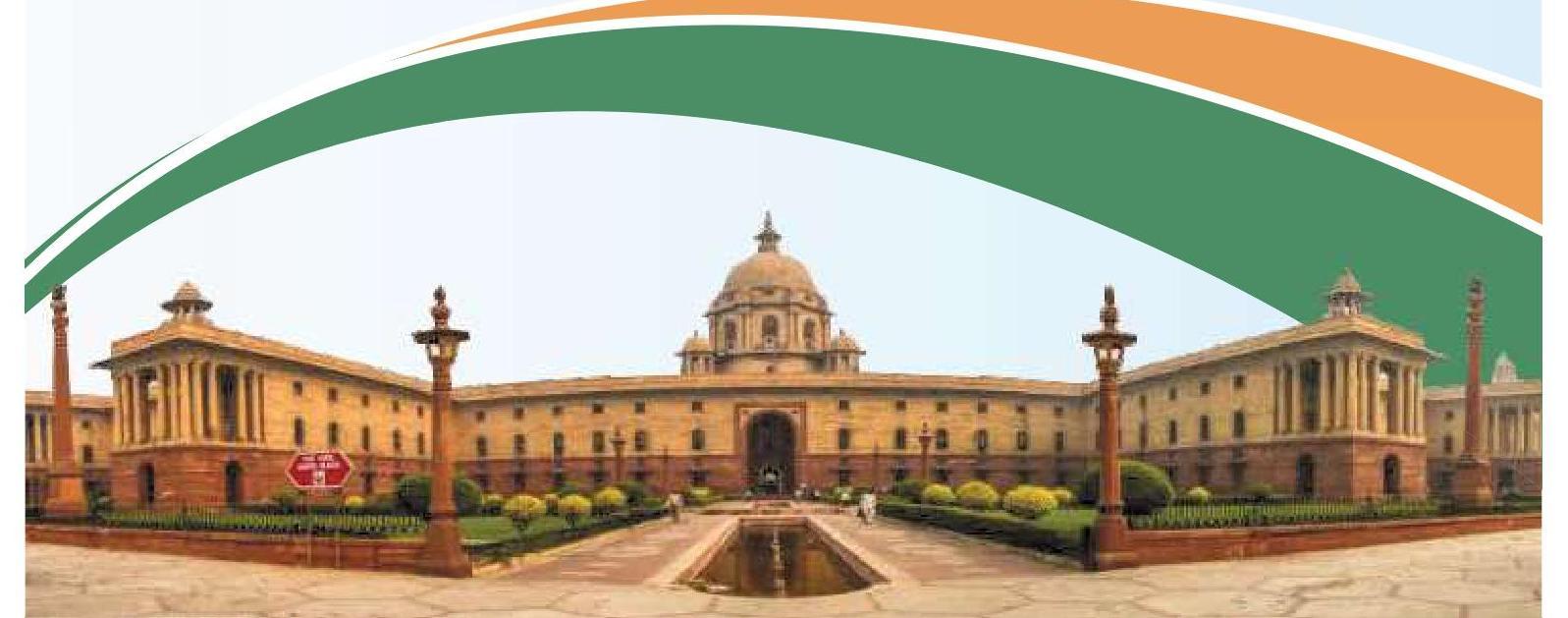
.
ANNUAL REPORT
2023-24
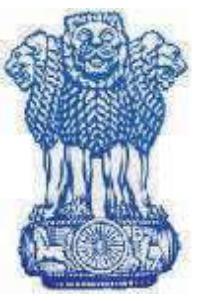
Ministry of Personnel, Public Grievances and Pensions
Government of India
.
CONTENTS
| List of chapters | Page Nos. |
|---|---|
| Vision and Mission | iii |
| Executive Summary | iv |
| DEPARTMENT OF PERSONNEL AND TRAINING | |
| 1 Overview | 1 |
| 2 Major Initiatives/Achievements/Events during the year | 7 |
| 3 Personnel Policies | 22 |
| 4 Reservation in the Central Government Services | 42 |
| 5 Cadre Management | 46 |
| a) Indian Administrative Service (IAS) | 46 |
| b) Central Secretariat Service (CSS) | 54 |
| c) Central Secretariat Stenographers’ Service (CSSS) | 57 |
| d) Central Secretariat Clerical Service (CSCS) | 59 |
| e) State Reorganization | 61 |
| 6 Senior Appointments under Government of India | 64 |
| 7 Training Policy and Programmes | 69 |
| 8 Training Institutions | 97 |
| 9 Mission Karmayogi & e-HRMS | 137 |
| 10 Administrative Vigilance Division | 143 |
| 11 International Cooperation | 153 |
| 12 Central Bureau of Investigation | 155 |
| 13 Joint Consultative Machinery | 181 |
| 14 Administrative Tribunals | 183 |
| 15 Staff Welfare | 191 |
| 16 Right to Information | 200 |
| 17 Grievance Redressal Mechanism & Citizens’ Charter | 206 |
| 18 Progressive Use of Hindi in Official Works | 208 |
| 19 Financial Management | 214 |
| 20 DEPARTMENT OF ADMINISTRATIVE REFORMS AND PUBLIC GRIEVANCES | 219 |
| 21 Administrative Reforms | 228 |
| 22 Public Grievances | 238 |
| 23 Organisation and Methods Division | 244 |
| 24 E-Governance | 248 |
| 25 International Exchange & Cooperation (IE&C) | 254 |
| 26 | Documentation and Dissemination Division (D&D) | 258 |
|---|---|---|
| 27 | Hindi Section | 262 |
| 28 | DEPARTMENT OF PENSIONS AND PENSIONERS’ WELFARE | 265 |
| ANNEXURES | ||
| 29 | Department of Personnel and Training | |
| Annexure-I – Incumbency Position of Under Secretary level Officers and above in DoPT | 300 | |
| 30 | Department of Administrative Reforms and Public Grievances | |
| Annexure-II – National Awards for e-Governance 2022 | 304 | |
| Annexure-III – Organisational Chart of DARPG | 306 | |
| Annexure-IV – Incumbency position of Under Secretary level officers and above in DARPG | 307 | |
| Annexure-V- Prevention of Sexual Harassment of Women at Workplace | 308 | |
| Annexure-VI – Welfare of SC, ST, OBC and Person with Disability (PWD) | 309 | |
| 31 | Department of Pensions and Pensioners’ Welfare | |
| Annexure-VII- Organisational Chart | 310 | |
| Annexure-VIII – Incumbency Position of Group ‘A’ officers in D/o PPW | 311 |
Ministry of Personnel, Public Grievances and Pensions
Department of Personnel & Training
Vision
To create an enabling environment for the development and management of Human Resources of the Government for efficient, effective, accountable, responsive and transparent and ethical governance.
Mission
Development and management of government personnel by attracting the best talent, providing excellent career advancement opportunities, encouraging competence and innovation, adopting a dynamic framework of personnel policies and procedures, ensuring capacity building at all levels, inculcating and supporting a culture of transparency, accountability and zero tolerance to corruption in public affairs, and institutionalizing a system of continuous and constructive engagement with stakeholders to make the public services in India more efficient, effective, accountable and responsive.
EXECUTIVE SUMMARY
The Ministry of Personnel, Public Grievances and Pensions is the nodal Ministry responsible for personnel matters, especially in respect of issues concerning recruitment, training, career development, staff welfare, and the post-retirement dispensation. The Ministry also works towards the promotion of responsive, people-oriented, and modern administration.
The Ministry comprises three Departments:
(i) Department of Personnel and Training (DoP&T)
(ii) Department of Administrative Reforms and Public Grievances (DARPG)
(iii) Department of Pensions and Pensioners’ Welfare (DPPW)
DEPARTMENT OF PERSONNEL AND TRAINING (DOPT)
Various wings of DoP\&T are as under:
Establishment Officer’s (EO) Wing
Services \& Vigilance (S\&V) Wing
Personnel Policy Wing
AT, IR, Welfare \& Administration
Training Wing
Central Secretariat
The Establishment Officer’s Wing deals with the matter relating to senior appointments under the Government of India requiring approval of the ACC.
The Services \& Vigilance Wing handles matters relating to Administration of Rules on all the service matters in respect of All India Services and acts as the nodal agency in the arena of vigilance and anticorruption.
The Personnel Policy Wing is responsible for framing and revising rules and regulations regarding service conditions of the employees and personnel policies of the Central Government employees other than All India Service Officers. This wing handles the work related to Service conditions of Central Government, Reservation Policy of the Government, Joint Consultative Machinery (JCM) and Cadre Review. This wing also looks after the work related to the allocation of State cadre employees consequent upon the reorganization of the States and Redeployment and Retraining of surplus Staff of various Central Government Organisations.
The IR, AT, Welfare \& Admin Wing is responsible for governing \& implementation of the RTI Act. Also handles the administrative matters relating to the Administrative Tribunals and Central Information Commission. This wing also handles the work related to internal Administration \& Coordination of DoPT and welfare activities for benefit of the employees of the Government.
The Training Wing acts as the nodal agency for capacity building of Government functionaries and is primarily responsible for formulating policies regarding training.
The Central Secretariat Wing deals with the matters related to Cadre Management of the Central Secretariat Service, Central Secretariat Stenographers’ Service and the Central Secretariat Clerical Service.
The Department of Personnel and Training also handles the administrative work relating to the following Institutions: –
- Union Public Service Commission
- Central Vigilance Commission
- Lokpal
- Central Administrative Tribunals
- Central Information Commission
- Central Bureau of Investigation
- Staff Selection Commission
- Public Enterprises Selection Board
- Lal Bahadur Shastri National Academy of Administration
- Institute of Secretariat Training and Management
- Capacity Building Commission
- National Recruitment Agency
- Karmayogi Bharat – Special Purpose Vehicle
DEPARTMENT OF ADMINISTRATIVE REFORMS & PUBLIC GRIEVANCES
The Department of Administrative Reforms and Public Grievances is the nodal agency of the Government of India for administrative reforms as well as redressal of public grievances relating to the States in general and those pertaining to the Central Government agencies in particular. The Department endeavours to document and disseminate successful governance practices by way of audio-visual media and publications. The Department also undertakes activities in the field of international exchange and cooperation to promote public service reforms. There are 7 Divisions in the Department namely Administrative Reforms, Organization \& Methods, eGovernance, Documentation \& Dissemination, International Cooperation, Administration \& Coordination and Public Grievances.
DEPARTMENT OF PENSIONS AND PENSIONERS’ WELFARE
The Department of Pension \& Pensioners’ Welfare was set up in 1985 as part of the Ministry of Personnel, Public Grievances and Pensions to formulate policy and coordination of matters relating to retirement benefits of Central Government employees (except Defence, Railway and Post \& Telecommunication).
.
CHAPTER-1
OVERVIEW
1.0 The Ministry of Personnel, Public Grievances and Pensions acts as the formulator of policies pertaining to recruitment, regulation of service conditions, and deputation of personnel besides advising all organizations of the Central Government on issues pertaining to personnel management. The Organizational chart of the Department is on the next page.
Major Initiatives/Achievements/Events during the year (Chapter 2)
1.1 Major Initiatives/Achievements during the period of April 2023 – March 2024 have been brought out in Chapter 2.
Personnel Policies (Chapter 3)
1.2 The Department is responsible for framing rules and regulations governing service conditions including recruitment rules, promotions and seniority, Flexible Complementing Scheme, Leave Travel Concession, Deputation and Leave of employees. Personnel are recruited for the Central Government by the Union Public Service Commission through competitive examinations conducted by them for appointments to higher civil services and through the Staff Selection Commission for non-gazetted staff in Group ‘B’ & ‘C’ categories.
Reservation (Chapter 4)
1.3 In order to achieve the objective of upliftment and welfare of the Scheduled Castes and Scheduled Tribes, Other Backward Classes and Persons with Disabilities and Economically Weaker Sections (EWS); the Department frames policies to provide reservation to these groups in various Central Government services and for monitoring its implementation.
Cadre Management (Chapter 5)
1.4 This Department is responsible for the management of the cadres of All India Services (AIS) (IAS, IPS, and IFoS) and all three Secretariat Services namely Central Secretariat Services (CSS), Central Secretariat Stenographers’ Services (CSSS) and Central Secretariat Clerical Services (CSCS). In addition, this Department frames and revises Rules and Regulations regarding conditions of the All India Services, such as Indian Police Service (IPS) and Indian Forest Service (IFoS), in consultation with the Ministry of Home Affairs and Ministry of Environment, Forest and Climate Change respectively. This Department is also responsible for the cadre review of 66 existing Central Group ‘A’ Services/ Cadres periodically.
Senior Appointments under the Government of India (Chapter 6)
1.5 The Department deals with appointments at senior level and personnel policies of the Government of India. All proposals for senior appointments under the Government of India, which require the approval of the Appointments Committee of the Cabinet (ACC), are processed by the Department. These include board-level appointments to Central Public Sector Undertakings and appointments under the Central Staffing Scheme for posts of Joint Secretary, Director, and Deputy Secretary in Ministries /Departments. In addition, all appointments by promotion, which require the approval of the ACC, are also processed by the Department.
Training Policy and Programmes (Chapter 7)
1.6 The Department is the nodal authority to impart training to the government functionaries. The Training Wing of the Department formulates policies and implements its training programmes by identifying areas of training, designing training programmes, development of trainers and training capabilities and administering policies in training. Major training activities undertaken during the year are (i) In-service training of AIS/CSS/CSSS officers (ii) Mid-Career Training of IAS Officers (iii) Post Graduate Programmes in Public Policy/Sustainable Development/Management (iv) State Category Training Programme (SCTP); (v) Trainer Development Programme (TDP); (vi) Comprehensive Online Modified Modules for Induction Training (COMMIT); (vii) Augmentation of the Capacity of Training Institutions (ACTI); (viii) Integrated Government Online Training Programme (i-GOT); and (ix) National Programme for Civil Services Capacity Building (NPCSCB)- Mission Karmayogi.
Training Institutions (Chapter 8)
1.7 Lal Bahadur Shastri National Academy of Administration (LBSNAA), Mussourie, Uttarakhand and Institute of Secretariat Training and Management (ISTM), New Delhi are two premier training institutions, attached to this Department. These institutions cater to the needs of human resource development by imparting training to all officers of Central Government and AIS at regular intervals for their career progression. The Department also supports the Indian Institute of Public Administration (IIPA), an autonomous organization, in undertaking advance training programmes for administrators as well as researchers on issues relating to public administration.
Mission Karmayogi & e-HRMS (Chapter 9)
1.8.1 National Programme for Civil Services Capacity Building (NPCSCB) – Mission Karmayogi is being implemented with the goal of systematically imparting behavioral and functional competencies needed by a government official to best discharge their assigned roles and aims to effect a signal shift in competency driven training and Human Resource (HR) management of officials, by transitioning from a ‘rule-based’ system to a ‘role-based’ system of capacity building.
1.8.2 Through the adoption of modern technological tools such as a digital platform – the integrated Government online Training (i-GoT) portal – https://igotkarmayogi.gov.in/ and with effective harnessing of artificial Intelligence, machine learning and data analytics, Mission Karmayogi endeavors to break silos in capacity development and democratize knowledge on an equitable basis across civil services, by bringing easy access to world class continuous learning opportunities for all government officials.
1.8.3 The NPCSCB facilitates data-driven decisions for training and personnel management through the electronic Human Resources Management System (e-HRMS), which has now been revamped as e-HRMS2.0 and also integrated with the i-GOT portal. This helps the Government to digitally manage the service matters of officials leading to reduction in transaction time and cost, availability of digital records, dashboards for MIS, real time monitoring of manpower deployment as well as serving as a productivity enhancement tool amongst others.
Administrative Vigilance Division (Chapter 10)
1.9 The Department is the nodal agency responsible for the formulation and implementation of vigilance and anti-corruption policies of the Government. Administrative Vigilance Wing in
the Department oversees government programme for maintenance of discipline and eradication of corruption from public service. The Central Vigilance Commission (CVC) advises the Central Government on all vigilance matters. The jurisdiction of the Commission extends to all the organisations to which the executive powers of the Union of India extend.
International Cooperation (Chapter 11)
1.10 The Department of Personnel and Training is the nodal Department for formation of policies for anti-corruption in Government of India. To deal with international cooperation on these aspects an International Cooperation Cell was created in this Department. The primary tasks of this Cell emanate from the follow up to the ratification of the United Nations Convention Against Corruption (UNCAC) and the other consequential international collaborative efforts, on global platforms. This Cell acts in conjunction with specialized agencies like the Central Bureau of Investigation, the Enforcement Directorate and the other line Ministries entrusted with the specific ancillary tasks within their respective administrative domain, viz. corporate governance, extradition matters, prevention of money laundering, mutual legal assistance treaties etc.
Central Bureau of Investigation (Chapter 12)
1.11 Central Bureau of Investigation (CBI) was set up by the Government of India by a Resolution dated April 1, 1963, to not only investigate cases of bribery and corruption but also the cases of violation of central fiscal laws, major frauds relating to Government of India Departments, Public Joint Stock Companies, passport frauds and serious crimes committed by organized gangs and professional criminals. CBI was further strengthened by the addition of Economic Offences Wing by the Government of India by Resolution dated February 2, 1964.
Joint Consultative Machinery (Chapter 13)
1.12 The Government provides for a Joint Consultative Machinery for joint consultation at three levels between the Central Government and its employees for promoting harmonious relations and securing the optimum level of co-operation between the Central Government and its employees in matters of common concern. The objective is to increase the efficiency of public services along with the well-being of the employees. The three tiers are:
a) National Council – at the apex level, functioning under the Department of Personnel and Training.
b) Department Councils – functioning at the level of the Ministries / Departments.
c) Office Councils – functioning at offices/organisations under various Ministries / Departments.
The Scheme has proved to be an effective forum for amicable settlement of grievances of the Central Government employees relating to their service matters etc.
Administrative Tribunal (Chapter 14)
1.13 In order to provide speedy and inexpensive justice delivery system to the employees who feel aggrieved by Government decisions, the Government set up the Central Administrative Tribunal (CAT) in 1985, which now deals with all cases relating to service matters. The CAT has 19 regular benches, 17 of which operate at the Principal seats of High Courts and the remaining two are at Jaipur and Lucknow.
Staff Welfare (Chapter 15)
1.14 The Central Government being the largest single employer in the country discharges its responsibility for looking after the welfare of employees through various welfare measures. The Department also extends support to various staff welfare measures. The DoPT is the nodal Department for registered societies set up for the welfare of the Government employees and their families. In addition, the Department lays down policies for Departmental Canteens and supports the Resident Welfare Associations.
Right to Information (Chapter 16)
1.15 The Department has brought out a comprehensive law to ensure the right to information of the citizens of India in almost entire matters of governance at all levels from the Central Government to the local self-government. The Law (RTI Act, 2005) has provided a mechanism where the Central Information Commission, being the apex body at the Centre, facilitates its citizenry in accessing information in a time-bound, hassle-free and affordable manner.
Grievance Redressal Mechanism & Citizens’ Charter (Chapter 17)
1.16 The Department has identified some of the core services being offered by its various divisions and their standards for the purpose in its first Citizen Charter. This has been undertaken by a Task Force in consultation with the Stakeholders. While identifying the services the focus has been on measurable and verifiable services and their standards. The charter contains a Grievance Redress Mechanism related to the services mentioned in the Citizens’/Clients’ Charter. The Charter also provides links for other grievances which are not related to the Citizens’/Clients’ Charter. Timelines have been prescribed for final disposal of the complaint arising out of the Citizens’/Client’s Charter.
Progressive Use of Hindi (Chapter 18)
1.17 The Department is fully committed to promoting the use of Hindi as the official language, in official matters and motivate compliance of the provisions of the Official Language Act, 1963, and the rules framed thereunder. The Department also ensures that the spirit of various orders and guidelines issued by the Department of Official Language is appropriately enforced for implementation of the official language policy of the Union. The Department has an Official Language Division which monitors the implementation of the Official Language policy in the Department.
Financial management (Chapter 19)
1.18 In order to promote the various programmes administered by Ministry of Personnel, Public Grievances and Pensions, an allocation of Rs. 229.25 crore was made in the Central Sector Scheme Outlay for the year 2022-23 against the total allocation of Rs. 2320.37 crore at the Revised Estimate 2022-23 stage. The corresponding figures for RE 2023-24 are Rs. 272.35 crore as Central Sector Scheme Outlay against a total allocation of Rs. 2493.70 crore (RE 2023-24). The requirements and priorities of its attached and subordinate offices were kept in view while making budgetary allocation to them by this Department. One C\&AG Para is pending in respect of D/o ARPG.
Organizational Chart for Department of Personnel & Training
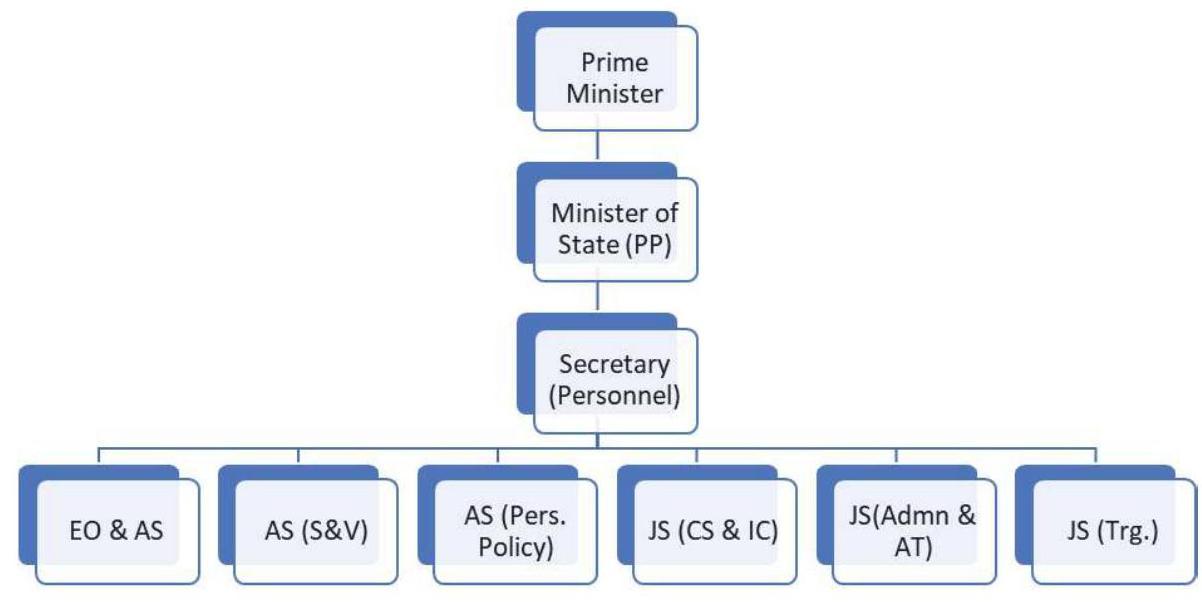
| Abbreviations Used in the Organization Chart | |
|---|---|
| ACC | Appointments Committee of Cabinet |
| AVD | Administrative Vigilance Division |
| ADMIN | Administration |
| AIS | All India Services |
| AS | Additional Secretary |
| B&A | Budget \& Accounts |
| CS | Central Secretariat |
| CPC | Central Pay Commission |
| CRD | Cadre Review Division |
| CWO | Chief Welfare Officer |
| DFFT | Domestic Funding of Foreign Training |
| DS | Deputy Secretary |
| DIR | Director |
| E | Establishment |
| EO | Establishment Officer |
| IR | Information Rights |
| JS | Joint Secretary |
| JCM | Joint Consultative Machinery |
| LTTP | Long Term Training Programme |
| L\&A | Leave and Allowances |
| MOS | Minister of State |
| MM | Middle Management |
| PR | Personal Records |
| PIIA | Pathways for an Inclusive India Administration |
| PESB | Public Enterprises Selection Board |
| PP | Personnel Policy |
| RES | Reservation |
| R\&R and DC | Redeployment \& Retraining and Departmental Council |
| S\&V | Services \& Vigilance |
| AIS | All India Services |
| SM | Senior Management |
| SR | State Reorganization |
| TRG | Training |
| V | Vigilance |
CHAPTER 2
MAJOR INITIATIVES/ ACHIEVEMENTS/ EVENTS DURING THE YEAR
International Yoga Day 2023
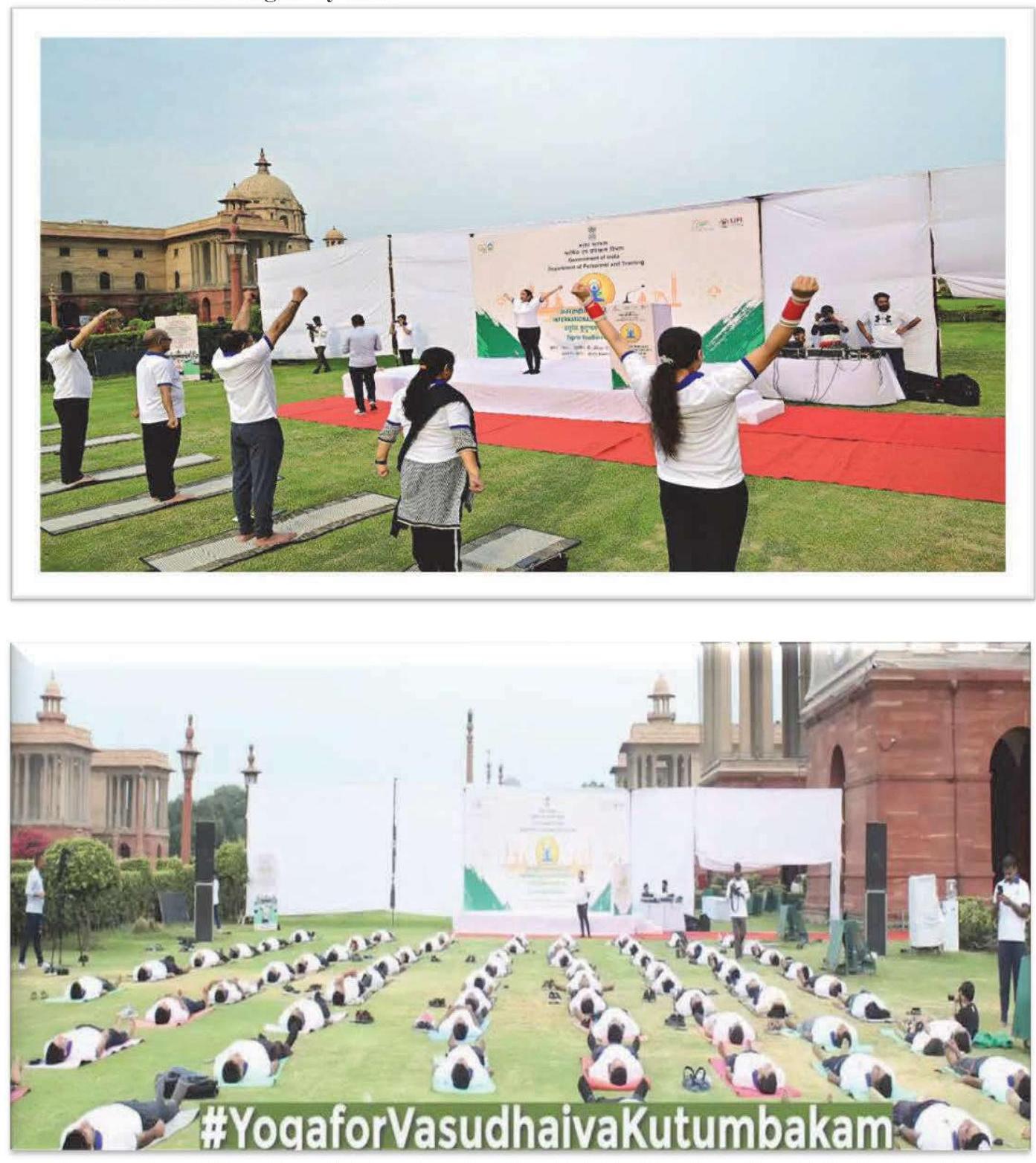
International Yoga Day Celebrations 2023 by DoPT officials at North Block, New Delhi
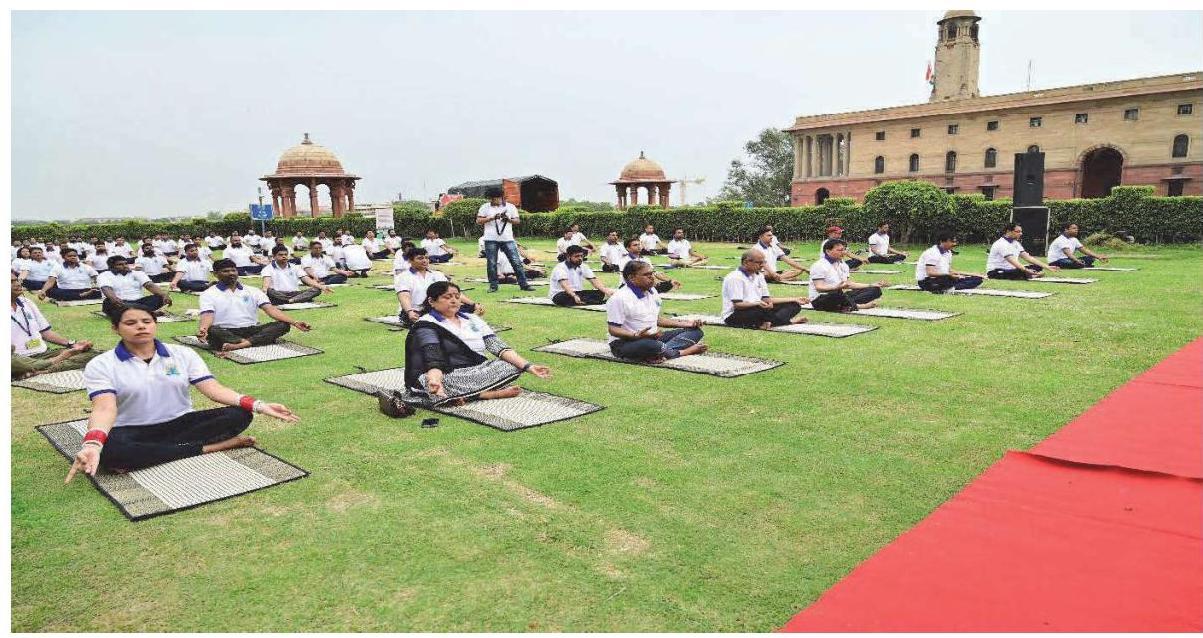
International Yoga Day 2023
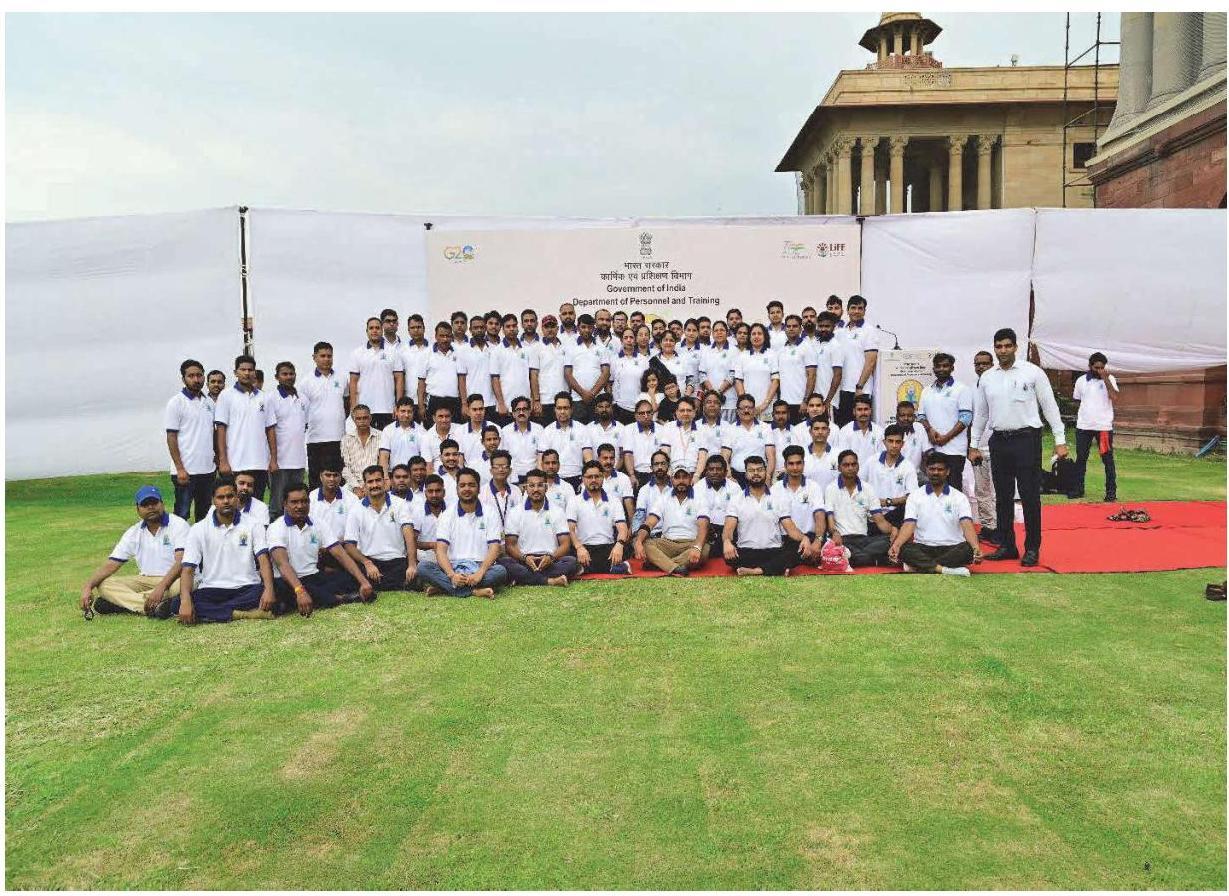
International Yoga Day 2023 celebration by DoPT officials
Rozgar Mela
Hon’ble Prime Minister launched Rozgar Mela on 22nd October 2022. Rozgar Mela is a step towards fulfillment of the commitment of the Hon’ble Prime Minister for employment generation in the country. The Rozgar Mela is expected to act as catalyst in further employment generation and provide meaningful opportunities to the youth for their empowerment and participation in National Development directly. The recruitments are largely in posts of Group-B and Group-C level. The new appointees were inducted into various Central Government Ministries/Departments/Public Sector undertakings (PSUs)/ Autonomous Bodies including Health and Educational institutes, Public Sector Banks and Administration of Union Territories (UTs) etc. Various Ministries and Departments organized Rozgar Melas across the country in which several lakh newly appointed candidates received their letters of appointment.
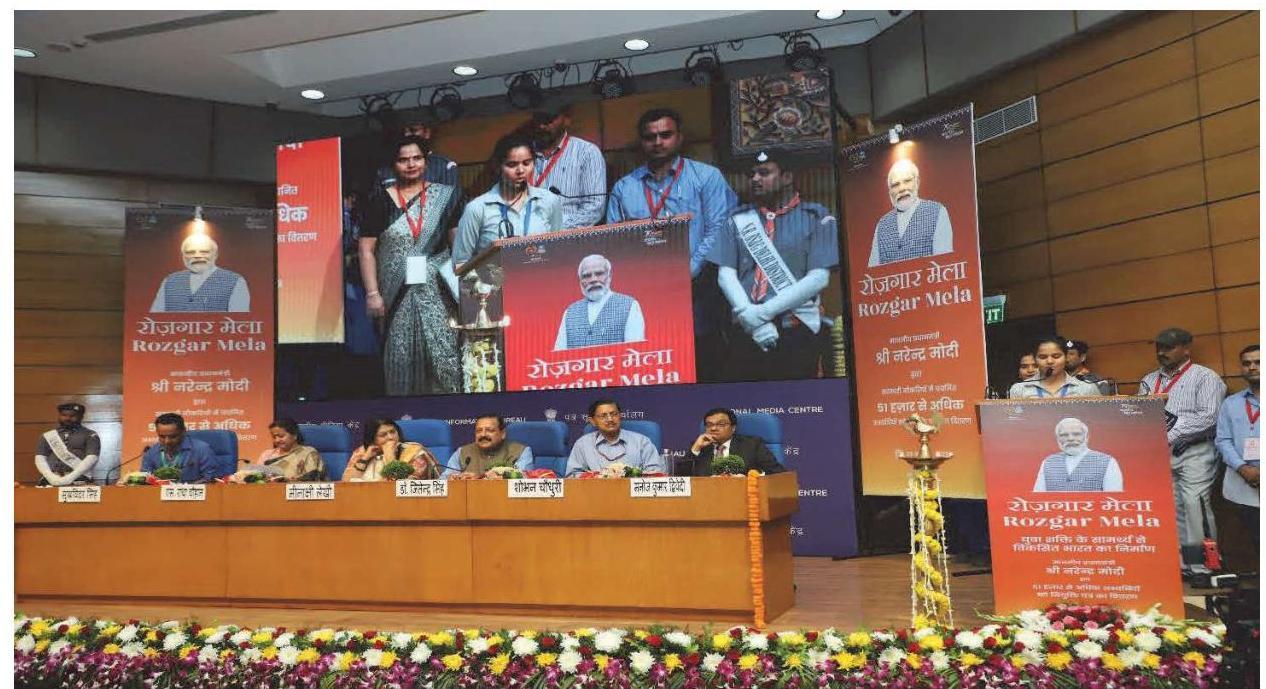
Rozgar Mela at National Media Centre, Delhi
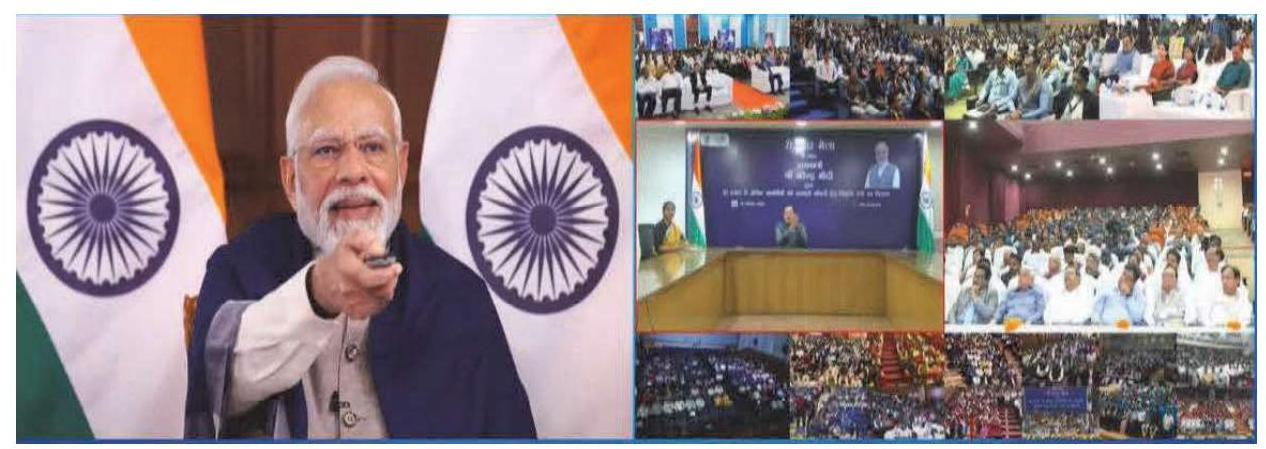
Hon’ble Prime Minister launching Rozgar Mela across the country
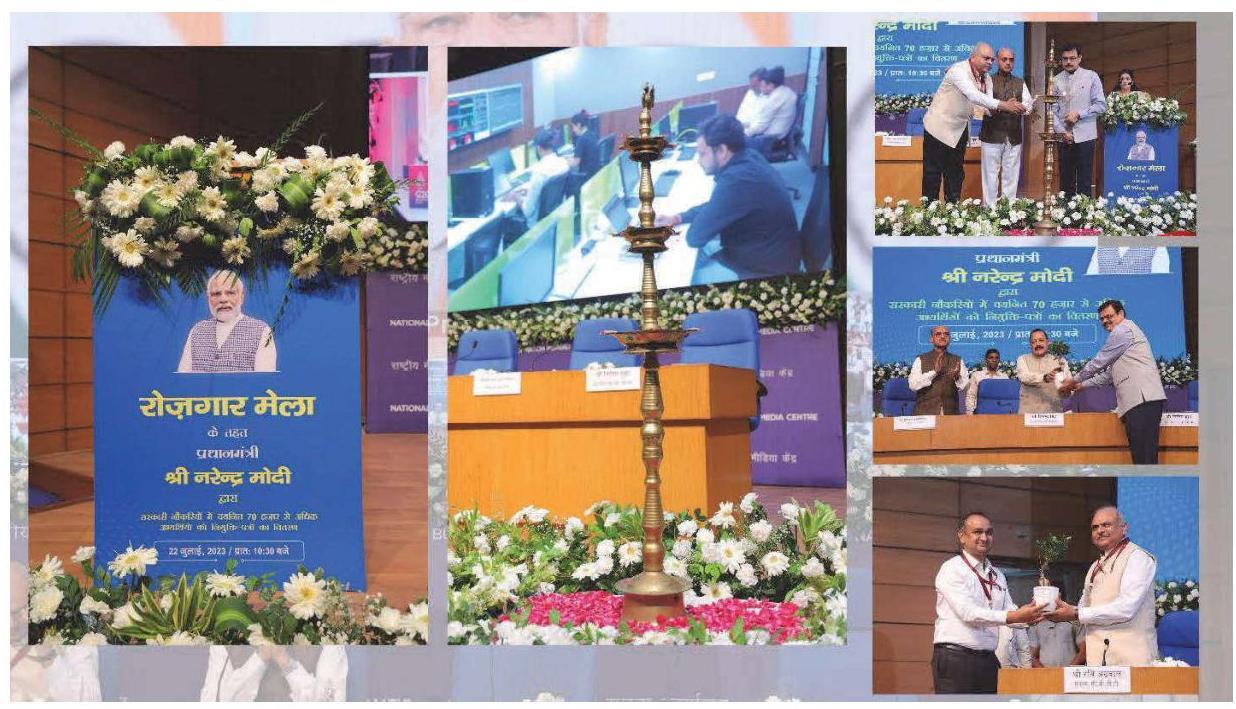
Glimpses of Rozgar Melas
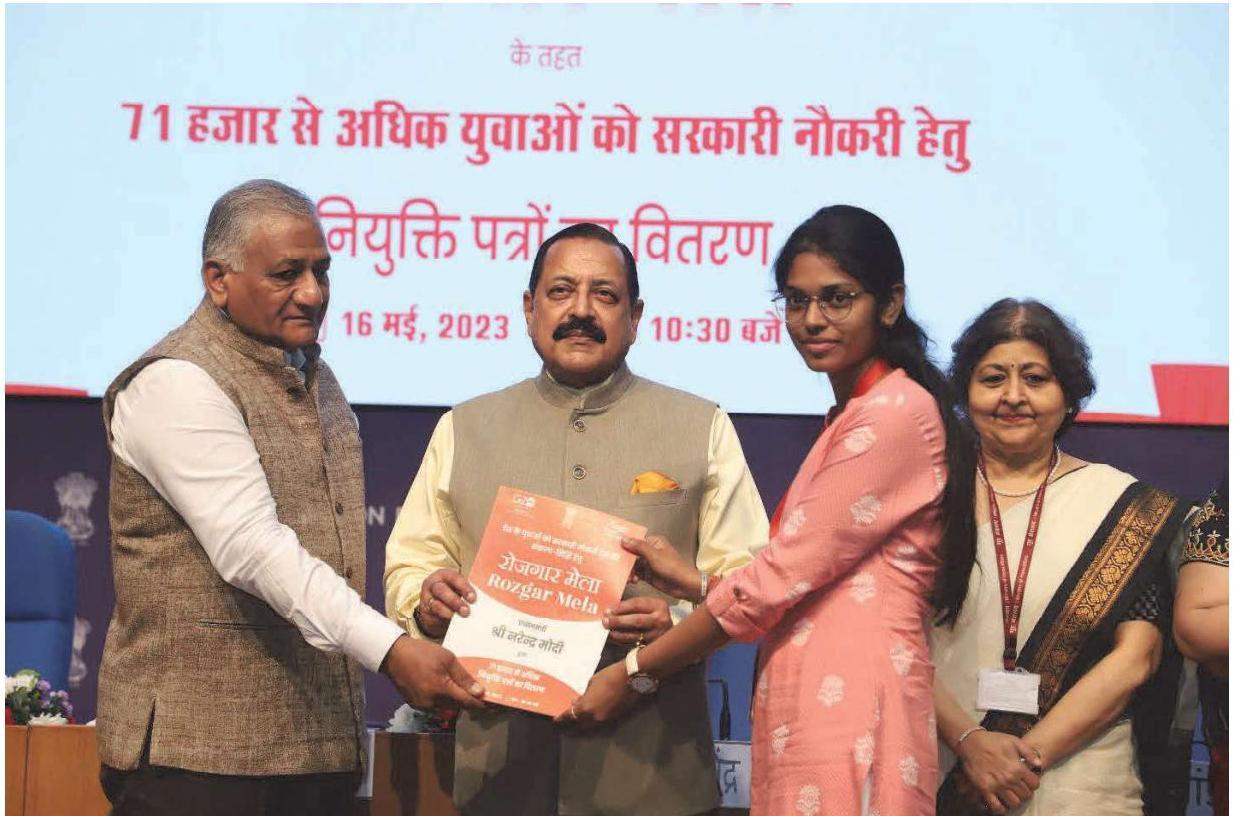
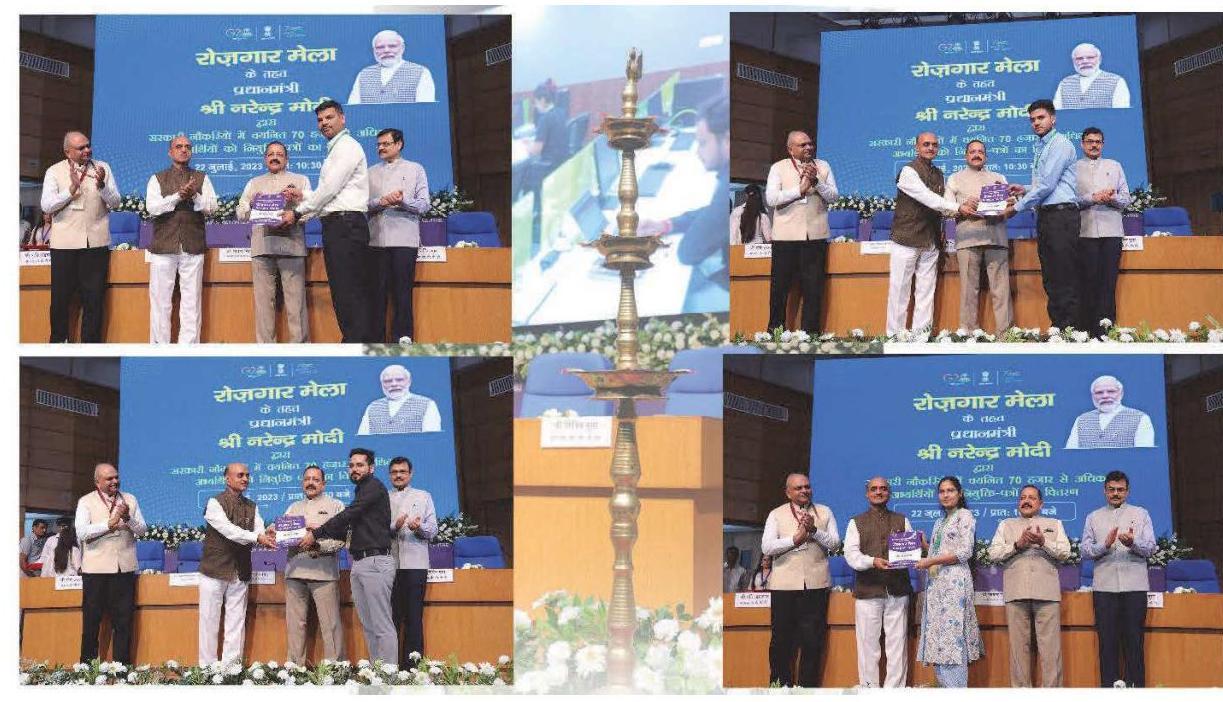
Distribution of appointment letters during Rozgar Mela
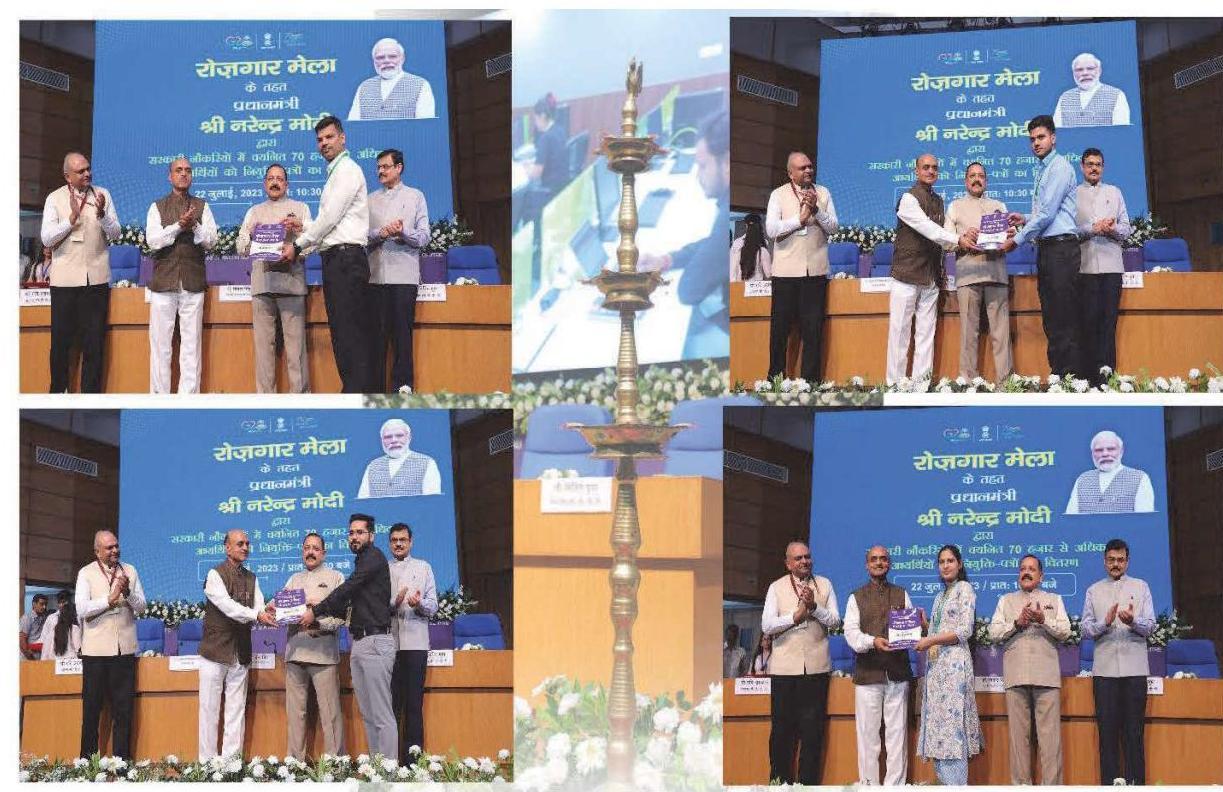
Swachhata Pakhwada in DoPT
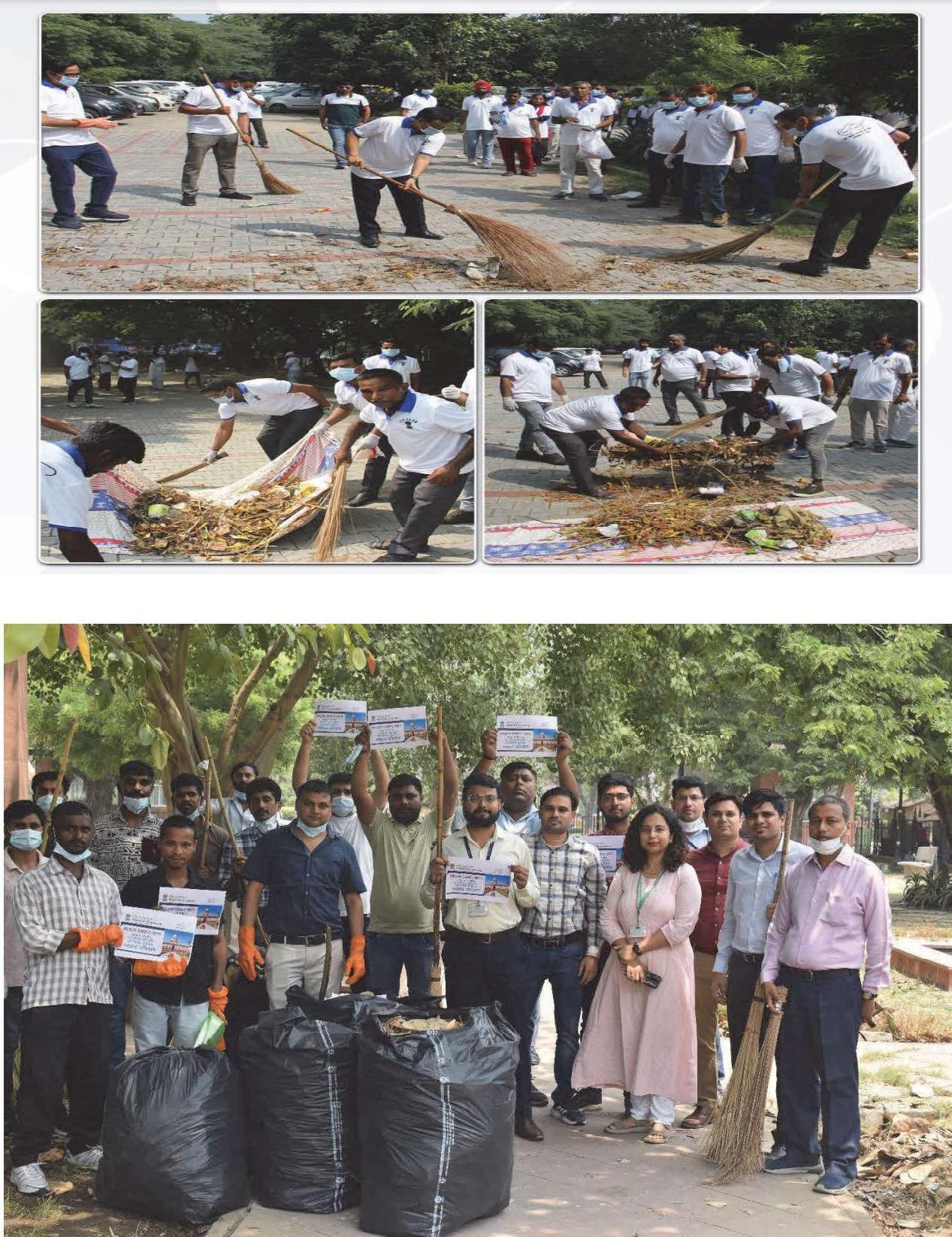
Blood Donation Camp Organized by DoP&T
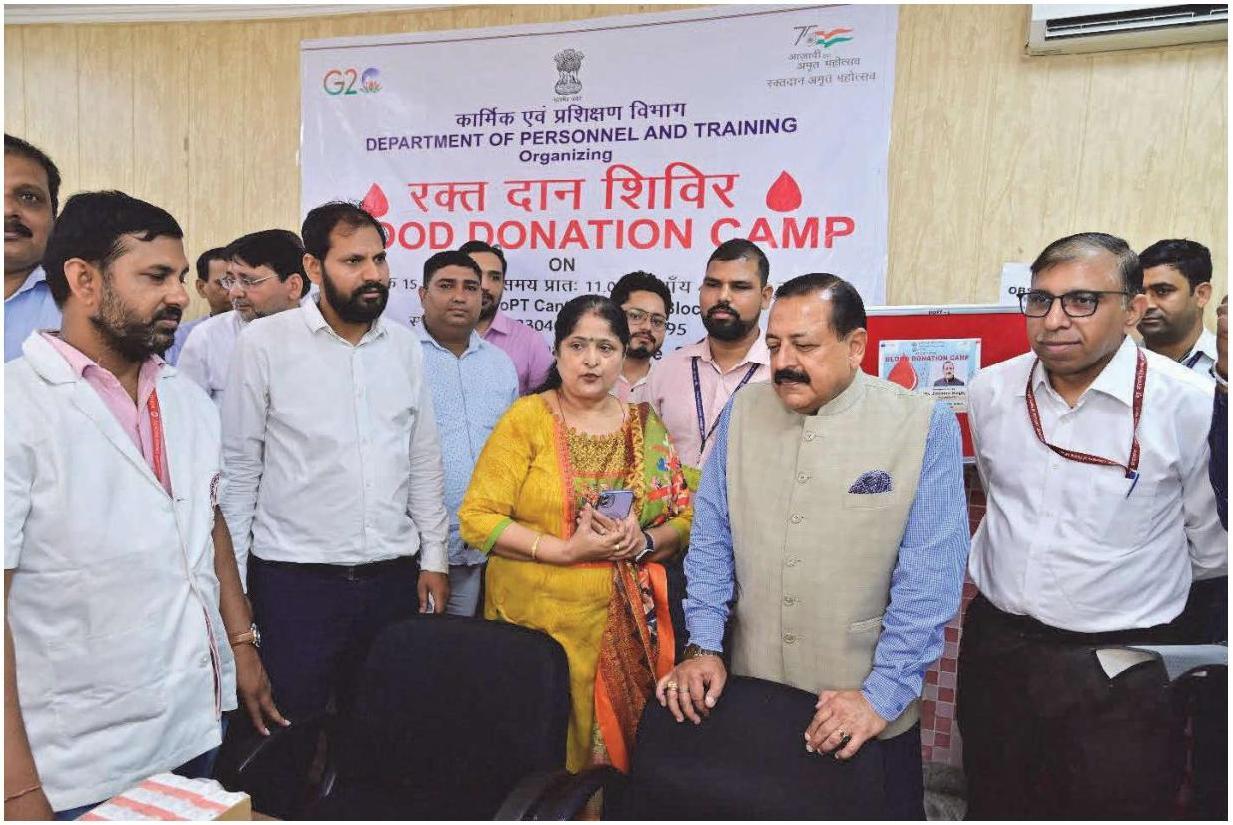
Hon’ble MoS inaugurating the camp on 15th June 2023.
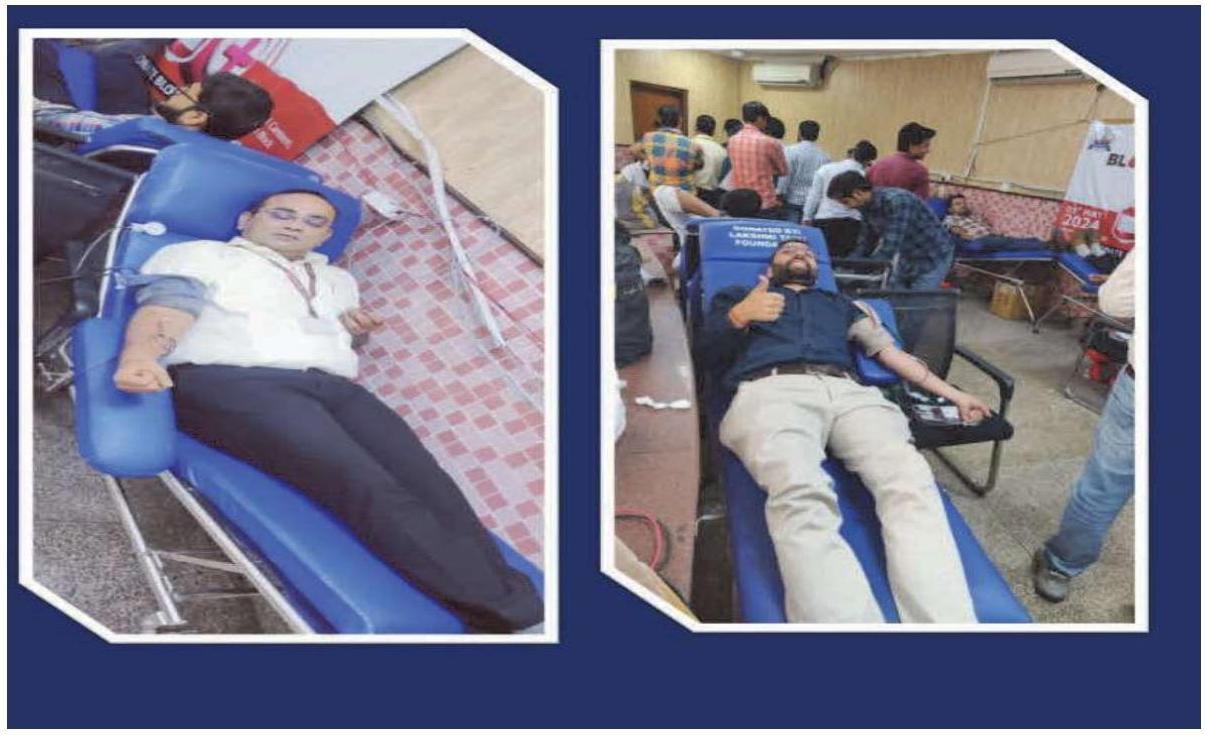
Sh. Rajat Kumar, JS, DoP&T and other officers donating blood during the camp.
Women Sports Meet organized by DoP&T on 20.12.2023
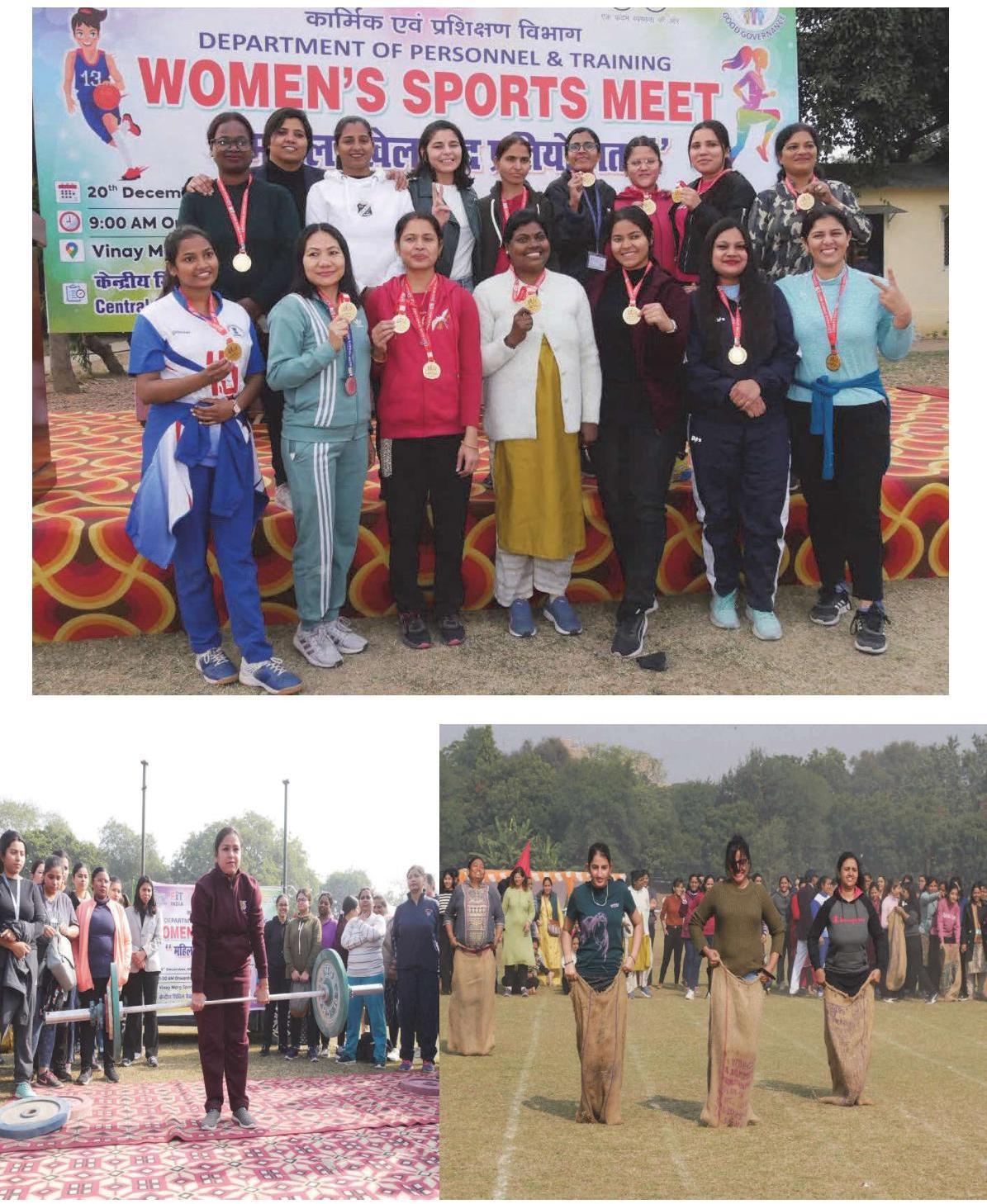
Slogan writing competition on vigilance awareness week
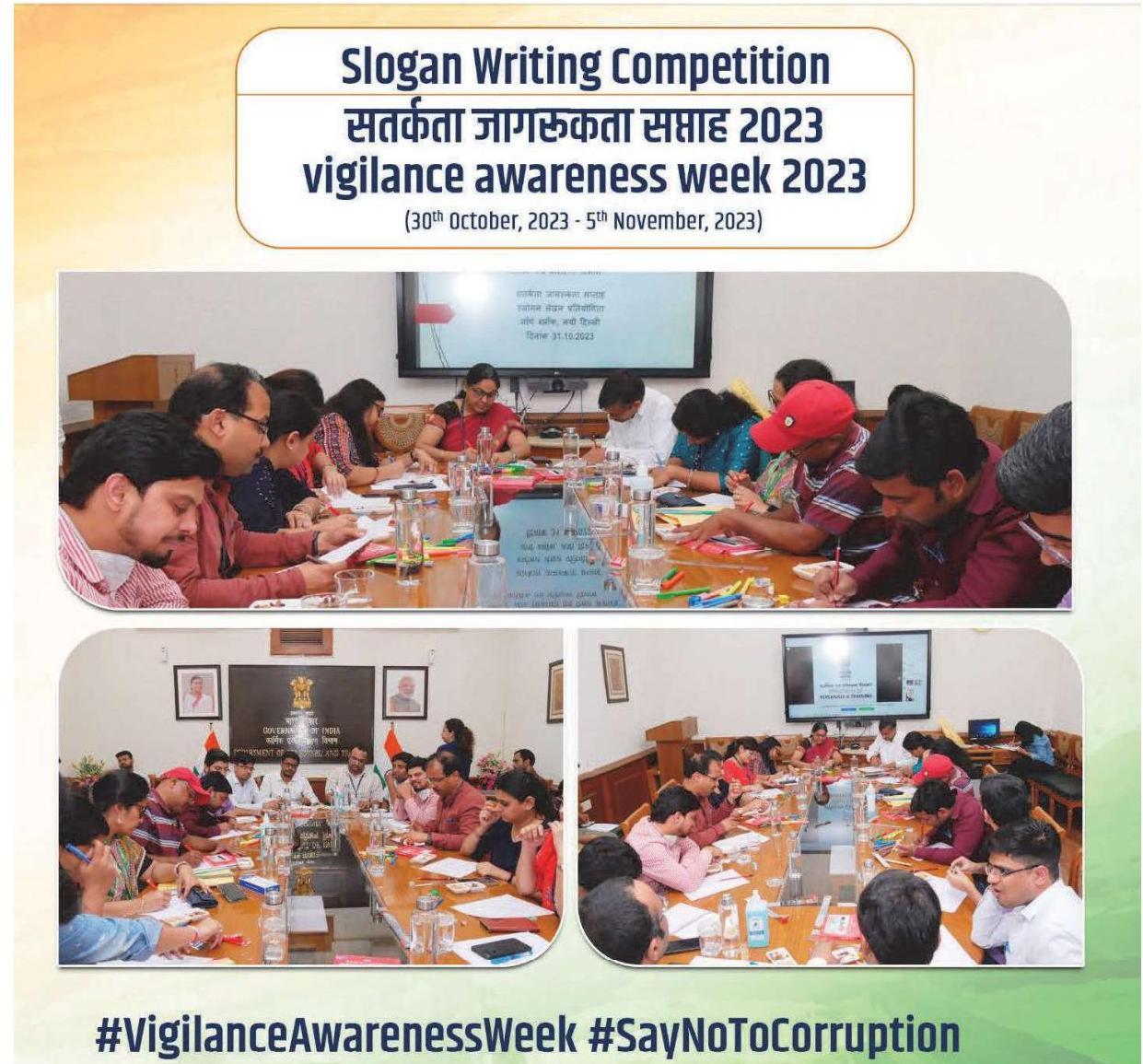
Rashtriya ekta diwas oath ceremony in North Block
साइम्य एकता दिवस पर
एकता शापथ
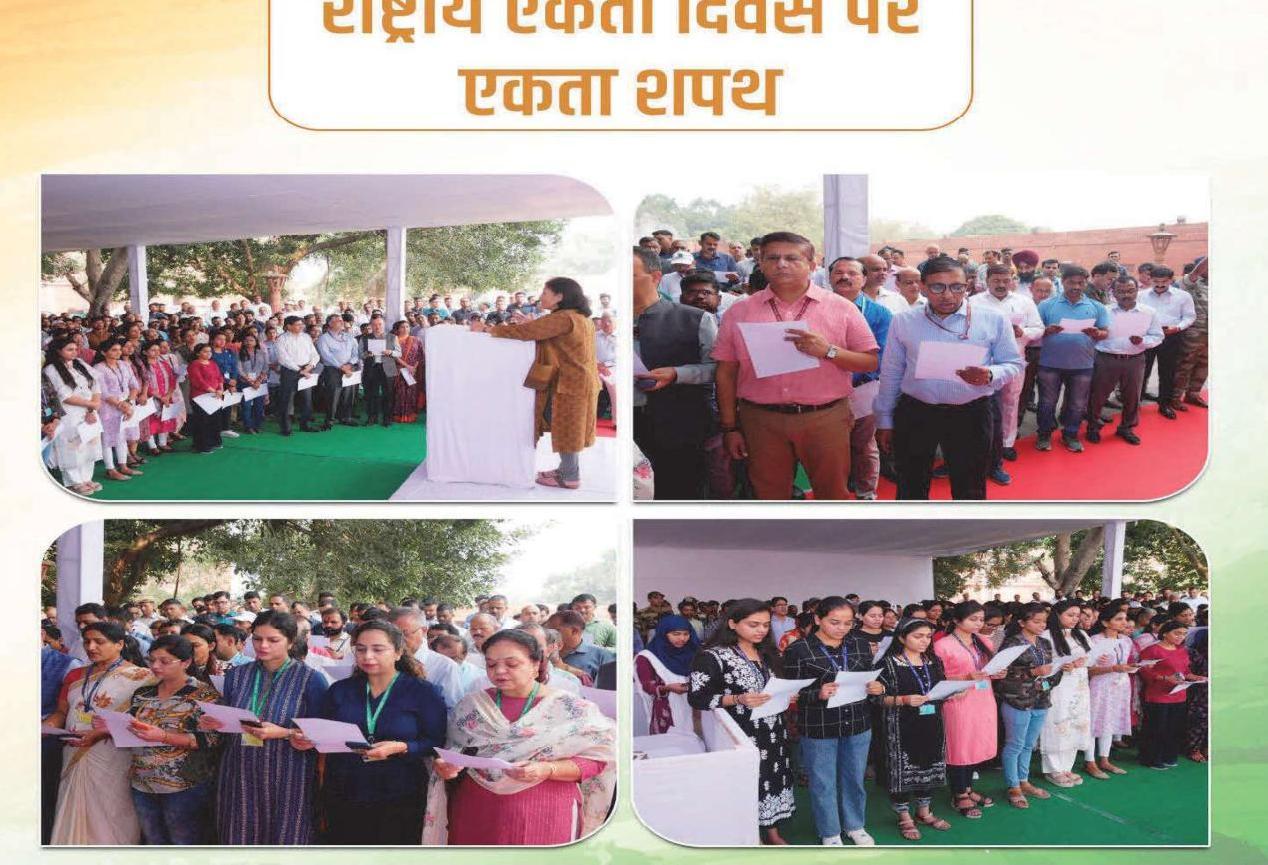
Run for Unity
Run for Unity
On the occasion of
“राष्ट्रीय एकता दिवस”
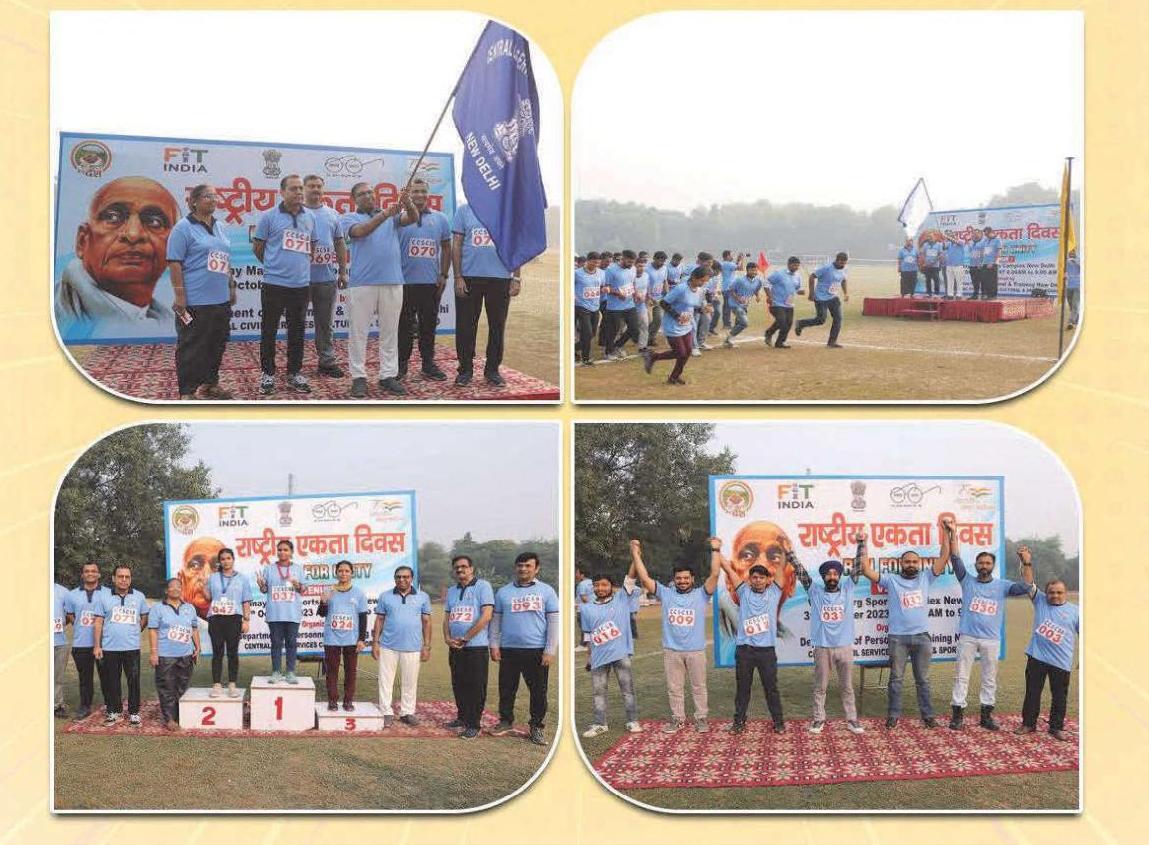
DoP&T organized Run for Unity on Rashtriya Ekta Diwas
Special campaign 3.0
Department of Personnel & Training (DOPT), along with its Attached/ Sub-ordinate organizations actively participated in all the activities included in the Special Campaign and fully achieved its targets of Special Campaign 3.0, which began on $2^{\text {nd }}$ October 2023 and concluded on $31^{\text {st }}$ October 2023 with a view to effectively reduce the pendency in respect of various items.
Highlights \& achievements of the Department
i) Effective Disposal of Pending items
During the campaign, DOPT along with its Attached \& Subordinate offices and autonomous bodies have disposed of 2 pending References from MPs, 10 Inter Ministerial References, 121 Public Grievances and 13 out of 14 Important references from other Organizations
ii) File Management: DOPT with its Attached, Subordinate, and Autonomous Organizations has successfully achieved its target in so far as it pertains to review of physical and e-office files. 75,136 physical files, 6000 e-office files and 1,17,000 documents/ dossier have been reviewed by DOPT and its associated organizations.
iii) Revenue Generation: Revenue of Rs 3.78 lakh has been generated.
iv) Cleanliness: 290 cleanliness campaigns have been conducted at various office sites.
Best Practices were also adopted during this Campaign. Some of the best practices adopted e.g Digitization \& Preservation of Records as part of Review exercise, Recording/Reviewing of files carried out in mission mode in all organisations so as to promote digital governance and freeing up of physical space, Cleanliness combined with ‘Go Green’ and LiFE campaign, Closure of Physical files with a view to promote e-office culture, Encouraging other Ministries to send only e- references to DOPT, E-HRMS modules made fully functional to reduce the physical references, 86 Central Ministries and Departments onboarded on i-Got Karmayogi portal, where more than 780 courses have been made available with a duration of 1459 hours and 39,18,633 course enrolments. 29, 83,902 course completions have been reported till date on the portal. Till the end of Special Campaign, more than 25 lakh users have been onboarded on the igotkarmayogi portal for continuous learning.
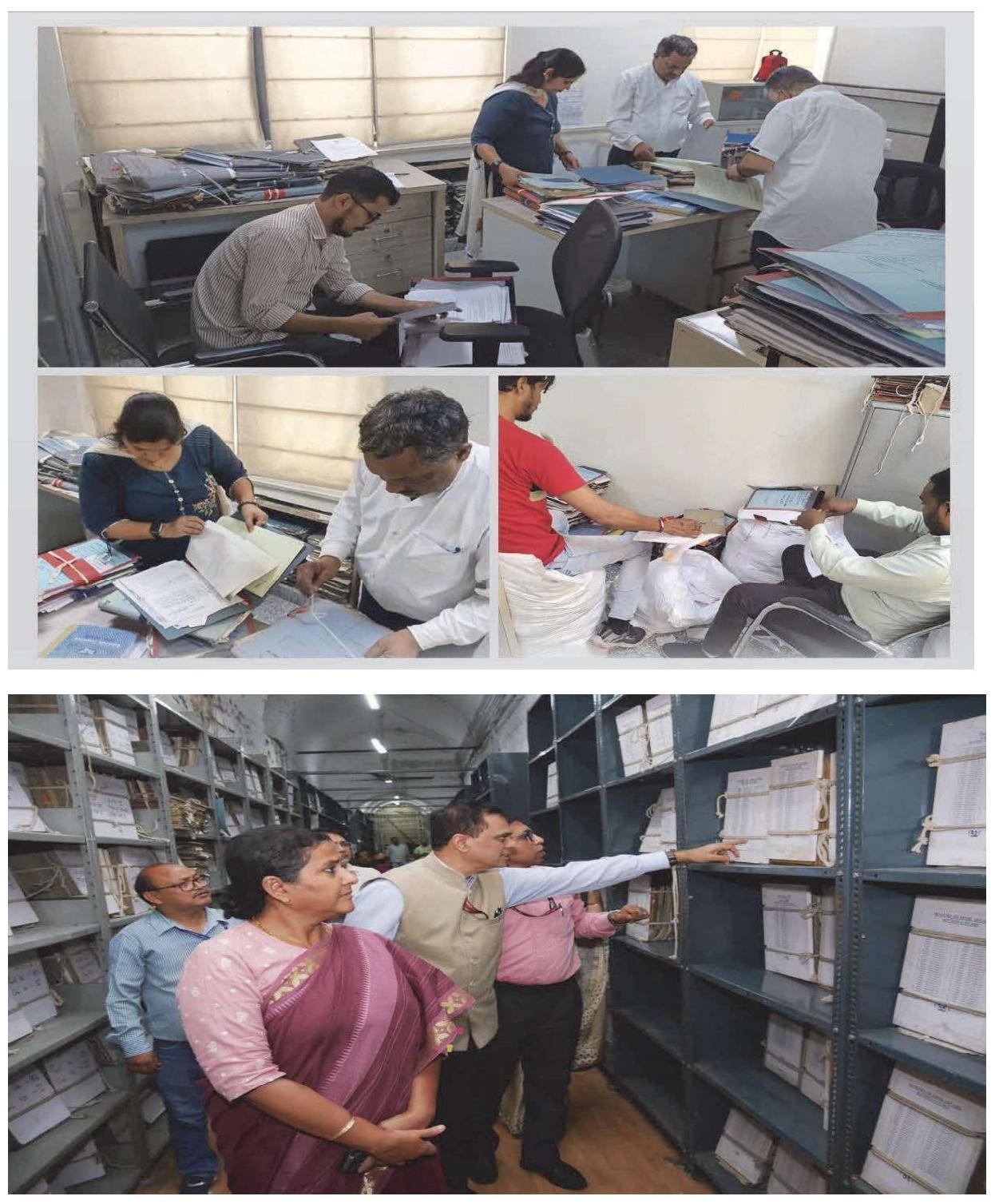
Secretary, DoP&T reviewed the Record Room renovation efforts
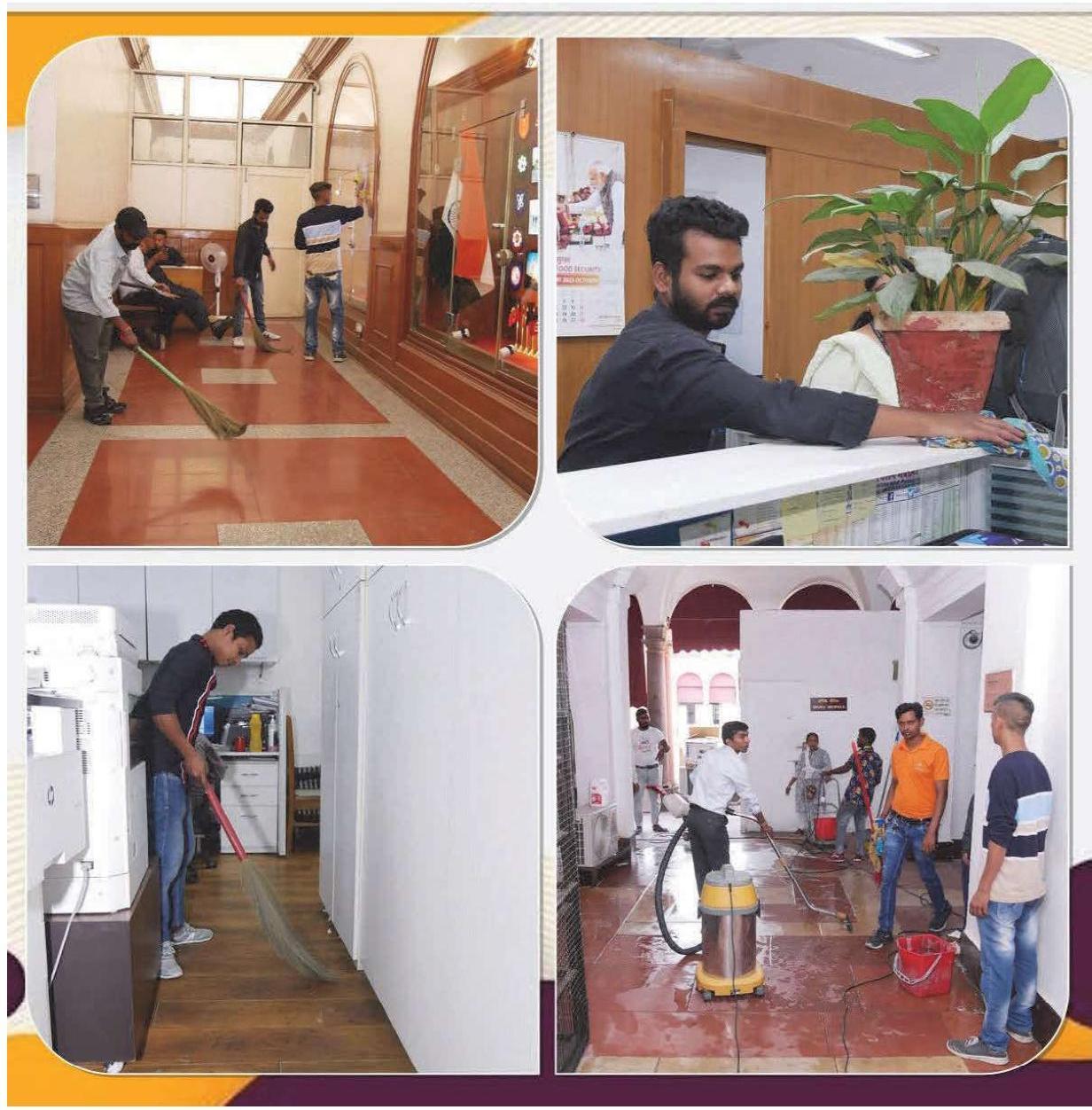
Cleaning activities in full swing in DoP&T
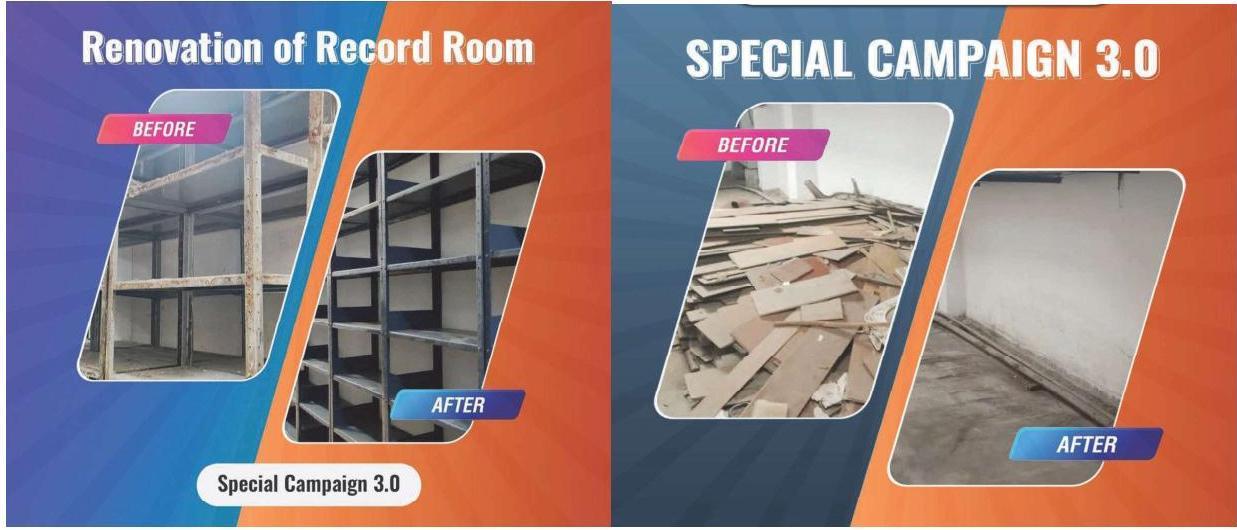
- A National Training Conclave was organized on 11-06-2023, hosted by the Capacity Building Commission (CBC), to bring together all Civil Services Training Institutes (CSTIs) in a common setting for the first time with the aim that this effort will help identify strategies for the Ecosystem to build and improve together. The Conclave provided a platform for knowledge exchange, identifying challenges and key areas of collaboration.
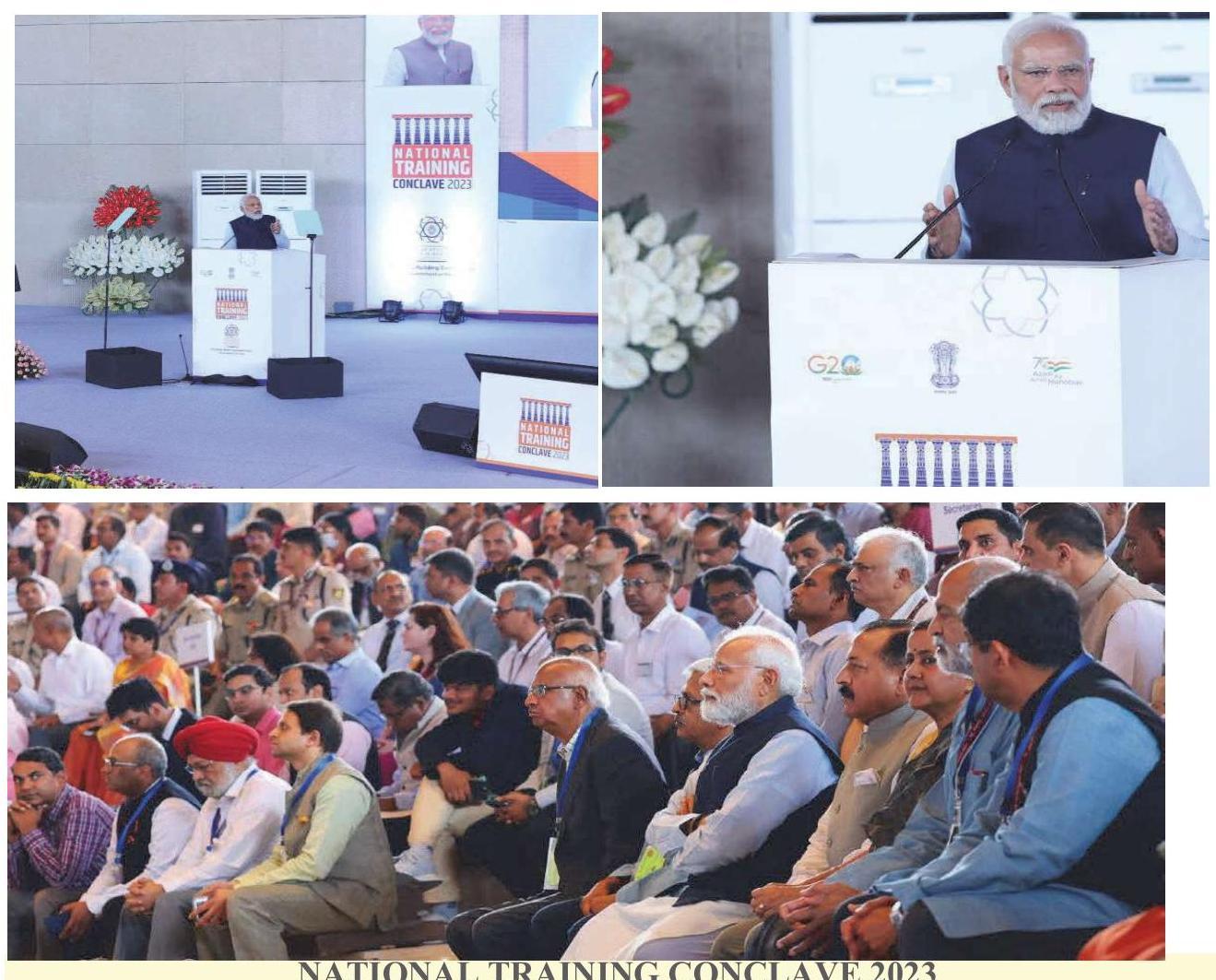
NATIONAL TRAINING CONCLAVE 2023
The iGOT Karmayogi Platform crossed the major milestone of 30 lakh cumulative on-boarded users, during the financial year 2023-24. The Karmayogi Bharat – a Special Purpose Vehicle set up as a Not for Profit 100% Government owned Corporation to own, manage and maintain the digital assets of Mission Karmayogi on behalf of the Government, started functioning from August 2022 and in a short span of 18 months, the intense efforts for outreach and onboarding have yielded significant results.
The engagement of users on iGoT is also showing encouraging progress with the platform crossing 94 lakhs course enrolments and 66 lakh course completions during f.y.2023-24.
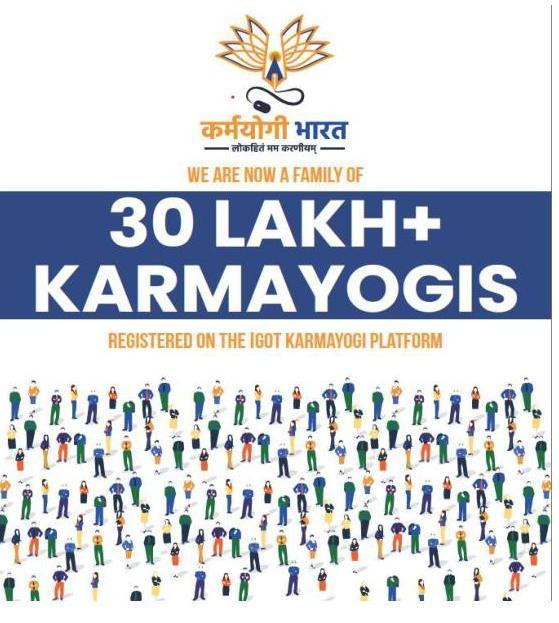
CHAPTER 3
PERSONNEL POLICIES
- Matters relating to framing and amendment of recruitment rules/service rules for Group “A” and “B” posts
- Framing of policy relating to the procedure for Departmental Promotion Committee(s)
- Policy on seniority
- General policy matters relating to: –
(a) Flexible complementing scheme,
(b) Modified Assured Career Progression Scheme,
(c) Lateral entry in Central Government,
(d) Leave travel concession,
(e) Deputation,
(f) Leave,
(g) Pay & allowances,
(h) Holiday policy,
(i) Age relaxation and
(j) Other matters concerning service conditions. - Administration of UPSC and SSC including exams except for the Civil Service Examination
- Policy matters of PESB
- Policy on Verification of Character and Antecedents of candidates selected for appointment to civil posts under the Government of India
- Disagreement cases with UPSC from various Ministries except on appointment cases
- UPSC (Exemption from Consultation) Regulations
- Policy on APAR.
- Commercial employment after retirement
- Policy on
(a) Retirement, extension, re-employment,
(b) Posting and transfers, Conduct and CCA Rules,
(c) Sealed Cover procedure,
(d) Status of Women in Central Government,
(e) Temporary Service Rules, etc.
(f) Lien, Probation, Confirmation,
(g) Daily Wage Casual Labourers
Pers Policy wing deals with formulation of/amendment in policy; interpretation of Policy and subsequent issuance of executive instructions; tendering advice to the Ministries/Departments on various aspects of service matters in respect of Government servants viz. Conduct and Discipline of Government servants, Leave Travel Concession, Age of retirement, Superannuation, Voluntary Retirement, Premature Retirement, Extension in Service/Reemployment, Transfer Policy. Probation/Confirmation, Technical Resignation, Temporary Service Rules, Regularization of Casual Labours etc. Pers Policy Wing also provide guidance to Ministries/Departments in the light of extant instructions on handling of Court cases on the above aspects and issuance of instructions in compliance of the directions of the Courts, if required.
Per. Policy A-III
3.1 Instructions regarding implementation of Aadhar Enabled Biometric Attendance System (AEBAS) for attendance of all Government employees, by various Ministries /Departments/ Organizations.
During a review of implementation of AEBAS, it was observed that a large number of Government employees posted across Ministries/Departments/Organizations of Government of India, despite being registered and active over AEBAS, were not marking their attendance using the System and as such were not adhering to the instructions contained in DOPT’s OM No. 11013/9/2014-Estt(A-III) dated 21.11.2014 and 28.01.2015. Taking a serious note of the inattentiveness/ laxity on the part of Ministries/ Departments/ Organizations and the employees (who are not marking attendance despite being registered and active), it was decided that Ministries/Departments/Organizations (MDOs) shall ensure registration and verification of biometric data in respect of all the employees and also ensure marking of attendance by the employees using AEBAS without fail. MDOs were also requested to make appropriate arrangements, in respect of Divyang employees, for providing easily accessible machines at lower heights or at their desks and for capturing biometrics through Face Recognition Machines.
[Reference DoPT OM No. 11013/13/2023-PP. A-III dated 23.06.2023
3.2 Instructions on Timely submission of Annual Immovable Property Return by the members of Central Civil Services/Posts.
Vide OM dated 14.07.2023, all the Ministries/Departments were instructed to ensure submission of Annual Immovable Property Returns in respect of every calendar year in a time bound manner i.e. by $31^{\text {st }}$ January of the next year. Further, they were also informed that failure on the part of a Government servant to comply with the requirement of this rule can form good and sufficient reasons for instituting disciplinary proceedings against him.
[Reference DoPT OM No. 11013/17/2023-PP. A-III dated 14.07.2023]
3.3 Requirement of completing/clearing a course related to procedural steps for holding Disciplinary Proceedings/ Departmental Inquiries by Inquiring Authorities (IAs)/Inquiry Officers (IOs), on iGOT Karmayogi Platform.
Vide OM dated 11.10.2023, all the Ministries/Departments/Organizations were informed that IAs/IOs appointed in disciplinary cases are now mandated to clear a course related to procedural steps for holding Disciplinary Proceedings/ Departmental Inquiries, on i-GOT Platform (https://igotkarmayogi.gov.in/ or iGOTKarmayogi App) with a view to strengthening the knowledge base and skill of IAs/IOs in handling a Departmental Inquiry. One such course available on the i-GOT Platform is “Conduct of Enquiry in Disciplinary Matters”.
[Reference DoPT OM No. 11012/36/2023-PP. A-III dated 11.10.2023]
3.4 Rule 14 of the CCS(Conduct) Rules, 1964 – Acceptance of Awards by Government servants.
Rule 14 of the CCS(Conduct) rules, 1964 provides that “No Government servant shall, except with the previous sanction of the Government, receive any complimentary or valedictory address or accept any testimonial or attend any meeting or entertainment held in his honour; or in the honour of any other Government servant: provided that nothing in this rule shall apply to- (i) a farewell entertainment of a substantially private and informal character held in honour of a
Government servant or any other Government servant on the occasion of his retirement or transfer or any person who has recently quitted the service of any Government; or (ii) the acceptance of simple and inexpensive entertainments arranged by public bodies or institutions.
Instructions on acceptance of Awards by Government Servants were compiled vide OM No. 11013/22/2023-PP. A-III dated 04.12.2023 and subsequently a clarification on the same was also issued vide OM No. 11017/05/2023-AIS-III dated 21.02.2024. The essence of these instructions is as under:
a. Awards given by Private Bodies/Institutions/Organizations may be accepted only with prior approval of Competent Authority.
b. The Competent Authority for acceptance of Awards by a Government servant would be Secretary of the concerned Ministry/Department.
c. The Competent Authority for acceptance of Awards by Secretaries to Government of India would be the Central Government and for other Officers of the Pay Level 17, the competent authority would be the concerned Ministry/Department.
d. The Competent Authority may grant approval, only in exceptional circumstances subject to the conditions that the award should not have any monetary component in the form of cash and/or facilities and credentials of the Private Bodies/Institutions/Organizations should be unimpeachable.
[Reference DoPT OM No. 11013/22/2023-PP. A-III dated 04.12.2023 and OM No. 11017/05/2023-AIS-III dated 21.02.2024]
Establishment A-IV
3.5 Central Civil Services (Leave Travel Concession) Rules, 1988- clarifications/ modifications in the LTC instructions – reg.
i. Reimbursement of Catering charges in case of LTC – Keeping in view the fact that Indian Railways is now providing options to the traveller to avail catering facility, it has been decided that wherever employees opt for catering services while booking the tickets for the eligible trains for the purpose of LTC, the reimbursement of catering charges shall be allowed.
ii. Reimbursement of Cancellation charges levied by the airlines/travel agents – It has been decided that both types of the cancellation charges, viz. (i) cancellation charges levied by the airlines & (ii) cancellation charges levied by the three authorized travel agents for utilization of their portals/platforms, if any, shall be reimbursed on the ground of official exigencies only.
iii. Booking of Air tickets through three Authorized Travel Agents viz. IRCTC, BLCL \& ATT even in case of the employees not entitled for air travel under LTC -It has been decided that the Government employees not entitled for air travel but wish to travel by air, are no longer required to mandatorily book their air tickets through these three travel agencies viz. M/s Balmer Lawrie \& Company Limited (BLCL), M/s Ashok Travels \& Tours (ATT), Indian Railways Catering and Tourism Corporation Ltd. (IRCTC) only as the reimbursement is restricted to the actual air fare or the entitled train/bus fare for the
shortest route, whichever is less. In case of cancellation of tickets, cancellation charges shall be borne by the Government employees concerned. However, in case of Special Dispensation Scheme, the Government employees not entitled for air travel under LTC, but wish to travel by air to the intended place of visit in NE region, UTs of J&K, Ladakh, A \& N, are required to book their air ticket through three ATAs only.
(Reference DoPT’s OM No. 31011/17/2023-Estt. A-IV dated 10/08/2023)
3.6 Modifications in instructions on booking of Air Tickets on Government Account in respect of Leave Travel Concession (LTC) – reg.
(i) All three authorized travel agents, viz. M/s Balmer Lawrie \& Company Limited (BLCL), M/s Ashok Travels \& Tours (ATT), and Indian Railways Catering and Tourism Corporation Ltd. (IRCTC) are to display the details of the flight having the cheapest fare and the flight(s) having the fare $10 %$ more than the cheapest fare only, in the desired time slot, at the time of booking the air tickets by the Government employees for the purpose of LTC journey. Therefore, the booking of air ticket for the purpose of LTC on the website of these three authorized travel agents shall itself be a proof that the ticket booked by the individual government employee was of the cheapest fare as provided under the guidelines.
(ii) All three authorized agents shall indicate the word ‘LTC’ on tickets issued for the LTC journey; and
(iii) In all cases wherein the non-entitled Government employees are to travel by air under Special Dispensation Scheme directly from their Headquarters/place of posting to the place of visit in NER/J\&K/A\&N/Ladakh, the Government employees shall continue to take the print-out of the concerned webpage having flight and fare details of the flight for relevant railhead viz. Kolkata/ Guwahati/ Delhi/Amritsar/ Chennai/ Vishakhapatnam to the place of visit viz. NER or UT of J\&K or UT of Ladakh or UT of A\&N within the same time-slot where the direct flight has been booked for the purpose of reimbursement. In case the flight tickets are not available in the same slot, the print out of the details of the flights available in the next slot may be retained for the purpose of settlement of claims, as provided under Point (ii) of the title “Provisions for Reimbursement” in DoPT’sOM No. 31011/12/2022Estt. A-IV dated 29.08.2022.
[Reference DoPT’s OM No. 31011/11/2023-Pers. Policy A-IV dated 20/10/2023]
3.7 Relaxation in LTC Rules – delegation of powers to Ministries/Departments regarding time limit for the submission of the claim.
In supersession of DoPT’s OM No. 31011/05/2007-Estt.(A) dated 27.09.2007, it has been decided that the Ministries/ Departments with the concurrence of the Financial Advisers and subordinate/attached offices with the concurrence of Head of Department not below the rank of Joint Secretary, can admit the claim of reimbursement in respect of LTC journey without reference to DoPT with the following time-lines in such cases where a Government servant is not in position to submit the claim within the prescribed time-limit under rule 14 and 15 of CCS(LTC) Rules, 1988 and the Ministries/Departments/attached offices/subordinate offices are satisfied that he/she was not able to do so due to circumstances beyond his/her control:-
i. Cases where no advance is drawn: Up to six months;
ii. Cases where advance is drawn: Up to three months provided the entire advance amount is returned within three months subject to a clause that the entire amount would be recovered within one lumpsum and interest will be charged on the entire amount of advance from the date of drawal to the date of recovery of amount.
[Reference DoPT’s OM No. 31011/18/2023-Estt. A-IV dated 21/12/2023]
3.8 Clarification regarding admissibility of travel by Tejas trains while availing of LTC.
The matter has been examined in consultation with Department of Expenditure (DoE) wherein the DoE informed that Tejas Rajdhani Express Trains are covered under DoE’s OM No. 19030/1/2017-E.IV dated 13.07.2017. Accordingly, vide DOPT’s OM dated 12.01.2024 it is clarified that in addition to trains mentioned in DOPT’s OM No. 31011/8/2017-Estt.A-IV dated 19.09.2017 only Tejas Rajdhani Express Trains are covered. Further, it is also clarified that the reimbursement of ticket fare of Tejas Express trains is not allowed under LTC.
[Reference DoPT’s OM No. 31011/01/2024-Pers. Policy A-IV dated 12/01/2024]
Pers Policy (Leave)
3.9 Instructions were issued regarding grant of Special Casual Leave to Organ Donors vide OM No. 24011/23/2022-Estt. (L) dated 25.04.2023.
3.10 Guidelines were issued regarding Governing Adoption of Children, 2015 under Juvenile Justice (Care and Protection of Children) Act, 2000. Vide OM No. A-24011/6/2023-Estt. (L) dated 26-05-2023.
3.11 Updated version of the Central Civil Services (Leave) Rules, 1972 was uploaded on DOPT website on 18.10.2023.
Pers Policy (Allowance)
3.12 Instructions were issued on reimbursement of Children Education Allowance (CEA) to Central Government servants having Divyang Children vide O.M. No. A-27012/01/2022-Estt. (AL) dated 17.02.2023.
3.13 Instructions were issued on submission of claims for reimbursement of Children Education Allowance vide O.M. No. A-27012/01/2022-Estt. (AL) dated 25.08.2023.
3.14 Instructions were issued on reimbursement of Children Education Allowance and Hostel Subsidy in accordance with New Education Policy 2020 vide O.M. No.A-27012/01/2023Pers.Policy (Allowance) dated 14.03.2024.
Establishment (Pay)
3.15 As part of the effort to simplify the accessibility to the instruction governing the subject matter handled in Pers. Policy (Pay) Division, instruction on the following topic were consolidated and information documents were prepared and finalized during the period on each of these topics:
| Sl No. |
Subject/Details | Date of issuance |
|---|---|---|
| 1. | Deputation of Group A Officers of the Central Government to State Governments/UTs – Modification in guidelines – regarding |
15.03 .2024 |
| 2. | Calculation of monthly contribution towards cost of Pension payable during foreign service |
01.01 .2024 |
| 3. | Transfer on deputation / foreign service of members of All India Services / members of Organised / members of Organised Group A and Group B Services of Central Government |
08.08 .2023 |
| 4. | Urgent review of cases of overstay while on deputation – regarding |
22.03 .2023 |
| 5. | Consolidated guidelines on deputation/foreign service for Central Government employees |
28.03 .2024 |
Pers. Policy (RR)
3.16 As a major reform measure, the entire process of framing/ amendment of Recruitment Rules (RRs) for Group ‘A’ and ‘B’ posts involving approval of Department of Personnel & Training, consultation with Union Public Service Commission, vetting of draft Notification by Legislative Department and publication of notification in the Gazette of India, is being automated through the Recruitment Rules Formulation, Amendment Monitoring System (RRFAMS) portal. Resultantly, the earlier system of sending physical files, which often resulted in considerable delay in finalization of recruitment rules, is being replaced by an online mechanism. The RRFAMS portal was formally launched on 25.12.2016 by Hon’ble Minister of State in the Ministry of Personnel, Public Grievances and Pensions.
3.17 At present, in the process of framing/ amendment of Recruitment Rules for Group ‘A’ and ‘B’ posts, the modules relating to approval by Department of Personnel \& Training and Union Public Service Commission, have been operationalised on the RRFAMS portal. The system of processing proposals for framing and amendment of RRs in the physical mode has been dispensed with. Once the Legislative Department and Directorate of Printing are also on-boarding the system, the entire process would become fully automated.
3.18 To further facilitate user Ministries/ Departments in operation of the RRFAMS portal, a user guide was published in September 2020 on the RRFAMS portal. The launching of RRFAMS portal has significantly improved the timelines for framing the RRs, besides streamlining the process. The average time taken by DoPT for final approval of the draft RRs has been significantly reduced. As on 31.03.2024, over 3000 proposals for framing/ amendment of RRs have been received on the RRFAMS portal, out of which over 1900 proposals have been approved by DoPT.
3.19 Instructions on Revised Flexible Complementing Scheme (RFCS) for Scientists have been issued.
3.20 Lateral recruitment is an initiative of the Government to achieve the twin objective of bringing in fresh talent as well as augment the availability of manpower at middle management levels by appointing persons, at the level of Joint Secretary, Director and Deputy Secretary, for specific assignments keeping in view their specialized knowledge and expertise in their domain area. A total of 33 officers comprising 08 Joint Secretaries, 16 Directors and 09 Deputy Secretaries, appointed through Lateral Recruitment, are in position in various Ministries/ Departments. For LE cycle 2023, 25 officers have been approved for appointment to the posts of Joint Secretary/Director/Deputy Secretary. The list includes 3 Joint Secretaries, 15 Directors and 7 Deputy Secretaries.
Pers. Policy D
Inclusion of Sports Event in the list of events of National Importance for recruitment of meritorious sports persons to any post in Group ‘ $C$ ‘ in Ministries/ Department of Government of India – regarding.
3.21 Consolidated Instructions on Recruitment/Promotions for Sportspersons in Government of India have been updated vide DoPT’s OM No.- 1711450898768 dated 04.03.2024 by including the Sports Events – Khelo India University Games, Khelo India Youth Games, Khelo India Winter Games and Khelo India Para Games in the list of Events of National Importance. Medal Winners in the designated sports/games under the above events would now also be eligible to the considered for recruitment/promotions under Sports Quota.
RECRUITMENT AGENCIES
3.22 The Union Public Service Commission (UPSC) and the Staff Selection Commission (SSC) are the two designated recruitment agencies administered by the Department of Personnel and Training. While the UPSC is a Constitutional body set up under Article 315 of the Constitution, the Staff Selection Commission has been set up by Resolution of the Government and it has the status of an attached office of the Department of Personnel and Training. Both these agencies enjoy the reputation for selecting candidates for the Government services in a fair, objective, and impartial manner. The candidates for the various examinations come from a variety of social environment and having studied in different disciplines.
3.23 UNION PUBLIC SERVICE COMMISSION *
3.23.1 The Union Public Service Commission comprises a Chairman and ten Members. The UPSC makes recruitment for recruitment for All India Service, Group ‘A’ Central Civil Services /posts, and Group ‘B’ Gazetted posts in Ministries/Departments of the Central Government. The Commission also conducts the examination for recruitment of Commissioned officers in the Defence forces. Some Union Territories (UTs) also avail the services of the Union Public Service Commission for recruitment to the posts under the UT.
3.23.2 The functions of the Commission are as specified in Article 320 of the Constitution. By the exercise of powers conferred by the proviso to Article 320 (3) of the Constitution the President has made the UPSC (Exemption from Consultation) Regulations, 1958 as amended from time to time, as respects the All India Services and also as respects other services and posts in connection with the affairs of the Union specifying the matters in which it shall not be necessary for the UPSC to be consulted.
3.23.3 Examination
(a) During the year 2022-23, the Commission conducted a total of 15 examinations under the method of Recruitment by Examination, i.e. 11 examinations for selection to Civil Services/Posts and 04 for Defence Services, against which a total of 33,51,916 applications were received and processed. 5,337 candidates were interviewed for Civil Services/Posts and 22,685 candidates were interviewed for Defence Services/Posts. The interviews for Defence Services were conducted by Services Selection Board (SSB) of Ministry of Defence. A total of 4,195 candidates were recommended for appointment to various posts; 2,721 candidates for Civil Services/Posts and 1,474 candidates for Defence Services/Posts.
(b) Against 1697 posts reserved for SC, ST, OBC and EWS candidates to be filled up under method of Recruitment by Examinations, the Commission recommended 1,409 Candidates, including 93 SC, ST, OBC and EWS candidates, who were recommended against the post reserved for them but at general standard in cases where Reserve List is maintained. The final status will be known after allocation of service upon applying the Reserve List Rule. In addition to above 154 candidates were recommended at general standard, against the unreserved posts, in respect of examinations having no provision of Reserve List.
(c) Under the method of Recruitment by Examination, the offer of appointment is made by the Ministry/Department concerned. A delay in the issues of offer of appointment was reported in 266 cases.
(d) 07 cases of malpractices, committed by the candidates were reported to the Commission relating to suppression of information, submission of false/fabricated documents, possession of mobile phones etc. The Commission took serious note of such cases and after following due process, imposed penalties on the delinquent candidates, ranging from cancellation of their candidature to their debarment up to a period of 10 years from future Examination/ Selections, conducted by the Commission.
(e) Changes implemented during the year 2022-23:
(i) Two new centres i.e. Mandi and Dharamshala in Himachal Pradesh were opened during the financial year 2021-2022 and made operational in respect of CS (P), NDA $& \mathrm{NA}(\mathrm{II}), \mathrm{CDS}(\mathrm{II})$ and $\mathrm{CAPF}(\mathrm{ACs})$ examinations during the financial year 2022-23.
(ii) Almora and Srinagar in Uttarakhand were also made operational in respect of CAPF(ACs) Examination, 2022 held on August 7, 2022.
3.23.4 Direct Recruitment by Selection
(a) The Commission received 233 requisitions for 4,411 posts from various Ministries/ Departments. A total of 1,741 posts against 184 requisitions were advertised during the year and $11,58,128$ applications were received. The recruitment process was cancelled in respect of 11 requisitions for 183 posts, subsequent to the publications of advertisement.
(b) During the year, a total of $10,80,116$ applications were finalized including applications received in the preceding year; 7,913 candidates were called for interview and 6,123 candidates actually appeared for interview. 1,582 candidates were recommended against 1,736 posts requisitioned in 161 cases. The applicant to Post Ratio was 622 and the Recommendation to Post Ratio was 0.91 .
(c) Recruitment Tests were conducted in 29 cases, where the number of applicants was disproportionately high vis-à-vis the number of vacancies.
(d) The process of selection to 154 posts became infructuous due to non-availability of suitable candidates. Most of these posts required specialized medical or engineering qualifications.
(e) As against 935 reserved posts, a total of 815 candidates ( $220 \mathrm{SC}, 110 \mathrm{ST}, 390 \mathrm{OBC}$ and 95 EWS) were recommended. Thus, 87.2 percent of the posts for reserved category were filled up. Besides, 15 SC , six ST, 94 OBC and 21 EWS candidates were recommended for selection against the unreserved posts.
(f) The Commission recommended 38 candidates against 68 posts reserved for Person with Benchmark Disabilities (PwBD). Further, four more PwBD candidates were also recommended for posts suitable for them.
(g) A delay was reported in 48 cases in issue of offer letters of appointment to the candidates recommended by the Commission. By the Ministry/ Department concerned, in certain cases, the Ministry/ Department concerned did not provide information regarding the issuance of the offer letters of appointment to the recommended candidates.
3.23.5 Appointments
(a) The Commission considered the service records of 21,561 officers and made recommendations regarding the suitability of candidates/officials for promotion, deputation, absorptions etc. in respect of 12,879 officers as follows:
(b) 12,749 officers for promotion in Central Services and
(c) 130 officers for appointment on Deputation (ISTC)/Absorption.
(d) Advice letters were issued to the Ministries/ Departments concerned in 502 DPC cases and in 179 Deputation cases (including 74 infructuous cases).
3.23.6 Recruitment Rules
(a) Advice of the Commission on 329 proposals relating to framing / amendment of Recruitment Rules [including 7 Service Rules and 26 one-time mode of recruitment] were issued during the year.
(b) Out of 329 proposals, 295 proposals were processed online on Recruitment Rules Formulation, Amendment Monitoring System (RRFAMS) portal whereas 34 proposals were processed in offline mode.
3.23.7 Disciplinary Cases
(a) In order to handhold various State Public Service Commissions (SPSCs) on “Processing and Handling of Disciplinary Cases”, a workshop was conducted by the Commission for the officers of SPSCs. The workshop was attended by representatives from 12 SPSCs, wherein a detailed presentation was made. The workshop achieved its objectives considering the enthusiastic response by the participants and their feedback.
(b) Commission has been able to reduce the pendency from 323 cases at the end of previous Financial Year (F.Y.) 2021-22 to 231 cases at the end of F.Y. 2022-23. Thus, there is a reduction of over $28 %$ in pendency of disciplinary cases during the F.Y. 2022-23 as compared to pendency at the end of previous F.Y.
3.23.8 Pursuant to the decision taken in the $23^{\text {nd }}$ National Conference of Chairpersons of State Public Service Commissions held on April 15-16, 2022 in Thiruvananthapuram, Kerala, the Commission organized the following Workshop: –
(a) “Workshop on “Disciplinary Proceedings”
A Workshop on “Disciplinary Proceedings” was conducted on 07.09.2022 for officers of State PSCs in UPSC. The workshop was attended by 19 participants for 11 States Public Service Commissions.
(b) “Workshop on Recruitment Rules” & “Recruitment for Persons with Disabilities”
Workshops on “Recruitment Rules” and “Recruitment for Persons with Disabilities” were conducted on 10.11.2022 \& 11.11.2022 respectively for officers of State PSCs. The workshops were attended by 23 participants from 12 State Public Service Commissions.
3.23.9 Visit of Foreign Delegation
An eleven-member delegation led by Mr. Mohamed Nasih, President, Civil Service Commission, Maldives along with four officers of National Centre for Good Governance (NCGG) visited the Commission on 15.06.2022.
3.23.10 Progressive use of Hindi in official work
Hindi Branch of Union Public Service Commission has remained engaged in making sincere and concerted efforts to ensure the compliance with the provisions of the Official Language Act/Rules and various orders/ instructions issued by the Department of the Official Language from time to time regarding the progressive use of Hindi for official purposes.
3.23.11 Implementation of Government’s Language Policy and programme
Hindi Branch in the UPSC is under the charge of a Director (Official Language) with two Deputy Directors (Official Language), four Assistant Directors (Official Language) and other supporting staff. Apart from guiding and monitoring the implementation of the Official Language policy and programmes of the Government, this Branch also performs the work relating to the translation of documents, which are required to be issued in Hindi or bilingually, as per rule.
3.23.12 Official Language Implementation Committee
There is an Official Language Implementation Committee in UPSC duly constituted under the Chairmanship of Secretary and all the branch-heads of UPSC are its members. All the decisions regarding use of Hindi in office and discussions on shortcomings, if any, in achieving the target fixed every year by Department of Official Language, are made in this meeting. During 2022-23, four meetings of the Official Language Implementation Committee were held in the Commission and necessary follow-up actions were taken to implement the decisions of the Committee.
3.24 Staff Selection Commission
A. Introduction
3.24.1 The Staff Selection Commission is one of the largest recruiting agencies in India in terms of the number of candidates who apply for various posts in the Central Government.
The Staff Selection Commission is mandated with the task of making recruitment to all Group ‘B’ (Non-Gazetted) and Group ‘C’ (Non-Technical) posts in various Ministries / Departments of the Government of India and their Attached and Subordinate Offices except those posts which are specifically exempted from the purview of the Commission. In addition, the Commission, from the year 2016, has been assigned the additional responsibility of making recruitments to Group ‘B’ (Gazetted) posts of Assistant Accounts Officer and Assistant Audit Officer for the Indian Audit and Accounts Department. Further, in the year 2021, the Staff Selection Commission has been entrusted with the responsibility of conducting recruitment examinations for the vacant Group ‘B’ (Non-Gazatted) and Group ‘C’ posts in Constitutional / Statutory bodies and the Union Territory (UT) of Ladakh.
B. EXAMINATIONS CONDUCTED BY THE COMMISSION
3.24.2 The Commission is mandated to conduct the following Examinations:
I. Combined Graduate Level Examination;
II. Combined Higher Secondary (10+2) Level Examination;
III. Junior Engineer (Civil, Mechanical and Electrical) Examination;
IV. Sub Inspectors in Delhi Police, and Central Armed Police Forces Examination;
V. Junior Hindi Translator, Junior Translator and Senior Hindi Translator Examination;
VI. Stenographer’s Grade ‘C’ & ‘D’ Examination; and
VII. Multi-Tasking (Non-Technical) Staff Examination.
3.24.3 Non-mandated Examinations: In addition to the above, the Commission also conducts non-mandated Examinations on the specific directions of the Government. Such Examinations are conducted on Memorandum of Understanding basis.
3.24.4 Departmental Examinations: Besides, the Commission also conducts three Limited Departmental Competitive Examinations.
(i) Junior Secretariat Assistant / Lower Division Clerk Grade Limited Departmental Competitive Examination.
(ii) Senior Secretariat Assistant / Upper Division Clerk Grade Limited Departmental Competitive Examination.
(iii) Grade ‘C’ Stenographers Limited Departmental Competitive Examination.
3.24.5 Selection Posts: The Commission is also mandated to conduct examinations for recruitment to Selection Posts, which are isolated posts (not covered under All India Open Competitive Examinations) for Group ‘B’ (Non-Gazetted) and Group ‘C’ (Non-Technical) posts in different Ministries / Departments of the Government of India and their Attached and Subordinate Offices. These posts were earlier filled only through interviews. As interviews for lower level posts have been dispensed with by the Government of India w.e.f. 01.01.2016, the said posts are now filled through written examinations conducted in the format of Objective Type Multiple Choice Questions in Computer Based Mode (CBM).
C. MEASURES ADOPTED IN THE EXAMINATION SYSTEM
3.24.6 Introduction of Computer Based Mode (CBM) of Examination for conduct of various examinations by the Staff Selection Commission.
In June 2016, the Commission adopted the Computer Based Mode for the conduct of its Objective Type Multiple Choice Examinations. Earlier these examinations were conducted in the conventional Optical Mark Reader (OMR) Based Mode. The Computer Based Mode of examination has the following strategic advantages: –
(i) The Computer Based Mode of Examination is more effective and with adequate safeguards in place, the said modality is more reliable, efficient and robust.
(ii) Human intervention is minimal which reduces the chances of the examination being compromised.
(iii) There is greater flexibility and higher confidentiality in the administration and management of Question Papers.
(iv) There is greater accuracy and faster processing of results.
(v) This mode also facilitates better data management and analysis for generating reports.
3.24.7 Online System for receipt of applications, vacancy collection, declaration of results and related activities
(i) As an initiative to achieve full digitization, the Commission introduced the system of online application, in phases from the year 2010. At present, the Commission receives applications for all its examinations only online.
(ii) The Commission uploads notices of various examinations on its website. Starting with Combined Graduate Level Examination, 2021, the Commission has started providing a Window for Application Form Correction after the closing date for receipt of online applications to enable the candidates to correct / modify online application parameters. During the Window for Application Form Correction, the candidates are allowed to submit applications after making requisite corrections / changes in the one-time registration / online application data as per their requirement.
(iii) The online collection of vacancies from various Ministries / Departments of the Government of India has been made mandatory.
(iv) Admit Cards of the candidates are hosted on the websites of the Regional Offices of the Commission.
(v) Similarly, after the conduct of the written examination in the CBM, challenges on the Tentative Answer Keys are invited online. Thereafter, Final Answer Keys are hosted on the website of the Commission.
(vi) Results of all examinations, including results of intermediary stages / tiers are also declared on the website of the Commission. In addition, intimation regarding Document Verification and Skill Test, wherever applicable, are uploaded on the website.
(vii) The responses of candidates, Final Answer Keys and scores of the candidates for their Computer Based Examinations are also uploaded on the website of the Commission. Candidates can view their response sheets and scores individually by logging in using their unique credentials.
(viii) The comprehensive adoption of the online mode for various exam related activities of the Commission has brought about systemic improvements in the examination process contributing to higher standards of diligence and efficiency in the conduct of examinations.
(ix) In addition, communication with the candidates, if required at short notice, is also done through e-mails / SMS, etc.
3.24.8 Reforms in the Recruitment Process
(i) The Staff Selection Commission (SSC), with the approval of Department of Personnel & Training (DoP\&T), had constituted an Expert Committee (EC) for review of scheme and syllabus of examination to be conducted by SSC. The Committee submitted its report on 08.08.2022. After the approval of DoP\&T, the recommendations of the Committee were adopted and the same was applied with effect from the notice of Combined Graduate Level Examination, 2022 published on 17.09.2022. The major changes following the implementation of the recommendations of the Committee are as under.
a) The number of tiers of the examinations conducted by SSC has been reduced.
b) Following the recommendations of the Committee, the Commission has removed descriptive paper from All India open competitive examinations except Junior Hindi Translator Exam.
c) The scheme and syllabus of examinations have also been changed based on the recommendations of the Committee.
d) The Commission has started conducting 12th level and 10th level examinations in multiple languages.
e) From 2022 series of exams, Document Verification (DV) is being conducted by User Departments only.
(ii) Due to cumulative effects of the various reform measures taken, including the ones following the recommendations of the Expert Committee, there has been a reduction in the recruitment cycles of various examinations. Whereas earlier, the average time taken for Combined Graduate Level and Combined Higher Secondary Level Examination right from the Tier-l stage to the declaration of final result has been approximately 12 15 months, this has come down to $6-7$ months during the mission mode recruitment.
3.24.9 Measures for the benefit of Persons with Disabilities (Divyangjan)
The Commission extends the facility of providing scribes for Written Examination / CBM of Examination to the candidates having benchmark disabilities in the category of blindness, locomotor disability (Both Arms Affected-BA) and Cerebral Palsy, if desired by the candidates in their online applications. In addition, for the remaining categories of persons with benchmark disabilities (as prescribed in DoP\&T OM No.36035/02/2017-Estt.(Res) dated $15^{\text {th }}$ January, 2018), if desired by the candidates in his / her online application, a scribe is provided on production of a certificate from the Chief Medical Officer / Civil Surgeon / Medical Superintendent of a Government Health Care Institution in the specified proforma at the time of the examination to the effect that the person concerned has physical limitation and scribe is essential to write the examination on his / her behalf. Compensatory time of 20 minutes per hour is also provided to such candidates. The VH candidates are also provided with the facility of Passage Readers during the Skill Test.
The Commission ensures that the VH candidates are administered separate sets of questions on Quantitative Aptitude and General Intelligence which do not have components of Maps, Graphs, Statistical data, Diagrams, etc.
The Commission makes a conscious effort to provide PwD candidates, an easy, safe and hassle-free access to the venues of examination. To ensure this, the PwD candidates are allocated to such venues which are provided with user friendly facilities like elevators/lifts and ramps, etc. PwD candidates, who seek assistance of scribes, are allotted specific venues on a separate date.
3.24.10 Transparency in Governance
As a premier Recruiting Agency, the Commission maintains a high standard of integrity, discipline and efficiency in the conduct of its examinations to ensure merit-based selection.
The Commission also maintains transparency in its processes. The Commission has put in place a robust grievance redressal mechanism wherein references received through CPGRAMS, RTI or any other mode of communication are addressed on priority with due weightage assigned to the quality of replies.
3.24.11 Candidates registering with the Commission
Total number of candidates registered for various Examinations of the Commission during 2023-24 is as under:
| Sl. No. |
Name of Examination | Date of Examination | Registered Candidates |
|---|---|---|---|
| 1 | Stenographer Grade ‘C’ & ‘D’ ReExamination, 2022 | 25/04/2023 \& 26/04/2023 | 498884 |
| 2 | Multi-Tasking Staff (NonTechnical) and Havildar (CBIC \& CBN) Examination (Paper-I), 2022 | 02/05/2023 to 19/05/2023 \& 13/06/2023 to 20/06/2023 | 5521917 |
| 3 | Selection Post Phase XI-2023 | 27-06-2023, 28-06-2023 \& 30-062023 | 1407701 |
| 4 | Combined Graduate Level Exam2023 | 14-07-2023 to 27-07-2023 | 2527369 |
| 5 | Combined Higher Secondary Level Exam-2023 | 02.08.2023 to 22.08.2023 | 3217298 |
| 6 | Multi-Tasking Staff (NonTechnical) and Havildar (CBIC \& CBN) Examination, 2023 | 01.09.2023 to 14.09.2023 | 2608167 |
| 7 | Sub-Inspector in Delhi Police and CAPFs Examination, 2023 | 03.10.2023 to 05.10.2023 | 834466 |
| 8 | Junior Engineer (Civil, Mechanical, Electrical and Quantify Surveying \& Contracts) Examination 2023 | 09.10.2023 to 11.10.20223 | 593027 |
| 9 | Stenographer Grade “C” \& “D” Examination, 2023 | 12.10.2023 to 13.10.2023 | 508538 |
| 10 | Junior Hindi Translator, Junior Translator and Senior Hindi Translator Examination, 2023 | 16.10.2023 | 8126 |
| 11 | Constable (Executive) Male and Female in Delhi Police Examination 2023 | 14.11.2023 to 03.12.2023 | 3243083 |
| 12 | Grade ‘C’ Stenographer Limited Departmental Competitive Examination- 2018-19 | 06.02.2024 | 823 |
| 13 | Grade ‘C’ Stenographer Limited Departmental Competitive Examination- 2020, 2021 \& 2022 | 06.02.2024 | 1187 |
| 14 | SSA / UDC Grade Limited Departmental Competitive Examination- 2018-2019 | 07.02.2024 | 109 |
| 15 | SSA / UDC Grade Limited Departmental Competitive Examination- 2020, 2021 \& 2022 | 08.02.2024 | 360 |
| 16 | JSA / LDC Grade Limited
Departmental Competitive Examination- 2019-2020 | 09.02.2024 | 940 |
| — | — | — | — |
| 17 | Constable (GD) in CAPFs, NIA, SSF, and Rifleman (GD) in Assam Rifles Examination, 2024 | 20.02.2024 to 07.03.2024 | 47,35,500 |
| 18 | JSA / LDC Grade Limited
Departmental Competitive Examination- 2021-2022 | 04.03.2024 | 1907 |
| | | Total | 2,57,09,402 |
Candidates selected by the Commission
3.24.12 During the Financial Year 2023-24, the Commission has recommended 1,41,487 candidates to various User Ministries/Departments. Details in this regard are given in the table below:-
| Sl. No. | Name of Examination | Date of Declaration of Result | Candidates
Selected |
| — | — | — | — |
| 1 | Combined Higher Secondary (10+2) Level Examination, 2021 | 27.04.2023 | 5998 |
| 2 | Combined Graduate Level Examination, 2022 | 13.05.2023 | 36001 |
| 3 | Junior Engineer (Civil, Mechanical, Electrical and Quantity Surveying & Contracts) Examination, 2022 | 24.05.2023 | 2798 |
| 4 | Stenographer Grade ‘C’ and ‘D’ Examination 2022 | 14.07.2023 | 3960 |
| 5 | Combined Higher Secondary (10+2) Level Examination, 2022 | 07.08.2023 | 3242 |
| 6 | Sub-Inspector in Delhi Police and CAPFs Examination, 2022 | 16.08.2023 | 4276 |
| 7 | Constable (GD) in Central Armed Police Forces (CAPFs), SSF, Rifleman (GD) in Assam Rifles and Sepoy in Narcotics Control Bureau Examination, 2022 | 20.08.2023 | 46554 |
| 8 | Multi-Tasking (Non-Technical) Staff, and Havaldar (CBIC \& CBN) Examination, 2022 | 18.10.2023 | 11450 |
| 9 | Combined Graduate Level Examination, 2023 | 06.12.2023 | 7859 |
| 10 | Constable (Driver) Male in Delhi Police Examination, 2022 | 09.12.2023 | 1400 |
| 11 | Multi-Tasking (Non-Technical) Staff, and Havaldar (CBIC \& CBN) Examination, 2023 | 18.12.2023 | 1786 |
| 12 | Head Constable (Assistant Wireless Operator ((AWO)/Tele-Printer Operator (TPO)] in Delhi Police Examination, 2022 | 21.12.2023 | 832 |
| 13 | Head Constable (Ministerial) in Delhi Police Examination, 2022 | 27.12.2023 | 811 |
|---|---|---|---|
| 14 | Junior Engineer (Civil, Mechanical and Electrical) Examination, 2023 | 05.01 .2024 | 1374 |
| 15 | Constable (Executive) Male and Female in Delhi Police Examination, 2023 | 24.01.2024 | 6976 |
| 16 | Stenographer Grade “C” and ‘D’ Examination, 2023 | 08.02.2024 | 1223 |
| 17 | Combined Higher Secondary Level, Examination, 2023 | 28.02.2024 | 1211 |
| 18 | Junior Hindi Translator, Junior Translator & Senior Hindi Translator Examination, 2023 | 01.03 .2024 | 296 |
| 19 | Constable (GD) in CAPFs, NIA, SSF and Rifleman (GD) in Assam Rifles Examination, 2022 | 21.03.2024 | 418 |
| 20 | Selection Posts/ Phase-VIII/ 2020 Examination | Final results is declared post wise by Regional Offices | 124 |
| 21 | Selection Posts/ Phase-IX 2021 Examination | Final results is declared post wise by Regional Offices | 1025 |
| 22 | Selection Posts/ Phase-X/ 2022 Examination | Final results is declared post wise by Regional Offices | 1176 |
| 23 | Selection Post Phase-XI/ 2023 Examination | Final results is declared post wise by Regional Offices | 46 |
| 24 | Selection Post Phase/Ladakh/2022 Examination | Final results is declared post wise by Regional Offices | 651 |
| Total | 1,41,487 |
3.24.13. Progressive use of Hindi in Commission’s work
During the period under review, provision of section 3(3) of Official Language Act, 1963 and Official Language Rule, 1976 were duly complied with. All the notices of various examinations published during the period were issued bilingually and the emphasis was laid on increasing the original correspondence in Hindi with three regions namely $\mathrm{A}, \mathrm{B}$ and C as per target prescribed by the Department of Official Language.
Three Regional Offices of Staff Selection Commission namely Prayagraj (Region-A), Chandigarh (Region-B) and Guwahati (Region-c) were awarded the Rajbhasha Shield under the scheme of commendable work in Official Language Hindi for the year 2022-23. In the year 202223, Ten officials were awarded under the scheme of Original Work in Hindi and Confidential 1/2 Section of this Commission was awarded Rajbhasha Running Shield for the year 2022-23.
In order to encourage the progressive use of Hindi in the Official work and to create interest among officers/officials for its usage, Hindi Software supported by Unicode compliance is being used. All Regional offices of the Commission along with Headquarter are using this Hindi Software/Fonts. The Hindi Fortnight event was organized from 14th September, 2023 to 29th September, 2023. During the fortnight various competitions like Hindi Typing, Hindi Story Writing, Noting and Drafting, Hindi Dictation, Hindi Essay and Debate competitions were organized. The winners were awarded by the Hon’ble Chairman, SSC (HQ) in a prize distribution function organized on $17^{\text {th }}$ October, 2023. During the period under review, Hindi workshops were also organized on $16.05 .23,26.09 .23,26.12 .23$ and 15.03 .24 , in which $19,15,11$ and 19 Officers/Officials respectively participated.
In a major initiative taken by the Commission towards Rajbhasha implementation, an eMagazine of the Commission named “Naya Jharokha” was launched during the year 2022-23. The $3^{\text {rd }}$ edition of the above Magazine was released online on 07.06.2023.
3.25 NATIONAL RECRUITMENT AGENCY
A. Introduction
3.25.1 The National Recruitment Agency (NRA) has been registered as a Society under the Societies Registration Act, 1860 with its HQ in Delhi. NRA has been set up to conduct the Common Eligibility Test (CET) for subordinate posts as per the DoPT order dated 28.08.2020. NRA aims to conduct Common Eligibility Tests (CET) to shortlist the candidates for vacancies of Group B Non Gazetted posts, Group B Gazetted posts which are exempted from consultation with UPSC; Group C posts in the Government and equivalent posts (where no such classifications exist) in instrumentalities of the Government, through a computer-based test (Tier-1 Examination).
B. Major Objectives of NRA
- To mitigate the hardship faced by candidates who have to appear for multiple examinations conducted by multiple agencies, where similar eligibility conditions have been prescribed.
- To bring in savings to the candidates towards multiple application fees and travelling cost to appear in these examinations.
- To reduce the time taken in the selection process.
- To facilitate employment generation- In the longer run, the CET score could be shared with other recruiting agencies in the Central Government, State Governments/ Union Territories, Public Sector Undertaking and Private Sector on MOU/Cost sharing basis, for appointment in their organizations. This would help such organizations in saving costs and time spent on recruitment.
C. Organizational Structure of NRA
The following is the organizational structure of NRA.
| SI No |
Name of the post | Pay level (7 th CPC) |
Number posts |
of of |
Current Position |
|---|---|---|---|---|---|
| 1 | Chairman | 17 | 01 | 01 | |
| 2 | Secretary cum CoE | 14 | 01 | 01 | |
| 3 | Director | 13 | 03 | 01 | |
| 4 | Deputy Secretary | 12 | — | 02 | |
| 5 | Deputy Director (Under Secretary Level) |
11 | 07 | 0 | |
| 6 | Assistant Director | 10 | — | 0 | |
| 7 | Sr PPS (for Chairman Office) | 12 | 01 | 0 | |
| 8 | PPS (for Secretary Cum CoE office) |
11 | 01 | 0 | |
| 9 | Stenographer Grade C | 07 | 04 | 0 | |
| 10 | Executives (ASO) | 07 | 15 | 05 | |
| Total | 33 | 10 |
D. The Proposed Examination Scheme
a. Dr. Shruti Singhal has been appointed as Deputy Secretary on $24^{\text {th }}$ May 2023.
b. DoPT vide its order F. No. 39020/14/2023-Estt.(B) dated 18.10.2023 has mandated National Recruitment Agency to formulate Normative Standards and Guidelines for conduct of Computer Based Tests (CBT) by Central Government and its agencies for recruitment to various posts and admission to Under Graduate/Post Graduate Courses.
c. NRA has already started the work of preparation of Standards and Guidelines. Consultation with all the stakeholders (eg. SSC, IBPS, RRBs, NTA,) including private service providers is being carried out.
d. The $3^{\text {rd }} \mathrm{GB}$ meeting of NRA has been held on 31.10 .2023 , where the GB noted the provision of DoPT order dated 18.10.2023 regarding normative standard guidelines and resolved that NRA should take up the task on the priority basis and should carry out extensive consultants before preparing guidelines.
e. The 4th GB meeting was also held on $14^{\text {th }}$ March 2024. The GB was apprised on the present activities being undertaken by NRA.
3.26 Public Enterprises Selection Board
3.26.1 The Public Enterprises Selection Board (PESB) is a high-powered body set up by a Resolution of Government of India, Ministry of Finance dated 30.08.1974 to evolve a sound managerial policy for Central Public Sector Enterprises (CPSEs) and in particular, to advise the Government on appointments to the top management posts. The PESB functions as a professional body with a large measure of autonomy. The PESB is headed by Part – Time Chairperson with three Members.
3.26.2 The PESB is not merely an interview Board and can, also, constitute itself into a Search Committee to look out for and identify suitable persons who can be appointed to Level-I and Level-II posts in CPSEs.
3.26.3 The policy of the Government is to appoint through a fair and objective selection procedure outstanding professional manager to Level-I and Level-II posts and posts at any other level, as may be decided by the Government from time to time. Government has recognised the need to develop a cadre of professional managers within the public sector. Hence, unless markedly better candidates are available from outside, internal candidates, employed in CPSEs, will be preferred for appointment to Board Level posts. However, if internal candidates are not available, preference will be given to candidates working in other CPSEs, wither in the same area of business or in the other areas. Mobility of managerial personnel among CPSEs within the same sector or group, failing which mobility within the public sector as a whole will be encouraged, subject to certain limitations. Vide GoI notification dated 20.06.2023, in special cases, Group ‘A’ officers of the Central Government including All India Services (AIS) & Armed Forces of India and officers in equivalent rank / grade from Public Sector Bank / Financial Institutions / Autonomous Bodies, etc. subject to fulfilling the eligibility criteria, can also be considered as non-internal candidates.
3.26.4 Candidates from State Public Sector Enterprises and the private sector subject to fulfilling the eligibility criteria, can also be considered as non-internal candidates along with the candidates of other public sector enterprises for a period of five years with effect from 10.06.2021.
3.26.5 Under special circumstances, the appointment to a particular post or posts in a CPSE may be made other than through PESB with the prior and specific approval of the Government.
3.26.6 For sick and potentially sick CPSEs, the Administrative Ministry / Department concerned, in consultation with PESB could take a decision at any stage in the process of recruitment to the post of Chairman, Managing Director or Chairman-cum-Managing Director of the CPSE, to take a person on deputation from any of the All India or Group ‘A’ Central Services without insisting on the rule of immediate absorption.
Constitution of the Board
3.26.7 The PESB consists of a part-time or full-time Chairperson and three full-time Members. The Chairperson and Members are persons who have had a long and distinguished career in management of Public or Private Corporation or Public Administration and have proven record of achievements, preferably, in the field of personnel, finance, production or marketing. The three full-time Members of PESB may be:
3.26.8 A distinguished serving or former Chief Executive of a Public Sector or Private Sector or Joint Sector Enterprises.
3.26.9 A distinguished person with experience in selection of Top Management personnel.
3.26.10 A distinguished serving or former Civil servant with experience in management of PSEs or in areas of finance, industry or economic affairs.
3.26.11 The specific functions assigned to the PESB include the following:
(i) To be responsible for the selection and placement of personnel in the posts of Chairman, Managing Director or Chairman-cum-Managing Director (Level-I), and functional Directors (Level-II) in CPSEs as well as in posts at any other level as may be specified by the Government;
(ii) To advise the Government on matters relating to appointments, confirmation or extension of tenure and termination of services of the personnel of the above-mentioned levels;
(iii) To advice the Government on the desired structure at the Board Level, and for senior management personnel, for each CPSE or group of CPSEs;
(iv) To advice the Government on a suitable performance appraisal system for both the PSEs and the managerial personnel in such enterprises;
(v) To build a data bank containing data relating to the performance of PSEs and its officers;
(vi) To advice the Government on formulation and enforcement of code of conduct and ethic for managerial personnel in PSEs;
(vii) To advice the Government on evolving suitable training and development policies for management personnel in PSEs.
3.26.12 Action taken by PESB during the year 2023-24 from April 1, 2023 to March 31, 2024.
The achievements made during the period under report are as follows:
| S. No. |
||||
|---|---|---|---|---|
| 1 | Selection Process | No. of Advertisements issued | No. of Selection Meetings held | No. of Posts where recommendations were made |
| 86 | 89 | 84 | ||
| 2 | Joint Appraisal for non-extension / non-confirmation of tenure | I. Director (Finance), MSTC II. Director (CFA), BSNL III. Director (CP&P), HSL IV. Director (Works), IRCON |
||
| 3 | Creation of posts / bifurcation of Board | M/o Power vide order no. 15-22/14/2022-HYDEL-II(MoP) dated 27.09.2023 conveyed that the existing posts of Director (Civil) and Director (Electrical) in SJVN Ltd. stand merged into one post with its nomenclature as Director (Projects), SJVN. | ||
| 4 | Creation / Categorization of CPSEs |
Schedule up gradation (Re-categorization) of the following CPSEs was examined (i) Numaligarh Refinery Limited (ii) Cochin Shipyard Limited (iii) REDA |
CHAPTER: 4
RESERVATION IN THE CENTRAL GOVERNMENT SERVICES
MANDATE
Based on the policy decision taken by the concerned nodal Ministries/Departments, DoPT issues instructions on the matters regarding reservation in posts and services in Central Government for the following: –
- $\quad$ Scheduled Castes, Scheduled Tribes & Other Backward Classes;
- Economically Weaker Sections who are not covered under the scheme of reservation for SCs, STs and OBCs;
- Persons with Benchmark Disabilities;
- Ex-servicemen.
4.0 The Government has taken several steps for the upliftment and welfare of the Scheduled Castes (SCs), the Scheduled Tribes (ST) and Other Backward Classes (OBCs). One such welfare measure, as per Constitutional provisions, is to give them reservation in services under the State. Persons with Benchmark Disabilities (PwDs), Ex-servicemen and Economically Weaker Sections (EWS), also get the benefit of reservation in services.
RESERVATION FOR SCs, STs AND OBCs:
4.1 Clause (4) of Article 16 of the Constitution of India enables the State to make provision for reservation in appointments or posts in favour of any backward class of citizens which, in the opinion of the State, is not adequately represented in the services under the State. Clause (4A) of the same Article enables the State to provide reservation for the members of the SC and ST in the matters of promotions. Article 335 provides that the claims of the members of the SC and the ST shall be taken into consideration, consistently with the maintenance of efficiency of administration, in the making of appointments to services and posts in connection with the affairs of the Union or of a State.
4.2 In consonance with the powers given by the Constitution, the Government has issued various instructions, from time to time, providing for reservation in services for the members of the SCs, the STs and the OBCs. Such members of OBC, who fall in creamy layer, however, do not get the benefit of reservation. The income limit for determining the creamy layer status amongst the OBCs to exclude the socially advanced persons/sections is presently Rs.8.0 lakh per annum.
4.3 Reservation to SCs, STs, OBCs and EWS, in case of direct recruitment, is available in all groups of posts. When direct recruitment is made on all India basis by open competition, reservation for SCs, STs and OBCs is $15 %, 7.5 \%$ and $27 \%$ respectively, and when direct recruitment is made on all India basis otherwise than by open competition, it is $16.66 \%, 7.5 \%$ and $25.84 \%$, respectively.
4.4 In case of direct recruitment to Groups C and the erstwhile Group D posts, normally attracting candidates from a locality or a region, percentage of reservation for SCs and STs is generally fixed in proportion to the population of SCs and STs in the respective States/UTs. Reservation for OBCs, in such cases, is fixed keeping in view their proportion in the population of the State/UT subject to the maximum at $27 \%$. Further it is subject to the condition that total reservation for SCs, STs and OBCs does not exceed the limit of $50 \%$, prescribed by the Nine Judges Constitutional Bench of the Hon’ble Supreme Court in the Indira Sawhney Judgment.
4.5 Relaxations and concessions are given to SC and ST candidates with a view to increasing their representation in services. They get relaxation in upper age limit and exemption from payment of fees. They also get unlimited number of chances within the relaxed age limit prescribed for appearing in the competitive examinations.
4.6 Likewise, the OBC candidate get concession like relaxation in upper age Limit upto three years, relaxation in number of chances up to nine within the relaxed age limit for appearing in the Civil Services Examination etc. The SC/ST/OBC candidates appointed on their ‘own merit’ are adjusted against unreserved vacancies.
4.7 In case of promotion, the reservation is provided to SCs and STs only which is $15 %$ and $7.5 \%$ respectively. Further, SC and ST candidates appointed by promotion on their own merit and seniority and not owing to reservation or relaxation of qualifications will be adjusted against unreserved points of reservation roster, irrespective of the fact whether the promotion is made by selection method or non-selection method. However, the Office Memorandum, dated 13.8.1997, providing ‘reservation in promotions’ and the Office Memorandum, dated 10.8.2010, relating to ‘promotion of SCs/STs on own merit’ are under challenge and presently subjudice before the Hon’ble Supreme Court. In the SLP No. 30621/2011 titled “Jarnail Singh & Ors. vs. Lachhmi Narian Gupta \& Ors. Hon’ble Supreme Court has delivered a judgement in Jarnail Singh Case on 28/01/2022 in which Hon’ble Supreme Court has clarified some issues which have emanated from its erstwhile judgment in M. Nagaraj case. However, the Hon’ble Supreme Court has not expressed any opinion on the merits of any individual case. In pursuance of the aforesaid judgment in Jarnail Singh Case, an OM dated 12/4/2022 has been issued by DoPT vide which Ministries/Departments has been requested to fulfil certain conditions before making reservation in promotion which inter alia include, collection of quantifiable data regarding inadequacy of representation of SC \& ST and applicable of the said data to each cadre separately.
4.8 Quantum of reservation for the SCs, STs and OBCs in any grade/cadre is determined on the basis of number of posts in the grade/cadre. However, in small cadres having less than 14 posts, where it is not possible to give reservation to all the three categories on the basis of this principle, reservation is provided by rotation by way of L-Shaped 14-Point rosters prescribed by Department of Personnel and Training Office Memorandum No.36012/2/96-Estt. (Res.), dated 2.7.1997.
4.9 As per the guidelines or instructions issued by DoPT, all Ministries/Departments are required to appoint/nominate Liaison Officers at the least the rank of Deputy Secretary and setting up of special Reservation cell for enforcement of orders of reservation in posts and services of the Central Government. The Liaison Officer has been assigned the duty of ensuring proper implementation of reservation orders, conducting annual inspection of reservation register/roster registers maintained in the Ministries/Departments/Offices, reporting the case of negligence or lapses in the matter of following reservation and orders relating to it coming to light through inspections carried out by him/her to the concerned Secretary/Additional Secretary/Head of Department etc. In offices and organizations under the control of the Ministries/Departments also, a Liaison Officer is required to be nominated in the same matter as is existing in the Ministries/Departments.
4.10 Instructions have been issued on $13^{\text {th }}$ February, 2014 wherever a Selection Committee/Board exists or has to be constituted for making recruitment to 10 or more vacancies in any level of posts or services, it is mandatory to have one member belonging to SC/ST, one member belong to OBC and one member belonging to Minority Community in such Committees/Boards. One of the members of the Selection Committee/Board, whether from the general category or from the minority community or from SC/ST/OBC, should be a lady failing which a lady member should be co-opted on the Committee/Board. It is also to be ensured that
where the number of vacancies against which selection is to be made is less than 10, no effort should be spared in finding a Scheduled Caste/Scheduled Tribe/Other Backward Class Officer, a Minority Community officer and a lady officer for inclusion in such Committees/Boards.
4.11 Reservation for ex-servicemen and Persons with Benchmark Disabilities is termed as “horizontal” reservation and reservation for SCs, STs and OBCs is termed as “vertical” reservation. Guidelines have been issued vide Para No. 9 of OM No. 36035/2/2017-Estt.(Res) dated 15.01.2018 which are available on the website of this Department explaining how the “horizontal” reservation is to be adjusted against the “vertical” reservation.
RESERVATION FOR PERSONS WITH BENCHMARK DISABILITIES:
4.12 With enactment of ‘The Right of Persons with Disabilities Act, 2016’ and notification of ‘The Rights of Persons with Disabilities Rules, 2017’ issued by the Department of Empowerment of Persons with Disabilities, the Department of Personnel and Training issued instructions, vide OM No. 36035/2/2017-Estt. (Res), dated 15.01.2018, providing reservation to Persons with Benchmark Disabilities in the posts/services of the Central Government in direct recruitment as follows: –
In case of direct recruitment, four per cent of the total number of vacancies to be filled up by direct recruitment, in the cadre strength in each group of posts i.e. Groups A, B and C shall be reserved for persons with benchmark disabilities.
Against the posts identified for each disability, of which, one per cent each shall be reserved for persons with benchmark disabilities under clauses (a), (b) and (c) and one per cent, under clauses (d) and (e), namely: –
(a) blindness and low vision;
(b) deaf and hard of hearing;
(c) locomotor disability including cerebral palsy, leprosy cured, dwarfism, acid attack victims and muscular dystrophy;
(d) autism, intellectual disability, specific learning disability and mental illness;
(e) multiple disabilities from amongst persons under clauses (a) to (d) including deafblindness.
4.13 As per OM dated 31.3.2014, DoPT has issued detailed guidelines conveying the additional facilities/amenities which are required to be provided to the Persons with Disabilities (PwDs) to enable them to effectively discharge their duties. Vide this OM, facilities such as identification of jobs, post recruitment and pre-promotion training, assistive devices, preference in transfer/posting, special casual leave, etc. have been identified as areas which require special attention. Further, vide OM dated 8.10.2018, exemption from the routine exercise of transfer/rotational transfer has also been extended to the employees, who are caregiver of Persons with Disability dependents. These instructions have been further reiterated vide OM dated 2.2.2024.
4.14 Orders have been issued by DoP&T for exemption of Persons with Benchmark Disabilities from payment of examination and application fee prescribed for competition examination held by SSC/UPSC.
4.15 DoPT has issued OM No. 36012/1/2020-Estt. (Res.-II), dated 17.05.2022 providing reservation in promotion to Persons with Benchmark Disabilities (PwBDs). The applicability of this OM has been made effective from 30.6.2016.
4.16 This Department has issued OM dated 27.9.2022 providing that facility of scribe taken by a PwBD candidate along with compensatory time shall not be treated as relaxed standard and disability of a person which he is suffering from shall not be treated as relaxed standard in medical fitness test for the purpose of ‘own merit’.
RESERVATION FOR ECONIMICALLY WEAKER SECTIONS (EWSs) WHO ARE NOT COVERED THE SCHEME OF RESERVATION FOR SCs, STs AND OBCs.
4.17 In pursuance of insertion of clauses 15(6) and 16(6) in the Constitution by One Hundred and Third Amendment Act, 2019 and in order to enable the Economically Weaker Sections (EWSs) who are not covered under the scheme of reservation for SCs, STs and OBCs, Office Memoranda, dated 19.01.2019 and 31.01.2019, have been issued for providing $10 %$ reservation to them in direct recruitment in civil posts and services in the Government of India.
RESERVATION FOR EX-SERVICEMEN:
4.18 Reservation for ex-servicemen is available in terms of the Ex-servicemen (Reemployment in Central Civil Services and Posts) Rules, 1979, as amended from time to time. As per these Rules, ten percent of the vacancies in the posts upto of the level of Assistant Commandant in para-military forces, ten percent of the vacancies in Group ‘ C ‘ posts, and twenty per cent of the vacancies in Group ‘D’ posts are reserved for ex-servicemen to be filled by direct recruitment in any year. The DG (Resettlement), Ministry of Defence monitors the implementation of guidelines for resettlement of ex-servicemen.
4.19 As per Office Memorandum dated 14.08.2014, if an ex-serviceman applies for various vacancies before joining any civil employment, he/she can avail of the benefit of reservation as ex-serviceman for any subsequent employment, which are filled through direct recruitment and wherever reservation is applicable to the ex-servicemen. However, to avail of this benefit, an exserviceman, as soon as (s)he joins any civil employment, should give self-declaration/undertaking to the concerned employer about date-wise details of application for various vacancies for which (s)he had applied for before joining the initial civil employment. These Orders took effect from the date of the Office Memorandum i.e. $14^{\text {th }}$ August 2014.
4.20 Definition of Ex-servicemen has been amended to cover the Short Service Commissioned officers who have been released from service after completion of the initial terms of engagement and have been given gratuity. However, such release should not be by way of dismissal or discharge on account of misconduct or inefficiency.
4.21 An OM No. 36034/2/2017-Estt. (Res.), dated 31.12.2021 was issued by this Department regarding “Nomination of Liaison Officer for implementation of orders of reservations relating to Ex-Servicemen in the posts and services of the Central Government”. The instructions relating to Liaison Officer for Ex-Servicemen have been reiterated vide OM dated 8.12.2002
CHAPTER 5
CADRE MANAGEMENT
MANDATE
The Services Division is responsible for Cadre Management of All India Services (IAS, IPS and IFoS) which includes framing and revising rules and regulations regarding service conditions of the employees, in consultation with the Ministry of Home Affairs and Ministry of Environment and Forests. Matters relating to framing and amendment of recruitment rules, clarification related to rules etc., are examined and processed in this Division.
5.0 Amendments in AIS Rules
(i) Amendment in Indian Police Service (Probation) Rules, 1954, was notified on 13.03.2023.
(ii) Indian Police Service (Probationer’s Final Examination) Rules, 2023 was notified on 19.05.2023 in supersession of existing Indian Police Service (Probationer’s Final Examination) Rules, 2012.
(iii) Amendment in Rule 18D of AIS (Leave) Rules, 1955, was notified on 28.07.2023.
(iv) Indian Forest Service (Probationer’s Training and Evaluation) Rules, 2023 was notified on 23.11.2023 in supersession of existing Indian Forest Service (probationer’s Final Examination) Regulation 2016.
(v) Amendment in Indian Forest Service (Probation) Rules, 1968 was notified on 23.11.2023
(vi) Amendment in Rule 4(2) of IAS/IPS/IFS (Cadre) Rules, was notified on 17.10.2023.
(vii) Amendment in Rule 5(9) of IPS (Pay) Rules, 2016 and Rule 5(10) of IFS (Pay) Rules, 2016 vide Notifications ( $874 & 875$ ) dated 05.12 .2023 .
(viii) Amendment in schedule II of IPS (Pay) Rules, 2016 was notified on 25.04.2023 vide Notification GSR 314(E).
(ix) Amendment in Rule 2, Rule 3 and Rule 22 of the All India Services (Death-cumRetirement Benefits) Rules, 1958 was notified on 06.07.2023 vide Notification G.S.R. 487(E).
(x) Amendment in Rule 8 of the All India Services (Death-cum-Retirement Benefits) Rules, 1958 was notified on 06.02.2024 vide Notification G.S.R. 102(E).
Cadre strength of IAS
5.1 The Total Authorized Cadre Strength of the IAS as on 01.01.2023 was 6829 and the number of officers in position was 5464 . The corresponding figures are 6858 and 5442 as on 01.01.2024 respectively. The authorized cadre strength and the number of officers in position in different years since 1951 is as given below:
| Year | Authorized cadre strength |
Number of officers in position (As on $1^{\text {st }}$ January) |
|---|---|---|
| 1951 (At the time of the initial constitution of the service) |
1232 | 957 (Including 336 officers of the Indian Civil Service) |
| 1961 | 1862 | 1722 (Including 215 officers of the Indian Civil Service) |
|---|---|---|
| 1971 | 3203 | 2754 (Including 88 officers of the Indian Civil Service) |
| 1981 | 4599 | 3883 |
| 1991 | 5334 | 4881 |
| 2001 | 5159 | 5118 |
| 2002 | 5159 | 5051 |
| 2003 | 5159 | 4871 |
| 2004 | 5159 | 4791 |
| 2005 | 5261 | 4788 |
| 2006 | 5337 | 4790 |
| 2007 | 5422 | 4731 |
| 2008 | 5460 | 4761 |
| 2009 | 5671 | 4572 |
| 2010 | 5689 | 4534 |
| 2011 | 6077 | 4456 |
| 2012 | 6154 | 4377 |
| 2013 | 6217 | 4737 |
| 2014 | 6270 | 4619 |
| 2015 | 6375 | 4802 |
| 2016 | 6396 | 4926 |
| 2017 | 6500 | 5004 |
| 2018 | 6553 | 5104 |
| 2019 | 6699 | 5205 |
| 2020 | 6715 | 5205 |
| 2021 | 6746 | 5231 |
| 2022 | 6789 | 5317 |
| 2023 | 6829 | 5464 |
| 2024 | 6858 | 5542 |
5.2 There is a provision for quinquennial cadre review in respect of every cadre of the three All India Services under the relevant Cadre Rules.
5.3 In the calendar year 2023, notifications have been issued revising the strength and composition of the following cadres participating in the All India Services:
| Indian Administrative Service | |
|---|---|
| 1 | Chhattisgarh |
| 2 | Maharashtra |
| Indian Police Service | |
|---|---|
| 1 | Uttarakhand |
| 2 | Nagaland |
Commercial Employment
5.4 As per Rule 26 of the All India Services (Death-Cum-Retirement Benefits) Rules, 1958 a pensioner shall not accept any commercial employment before the expiry of one year from the date of his retirement, except with the previous sanction of the Central Government by submitting an application in Schedule ‘L’.
During the year 2023, Permission of the Central Government was granted to 02 (two) retired IAS officers for accepting post retirement commercial employment under the above said rule by the Competent Authority.
During the year 2024 (i.e.upto $31^{\text {st }}$ March, 2024), Permission of the Central Government have been granted to 03 (three) retired IAS officers for accepting post retirement commercial employment under the above said rule by the Competent Authority.
Resignation of AIS Officers
5.5 The issue of resignation of AIS officers is governed by Rule 5 of AIS (DCRB) Rules, 1958 as well as guidelines issued vide O.M No. 24012/10/2010-AIS-II dated 16.08.2011. Rule 5 of AIS (DCRB) Rules, 1958 provides that no retirement benefits may be granted to a person who has been dismissed or removed from the service or who has resigned from the service. Further, the issue of deemed to have resigned from service cases are governed under Rule 7 of AIS (Leave) Rules, 1955.
5.6 During the current year 2023, 02 (Two) resignation cases of IAS officers have been approved by the Competent Authority, i.eMoS (PP). However, during the year 2024 (i.e.upto $31^{\text {st }}$ March, 2024),01(one) resignation case has been approved by the Competent Authority.
5.7 During the current year 2023-24, 01 (one) IAS officer has been deemed to have resigned from service under Rule 7 of AIS (Leave) Rules, 1955.
Instructions issued under AIS Rules by AIS-II Section
5.8 During the calendar year 2023, the following instructions have been issued.
i. A decision has been taken to grant one more opportunity to IAS officers vide letter dated 10.05.2023 to open window of SPARROW enabling the IAS officers to file their pending IPRs subject to the provisions of amended IAS (Pay) Rules vide gazette notifications dated 30th December, 2021 to make it mandatory for officers to file IPR for being considered for appointment in the next level of pay in the pay matrix. The initiative has been taken to ensure high standard of probity in civil service.
ii. A clarification has been issued to all State cadres vide letter dated 12.09.2023 to address the difficulties faced in dealing with the IPR issues in respect of IAS officers inducted from State Civil Service / Non-State Civil Service.
iii. An instruction had been issued vide letter No. 25011/02/2021-AIS-II(Pension) dated 13.07.2023 to grant one-time option to be governed under All India Services (Death-cum-Retirement Benefits) Rules, 1958, in place of National Pension System (NPS), to the members of All India Services (AIS) who have been appointed against a post/vacancy in AIS, or who prior to joining AIS were selected in a Central Government service, which was advertised/notified for recruitment prior to the date of notification of NPS (i.e. 22.12.2003) and who are covered under NPS on joining service on or after 01.01.2004.
Instructions issued under AIS Rules by AIS-III Section
5.9 During the calendar year 2023, the following instructions have been issued.
i. Instruction issued vide letter dated 06.01.2023 under AIS (Provident Fund) Rules, 1955 regarding Ceiling of Rs. 5 Lakh on subscription to General Provident Fund (GPF) in a financial year.
ii. Instruction issued vide letter dated 16.01.2023 under AIS (Study Leave) Regulations, 1960, regarding Rationalizing the process of granting approval of Central Government for sanctioning ex-India Study Leave by the State Cadre in respect of IAS officers.
iii. Instruction issued vide letter dated 20.03.2023 under AIS (Conduct) Rules, 1968 regarding limit for intimation in respect of transactions in sale and purchase of-share, securities, debentures.
iv. Revised Study Leave Bond was issued vide instruction dated 07.06.2023 under Regulations 9(1) of the AIS (Study Leave) Regulations, 1960.
v. Instruction issued vide letter dated 22.06.2023 under Rule 12 of AIS (Conduct) Rules, 1968 regarding guidelines on acceptance of awards from Government Bodies / Private organisations by members of All India Services.
vi. Extension of timelines for recording of PARs for the year 2022-2023 in respect of AIS officers by the Reporting and the Reviewing Authority was issued vide letters dated 30.05.2023, 15.06.2023 and 12.09.2023.
vii. Instruction issued vide letter dated 17.10.2023 under AIS (Provident Fund) Rules, 1955 regarding Payment of GPF at the time of retirement in respect of AIS officers on Central Deputation.
Data regarding Service Allocation on the basis of Civil Services Examination (CSE) 2022
5.10 In 2023-2024, Union Public Service Commission conducted the Civil Services Examination (CSE)-2022 for recruitment to 20 participating services (as mentioned below) out of which 16 are Group ‘A’ Services and the remaining 4 services are Group ‘B’ Services.
5.11 After the completion of $5^{\text {th }}$ iteration of Service Allocation, 890 candidates have been allocated service against 1022 advertised vacancies for CSE-2022 in the following 20 participating services:
| SI. No. |
Service | SC | ST | OBC | EWS | UR | Total |
|---|---|---|---|---|---|---|---|
| 1 | Indian Administrative Service (IAS) | 29 | 13 | 45 | 19 | 75 | 181 |
| 2 | Indian Foreign Service (IFS) | 6 | 3 | 11 | 4 | 14 | 38 |
| 3 | Indian Police Service (IPS) | 31 | 13 | 53 | 20 | 83 | 200 |
| 4 | Indian Audit and Accounts Service (IA&AS), Group-A |
4 | 2 | 7 | 2 | 12 | 27 |
| 5 | Indian Civil Accounts Service (ICAS), Group-A | 2 | 1 | 4 | 1 | 2 | 10 |
| 6 | Indian Corporate Law Service (ICLS), Group-A | 2 | 0 | 3 | 3 | 6 | 14 |
|---|---|---|---|---|---|---|---|
| 7 | Indian Defence Accounts Service (IDAS), Group-A | 4 | 2 | 6 | 2 | 10 | 24 |
| 8 | Indian Defence Estates Service (IDES), Group-A | 1 | 1 | 3 | 1 | 5 | 11 |
| 9 | Indian Information Service (IIS), Junior Grade Group-A | 1 | 1 | 5 | 0 | 6 | 13 |
| 10 | Indian Post & Telecommunication Accounts and Finance Service (IP\&TAFS), Group-A | 0 | 0 | 1 | 0 | 4 | 5 |
| 11 | Indian Postal Service (IPoS), Group-A | 1 | 0 | 2 | 1 | 6 | 10 |
| 12 | Indian Railway Management Service (IRMS), Group-A | 22 | 9 | 31 | 8 | 62 | 132 |
| 13 | Indian Railway Protection Force Service (IRPFS), Group-A | 0 | 0 | 2 | 0 | 3 | 5 |
| 14 | Indian Revenue Service (Customs \& Indirect Taxes) [IRS(C\&IT)], Group-A | 6 | 4 | 11 | 4 | 17 | 42 |
| 15 | Indian Revenue Service (Income Tax) [IRS(IT)], Group-A | 20 | 10 | 35 | 12 | 53 | 130 |
| 16 | Indian Trade Service (ITS), Group-A (Grade III) | 1 | 0 | 2 | 0 | 3 | 6 |
| 17 | Armed Forces Headquarters Civil Service (AFHQCS), Group-B (Section Officer’s Grade) | 1 | 0 | 1 | 0 | 1 | 3 |
| 18 | Delhi, Andaman and Nicobar Islands, Lakshadweep, Daman \& Diu and Dadra \& Nagar Haveli Civil Service (DANICS), Group-B | 5 | 1 | 6 | 4 | 15 | 31 |
| 19 | Delhi, Andaman and Nicobar Islands, Lakshadweep, Daman \& Diu and Dadra \& Nagar Haveli Police Service (DANIPS), Group-B | 4 | 0 | 0 | 2 | 0 | 6 |
| 20 | Pondicherry Civil Service (PONDICS), Group-B | 1 | 0 | 0 | 0 | 1 | 2 |
| TOTAL | 141 | 60 | 228 | 83 | 378 | 890 |
5.12 Cadre Allocation of candidates selected for IAS through CSE-2022:
Cadre allocations of 181 candidates allocated to IAS on the basis of CSE-2022 has been made on 09.11.2023 vide DoP\&T’s letter No. 13013/07/2022-AIS (I). State/Cadre-wise details of the candidates allocated to various cadres /joint cadres are as follows:
| S. No. | Cadre/ Joint Cadre | No. of officers allocated on the basis of CSE – 2022 |
|---|---|---|
| 1. | A G M U T | 15 |
| 2. | Andhra Pradesh | 6 |
| 3. | Assam Meghalaya | 9 |
| 4. | Bihar | 11 |
| 5. | Chhattisgarh | 4 |
| 6. | Gujarat | 8 |
| 7. | Haryana | 7 |
| 8. | Himachal Pradesh | 2 |
| 9. | Jharkhand | 5 |
| 10. | Karnataka | 4 |
|---|---|---|
| 11. | Kerala | 8 |
| 12. | Madhya Pradesh | 9 |
| 13. | Maharashtra | 12 |
| 14. | Manipur | 3 |
| 15. | Nagaland | 1 |
| 16. | Odisha | 8 |
| 17. | Punjab | 5 |
| 18. | Rajasthan | 9 |
| 19. | Sikkim | 1 |
| 20. | Tamil Nadu | 11 |
| 21. | Telangana | 7 |
| 22. | Tripura | 5 |
| 23. | Uttar Pradesh | 16 |
| 24. | Uttarakhand | 2 |
| 25. | West Bengal | 13 |
| Total | 181 |
Civil Services Examination-2022-Personality Test/Interview and Medical Examination of the Candidates
5.13 Personality Test/Interview of the 2529 candidates as recommended by UPSC in the Main List of CSE (Main)-2022 was scheduled from 30.01.2023 to 18.05.2023 and their Medical Examination was conducted on the next working day of their interview.
Promotion SCS to IAS
5.14 During 2023, this Department made concerted efforts to make appointment from SCS/Non-SCS category to IAS. As a first step towards that, all the proposals for determination of vacancies received from cadres/ segments were finalized. As on 01.01.2023, against 2068 posts earmarked for being filled through Promotion/ Selection to IAS, a total of 1537 officers were in position. Against the shortfall of 531, this Department has made 257 appointments till 31.12.2023.
Inter-cadre Deputation/Transfer during 2023
5.15 Inter cadre deputation: –
Inter-cadre deputation will be available to the officers only after completion of nine years of service in his or her cadre and before reaching pay at Level 14 of the Pay Matrix in his or her home cadre. The total allowable period of inter-cadre deputation in the entire career of the officer shall be five years.
During the period from January 2023 to December 2023, approval of the Competent Authority has been obtained on three proposals of extension of inter cadre deputation.
5.16 Inter cadre transfer: –
Inter-cadre transfer shall be permitted for members of All India Service officers on marriage to another member of an All India Service, where the officer or officers concerned have sought a change. Inter-cadre transfer shall also be permitted on grounds of extreme hardship in the rarest of cases. Inter-cadre transfer shall not be permitted to the home State of the officer.
During the period from January 2023 to December 2023, approval of the Competent Authority has been obtained for 14 Inter cadre transfer proposals on grounds of marriage.
Smart Performance Appraisal Report Recording Window (SPARROW):
5.17.1 SPARROW is an online system based on the comprehensive performance appraisal dossier maintained for IAS officers. The system aims at bringing greater transparency in the recording of performance appraisals of the officers, eliminating loss of Performance Appraisal Reports (PARs) during transition, ensuring better monitoring and timely completion of PARs and providing easy and real time access to the PARs by authorized stakeholders. This system is not only user friendly but can be accessed uninterruptedly through an internet enabled computer system from anywhere, anytime, which reduces the delays in processing of PARs by officers concerned. The system was launched with effect from 01.04.2014 and was initially linked to the intra-IAS database enabling the PAR form to be pre-populated with the existing information. Subsequently the responsibility to update the requisite details in respect of officers was passed on to the Employee Master Data (EMD) manager of the respective Ministry or Department / State Cadre. In order to make the system hassle-free and more user-friendly, the system has been enabled with e Sign (electronic Signature), an Aadhaar based authentication service.
5.17.2 For ensuring recording of PAR in a timely manner by all the authorities, auto-forwarding of PARs has been implemented vide AIS (PAR) Amendment Rules, 2007 as amended from time to time.
5.17.3 As on 31.03.2024, the total number of the electronically generated PARs for the Assessment Year 2022-23 is 9251 and that of 2023-24 is 2630.
Immovable Property Returns (IPR) Module
5.18 As per Rule 16(2) of AIS (Conduct) Rules, 1968, IAS officers are required to submit Immovable Property Returns every year as on $1^{\text {st }}$ January and latest by $31^{\text {st }}$ January of the year, in respect of the preceding year. Since the year 2011, the IPRs of the officers are being uploaded on the Department’s website. Subsequently, an IPR Module has been introduced for filing the IPRs online by the officer’s w.e.f. 1.1.2017, the navigation tab of which has been provided in the menu on Home Page of SPARROW. The officers can access the Module by using the login ID and password, which are already provided to them for accessing the SPARROW and after filing the return, they are required to authenticate it by using either DSC or eSign.
5.19 Cadre Review of Central Group ‘A’ Civil Services:
A. The Department of Personnel & Training is the nodal agency of the Govt. of India for personnel management policies. One of the major functions envisaged for the Department of Personnel \& Training is periodical review of Central Group ‘A’ Civil Services. Cadre review encompasses several key elements of cadre management such as manpower projection, recruitment planning, training, deputation, etc. It helps to realign a service to the ever-changing organizational needs and maintain congruence between functional needs and legitimate aspirations of the officers.
B. Cadre Review Division facilitates the review of 66 existing Central Group ‘A’ Services/cadres in consultation with Department of Expenditure and acts as Secretariat to Cadre Review Committee headed by Cabinet Secretary.
C. In 2023, the achievements of the Department in this regard are as under:
(i) 10 meetings of Cadre Review Committee have been held in 2023. Cadre review of Indian Civil Accounts Service, Central Engineering Service (Roads), Defence Aeronautical Quality Assurance Service, Indian Statistical Service, Indian Legal Service were considered and recommended by Cadre Review Committee for obtaining approval of the Cabinet.
(ii) Approval of the Cabinet was obtained on cadre review of 4 Central Group ‘A’ Services (Indian Economic Service, Indian Foreign Service, Survey of India Group ‘A’ and Indian Radio Regulatory Service).
(iii) Due to proactive measures and regular meetings by DoPT, the overall pendency of cadre reviews has reduced from around 25-30 few years back to 8 , at present.
(iv) The proposals of cadre review of Indian Defence Accounts Service, Indian Trade Service, Indian Postal Service, Central Labour Service are under process at various stages.
(v) 2 workshops on consolidated OMs on Cadre and NFSG were conducted in 2023 (17 OMs on cadre review and 11 O.M.s on NFSG were consolidated and updated and published on the website of DoPT (December, 2022).
CENTRAL SECRETARIAT SERVICE (CSS)
MANDATE OF CS-I DIVISION
5.20 CS-I Division is one of the important Divisions, responsible for the Cadre Management of the Central Secretariat Service (CSS) comprising the grades, starting from the entry grade of Assistant Section Officer, Section Officer, Grade-I (Under Secretary), Selection Grade (Deputy Secretary) and Senior Selection Grade (Director). The responsibilities involve, inter alia, Cadre management of CSS officers, viz. recruitment, promotion, posting, transfer, training, cadre clearance for deputation, etc., policy making, framing/amendments in CSS Rules and Regulations, encadrement/de-cadrement of posts in CSS & CSSS, meeting the CSS manpower requirement of Ministries/Departments.
5.21 The details of the grades comprising CSS and the sanctioned strength of each grade as on 31.12.2023 are as under: –
| S. No | Grade/Classification | Pay Scale and Grade Pay | Sanctioned Strength as on 31.12 .2023 |
|---|---|---|---|
| 1 | Senior Selection Grade (Director)/Group ‘A’ (Gazetted) |
Level 13 -Rs. 118500- 214100; |
753 |
| 2 | Selection Grade (Deputy Secretary)/ Group ‘A’ Gazetted) |
Level 12- Rs. 78800- 209200; |
|
| 3 | Grade-I (Under Secretary)/Group ‘A’ (Gazetted) |
Level 11 – Rs. 67700- 208700; |
1872 |
| 4 | Section Officers’ Grade/ Group ‘B’ (Gazetted) |
Level 8 – Rs. 47600 151100; Level 10 Rs. 56100 177500 (after 4 years of approved service) |
3639 |
| 5 | Assistants Section Officers’ Grade/ Group ‘B’ (Non-Gazetted) |
Level 7 – Rs. 44900- 142400″. |
6720 |
| Total | 12984 |
- The strength of Deputy Secretary/ Director is operated on combined basis with inter-se flexibility. CSS officers empanelled as Joint Secretaries under Central Staffing Scheme are also given in situ promotion as Joint Secretary in SAG grade at their current places of posting till they are placed under the Central Staffing Scheme. The maximum number of Joint Secretary (in-situ) posts earmarked to CSS is 40 . In the combined strength of DS/Director, the ceiling for Director Grade is 220. Any unfilled post at Dir/JS (In-situ) is operated at the level of DS.
5.22 Cadre management of the grades of Under Secretary and above of CSS is centrally administered in the CS-I Division and that of the grades of Assistant Section Officer and Section Officer is partly centralized. Functions such as conduct of DPC for promotions, cadre clearance for deputations, acceptance of resignation, voluntary retirement, disciplinary powers etc. in respect of these two grades are carried out by the respective Ministries/Departments (also known as cadre units). However, the issue of zone of consideration for promotions, calculation of vacancies, and maintenance of reservation roster for these grades is done centrally by the CS. I Division.
Major developments/achievements during the year
i. Consequent upon DPCs for USSL-2023, a total 399 Section officers have been promoted as Under Secretary during the year.
ii. Transfer of approx. 400 Under Secretaries was implemented under Rotational Transfer Policy in two phases first time through online portal e-HRMS 2.0.
iii. Massive Review exercise of USSL-2003 onwards has been undertaken during the year to correct discrepancies, if any, reported by officers belonging to reserved category.
iv. Consequent upon implementation of CAT Order in Preeti Wadhwa case and judgment of Hon’ble Delhi High Court in Sugam Arora case, the select lists of ASOs have been reviewed for the years 2009-2017 and Common Seniority Lists of ASOs were finalised for these years. Similarly corresponding select lists of SOs for the years 2018 to 2022 under Seniority Quota have been revised and notified.
v. Recruitment process of ASOs has been digitized through CGLE Portal developed by NIC in consonance with the requirement in e-Office.
vi. Mandatory Training Programme for DR-ASOs of CGLE, 2021 and 2022 onwards has been conducted in various training institutions as per the schedule finalized in consultation with ISTM.
5.23 Promotions/ appointments in Central Secretariat Service
5.23.0 Empanelment: 02 CSS officers have been empanelled as Additional Secretary in the Centre.
5.23.1 JS (in-situ): 10 CSS officers have been promoted as JS (in-situ) after their empanelment as Joint Secretary.
5.23.2 Director: 48 CSS Officers in the grade of Deputy Secretary have been promoted by inclusion in the Senior Selection (Director) Grade in 2023
5.23.3 Under Secretary: 376 officers were promoted to the grade of Under Secretary during the year 2023 Further, consequent upon review of USSL 2023, another 23 officers were also included in USSL-2023.
5.23.4 Section Officer: The long pending Departmental Examinations (SO LDCE) for promotion to the grade of Section Officers pending on account of pending court cases in the Jarnail Singh batch of cases on the issue of reservation in promotion, were commenced. In order to expedite the process of promotions in the Section Officer grade through LDCE and fill up vacancies in the grade, the Section Officers Limited Departmental Competitive Examination (LDCE) from 2018-2023 have been conducted in the year, 2023. On the basis of result of SO/PS LDCE 2018-22 declared by UPSC, 1342 officers have been promoted as Section officers filling up large number of vacancies in the SO grade.
5.23.5 Assistant Section Officer: 75% Vacancies in this grade are filled by Direct recruitment through Combined Graduate Level Examination (CGLE) conducted by the Staff Selection Commission (SSC), 15\% vacancies through Seniority Quota and 10\% through Limited Departmental Competitive Examination conducted by SSC in ASO grade. Based on the recommendations of SSC, 1875 candidates were appointed as ASOs against CGLE Year 2021 (203 ASOs), 2022 ( 981 ASOs) and 2023 ( 691 ASOs) in various Ministries/Departments. 15 candidates belonging to recruitment year 2023 did not submit their willingness for considering for their appointment as ASOs.
5.24 Annual Performance Appraisal Report of CSS officers:
CS. I Division is the custodian of APARs of Under Secretary and above level officers of Central Secretariat Service (CSS). From 2018-19, online recording of APARs in the SPARROW portal has been made compulsory in all the grades of CSS. Since then all officers of CSS are submitting their APARs through online SPARROW portal. For the year 2022-23, 16,917 online APARs as on 31.3.2024 were generated in the portal and completed the process for the year.
5.25 Cadre Training Plan for CSS
A comprehensive Cadre Training Plan (CTP) is in place for CSS officers. The training programmes under CSS (CTP) are mandatory and linked to promotion. There is also a Foundation Training for DR-ASOs recruited through Staff Selection Commission through CGLEs.
5.26 ISTM is the nodal agency for training of CSS officers, including foundational training for Direct Recruit Assistant Section Officers. During the year 2023-24, ISTM has so far conducted 82 training programmes under the CSS-CTP and 4271 officers were nominated for these training programmes.
5.27 MANDATE OF CS-II DIVISION
CS-II Division is responsible for the cadre management of the Central Secretariat Stenographers Service (CSSS) comprising the grades, starting from the entry grade of Stenographer Grade ‘D’. Personal Assistant (PA), Personal Private Secretary (PPS), Senior Principal Private Secretary (SR.PPS), Principal Staff Officer (PSO)and Central Secretariat Clerical Service (CSCS) comprising the grades of Junior Secretariat Assistant (JSA) and Senior Secretariat Assistant (SSA).
The responsibility involves, inter alia, cadre management of CSSS officers, viz. recruitment, promotion, posting, training and transfer etc. policy making, framing CSSS Rules and Regulations. Meeting the manpower requirement of Ministries/Departments having CSSS cadre posts therein.
The responsibility of (CSCS) cadre involves imparting advice to Cadre Authorities on individual cases of promotion, confirmation, seniority and other service related matters. Fixation of Zones of promotions for various grades in CSCS. Allocation and transfers of personnel to other cadres under the zoning schemes and inter-cadre transfers.
The creation of posts in the personal staff of the Union Council of Ministers is also the responsibility of this Division.
Central Secretariat Stenographers’ Service (CSSS):
5.28
The details of the grades comprising CSSS are as under: –
| Grade | Level in Pay Matrix | Sanctioned Strength on 31.12.2022 |
|---|---|---|
| Principal Staff Officer (PSO) | Level-13, Rs.118500-214100 | 339 |
| Senior Principal Private Secret (Sr. PPS) | Level-12, Rs. 78800-209200 | |
| Principal Private Secretary (PPS) | Level-11, Rs. 67700-208700 | 1217 |
| Private Secretary (PS) NFSG Granted after 4 Years of regular service at Level- |
Level-10, Rs. 56100-177500 | 1547 |
| Level-8, Rs. 47600-151100 | ||
| Personal Assistant (PA) | Level-7, Rs. 44900-142400 | 1657 |
| Stenographer Grade’D’ NFSG granted after 5 Years of service to the $30 %$ of Grade ‘D’ officials at Level 6 |
Level-6, Rs. 35400-112400 | 2343 |
| Level-4, Rs. 25500-81100 |
5.29 Cadre management of the grades of PSO, Sr. PPS and PPS in respect of promotion, maintenance of APAR and Cadre clearance for various purposes is centrally administered by the CS-II Division.
5.30 The other three grade viz. PS, PA & Stenographer Grade ‘D’ are decentralized into 56 cadre units. The Division coordinates the process of filling up the vacancies in these grades. Accordingly, as provided in CSSS Rules, 2010 and CSSS Regulations, 2010, the CS-II Division prescribes the zone of promotion in respect of vacancies to be filed up though seniority quota on the basis of seniority-cum-fitness. In respect of vacancies to be filled up through direct recruitment in stenographer Grade ‘D’ as well as Limited Departmental Competitive examination in the grade of PA, the vacancies are reported by this Division to the recruiting agency, namely, Staff Selection Commission (SSC). For PS Grade Limited Departmental Competitive Examination, the vacancies are reported to the Union Public Service Commission (UPSC) which conducts the examination and nominates the successful candidates to the Division for further appointment. All other issues relating to these grades are looked after by the respective Cadre Units.
5.31 Major achievements during the year 2023-2024
A. Promotion/Appointments
(a) Principal Staff Officer (PSO):
(i) Promotion of 34 Senior Principal Private Secretary to the grade of PSO.
(b) Senior Principal Private Secretary (Sr. PPS):
(i) Promotion of 57 Principal Private Secretaries to the grade of Sr. PPS.
(c) Principal Private Secretary (PPS):
(i) Promotion of 148 Private Secretaries to the grade of PPS.
(c) Private Secretary (PS):
(i) Promotion of 50 Personal Assistants to the grade of PS of SLY 2023.
(e) Personal Assistant: –
(i) Promotion of 176 Stenographer Grade ‘D’ to the grade of PA.
(f) Draft CSL of stenographer Grade ‘D’ of CSSS upto the SLY 2017 issued on 02.03.2023.
B. Recruitment
1005 & 427 officials were finally recruited through Stenographer Grade ‘C’ \& ‘D’ Examination, 2022 \& 2023 respectively conducted by SSC and allocated amongst 56 Cadre Units.
C. Training:
| Programme conducted by ISTM | Batches | Number of officials/ officers nominated |
|---|---|---|
| Stenographers Direct Recruit (Foundational) (Stenographer Grade-D) |
2 | 132 |
| Level-I (Stenographer Grade-D to PA) |
2 | 76 |
| Level-II (PA) to (PS) | NIL | NIL |
| Level-III (PS to PPS) | 2 | 67 |
| Level-IV (PPS to Sr.PPS) | 11 | 393 |
| Level-V (Sr.PPS to PSO) | 1 | 37 |
D. Downgrading of posts: 125 posts in the Grade of PPS and 68 posts in the Grade of Sr. PPS/PSO and 600 vacant posts in the grade of PS have been downgraded to Stenographer Grade ‘D’ ${200$ posts in SLY 2021,200 posts for SLY 2022 and 200 posts for 2023$}$ in November, 2022 as per $3^{\text {rd }}$ Cadre Review Committee recommendations.
F. Grant of NFSG
134 officials in the Grade of Stenographer Grade ‘D’ of SLY 2015 \& 2016 have been granted NFSG w.e.f dates mentioned in O.M. No. 6/8/2018-CS. II dated 27.03.2024.
G. e-HRMS 2.0 Portal
This Division works in close tandem with e-HRMS Division to successfully develop revamped cadre management portal i.e. e-HRMS 2.0 Portal. Inputs have been given to develop various modules like cadre clearance for the purpose of deputation, voluntary retirement and on several modules, work is in progress. This will not only help cadre management but also less manual interface. Modules relating of Preparation of PBRR, Seniority lists, promotion order have also been incorporated in the portal.
H. File Review
During this period, 370 files were reviewed out of which 120 files were weeded out and 250 files have been retained. Also 568 APAR Dossiers of PPS/Sr.PPS &PSOs were reviewed out of which 482 APAR Dossiers were weeded out and 86 Dossiers have been retained.
CENTRAL SECRETARIAT CLERICAL SERVICE (CSCS): –
5.32 CSCS comprises the following grades: –
| Grade | Classification | Level in Pay Matrix | Sanctioned strength as on 31.12.2023 |
|---|---|---|---|
| $\begin{array}{ll} \text { Senior } & \text { Secretariat } \ \text { Assistant (SSA) } \end{array}$ | Group ‘C’ (Non- Gazetted) |
Level-4 Rs. $25500-81100$ |
505 |
| Junior Secretariat Assistant (JSA) | Group ‘C’ (Non- Gazetted) |
Level-2 Rs.19900-63200 |
772 |
| Total | 1277 |
5.33 The Central Secretariat Clerical Service (CSCS) is decentralized into 42 cadre units. This Division coordinates the process of filling up the vacancies in the grade of Senior Secretariat Assistant as reported by the cadre units. Under the existing CSCS Rules and extant instructions, the CS-II Division prescribes the zone of promotion in respect of vacancies to be filled up in Senior Secretariat Assistant grade through seniority quota on the basis of seniority-cum-fitness. In respect of vacancies to be filled up through Limited Department Competitive Examination, the vacancies are reported, after compelling the inputs received from participating Ministries/Department, to the recruiting agency namely, Staff Selection Commission (SSC). In addition, CS-II Division also prescribes the range of seniority for promotion under Seniority Quota to the Assistant Section Officer of CSS and also conduct Assistant Grade LDCE through SSC.
5.34 CS-II Division also coordinates the filling up of vacancies in the Junior Secretariat Assistant (JSA) and Senior Secretariat Assistant (SSA) grades of CSCS though Limited Departmental Examination for eligible employees to promotion in the Group C staff in Level-I, (Rs. 18000-56900) and Level-2, (Rs. 19900 to 63200), respectively.
5.35 Personal staff of Union Ministers
Matters relating to personal staff of the members of the Union Council of Ministers.
A. Relaxation in Eligibility Criteria.
This Division has given approval for relaxation of eligibility criteria and creation of posts in respect of 10 personnel for appointment in the personal staff of Union Ministers in various Ministries.
B. Creation of posts in personal staff of Union Ministers.
The followings posts were created in the personal staff of the members of the Union Council of Ministers:
| Post | Level in Pay Matrix | Case Approved |
|---|---|---|
| Officer on Special Duty | Level-12, Rs. 78800-209200 | 05 |
| Level-11, Rs. 67700-208700 | 01 | |
| Assistant Private Secretary | Level-8, Rs. 47600-151100 | 04 |
| Lower Division Clerk | Level-2 | 01 |
| Total | $\mathbf{1 1}$ |
File Review
Personal Staff section 863 files were reviewed out of which 843 files were weeded out and 20 files have been retained.
5.36 Major Achievement during 2023-2024
A. Consequent upon implementation of Hon’ble High Court order dated 07.02.2023 in writ petition no. 8616/2019 and 8454/2019 draft CSL of SSAs for 2004 to 2016 consisting of 3954 officials were reshuffled and issued. The judgment of Hon’ble High Court of Delhi in WP(C) No. 5259/2019 was further challenged in Hon’ble Supreme Court of India vide Special Level Appeal (C) No. 4089/2023. However, the SLA was dismissed by Hon’ble Supreme Court in its judgment dated 03.03.2023.
B. Conducted long pending Assistant Section Officer Grade Limited Departmental Competitive Examination for the SLY 2014 to 2023 and 624 SSAs were promoted.
C. Promotion of 1601 Senior Secretariat Assistants (SSAs) to the grade of Assistant Section Officer (ASO) against SL 2009-2018.
D. Promotion of 80 MTS, under Junior Secretariat Assistant (JSA) LDCE against SLY 2018 to 2019 and 7 JSAs to the grade of SSA under LDCE quota.
E. Preparation of reservation roster for the SLY 2014- 2023-DE quota and 2016-2018 SQ quota.
5.37 File Review
676 files were reviewed out of which 235 files were weeded out and 441 files have been retained.
STATE REORGANISATION DIVISION
5.38 The State Reorganization (SR) Division in the Department of Personnel & Training is entrusted with the task of allocation of the State Governments’ employees (other than All India Services) between the successor States.
5.39 Andhra Pradesh and Telangana
(i) Allocation process is complete in respect of all the identified allocable categories. Now only a few individuals remain unallocated on account of pendency of litigation before the High Court / Supreme Court.
(ii) Aggrieved by the final allocation, employees of some State cadres have filed cases in the Hon’ble High Court for Telangana and Hon’ble High Court for Andhra Pradesh for revision of the final allocation. Details of the number of court cases pending in various Courts/ Supreme Court are as under: –
| No. of court cases pending in High Courts / Supreme Court as on 01.04 .2023 |
134 |
|---|---|
| Cases filed during the year | 2 |
| Cases disposed of during the year | 32 |
| Total No. of court cases pending in High Courts / Supreme Court as on 31.03 .2024 |
104 |
5.40 Uttar Pradesh / Uttarakhand
A large number of Court Cases were filed by the employees who had been allocated to a successor State against their option/domicile. However, as on date only 52 Court cases remain pending before the concerned High Court(s)/ Supreme Court in respect of such employees of Uttar Pradesh / Uttarakhand.
Details of court cases pending in the Courts are as under: –
| No. of pending court cases in High Courts / Supreme Court as on 01.04 .2023 |
68 |
|---|---|
| Cases filed during the year | 2 |
| Cases disposed of during the year | 18 |
| Total No. of court cases pending in High Courts/Supreme Court as on 31.03 .2024 |
52 |
5.41 Madhya Pradesh / Chhattisgarh
Final allocation of State cadre employees has been completed in these States. The Advisory Committee was wound up on 01.04.2019. As per decision taken in the last meeting of the Advisory Committee, consequent upon winding up of the Advisory Committee, to deal with representation/Courts’ Order, if any, which may arise in future in allocation matters, the following mechanism is being followed: –
(i) The representations of aggrieved employees will be considered by the Central Govt./State Governments, on a case-to-case basis in compliance of Court’s directions, if, the Hon’ble Courts pass any specific directions to this effect.
(ii) If any issue regarding allocation of employees of erstwhile State of Madhya Pradesh arises in future, it will be considered by the Central Govt. in consultation with both the Successor State Governments.
The number of pending court cases filed against their final allocation by the aggrieved employees is given below: –
| No. of Court cases pending in various High Courts/Supreme Court as on
01.04 .2023 | 77 |
| :– | :–: |
| Cases filed during the year | 0 |
| Cases disposed of during the year | 3 |
| Total No. of pending Court cases in various High Courts/Supreme Court as on
31.03 .2024 | 74 |
5.42 Bihar / Jharkhand
Final allocation of State cadre employees has been completed in these States. The Advisory Committee was wound up on 26.04.2019, as per the decision taken in the last meeting of the Advisory Committee. Representations of employees aggrieved by the allocation, if any, are being decided on case to case basis in compliance of directions of the Hon’ble High Courts.
The number of pending court cases filed by the aggrieved employees against final allocation is given below: –
| No. of pending Court cases in various High Courts/Supreme Court as on
01.04 .2023 | 5 |
| :– | :–: |
| Court Cases filed during the year | 0 |
| Court Cases disposed of during the year | 1 |
| Total No. of pending Court cases in various High Courts/Supreme Court as on
31.03 .2024 | 4 |
Retraining & Redeployment and Departmental Council (R\&R and DC) Division
REDEPLOYMENT OF SURPLUS STAFF
5.43 The Central Government employees rendered surplus along with their posts as a result of (1) administrative and financial reforms including inter-alia, restructuring of an organization, zero base budgeting, transfer of an activity to a State Government, Public Sector Undertaking or other autonomous organization, discontinuation of an on-going activity, and introduction of changes in technology; or (2) Studies of work measurement undertaken by the Staff Inspection Unit of the Ministry of Finance or any other body set up by the Central Government or the Ministry/ Department concerned; or (3) Abolition or winding up either in whole or in part of an organization of the Central Government, are taken on surplus rolls and redeployed in suitable vacancies by this Department under extant rules. The scheme for redeployment of personnel declared surplus has been in operation since 1966 and has undergone various modifications and improvements. Salient Provisions of the Revised Scheme for Redeployment – 1989 are: –
- Surplus employees enjoy first priority for absorption against the vacancies meant for direct recruitment;
- The need of interview etc. in appointments to the posts requiring recommendations of UPSC are decided by them. However, normally, appointments to other posts including Group-C posts are not subject to any test, interview, fresh medical examination or age limit;
- Prescribed educational qualifications may also be relaxed by DoPT, if necessary for redeployment;
- The provisions of relevant recruitment rules would be deemed to have been amended to the extent required for redeployment;
- A redeployed surplus employee enjoys protection of pay;
- Past service, however, do not count for seniority and promotion;
- There is no time limit for redeployment and a surplus employee can remain on surplus roll until he is redeployed or retired.
5.44 In order to make the Scheme of redeployment of surplus staff more effective, pro-active measures have been adopted to ensure that the prior claim of surplus staff is considered before any action for fresh recruitment is initiated by the Ministries /Departments /Offices of the Government of India covered under the scheme. Whenever no suitable surplus employee is available on the surplus roll of this Department, No Objection Certificate (NOC) is issued against the vacancies for Direct Recruitment reported by various Ministries /Departments /Organizations to enable them to proceed further.
5.45: LAUNCH OF ONLINE REDEPLOYEMNT AND SURPLUS MANAGEMENT SYSTEM (RSMS) – AUTO GENERATED ISSUANCE OF NOC/NAC FOR SURPLUS EMPLOYEES: –
The Redeployment and Surplus Management System (RSMS) online platform (URL: rsms.nic.in) was developed and launched in the event of “Chintan Varta” on 08.06.2023 with an aim to facilitate the Departments/Offices of Government of India to seek Non-Availability Certificate (NAC) from Department of Personnel & Training under Rule 3 of CCS(RSS) Rules, 1990. RSMS become live on 21.06.2023 and Departments/Offices are able to report vacancy details, search the database of available surplus staff awaiting suitable redeployment against reported vacancies under Rules 4, 5 \& 6 of CCS (Redeployment of Surplus Staff) Rules, 1990 and get auto generated Non-Availability Certificate (NAC) or auto generated redeployment -cum-NAC letter (Gazetted/ Non-gazetted) from RSMS.
5.46 Details of activities from 01.04 .2023 to 31.03 .2024 in respect of surplus employees are listed below: –
| Sl. No. |
Details of Activities | No of Surplus Employee(s) |
|---|---|---|
| $\mathbf{1}$ | Surplus employees available for redeployment as on 01.04 .2023 |
68 |
| $\mathbf{3}$ | Surplus employees nominated for redeployment | 8 |
| $\mathbf{4}$ | Surplus employees retired on Special VRS/ superannuation in period 01.04 .23 to 31.03 .24 |
0 |
| $\mathbf{5}$ | Surplus employees available for redeployment as on 31.03 .2024 |
60 |
| $\mathbf{6}$ | Number of NOCs issued during the period | $1979(1670+309)$ |
CHAPTER – 6
SENIOR APPOINTMENTS UNDER THE GOVERNMENT OF INDIA
6.0 The Department of Personnel & Training (DoPT) is not only responsible for the personnel policy of the Government of India but also looks after appointments at senior levels in the Government. For this purpose, the Establishment Officer in the Department is the Secretary to the Appointments Committee of the Cabinet (ACC). All proposals for senior appointments under the Government of India requiring approval of the ACC, as per the Government of India (Transaction of Business Rules) 1961, are processed through the Establishment Officer. These include Board level appointments in Public Sector Undertakings and appointment to posts at the level of Joint Secretary. In addition, all appointments by promotion, which require approval of the ACC, are also processed through the Establishment Officer.
6.1 The Establishment Officer is the Member Secretary of the Civil Services Board (CSB) chaired by the Cabinet Secretary. The Establishment Officer also assists the Screening Committee chaired by the Cabinet Secretary for considering cases of Foreign Assignments for All India Service (AIS) officers under Rule 6 (2)(ii) of the AIS (Cadre) Rules 1954 and para 2.1 of the Consolidated Deputation Guidelines (CDG) for members of the organized Group A and Group B Services of the Central Government (Officers of JS level \& above).
THE CENTRAL STAFFING SCHEME
6.2 The Central Staffing Scheme provides a systematic arrangement for the selection and appointment of officers to senior administrative posts at the Centre, excluding posts which are specifically encadred for the organized Group ‘A’ services or filled by recruitment through the Union Public Service Commission, by borrowing from the All India Services and participating Group ‘A’ services. The raison d’être of such a scheme is the Centre’s need for fresh inputs at senior levels in policy formulation and programme implementation from diverse sources viz. the All-India Services and the participating organized Group ‘A’ Services. The officers serve for specified periods on deputation and return to their respective cadres at the end of their tenure. This two-way movement is of mutual benefit to the service cadres and the Government of India.
PLACEMENT AT MIDDLE \& SENIOR MANAGEMENT LEVELS
6.3. 369 Officers have been appointed under the Central Staffing Scheme during the year 2023-24, out of which 35 officers are at Secretary/Equivalent level, 36 officers at Additional Secretary/Equivalent level, 67officers at Joint Secretary/Equivalent level and 231 officers at Director and below levels. Out of these, all the above appointment at the Middle \& Senior management levels, 165 officers belong to IAS and 204 officers are from the other All India Services including IPS and IFoS and the organized Group ‘A’ Services of the Government of India. These appointments include 98 women officers.
6.4. 34 meetings of various Experts Panels have been held during the year 2023-24(for the period from 01.04 .2023 to 31.03 .2024 ) for assessment of officers belonging to 35 different batches of participating services for empanelment for holding the posts of Joint Secretary/equivalent at the Centre. The cases of 918 officers of various services have been considered by the CSB (from 01.04.2023 to 31.03.2024).
NUMBER OF APPOINTMENTS MADE UNDER CENTRAL STAFFING SCHEME DURING THE LAST FIVE YEARS
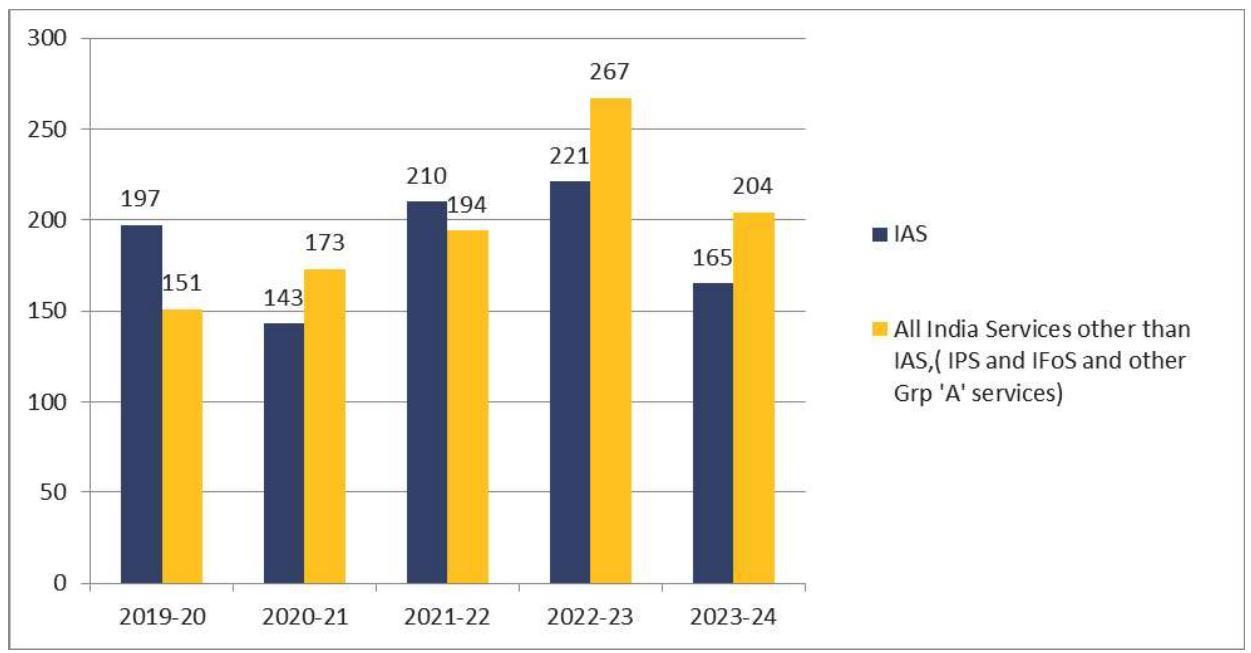
Figures for 2019-20 are up to 31/12/2019, for 2020-21 are up to 31/12/2020 for 2021-22 are up to 31/12/2021, for 2022-23 are up to 31/12/2022 and for 2023-24 are up to 31/03/2024.
CENTRAL DEPUTATION RESERVE
6.5 The Establishment Officers (EO) Division in the Department of Personnel & Training maintains an electronic database of the IAS officers \& of Group ‘A’ service officers working at the Centre under the Central Staffing Scheme. These records are maintained on the basis of orders/letters/notifications issued by the DOPT, various Central Ministries/Departments and the State Governments. The maintenance/ updation of this database is significant, as it helps in providing readily available digitized information in respect of all officers and also processing of cases for foreign appointments/assignments and training etc.
6.6. The Central Deputation Reserve statement in respect of Indian Administrative Service summarizes the state wise number of officers that are on central deputation vis-a-vis senior duty posts. It also indicates the number of officers presently on central deputation from each cadre.
CENTRAL DEPUTATION RESERVE FIGURES AS ON (31/03/2024).
| Sr. | Cadre | Total Authorized Strength |
Central Deputation Reserve |
No.of Officers at Centre |
Col. 5 as Percentage of Col.4 |
|---|---|---|---|---|---|
| (1) | (2) | (3) | (4) | (5) | (6) |
| 1 | A G M U T | 542 | 117 | $\underline{68}$ | 58 |
| 2 | Andhra Pradesh |
239 | 52 | $\underline{8}$ | 15 |
| 3 | Assam Meghalaya |
263 | 57 | 24 | 42 |
|---|---|---|---|---|---|
| 4 | Bihar | 359 | 78 | 28 | 35 |
| 5 | Chhattisgarh | 202 | 44 | 11 | 25 |
| 6 | Gujarat | 313 | 68 | 18 | 26 |
| 7 | Haryana | 215 | 46 | 14 | 30 |
| 8 | Himachal Pradesh |
153 | 33 | 12 | 36 |
| 9 | Jharkhand | 224 | 48 | 18 | 37 |
| 10 | Karnataka | 314 | 68 | 20 | 29 |
| 11 | Kerala | 231 | 50 | 16 | 32 |
| 12 | Madhya Pradesh |
459 | 99 | 34 | 34 |
| 13 | Maharashtra | 435 | 94 | 23 | 24 |
| 14 | Manipur | 115 | 25 | 15 | 60 |
| 15 | Nagaland | 94 | 20 | 7 | 35 |
| 16 | Odisha | 248 | 54 | 22 | 40 |
| 17 | Punjab | 231 | 50 | 21 | 42 |
| 18 | Rajasthan | 313 | 68 | 16 | 23 |
| 19 | Sikkim | 48 | 10 | 6 | 60 |
| 20 | Tamil Nadu | 394 | 85 | 22 | 25 |
| 21 | Telangana | 208 | 45 | 9 | 20 |
| 22 | Tripura | 102 | 22 | 14 | 63 |
| 23 | Uttar Pradesh | 652 | 141 | 30 | 21 |
| 24 | Uttarakhand | 126 | 27 | 10 | 37 |
| 25 | West Bengal | 378 | 82 | 6 | 7 |
| Total | $\mathbf{6 8 5 8}$ | $\mathbf{1 4 8 3}$ | $\mathbf{4 7 2}$ | $\mathbf{3 1}$ |
6.7. In addition to the appointments under the Central Staffing Scheme, 284 appointments as Chairman/ CMDs/MDs/ Deputy Governor/ Chairman/ Vice Chairman/Members/Executive Directors/ Functional Directors/ Non-Official Directors were made on the Boards of Public Sector Undertakings and Banks/Financial Institutions during the period 01.01.2023 to 31.03.2024. During the same period, 64 appointments were made at the level of Chairman//General Managers/ equivalent Members/Additional Members/ Director General in the Railway Board/Zonal Railways. Besides, 809 Officers were also approved during the above period for additional charge/extension of tenure/non-extension of tenure/ad-hoc extension/rejection/termination of services of CMDs/MDs, Functional Directors, in the PSUs/Banks/Financial Institutions, and empanelment of GM/DG/AM in the Ministry of Railways. Out of these 1157 appointments/Additional charge arrangements, 35 are female officers.
NUMBER OF APPOINTMENTS TO THE POST OF CHAIRMAN-CUM-MANAGING DIRECTOR/MANAGING DIRECTOR ETC IN PSUs/BANKs
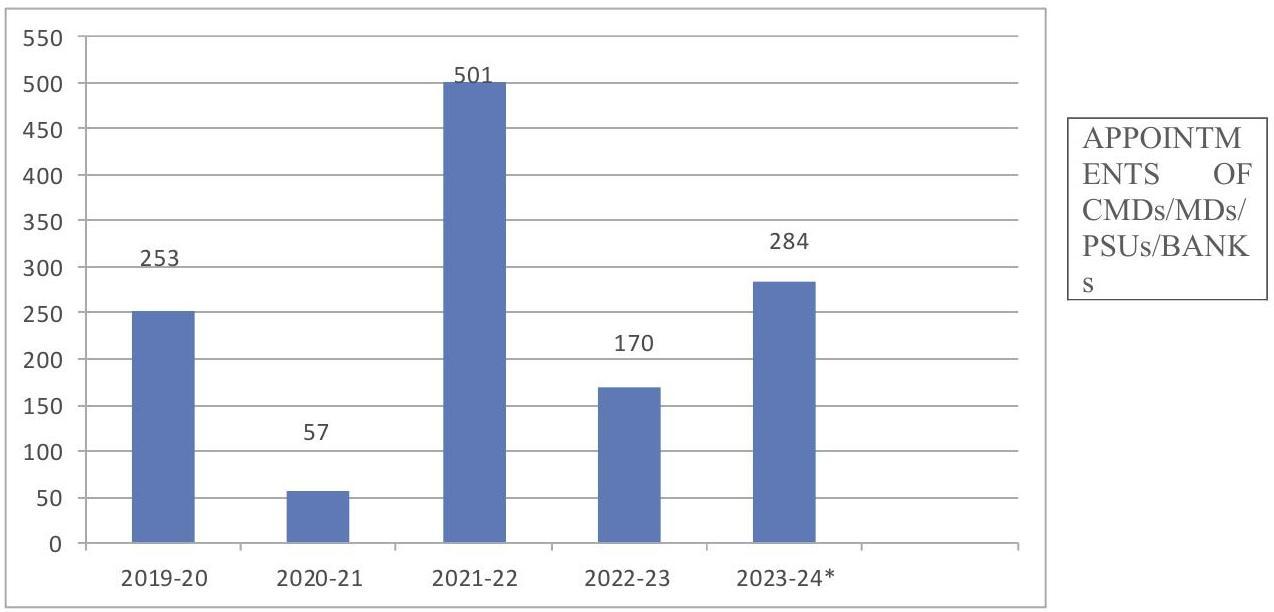
*(For the period from 01.01.2023 to 31.03 .2024 )
6.8. During the period 2023-24 (01.01.2023 to 31.03.2024) 442 Member/Chairman/ Chief Executive Officer/Advisor were approved for appointment in various Autonomous Bodies, Administrative Tribunals, Labour Courts and Regulatory Bodies etc. Out of these, 49 are women officers.
6.9 A total of 3002 officers were approved for empanelment for promotion to posts of and above the level of Joint Secretary in various organized Central Services which are not included in the Central Staffing Scheme. Out of these, 382 are women officers.
6.10 During this period, based on the recommendations received from the Election Commission of India, 54 IAS officers posted in various Ministries/Departments on Central Deputation were appointed for General Observer Duty during General/ Bye election in various Legislative Assemblies and Parliamentary/Assembly Constituencies of various States/UT.
Chief Vigilance Officer
6.11 During the year 2023-24 (upto31.03.2024), 37 officers have been appointed as Chief Vigilance Officers (CVOs) in various organizations and 25 officers have been given additional charge of the vacant posts of CVOs in various organizations. During the same period, 13 CVOs have been granted extension of tenure after completion of initial tenure and 09 case of premature repatriation has been finalized.
REPRESENTATION OF WOMEN
6.12 While taking up empanelment of officers to Joint Secretary rank, it is ensured that women get adequate representation.
6.13 A total of 98 women were appointed under Central Staffing Scheme during the period 2023-24 including 41 women at Secretary/Addl. Secy. / Joint Secy. levels.
6.14 A total of 35 female officers were also approved for the period for appointment as CMDs/MDs, Executive Directors, Functional Directors, Non-official Directors in PSUs/Banks, Financial Institutions and at various post in Indian Railways.
6.15 A total of 431 women officers were appointed as Member / Chairperson / CEO, etc. in various Autonomous Bodies, Administrative Tribunals, Labour Courts, Regulatory Bodies and to posts of Joint Secretary Level and above in various organised central services excluding appointments under the Central Staffing Scheme.
6.1649 women were approved for appointment in various Autonomous Bodies, Administrative Tribunals, Labour Courts, and Regulatory Bodies etc.
CHAPTER 7
TRAINING POLICY AND PROGRAMMES
Mandate of Training Wing
7.0 The Training Wing of the Department of Personnel and Training is the nodal agency for training of government functionaries and is primarily responsible for formulating policies with regard to training. It also implements certain components of training directly. In the implementation of its mandate, the Wing has set the following objectives:
- Administering Policy matters in training
- Identification of functional areas of training
- Designing and implementing training programmes for officers involved in the priority development sectors
- Development of trainers and training capability
The goal of the Training Wing is to attain “Training For All”, which means that training would be imparted to all rungs of Civil Services starting from the lowest and cutting-edge to the highest in policy making.
7.1.1 Major Activities
1) Post Graduate Programmes in Public Policy/Sustainable Development/Management
2) Mid-Career Training of IAS Officers
3) Training Support under Training for All (TFA) Scheme through the following components:
State Category Training Programme (SCTP)
Trainers’ Development Programme (TDP)
Comprehensive Online Modified Modules on Induction Training (COMMIT)
Faculty Development Scheme (FDS)
Augmentation of Capacity of Training Institutions (ACTI)
4) In-service Training of IAS Officers
5) Advanced Professional Programme in Public Administration (APPPA)
6) Posting of Probationary IAS Officers as Assistant Secretary in Government of India
7) National Programme for Civil Services Capacity Building (NPCSCB) – Mission Karmayogi
7.1.2 This Department is the nodal agency of Government of India for matters related to training of Civil Servants. For fulfilling this mandate, National Training Policy was formulated initially in 1996 and revamped in 2012. The 2012 policy underscores that for transforming the civil service, it is imperative to move to a strategic human resource management system, which would look at the individual as a vital resource to be valued, motivated, developed and enabled to achieve the Ministry/ Department/ Organisation’s mission and objectives.
National Program for Civil Services Capacity Building (NPCSCB) – Mission Karmayogi
7.2 Union Cabinet on 02-09-2020 approved the National Program for Civil Services Capacity Building (NPCSCB) – Mission Karmayogi, with the goal of securing efficient and effective public service delivery for citizens through a targeted approach of role specific capacity building of all civil service officials across the Centre and States, regardless of their ranks, cadre and geographies, transitioning from a ‘rule-based’ to a ‘role-based’ system of capacity development.
Under NPCSCB, DoPT is taking steps to build a competency model and identify the behavioural, functional and domain needs, evolving from the organization to the individual levels of the Government. An online learning platform (iGOT-Karmayogi) has also been developed to allow the Departments to provide competency linked training resources and opportunities to their employees.
NPCSCB has an overall budget of ₹510.86 crore (including Taxes), including technical assistance from the World Bank Group to the tune of ₹350 crore (approx.) in the form of loan.
Objective
7.3 Civil services are at the centre of all government activities – they are agents of policymaking and the executive hand that delivers on the ground. The skillsets and capacity of the civil servants play a vital role in service delivery, program implementation and performance of core governance functions. Recognizing this crucial responsibility, the NPCSCB aims to create a professional, well-trained and future-looking civil service that is imbued with a shared understanding of India’s developmental aspirations, national programs and priorities.
The focus of NPCSCB is on promoting ease of living and ease of doing business, by considerably enhancing the quality and effectiveness of the citizen-government interface. This involves nurturing the continuous development and upgrading of functional as well as behavioral competencies among civil servants.
NPCSCB – Pillars & Philosophy
7.4 NITI Aayog, in its report on India@75, highlighted the need for reforms in training. The experience gained during the Covid-19 pandemic also brought forth the need for the civil service to be agile, capable of partnering with diverse stakeholders and to be up to date with new competencies. The NPCSCB is carefully crafted to lay the foundation for capacity building for future generations of civil servants so that they learn from the best practices across the world, while remaining connected to their roots.
The key philosophy of NPCSCB is to create an ecosystem of competency driven training and Human Resource (HR) management by offering holistic learning resources on iGOT Karmayogi platform, to align the knowledge, skills, and attitudes of a civil servants, based on a systematic assessment of the behavioral, functional and domain competencies required in their current role/position.
The National Programme for Civil Services Capacity Building has six key pillars –
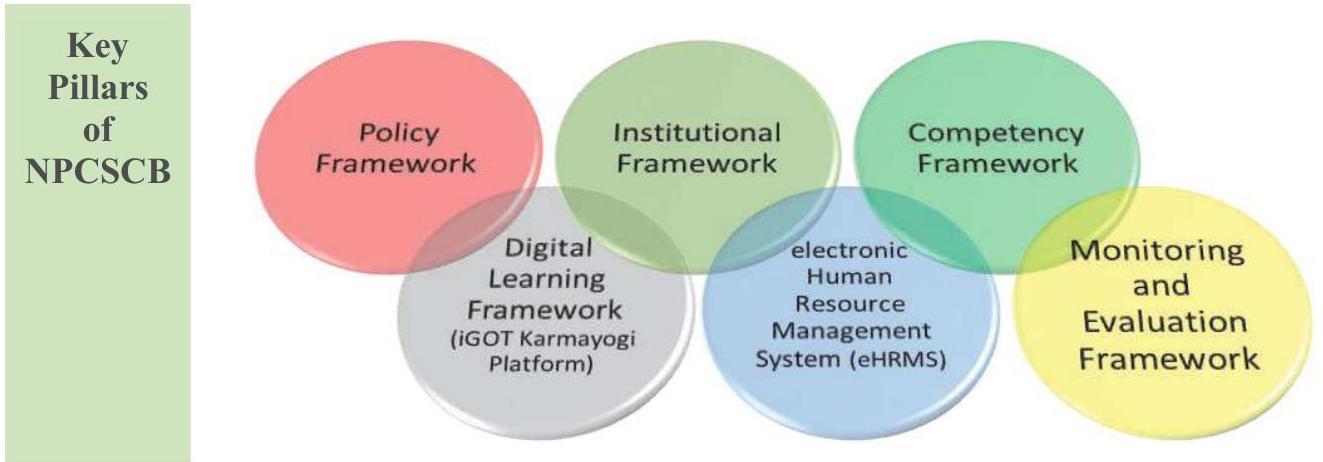
The NPCSCB aims to cover all civil servants across different Ministries, Departments, Organisations (MDOs) of the Union Government. The willing State Governments are also being enabled to align their capacity building plans on similar lines.
Policy Framework
7.5 A competency-based HR policy requires assignment of the right person to the right role at the right time. NPCSCB aims to create a robust policy framework towards implementation of such an HR policy in the Government. The policy framework will also enable adoption of modern technological tools such as a digital platform, artificial Intelligence, machine learning and data analytics for monitoring and evaluation of the entire programme, especially quality of the learning content, assessment of user feedback and competency assessment.
Key Principles of the NPCSCB Policy Framework
- To complement Physical Capacity Building with an Online Training framework.
- Focus on ‘On-Site learning’ to complement ‘Off-Site learning’ whereby the civil servant learns in her job environment and only higher order learning is delivered through training institutions.
- To create an ecosystem of shared training infrastructure including teaching material and personnel.
- To harmonise the functioning of all civil services training institutions (such as Central Training Institutions etc.) and enable them to partner with domestic and global institutions.
- To calibrate all civil service tasks to a Framework of Roles, Activities and Competencies including skills (hereinafter referred to as FRACs)
- To partner with all content creators including in-house sources, as well as the private sector to build a content marketplace on iGOT-Karmayogi.
- To make available to all civil servants, agnostic to their geographical location and their position in the hierarchy, an opportunity to access training content in Hindi, English and other Indian languages.
- To enable the individual learners to follow self-decided as well as mandated learning paths.
- To make Mid-Career Training Programme (MCTP) mandatory for all services including horizontal and combined programs amongst services.
Competency Framework
7.6 The NPCSCB will facilitate delineating the Roles, Activities, and Competencies including skills by each Ministry/Department/Organisation of Union Government, for its various positions and its integration with the iGOT-Karmayogi Platform. The exercise aims to pinpoint the competencies required at each position in the government. Thereafter, work-allocation, notifications of vacancies etc. will be done through the iGOT-Karmayogi platform following the competency model. Further, capacity building content appropriate to the competency model will be provided by participating organisations on the 70:20:10 rule (an indicative $70 %$ training online, $20 \%$ on-the-job and $10 \%$ physical).
Digital Learning Framework (iGOT-Karmayogi Platform)
7.7 An online learning platform, i-GOT-Karmayogi, has been developed as an integral part of the Digital India stack for capacity building of all government employees. It provides anytime-anywhere-any device learning with the potential to train about 2.0 crores users which was hitherto not achievable through traditional measures. The Platform is also available as a mobile app on popular platforms for easy access
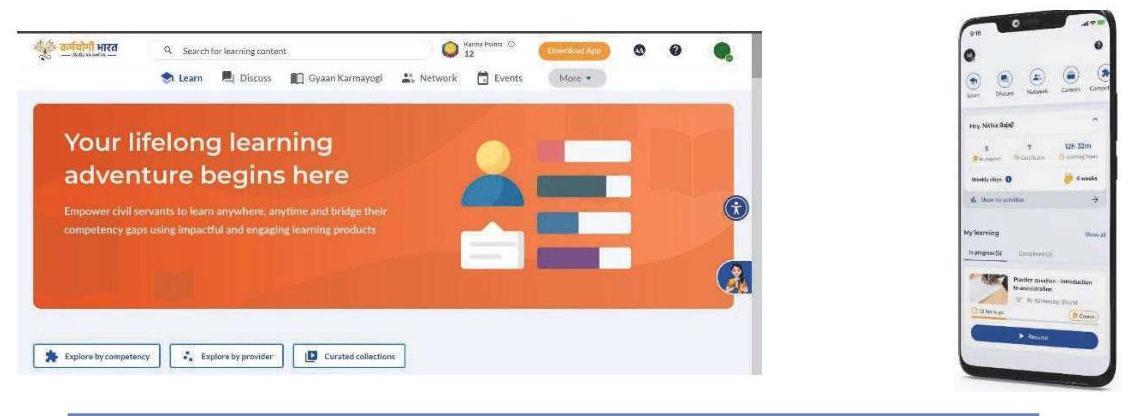
iGOT Karmayogi- Web Platform and Mobile App
The content is being curated by individual government ministries or organizations in-house or through knowledge partners. Carefully crafted and vetted content from best-in-class institutions, universities, private content providers and individual resources is also being made available as training modules. The platform is envisioned to eventually evolve into a vibrant and world class marketplace for content modelled on FRACs, supported by a robust e-learning content industry.
Institutional Framework
7.8 At present, the NPCSCB has operationalized the following institutional framework to manage the Programme and oversee its execution:
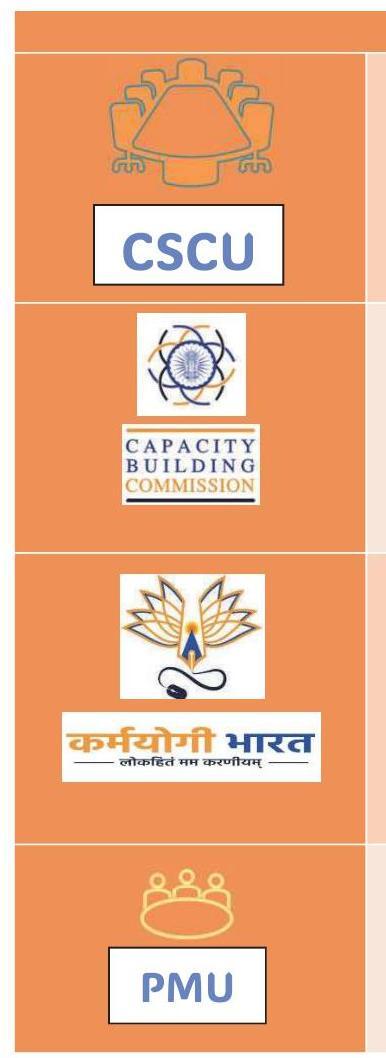
Institutional Framework for NPCSCB
(i) Cabinet Secretariat Coordination Unit (CSCU): A coordination unit has been set up on 27.01.2023 under the Chairmanship of the Cabinet Secretary to monitor the implementation of the NPCSCB. It acts to align all stakeholders and provide mechanism for overseeing capacity building plans.
(ii) Capacity Building Commission: The Capacity Building Commission (CBC) has been made operational from April 2021 with the mandate to make policy recommendations on Personnel/HR and oversee the systematic development of the training ecosystem, including various Civil Service Training Institutes (CSTIs).
(iii)Karmayogi Bharat: A not-for-profit company incorporated in the name of Karmayogi Bharat, under the administrative control of DoPT, as a $100 %$ government owned entity for owning, managing and maintaining the digital assets, i.e., i-GOT-Karmayogi- the digital/ e-learning platform, as well as the IPR of all software, content, process etc., on behalf of Government.
(iv)A Programme Management Unit (PMU): This unit in DoPT provides interface with support agencies. This unit has been set up to provide program management and support services to the department for rolling out and managing different aspects of NPCSCB.
Special Purpose Vehicle (SPV) – Karmayogi Bharat (KB)
7.9 The Special Purpose Vehicle (SPV), Karmayogi (SPV-KB) was incorporated on 31.01.2022 under Section 8 of the Companies Act, 2013 as a 100% Government owned not for profit Company to own and manage the iGOT Karmayogi platform and other digital assets pertaining to the NPCSCB. The SPV-KB started functioning from July 2022 with the appointment of its CEO and the Board of Directors.
Composition of the Board of SPV – Karmayogi Bharat
Board of Directors of Karmayogi Bharat
a) Shri Subramanian Ramadorai, Former Advisor to the Prime Minister in the National Council on Skill Development:-Non-executive Director and Chairperson, Karmayogi Bharat.
b) Ms. Debjani Ghosh, President, National Association of Software & Services Companies (NASSCOM):-Non-executive Director Karmayogi Bharat.
c) Mr. Pankaj Bansal, Co-Founder and Group CEO of PeopleStrong:Non-executive Director Karmayogi Bharat.
d) Dr. Santrupt Misra, Group Director, Birla Carbon \& Group Human Resources for the Aditya Birla Group:-Non-executive Director Karmayogi Bharat.
e) Dr. Nirmaljeet Singh Kalsi, IAS (retd.), Chairperson of National Council for Vocational Education and Training:-Non-executive Director Karmayogi Bharat.
f) Shri Govind Iyer (Consultant, Egon Zehnder):-Non-executive Director, Karmayogi Bharat.
g) Secretary, Ministry of Electronics and Information Technology, Government of India (Ex-officio): Non-executive Director Karmayogi Bharat.
h) Secretary, Department of Personnel and Training, Government of India (Ex-officio) Director, Karmayogi Bharat.
i) Secretary, Capacity building Commission (CBC) (Ex-officio), Director Karmayogi Bharat.
j) Shri Abhishek Singh, CEO \& Director, Karmayogi Bharat.
k) CFO, Karmayogi Bharat \& Director, Karmayogi Bharat.
The Karmayogi Bharat has set about advancing its mandate to develop the i-GOT-Karmayogi Platform into a comprehensive resource for the Capacity Building of Civil Services in India.
Capacity Building Commission
7.10 Capacity Building Commission (CBC), an attached office of DoPT, has been functioning under the aegis of Mission Karmayogi since April 2021, formulating Annual Capacity Building Plans for all Ministries/Departments/Organizations (MDOs); to systematically capture the demand for training and transform and elevate the supply side of Capacity Building ecosystem, by reviewing, benchmarking and targeted upgradation of the various Civil Service Training Institutes (CSTIs):
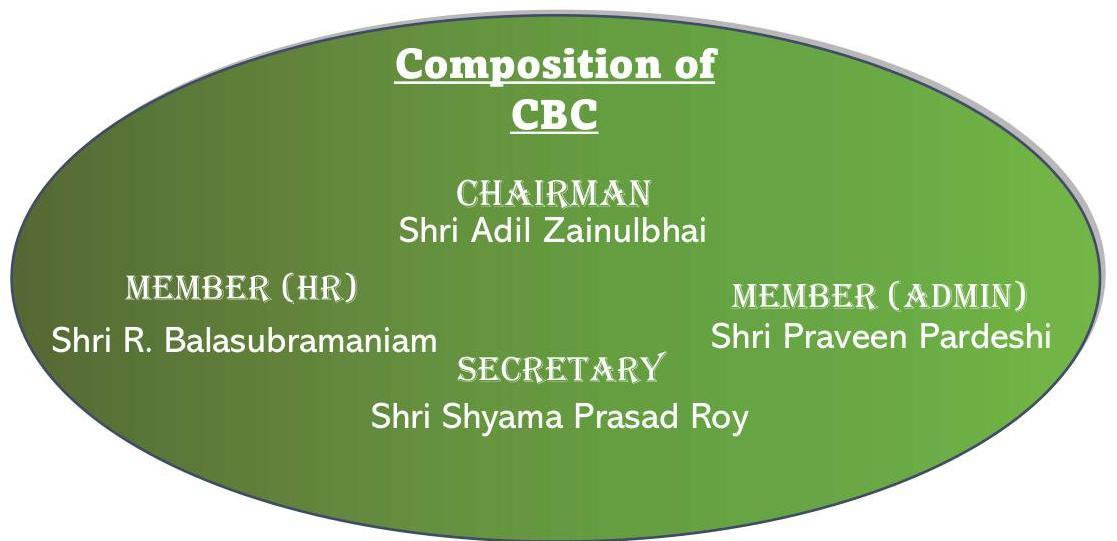
Monitoring and Evaluation framework
7.11 The performance of all users of the iGOT – Karmayogi platform will be monitored and evaluated on Key Performance Indicators (KPIs). This will include the individual learner, the supervisor, the organisation, the peer group, the content provider, the content creator, and the technology service providers etc.
Initiatives under the Mission Karmayogi during F.Y, 2023-24
7.12 The major activities during the financial year 2023-2024 under Mission Karmayogi are highlighted below:
Cabinet Secretariat Coordination Unit (CSCU): The second meeting of the CSCU was held under the chairmanship of Cabinet Secretary, on $6^{\text {th }}$ October, 2023 to deliberate on the progress made under Mission Karmayogi. The status of following was discussed:
i. Status of onboarding of various Ministries/ Departments/ Organizations and States on iGOT platform.
ii. Registration of Civil Service Training Institutions on the National Standards of Civil Services Training Institutions (NSCSTI) portal.
iii.Preparation of Capacity Building Plan (CBP) of various Ministries/ Departments and Organizations (MDOs).
Developments on the iGOT Platform during the year are highlighted below –
a. The iGOT platform has shown consistent progress in onboarding users during the year with cumulative learner registrations crossing $\mathbf{3 1 , 0 0 , 0 0 0}$ during the Financial Year 2023-24
Cumulative number of Karmayogis onboarded on iGoT (in Lakhs)
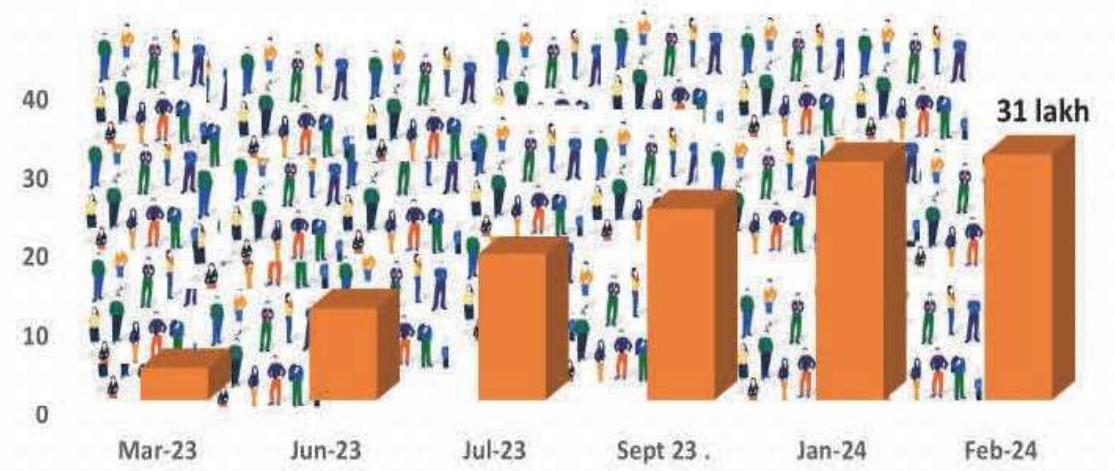
b. Content Generation and user engagement on the Platform has also shown encouraging progress.
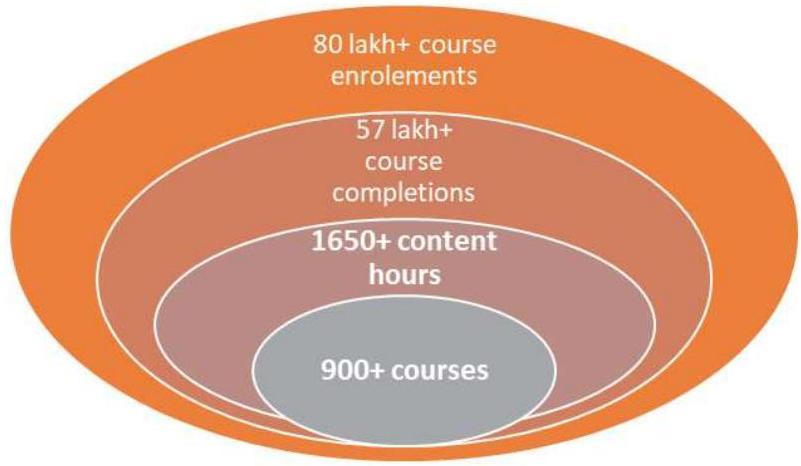
c. The iGOT Karmayogi Mobile App has seen 5.2 lakh plus downloads.
d. OTP Authentication for mobile based login feature has been added.

e. Verified Karmayogi badge, a feature has been added through which only users with a Verified Karmayogi badge will be able to access moderated courses.
f. FAQ Chatbot feature introduced to facilitate users on the Platform.
g. Launch of DAKSHTA for Young Professionals: In June 2023, recognising the growing popularity of iGOT, NITI Aayog launched the ‘DAKSHTA for Young Professionals’ program on the platform. Tailored for Young Professionals & Consultants engaged in Government. This collection seeks to build functional, domain and behavioural competencies by acquainting learners with subjects crucial for discharging their duties, and responsibilities effectively.
h. Launch of NITI Aayog’s SAMARTH curated programmes on iGOT: Karmayogi Bharat, in association with NITI Aayog, launched 6 SAMARTH Curated Training Programs on the iGOT Karmayogi Platform for State Government officials. The programs are- 1) SAMARTH Blocks, 2) SAMARTH Zila, 3) SAMARTH Rajya, 4) SAMARTH
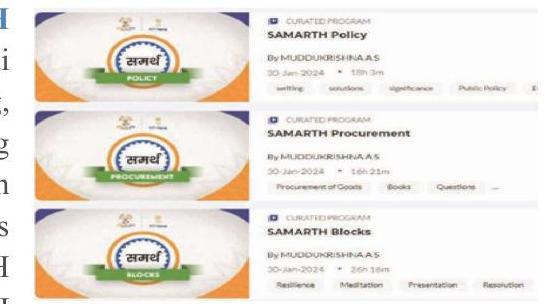
Rajya Sachiva, 5) SAMARTH Policy, and 6) SAMARTH Procurement. These programs aim to elevate the skills and competencies of government officials, ensuring they are well-equipped to meet the evolving needs of governance.
i. My iGOT functionality implemented for providing personalized learning experiences for the learners based on training calendars. My iGOT delivers targeted training courses on home page of individual officer that directly address the unique capacity building needs of the officer as identified in the Capacity-Building Plan for their Ministries/Departments thereby facilitating a highly personalized, focused and targeted capacitybuilding experience.
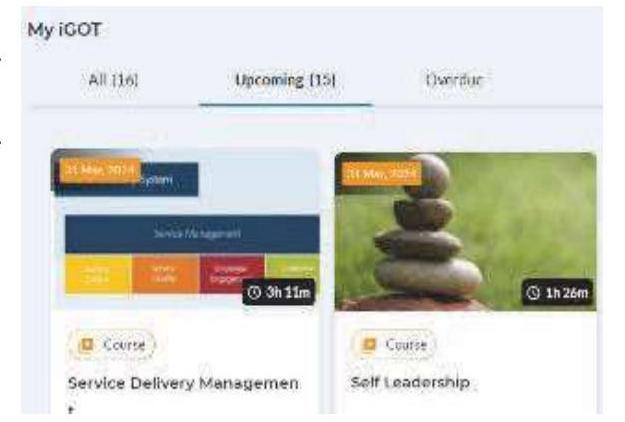
j. Blended Programs capability introduced on iGOT-Karmayogi platform to facilitate equitable access to training methodologies across all levels to meet dynamic training needs of the officials. Blended Programs integrate traditional offline (in person) classroom courses with online learning components.
k. Curated Programs on iGOT Karmayogi are designed to cater to diverse learning needs of the Ministries/Departments and Training Institutions. The course providers will now be able to curate relevant content, resources, and assessments from the repository of iGOT with a programmatic approach to provide a tailored learning journey.
7.13 The Karmayogi Bharat and DoPT continued their vigorous outreach and onboarding efforts and undertook several activities during the year to increase the reach and awareness of the iGOT Platform –
a. Good Governance Day 2023: Dr Jitendra Singh, Hon’ble MoS (PP) launched three new features on the iGOT Karmayogi Platform, on Good Governance Day – My iGOT, Blended Programs, and Curated Programs.
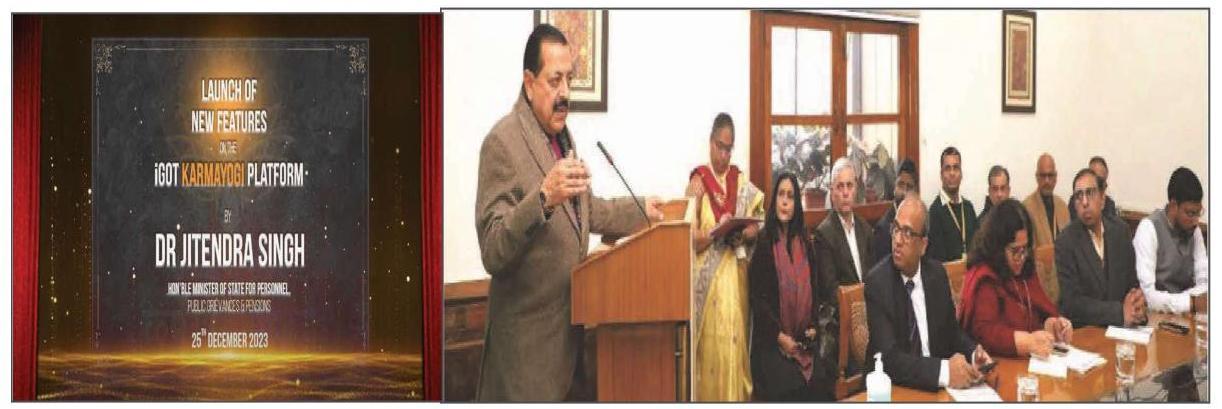
b. iGOT Karmashala 2023: Karmayogi Bharat organised the ‘iGOT Karmashala’ on 02-05-2023 at Vigyan Bhawan with senior officials of all Ministries and Departments, iGOT Nodal officers, content partners, and representatives of training institutes. The objective of this workshop was to bring all stakeholders on the same forum, share the progress
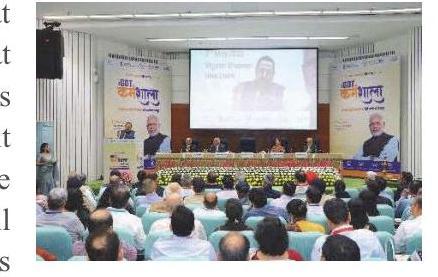
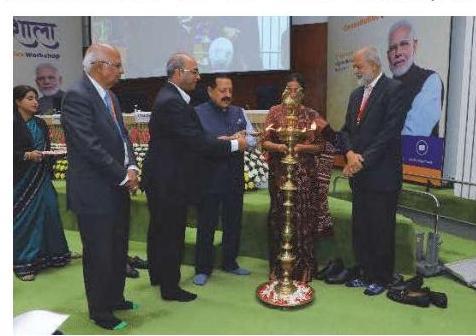
made under the Mission and recognise high performing
Ministries/Departments/Organisations (MDOs), and learners. Based on the number of course completions, the top 10 MDOs were awarded by Hon’ble Union Minister Dr Jitendra Singh along with 150 top learners across Ministries.
c. iGOT Manthan 2023: iGOT Manthan was organised by Karmayogi Bharat on 09-11-2023, with 31 content partners. The workshop also hosted guest speakers such as Shri Alakh Pandey, Founder of PhysicsWallah, and Smt Anita Karwal, ChairpersonGUJRERA, who shared their deep insights on content and learner engagement

iGOT Manthan meeting
d. Outreach: The Karmayogi Bharat team has conducted regular outreach-cumorientation sessions with more than 200 Ministries/Departments/ Organizations/ Training Institutes/ Content Providers during the year.
e. State Outreach: Going beyond Central Government officials, Karmayogi Bharat has been making concerted efforts to onboard State Government employees on the iGOT Karmayogi Platform Between January and December 2023, Tripartite Memorandums of Understanding (MoUs) were formalized with the State Governments of Maharashtra (12 May 2023), Meghalaya (03 July 2023), Jharkhand (23 August 2023), Uttar Pradesh (06 September 2023), and Gujarat (10 November 2023).
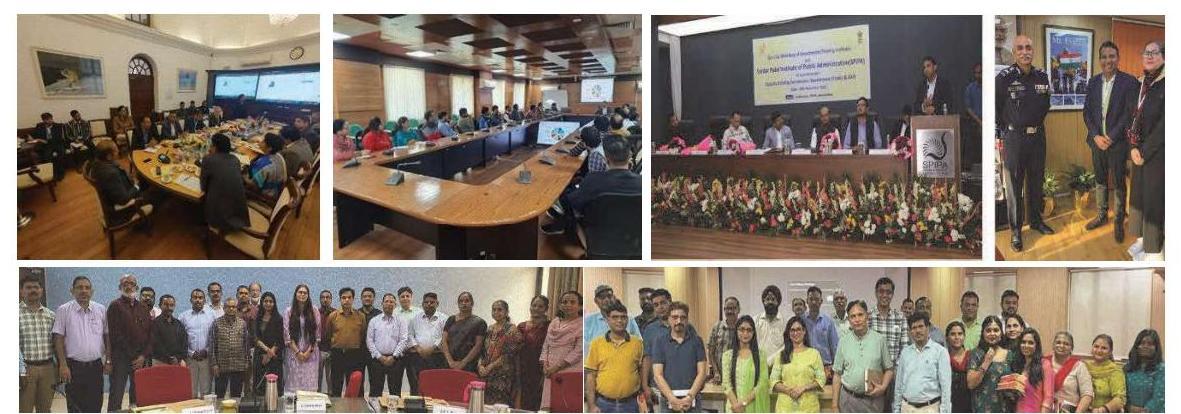
626 Admins were created for MDOs & States during f.y.2023-24.
f. Observing World Day of Social Justice, 2023: World Day of Social Justice was celebrated on February 20, 2023, to generate awareness about the inclusion of differently-abled people in the mainstream. On the occasion, three selected learners, registered on iGOT,
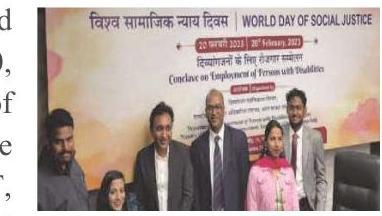
were invited to share their personal and professional experiences.
g. International Women’s Day celebration: On International Women’s Day 2023, a curated course collection SHAKTI was launched by Smt S. Radha Chauhan (Secretary, DoPT), and Smt Debjani Ghosh (President, NASSCOM).
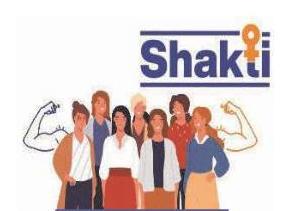
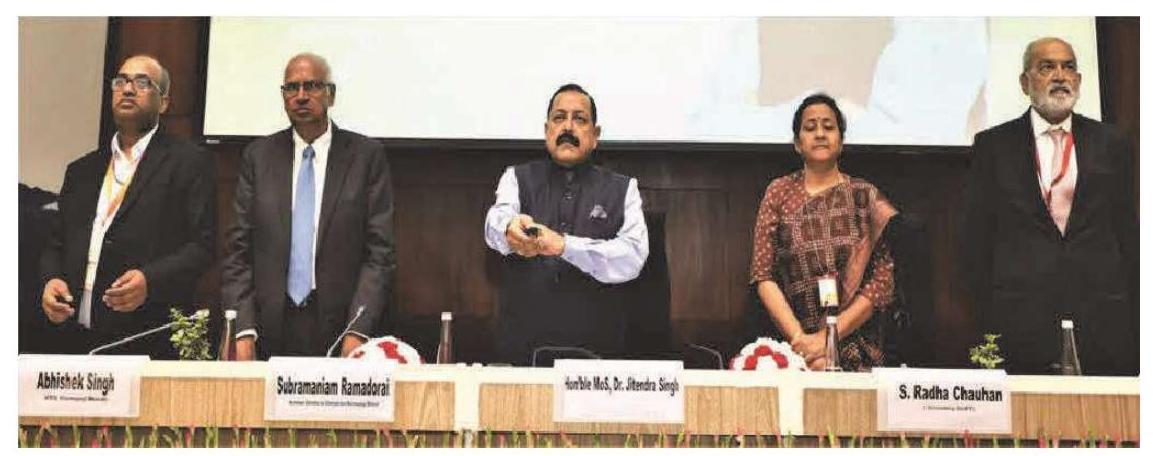
h. National Training Conclave (NTC) 2023, and iGOT Lounge: On 11-06-2023, the Capacity Building Commission (CBC) hosted a National Training Conclave (NTC) bringing together all Civil Services Training Institutes (CSTIs) on a single platform with the objective to acquaint them about their roles and responsibilities, fostering a spirit of learning and collaboration under Mission Karmayogi. A dedicated iGOT Lounge was set up by Karmayogi Bharat to familiarize representatives from Central/Administrative Training Institutions about the various facets of the iGOT
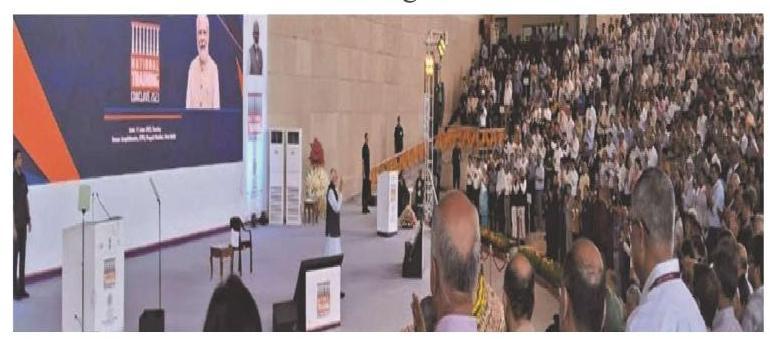
Karmayogi
Platform.
Apart from acquainting
representatives of Training Institutions with the iGOT Karmayogi Platform, visitors to the Lounge were also taken through aspects of course creation, course uploading process, the CBP portal, and learner engagement. The iGOT Lounge hosted representatives from 20+ Central Training Institutions, and State Administrative Training Institutions.
i. Focus Group Discussion with iGOT’s learners: Karmayogi Bharat conducted two sessions of Focus Group Discussion on $1^{\text {st }} & 2^{\text {nd }}$ August 2023 with learners, MDO Admins, and other stakeholders from 15+ Ministries and Government Departments around the iGOT Karmayogi platform. The key objective of this exercise was to capture the underlying needs of various learner groups and gather their feedback on the iGOT Karmayogi platform.
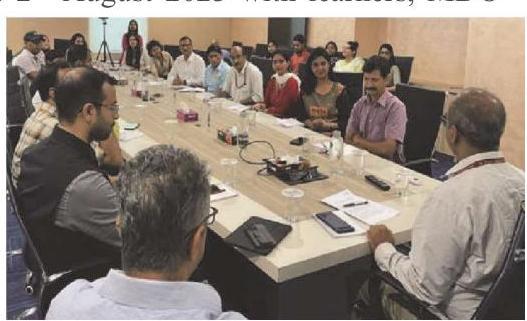
j. Workshop on Content Development: Karmayogi Bharat conducted a workshop in August 2023 with all CBC-empaneled agencies and other key stakeholders to streamline the course creation and uploading process on iGOT. All participants were informed about the guidelines for course creation and uploading on the platform
k. Session on Leadership and Communication Skills: Karmayogi Bharat organized a workshop on ‘The Art of Leadership Communication’ for senior government officials from various Ministries/Departments on 9th October 2023. Catering to one of the key skills needed for senior civil servants – ‘Effective Communication’ – the workshop was conducted with the objective to complement the Communication courses on iGOT Karmayogi Platform. The session covered themes such as Leadership Qualities for Building Behavioural Competencies, Art of Verbal Communication, Storytelling in Business and Life, and Communicating Data Impactfully.
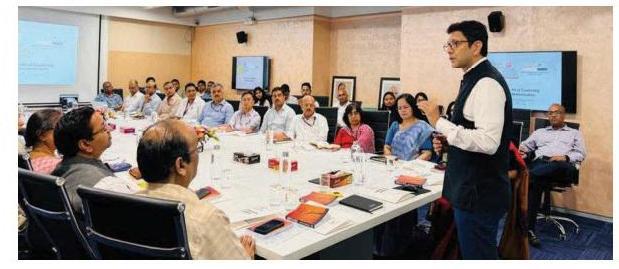
- First-year Celebration of Karmayogi Prarambh: Karmayogi Bharat organised a workshop with select learners for the first anniversary celebration of the Karmayogi Prarambh Module on November 22, 2023. The event also included a panel discussion with the participants. The session served as a valuable forum for participants to
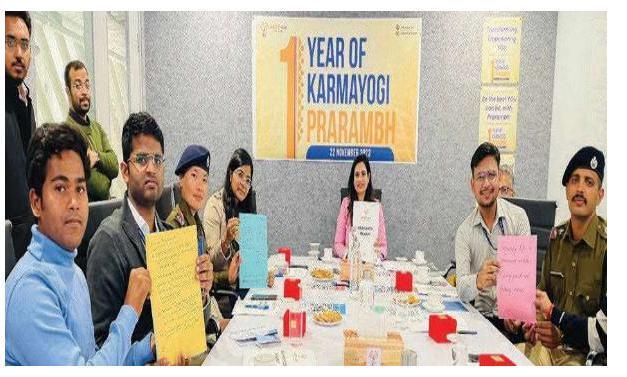
share their insights, experiences, and provide constructive feedback, contributing to the continuous development, and expansion of the platform, and its offerings.
7.14 The Key activities taken up by the CBC are as under:
a. Capacity Building Plans (CBPs): CBC is coordinating preparation of Capacity Building Plans (CBPs) of Ministries, Departments and participating Organisations (MDOs). The CBPs will help in identifying the demand for capacity building at individual, organizational and institutional level in each MDO. CBC has facilitated the development of 107 CBPs across MDOs.
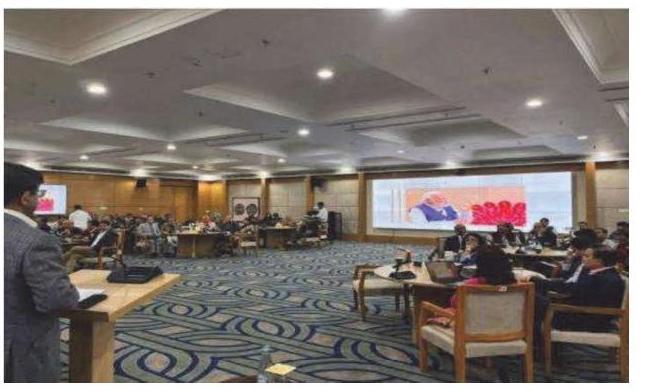
07 February 2024: Dept of Commerce Ministry of Commerce and Industry, Government of India launched its Annual Capacity Building Plan
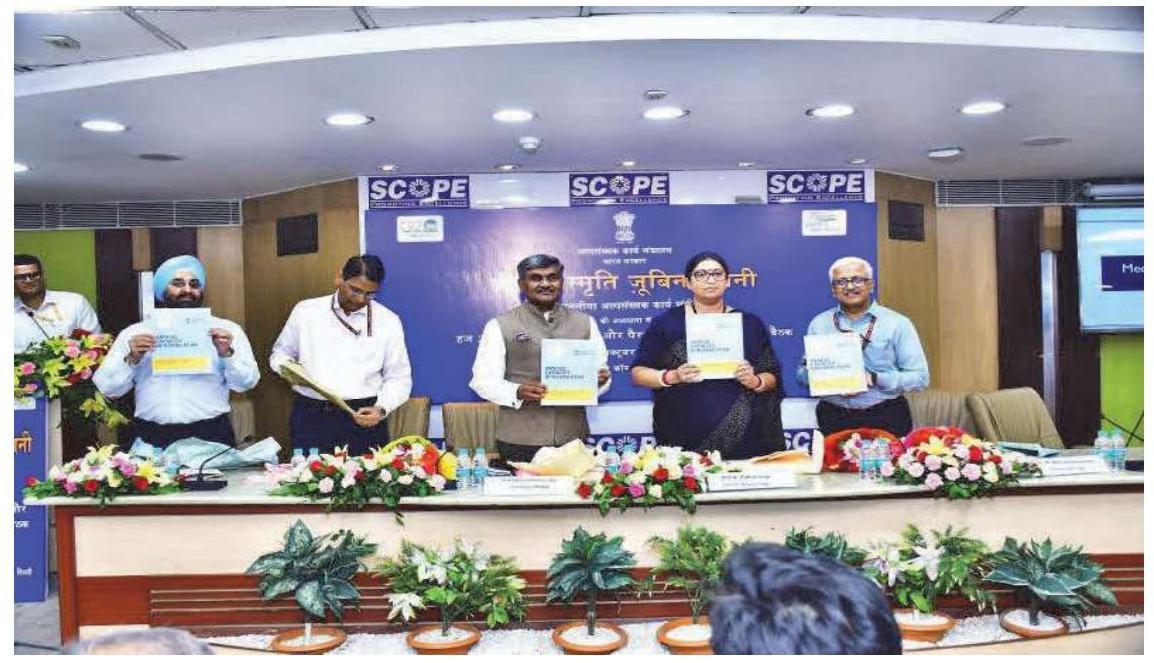
04 October 2023: The Ministry of Minority Affairs in collaboration with Capacity Building Commission launched their Annual Capacity Building Plan in the presence of Hon’ble Minister Smt. Smriti Irani, on 4th October 2023
b. Urban Local Bodies (ULB) outreach: CBC is also working with Urban Local Bodies (ULB) to develop an integrated approach for enhancing their capacity. CBC has facilitated CBPs for 7 ULBs and a ‘Toolkit for Preparation of CBPs for ULBs’ has been developed for the benefit of all ULBs. Besides this, CBC has also signed Memorandum of Understanding with states like Meghalaya, Gujarat, Maharashtra, Uttar Pradesh, Madhya Pradesh, Jharkhand and Uttarakhand for undertaking various capacity building activities for the State Government officials.
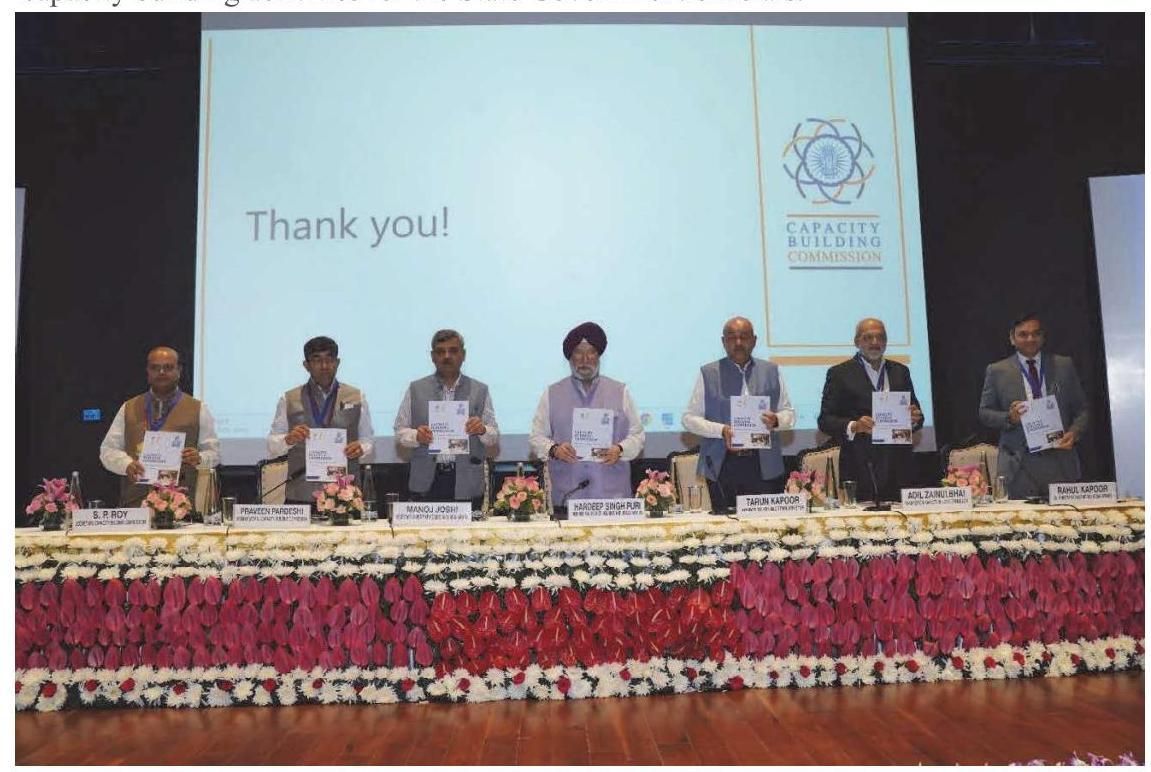
c. National Training Conclave: CBC organized a National Training Conclave on 11-06-2023 to bring together all Civil Services Training Institutes (CSTIs) in a common setting for the first time with the aim that this effort will help identify strategies for the Ecosystem to build and improve together. The Conclave provided a platform for knowledge exchange, identifying challenges and key areas of collaboration.
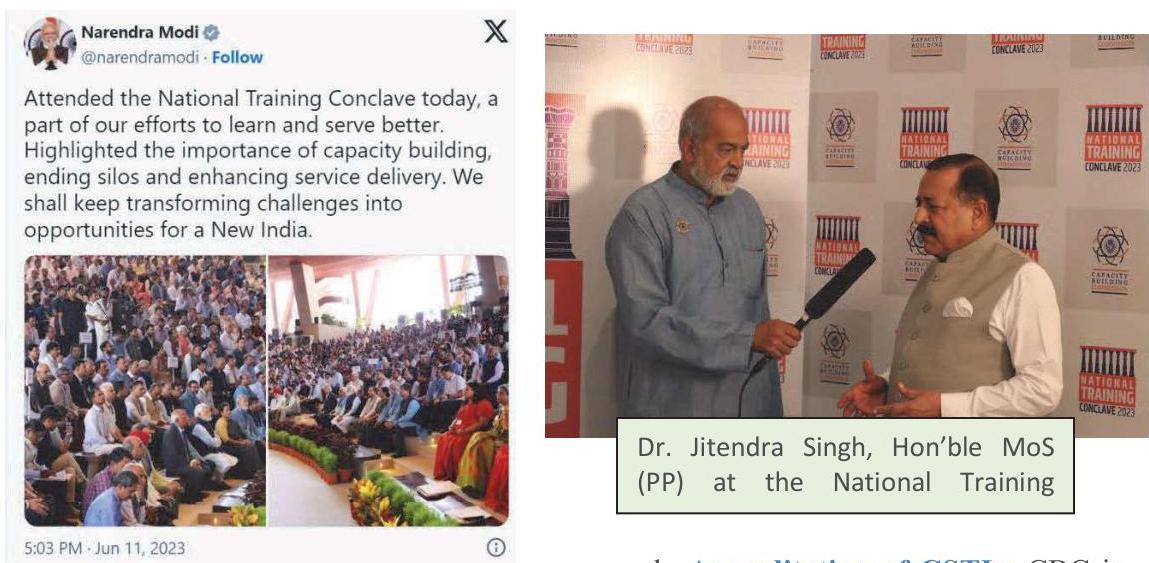
d. Accreditation of CSTIs: CBC is
closely collaborating with the Civil Services Training Institutions (CSTIs) for standardization of training and capacity building, pedagogy and methodology. This initiative caters to the supply side of the capacity building ecosystem. CBC has facilitated the accreditation of 84 CSTIs, after the launch ‘National Standards for Civil Service Training Institutions’ portal.
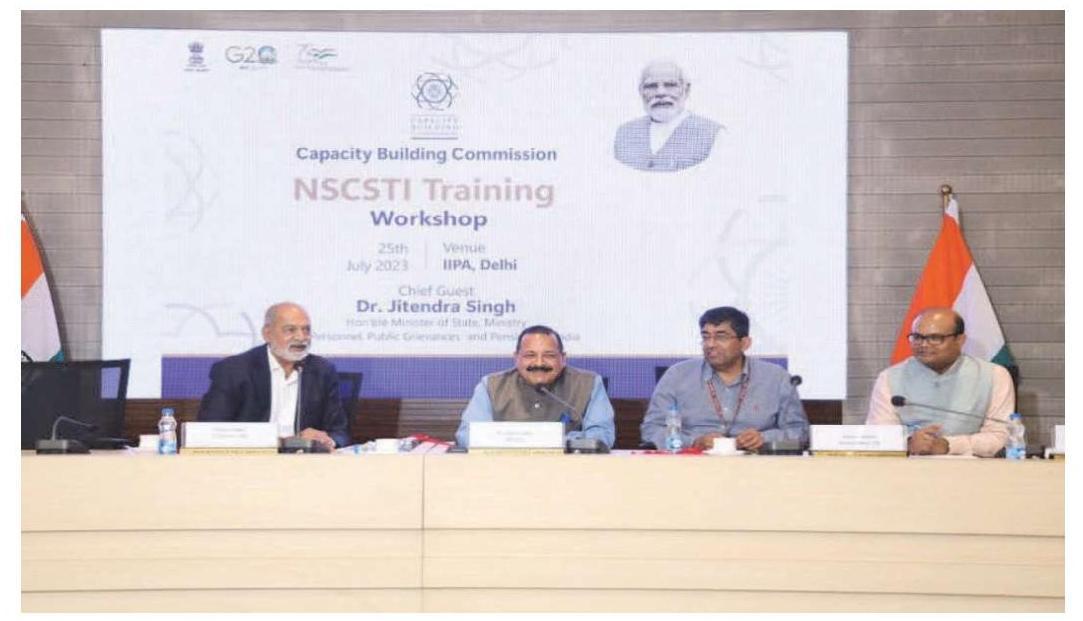
25July 2023: Capacity Building Commission hosted a workshop for Civil Services Training Institutes on National Standards for Civil Service Training Institutions
(NSCSTI) accreditation framework on 25th July 2023. The program was hosted jointly by CBC and NABET at IIPA, New Delhi
e. NSCSTI Framework -The NSCSTI framework aims to introduce benchmarks on key parameters for CSTIs as a means for continuous improvement of these Institutions. This portal is aimed at setting common standards of excellence and promote organizational improvement through continuous self-assessment of Training Institutes. This would also institutionalize a forum to highlight best-practices and facilitate collaborative learning, and give direction for long-term strategic planning.
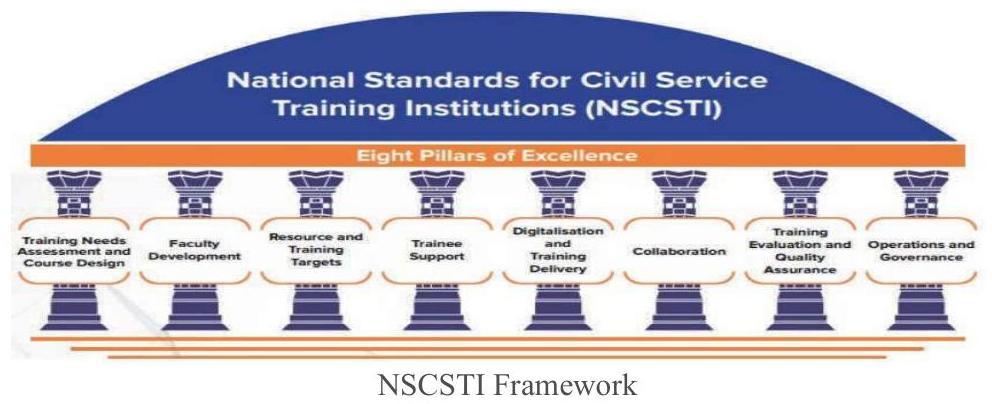
f. Knowledge Partnerships: CBC has entered into knowledge partnerships with various Institutions for capacity building of civil servants by leveraging expertise of these academic & other institutions. So far it has entered into partnerships with 45 such institutes.
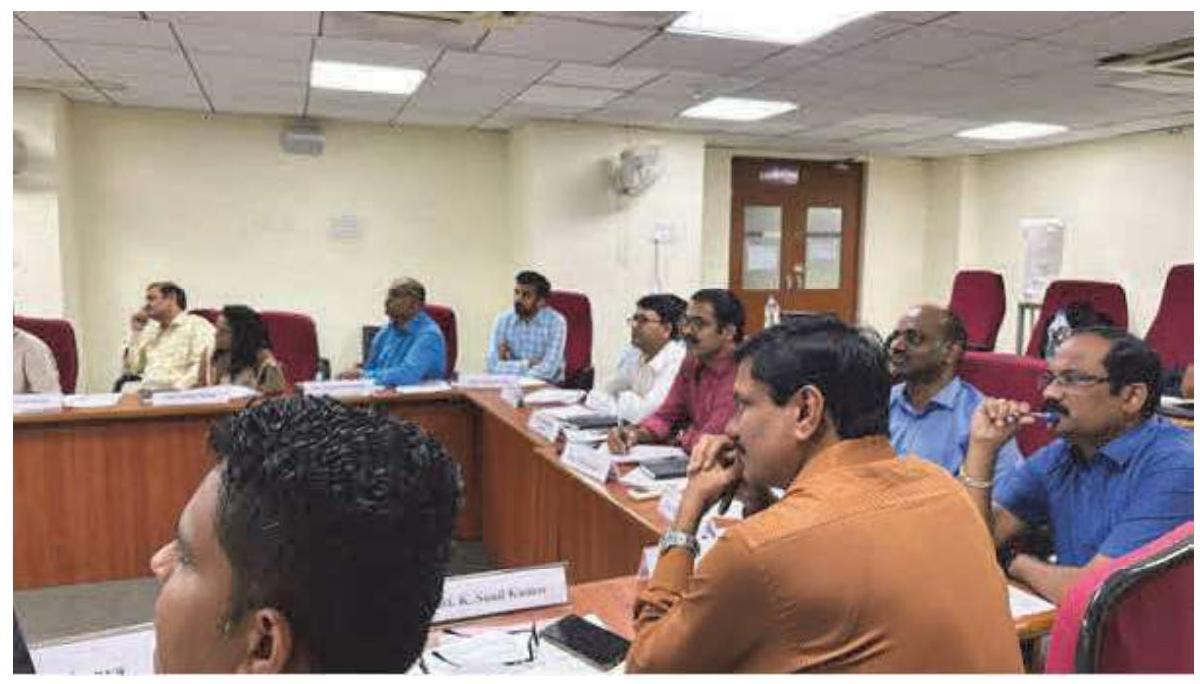
02 August 2023: Faculty Development Programme in collaboration with the Indian School of Business was conducted at the Yashwantrao Chavan Academy of Development Administration (YASHADA), Pune.
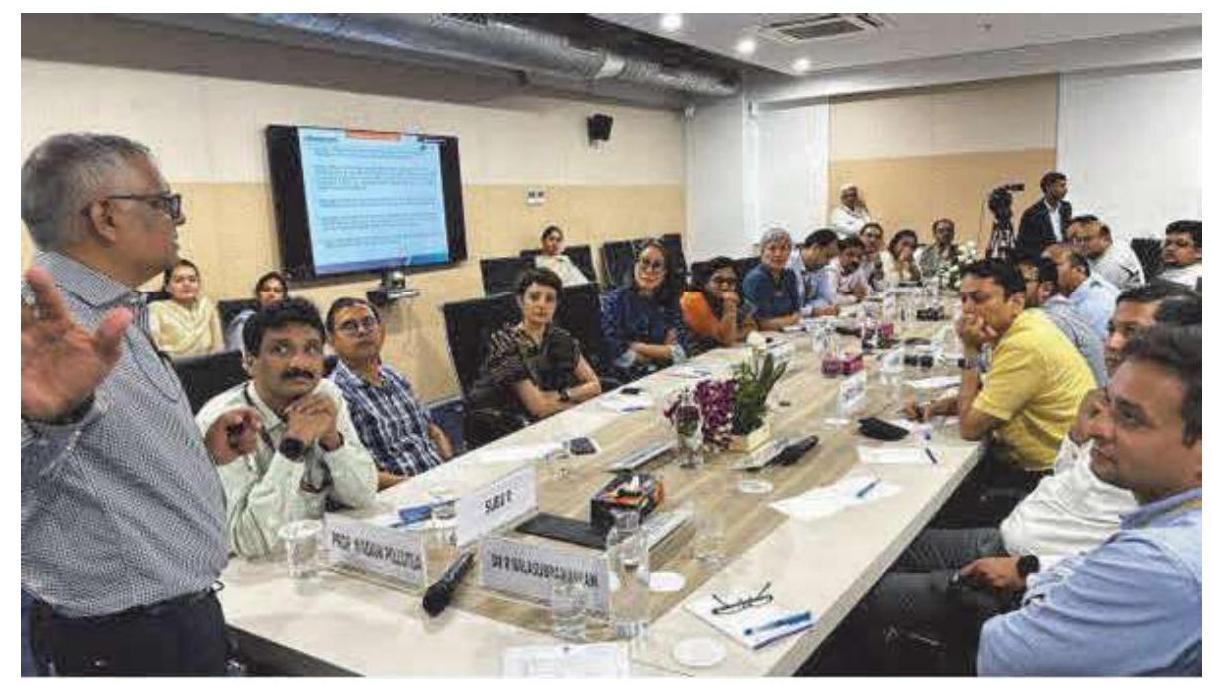
$10^{\text {th }}$ August 2023: The officers trained for the Common Mid-Career Training Programme CMCTP came together to share and gather knowledge and inspire others in the regional event for the “Community of Leaders” from North India.
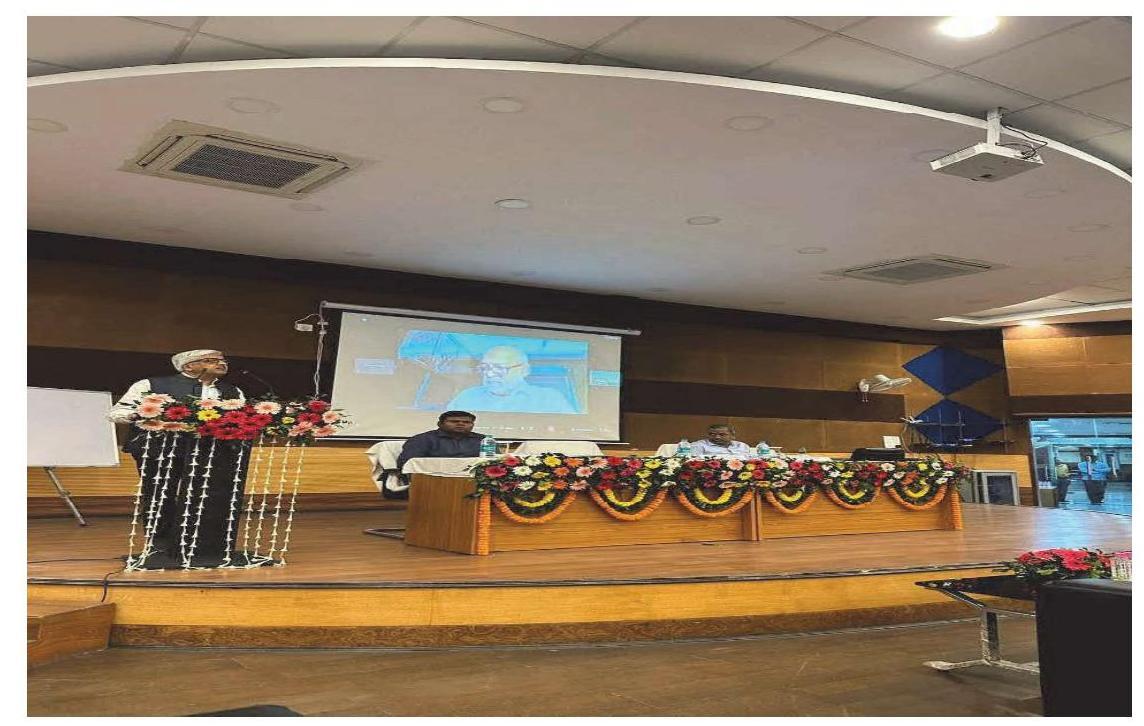
25 September 2023: The Capacity Building Commission hosted a workshop for the Civil Services training institutes at Sri Krishna Institute of Public Administration (SKIPA), Ranchi.
g. Behavioural competency reinforcement measures: Commission has undertaken Large Scale Interventions for sustainable behavioural changes amongst the public facing Government officials, with active involvement of stakeholders throughout the system with the objective to improve interactions with citizens for better citizen experience (Citizen Centricity) and re-awakening the aspiration to serve (Sewa Bhav) amongst the public servants. It has piloted large scale interventions with various citizen – facing agencies like Railways (Rail Karmayogi program); Dept. of Posts (Dak Karmayogi Program); Ministry of Home Affairs, Ministry of Youth Affairs (MoYA); Ministry of Electronics & IT (MeitY); BSNL; UT Police Forces (Police Karmayogi Program) and Delhi Police to co-develop short, self-paced digital modules focused on building behavioral competencies and have trained over 4.3 lakh citizen facing officials. CBC in collaboration with Central Board of Direct Taxes (CBDT) has also created a training program on Grievance redressal of taxpayers as part of its large-scale intervention taken by 8000 IT officers. Similar engagement with CBDT is being undertaken.
h. The Capacity Building Commission has initiated, curated and coordinating and supporting a network of senior practitioners of public leadership as a part of Community of Practice to provide a sense of continuity \& Purpose to share the knowledge created to and facilitate collective learning from the course.
i. Innovation in Public Administration: CBC launched the programme “Innovation in Public Administration” to share innovative practices that Govt. employees across Central, State or Local Govts. (including A, B or C) have undertaken in public Administration. These submissions would be used as case studies for Capacity Building of present and future civil servants, and to assist in developing a knowledge Repository that can be accessed by all, to scale-up innovation in the country.
j. Targeted Capacity building initiatives: CBC has onboarded $80+$ courses on Karmayogi Bharat Platform with course enrolment over 23.5 lakhs and over 16 lakhs course completion. CBC created the physical course on ‘Emerging Technologies’ in collaboration with Institute of Public Administration (IIPA) and Wadhwani Institute of Technology and Policy). Designed as an introduction on key emerging technologies for civil servants, wherein the online part of the course is available on iGOT, has been undertaken by 2,22,910 officials. CBC has also facilitated other function courses like the 10 Microsoft courses, courses on Cyber Security and Cyber Shiksha which has seen course completion by over 3.15 lakhs Govt. officials.
k. CBC has also assisted various Ministries / Departments in carrying out Immersion Program with Industry Partners for deep hands on experience of the subject matter being dealt by the Government officials in the Ministries / Departments.
- Faculty Development Programs: CBC is also conducting Faculty Development Programs for building capacity of the Training Institutes across the country. CBC also organized a workshop to train Central Training Institutes (CTIs) and State Training Institutes (ATI) faculty members in developing case studies.
m . CBC has also been providing policy recommendations to DoPT and iGOT on various issues. The Karmayogi Guidelines has been framed by DoPT with inputs from CBC. The Commission has also been supporting Karmayogi Bharat with policy recommendations for the content framework on iGOT.
Capacity Building interventions in DoPT
7.15 Launch of Capacity Building Plan of DoPT: The Capacity Building Plan (CBP) of DoPT, prepared in consultation with CBC, was launched by Dr. Jitendra Singh, Hon’ble MoS (PP) on 27/09/2023. The CBP consists of both training & non-training interventions. At an individual level, based on competency requirements identified for each unique role, training interventions have been recommended across domains. Training calendar has been circulated and over 150 employees of DoPT have already consumed prescribed courses for first and second quarters.
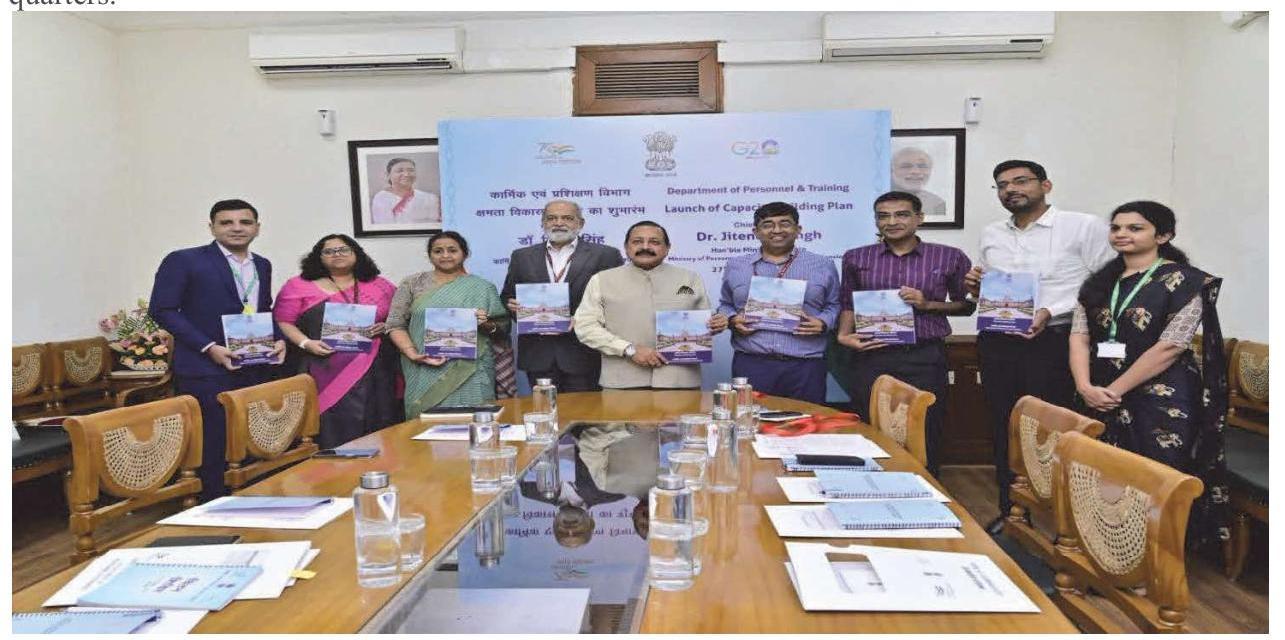
27 September 2023: Launch of Capacity Building Plan of DoPT by Dr Jitendra Singh, Hon’ble MoS (PP) at North Block, New Delhi
7.15.1 Chintan Varta and HR Immersion Workshop- The Chintan Varta and HR Immersion Workshop was organised on 27-09-2023 for officers of DoPT for discussion on Public HR best practices like – Learning and Development and linkage to career progression, employee wellbeing, HR Technology and data driven decision making.
7.15.2 Orientation Workshop for attached/ subordinate offices of DoPT – An Orientation Workshop was organized on $02 / 02 / 2024$ to create a shared understanding of the training and capacity building landscape under the National Programme for Civil Services Capacity Building – Mission Karmayogi and to support the implementation of the Program in the organizations of DoPT. These organizations have onboarded their employees on iGOT platform and have started implementation of Mission Karmayogi guidelines.
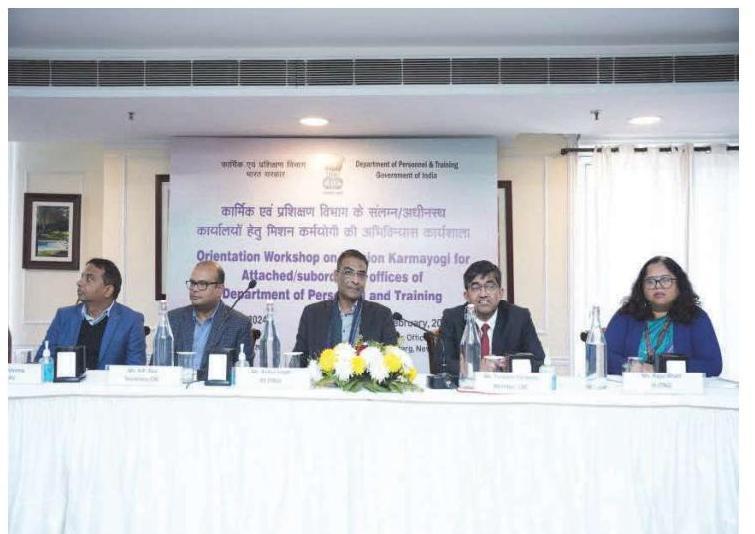
02 February 2024: Orientation Workshop for attached/ subordinate offices of DoPT held at CSOI, New Delhi
7.15.3 Launch of courses on iGOT Karmayogi Platform – 12 courses developed by the Karmayogi Digital Learning Lab, established at ISTM, was launched onto iGOT Karmayogi platform by Hon’ble MoS (PP) on 25/12/2023 during Good Governance Week.
7.16 Karmayogi Guidelines, 2023
To equip the civil services with the right attitudes, skills, knowledge and competencies aligned to the demands and expectations of a rapidly growing economy and its aspirational citizens, Government of India launched the National Programme for Civil Services Capacity Building (NPCSCB) – Mission Karmayogi. The Mission aims at developing a citizen-centric and futureready civil service and through democratized and competency-led capacity building, which encompasses in its scope a mandate that unifies the efforts of structured, formal and service-based training through Civil Service Training Institutions (CSTIs) with the on-demand digital training through iGOT- Karmayogi platform.
It is envisaged that the institutional training interventions in ‘complementarity with online capacity building interventions on iGOT would facilitate the overall objective of shift from rulebased system to a role-based Human Resource Management in Government. The National Training approach, therefore, has to harmoniously blend and realign the role of various CSTIs so as to fully complement the efforts of other pillars of Mission Karmayogi.
To bring more clarity to the roles and responsibilities of various stakeholders in the training and capacity building landscape, including that of the institutions established under the Mission Karmayogi, namely, the Capacity Building Commission and the Karmayogi Bharat SPV. Therefore, “Karmayogi Guidelines, 2023” were issued vide OM No. No. T-16017/6/2023-TFA dated $28^{\text {th }}$ July, 2023. All the Ministries / Departments, including CSTIs and other organizations functioning under their administrative control, were requested to comply with the guidelines. In so far as the State Governments are concerned, it the guidelines recommend formulation of comprehensive guidelines for training and capacity building of their employees, in consonance with these guidelines, to enable achievement of citizen-centricity and effective public service delivery. These guidelines can be accessed at https://documents.doptcirculars.nic.in/D2/D02trn/KARMAYOGI%20GUIDELINES\%202023vA 6zZ.pdf
7.17 Guidelines for Awards / Medals / Memorial Lectures instituted by CTIs
The Central Training Institutes (CTIs), under the administrative control of various Ministries/ Departments have been conducting induction and mid-career training programmes for various cadres of Government of India. In order to motivate the participants to perform better in the academic/extra-curricular activities during training, a number of measures are undertaken by the CTIs. Such measures include giving recognition by way of Awards / Rewards / Medals / Certificates etc. Some CTIs have also instituted Memorial Lectures in the name of eminent personalities etc. The expenditure on these awards / rewards / medals / certificates / memorial lectures is borne either from Government funding or through one time/recurring endowments from non-government entities.
To bring about uniformity and transparency in institution of such Awards etc, guidelines have been issued vide OM No No. T- 160 I 7/02 / 2023-TF A dated $24^{\text {th }}$ May, 2023 requesting all the Ministries/Departments to instruct the CTIs under their administrative control to comply with the Guidelines’. These guidelines are available at https://documents.doptcirculars.nic.in/D2/D02trn/award\%20guidelinesSEp6e.pdf
7.18 Rajbhasha Guidelines for training institutions
In pursuance of recommendations of the Committee of Parliament on Official Language, DoPT, vide OM No. T-19011 /1 /2023-NTP dated $1^{\text {st }}$ January, 2024 exhorted the Central Training Institutions for strict adherence to Rules/ Guidelines for Training Institutions contained in the Rajbhasha Rule Book. The instructions are at https://documents.doptcirculars.nic.in/D2/D02trn/Lr%20to\%20CTIs\%20for\%20use\%20of\%20Hi ndiocSXR.pdf
7.19 Clarification on need for seeking permission from office to pursue courses available on iGOT Platform
A clarification was issued vide DoP&T OM No. T-19011/1/2024-NTP dated $15^{\text {th }}$ January, 2024, indicating that the instructions for seeking permission from the office to pursue courses do not apply to online courses made available on iGOT Platform. The clarification is available at https://documents.doptcirculars.nic.in/D2/D02trn/No\%20Permission\%20for\%20iGOT\%20Course s11OLk.pdf
7.20 Central Sector Scheme – “Training for All”
Training Support is given under Training For All (TFA) Scheme through the following components:
a) State Category Training Programme (SCTP)
b) Trainers’ Development Programme (TDP) \& Faculty Development Scheme (FDS)
c) Comprehensive Online Modified Modules on Induction Training (COMMIT)
d) Augmentation of Capacity of Training Institutions (ACTI)
7.20.1 “Training for All (TFA)” is a Central Sector Scheme sponsored by Department of Personnel \& Training. The Scheme has been in operation since 1992. The objective of the Scheme is capacity building of all the Government officials at National and State levels through training interventions to provide training for all viz. developing management skills and knowledge in different areas for senior and middle level officers of State Governments / State Public Sector Undertakings and State Autonomous Bodies; development of a cadre of professional trainers and resource persons in the country; improving functional knowledge, skill and attitudinal orientation of the frontline functionaries; imparting training, including training on soft skills, to the newly recruited cutting edge level functionaries of the State Governments in order to strengthen the public service delivery mechanism; providing opportunity to trainers / faculty members of various Central and State Training Institutes to undergo short-term training programmes in the institutions of excellence within the country to supplement their knowledge and skills; augmenting the existing training mechanism with online module-based training, coupled with certification to government servants; and providing financial support to the State ATIs for augmenting infrastructure.
7.20.2 State Category Training Programme (SCTP): Under this component, support is provided to State / Union Territory (UT) Administrative Training Institutes (ATIs) by way of sponsoring training programmes in the areas accorded priority by the Central Government. The programmes are designed for senior and middle level officials of State / UT Governments / State Public Sector Undertakings and State Autonomous Bodies to develop management skills and knowledge in different areas and also to sensitize about new and important issues facing our society. The courses cover a large variety of subjects under broad thematic groups such as Ethics in Administration, Disaster Management, Right to Information, Gender Issues, Decentralized Planning, Role \& Responsibilities of DDOs, Financial Management, Environment \& Climate Change, e-Governance, Cyber Security, Leadership \& Team Building, Disaster Management \&
Climate Change, Legal Literacy for Government Servants, Training in Administrative Vigilance, Public Private Partnership, Revenue Resource Mobilization through VAT/GST/IT etc.
During the year 2023-24, this Department has sponsored 710 SCTP courses to various State / UT ATIs on several thematic subjects.
7.20.3 Trainers’ Development Programme (TDP) & Faculty Development Scheme (FDS): Recognizing the importance of trainers in the training function, the TDP was started in the early 1990s. Over a period of time, indigenous mechanisms were evolved for developing a cadre of professional trainers and resource persons in the country to create a cascading and multiplier effect by developing the Central / State / UT employees as Master Trainers and Recognized Trainers of various “Training of Trainers (ToT)” packages. The programme has gone a long way in embedding the Systematic Approach to Training (SAT) into the process of designing and imparting effective training to government officials. Under the component, financial assistance is provided to State / UT ATIs \& selected Central Training Institutes (CTIs) to develop a cadre of professional trainers and resource persons in various ToT packages.
The following ToT programmes are sponsored under the TDP component which are conducted by various training institutions across the country:
- Training Needs Analysis (TNA)
- Design of Training (DOT)
- Direct Trainer Skills (DTS)
- Evaluation of Training (EoT)
- Management of Training (MoT)
- Experiential Learning Tools (ELT)
- Mentoring Skills
- Facilitation Skills
- Introduction to SAT courses
During the year 2023-24, this Department sponsored 105 TDP courses to various Central / State Training Institutions.
To align the SCTP and TDP components with Mission Karmayogi, it has been stipulated that the ATIs register participants onto the iGOT platform and to usese the e-courses / content already available on the platform, to the extent possible. The Institutes have also been requested to register for accreditation under the National Standards for Civil Service Training Institutions developed by the Capacity Building Commission under Mission Karmayogi.
This Department has been implementing the FDS with a view to broadening and honing the knowledge and skill base of the trainers/faculty members working in the training institutes. All Master Trainers/Recognized Trainers (MTs/RTs) developed by this Department under Trainers Development Programme (TDP), faculty members working in Central Training Institutions (CTIs) and State Administrative Training Institutions (ATIs) for conducting domestic trainings are eligible for support under the Scheme. The trainers / faculty are sponsored to undergo training in domestic short duration programmes / correspondence courses conducted by premier Intuitions.
7.20.4 Comprehensive Online Modified Modules on Induction Training (COMMIT): A Blended Training Programme was conceptualized and launched in 2017 in the backdrop of the mandate of the National Training Policy, which stipulates that all civil servants from lowest level functionaries to the highest level will be provided training at the time of their entry into civil
service and mandates that priority will be given to the training of front-line staff, including training on soft skills, so as to improve customer orientation as well as quality service delivery to the citizen.
The blended course allows officers and faculty to take advantage of flexibility and convenience of an online course while retaining the benefits of the face-to-face classroom experience. The mission and goal of COMMIT is to develop skills and attitude towards improving service delivery keeping the citizen at the core. The advantage of such a blended programme is requirement of limited classroom space; to infuse new opportunities to officers who have had limited or no training to build the requisite skills, knowledge and attitude; and offer the convenience of online learning combined with the social and instructional interaction that may not lend themselves to online delivery (e.g. motivational talk, understanding of the vision and proctoring assessments).
The COMMIT component has been aligned with the National programme for Civil Services Capacity Building (NPCSCB) – Mission Karmayogi by providing the programme on iGoT Karmayogi platform from 2023-24.
The COMMIT programme comprises of 15 e-courses ( 12 Generic and 3 Domain specific) which is of 28 hours duration. The registered/ enrolled participants complete 3 (three) e-courses on soft skills during one day ( 8 hours) orientation-cum-registration session. The participants complete the remaining 12 courses from the iGOT – Karmayogi platform in 60 days time thereafter.
During 2023-24, this Department sponsored COMMIT programme for 36210 trainees covered through 11 State Training Institutions.
7.20.5 Augmentation of Capacity of Training Institutions (ACTI): Under the ACTI component, support is provided to the State / UT ATIs for augmenting infrastructure in the form of hardware, software and courseware, networking of training institutions and consolidating the training ware. The Training Institutes are also supported and encouraged for developing case studies, e-learning packages, training films, organizing workshops, special programmes, seminars etc. The funds are released to those ATIs who seek financial assistance for up-gradation of their training capacity.
The component is being reviewed keeping in view the changes taking place in technology in the training and capacity building ecosystem and need for alignment of the scheme with Mission Karmayogi.
Long-Term Domestic Post Graduate programmes in Public Policy and Management
7.21 The courses sponsored by Department of Personnel & Training under Long Term Domestic Program Scheme are as under: –
(i) Post Graduate Program in Public Policy and Management (PGPPM) at the Centre for Public Policy, Indian Institute of Management, Bangalore;
(ii) One-year Diploma Program in Public Policy and Sustainable Development (PP \& SD) or Two-year M.A. (Public Policy and Sustainable Development) Degree Program at the TERI School of Advance Studies, New Delhi;
(iii)Post Graduate Diploma Program in Public Policy and Management (PGDM-PPM) at Management Development Institute, Gurugram;
(iv) One-year Advanced Management Program in Public Policy (AMPPP) at Indian School of Business, Hyderabad/ Mohali;
These programs have been envisaged to enhance the competence of Mid-Career Civil Servants in Public Policy and Management by –
(i) Broadening awareness of the latest trends in policy approaches,
(ii) Developing technical, analytical and leadership skills for public policy,
(iii) Providing opportunity in specialization and
(iv) Exposing them to alternative systems of public management in other countries.
During 2023-24, $8^{\text {th }}$ Batch of One-year Advanced Management Program in Public Policy (AMPPP) commenced on $11^{\text {th }}$ August, 2023 at Indian School of Business- Hyderabad/ Mohali, which is being attended by 28 participants. $15^{\text {th }}$ Batch of Program in Public Policy & Sustainable Development (PP \& SD) commenced on $9^{\text {th }}$ October, 2023 at TERI School of Advance StudiesNew Delhi, which is being attended by 2 participants. $16^{\text {th }}$ Batch of Post Graduate Diploma in Management-Public Policy and Management (PGDM-PPM) commenced on $27^{\text {th }}$ September, 2023 and is being attended by 8 participants. $20^{\text {th }}$ Batch of Post Graduate Diploma in ManagementPublic Policy and Management (PGDM-PPM) commenced on $03^{\text {rd }}$ October, 2023 and is being attended by 15 participants.
A workshop to review/revamp LTDP scheme with all the stakeholders was conducted on 26.12.2023 at Civil Services Officers’ Institute (CSOI), K.G. Marg, New Delhi.
Mid-Career Interaction between Armed Forces and Civil Services Officers
7.22 Mid-Career interactions programme (MCIP) between Armed Forces and Civil Services Officers are being organized at the Central Training Institutes/State Administrative Training Institutes and Defence Institutions in various parts of the country with the objective to benefit both the Armed Forces and Civil Services Officers by way of mutual learning from each other’s strength and also by imbibing the best points of each other’s work culture, ethos and customs. This, in the long run, is expected to help the participating officers to combat future challenges to national security in a better manner.
During the current financial year 2023-24, 4 programs have been planned- one by DoP\&T and three by M/o Defence i.e. each by Army, Navy \& Airforce. The MCIP were conducted at $15^{\text {th }}$ Infantry Division (Army), Amritsar, Gopabandhu Academy of Administration (GAA), Bhubaneshwar, Orissa, Maritime Warfare Centre- Vishakhapatnam (NAVY), and College of Air Warfare- Secunderabad (Air-Force) on the themes ‘Threat on India’s Internal Security by Radicalization and information warfare’, ‘Disaster Management’, ‘Maritime Security of India’, and ‘Whole of Nation’. Out of these, three programs have already been conducted and the fourth MCIP at College of Air Warfare- Secunderabad (Air-Force) is scheduled from $12^{\text {th }}$ to $14^{\text {th }}$ February, 2024.
Overseas Training Programmes
7.23 Department of Personnel and Training has been nominating officers for training programs abroad. In the past, these programs were funded by bilateral or multilateral assistance. Keeping in view the importance and benefits of providing international exposure to the officers, a scheme of Domestic Funding of Foreign Training (DFFT) was started in 2001 with Government of India funding. This covers both long-term and short-term training in various universities/institutes in several countries. A scheme of “Partial Funding of Foreign Study” was also started in 2002-03 as another component of the scheme of DFFT under which Government of India provides limited financial assistance to such officers who secure admission in reputed universities and in programs relevant to their present or future career in the relevant field.
During 2023-24, the DFFT programs could not be conducted since there was restriction imposed on foreign training due to the outbreak of COVID-19. The Officers were nominated for
programmes supported by foreign agencies under bilateral programmes in which 13 officers have been nominated for Knowledge Co-Creation Program of Japan International Cooperation Agency (JICA) held in Japan under the Technical Cooperation Program of the Government of Japan and 3 officers were nominated for one year Masters Degree Course in “School of Government” and “School of Local Governance” under Young Leaders Program (YLP) offered by Embassy of Japan held at the National Graduate Institute for Policy Studies, (GRIPS) Tokyo, Japan.
One-week In-Service Training (IST) Programme for Officers of All India Services, those working under Central Staffing Scheme and Officers of Central Secretariat Service (CSS) and Central Secretariat Stenographers Service (CSSS).
7.24 The Training Division sponsors ‘In-Service Training Programme’ of ‘one-week duration’ in various ATIs/CTIs/ Premier Training Institutes in the country by inviting proposals from them on relevant themes. During the year (2023-24), 18 programmes (Physical/Offline mode) are being offered at 18 training institutions and 2 programs (Online mode) are being offered at 2 training institutions. These programmes provide middle and senior management level officers an opportunity to update their skills in areas of their choice-in sectors they are currently working in, or in areas they are expected to work in the near future, or in areas they want to specialize in. These programs also provide a valuable platform for horizontal and vertical knowledge sharing.
The primary objective of the IST program is to sensitize the participants to national concerns and the values enshrined in the Constitution; to provide for exchange of experience and adequate discussions on issues of values, ethics and attitudes; to make the participants more confident to face problems in their work areas and attempt solutions; and to train the participants to look at problems in an integrated manner and develop a systematic approach.
In the past, these programs have been offered in diverse and broad thematic areas: such as Administrative Law, Agricultural & Rural Development, Climate Change (preparedness), Competition Law (policy formulation), Corruption (eradication strategy), Education (reforms \& challenges), E-governance (opportunities \& challenges), Environment \& Natural Resource (management), Environmental Impact Assessment (development projects), Ethics (Public Governance and Administration), Financial Markets (regulation), Fiscal Policy (Macroeconomic Management), Governance (IT management and improving through accountability), Infrastructure (Finance), Innovations (public service), Land Acquisition (rehabilitation \& resettlement), Leadership, Participatory Management (Community Mobilization), PPP (negotiating strategies and urban development), Procurement (procedure \& contracting), Project Analysis/Appraisal (risk analysis/management), Public Policy (management/governance), Quantitative Methods (management), Service Delivery (management), Social Policy (Governance), Social Sector (financing/marketing), Urban Development, WTO (basic/advance course), Citizen Centric, Cyber Crime, Stress Management, etc.
Advanced Professional Programme in Public Administration (APPPA) At Indian Institute of Public Administration, New Delhi
7.25 The Training Division has been sponsoring a ten-month Advanced Professional Programme in Public Administration (APPPA) at the Indian Institute of Public Administration (IIPA), New Delhi every year since 1975-76.
The objectives of this programme are to prepare the participants to make greater contribution to better governance, develop attitudes that focus on citizen services and also to strengthen leadership qualities in the civil service. It provides an opportunity to the participants to analyze major contemporary issues in Governance, learn about recent developments in the social sciences and their application in administration; review their experiences by making a critical analysis of environmental and other factors, apply relevant concepts, skills and techniques relating to policy, behavioral and administrative sciences and to demonstrate their creative and analytical abilities individually and in groups. It also seeks to develop interpersonal skills and sensitiveness to the needs of the people with a view to making administration more responsive and result oriented.
An officer with at least 10 years of Group ‘A’ (class-I) service and at least of the rank of Director/Deputy Secretary in the Government of India or holding an equivalent post is eligible for APPPA course. The Programme is also open for senior officers (Group ‘A’) from State Services.
This 10 -month programme includes three semesters, rural and urban field visits in India and a two-week foreign study tour. The $49^{\text {th }}$ APPPA course in this series commenced from $3^{\text {rd }}$ July 2023 and is scheduled to end on April 30, 2024 and 27 officers are attending for the said course.
7.26 Indian Institute of Public Administration
Indian Institute of Public Administration (IIPA), New Delhi is an Autonomous Research and Training Institute of National Importance under Department of Personnel & Training (DoPT), Government of India. IIPA was established on 29th March 1954 for promotion of Public Administration in post-colonial era and changing the colonial mindset of the Civil Services.
Presently, the Hon’ble Vice President of India Shri Jagdeep Dhankhar, is the President of IIPA and Hon’ble Union Minister of State, Ministry of Personnel, Public Grievances and Pensions, Dr. Jitendra Singh is the Chairman of IIPA Executive Council. Shri Surendra Nath Tripathi, IAS (R), Former Secretary, Ministry of Parliamentary Affairs, Government of India is the present Director General of IIPA. IIPA Executive Council includes, among others, the CEO, NITI Aayog, Secretary (P), DoPT, Secretary (Expenditure) and Director, LBSNAA, Mussoorie.
The activities of IIPA include research, training, publication and dissemination of information in the field of Public Administration \& Governance. Every year IIPA conducts around 20-30 Research Studies which consists of evaluation of government schemes, policy advisory and policy analysis for different Ministries / Departments of Government of India, State Governments and International Organizations. IIPA Applied Research Wing gained a qualitative upswing with specific governance areas of concern. IIPA faculty completed around 17 research studies for various Central Ministries and State Governments till December 2023.
llPA conducts over 120 training programmes every year for officers of Government of India, State Governments, PSUs, Defence Forces and Foreign Governments. IIPA has been conducting training for Chief Information Security Officers’ Deep Dive Training on Cyber security (Under
Cyber Surakshit Bharat Initiative) (Sponsored by NeGD, MeitY, Govt. Of India), Advance Leadership Programme (ALP) sponsored by (PSUs), Induction Training Programme on Public Administration and Governance cum Exposures visits for the Odisha Administrative Services Officers Trainees (Sponsored by Gopabandhu Academy of Administration Government of Odisha) Training Programme cum Exposure Visit For Gujarat Administrative Service (Sponsored by Sardar Patel Institute of Public Administration), Capacity Building programme for Vigilance Awareness Campaign (Sponsored by Census Commissioner of India), International Capacity Building Programme on Innovations in Organizational Management, Foundation Training Programme of Department of Science & Technology, Capacity Building Programmmes By DST etc. IIPA has conducted 96 training programmes till December 2023.
Advanced Professional Programme in Public Administration (APPPA) is 10 months long programme for Mid-Senior Civil Servants and Defence Forces Officers is the flagship programme of IIPA under the aegis of Department of Personnel and Training (DoPT), Government of India. The $49^{\text {th }}$ APPPA commenced on $3^{\text {rd }}$ July 2023. Hon’ble Union Minister Dr Jitendra Singh interacted with the participants on $3^{\text {rd }}$ July 2023. Total Twenty-Seven (27) participants are participating, majority of them being from all tri- services of armed forces and others from ITS, Indian Postal Service, Military Engineer Services (MES and other Civilian Officers.
The Institute disseminates information, analyses viewpoints and knowledge related to public administration, governance, policy and public administration, governance, policy and development through its regular publications viz., monthly digital edition of IIPA Newsletter, quarterly editions of Indian Journal of Public Administration (IJPA) in association with Sage Publications, quarterly editions of Nagarlok, Documentation in Public Administration (DPA), biannual editions of Lok Prashashan (Hindi Journal) and quarterly editions of IIPA Digest. IJPA, Nagarlok and Lok Prakashan, all three are also listed in the UGC- Care List of Journals.
IIPA has prepared commendable Digital Infrastructure and it has now VC equipped eight Lecture Halls for conducting both online/offline programmes. In fact, IIPA has prepared all the Digital Material for APPPA and other Online Programmes. IIPA is an important cog in the wheel of Mission Karamyogi, the National Programme for Civil Services Capacity Building. IIPA has also prepared and uploaded several Capacity Building Programmes on “iGOT”. IIPA is an active partner of Capacity Building Commission (CBC) and holding several programmes in collaboration with CBC.
IIPA receives grant-in aid from DoPT, Govt. of India under Salary, General and Capital heads. For BE 2023-24, IIPA has been allocated Rs. 8.49 crore under Salary, Rs. 7.00 crore under General and Rs. 9.01 crore under Capital i.e. total of Rs. 24.50 crore.
7.27 Assistant Secretary Training Programme in Union Ministries
The Department of Personnel and Training is entrusted with the implementation of Assistant Secretary Training Programme to provide exposure to the young IAS officers to Government of India functioning at early stage(s) in their career on completion of their phase II Training at LBSNAA, Mussoorie.
This exposure helps them acquire a national perspective and appreciation of diversities in national policies. This also sensitize them to the larger perspective of policies \& programmes of
Government of India and the officers are likely to be an inspired Change Agents when they go back to their cadre States. As primary implementers of Programmes/Projects in the field (States), this exposure also facilitates a broader macro perspective.
The programme started in 2015 as per vision of Hon’ble Prime Minister when 2013 batch officers were posted in as Assistant Secretary in Ministries/Departments. The programme is successfully continuing since then and so far, 1037 IAS officers have come on Central Deputation till 2022. The programme could not be held in $2020 & 2021$ in respect of the IAS officers of $2018 \& 2019$ batches due to pandemic COVID-19.
However, after completion of 6 years of implementation of this programme as Central Deputation of the IAS officers, a need was felt to review the existing design, structure, duration and framework of the present programme to ensure its alignment with overall objectives of this programme. Accordingly, after wide stakeholders’ consultations, and with the approval of Competent Authority, the programme has been revamped in terms of its design, structure and framework to ensure its alignment with overall objectives of this programme. In 2023, the programme has been incorporated as a part of the Induction Training of the IAS officers. The duration of the programme has been reduced from 13 weeks to 8 weeks.
In the revised programme, conducted between 21.08.2023 to 13.10.2023, a total of 182 Officer Trainees were attached with 44 Ministries/Departments of the Central Government handling flagship schemes/programmes/missions. They were given pre-joining reading material as part of their learning related to the concerned Ministries/Departments through “Gyan” portal of LBSNAA which included annual reports of last financial year, Acts administered and flagship scheme/important programme details of the concerned Ministries/Departments.
During this period, they worked exclusively as Desk Officer/Assistant Secretary in the respective Ministries/Departments. The programme was structured as below:
i. One-day orientation programme for the IAS officers of 2021 batch held on the first day by DoPT.
ii. Out of the 8 weeks, 6 days spread across 8 weeks assigned to formal interaction with dignitaries, like Hon’ble President, Hon’ble Vice President, Hon’ble Prime Minister, MOS(PP), national agencies and organizations, exclusively in the domain of the Central Government.
iii. Seven weeks of intensive exposure to one Ministry/Department with the following assignment:
a. The OTs prepared two policy critique papers on Policies of national importance/ flagship scheme/missions with data analytics; gap analysis, identification of the bottlenecks etc and also to give suggestions for improvements. This is a group activity and includes Scheme Description, International Comparison, Data sets, Dashboards, Research Methodology, Study Evidence, Research Papers etc.
b. Involved in major stakeholder consultations related to intra/ inter-ministerial synergetic efforts in the implementation of various schemes/projects/missions etc. and to record the discussions.
c. Involved in matters related SFC/EFC, DIB/PIB processing, Cabinet Note making, Parliamentary Work, Establishment matters etc.
Besides the above, an online orientation module has been prepared by the LBSNAA related to the functioning of Central Government which is available on LBSNAA portal.
The Assistant Secretaries prepared and submitted their analysis paper/ report on policies to the Secretary of the respective Ministry/Department as well as on the GYAN portal of LBSNAA. Secretary/SGOS guide and assess the Assistant Secretaries based on their overall performance, analysis paper/report prepared on the policies of the respective Ministry /Department. Secretary of the respective Ministry/Department also certify the satisfactory completion of this attachment with the Ministry/Department. This is mandatory for successful completion of Induction Training of the Officers.
The following activities were undertaken by the Assistant Secretaries 2021 batch during their Central attachment:
a. The orientation-cum-inaugural session of the programme was held on 21.08.2023 at Vigyan Bhavan. The programme was presided over by Principal Secretary to the Prime Minister.
b. The Assistant Secretaries were given exposure to work relating to G20 Summit on 19.09.2023 at Sushma Swaraj Bhawan, New Delhi.
c. They had an interaction with Hon’ble MoS (PP) on 20.09.2023 CSOI Vinay Marg, New Delhi.
d. The officers called on Hon’ble President of India on 25.09.2023 at Rashtrapati Bhavan.
e. The officers participated in one hour of Shramdaan for Swachhata at 10:00 am on $1^{\text {st }}$ October, 2023 at the clarion call of Hon’ble Prime Minister as a ‘swachhanjali” to Bapu on the eve of his Jayanti.
f. They also called on Hon’ble Vice President of India on 04.10.2023 at Vice President Secretariat.
g. The Hon’ble Prime Minister had an interaction with the Assistant Secretaries on 10.10.2023 at Sushma Swaraj Bhawan, New Delhi.
h. The valedictory ceremony of the programme was organised on 12.10.2023 at Vigyan Bhavan under the chairmanship of Cabinet Secretary.
10. Online feedback on various aspects of the programme was obtained from the Assistant secretaries through the format uploaded on “Gyan” portal of LBSNAA.
CHAPTER 8
TRAINING INSTITUTIONS
LAL BAHADUR SHASTRI NATIONAL ACADEMY OF ADMINISTRATION, MUSSOORIE (UTTARAKHAND)
8.1.1 Introduction
The Lal Bahadur Shastri National Academy of Administration (LBSNAA), Mussoorie, is Government of India’s premier institution for the training of higher civil services in the country.
8.1.2 History of the Academy
On April 15, 1958, the then Union Home Minister Pandit Govind Ballabh Pant announced in the Lok Sabha, that the Government would set up a National Academy of Administration, where training would be given to all the recruits of the Civil Services. The Ministry of Home Affairs also decided to amalgamate the IAS Training School, Delhi and the IAS Staff College, Shimla to form a National Academy of Administration to be setup in Mussoorie’s Charleville Estate. On the first day of September, 1959 curtains were drawn on the training in Metcalfe House. Union Home Minister Pandit Govind Ballabh Pant was instrumental in effecting this shift to Mussoorie. Charleville was not a very comfortable venue initially but niggling glitches and gaps were wrinkled out in a short time.
8.1.3 Flagship Courses
The Academy imparts induction level and in-service training. A common Foundation Course is held for entrants to All India Services and all Group ‘A’ services of the Union. The professional training to regular recruits of the Indian Administrative Services (IAS) and members of the Royal Bhutan Civil Service is conducted after the Foundation Course. The Academy also conducts inservice and Mid-Career Training Programmes (MCTP) for members of the IAS and Induction Training programmes for officers promoted to the IAS from State Civil Services, as well as workshops and seminars on various issues in public administration.
8.1.4 Restructuring and Realignments
The academy has constituted Board of Studies (BoS) in different disciplines from time to time in order to support and provide inputs, inter alia, for curation of content for various courses. Likewise, different Academic Centres were also established which apart from providing support to the Induction and Mid-Carrer Training Programmes in the form of curation and conduct of modules, also independently take up Research Studies, Publications and Sector specific training programmes. It has been felt that there is a need to align the Centres, BoS and the Sectors in order to bring synergy in their activities. It is also necessary to have a continuous dialogue with the Mnistries/Departments/State Governments as well as other stakeholders to bring focus to such efforts.
Accordingly, the following classification of BoS, Centres, Sectors and Ministries/Departments was notified for internal functioning and Coordination with the Ministry:
| SL No. | Sector | Centres | Ministries and Departments | Board of Studies |
|---|---|---|---|---|
| 1. | Rural and Agriculture | BNY Centre for Rural Studies | D/o Agriculture & Farmers Welfare | Rural Development & Livelihood |
| D/o Agricultural Research and Education | ||||
| M/o Panchayati Raj | ||||
| D/o Rural Development | ||||
| D/o Land Resources | ||||
| M/o Food Processing Industries | ||||
| D/o Fertilizers | ||||
| D/o Water Resources, River Development and Ganga Rejuvenation | ||||
| D/o Drinking Water and Sanitation | ||||
| D/o Animal Husbandry and Dairying | ||||
| Centre for Cooperatives and Livelihood | D/o Fisheries | Agriculture & Cooperation | ||
| Dito Food and Public Distribution | ||||
| M/o Cooperation | ||||
| D/o Consumer Affairs | ||||
| 2. | Infrastructure | Centre for Urban Affairs & Infrastructure | M/o Housing and Urban Affairs | Urban |
| M/o Civil Aviation | ||||
| M/o Road Transport and Highways | ||||
| D/o Economic Affairs | ||||
| M/o Railways | ||||
| M/o Ports, Shipping & Waterways | ||||
| 3. | Resources | M/o Petroleum and Natural Gas | Energy | |
| M/o Power | ||||
| M/o Environment, Forest and Climate Change | Environment & Climate Change | |||
| M/o New and Renewable Energy | ||||
| M/o Coal |
| | | | | |
| — | — | — | — | — |
| 4. | Social | Centre for Sustainable Development Goals | Bio Mines | Education |
| | | | D/o Higher Education | |
| | | | Bio Culture | |
| | | | D/o School Education & Literacy | |
| | | | D/o Youth Affairs | |
| | | | Bio Skill Development \& Entrepreneurship | |
| | | | D/o Sports | |
| | | Centre for Health and Nutrition | D/o Health and Family Welfare | Health and Nutrition |
| | | | D/o Pharmaceuticals | |
| | | | M/o AYUSH | |
| 5. | Welfare | National
Gender and
Child
Centre | M/o Women \& Child Development | Woman and Child |
| | | | D/o Social Justice and Empowerment | |
| | | | M/o Tribal Affairs | |
| | | | D/o Empowerment of Persons with Disabilities (Divyangjan) | |
| | | | M/o Minority Affairs | |
| 6. | Finance and Economy | | D/o Expenditure | Public
Procurement and Project Management |
| | | | D/o Economic Affairs | |
| | | | NITI Aayog | |
| | | | Bio Corporate Affairs | |
| | | | D/o Financial Services | |
| | | | D/o Revenue | |
| | | | 0/o Public Enterprises | Banking and Finance |
| | | | D/o Investment \& Public Asset Management | |
| | | | M/o Statistics and Programme Implementation | Economics |
| 7. | Commerce and Industry | | D/o Commerce | Industrial promotion and Entrepreneurial development \& Labour(\& |
| | | | Department for Promotion of Industry and Internal Trade | |
| | | | Mio Heavy Industry | deregulation) |
| — | — | — | — | — |
| | | | M/o Steel | |
| | | | Mio Micro, Small and Medium Enterprises | Understanding/i nter acting Private Sector and Non- State actors in development |
| | | | M/o Tourism | |
| | | | M/o Labour & Employment | |
| | | | D/o Chemicals \& Petrochemicals | |
| | | | M/o Textiles | |
| | | | D/o Pharmaceuticals | |
| 8. | Technology | DigiTag
Arena \&
Centre for
Excellence | D/o Bio-Technology | DIGITAG
Arena |
| | | | D/o Telecommunications | |
| | | | D/o Defence Research \& Development | Digital Governance |
| | | | D/o Science \& Technology | |
| | | | M/o Electronics and Information Technology | |
| | | | Mio Earth Sciences | |
| | | | D/o Scientific \& Industrial Research | |
| | | | D/o Health Research | |
| | | | D/o Agricultural Research and Education | |
| | | | M/o AYUSH | |
| 9. | Governance | National
Centre for Law and Administration | D/o Justice | Law |
| | | | M/o Parliamentary Affairs | |
| | | | D/o Official Language | |
| | | | Legislative Department | |
| | | | D/o Legal Affairs | |
| | | Sardar Patel | M/o Information and Broadcasting | Library:
Digital
Knowledge
Managemen
t Ecosystem |
| Leadership Centre (SPLC) |
D/o Posts | Leadership (Behavioura 1 Inputs) Communication Module |
||
|---|---|---|---|---|
| Parvatmala | M/o Development of North Eastern Region | Administratio n in hill States and North East | ||
| Centre for Public Policy, Practice & Development | D/o Personnel and Training | Ethics | ||
| D/o Administrative Reforms \& PG | ||||
| D/o Pensions and Pensioners Welfare | ||||
| 10. | Security and Foreign Affairs | Centre for Disaster Managemen t | D/o Defence | National Security |
| M/o Home Affairs | ||||
| D/o Defence Production | ||||
| D/o Military Affairs | ||||
| M/o External Affairs | ||||
| D/o Ex-Servicemen Welfare | ||||
| D/o Border Management | ||||
| D/o Internal Security | ||||
| D/o Space | ||||
| D/o Atomic Energy | ||||
| D/o Defence Research \& Development | ||||
| 11. | Inter-Sectoral, Institutional \& Field level Coordination | Centre for Public System Management CENTRUM IAS-PRO (Professiona 1 Reorientatio n Unit) ATI Capacity Building Centre District Governance |
Research Methodology, Quantitative Methodologies |
| and Field Administratio n Centre (DiG-FAC) |
||||
|---|---|---|---|---|
Consequent to alignment of Centres/BoS of the Academy to Various Sectors and in turn to Ministries/Departments, the Following allocation of Sectors among Faculty was hereby assigned as below:
| Sl. No. | Sector | Facutly Team |
|---|---|---|
| 1. | Rural and Agriculture | – Dr. Bagadi Gautham, Deputy Director (Sr.) – Shri Shelesh Nawal, Deputy Director – Dr. R Parthasarthy, Professor |
| 2. | Infrastructure | – Ms. Chhavi Bharadwaj, Deputy Director (Sr.) – Shri Abhiram G Sankar, Deputy Director |
| 3. | Resources | – Shri Nand Kumarum, Deputy Director (Sr.) – Ms. Ritika Narula, Professor – Shri Gautam Thapliyal, Assistant Director |
| 4. | Social | – Shri Shelesh Nawal, Deputy Director – Dr. Anupam Talwar, Deputy Director |
| 5. | Welfare | – Dr. Anupam Talwar, Deputy Director – Dr. Anju Choudhary, Reader – Shri Romeo Vincent Tete, Assistant Director |
| 6. | Finance and Economy | – Ms. Sowjanya, Joint Director – Ms. Ritika Narula, Professor – Shri Gautam Thapliyal, Assistant Director |
| 7. | Commerce and Industry | – Ms. Aswathi S, Deputy Director – Shri Shelesh Nawal, Deputy Director |
| 8. | Technology | – Shri Nand Kumarum, Deputy Director (Sr.) – Shri Abhiram G Sankar, Deputy Director – Shri Vinod Kumar Taneja, Senior Technical Director |
| 9 . | Governance | – Shri Abhiram G Sankar, Deputy Director – Dr. Anupam Talwar, Deputy Director – Ms. Aswathi S, Deputy Director – Ms. Ekta Uniyal, Reader – Dr. Anju Choudhary, Reader – Shri Romeo Vincent Tete, Assistant Director |
| 10. | Security and Foreign Affairs | – Ms. Sowjanya, Joint Director – Ms. Chhavi Bharadwaj, Deputy Director (Sr.) – Shri Abhiram G Sankar, Deputy Director – Dr. Anupam Talwar, Deputy Director – Ms. Ekta Uniyal, Reader |
| 11. | Inter-Sectoral, Institutional & Field level Coordination |
– Ms. Sowjanya, Joint Director – Ms. Chhavi Bharadwaj, Deputy Director (Sr.) – Shri Nand Kumarum, Deputy Director (Sr.) – Shri Bagadi Gautham, Dpeuty Director (Sr.) – Dr. R Parthasarthy, Professor – Shri Romeo Vincent Tete, Assistant Director |
8.1.5 Financial Statement of LBSNAA
Budget allocation of LBSNAA is made under “Demand No. 074 – Ministry of Personnel, Public Grievances & Pension”. The provision includes establishment related expenditure under Non-Scheme (revenue). Infrastructure related expenditure is provided under Scheme (Revenue) and Scheme (Capital). The budget allocation is made for various core activities of the Academy that include training programme such as the Foundation Course, Refresher Courses, Mid-Career Training Programmes, etc. allocations are made under Scheme (Capital) and Scheme (Revenue) for improvement of Infrastructure and up-gradation of essential facilities at LBSNAA.
The details of actual expenditure for 2020-21, 2021-22, 2022-23, 2023-24 and allocation for financial year 2024-25 is as under:
(Figure in thousands)
| S1. No. |
Non-Scheme (Revenue) Establishment |
Actual Expenditure | Budget Allocation |
|||
|---|---|---|---|---|---|---|
| 2020-21 | 2021-22 | 2022-23 | 2023-24 | 2024-25 | ||
| 1 | Salaries | 1,62,877 | 1,62,235 | 1,22,600 | 1,19,649 | 1,24,800 |
| 2 | Wages | 33,495 | 36,498 | 46,000 | 71,067 | 46,000 |
| 3 | Rewards | 0 | 0 | 0 | 1,646 | 2,500 |
| 4 | Medical | 4,480 | 5,145 | 7,000 | 6,779 | 6,000 |
| 5 | Allowances | 0 | 0 | 0 | 67,191 | 69,000 |
| 6 | LTC | 0 | 0 | 0 | 1,559 | 2,200 |
| 7 | Training Expenses | 0 | 0 | 0 | 1,246 | 200 |
| $\begin{aligned} & \text { Sl. } \ & \text { No. } \end{aligned}$ | Non-Scheme (Revenue) Establishment |
Actual Expenditure | Budget Allocation |
|||
| 2020-21 | 2021-22 | 2022-23 | 2023-24 | 2024-25 | ||
| 8 | Domestic TA | 5,996 | 5,725 | 5,400 | 5,770 | 6,000 |
| 9 | Foreign TA | 84 | 0 | 0 | 0 | 500 |
| 10 | Office Expense | 88,950 | 85,528 | 1,08,845 | 87,491 | 1,20,000 |
| 11 | Rent, Rates \& Taxes | 1,998 | 1,964 | 1,998 | 2,979 | 3,000 |
| 12 | Printing \& Publications | 350 | 636 | 644 | 633 | 650 |
| 13 | Rents for others | 0 | 0 | 0 | 716 | 800 |
| Other Admin Expenses | 200 | 199 | 290 | 0 | 0 | |
| 14 | Digital Equipment | 0 | 0 | 0 | 1815 | 500 |
| 15 | Fuel and Lubricants | 0 | 0 | 0 | 9,616 | 4,800 |
| 16 | Minor Civil \& Electric works | 1,500 | 1,500 | 2,500 | 2,723 | 2,000 |
| 17 | Professional Services | 1,22,500 | 1,48,796 | 2,49,664 | 2,64,342 | 2,40,000 |
| 18 | Repair \& Maintenance | 0 | 0 | 0 | 2,366 | 700 |
| 19 | Grants-in-Aids | 500 | 500 | 500 | 500 | 500 |
| 20 | Bank \& Agency charges | 0 | 0 | 0 | 521 | 500 |
| 21 | Other Revenue Expenditure | 5,200 | 3,999 | 3,767 | 4,959 | 5,000 |
| 22 | Salaries Canteen | 1,660 | 3,506 | 2,847 | 125 | 2,500 |
| 23 | Medical Canteen | 31 | 134 | 199 | 116 | 300 |
| Sl. No. |
Non-Scheme (Revenue) Establishment |
Actual Expenditure | Budget Allocation |
|||
|---|---|---|---|---|---|---|
| $2020-21$ | $2021-22$ | $2022-23$ | $2023-24$ | $2024-25$ | ||
| 24 | Allowance Canteen | 0 | 0 | 0 | 73 | 1,000 |
| 25 | LTC Canteen | 0 | 0 | 0 | 8 | 50 |
| 26 | Professional TRPC |
9,000 | 59,999 | 59,994 | $1,14,487$ | 75,000 |
| 27 | Swachhta Action Plan | 597 | 593 | 451 | 728 | 800 |
| 28 | Other charges It | 597 | 596 | 598 | 0 | 0 |
| Total | $4,40,015$ | $5,17,553$ | $6,68,930$ | $7,69,412$ | $7,15,300$ | |
| 29 | Scheme (Revenue) | $1,10,000$ | $1,14,000$ | $1,72,680$ | $1,78,000$ | $1,70,000$ |
| 30 | Scheme (Capital) | $2,84,400$ | $2,45,000$ | $3,74,814$ | $2,00,300$ | $6,85,000$ |
| Grand Total | $8,34,415$ | $8,76,553$ | $12,16,424$ | $3,78,300$ | $15,70,300$ |
8.1.6 NIC Training Unit (NICTU) at Lal Bahadur Shastri National Academy of Administration (LBSNAA), Mussoorie
The coordination, session design, concurrent evaluation and successful delivery by NICTU contributed significantly to the skilling requirements of the training programmes of LBSNAA. NICTU did it as per the course requirements, feedback and training needs analysis shared by the respective course coordinators of LBSNAA and approved by its Academic Council. In addition, NICTU conducted Training of Trainers (ToTs) for the officers of LBSNAA, NIC Uttarakhand, ITBP and DRDO. Overall during 2023, around 1600 Nos. of Government officers benefitted by the hands-on skilling by NICTU on Information and Communication Technologies (ICT), e-Governance and Digital Transformation. Some of the intended objectives are: increasing personal and office productivity, data-driven decision-making and framing up of the requirements needed for attempting digital transformation at the field level by the Government officers, so trained.
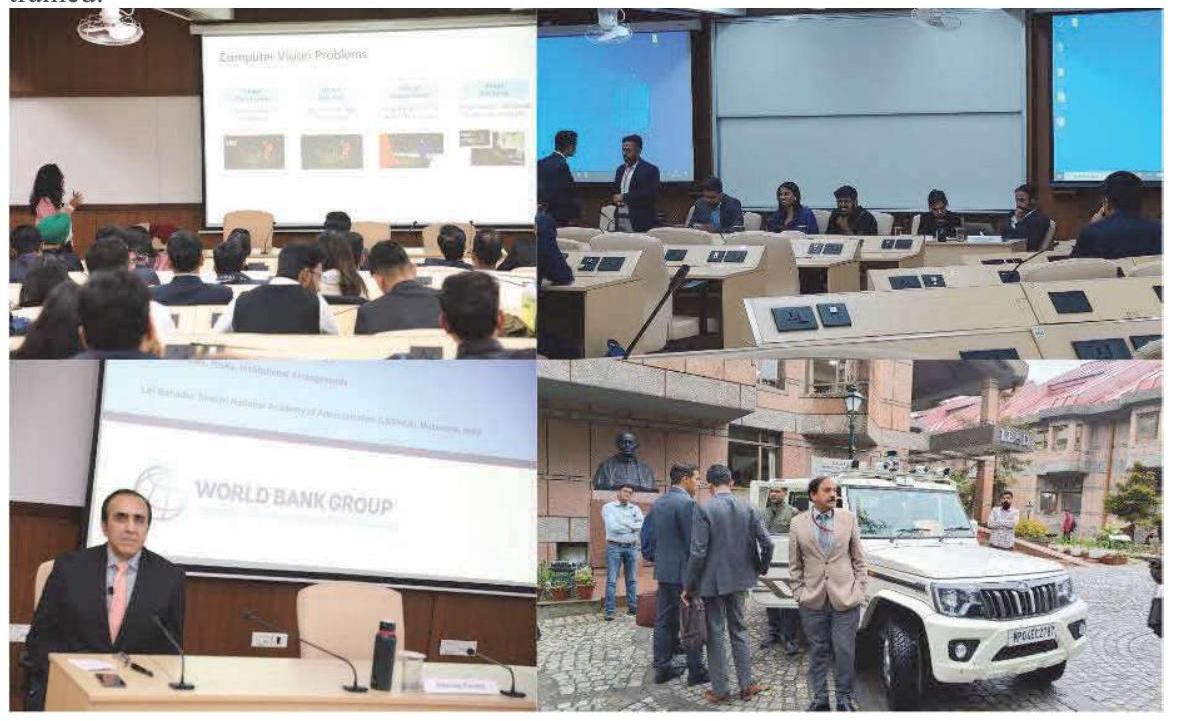
NICTU ensured that successful e-Governance implementations and the current trends of generative AI, data analytics, computer vision-based Machine Learning, GIS and Drone technology were explained to the participants of the induction and Mid-term Career programmes at LBSNAA. For this, NICTU coordinated with experienced practitioners in the Government: Central ministries (MeitY, NIC, NeGD, Income Tax, GST, Railways, Niti Aayog), State Governments (Land records, IT agencies, CM Dashboards and other IT initiatives), PSUs/ agencies (State Electricity Boards, Smart Cities, Banks), global organisations (World Bank, Carnegie Melon University), Academia (CMU, IIT Delhi, IIT Guwahati, IIM Ahmedabad), and Industry (award-winning Tech startups suggested by MeitY and NASSCOM). LBSNAA invited their respective representatives for guest lectures and technology demonstrations.
NICTU also ensured that the training participants acquired sufficient hands-on skills in handling public data. They were guided to use different data formats of large datasets sourced from different sources to solve problem statements relevant to the administration and governance domain. NICTU made them practise elementary data extraction and data transformation using Structured Query Language (SQL) on the RDBMS tool. They were also made to practise data summarisation and data visualisation using common spreadsheets and visualisation tools. They were also exposed to AI/ML tools for preparing predictive models using a sample data. The individual and team efforts led them to attempt meaningful Infographics and actionable insights. They created and presented different data stories among peers and before the invited esteemed guests. Smt. Droupadi Murmu, the President of India, Shri Ramnath Kovind, the former President of India, Lt. Gen. (Retd.) Shri Gurmeet Singh, Governor of Uttarakhand, Shri Pushkar Singh Dhami, Chief Minister of Uttarakhand, Secretaries to the Government of India and the state Governments, the Chairman and members of Capacity Building Commission of India, witnessed such demonstrations and presentations made by the participants of training programmes of LBSNAA and trained by NICTU.
NICTU also contributed to the improved automation of the back-office operations and activities of LBSNAA. Few of the important ones are: planned shifting of on-premises deployments of applications to NDC and MeitY-empanelled clouds, tele-medicine facility established between LBSNAA and AIIMS Rishikesh, hiring and deployment of NeGD-sponsored data analysts, equipping the NICTU lab at LBSNAA with 120 Nos. high-end machines procured through NICSI, and a series of rich dashboards developed and curated depicting live monitoring of Government schemes across the governments.
8.1.7 $98^{\text {th }}$ Foundation Course ( 14 Weeks)
The main activities organized during the Foundation Course were:
1) Physical Fitness & Sports: Physical fitness is not only one of the most crucial aspects to attain healthy body; it is the foundation of a healthy mind. The Academy strove to provide an encouraging atmosphere to all the Officer Trainees wherein physical fitness was an inseparable and crucial component of the training and holistic personality development.
- Pre-course evaluation: As soon as Officer Trainees reported to the Academy, some essential health and fitness tests to assess parameters like flexibility, muscular strength, cardio-vascular fitness and balance were conducted. This provided the baseline of current fitness level, which the Academy would encourage every Officer Trainee to improve using the facilities available in the Sports Complex along with the advice of coaches and trainers.
- Morning Activities: The day began at 0615 hrs. for all Officer Trainees with mandatory
morning activities which included Physical Training, Yoga, Aerobics, Zumba and Un-Armed Combat. Self-defence through Krav Maga (a form of un-armed combat) had been identified as a critical skill, and accordingly Officer Trainees were encouraged to master this with full enthusiasm.
2) Field Study and Research Programme: this study/programme was meant to assess the dynamics of the socio-economic-political situation existing in a village. Besides this, it also helped to:-
- Understand the problems faced by the rural people, especially the socially disadvantaged sections and women.
- Evaluate the spatial and temporal changes that have occurred in the village in terms of quality of life as a result of Government and non-Governmental interventions or with the passage of time.
- Evaluate the working of various village level institutions, both formal and informal in terms of participation and effectiveness.
- Recognize the importance of the need to learn from the villagers in evolving people-based solutions to their problems.
- Study the physical environment of the village in relation to ecological imbalances and vulnerability to disasters.
The Officer Trainees proceeded for the Field Study and Research Programme in Tribal lives & Livelihoods villages in India from August 26, 2023 to September 3, 2023. The Field Study and Research Programme is a major component of the Foundation Course, not only because it exposes the Officer Trainees to the realities of rural India through a structured study, but, also because it provides them the opportunity to stay in villages and interact intensively with the rural populace to understand and appreciate their concerns and priorities. They were given inputs on Data Collection \& Analysis, Rural development programs, Social sector, Role of NGOs, PRA techniques, etc. to equip them adequately for the visit. Officer Trainees conducted a survey in their respective village as per the guidelines provided to them.
On return, they submitted an individual as well as group reports of the activities, findings and recommendations and make group presentations, which was graded on both the data collected and the quality of analysis.
3) Amritotsav (Fete \& SHG Mela): The Academy had taken the initiative to curate a Amritotsav (Fete \& SHG Mela) event on $7^{\text {th }}$ September 2023 showcasing the life, struggle and contribution of around dozen Padma Awardees who have selflessly rendered themselves to public good and made a meaningful impact on lives around them. The Officer Trainees were engaged and interacted with the Padma Awardees in the forenoon. On the same weekend, the Officer Trainees conducted “Amritotsav Mela” in order to celebrate the successes and achievements of Self-Help Groups (SHGs) across the country who are striving to protect and promote the local traditional handicrafts. Shri Sriram Taranikanti, Director LBSNAA inaugurated the “Amritotsav Mela” on $7^{\text {th }}$ September, 2023.
4) Athletics Meet: This is a major event during FC and participation of all Officer Trainees is mandatory. In this Meet, various track and field events like 100- \& 200-meters relay races, high jump, long jump, shot-put throw etc. are organized. It is an occasion for Officer Trainees to test and display their athletic prowess. Some new records were also made during this FC like 100 mt race \& High Jump (women) and High Jump (Men).
5) Kevadia Visit: Aarambh
a) With the vision of making the civil service recruits capable of leading transformation and work seamlessly across different departments and fields, common visioning and collaborative exercise named “Aarambh” was started as part of the 94th Foundation Course in 2019, in which all new entrants came together at Kevadia, Gujarat, to understand changing technologies and its possibilities for governance with the help of experts from world class institutions. During “Aarambh”, a theme relevant and important for the country in the current context is taken up for deeper understanding and analysis in the form of an exercise by the Officer Trainees.
b) In the $98^{\text {th }}$ Foundation Course, Aarambh 5.0 was held from $29^{\text {th }}$ October to $31^{\text {st }}$ October, 2023 at Kevadia. The theme for Aarambh 5.0 was “HARNESSING THE POWER OF DISRUPTION”, where experts who have undertaken local innovations, to global next gen experiments interacted with the Officer Trainees on this theme. The following were the eminent guest speakers for the event: –
6) India Day: The high point of the cultural activities is the celebration of “India Day”. On this day, the culture, customs, art & craft and cuisine of different regions of the country were put up on display – both through outdoor and indoor activities by the Officer Trainees. The event helped build pride in the country’s rich heritage, besides sensitizing the Officer Trainees on the rich traditions from regions other than their own.
7) A.K.Sinha One Act Play: Late Shri Anirudh Kumar Sinha, an IAS Officer Trainee of 1976-78 batch (Rajasthan Cadre) was a very talented dramatist. He was on the verge of completing his District Training when he fell ill and passed away due to brain fever. To immortalise his memory, his batch mates instituted the A.K. Sinha Memorial Trophy to be awarded to the best one-act play. Accordingly, every FC has an A. K. Sinha Memorial One Act Play competition. The quality of plays put up during this event has risen, making this a much-awaited event over the years.
8) Annual Fete: This is put up by all Officer Trainees as per their Tutor Groups during the course. Stalls of games, food, SHG products, etc. are set up, and people across Mussoorie were invited to the event. The main purpose of the Fete was to raise funds for the Society for Social Service and also support Self-Help Groups. It is an important event in the calendar of Mussoorie and also looked forward to by Officer Trainees, faculty and people of the town with equal anticipation and excitement.
9) Trekking: The Himalayan trek ( $23^{\text {rd }}$ September, 2023 to $2^{\text {nd }}$ October, 2023) is the high point of the Foundation Course, both literally and metaphorically. It exposes the Officer Trainees to the natural grandeur and beauty of the Great Himalayas. It provides one of the most exhilarating experiences. It is a significant learning experience in group dynamics
and brings out leadership qualities. The mighty Himalayas evoke a sense of respect for nature as well as humility in any person who makes the attempt to know them. It is also a test of endurance and courage.
8.1.8 IAS Professional Course Phase-I (2022 Batch)
( $12^{\text {th }}$ December, 2022 to $12^{\text {th }}$ May, 2023)
The Course design of the Phase I programme was consciously liberal in spirit and content of the Mission Karmayogi. While seeking to provide the Officer Trainees with ample space to study, learn, experience, it strived to impart key competencies i.e Domain Knowledge (Right Knowledge), Behavioural (Right Attitude) and Functional (Right skills) which would enable them to shoulder future responsibilities and to
tackle not only the day to day working challenges but also the unforeseen and emergent crisis effectively. The 22-week IAS Professional Course, Phase-I for the 2022 batch, commenced on $12^{\text {th }}$ December, 2022 and concluded on $12^{\text {th }}$ May, 2023. It had two main components:
- Winter Study Tour cum Bharat Darshan (from $26^{\text {th }}$ December, 2022 to $3^{\text {rd }}$ February, 2023)
- On-campus training inputs part 01 (from $12^{\text {th }}$ December, 2023 to $25^{\text {th }}$ December, 2022)
- On-campus training inputs part 02 (from $13^{\text {th }}$ February, 2023 to $12^{\text {th }}$ May, 2023)
The Phase-I is a full-time training programme with an eclectic mix of curricular and extra-curricular activities. A typical day commenced at 0640 hours with physical exercises at the Happy Valley ground. The evenings were dedicated to programmes by Clubs and Societies including cultural programmes.
8.1.9 $3^{\text {rd }}$ Common Mid-Career Training Programme
The 3rd Round of the CMCTP was structured to provide a comprehensive and thematic learning experience for senior government officers. The course included a variety of modules, discussions, and interactive sessions, each tailored to address specific aspects of modern governance and leadership. This design ensured that the participants were exposed to a blend of theoretical knowledge and practical applications, fostering a holistic understanding of contemporary governance challenges and strategies and sessions were delivered by a range of experienced civil servants and professionals.
- Leadership in Government Organization: Focused on enhancing leadership qualities essential for effective governance, including decision-making, strategic planning, and team management.
- Emerging Challenges in National Security: A panel discussion that provided insights into the evolving landscape of national security and strategies to address contemporary challenges.
- Role of Zonal Councils in Development Context: Explored the significance of zonal councils in fostering regional development and cooperation among states.
- Creative Usage of Data in Governance: Emphasized the importance of data analytics and its application in policy-making and governance for better service delivery and transparency.
- Negotiation Module: Aimed at developing negotiation skills crucial for conflict resolution and effective communication within and across government departments.
- Simulation Game on Systems Thinking & Team Performance “Friday Night at the ER”: An interactive session designed to enhance systems thinking and team performance through a simulation game, providing practical insights into organizational dynamics.
- Digital Transformation of Direct Taxes: Focused on the digitalization of the taxation system, discussing its impact on efficiency, compliance, and revenue collection.
- Panel Discussion: Whole of Government Approach in Covid Management: A comprehensive review of the collaborative efforts and strategies employed by various government sectors during the Covid-19 pandemic.
8.1.10 IAS Professional Course, Phase-II (6 Weeks)
The duration of the IAS Professional Course Phase-II was of 06 weeks, from $24^{\text {th }}$ October to $2^{\text {nd }}$ December 2023. Classes were scheduled from Monday to Friday. Select sessions were also scheduled over weekends and holidays depending on the convenience of the guests. The Clubs and Societies were encouraged to organise extra-curricular activities during weekends.
The main component of the Course was:
- On campus input of 6 weeks which included presentations by guest speakers, experience sharing presentations, discussion sessions, etc.
Objectives
The objectives of Phase II were:
- To internalise the importance of an Officer’s role and responsibility during Amrit Kaal.
- To analyse individual and collective experiences of District Training and Assistant Secretaryship through a process of structured reflection and experience-sharing.
- To understand the imperatives of working as field officers towards technology-led, citizen-centric good governance.
- To improve administrative, managerial and ICT skills along with practical application of laws at the district level.
- To inculcate required leadership qualities and emotional intelligence to effectively manage the work-worker-workplace.
- To promote physical and mental fitness.
- To align with aims of “Mission Karmayogi” i.e. to impart behavioural, functional and domain knowledge related competencies.
- To align the efforts of the field officers towards making our country into a developed Nation.
8.1.11 Assistant Secretaryship:
The Assistant Secretaryship with different Ministries/ Departments of GoI before Phase II training at LBSNAA provides a ring side view of the working of different Ministries/ Departments at the highest level of governance. ( 8 weeks)
The entry level professional training in the Academy is meant to prepare the Officer Trainees for the first decade of their career when they would function as Sub-Divisional Officers, Project Officers, District Rural Development Agency (DRDA), Chief Executive Officers of Zila Parishads, Municipal Commissioners, District Collectors, and in some cases in the State Directorates, Public Sector Undertakings and the Secretariat. At a more fundamental level, this training is meant to build a foundation and provide a perspective for the rest of their career in the civil services. It must be noted that the training scheme for the IAS has expanded well beyond the IAS Professional Course Phase-II and now involves Mid-Career Training Programmes – Phases III, IV and V for officers of varied seniority.
8.1.12 Valedictory Session
The valedictory address was delivered by Smt. Nirmala Sitharaman, Hon’ble Union Minister of Finance and Corporate Affairs on 2nd December 2023.
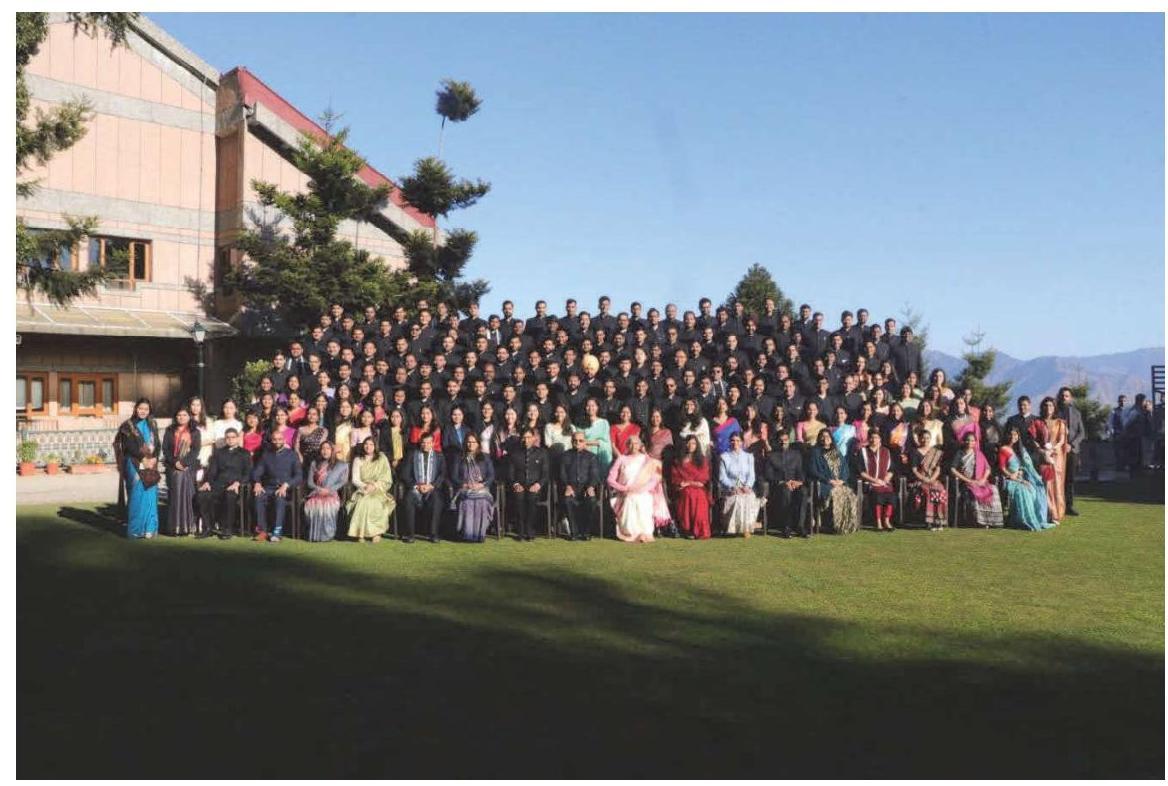
Valedictory of IAS Phase II (2021 Batch)
8.1.13 17th Round of Phase-IV (MCTP)
To equip officers who have completed 14 to 16 years of service and enabling them to effectively transition to policy formulation and better implementation.
Course Objectives
- Develop a sound appreciation of strategic management in government to cope with future challenges;
- Understand the nuances of public policy, ethics and regulation relevant for policy formulation and implementation;
- Appreciate the policy challenges and ecosystem facing the Government in key sectors and their inter-relationship; and
- Acquire better understanding of leadership and negotiation skills
- Have deeper understanding of thematic issues in the context of infrastructure and regulation on one hand, and future challenges in the realms of human resource development and environment on the other
8.1.14 14th Round of IAS Phase-V (MCTP)
Aim
To equip officers who have completed 26 to 28 years of service for effective transition into policy formulation and better implementation.
Course Objectives
- Develop a sound appreciation of strategic management in government to cope with future challenges;
- Understand the nuances of public policy, ethics and regulation relevant for policy formulation and implementation;
- Appreciate the policy challenges and ecosystem facing the government in key sectors and their inter-relationship; and
- Acquire better understanding of leadership and negotiation skills
- Have deeper understanding of thematic issues in the context of infrastructure and regulation on one hand and future challenges in the realms of human resource development and environment on the other

8.1.15 $29^{\text {th }}$ Joint Civil-Military Training Programme $\left(07^{\text {th }}-\mathbf{1 6}^{\text {th }}\right.$ June, 2023)
Introduction of the Course
The Joint Civil-Military Training Programme on National Security is a flagship course of the Academy. It was initiated in 2003 consequent to the report of the Group of Ministers on reforming the National Security apparatus.
Objectives, Course Activities and Highlights:
- To increase awareness levels about the different dimensions and elements of National Security and the various threats to the Indian state;
- To familiarize the participants with challenges to management of national security, external security environment and internal security environment;
- To create awareness on different dimensions of security (Cyber, Environmental, Economic, Energy) as well as threats to such security;
- To expose them to the imperatives of civil-military interface; and
- To provide an opportunity for the participants to interact and exchange ideas on the subject
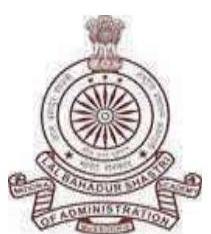
$30^{\text {th }}$ Joint Civil-Military Training Programme
$\left(15^{\text {th }}-27^{\text {th }}\right.$ January, 2024)
8.1.16 Pioneering features of the $30^{\text {th }} \mathbf{J C M}$ Training Programme
- Faculty from Training Institutions as Participants: The $30^{\text {th }}$ JCM training programme welcomed faculty from different Central Training Institutes (CTIs) and Administrative Training Institutes (ATIs). These faculty likely hold expertise in various areas and the intention was to create a ‘multiplier effect’ by involving them in the training Programme. This means that the knowledge, skills, and insights gained by these faculty can be disseminated and applied more broadly within their respective institutions.
Essentially, the faculty act as conduits for spreading the benefits of the training programme to a wider audience. Overall, the inclusion of faculty from CTIs and ATIs as participants in the $30^{\text {th }}$ JCM Training Programme reflects a strategic approach to maximizing the programme’s impact and ensuring broader dissemination of knowledge and skills within relevant educational and training institutions.
2. Expanding the Horizons: This year’s the JCM expanded its scope by involving more organizations in the training programme. The engagement of various organizations such as the Borders Road Organization, Ministry of Ports, Shipping and Waterways, Department of Telecommunications, BSNL (Bharat Sanchar Nigam Limited), and the National Defence College, Delhi, reflected a more inclusive approach towards training and collaboration.
The decision to broaden the scope of the JCM training programme suggests an acknowledgment of the evolving nature of civil-military relations and the need for a comprehensive understanding of various sectors and their interdependencies. By expanding its scope, the programme aimed to address a wider range of issues and challenges that require cooperation between civil and military entities.
3. Dedicated Sessions to identify the pain points in inter agency interface and to foster Desiloisation: The interactive sessions included in this year’s Joint-Civil Military (JCM) training programme were designed specifically to address pain points and foster collaboration among different services and organizations. This focused approach allowed participants to delve deeply into specific issues, identify and address challenges faced in joint operations, as well as to promote inter-service cooperation and coordination.
Rather than simply identifying problems, the sessions were structured to emphasize solutionfinding. Participants were encouraged to brainstorm and propose practical strategies for overcoming the identified pain points. The discussions were grounded in real-world scenarios and experiences, allowing participants to draw from their own expertise and insights. This approach ensured that the solutions generated were relevant and actionable.
- Interaction with heads of various CTIs and ATIs- The interaction between heads from various Central Training Institutes (CTIs) and Administrative Training Institutes (ATIs) played a crucial role in fostering collaboration and knowledge exchange within the Joint Civil-Military (JCM) training Programme. The sessions primarily featured senior most faculty members from these institutes serving as speakers, offering insights and expertise from their respective institutions. These interactions aimed to enhance the collaboration and knowledge exchange among the participants and multiple services and organizations by discussing three primary questions:
i. What will the respective institution add to their curriculum to improve interface with other services.
ii. What inputs the CTI/ATI want other services/ institutions to add to their training curriculum regarding requirements of the service(s) catered to the respective by CTI/ATI.
iii. What is already being done by their institution for better inter service interface.
8.1.17 125 th Induction Training Programme for IAS Officers ( $19^{\text {th }}$ February – $29^{\text {th }}$ March, 2024)
Course Objectives
$\checkmark$ To facilitate understanding of the all India nature of Indian Administrative Service and develop a national perspective on governance and public affairs
$\checkmark$ To equip officers with:
a) Domain knowledge of policies and programmes in various sectors
b) Functional ICT/ Project management skills
c) Behavioural skills around leadership, management and negotiation
The pedagogy that was adopted to meet the course objectives included Lecture and Discussion, Case Studies, Heritage/Nature Discourse, Experience Sharing Presentations, Films and Discussions, Management Games, Group Work.
Course Design
Week 1 IAS in perspective, IAS: Dimensions, Opportunities & Challenges, Mental Health, Induction: Experience Sharing, Income approach to agriculture: Doubling Farmers’ Income – A Quantitative Target, ODOP, Prevention of Corruption Act, National Security, ICT-1, Leadership Module, Startup India- Role of Govt. in spurring innovation and support to start-ups, Eat Right – The strategy of 3S, Irrigation Management in India: Options and Practices, ICT-2, SVAMITVA, Ethics for Administrators, Geo Spatial Technologies for Public Policy.
Week 2 Jal Jeevan Mission – Navigating the Path to Universal Rural Water Access, Sanitation Revolution: Swachh Bharat Mission – Gramin Unveiled, Perspective on North-East, Rural Resurgence: Strategies and Initiatives Shaping India’s Countryside, Budgeting, Health Systems Strengthening, Safe Motherhood – The Meghalaya Story, Urban Infrastructure Development: Issues and Challenges, Urban Floods \& Disaster Management, Perspectives from Finance Department, ICT-3, Negotiation, Railways for a Vikasit Bharat, Disaster Management, Empowering Lives: Insights into the National Livelihood Mission, Transformative Tourism for Strengthening Communities – Kabani \& Suyatri, Silkyara Rescue Case, Module on Emotional Intelligence
Week 3 \& Week 4 Study Tour
| Week 5 | Primary and Secondary Education: A Overview, Allied Sector – Dairy |
|---|---|
| Fisheries, Leveraging Insurance and IT for achieving Universal Health | |
| Coverage, Plain Language and Simplification in Legislative Drafting, | |
| Types- Classification-Strategies and Stages in Legislative Drafting, | |
| Infrastructure – NHAI, AIS Rules, Urban Governance – Inclusive | |
| Sanitation, Jaga Mission, Behavioral Economics and Public Policy, | |
| Aviation Sector, Project Management, ISTM- Central Secretariat Structure | |
| and Functions – Introductory Session, Mission Karmayogi – Capacity | |
| Buildings of Government Employees, GFR, Economic Survey of India: A | |
| brief & Comparative picture of different states, Women led development- | |
| Role of women SHGs, Education – Orissa, Goods and Service Tax. | |
| Week 6 | Procurement, Janandolan – Saturation approach to rural development, |
| Hands on practice of AI Tools- Chat GPT, New \& Renewable Energy and | |
| PM Suryodaya Yojana, Field Intervention Group Activity, ICT-4. |
Week 6 Procurement, Janandolan – Saturation approach to rural development, Hands on practice of AI Tools- Chat GPT, New \& Renewable Energy and PM Suryodaya Yojana, Field Intervention Group Activity, ICT-4.
8.1.18 19th Round IAS Phase-III (2023)
Course Aim
To equip officers who have completed seven to nine years of service to shoulder multifarious and varied responsibilities at the forefront of field administration.
Course Objectives
- Opportunity to develop core strength in various components of two sectors of interest to the participant.
- To equip officers with tools, skills and knowledge that will help them achieve excellence in the implementation of programmes;
- To design and implement Business Process re-engineering (BPR) in Government and leveraging IT to improve public service delivery;
- To strengthen communication, interpersonal and team-building skills and appreciate the centrality of values in governance;
- To learn about efficient service delivery in specific sectors from experiences across States.
- Enhance the Negotiation and Leadership skills and HR Management.
Week-wise design of the Course (should provide a schematic overview of main academic inputs)
Course Design
Week 1 Leadership, Project Management
Week 2 Infrastructure/Urban/Energy, Education \& Health, RD/Agriculture, Environment
Week 3 Infrastructure/Urban/Energy, Education \& Health, RD/Agriculture, Environment
Week 4 Evidence based policy making, IT in governance, Finance
8.1.19 20 th Round of Phase-III (2024)
Aim
To equip officers with necessary skill – sets to serve at middle management for effective transition from District Administration to Head of Department with focus on Excellence in implementation.
Course Objectives
- Opportunity to develop core strength in various components of the sectors to the participants and leveraging for implementation in their respective domains.
- To strive for efficient service delivery and learning from experiences across the country.
- Enhance the Negotiation and Leadership skills and HR Management for multiple effects.
Week-wise design of the Course
Course Design
Week 1 Project Management Module, Governance Module
Week 2 Leadership Module, Health Module, Negotiation Module, Public Finance Module
Week 3 Infrastructure Module, Security and Foreign Affairs Module, Startups & Innovation Module, Climate Change, Leveraging UN Agencies, Education, Land \& Agriculture
Week 4 Urban Development Module, Public Policy Module, Energy Module, Digital India, Developed India
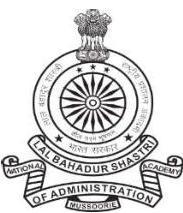
In-service Training Programme
on
Building infrastructure for a Viksit Bharat
(5 – 9 February, 2024)
Course Report
Lal Bahadur Shastri National Academy of
Administration
Mussoorie – 248179
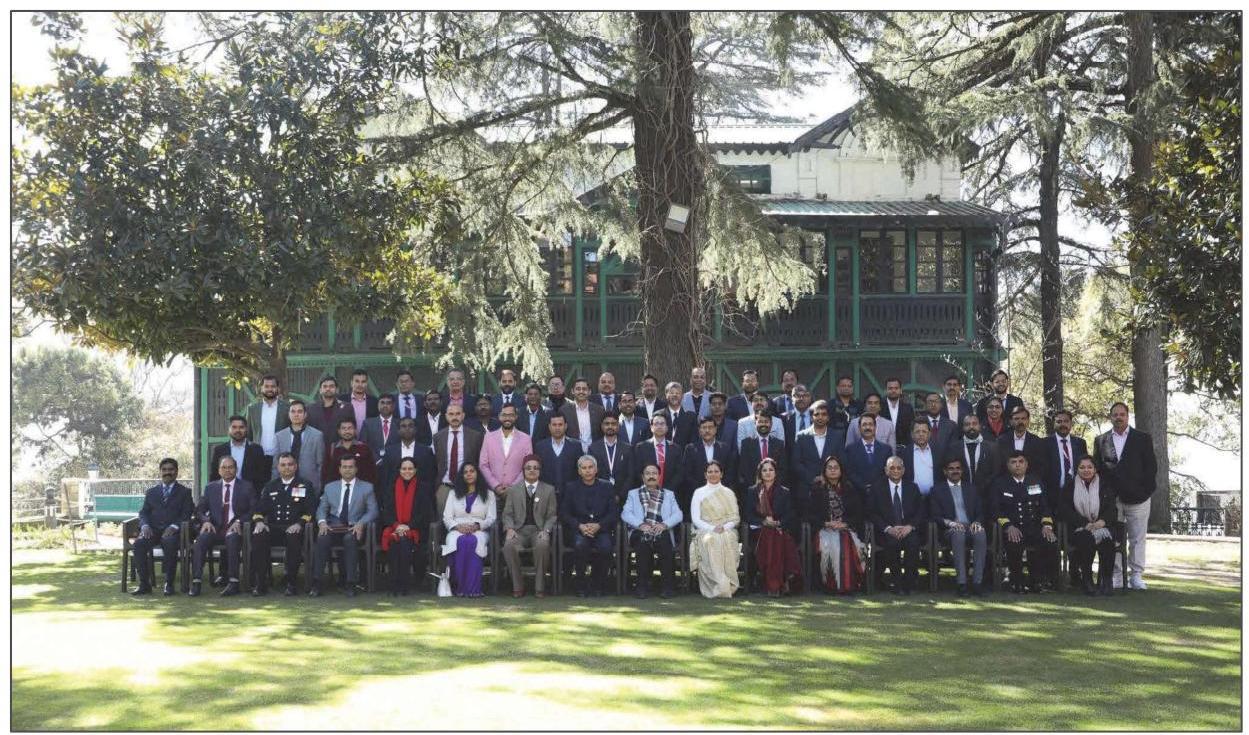
Participants of In-service Training Programme on Building infrastructure for a Viksit Bharat held at Lal Bahadur Shastri National Academy of Administration, Mussoorie (5 – 9 February, 2024)
Executive Summary
The Lal Bahadur Shastri National Academy of Administration conducted a 5-day in-service training program titled “Building Infrastructure for a Viksit Bharat” from 5th to 9th February 2024. This program was meticulously designed to enhance the capacity of civil servants in the domain of public infrastructure. Specifically tailored for mid-career civil servants transitioning from field roles to policy/middle management positions within the government, the training aimed to equip participants with the necessary skills and knowledge to effectively contribute to the development of a modernized India.
Recognizing the vast scope of infrastructure development, the program encompassed thematic components spanning various facets of infrastructure management. These included project planning, monitoring and evaluation, project finance, dispute resolution, as well as sectoral considerations such as roads, railways, ports and shipping, civil aviation, and urban infrastructure and services. By addressing these diverse elements, participants gained a comprehensive understanding of the complexities involved in infrastructure projects and were better prepared to tackle challenges in their professional roles.
The course design featured a modular structure, ensuring flexibility and adaptability to the diverse needs of participants. Thematic content was carefully curated to provide practical insights and relevant knowledge, eliminating the need for prior expertise while facilitating hands-on learning experiences. This approach was aligned with the ethos and objectives of Mission Karmayogi, fostering a culture of continuous learning and skill development among civil servants.
Course Objectives
- To equip participants with contextual understanding of the infrastructure ecosystem in India
- To foster understanding of key infrastructure sectors like roads, highways, railways, ports, airports, waterways, and urban development (Greenfield & brownfield).
- To develop understanding of global context and practices in infrastructure development and to build systems that can provide world class infrastructure and services.
- To conceptualize and enhance skills in project planning, management, monitoring and finance.
- To develop expertise in contract management, dispute resolution, and arbitration.
- To promote adoption of green infrastructure solutions and climate-friendly development practices.
Course Design
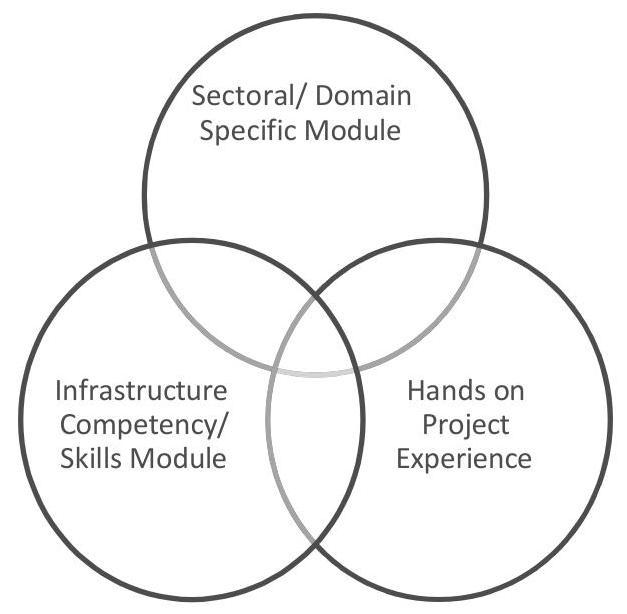
Course design for day in-service training program titled “Building Infrastructure for a Viksit Bharat”
SECTORAL/ DOMAIN SPECIFIC MODULE
This module had sectoral sub-modules dealing with specific components of infrastructure. Following sub-modules are proposed for the above module –
a) Roads including National Highways / Bharatmala Pariyojana, Expressways and Bridges, State Highways
b) Railways including Dedicated Freight Corridors, High Speed Rail projects and Railway Station Redevelopment using PPPs
c) Shipping, Ports and Inland Waterways including Sagarmala Pariyojna and port modernization, Inland Waterways Authority and National Waterways
d) Civil Aviation including Udaan Scheme and airport/ airstrip development
e) Urban Greenfield / Redevelopment projects including Town Planning Scheme and Local Area Plans
f) Urban transport infrastructure including MRTS/RRTS
g) Urban service delivery including drinking water supply, sewerage and sanitation
INFRASTRUCTURE COMPETENCY/ SKILLS MODULE
This module had the following sub-modules dealing with specific skills/competencies which cross-cut all sectors of infrastructure.
h) Infrastructure project planning and design – platforms for planning of infrastructure projects including Gatishakti with use cases
i) Infrastructure Project Management – Monitoring and Evaluation Tools – PMIS tools used in public infrastructure corporations like Speed (NCRTC) or Impulse (DMRC)
j) Contract Management – bid process management, contract administration principles, tools and best practices
k) Project Finance – modalities for financing infrastructure projects – own resources, budgetary support, banks, infrastructure bonds, lIFCL, NaBFID
l) Dispute Resolution Mechanisms and Arbitration
m) Green infrastructure – Blue Green master plans, National Green Building Code, Green infrastructure certifications
HANDS ON PROJECT EXPERIENCE
Practical hands on sessions on Project planning, monitoring and evaluation tools in collaboration with Gatishakti / NCRTC
PEDAGOGY
- Interactive lectures and presentations by eminent experts from government, industry and academia.
- Case studies and practical hands-on exercises to apply learning to real-world scenarios.
- Group discussions and panel discussions to facilitate knowledge sharing and critical thinking.
8.1.20 19th Conference of Administrative Training Institutes
Dates: 22nd to 23rd March, 2024.
Venue: Sardar Patel Hall, Lal Bahadur Shastri National Academy of Administration (LBSNAA), Mussoorie
Conference Coordinator: Dr. Bagadi Gautham (Deputy Director Senior)
Key Takeaways of the Conference were: –
- Emphasized the importance of sharing innovative practices among ATIs and leveraging platforms like iGoT for training.
- Highlighted the PM’s vision of a developed India by 2047 and urged participants to focus on a national-level outlook in their training.
- Discussed methodologies for training based on the evolving world context and suggested a holistic approach towards training.
- Discussed unlocking human capital potential aligned with India@2047 vision.
- Emphasized role-based governance and lifelong learning.
- Discussed the architecture of LBSNAA Academic Programmes, including Induction Programmes and MCTP courses.
- Explained the detailed institutional structure and support centers for training.
- Explained DigiTAG arena and DiGFAC support for officer and probationer training.
- Discussed continuous course review and structural improvements.
8.1.21 Visit of Cabinet Secretary
Shri Rajiv Gauba, Cabinet Secretary, Govt. of India visited the LBSNAA during 23-25 February, 2024.
On $23^{\text {rd }}$ February, 2024, Cabinet Secretary addressed the officer trainees of IAS Professional Course Phase I (2023 batch) and IAS officers of $125^{\text {th }}$ Induction Training Programme and released the book “Harnessing the Power of Disruption”.
On $24^{\text {th }}$ February, 2024, Cabinet Secretary interacted with the faculty members of the Academy and released the book “One District One Product”. This was followed by visit to the Gandhi Smirti Library where he unveiled the plaque of Jnanpith and Sahitya Academy Books’ Gallery.
Sambhaav-Yoga Consultation Room and Ayurshila Herbal Garden in the Ayurveda Wellness Centre were inaugurated by the Cabinet Secretary.
The visit concluded with a final interaction with the Academy faculty and visit of the Academy on $25^{\text {th }}$ February, 2024.
INSTITUTE OF SECRETARIAT TRAINING AND MANAGEMENT
8.2 Introduction
8.2.1 The Institute of Secretariat Training and Management (ISTM) is imparting training to the officers of the Central/State Governments, Public Sector Undertakings & Autonomous Bodies. Originally set up with the objective of conducting foundational and in-service training programmes for Assistants and Section Officers of the Central Secretariat, the range of the activities of the Institute has increased exponentially over the last seven decades. In addition to the in-house training programmes, the Peripatetic Training provided by the Institute to the officials of State Governments and Union Territories in Behavioral Skills, Management Techniques, Financial Management and Office Management, is of particular significance. On specific request from Central Government Departments, Autonomous Bodies and Public Sector Organizations, the Institute also organizes special programmes addressed to the specific customer needs in different areas.
8.2.2 From the year 2007-08, ISTM is also involved in the implementation of the Central Secretariat Service Cadre Training Plan (CSS-CTP) and from 2011 onwards Central Secretariat Stenographer’s Service Cadre Training Plan (CSSS-CTP), which envisages mandatory training programmes having linkages with career progression up to Director level officers.
8.3 Implementation of Mission Karmayogi in ISTM
8.3.1 As one of the prominent Civil Service Training Institutes (CSTIs) coming directly under the Department of Personnel \& Training, ISTM plays an important role in implementation of
National Programme for Civil Services Capacity Building (NPCSCB) – Mission Karmayogi. The achievements of ISTM under various pillars of Mission Karmayogi are as under:
a) Competency: ISTM remained one of the knowledge partners of the Capacity Building Commission (CBC) in finalizing Behavioural, Functional and Domain Competency identification frameworks.
b) Learning: ISTM houses a unique of its kind “Karmayogi Digital Learning Lab (KDLL)” at its premises. This facility is developed by the DoPT under the Technical Assistance Grant from the Asian Bank. Through this facility and otherwise, ISTM contributed total 151 hours of eLearning material on iGot Karmayogi portal. This is 61 hours more than the previous year.
8.4 Organizing Courses/ Programmes on iGOT Karmayogi Platform
8.4.1_During the year 2023-24, substantial parts of 15 more programmes in comparison to previous year have been organized through iGoT Karmayogi portal as shown in the table below:
| SN | Programme | Organized in iGOT Karmayogi Platform | |
|---|---|---|---|
| 2022-23 | 2023-24 | ||
| 1. | Mandatory in-service Cadre Training Programmes for Central Secretariat Service (CSS-CTP) | 48 | 91 |
| 2. | Mandatory in-service Cadre Training Programmes for Central Secretariat Stenographers’ Service (CSSS-CTP) | 43 | 18 |
| 3. | Demand-driven DAKSHTA Programmes | 21 | 18 |
| Total | 112 | 127 |
8.5 Details of Courses conducted during 2023 – 2024.
| Courses (241 Planed) | No of Course Conducted |
Particip ants |
No of training days |
No of Training weeks |
|---|---|---|---|---|
| CTP-CSS | 99 | 3188 | 2260 | 452 W |
| CTP-CSSS | 18 | 583 | 320 | 64 W |
| Calender Courses 2023-24 | 79 | 2770 | 329 | $65 \mathrm{~W} / 4$ Days |
| Dakshta | 13 | 249 | 59 | $11 \mathrm{~W} / 4$ Days |
| TDP Courses (7) & SCTP Courses (0) |
7 | 144 | 61 | $12 \mathrm{~W} / 1$ Day |
| OSP (12) \& PT Programmes (3) |
15 | 415 | 67 | $13 \mathrm{~W} / 2$ Day |
| Total | 231 | 7349 | 3096 | $619 \mathrm{~W} / 1$ Day |
8.4.1 Number of Training Programmes Planned, Conducted and No. of Participants Trained during the Last three years
| Training Calendar Year (April-March) |
Target Planned (No of courses planned) |
Target Achieved (No of courses conducted) |
Number of Participants Trained | ||
|---|---|---|---|---|---|
| Group-A | Group B & C |
Total | |||
| $2019-20$ | 230 | 272 | 1431 | 6106 | 7537 |
| $2020-21 *$ | 224 | 100 | 284 | 3242 | 3526 |
| $2021-22 *$ | 226 | 232 | 1215 | 6640 | 7855 |
| $2022-23$ | 241 | 286 | 1034 | 7192 | 8226 |
| $2023-24$ | 274 | 231 | 927 | 6422 | 7349 |
- Due to COVID-19 pandemic, less no. of courses was conducted during first quarter forthe year 2021-22 and no courses were conducted during first quarter for the year 2020-21.
8.5 “CERTIFICATE OF ACCREDITATION” as उन्कृष्ट (UTAKRISHT)
ISTM has been awarded with “CERTIFICATE OF ACCREDITATION” as उन्कृष्ट (UTAKRISHT) under Capacity Building Commission’s (CBC) Standards as assessed by National Accreditation Board of Education and Training (NBABET) from 19th to 20th April, 2023.
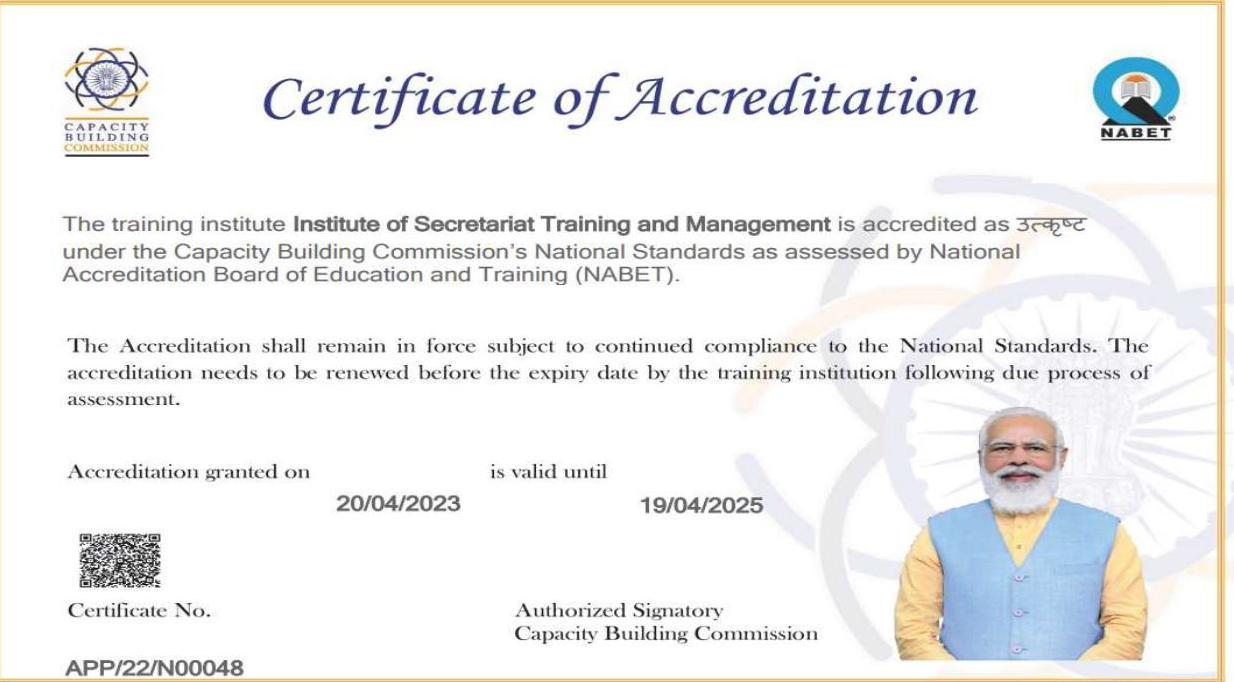
8.6 Foundation Training Programme for ASO Probationers
8.6.1 Assistant Section Officer (ASO) is the entry level position in the Central Secretariat Service (CSS), who plays a significant role in the overall functioning of the Central Secretariat.
Foundation Training Programme (FTP) is conducted by Institute of Secretariat Training and Management (ISTM), New Delhi. DOPT’s vide its O.M. No. T-25017/1/2015-Trg. (ISTM Section) dated 30.06.2023, has restructured the existing 108 weeks’ FTP into 90 weeks’ FTP and the details of the broad components are as follows:
| S. No. | Modules | Duration |
|---|---|---|
| 1. | Pre-Foundation Course (online on Karmayogi i-GOT Platform) |
06 |
| 2. | ISTM Phase – 01 | 09 |
| 3. | On-the-Job Training | 73 |
| 4. | ISTM Phase – 02 | 02 |
| TOTAL | 90 |
8.6.2 The ASO Foundation Training Programme aims to develop identified set of competencies, focusing especially on personality development as well as functional readiness of the ASOs to handle responsibilities in the Central Secretariat. Some of the major features of the Programme are as follows:
i. Competency-based training spread over 90 weeks, targeting ‘behavioural competencies’, ‘domain competencies’ and ‘functional competencies’ identified by the Government as essential for efficient and effective functioning in the Central Secretariat. Ministries and Departments where the ASOs are posted to decide on modules for acquiring ‘domain competencies.
ii. Provision for six (06) weeks ‘Pre-Foundation Module’ through online learning on Karmayogi i-GOT Portal has been designed to inculcate the habit of reading and service ethos, essential for civil servants.
iii. Emphasis on role of ‘On the Job Training’ and ‘Relationship learning’ (mentoring) in addition to 11 weeks ( 9 weeks of Phase-I & 02 weeks of Phase-II) of classroom with emphasis on higher order learning objectives such as analysis, application, drafting, and creation as training outcomes.
iv. Built in components for ‘Experiential Learning’ through “Bharat Darshan”, “NGO Attachment”, and “Village Attachment” through various State Institutes of rural Development (SIRDs)/ ATIs/ CTIs.
v. Extensive use of e-learning methodologies for delivery of on-the job training, concurrent assessments and monitoring through Karmayogi i-GOT Platform and ISTM’s e-Learning Management System (e-LMS).
vi. Emphasis on Institutional collaborations with identified Institutions of Excellence such as Parliamentary Research and Training Institute for Democracies (PRIDE) for handling of Parliamentary work, National Archives of India (NAI) for Record Management, Indian Institute of Public Administration (IIPA) for imparting specialized training on selected competencies etc.
vii. Focus on ‘Communication Skills through dedicated sessions over the entire period of foundation training covering reading, comprehension, writing and oral communication skills.
viii. Organising of extracurricular activities like ‘Essay & Precis writing’, ‘Blood Donation Camp’, ‘Cultural event/ programme’, ‘Sports Meet’ etc. to inculcate team working skills and grooming leadership skills.
8.6.3 Following activities were organized at ISTM for ASO Probationers of CGLE 2021 and 2022 Batch:
(i) INTERACTION WITH HON’BLE MINISTER OF STATE (MOS) WITH ASO PROBATIONERS OF CGLE 2022 BATCH
Hon’ble Minister of State (PP), Dr. Jitendra Singh, interacted with ASO Probationers of CGLE 2022 batch through video conference.
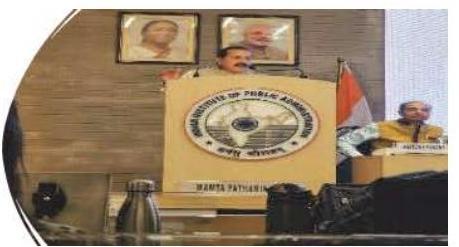
(ii) Interaction of Eminent Speaker with Assistant Section Officers (Probationers) of 2022 Batch
Assistant Section Officers (Probationers) of 2022 Batch interacted with Shri Madan Lal, former Indian cricketer and Indian national cricket coach and also member of the 1983 Cricket World Cup. He encouraged trainees about maintaining fitness and also motivated through his life changing experiences and hard work.

(iii) Essay / Precis Writing Competition
Approximately 181 & 174 Assistant Section Officers (Probationers) of 2021 \& 2022 Batch participated in essay/ precis writing competition on 11th August, 2023 (CGLE 2021 Batch) and 9th November, 2023 (CGLE 2022 Batch). The main objective of the competition was to hone the writing skills, promote critical thinking, and enhance research skills, platform for selfexpression and creativity. It was one of the extra-curricular activities organized in order to make the Foundation Training interesting, engaging \& competitive.
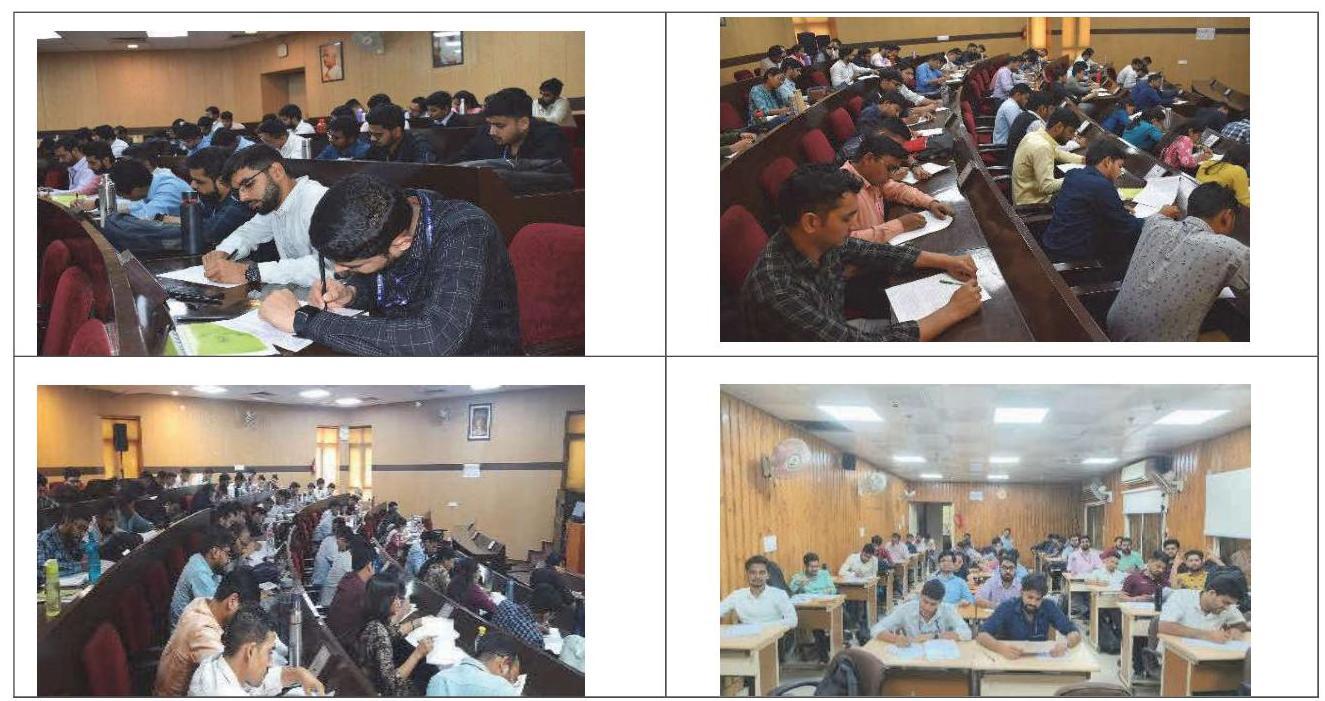
(iv) Visit to National Archives of India (NAI)
Approximately 181 \& 174 Assistant Section Officers (Probationers) of 2021 \& 2022 Batch visited National Archives of India, New Delhi to attend a half-day workshop on ‘Records Management’ during the Foundation Training Programme. The key features of the visit were to educate them about the conservation and preservation of records, archival research, digital initiatives, etc. The visit consisted of lecture by eminent archivist, visit to National Archives Museum, Conservation Research Laboratory, Record room/ storage etc.

(v) Blood Donation Camp Organized for CGLE 2021 & 2022 Batch
Blood donation is a selfless act that has a profound impact on saving lives and improving the health of individuals in need. It is a simple yet powerful gesture that embodies compassion, empathy, and humanity. The act of donating blood not only benefits the recipient but also brings a sense of fulfilment and satisfaction to the donor, therefore, under the aegis of ‘Azadi Ka Amrit Mahotsav’, blood donation camp was organized with the help of AIIMS, New Delhi on 11th August, 2023 for CGLE 2021 Batch and 9th November, 2023 for CGLE 2022 Batch. Around 150 participants in total donated blood and contributed in this divine donation.
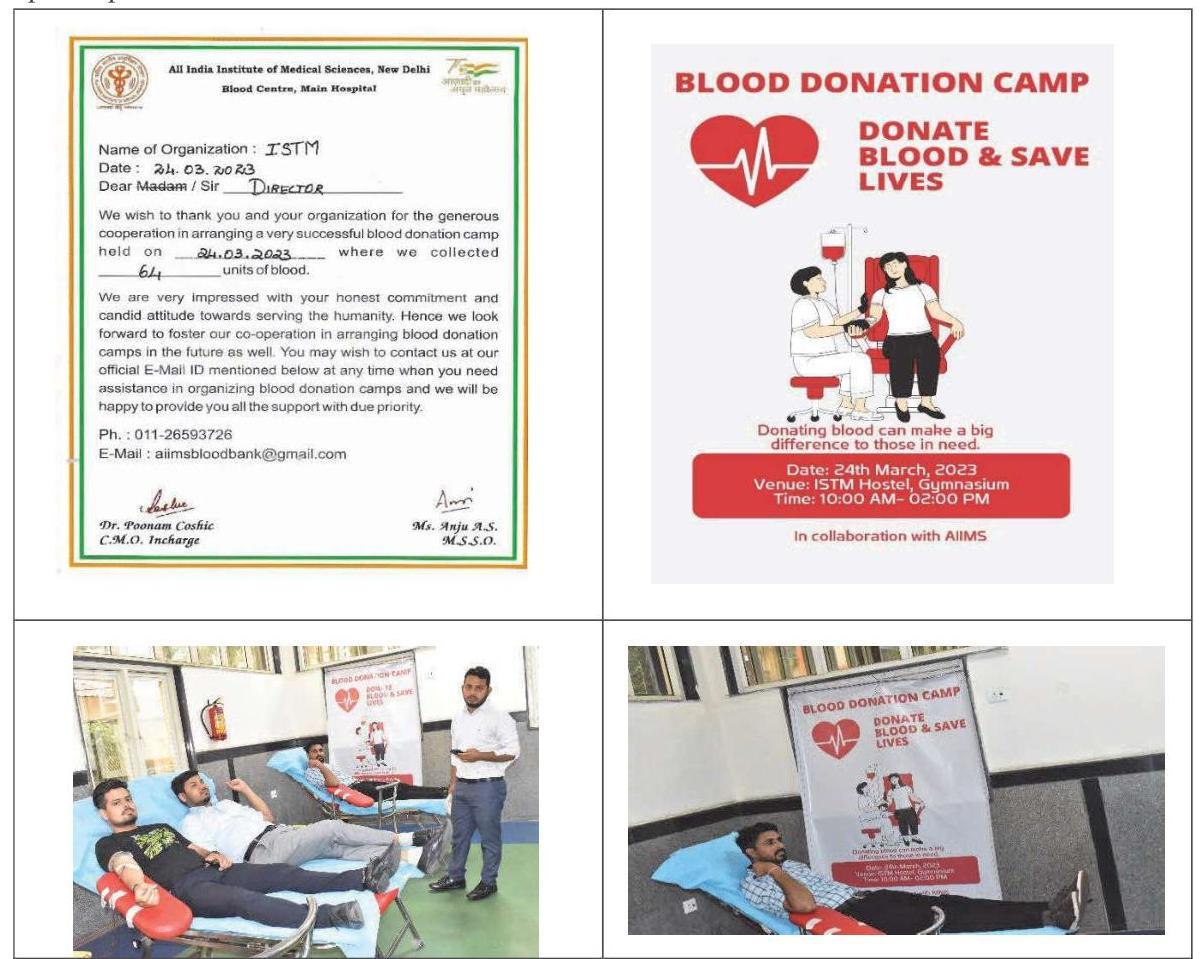
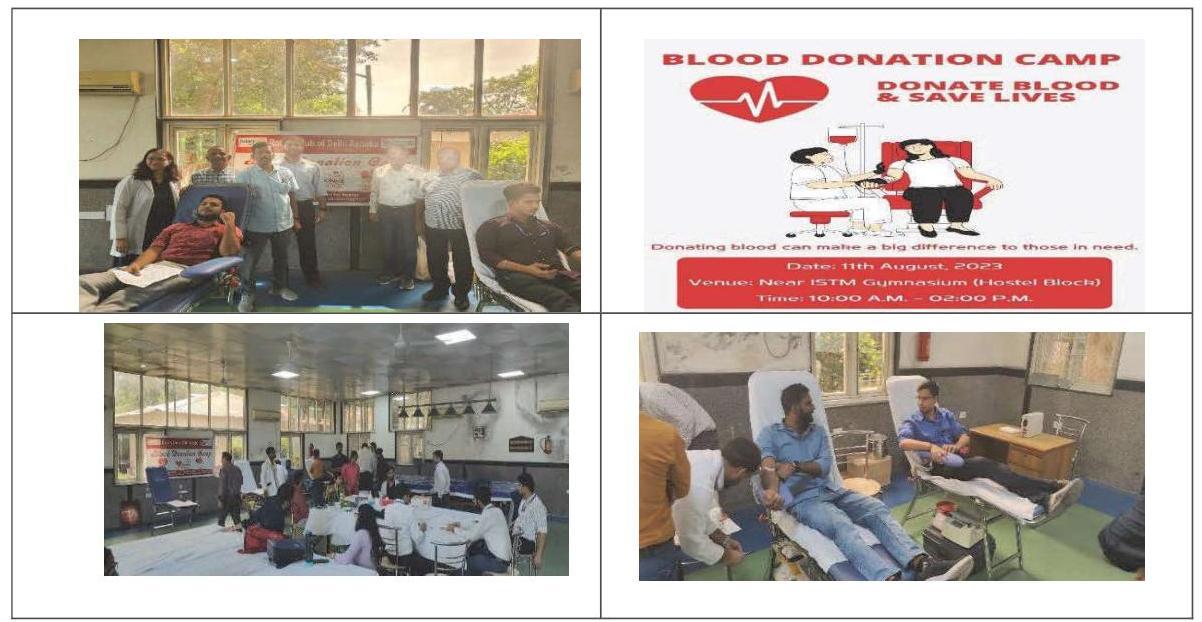
(vi) Visit of Assistant Section Officers (Probationers) of 2021 & 2022 Batch to Parliamentary Research and Training Institute for Democracies (Pride)
Approximately 181 \& 175 Assistant Section Officers (Probationers) of 2021 \& 2022 Batch respectively visited Parliamentary Research and Training Institute for Democracies (PRIDE) on 27th \& 28th March, 2023, 04th August, 2023 and 7th November, 2023 respectively to attend a 2-days workshop on ‘Parliamentary Work Management’ during the Foundation Training Programme.
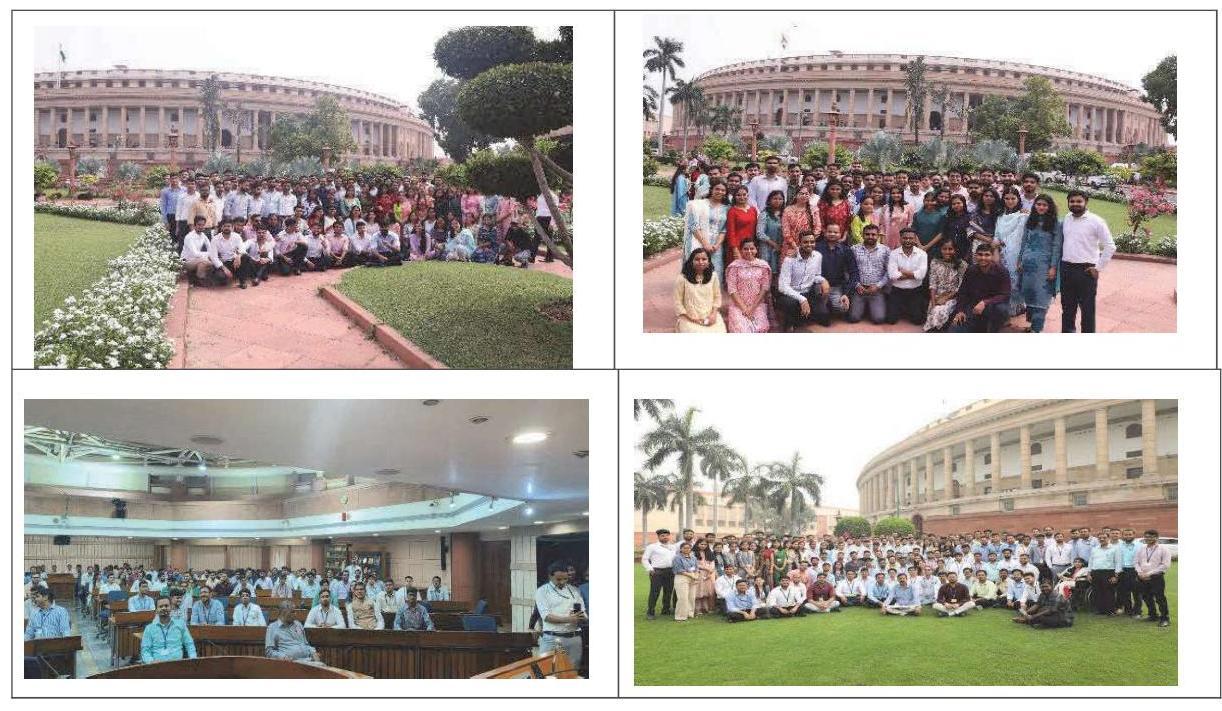
Approximately 175 Assistant Section Officers (Probationers) 2021 Batch participated in Sports Meet, 2023 held on 25th August, 2023 during the Foundation Training Programme. The event allows individuals to showcase their physical prowess and skills. Engaging in sports activities not only enhances physical fitness but also boosts mental well-being, concentration, and productivity. It provides a platform for employees to interact, collaborate, and develop strong professional relationships outside the confines of their work environment. Sports Day also instils a sense of unity and pride within the institution, as participants compete in friendly matches, cheering each other on and celebrating collective achievements.
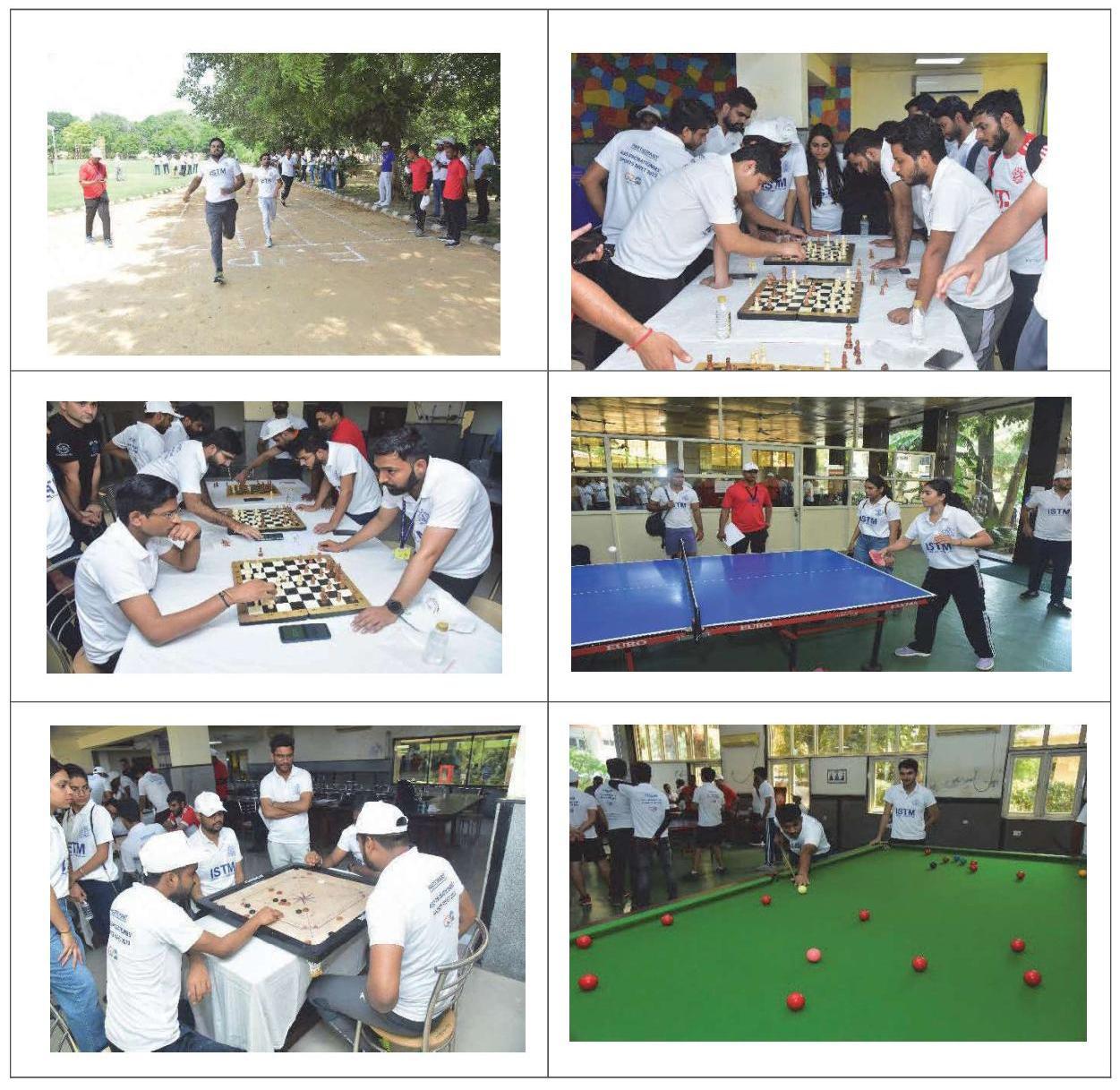
(viii) Independence Day Celebration
ASO Probationers of 2021 Batch participated in Independence Day celebration organized by ISTM on 15.08.2023. More than 50 ASO Probationers showcased their skills through group dance, solo dance, singing, poetry, etc.
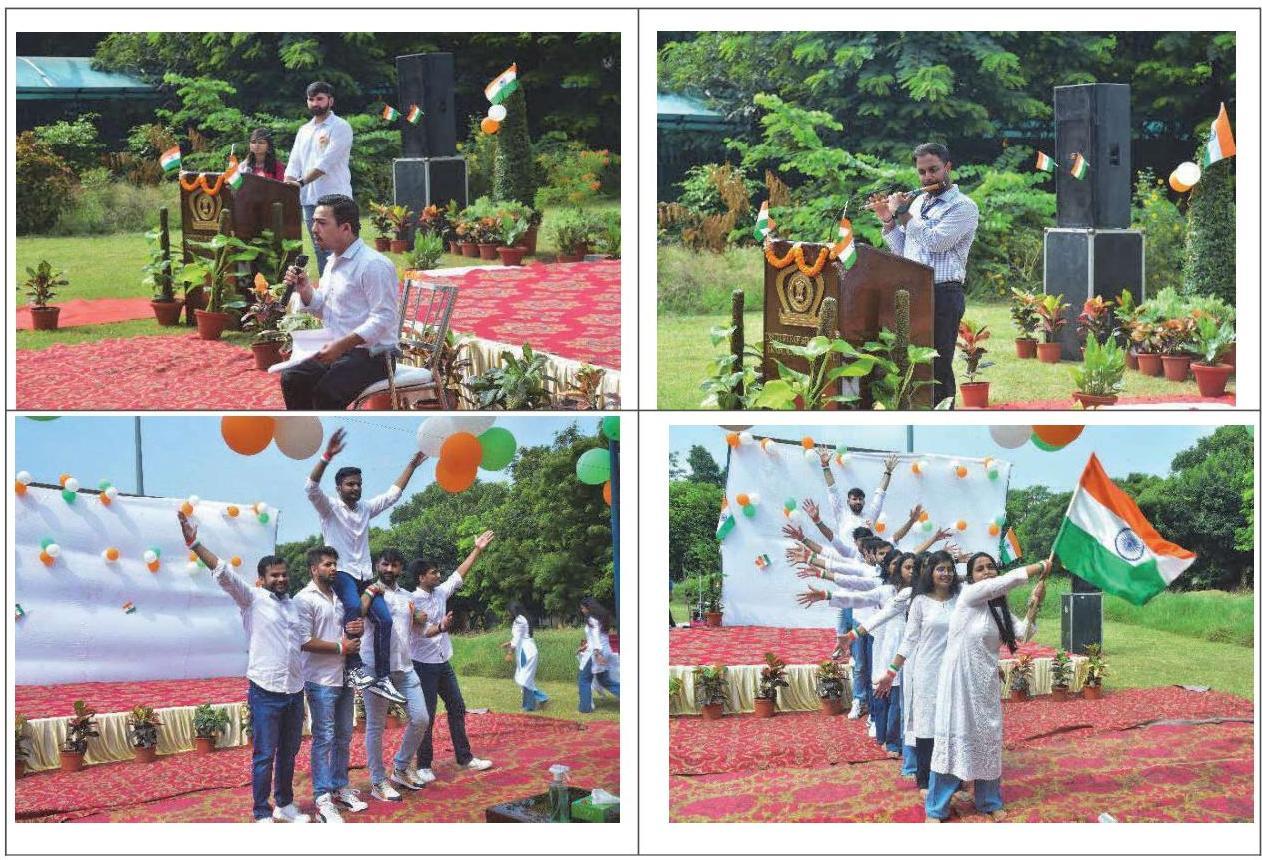
(ix) STUDY TOURS (VILLAGE ATTACHMENT & BHARAT DARSHAN) for CGLE 2019 and CGLE 2021 Batch
Study Tours consisting of Village Attachment and Bharat Darshan in collaboration with ATIs/ SIRDs of states, viz., Jaipur, Hyderabad \& Telangana, Raipur, Chennai, Vijayawada, Lucknow, were organised for ASO Probationers of CGLE 2019 Batch during their 04 weeks of Phase-II Training at ISTM from 27th August, 2023 to 29th September, 2023 and for ASO Probationers of CGLE 2021 Batch during their 09 weeks of Phase-I Training at ISTM from 27th August, 2023 to 08th September, 2023. During the field training, participants are required to be exposed to ground realities in the social sectors, development administration, welfare and infrastructure sectors with a focus in villages. The participants are also required to interact with Village Administration and Block Level Administration regarding various schemes being implemented in selected village. The aim of the training is to show case various developmental activities undertaken for improvement of conditions of villagers and making it viable for economic growth of the country. The participants are required to interact with the villagers in actual work situation as well as they are required to be given inputs by the village/Block Level Administration about actual implementation issues, bottlenecks, best practices and case studies for development.
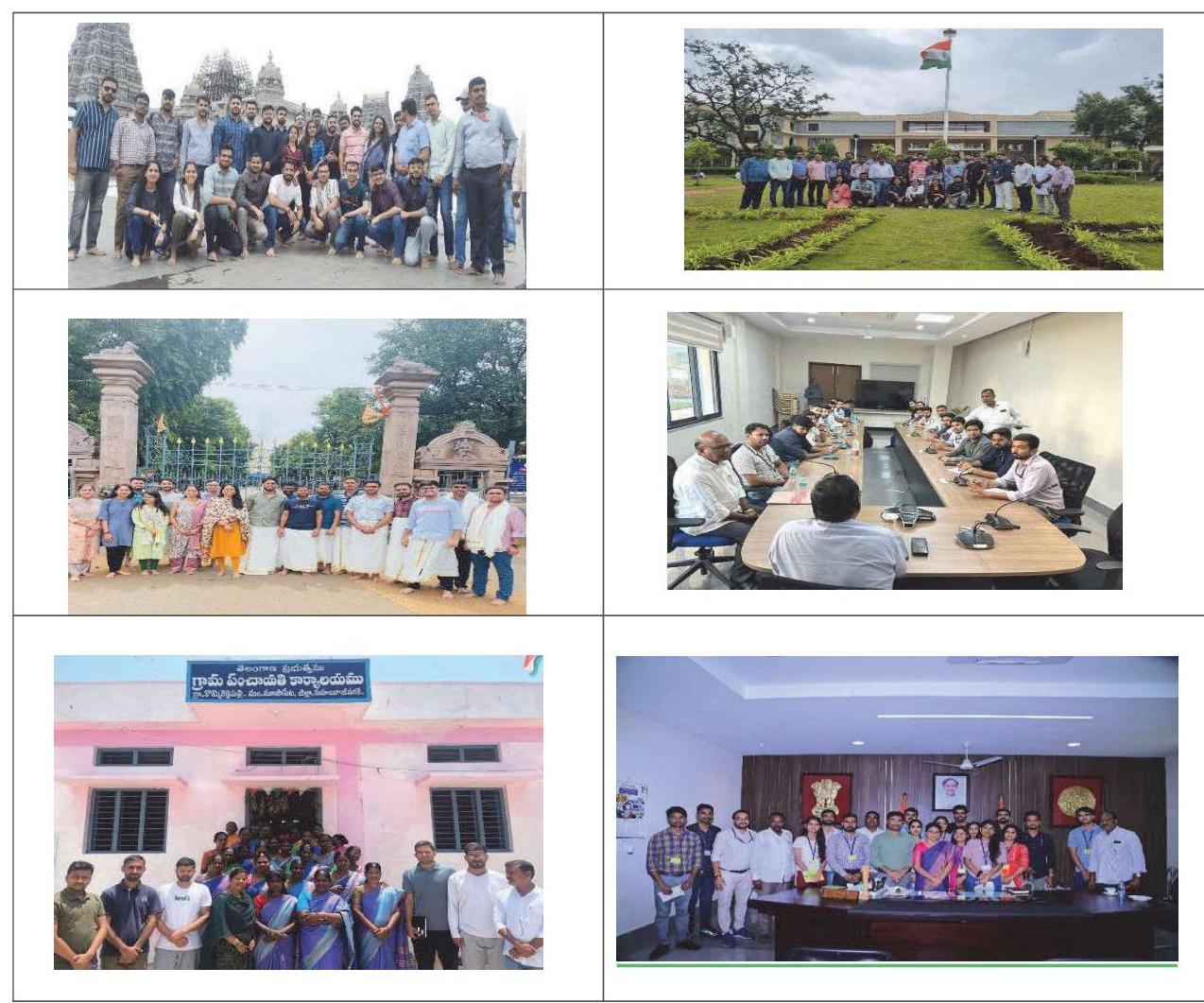
(x) STUDY TOURS (VILLAGE ATTACHMENT & BHARAT DARSHAN) for CGLE 2022 Batch
Study Tours consisting of Village Attachment and Bharat Darshan in collaboration with SIRD Chennai; SIRD, Andhra Pradesh; SIRD Kerala for ASOs of CGLE 2022 Batch from 13th November, 2023 to 24th November, 2023. During the field training, participants are required to be exposed to ground realities in the social sectors, development administration, welfare and infrastructure sectors with a focus in villages. The participants are also required to interact with Village Administration and Block Level Administration regarding various schemes being implemented in selected village. The aim of the training is to show case various developmental activities undertaken for improvement of conditions of villagers and making it viable for economic growth of the country. The participants are required to interact with the villagers in actual work situation as well as they are required to be given inputs by the village/Block Level Administration about actual implementation issues, bottlenecks, best practices and case studies for development.
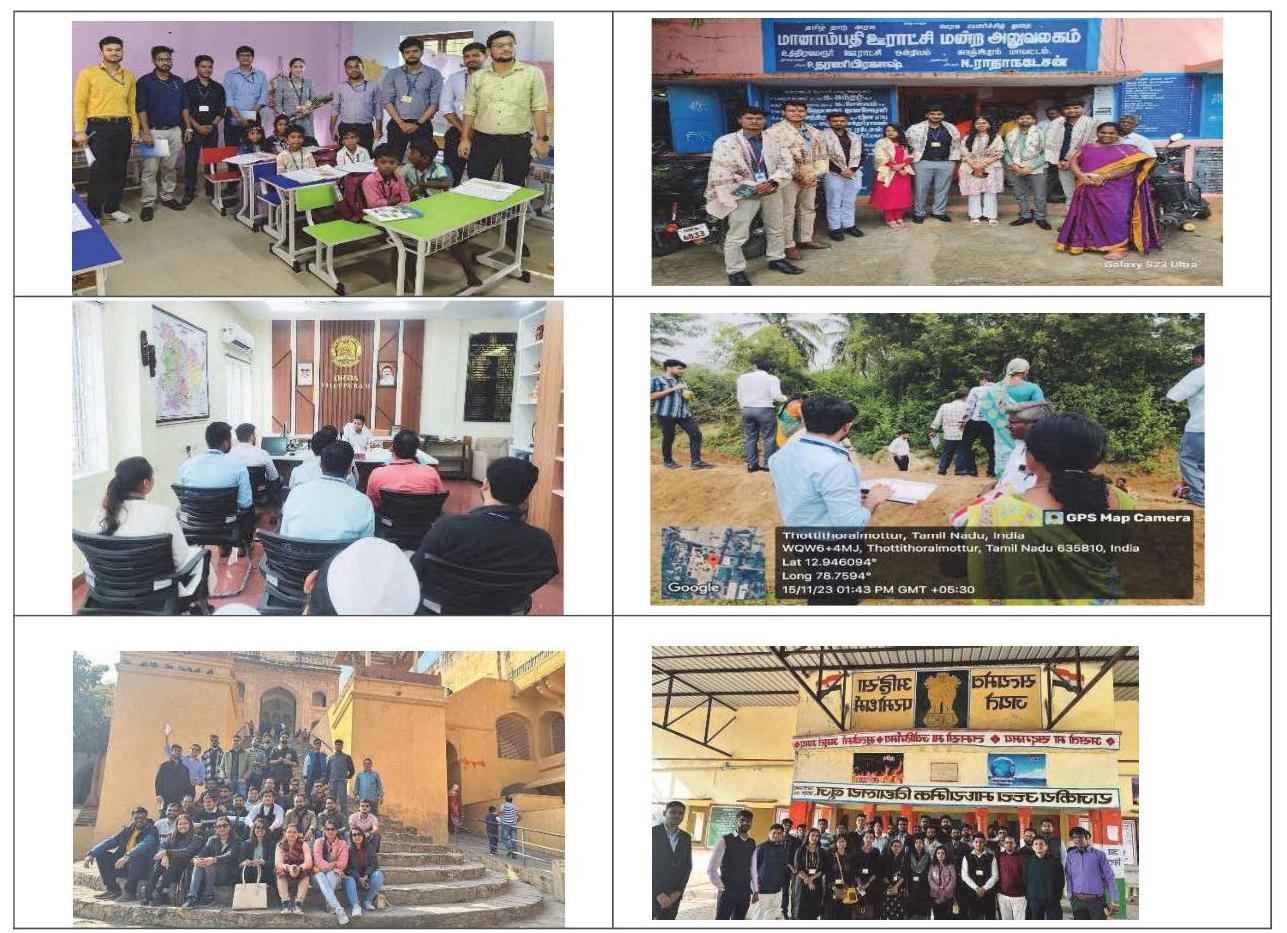
8.7 Launch of Pilot Online “Vikas” Programme by Hon’ble MoS (PP) On 25.12.2023
On the occasion of Good Governance Day, Dr. Jitendra Singh has launch a new blended learning programme named VIKAS (Variable & Immersive Karmayogi Advanced Support) meant for capacity building of Middle management civil servants in Central Secretariat. VIKAS is a blended programme with iGOT consisting of 33 hours complemented by 30 hours of offline training at ISTM with focuses on development of functional, behavioral and technological competencies required in Central Government and also releases 12 e-learning content developed by ISTM on functional/behavioral \& domain competencies.
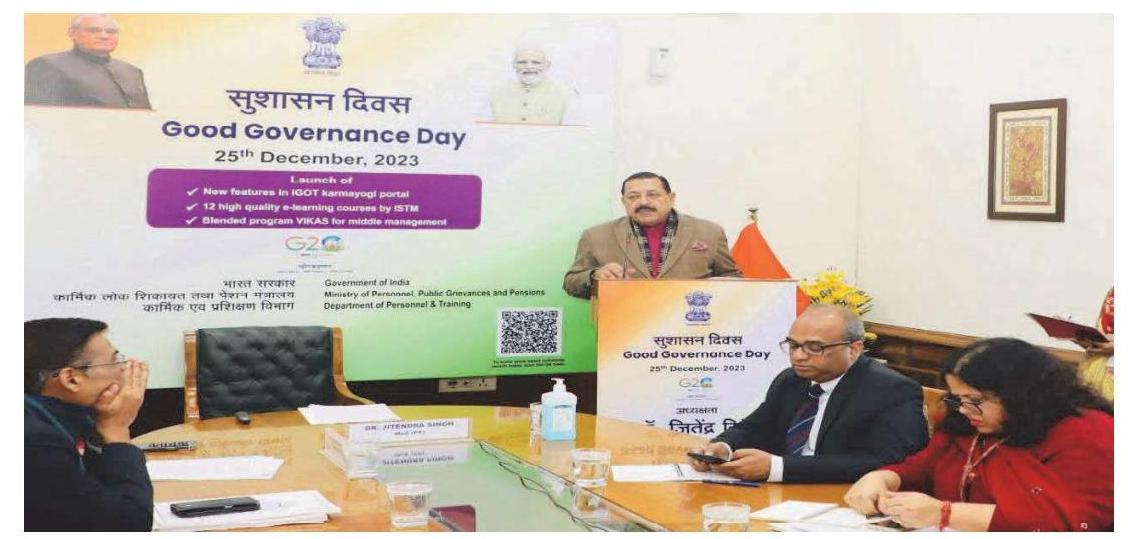
8.8 Visit of Secretary (P) at ISTM
Secretary (P) Visited ISTM on 19.01.2024 for interaction with DoPT Officials who are participating in Half- Day Workshop on “Personnel Policies – Recruitment Rules and Reservation Policies”.

8.9 Celebration of Republic Day
Republic Day is an auspicious occasion that marks the adoption of the constitution, symbolizing the sovereignty and democratic principles of a nation. The day is celebrated with great fervor and patriotism, bringing people together to honor the values that define the country. On this occasion Ms. Rajul Bhatt, Director (ISTM) hoisted the National flag. This was followed by cultural programmes presented by trainee participants, staff members and their families. The participating children were felicitated with gifts.
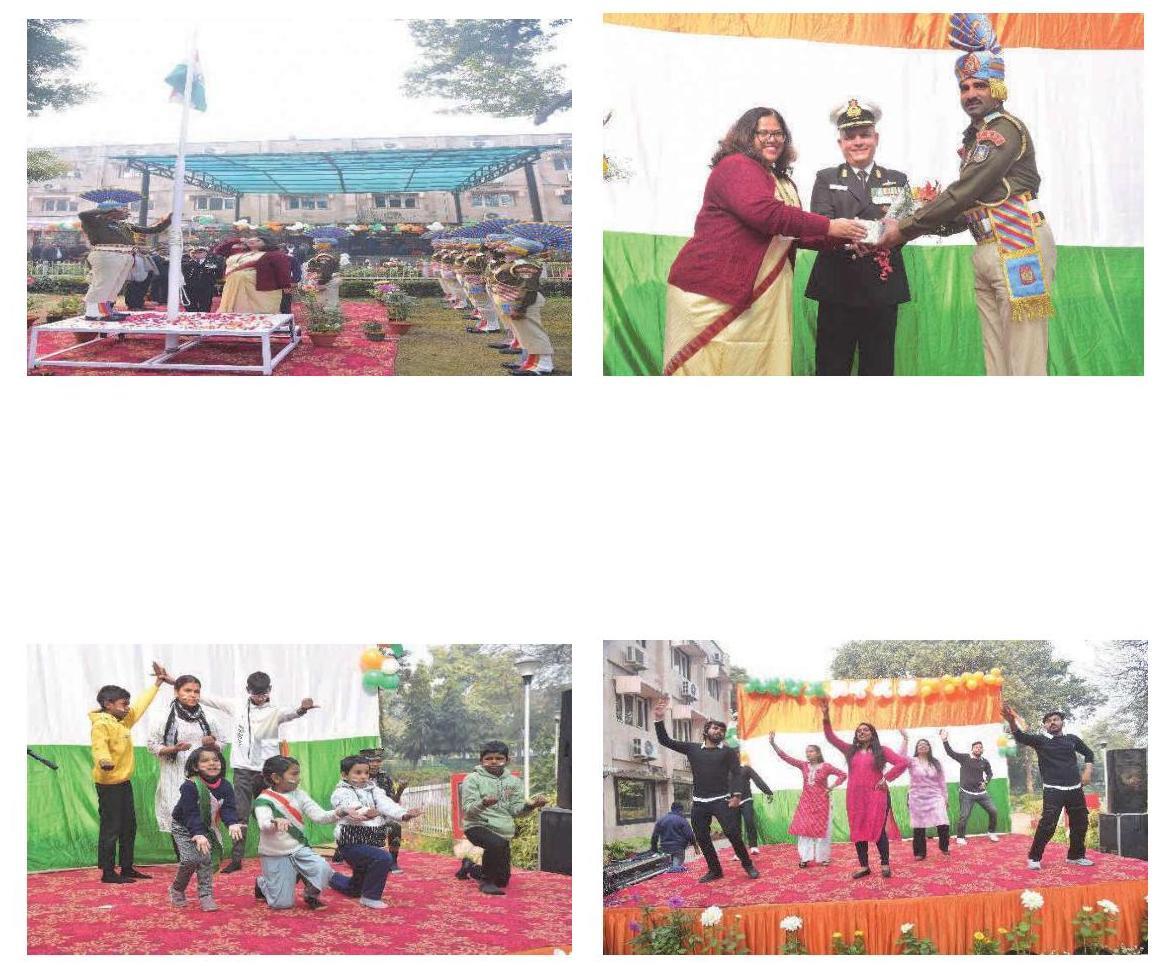
8. 10 Official Language, ISTM
- 10.1 Celebration of Hindi Diwas & Hindi Fortnight, 2023
For promoting the use of Hindi in official works by using motivation and incentives, the institute has celebrated Hindi Diwas on $14^{\text {th }}$ September, 2023 and Hindi Fortnight has been organized from $14^{\text {th }}$ September, 2023 to $29^{\text {th }}$ September, 2023. As per the directions of the Department of Official Language, the Hindi Fortnight has been commenced on $14^{\text {th }}$ September, 2023 from $3^{\text {rd }}$ All India Official Language Conference, Pune (Maharashtra). Deputy Director (OL) and Junior Translation Officer have attended the conference. During the aforesaid period of Hindi Fortnight, various competitions; such as Essay writing, Noting & Drafting, Extempore, Dictation, Story Writing etc.; have been conducted to celebrate and propagate the simplicity, flexibility and uniqueness of Official Language-Hindi.

8. 10.2 Prize distribution ceremony- Hindi Fortnight, 2023
A prize distribution ceremony has been held to reward and applaud the official language skill and the creative mind of the participants under the chairmanship of Smt. Rajul Bhatt, Director (ISTM). Other than participants, higher officials and faculty members of ISTM were also present in the ceremony to witness the moments of honour.
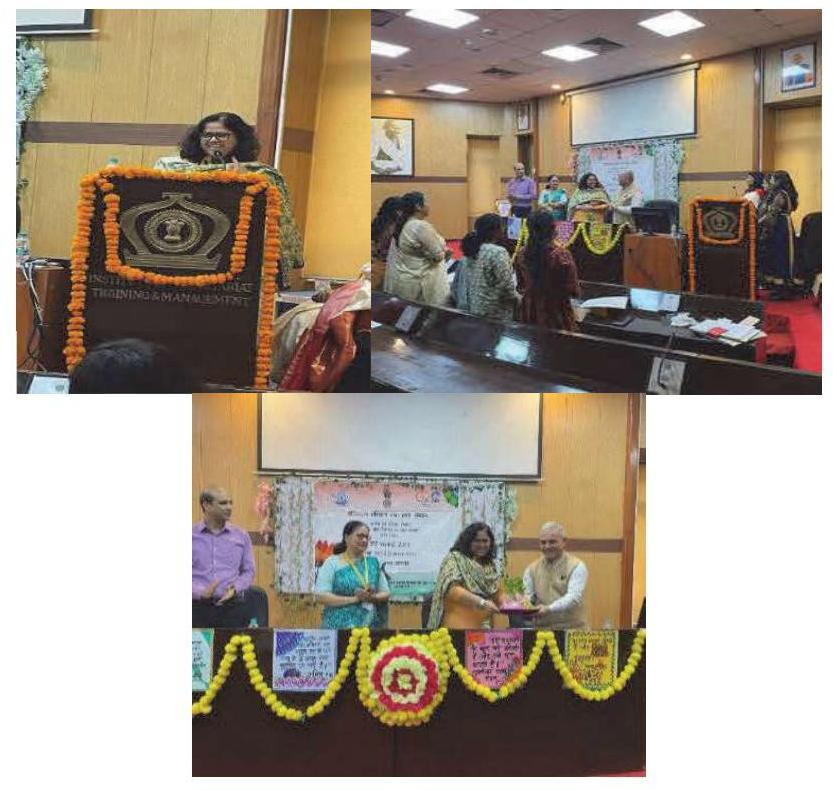
8.10.3 Hindi Workshops
Hindi workshops on the following topics have been conducted during the year:
| Sl. No. | Quarter | Topic |
|---|---|---|
| 1. | April-June | The Official Language Policy of the Union |
| 2. | July-September | E-tools and the Official Language-Hindi |
| 3. | October-December | How to work on Computer in Hindi Language |
| 4. | January-March | Spelling errors and standardization of Devanagari Script |
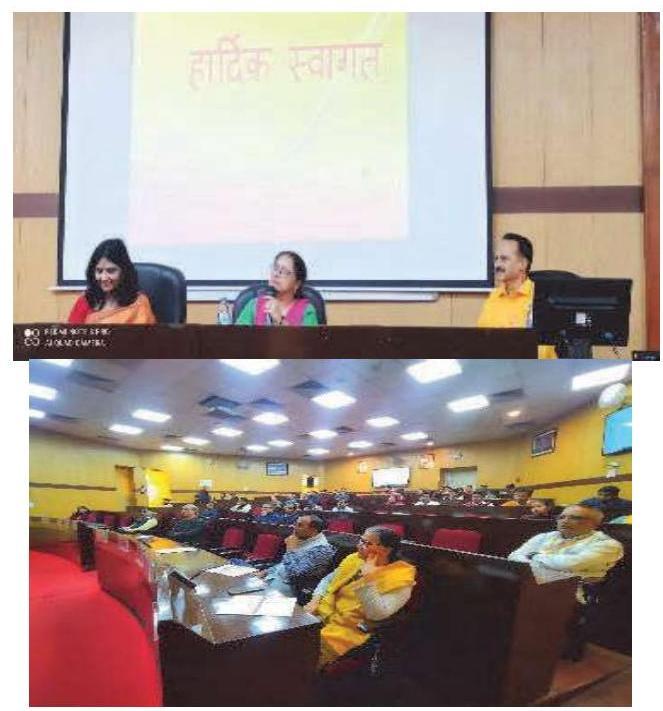
8.11 Upgradation of ISTM Hostel Unit
8.11.1 The ISTM has well-furnished hostel facilities. All 80 rooms equipped with AC/Dish and attached bath-room with geyser. Hostel also have three dining hall with modern kitchen facility. Out-station participants of different courses are provided accommodation on single/twin sharing basis as per their preferences. ISTM Hostel provided to Govt. employees on availability.
8.11.2 Following activities have been made during 2023-24 to strengthen the Hostel facilities:
i. Maintenance of hostel rooms, toilets and Kitchen including seepage, drainage system, carried out through CPWD.
ii. Repair/replacement of complete gas pipe line including Gas Chulha has been carried out.
iii. Latest gym equipment has been provided to gym on trainee’s demand.
iv. Billiard Table and Table Tennis table has been repaired.
v. During the reporting year ISTM Hostel has accommodated 1086 trainees/guests and guest Faculties.
8.12 ISTM Library
8.12.1 The ISTM Library is valuable resource for both staff members and trainees. With a collection of 20,004 volumes spanning various categories, including a notable reference section and special manuscripts from trainees, the library operates in a semi-automated, digital manner. The statistical report reveals growth in resources across documents/books, print magazines/journals, print newspapers, and digital resources compared to the previous year. Noteworthy publications by the library include daily infographics, monthly information bulletins, quarterly newsletters, and monthly indexing publications. Usage statistics indicate increased visitor numbers, document referrals, and active members.
8.12.2 The report highlights key activities such as the Celebration of Reading Month, featuring programs and competitions promoting literacy, with robust participation from faculty, officers, staff, and trainees. The library also hosted its first National Level Seminar for Central Government Librarians on National Librarians Day, focusing on best practices and trends in library services, with participation from 36 librarians across the nation. External speakers and exchange platforms facilitated knowledge sharing. Additionally, the library organized various events such as book exhibitions, talks, and author discussions to engage readers and foster reading habits.
8.12.3 Important Activities of ISTM Library in this year
First-ever National-Level Seminar for Central Government Librarians on National Librarians Day-
In commemoration of National Librarians Day, the ISTM Library organized its first-ever National Level Seminar tailored for librarians from Central Government offices. Held on August 11, 2023, the seminar focused on the theme of “Best Practices in Library Services and Latest Trends.” Thirty-six librarians from across the nation actively participated in the event.
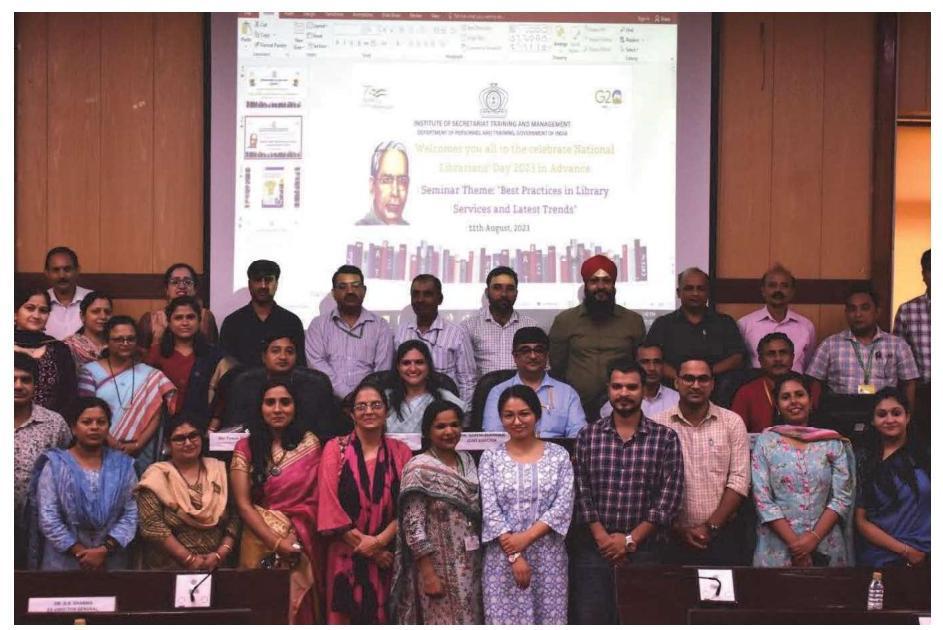
The seminar commenced with an inaugural address and chairmanship by Shri Naresh Bhardwaj, the Joint Director of ISTM. Shri Rajesh Singh, Deputy Director of ISTM, provided an overview of the Institute’s functions to the participants. The initial session, led
by Shri Pawan Kumar Shrivastav, ALIO at ISTM, highlighted the exemplary practices observed in the ISTM Library. Subsequent sessions were conducted by esteemed external speakers, including Shri R.K. Sharma, Ex-Director General of Delhi Public Library; Shri Kumar Sanjay, Director (Library) at Niti Aayog and Dr. Lata Suresh, Head of the Knowledge Resource Centre at the Indian Institute of Corporate Affairs.
Additionally, all attending librarians had the opportunity to tour the ISTM Library, exploring its extensive collection and experiencing the Library’s OPAC service. Furthermore, a platform was provided for librarians to exchange and share the best practices implemented in their respective libraries, fostering a collaborative environment for knowledge exchange and enhancement.
8.13 Infrastructure Development
8.13.1 Hon’ble Prime Minister lay the foundation stone of Phase I of Integrated Complex “Karmayogi Bhavan” at New Delhi-
On 12th February, 2024 Prime Minister laid the foundation stone of Phase I of the Integrated Complex “Karmayogi Bhavan” at New Delhi. This complex will promote collaboration and synergy amongst various pillars of Mission Karmayogi.
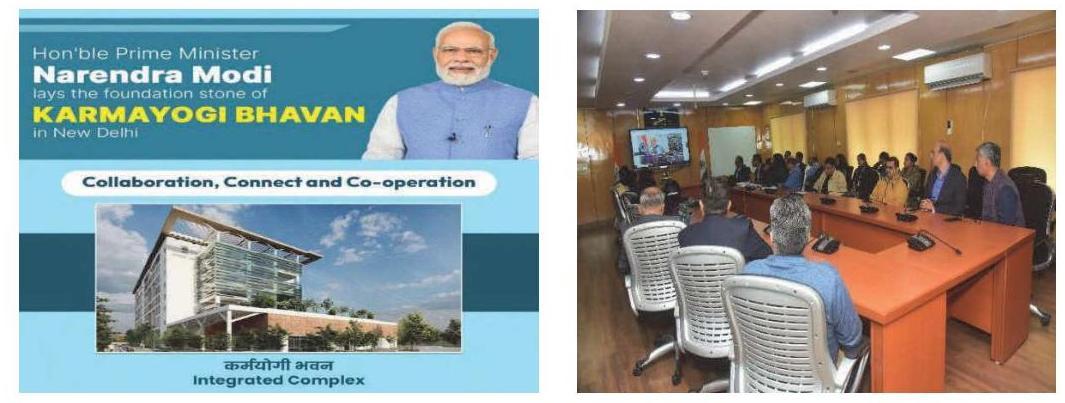
Integrated Building for Institute of Secretariat Training & Management and other Institutes of Department of Personnel \& Training is in process, for which 7.51-acre land have been allocated by L\& DO, MoHUA. The project is to be completed in two phases. Phase-I is for Integrated Building for ISTM and other Institutes of DoPT and Phase-II is for Hostel Building of ISTM.
A piece of land measuring 6.09 acre has been allotted by L\&DO/MoHUA to Ministry of Personnel, PG \& Pensions for ISTM for construction of integrated building. The total cost of the land $40,52,66,540 /-$ has already been paid during previous financial year. An Integrated training complex for ISTM and office accommodation for DOPT has been planned. In addition, a state-of-the-art Hostel accommodation will also be developed along with office accommodation for Capacity Building Commission (CBC) and SPV for Mission Karmayogi. The project is located in prime location. The facility under integrated structure developed will significantly enhance capacity of ISTM to provide training to approx. 14000 CSS and 7000 CSSS officials.
It is proposed to develop ‘Centre for Excellence’ for various themes as part of new infrastructure and digital labs in line with emerging technologies. An Immersive Lab for Emerging Technology (iLET) will be housed in the new complex to give all the trainees a firsthand experience of use of technology in their respective domain areas. Presently, there is a constraint in conducting training for larger groups. The project will provide larger training halls and upgraded training infrastructure. There shall be training halls of different trainee capacity, catering facilities, state of the art Labs, smart class rooms, webinar rooms, server rooms auditoria, area for physical and mental well-being in the form of Yoga Room and Indoor Games Room. The building will also have exhibition areas and Committee rooms to facilitate exchange of ideas in training and development field. The complex will also house all administrative offices of ISTM and will provide office space for DoPT.
The proposed training capacity of new complex will be as under: –
| Infrastructure | Number of Training halls |
Training Capacity per day |
Annual Training Capacity |
|---|---|---|---|
| Existing | 12 | 480 | 7500 |
| Proposed | 22 | 840 | 21000 |
The integrated complex will also have office space for Department of Personnel & Training (DoPT)/Training Division to provide the officials with better working conditions, storage space and aesthetic functional areas. The new integrated building for ISTM and DOPT will be constructed in the vacant piece of land, adjacent to the ISTM Administrative Block. CPWD Consultants, Architect and ISTM Representatives visited several academies/institute/ office buildings recently built in Delhi NCR and Pune to get inspiration for the new building. While preparing the design for the integrated building best designs/space utilization seen at different places was kept in mind.
The integrated structure will be constructed in eight floors. DOPT offices will be located in part of each floor upto 3rd floor only. Entry and Exit for ISTM and DOPT have been kept separately. In order to facilitate movement of the participants, most of the training areas including training halls of different sizes have been proposed in the first three floors. Fourth floor will have ICT Labs, Behavioural Training Area, Canteen and space for other facilities. While fifth floor will have facilities like canteen, auditorium, committee halls, etc., the sixth and seventh floor will have server room, gym, yoga space and large size auditoria with flexible furniture having capacity of upto 700 participants to cater for training needs of larger groups. Eighth floor is kept for various administrative offices, visiting faculty rooms, etc.
8.13.2 Allotment of land for construction of new Hostel.
L\&DO has also allocated 1.42 acre of land which will be utilized for construction of new Hostel Building for ISTM. The 1.42 acres of land allocated to ISTM is already under possession of ISTM in which there is an existing old hostel. Considering the construction of an integrated building with state of the art training facilities, it is proposed to construct a new hostel building with more accommodation and better facilities, replacing the old structure.
CHAPTER 9
CBC & e-HRMS
Capacity Building Commission
Achievements of Capacity Building Commission.
i. Capacity Building Commission (CBC), an attached office of DoPT, has been functioning under the aegis of Mission Karmayogi, formulating annual capacity building plans for all Ministries/Departments/Organizations (MDOs); to systematically capture the demand for training and transform and elevate the supply side of Capacity Building ecosystem, by reviewing, benchmarking and targeted upgradation of the various Civil Service Training Institutes (CSTIs). The composition of CBC is as under:
a. Shri Adil Zainulbhai, Chairman
b. Shri R. Balasubramaniam, Member (HR)
c. Shri Praveen Pardeshi, Member (Admin)
d. Shri Shyama Prasad Roy, Secretary
ii. Key activities taken up by the Capacity Building Commission are as under:
a. Capacity Building Commission is coordinating preparation of Capacity Building Plans (CBPs) of Ministries, Departments and participating organisations (MDOs). The CBPs will help in identifying the demand for capacity building at individual, organizational and institutional level in each MDO. CBC has facilitated the development of 107 CBPs across MDOs.
b. Capacity Building Commission is also working with Urban Local Bodies (ULB) to develop an integrated approach for enhancing capacity of Urban Local Bodies. CBC has facilitated CBPs for 7 ULBs and a ‘Toolkit for Preparation of CBPs for ULBs’ has been developed for the benefit of all ULBs. Besides this, CBC has also signed Memorandum of Understanding with states like Meghalaya, Gujarat, Maharashtra, Uttar Pradesh, Madhya Pradesh, Jharkhand and Uttarakhand for undertaking various capacity building activities for the State Government officials.
c. CBC is closely collaborating with the Civil Services Training Institutions (CSTIs) for standardization of training and capacity building, pedagogy and methodology. This initiative caters to the supply side of the capacity building ecosystem. CBC has facilitated the accreditation of 84 CSTIs. CBC organized a National Training Conclave on 11th June, 2023 to bring together all Civil Services Training Institutes (CSTIs) in a common setting for the first time with the aim that this effort will help identify strategies for the Ecosystem to build and improve together. The Conclave provided a platform for knowledge exchange, identifying challenges and key areas of collaboration.
d. CBC has also undertaken the work of accreditation of CSTIs after the launch ‘National Standards for Civil Service Training Institutions’ portal. The NSCSTI framework aims to introduce benchmarks on key parameters for CSTIs as a means for continuous improvement of these Institutions. This portal is aimed at to setting common standards of excellence and promote organizational improvement through continuous self-assessment
of Training Institutes. This would also institutionalize a forum to highlight best-practices and facilitate collaborative learning, and give direction for long-term strategic planning.
e. CBC has entered into knowledge partnerships with various Institutions for capacity building of civil servants by leveraging expertise of these academic & other institutions. So far it has entered into partnerships with 45 such institutes.
f. The Commission has undertaken Large Scale Interventions for sustainable behavioural changes amongst the public facing Government officials, with active involvement of stakeholders throughout the system with the objective to improve interactions with citizens for better citizen experience (Citizen Centricity) and re-awakening the aspiration to serve (Sewa Bhaw) amongst the public servants. It has piloted large scale interventions with various citizen – facing agencies like Railways (Rail Karmayogi program); Dept. of Posts (Dak Karmayogi Program); Ministry of Home Affairs, Ministry of Youth Affairs (MoYA); Ministry of Electronics \& IT (MeitY); BSNL; UT Police Forces (Police Karmayogi Program) and Delhi Police to co-develop short, self-paced digital modules focused on building behavioral competencies and have trained over 4.3 lakh citizen facing officials. CBC in collaboration with Central Board of Direct Taxes (CBDT) has also created a training program on Grievance redressal of taxpayers as part of its large-scale intervention taken by 8000 IT officers. Similar engagement with CBDT is being undertaken.
g. The Capacity Building Commission has initiated, curated and coordinating and supporting a network of senior practitioners of public leadership as a part of Community of Practice to provide a sense of continuity \& Purpose to share the knowledge created to and facilitate collective learning from the course.
h. CBC launched the programme “Innovation in Public Administration” to share innovative practices that Govt. employees across Central, State or Local Govts. (including A, B or C) have undertaken in public Administration. These submissions would be used as case studies for Capacity Building of present and future civil servants, and to assist in developing a knowledge Repository that can be accessed by all, to scale-up innovation in the country.
i. CBC has onboarded $80+$ courses on Karmayogi Bharat Platform with course enrolment over 23.5 lakhs and over 16 lakhs course completion. CBC created the physical course on ‘Emerging Technologies’ in collaboration with Institute of Public Administration (IIPA) and Wadhwani Institute of Technology and Policy). Designed as an introduction on key emerging technologies for civil servants, wherein the online part of the course is available on iGOT, has been undertaken by 2,22,910 officials. CBC has also facilitated other function courses like the 10 Microsoft courses, courses on Cyber Security and Cyber Siksha which has seen course completion by over 3.15 lakhs Govt officials.
j. CBC has also assisted various Ministries / Departments in carrying out Immersion Program with Industry Partners for deep hands on experience of the subject matter being dealt by the Government officials in the Ministries / Departments.
k. CBC has also created instruments like leadership Assessment toolkit; resources for courses such as Learning Design Manual and Course Evaluation Matrix. It is also conducting Faculty Development Programs for building capacity of the Training Institutes
across the country. CBC also organized a workshop to train Central Training Institutes (CTIs) and State Training Institutes (ATI) faculty members in developing case studies.
- CBC has also been providing policy recommendations to DoPT on various issues. The Karmayogi Guidelines has been framed by DoPT with inputs from CBC. The Commission has also been supporting Karmayogi Bharat with policy recommendations for the content framework on iGOT.
e-Human Resource Management System 2.0 (e-HRMS 2.0)
- Department of Personnel and Training (DoPT) introduced the Electronic Human Resource Management System (e-HRMS) with effect from 25.12.2017 to digitize the service records of Central Government employees and for providing certain HR processes in a digital working environment. e-HRMS is one of the six key pillars of Mission Karmayogi.
- e-HRMS2.0, launched on 25.12.2022 by the Hon’ble Minister of State for Personnel, Pensions and Public Grievances, is a completely revamped version of e-HRMS that envisions to cover the entire life cycle of an employee’s service and offers AI enabled dashboards for insights/suggestions for transparent and efficient decision-making in-service matters.

Services on eHRMS 2.0
3. e-HRMS 2.0 has been modelled to provide all major employee related HR Services like training, promotion, deputation, transfer, superannuation, resignation, integrating various related platforms such as iGOT, SPARROW, PFMS, Bhavishya, Probity etc and facilitating the uptake of entitlements & benefits like various kinds of Reimbursements, Claims, Advances and Leaves by the employee in an easy and transparent manner.
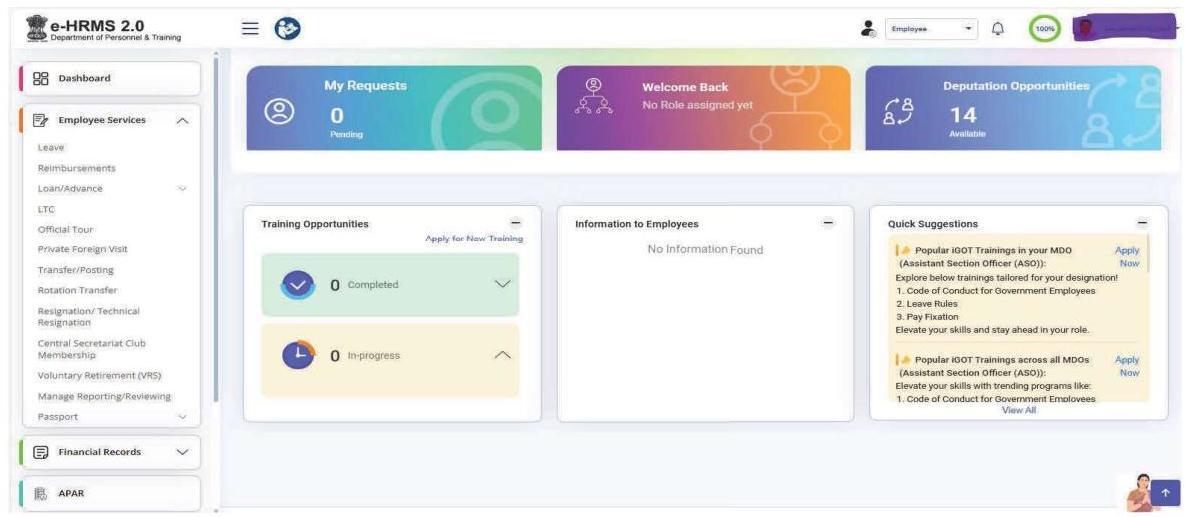
Claims/Services for employees on e-HRMS.2.0
4. e-HRMS provides analytics to the Senior Administration in Policy formulation and implementation. e-HRMS has built in tools and capabilities to bring together dispersed data to generate automated clearances and suggestions in its modules.
Salient Features of e-HRMS
| 1. | Single source of authentic employee data |
6. | 24X7 access and availability |
|---|---|---|---|
| 2. | Common document repository of employees |
7. | Ease of sharing information among stakeholders |
| 3. | MIS reports analytics | 8. | e-Sign facility |
| 4. | Standardization of master data | 9. | Alerts/notification functionality |
| 5. | Minimizes manual entry of data | 10. | Integrated with other applications like iGoT Karmayogi, SPARROW PFMS, Probity etc. |
Achievements:
a. As per e-HRMS Dashboard report, more than 3.60+ lakh employees of 134 Ministries /Departments/Organisations (MDOs) including 03 UTs and 02 State Govt have been onboarded onto the e-HRMS platform.
b. Training, Deputation, IPR, APAR, Vigilance Clearance, Leave, Reimbursement are in use by various MDOs now.
c. Financial Sanctions for Claims & Reimbursements have been integrated with PFMS, Leave Module enhanced with new leave engine and new features of configurable work calendars and leave account and new functionality for NOC/Intimation for Passport, LTC Claim rolled out. Modules for TA/DA, pension benefits, NOC for Higher Studies, Briefcase allowance Medical reimbursement (Non-CGHS) etc. have been developed and roll out is in process.
d. Akin to the citizen’s charter, timelines for Service Delivery through e-HRMS 2.0 portal has been issued vide DoPT ‘s OM No. 3/1/2024-e-HRMSv2.0 dated 29.02.2024. Deemed approval of various types of leaves has been implemented.
e. e-Service Record is LIVE now. Integration with Bhavishya portal in progress. Post integration, eHRMS will be a stop shop for onboarded employees to apply for retirement benefits like pension, CGHS card and NOC for Govt Accommodation, requirement of physical service book shall be done away with and the process will be completely paperless and trackable.
f. AI enabled analytical dashboard for various roles (Nodal/MDO/CCA/ AVD/ Superadmin etc) have been developed providing various analytics to senior administration for decision and policy making. It is envisaged that e-HRMS shall serve as a comprehensive directory for all central government employees, also making available real time data on competencies gained by them through capacity building courses on i-GOT and enabling critical decision-making for deployments leading to more productive and efficient work force. Functionality for creation of dynamic queries for suggestive result sets for right person for right job is in progress.
Other key highlights:
a. Integration Status: For Vigilance Clearance, APAR, Training, Salary Slips, Retirement module, the e-HRMS2.0 portal integrates with Probity, SPARROW, iGOT, PFMS.
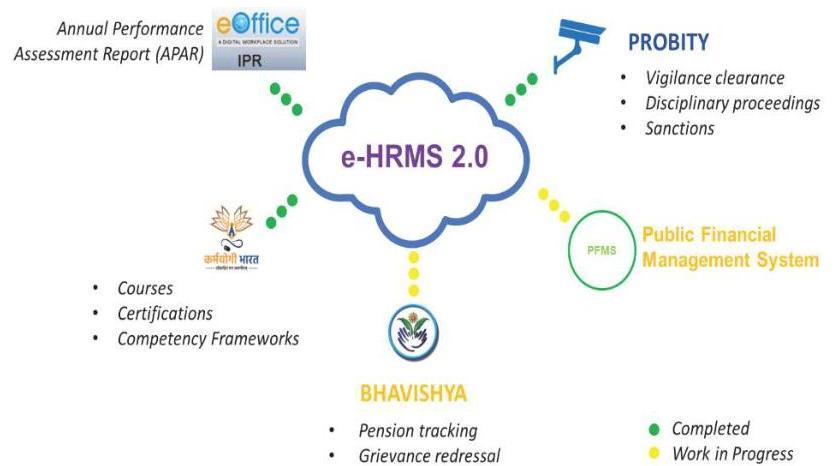
b. Deputation module leverages AI based features to alert employees about the opportunities available to them according to their qualification/experience. The platform allows application for these deputation opportunities by interested and eligible employees and provides a transparent and trackable mechanism for subsequent processing of the applications, relieving and joining.
c. e-HRMS 2.0 has also developed linkages with iGOT-Karmayogi platform to offer training programs, store competency history of officers and download of certificates for successfully completed trainings from the portal itself. It leverages the power of AI to automatically suggest suitable training opportunities for individual officers, based on their assigned role and preferred career path and nudges the employee to gain further competency by broadcast of information of most popular trainings and trainings being done by others at his level or in her MDO.
d. Successful paperless DPCs have been conducted via e-HRMS 2.0 portal. This has saved transaction time and costs and increased transparency.
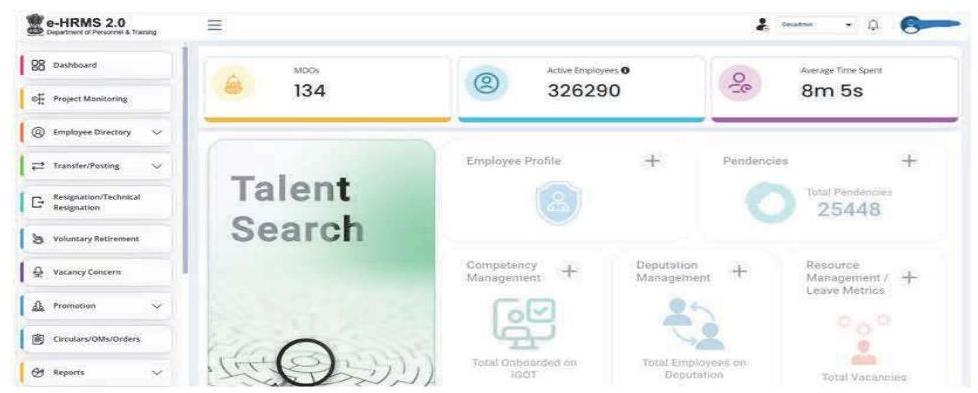
eHRMS SuperAdmin Dashboard
CHAPTER 10
ADMINISTRATIVE VIGILANCE DIVISION
10.0 Administrative Vigilance Division-I is responsible for examination of disciplinary cases and vigilance matters in respect of Indian Administrative Service officers working under the Central Government and State Governments under the All India Services (Discipline and Appeal) Rules 1969 and All India Services (Death-Cum-Retirement Benefits) Rules, 1958. Administrative Vigilance Division-I is also responsible for examination of disciplinary cases received from the Ministries / Departments in respect of Group ‘A’ officers of the Central Secretariat Service (CSS) and Central Secretariat Stenographers Service (CSSS) for initiation of disciplinary proceedings under Rule 14, Rule 16, Rule 19 of CCS (CCA) Rules, 1965 and under Rule 9 of CCS (Pension) Rules 1972 .
Administrative Vigilance Division-III is responsible for Complaints of corruption relating to Central /States /UT Administration and Public Sector Undertakings; Suggestions for eradication of corruption and publicity thereon; Complaints of corruption relating to commercial firms; All matters concerning the CVC; Disagreement cases with the advice of CVC from other Ministries / Departments; Annual Report of the CVC; Parliament Questions pertaining to anticorruption activities of Government; Reference relating OECD matters; Allegations / complaints / enquiries against Chief Ministers and Ministers of State Governments; Setting up of Commissions of Inquiry relating to corruption charges and matters relating thereto
10.1 The Division processes cases referred by the State Governments and Ministries / Departments under Government of India on the following issues:
- Proposals from the State Governments seeking to impose major penalty of dismissal / removal / compulsory retirement on members of IAS.
- Proposals from the State Governments seeking permission under the AIS (DCRB), 1958 Rules to initiate action against retired members of IAS.
- Proposals from the State Governments for imposing penalty of cut in pension against retired IAS officers.
- Proposals to initiate disciplinary proceedings / suspension of IAS officers working under the Government of India.
- Appeal against suspension submitted by IAS officers serving in the States.
- Memorial submitted by IAS officers against the orders passed by the Central Government or the State Governments in disciplinary proceedings in which the officer is aggrieved.
- Requests for sanction for prosecution against IAS officers under the Prevention of Corruption Act, 1988.
- Requests for sanction for prosecution under the Prevention of Corruption Act, 1988 against Group ‘A’ officers of the Central Secretariat Service (CSS) and Central Secretariat Stenographers Service (CSSS) cadres.
- Handling of Privilege Notices from the Members of Parliament received from the Lok Sabha / Rajya Sabha Secretariat as well as complaints against IAS Officers.
- Examination of vigilance status of IAS officers for purposes of empanelment/ training/ posting on deputation and other purposes as per extant guidelines. To facilitate this function, a Computerized Vigilance Information System is in operation with a central data base which can be accessed by the requisitioning Divisions concerned of this Department.
- Examination of vigilance status of all Group ‘A’ officers of the Central Secretariat Service (CSS) and Central Secretariat Stenographers Service (CSSS) cadres for various purposes viz. promotion, empanelment, deputation, VRS, etc as per extant guidelines.
- Advice / clarification to the State Governments / Central Ministries/ Departments on the procedural aspects of disciplinary proceedings.
10.2 Disciplinary Proceedings:
- During the period 01.04.2023 to 31.03 .2024 , thirteen final orders in thirteen disciplinary cases against Group ‘A’ officers of CSS was issued. In five cases, charge sheet was issued against Group ‘A’ officers of CSS cadre.
- During the period 01.04.2023 to 31.03 .2024 , three disciplinary cases against the IAS officers were initiated and two final orders were issued on conclusion of disciplinary proceedings cases.
- In one case, suspension against Group ‘A’ officer of CSS cadre was revoked and in one case, suspension against Group ‘A’ officers of CSS cadre was accorded and the same was reviewed from time to time.
- A panel of retired IAS officers has been constituted in December, 2023 for appointment as Inquiring Authorities in disciplinary proceedings against IAS officers to avoid delay in the matter.
- In four cases, final orders were issued in disciplinary proceedings matters against IAS officers working under the affairs of state government/UTs.
- Two suspension cases against IAS officers serving in the State Governments were reviewed by the Central Ministry’s Review Committee and suspension period in these cases were extended.
- In eight cases, suspension of IAS officers while serving in State Governments/UTs were confirmed and further extension beyond thirty days was approved and conveyed.
- One appeal against minor penalty received under Single Window System was examined and same was processed.
10.3 Sanction for Prosecution and Monitoring of Proposals of Sanction for Prosecution under provisions of Prevention of Corruption Act, 1988:
- Sanction for prosecution has been decided in 15 cases involving 15 IAS Officers under Prevention of Corruption Act, 1988 (as amended in 2018) during the period
from 01.04.2023 to 31.03.2024. Of which, Sanction for prosecution was granted against 14 IAS Officers whereas the same has been denied in respect of 1 IAS Officer.
- Sanction for prosecution was accorded against 01 Group ‘A’ Officers of CSS cadre, under Prevention of Corruption Act, 1988 in respect of Group ‘A’ officers of CSS cadre.
10.4 Privilege Notices from Members of Parliament and Complaints against IAS officers:
- During the period 01.04.2023 to 31.03.2024, 7 Privilege notices against officials of Districts Administration for protocol violation were received from the Lok Sabha/Rajya Sabha Secretariat and processed during the period. 7 Privilege notices were finally disposed of.
- During the period 01.04.2023 to 31.03 .2024 , no complaints were received from Hon’ble Members of Parliament against IAS officers.
- During the period 01.04.2023 to 31.03 .2024,1170 complaints against IAS officers were received and processed, and $\mathbf{1 1 7 0}$ complaints were finally disposed of.
- During the period 01.04.2023 to 31.03 .2024,73 complaints against Group “A” officers of CSS/CSSS cadres were received and processed.
Disagreement cases in Disciplinary matters:
10.5 In order to bring about greater uniformity in examining on behalf of the President the advice tendered by the CVC and taking decisions thereon, it has been decided that this Department should be consulted before the Ministries/Departments finally decide to differ from/not to accept any recommendation of the Central Vigilance Commission in those cases which relate to Gazetted Officers for whom the appointing authority is the President, the matter is to be referred to this Department for resolving the disagreement. This Division has, however, disposed of no such case between 01.04.2023 and 31.03.2024.
Disagreement in the matter of Prosecution Sanction cases:
10.6 Similarly, the cases of disagreement between the CVC/ CBI and Sanctioning/Disciplinary Authority in the matter of Prosecution Sanction cases are required to be referred to DoP&T for a final decision in terms of this Department’s OMs dated 01.03.2019 and 18.07.2019. As per these OMs, before taking a final decision for grant or denial of sanction for prosecution, the Competent Authorities shall obtain views of DoP\&T, in cases where they decide to differ with CVC’s advice. Accordingly, the views of DoP\&T may be taken into account while passing final speaking order.
This Division has disposed of 13 such cases between 01.04.2023 and 31.03.2024.
Appointment of Central Vigilance Commissioner and Vigilance Commissioner:
10.7 In terms of Section 4(1) of the Central Vigilance Commission Act, 2003, the President vide Warrant of Appointment dated 09.02.2024 has appointed Shri A S Rajeev, former Managing Director and CEO, Bank of Maharashtra recommended by the Committee under the Chairmanship of Hon’ble Prime Minister as Vigilance Commissioner in the Central Vigilance Commission.
Central Vigilance Commission
Introduction
1.8 The Central Vigilance Commission (CVC) is the apex integrity institution mandated to combat corruption and ensure integrity in public life. It is a statutory body vested with superintendence over vigilance administration of various Ministries of the Central Government or corporations established by or under any Central Act, Government companies, societies and local authorities owned or controlled by that Government.
With its outreach measures, CVC also endeavours to create awareness for achieving transparency, accountability, probity and corruption free system of administration.
Statutory Provisions
10.9 CVC was set up by the Government of India through Resolution No. 54/7/64 dated 11.02.1964. Later on, it was accorded statutory status through the Central Vigilance Commission Act, 2003 (No. 45 of 2003) passed by the Parliament.
10.10 The role and functions of CVC include exercising superintendence over the functioning of DSPE (CBI) and monitoring progress of cases registered for investigation by DSPE under PC Act, 1988.
10.11 CVC also reviews the progress of cases pending with the competent authorities for grant of sanction for prosecution of employees of the organizations covered under its advisory jurisdiction, especially those in which sanction has been delayed.
10.12 CVC can inquire or cause inquiry into complaints/offences alleged to have been committed under the PC Act 1988 by employees as specified in Section 8 of the Central Vigilance Commission Act, 2003 (45 of 2003).
10.13 As part of superintendence over vigilance administration of organizations covered under its jurisdiction, CVC tenders advice in disciplinary matters having vigilance angle, involving officers covered under its advisory jurisdictions.
10.14 CVC is the designated agency to receive and act on complaints or disclosure on any allegation of corruption or misuse of office from whistle blowers under the “Public Interest Disclosure and Protection of Informers’ Resolution” (PIDPI), 2004. CVC, as the designated agency under PIDPI Resolution is empowered to take appropriate steps if the complaint is found to be motivated or vexatious.
10.15 Each organization covered under the advisory jurisdiction of the CVC has a vigilance unit headed by the Chief Vigilance Officer (CVO). The CVOs act as extended arms of the CVC and are responsible for timely action on advice tendered by the Commission, apart from ensuring proper implementation of the guidelines issued by CVC. One of the important functions of CVOs is to advise the authorities in the organizations for establishing effective systems and procedures and to periodically monitor compliance of the same to minimize systemic failures/loopholes, which provide opportunities for malpractices/ irregularities.
10.16 As per Section 14 of the CVC Act, 2003, CVC submits an Annual Report of its activities to the President within six months of the close of the year under report. On receipt of such report, the President shall cause the same to be laid before each House of Parliament.
Multi-Pronged Strategy to combat Corruption
10.17 CVC has adopted a multi-pronged strategy to fight and eliminate corruption, which stresses not only on punitive vigilance but also on preventive mechanism and participative measures.
Punitive Vigilance
10.18 The Commission is of the firm view that time-bound and effective punitive action resulting in award of exemplary and adequate punishment acts as a deterrent to committing wilful misconduct. The Commission on its part tenders appropriate advice in respect of cases referred to it by various organisations. It reviews the progress of departmental actions periodically, through the mechanism of review meetings. The Commission seeks investigation report from the organizations concerned, in respect of those complaints where a specific issue with perceptible vigilance angle is found.
10.19 The advisory role of Commission extends to the specified categories of employees of the Central Government, corporations established by or under any Central Act, Government companies, societies and local authorities owned or controlled by the Central Government and for matters connected therewith or incidental thereto. Commission’s advisory role consist of a twostage mechanism i.e. first stage advice, after completion of investigation but before initiating disciplinary action and Second Stage Advice (SSA), i.e after issuance of charge sheet to delinquent employee. On completion of the inquiry proceedings, if the competent authority holds a view, which is different from Commission’s FSA, the Commission is to be approached for obtaining its SSA.
Preventive Vigilance
10.20 Central Vigilance Commission, the apex institution for vigilance administration in the country uses various tools for effective vigilance administration. Preventive Vigilance measures are amongst the most important tools to eliminate corruption as it improves upon existing systems, procedures and establishes in-built checks within the system to bring about standardisation, transparency, accountability and probity in Public administration.
10.21 The Commission, based on the inputs provided by the Stake-holders and on consideration of the Vigilance matters brought before it, advises systemic improvement measures.
10.22 The Commission is of firm belief that increasing transparency can be achieved by establishing relationship between government entities and public through use of technology. As such, the use of modern technology is an effective tool for enhancing transparency in governance and better monitoring. As a way forward, topics related to Monitoring of Public Projects, Adoption of ERP Module, Online Vigilance Clearance, Public Procurement, Online Vigilance Complaint Management, Corporate Social Responsibility, Third Party Inspection, Internal Grievance Redressal, Disciplinary Proceedings, Internal Audit & Inspection Methods, Staff Accountability in Banking Sector, etc. have been compiled in a booklet titled “VIGEYE VANI” Special Issue on Increasing Transparency Through Use of Technology.
10.23 The Commission has taken an initiative to conduct an appraisal of the vigilance administration of different organizations. The performance of the organizations has been assessed on critical parameters such as disposal of Disciplinary Proceedings and handling of complaints, by using objective statistical methods. The good practices of the top performing organizations have been compiled in the booklet titled “Best Practices in Vigilance Administration”. The booklet was released during VAW-2023.
10.24 Public procurement constitutes a substantial part of country’s GDP. As such, an efficient and accountable public procurement regime is key to economic development of the country. However, in spite of the availability of public procurement policy and procedures, instances of subjectivity in the procurement related decisions have come to the notice of the Commission. In some cases, the inappropriateness in decision making on account of lack of clarity in the policy and procedures; while, in others, it is attributed to lack of proper knowledge. For the convenience of the officials, references to the rules and procedures connected with different aspects of public procurement, important aspects of various stages of public procurement, irregularities observed along with relevant case studies have been compiled in a booklet titled “Public Procurement” Challenges and Way Forward. The booklet will be useful for the officials in appreciating the nuances attached with various stages of public procurement and will help them in bringing objectivity in procurement related decisions.
Participative Vigilance
10.25 Commission endeavours to promote integrity in every day functions of citizens and elicits participation of all stakeholders in the fight against corruption. One of the major initiatives taken in this regard is the observance of Vigilance Awareness Week every year, to coincide with the birthday of Sardar Vallabhbhai Patel.
10.26 The theme of Vigilance Awareness Week (VAW) 2023 was “Say no to corruption; commit to the Nation : भ्रष्टाचार का विरोध करें ; राष्ट्र के प्रति समर्पित रहें”. This was observed from $30^{\text {th }}$ October to $5^{\text {th }}$ November 2023.
10.27 The observance of Vigilance Awareness Week commenced with the taking of the pledge by public servants in the Ministries/ Departments/ Central Public Sector Enterprises (CPSEs)/ Public Sector Banks (PSBs) and all other organizations, on $30^{\text {th }}$ October, 2023.
10.28 In the Vigilance Awareness Week 2023, in a move towards inculcating the true spirit of participative vigilance, Commission had issued instructions detailing a three-month campaign period ( $16^{\text {th }}$ August 2023 till $15^{\text {th }}$ November 2023) in which six different preventive vigilance measures were to be taken up as focus areas by all the Ministries / Departments and Organizations. The different preventive vigilance activities taken up as focal areas by all the Ministries / Departments / Organizations included the following:
a) Awareness Building about Public Interest Disclosure and Protection of Informers ( PIDPI ) Resolution
b) Capacity Building programs
c) Identification and Implementation of Systemic Improvement measures
d) Leveraging of IT for complaint disposal
e) Updation of Circulars / Guidelines / Manuals
f) Disposal of Complaints received before 30.06.2023.
10.29 As a part of observance of Vigilance Awareness Week, a panel discussion on various issues relating to ‘Disciplinary Proceedings’ was held on $2^{\text {nd }}$ November 2023 at New Delhi. Senior officers from different Government organizations, having expertise and domain knowledge took part as panellist. The panel discussion was also attended by senior officers of the Government and CVOs of major Central Government organizations.
The panel discussed various aspects relating to the timely completion of disciplinary proceedings within the stipulated time period so that guilty officials are punished appropriately and innocent officials are not harassed due to delay in completion of departmental proceedings. These sessions inter alia included expeditious disposal of bias petitions of charged officials (COs) by the competent authority and delayering of levels of
processing of vigilance cases to ensure timely completion of disciplinary proceedings. The matter related to keeping in abeyance the vigilance cases of officials already dismissed or removed from service in other vigilance cases was also discussed in detail. Besides, issue relating to disciplinary action against retired employees of Central Public Sector Enterprises and harmonious construction of CVC Act 2003 and Commission’s guidelines with Act / Rules governing employees of Central Armed Police Forces etc. were also discussed.
As an outcome of panel discussion and further deliberations that took place, subsequently the Commission has issued a set of guidelines focusing on steps for timely completion of disciplinary proceedings and has also taken up the matter with other Govt. agencies for initiating appropriate steps in this direction.
Integrity Pact
10.30 Public procurement being vulnerable area has been a priority concern of the Commission. In order to ensure transparency, equity and competitiveness in public procurement, the Commission has recommended adoption and implementation of Integrity Pact (IP) by Ministries / Departments / Public Sector Enterprises, Public Sector Banks, Insurance Companies, Financial Institutions and Autonomous Bodies, etc. The Integrity Pact involves signing of a Pact (Agreement) between the procuring organisation and the bidders that they will not indulge in corrupt practices in the tendering, award and execution of the contract. An Independent External Monitor (IEM) is nominated by the Commission to monitor the adherence to the Pact by the two sides. At the instance of Commission, the Ministry of Finance, Department of Expenditure vide OM No. 14(12)/2008-E-II(A) dated 19.07.2011 has also directed all the Ministries / Departments, attached / subordinate offices and Autonomous organisations for implementation of Integrity Pact in respect of Request for Proposal/ Procurement Transactions/ Contracts. The DPE has also vide its OM No. DPE/13(12)/11-Fin dated 09.09.2011 issued similar instructions for CPSEs. Further, in view of the increasing procurement activities of Public Sector Banks (PSBs), Insurance Companies (ICs) and Financial Institutions (FIs), the Commission vide Circular No. 02/02/2015 dated 25.02.2015 has advised them to adopt and implement the Integrity Pact. The Commission issues guidelines on Standard Operating Procedure (SOP) for implementation of Integrity Pact from time to time and also prepares the panel of IEMs.
10.31 Central Vigilance Commission, from time to time has not only recommended for adoption of Integrity pacts but has also devised a Standard Operating Procedure for adoption and implementation of the Integrity Pact. The Standard Operating Procedure has been extensively revised and updated by Commission, vide Circular No. 04/06/23 dated 14.06.2023 bringing out more clarity about the methodology, role and responsibilities of IEMs.
Training and Capacity Building
Training of Inquiry Officers (IOs) and Presenting Officers (POs)
10.32 With a view to reduce the time taken in finalization of Departmental Inquiries; Commission has initiated a 3-day uniform Training Programme for Inquiry Officers (IO) and Presenting Officers (PO) of the Government organizations including PSUs and PSBs. Initially training was conducted through five Training Institutes, namely Institute of Secretariat Training & Management (ISTM), Central Academy for Police Training (CAPT), CBI Academy, HPCL Academy, National Productivity Council (NPC). Looking at the large number of nominations from the Banking and Insurance Sectors, Commission has separately identified Indian Institute of Bank Management (IIBM), Guwahati specifically for the IOs/POs of Banking and Insurance Sector.
10.33 Since the launch of the 3-day IO/PO training in August 2021, Commission has successfully organised training of 80 batches of IO/PO covering over 2790 officers. The focus of Commission is to train adequate potential IO and PO across the country. It is expected that the organizations will assign work only to the trained officers as IO and PO for conducting the departmental inquiries henceforth.
Induction Training for CVOs
10.34 The Commission has undertaken an initiative of holding 2 days’ Induction Training on a quarterly basis, for newly appointed CVOs. This training is conducted in the last month of each quarter. Four such training programmes were held in the year 2023. A total of 44 newly appointed CVOs was given training during the year 2023.
Advanced Training on Vigilance Investigation
10.35 The Commission has organized a 3-day advanced training on Vigilance Investigation for CVOs from $4^{\text {th }}$ to $6^{\text {th }}$ September 2023 at Sardar Vallabhbhai Patel National Police Academy (SVPNPA), Hyderabad for 27 CVOs.
Training on Preventive Forensics
10.36 The Commission has considered the utility of Forensic Science in investigation of vigilance cases and designed a training programme to suit to all the CVOs/ Vigilance Officers across all the organizations for orienting them on preventive side of Forensics. From April, 2022, Commission is regularly organizing 3-day offline training on “Preventive Forensics” at National Forensic Sciences University, Gandhinagar. Total 596 participants from Government Departments, CPSEs and Public Sector Banks etc. have participated in these training programmes, till December 2023.
Training on Public Procurement
10.37 Department of Expenditure in consultation with the Commission has released Manuals for Procurement of Goods, Works, Consultancy and other services. Considering the importance of understanding the procurement procedure, the Commission has formulated a 3-day training module on public procurement, in consultation with Arun Jaitley National Institute of Financial Management (AJNIFM), Faridabad. Based on this module, trainings were conducted at AJNIFM and IIM, Vishakhapatnam for officers belonging to different central govt. organizations under the jurisdiction of the Commission. During the year 2023, 10 such trainings were organized wherein 330 officers had participated.
Master Trainers
10.38 Considering lack of suitable trained resource persons in some of the organisations, Commission had organised Training of Trainers (ToT) programmes to develop a pool of trained resource persons in these organizations. A total of 964 such trainers were trained during the year 2023 on the following Training Domain:
| S No | Training Domain | Officers Trained |
|---|---|---|
| 1 | IOs/POs | 215 |
| 2 | Preventive Vigilance | 156 |
| 3 | Public Procurement | 191 |
| 4 | Cyber Hygiene and Security |
221 |
|---|---|---|
| 5 | Ethics and Governance | 181 |
Regional Conference /Training Programmes by the Commission
10.39 As part of the outreach programme, various regional conferences / training programmes for CVOs and other vigilance functionaries have also been organized by the Commission, across different geographical regions on Vigilance Administration and Procurement. 3 such trainings were given to vigilance officers of Southern Region and 2 such trainings were given to vigilance officers of Western Region. 442 officers participated in the above-mentioned training programmes.
Lokpal & Lokayuktas Act, 2013 (No. 1 of 2014) \& related matters
10.40 In order to establish a more effective mechanism to deal with complaints relating to allegations of corruption against public servants, the Government of India enacted Lokpal and Lokayuktas Act, 2013, which came into force with effect from 16.01.2014. Further, the Lokpal and Lokayuktas (Amendment) Act, 2016 has been brought into force w.e.f. 16.01.2014.
The institution of Lokpal was operationalized with the appointment of its Chairperson and Members in March, 2019.
Permanent office space for the Lokpal at the World Trade Centre, Nauroji Nagar, New Delhi is likely to be available for possession in the second half of 2024.
Appointment of Chairperson and Members of Lokpal
10.41 The president, on the recommendation of the Selection Committee constituted under subsection (1) of section 4 of the Lokpal and Lokayuktas Act, 2013, has appointed Justice Shri Ajay Manikrao Khanwilkar as Chairperson, Lokpal with effect from, 10.03.2024 (afternoon).
Further, the President, on the recommendation of the Selection Committee constituted under subsection (1) of section 4 of the Lokpal and Lokayuktas Act 2013, has also appointed, Justice Shri L Narayana Swamy, Justice Shri Sanjay Yadav and Shri Sushil Chandra as Members, Lokpal with effect from 12.03.2024 (forenoon) and Justice Shri Ritu Raj Awasthi, Shri Pankaj Kumar and Shri Ajay Tirkey as Members, Lokpal with effect from 27.03.2024 (forenoon).
Rules made under the Act
10.42 The Central Government, in exercise of powers conferred by Section 59 of the Lokpal and Lokayuktas Act, 2013, have notified three sets of rules under clauses (a), (b), (g) and (h) under sub-section (2) thereof.
10.43 In terms of section 10(3) read with section 59 of the Act, the Government have also notified three sets of Recruitment Rules for appointment of officers and staff in the Lokpal.
All these rules have also been laid on the Table of the both Houses of Parliament.
Thus, the rules which are necessary for effective and efficient functioning of the Lokpal have already been framed and notified. The exercise to frame other Rules will be taken up as and when the need therefor is projected by the Lokpal.
CHAPTER 11
INTERNATIONAL COOPERATION
11.0 Brief: The International Cooperation Division deals with the matters pertaining to implementation of the review of United Nations Convention against Corruption (UNCAC), G20 Anti-Corruption Working Group (G20 ACWG) and BRICS Anti-Corruption Working Group (BRICS ACWG). The primary tasks of this Division emanate from the follow up to the ratification of the United Nations Convention against Corruption (UNCAC) and the other consequential international collaborative efforts on global platforms. This Division acts in conjunction with specialized agencies like the Central Vigilance Commission, Central Bureau of Investigation, Enforcement Directorate and other line Ministries entrusted with the specific tasks within their respective administrative domain, viz. combating corruption, extradition matters, prevention of money laundering, mutual legal assistance treaties, etc.
11.1 UNCAC: The United Nations Convention against Corruption (UNCAC) is a universally binding international legal Instrument to fight corruption at both domestic and global level and was adopted by the United Nations General Assembly in October 2003. The convention aims to bring in rationalization and uniformity in legal frameworks and in the approaches in the fight against corruption. The provisions contain both mandatory and non-mandatory obligations. India signed the Convention in December 2005 and ratified the same in May 2011, after being satisfied of substantial compliance status of its domestic laws with the tenets of the Convention.
11.2 The Convention provides for a detailed mechanism for peer review of the status of implementation of its provisions by the Member States. This Department, in coordination with Ministry of Home Affairs, Ministry of Corporate Affairs, Ministry of External Affairs, Department of Legal Affairs; Constitutional bodies like CVC and UPSC; and other organizations like Central Bureau of Investigation, Enforcement Directorate, finalized the Executive Summary of $1^{\text {st }}$ cycle review on Chapter III (Criminalization and Law Enforcement) and Chapter IV (International Cooperation) of UNCAC in 2020. The second cycle review of implementation of Chapter-II (Preventive measures) and Chapter-V (Asset Recovery) of UNCAC has been initiated in November 2015.
11.3 Details of interactions held on various global platforms specific to UNCAC related issues during the period from April 2023 to March 2024 are indicated below:
| S. No. | Description | Period | Organized by | Venue/Mode |
|---|---|---|---|---|
| 1. | $14^{\text {th }}$ Session of the Implementation Review Group | $\begin{gathered} 12.06 .2023 \text { to } \ 16.06 .2023 \end{gathered}$ | UNODC | Vienna |
| 2. | $14^{\text {th }}$ Session of the Working Group on Prevention | $\begin{gathered} 14.06 .2023 \text { to } \ 16.06 .2023 \end{gathered}$ | UNODC | Vienna |
| 3. | First resumed $14^{\text {th }}$ Session of the Implementation Review Group | $\begin{gathered} 04.09 .2023 \text { to } \ 08.09 .2023 \end{gathered}$ | UNODC | Vienna |
| 4. | $17^{\text {th }}$ Session of the Working Group on Asset Recovery | $\begin{gathered} 04.09 .2023 \text { to } \ 08.09 .2023 \end{gathered}$ | UNODC | Vienna |
| 6. | $12^{\text {th }}$ session of Expert Meeting on International Cooperation | $\begin{gathered} 04.09 .2023 \text { to } \ 08.09 .2023 \end{gathered}$ | UNODC | Vienna |
11.4 G20 ACWG: India is also a Member of G-20 Anti-Corruption Working Group (ACWG). The focus of this Group is towards the global financial system, particularly from the point of view of denial of entry or visa to corrupt officials, providing measures to protect whistle blowers,
promote effective functioning of anti-corruption bodies and association of private and business sector in combating corruption. India has been participating in ACWG meetings. Three G 20 ACWG meetings are held every year. In the year 2023, India chaired the G20 ACWG with Italy being the Co-Chair. The $1^{\text {st }}$ ACWG meeting under India’s Presidency was held in Gurugram, Haryana from $1^{\text {st }}$ to $3^{\text {rd }}$ March, 2023.
11.5 India kept its focus on the topic of Fugitive Economic Offenders in continuation to the efforts on the same from previous years in G20 ACWG meetings of 2023. The basic objective behind this was to place the concern of India and other developing countries on the issue of Asset Recovery and the need for deliberation in the anti-corruption group for enhanced international cooperation. India’s participation in this forum from 01.04.2023 till 31.03.2024 is as follows:
| S. No. | Description | Period | Venue/Mode | |
|---|---|---|---|---|
| 1. | $2^{\text {nd }} \mathrm{G} 20$ ACWG meeting of 2023 |
25.05.2023 27.05.2023 |
to | Rishikesh, Uttarakhand |
| 2. | $3^{\text {rd }} \mathrm{G} 20$ ACWG of 2023 | 09.08 .2023 11.08 .2023 |
to | Kolkata, West Bengal |
| 3. | $1^{\text {st }} \mathrm{G} 20$ ACWG of 2024 | 24.03.2024 26.03.2024 |
to | Brasilia, Brazil |
11.6 BRICS ACWG: BRICS Anti-Corruption Working Group (ACWG) holds its meeting on the margins of G20 ACWG meetings at least twice every year to discuss strategies for presenting a united front for anti-corruption in G20 Anti-Corruption Working Group meetings. Under South Africa’s Chairmanship of BRICS ACWG in 2023, the $1^{\text {st }}$ BRICS ACWG meeting, $2^{\text {nd }}$ BRICS ACWG meeting & $3^{\text {rd }}$ BRICS ACWG meeting of 2023 were held on 28.02.2023 in Gurugram, Haryana, 18.05.2023(Virtual Mode) and 08.08.2023in Kolkata, West Bengal respectively on the sidelines of G20 ACWG meetings.
11.7 Other miscellaneous activities: Apart from the direct participations by the Department of Personnel and Training, the concerned Ministries/Departments/Organizations are representing the Government of India in respect of specialized areas. The role of DoPT in such cases is towards providing overarching support and inputs on global platforms include participation in FATF, SAARC, Stolen Asset Recovery (StAR) initiative etc.
CHAPTER 12
CENTRAL BUREAU OF INVESTIGATION
CONSTITUTION, ORGANIZATION AND EVOLUTION OF CBI
A. Setting-up of Special Police Establishment
12.1 During the early stages of World War-II, the then Government of India realized that the enormously expanded expenditure for purposes connected with the war had brought about a situation in which unscrupulous and antisocial persons, both officials and non-officials, were enriching themselves dishonestly at the cost of the public and the Government. It was under these circumstances, that the setting up of a separate organization to investigate offences connected with these transactions was conceived. Consequently, the organization known as the Special Police Establishment (S.P.E.) was created by the Government of India in 1941, by an Executive Order.
12.2 The functions of the S.P.E. were to investigate cases of bribery and corruption in transactions with which the War and Supply Department of the Government of India was concerned. The superintendence of the S.P.E. was vested in the then War and Supply Department. Towards the end of 1942, the activities of the S.P.E. were extended to include cases of corruption in the Railways also, presumably, because the Railways were strategically concerned with the movement and supply of war material.
12.3 An Ordinance No. XXII of 1943 was issued by the Government of India, by which a Special Police Force for the investigation of certain offences committed in connection with departments of the Central Government and with powers to investigate such offences, wherever committed in British India, was constituted. This Ordinance lapsed on $30^{\text {th }}$ September, 1946 and was replaced by the Delhi Special Police Establishment Ordinance No. 22 of 1946, which was subsequently replaced by the Delhi Special Police Establishment Act, 1946 (Act XXV of 1946). After the promulgation of the Delhi Special Police Establishment Act (DSPE Act, 1946), the superintendence of the Special Police Establishment was transferred to the then Home Department (later Ministry of Home Affairs) and its functions were enlarged to cover all Departments of the Government of India.
12.4 In 1953, an Enforcement Wing was added to the Special Police Establishment to deal with the offences under the Import and Export Control Act. With the passage of time, more and more cases under various laws other than Prevention of Corruption Act and violations of Import and Export Control Act were also entrusted to SPE. By 1963, SPE was authorised to investigate offences under 91 different sections of Indian Penal Code and 16 other Central Acts, besides offences under the Prevention of Corruption Act, 1947.
12.5 In 1963, the Delhi Special Police Establishment had 14 Branches, each under the charge of a Superintendent of Police. There were also two other Branches called the Central Investigating Agency comprising 2 squads, situated at Delhi, both having pan- India jurisdiction. At the Head Office of the CBI, the Delhi Special Police Establishment Division was under the direct charge of an Additional Inspector General of Police under the overall control of the Inspector General of Police. The Branches of the Delhi Special Police Establishment were divided into two Zones, each under the charge of a Deputy Inspector General of Police.
B. Establishment and Evolution of CBI
12.6 The Central Bureau of Investigation (CBI) was established vide Resolution No.4/31/61-T dated 1st April, 1963 of the Ministry of Home Affairs, Government of India, which reads as follows:
“The Government of India have had under consideration the establishment of a Central Bureau of Investigation for the investigation of crimes at present handled by the Delhi Special Police Establishment including specially important cases under the Defence of India Act and Rules particularly of hoarding, black marketing and profiteering in essential commodities, which may have repercussions and ramifications in several States: the collection of intelligence relating to certain types of crimes; participation in the role of the National Central Bureau connected with the International Criminal Police Organization; the maintenance of crime statistics and dissemination of information relating to crime and criminals; the study of specialized crime of particular interest to the Government of India or crimes having all India or interstate ramifications or of particular importance from the social point of view; the conduct of Police research; and the coordination of laws relating to crime. As a first step in that direction, the Government of India have decided to set up with effect from $1^{\text {st }}$ April, 1963, Central Bureau of of Investigation at New Delhi with the following six Divisions, namely: –
I. INVESTIGATION AND ANTI-CORRUPTION DIVISION (DELHI SPECIAL POLICE ESTABLISHMENT)
II. TECHNICAL DIVISION
III. CRIME RECORDS AND STATISTICS DIVISION.
IV. RESEARCH DIVISION.
V. LEGAL & GENERAL DIVISION.
VI. ADMINISTRATION DIVISION.
The Charter of functions of the above said Divisions will be as given in the Annexure. The assistance of the Central Bureau of Investigation will also be available to the State Police Forces on request for investigating and assisting in the investigation of interstate crime and other difficult criminal cases.
12.7 Hence, CBI has evolved out of the Delhi Special Police Establishment (DSPE) with an enlarged Charter of functions. In fact, with the establishment of CBI on $1^{\text {st }}$ April, 1963, the Delhi Special Police Establishment was made one of its Divisions, viz. ‘Investigation and AntiCorruption Division’. The Investigation \& Anti-Corruption Division (Delhi Special Police Establishment) was entrusted with the following mandate in the Resolution although it continued to derive its jurisdiction and powers from DSPE Act, 1946:
- Cases in which public servants under the control of the Central Government are involved either by themselves or along with State Government servants and/or other persons.
- Cases in which the interests of the Central Government or of any public sector project or undertaking, or any statutory corporation or body set up and financed by the Government of India are involved.
- Cases relating to breaches of Central Laws with the enforcement of which the Government of India is particularly concerned, e.g.:
(a) Breaches of Import and Export Control Orders.
(b) Serious breaches of Foreign Exchange Regulation Act.
(c) Passport frauds.
(d) Cases under the Official Secrets Act pertaining to the affairs of the Central Government.
(e) Cases of certain specified categories under the Defence of India Act or Rules with which the Central Government is particularly concerned.
- Serious cases of cheating or fraud relating to the Railways, or Posts & Telegraphs Department, particularly those involving professional criminals operating in several States.
- Crime on the High Seas.
- Crime on the Airlines.
- Important and serious cases in Union Territories, particularly those by professional criminals.
- Serious cases of fraud, cheating and embezzlement relating to Public Joint Stock Companies.
- Other cases of a serious nature, when committed by organised gangs or professional criminals, or cases having ramifications in several States, including Union Territories, serious cases of spurious drugs, important cases of kidnapping of children by professional interstate gangs, etc. These cases will be taken up only at the request of or with the concurrence of the State Governments/Union Territories Administrations concerned.
- Prosecution of cases investigated by this Division.
C. Enlarging Role for Preventive Vigilance
12.8 To ensure probity, integrity, fairness and transparency in public life, Central Bureau of Investigation (CBI) was enstrusted with several Anti-Corruption and Preventive Vigilance functions in respect of the Central Government Departments, Central Public Sector Undertakings etc., such as:-
(a) Preparation of Agreed List of Suspect Officers of Gazetted status.
(b) Preparation of list of Officers of Doubtful Integrity.
(c) Preparation of Agreed List of Points and Places of Corruption.
(d) Preparation of list of Undesirable Contact men.
(e) Provide inputs to Departments, Undertakings or Administrations for preparation of the list of Unscrupulous Contractors, Suppliers, Firms and Clearing Agents.
(f) Preparation of Appreciation Reports regarding modes of corruption in various Government Departments and Public Sector Undertakings.
(g) Conducting Joint Surprise Checks and Special Drives.
(h) Provide inputs on Vigilance Status of officers for appointment to key positions.
(i) Discreet Verification \& Scrutiny of Complaints and Source Information Reports.
D. Expanding Role and Restructuring
12.9 Economic Offences Division (EOD) in CBI was created in 1964. The scope of EOD was expanded from time to time to cover various economic offences mainly pertaining to serious frauds in Banks, Stock Exchanges, Financial institutions, Joint Stock Companies, Public Limited Companies, misappropriation of public funds, misallocation of national natural resources like Coal, criminal breach of trust, cheating of small investors through Ponzi Scheme and Chit fund Scams, Cyber Crime, IMPEX Laws, counterfeiting of currency, narcotics, drug trafficking,
offences related to antiques, arts & treasures, piracy, forgery of travel documents/ identity papers, fraud in overseas job rackets, Wildlife crimes etc.
12.10 With the passage of time, requests were made by various quarters for CBI to take up investigation even in conventional crimes like homicide, kidnapping, large scale Banks and Insurance Frauds, complicated matters etc. Constitutional Courts also reposed faith in CBI and started referring cases to it for enquiry/investigation on the basis of petitions filed by the aggrieved persons in serious matters. This led to multi-dimensional growth of the agency.
12.11 In 1987, internal work distribution in agency broadly categorised Investigation work into Anti- Corruption Division and Special Crimes Division, the latter dealing with cases of conventional crimes as well as Economic Offences. Subsequently, in the wake of Securities scam of 1992, a separate Banking Frauds and Securities Cell was created. Even after the establishment of separate divisions, creation of Special Cells wasnecessitated to take up investigation in important \& sensational cases of conventional nature like Special Investigation Team (SIT) was constituted in 1991 to investigate the case relating to the assassination of Shri Rajiv Gandhi, Special Investigation Cell was created in 1992 to investigate cases relating to the demolition of Babri Masjid in Ayodhya and Special Task Force was created in 1993 to take up investigation relating to Bomb blasts in Bombay.
12.12 A comprehensive internal work distribution was done in 1994 and divisions were given tasks as under: –
(a) Anti-Corruption Division – To deal with the cases of corruption and fraud committed by public servants of all Central Government Departments, Central Public Sector Undertakings and Central Financial Institutions.
(b) Economic Crimes Division-To deal with bank frauds, financial frauds, Import Export \& Foreign Exchange Violations, large-scale smuggling of narcotics, antiques, cultural property and smuggling of other contraband items etc.
(c) Special Crimes Division – To deal with the cases of terrorism, bomb blasts, sensational homicides, kidnapping for ransom and crimes committed by the mafia/underworld.
12.13 The Legal Division of CBI was reconstituted as Directorate of Prosecution in 2001 in pursuance of the direction of Hon’ble Supreme Court of India in Vineet Narain v/s Union of India case[(1998) 1 SCC 226]. The Directorate of Prosecution, CBI mainly performs the following functions:-
(i) Tendering Legal Advice in cases investigated by CBI.
(ii) Conducting and monitoring prosecution of cases investigated by CBI
(iii) Matters relating to the appointment of CBI Retainer Counsels and Special Counsels.
(iv) Matters relating to the notifications regarding appointment of CBI Prosecuting Officers under sections 24(2), 24(8) and 25(1-A) of the Code of Criminal Procedure, 1973 (Act No. 2 of 1974)
(v) Processing legal matters pertaining to the conferences and meetings.
(vi) Matters relating to interpretation of laws, statutory rules and regulations and amendments thereof.
(vii) Matters relating to notification under sections 3, 5(1) and 6 of the Delhi Special Police Establishment Act, 1946 (Act No. 25 of 1946).
(viii) Examination of Letter Rogatories.
12.14 In order to further improve the organisational efficiency, the organization was restructured with effect from 1.1.2009. The Organisation, with a view to increase efficiency, was divided into Branches supervised by the Zones. A new zone, namely, “Technical Forensic & Coordination Zone” (TFC) was created at CBI Head Quarters, New Delhi. This zone is responsible for Technological up-gradation of CBI including functioning of Technological and Forensic Support Units (TAFSU) and strengthening inter-branch, inter-state and international cooperation and coordination.
E. Interface with Central Vigilance Commission
12.15 In pursuance of the directions of the Hon’ble Supreme Court in the Vineet Narain case, the Central Vigilance Commission (CVC) was accorded statutory status by enactment of the Central Vigilance Commission Act, 2003. The Commission was vested with superintendence over DSPE, in terms of Section 4 of the DSPE Act as far as it relates to the investigation of cases under the Prevention of Corruption Act, 1988.
12.16 The appointments in CBI (including extension or curtailment of tenure) to the posts of the level of Superintendent of Police and above (except the Director) are to be done by the Central Government, on the recommendation of a Committee consisting of:-
(a) The Central Vigilance Commissioner — Chairperson;
(b) Vigilance Commissioners — Members;
(c) Secretary to the Government of India in charge of the Ministry of Home Affairs –Member;
(d) Secretary to the Government of India in charge of the Department of Personnel \& Training — Member.
The Committee shall consult the Director CBI before submitting its recommendation to the Central Government. The Central Government, on receipt of the recommendation, shall pass such orders as it thinks fit to give effect to the said recommendation.
12.17 The function and powers of the Commission, with reference to the DSPE, as laid down in Section 8 of CVC Act, 2003 are as under: –
(a) exercise superintendence over the functioning of the Delhi Special Police Establishment in so far as it relates to the investigation of offences alleged to have been committed under the Prevention of Corruption Act, 1988 or an offence with which a public servant specified in sub-section (2) may, under the Code of Criminal Procedure, 1973, be charged at the same trial;
(b) give directions to the Delhi Special Police Establishment for the purpose of discharging the responsibility entrusted to it under sub-section (1) of Section 4 of the Delhi Special Police Establishment Act, 1946:
Provided that while exercising the powers of superintendence under clause (a) or giving directions under this clause, the Commission shall not exercise powers in such a manner so as to require the Delhi Special Police Establishment to investigate or dispose of any case in a particular manner;
(c) inquire or cause an inquiry or investigation to be made on a reference made by the Central Government wherein it is alleged that a public servant being an employee of the Central Government or a corporation established by or under any Central Act, Government
company, society and any local authority owned or controlled by that Government, has committed an offence under the Prevention of Corruption Act, 1988 or an offence with which a public servant may, under the Code of Criminal Procedure, 1973, be charged at the same trial;
(d) inquire or cause an inquiry or investigation to be made into any complaint against any official belonging to such category of officials specified in sub-section (2) wherein it is alleged that he has committed an offence under the Prevention of Corruption Act, 1988 and an offence with which a public servant specified in subsection (2) may, under the Code of Criminal Procedure, 1973, be charged at the same trial;
(e) review the progress of investigations conducted by the Delhi Special Police Establishment into offences alleged to have been committed under the Prevention of Corruption Act, 1988 or the public servant may, under the Code of Criminal Procedure, 1973, be charged at the same trial;
(f) review the progress of applications pending with the competent authorities for sanction of prosecution under the Prevention of Corruption Act, 1988;
12.18 CVC exercises superintendence over the functioning of the DSPE in respect of investigation of offences under the PC Act. Issues discussed /reviewed during the Director, CBI and CVC Monthly Review Meetings are as under:
- Review of Under Investigation Cases under PC Act against Senior Govt. officers/ Politicians.
- Pendency of Under Trial cases under PC Act & their mode of disposal.
- Review of pending sanctions for prosecution under PC Act.
- Review of Under Investigation cases \& RDA against CBI Personnel
- Review of Vigilance Clearance for senior level govt. appointments.
- Review of Complaints referred by the CVC.
F. THE LOKPAL AND LOKAYUKTAS ACT, 2013
12.19 The Lokpal and Lokayuktas Act, 2013 (Act No. 1 of year 2014), the Delhi Special Police Establishment Act, 1946 has been amended providing for selection of Director, CBI on the recommendation of a Committee consisting of the Prime Minister- Chairperson, the Leader of Opposition recognized as such in the House of the People or where there is no such Leader of Opposition, then, the Leader of the single largest Opposition party in that House – Member and the Chief Justice of India or Judge of the Supreme Court nominated by him – Member.
12.20 The Act of 2013 further provides for a Directorate of Prosecution in CBI headed by a Director who shall be an officer not below the rank of Joint Secretary to the Government of India, for conducting prosecution of cases under this Act. The Director of Prosecution shall function under the overall supervision and control of the Director, CBI. The Central Government shall appoint the Director of Prosecution on the recommendation of the Central Vigilance Commission and the Director of Prosecution shall notwithstanding anything to the contrary contained in the rules relating to his conditions of service, continue to hold office for a period of not less than two years from the date on which he assumes office.
12.21 As per the Act of 2013, the Lokpal on receipt of a complaint, alleging commission of an offence punishable under PC Act, 1988 by a Public Servant, may order: –
(a)Preliminary inquiry against any public servant by the DSPE (CBI) to ascertain whether there exists a prima facie case for proceeding in the matter; or
(b)Investigation by DSPE (CBI) when there exists a prima facie case.
12.22 The Lokpal shall, notwithstanding anything contained in section 4 of the Delhi Special Police Establishment Act, 1946 and section 8 of the Central Vigilance Commission Act, 2003, have the powers of superintendence over, and to give direction to the Delhi Special Police Establishment in respect of the matters referred by the Lokpal for preliminary inquiry or investigation to the Delhi Special Police Establishment under this Act. Provided that while exercising powers of superintendence or giving directions as above, the Lokpal shall not exercise powers in such a manner so as to require the Delhi Special Police Establishment to investigate or dispose of any case in a particular manner.
G. CBI AS NATIONAL CENTRAL BUREAU (NCB)- NODAL POINT FOR INTERPOL IN INDIA
12.23 CBI has been the representative of the Country, since 1966, with International Criminal Police Organisation (ICPO), popularly known as INTERPOL. Director, CBI is the ex-officio Head of National Central Bureau of India (NCB-India).
12.24 NCB-India, also known as INTERPOL Wing of CBI, provides police-to-police communication and intelligence network for both State Police Agencies and Foreign Police Agencies. It also provides an interface to these agencies to seek assistance in criminal investigation that extends beyond their national boundaries.
12.25 Keeping in view the multifarious role being performed by NCB-India and to make it a vibrant and useful Support unit for CBI, State Police Forces, other Law Enforcement Agencies, MHA and MEA in the area of international police cooperation, an integrated unit by the name International Police Cooperation Unit (IPCU) consisting of two distinct though interlinked subunits called NCB-India and International Police Cooperation Cell (IPCC), was set up.
12.26 NCB- India maintains I-24X7 communication network, processes requests for issuance of Notices including Red Notice and also processes the requests received from Law Enforcement Agencies of different countries through their NCBs, gather information through Interpol Liaison Officers (ILOs) of different States and transmits the same after due analysis, collates data from various enforcement and investigating agencies and provides the same to Interpol Database and retrieves and makes available data relevant to the Law Enforcement Agencies of India. It has also been providing support to the Ministry of Home Affairs, Ministry of External Affairs and DoPT in handling incoming and outgoing Requests for investigation as well as outgoing Extradition Requests, negotiation of Mutual Legal Assistance Treaties, Conventions, Extradition Treaties with other countries and various other arrangements.
12.27 International Police Cooperation Unit (IPCU), CBI holds Conferences acting as the nodal point for law enforcement agencies in the country. It coordinates with States, primarily, through Interpol Liaison Officers (ILOs) in pending matters of Extradition, Letters Rogatory (LRs), Mutual Legal Assistance / Requests in Criminal Matters, issuance of Notices and guidance for International aspect of Investigation.
I. SPECIALISED UNITS WITHIN CBI
12.28 Realizing the ominous trend of exponential growth of Cyber Crimes early, the Cyber
Crime Investigation Cell was setup in CBI in 1999. The Ministry of Home Affairs in 2001, nominated Cyber Crime Investigation Cell (CCIC) of the CBI as the nodal agency for developing national capabilities for fighting cyber-crime and to develop training courses for cyber-crime investigation for state police officers. In addition, Cabinet Secretary, vide DO letter no.281/29/6/2000 dated 03.06.2002, has designated this unit as the nodal point for investigating cases of hacking/defacement of Government Websites. CBI is Contact Point for G-8 24/7 Network for making requests for preservation of electronic data.
12.29 Cyber & Hi-Tech Crime Investigation \& Training (CHCIT) Centre has been set up at CBI Academy in June 2010 by Ministry of Information Technology, Government of India for capacity building in the areas of investigation of cyber-crime, through training and providing tools and technology. The Centre aims to upgrade Cyber/Hi-Tech Crime investigation capabilities of CBI and also to provide world-class training to the investigators of CBI, State Police and Law Enforcement Agencies of South Asia and Asia Pacific Region.
12.30 Economic Intelligence Unit (EIU) was created in CBI in the year 2007 for collection, collation and dissemination of intelligence with regard to economic crimes. The specialized unit also coordinates with other stakeholders like Central Economic Intelligence Bureau (CEIB), Financial Intelligence Unit (FIU) etc.
12.31 In addition, specific units have been dedicated in Economic Offences Divisions to specialize in investigation of niche areas of Narcotics \& Drugs, theft of Arts/Antiquities, Counterfeiting Fake Currency Notes (FICN) and Wildlife Crimes.
12.32 A Sports Integrity Unit has been established in CBI in the year 2014 for investigation/enquiry of matters concerning corruption in sports including sports bodies, match fixing, doping, illegal betting and any other offences related to sports by individual sportsmen or/their agents or /and the role of organized crime syndicates.
12.33 An exclusive MAC \& Linux Forensic Lab is also functioning at CBI Academy. This lab is a first of its kind in India and is equipped with the latest Apple workstations and Forensic data recovery software from Apple devices such as iMAC, MAC Book Pro, iPhone, iPad, iPod etc. as well as from Linux devices. Forensic tools for cloning / imaging, password recovery, forensic analysis, internet artefacts recovery etc. are also available. Ministry of Home Affairs, in 2014, has identified CBI Academy as Centre of Excellence in the field of Cyber Forensics.
12.34 A new specialized Unit, namely, “On-Line Child Sexual Abuse and Exploitation (OCSAE) Prevention/Investigation Unit” has been created in CBI to collect, collate and disseminate information regarding publication, transmission, creation, collection, seeking, browsing, downloading, advertising, promoting, exchanging, distribution of information relating to online child sexual abuse and exploitation; and investigation of offences covered under the provisions of the Indian Penal Code (IPC) 1860, the Protection of Children from Sexual Offences (POCSO) Act, 2012 (32 of 2012) and the Information Technology Act, 2000 (21 of 2000) and under various Laws of the land, as applicable, which are in force.
12.35 With increasing number of Bank Fraud complaints, a need was felt to have a single point for receiving the same so that Bank Fraud cases are taken up earnestly, without delay. Accordingly, a cell has been created under BS\&F Zone in September, 2019 to deal with the complaints of Bank Frauds.
J. INTERNAL VIGILANCE
12.36 Members of Central Bureau of Investigation, the premier investigating agency fighting corruption, are required to maintain the highest standards of probity. As public, Constitutional courts and the Government repose so much faith in the CBI, it jealously guards its standards of integrity. Therefore, a very robust internal vigilance system has been put in place, which is constantly reviewed and upgraded. The policy of Zero Tolerance towards any questionable conduct on the part of any CBI officer deviating from the organisation’s motto of Industry, Impartiality and Integrity, is followed. The complaints pertaining to the integrity, high handed behaviour or moral turpitude of any CBI personnel are dealt with, promptly, firmly and as per the laid down procedure.
K. CYBER CRIME INVESTIGATION
12.37 CBI as the designated nodal agency of the Government of India is entrusted with the investigation of computer crimes. Meeting the evolving challenges of cybercrimes head-on, CBI has successfully elevated its capabilities in cybercrime investigation. Engaging in a multitude of critical functions and fostering collaborations both nationally and internationally, CBI is committed to effectively combating cybercrime.
12.38 On the national front, CBI operates in close coordination with the Indian Cybercrime Coordination Centre (I4C) under the Ministry of Home Affairs, CERT-IN, and various other Indian law enforcement agencies. Internationally, CBI maintains liaisons with agencies worldwide, facilitating the exchange of crucial information and trends in cybercrime. Collaborating with software experts, CBI conducts thorough analyses of cybercrime trends, identifying areas that demand focused attention. Acting as a pivotal interface between academia, industry, and cybercrime investigation, CBI remains attuned to global cybercrime trends and the latest advancements in cybersecurity and cyber forensics.
12.39 This year witnessed a significant milestone for CBI as it upgraded its unit into a fullfledged Cyber Crime Investigation Division (CCID). Equipped with a state-of-the-art Digital Forensic Lab, specialized units for OSINT and Dark Web, and dedicated desks for Interpol Reference Management, the CCID is poised to enhance cybercrime investigation capabilities.
12.40 The year 2023 marked the registration and investigation of complex cyber-dependent crimes with national security implications. These included a ransomware attack on a crucial defense unit, a data breach impacting millions of Indian users, a malware attack in a ministry, and a massive DDOS attack on critical infrastructure and airports in India. CBI emerged as a premier agency capable of investigating such intricate cybersecurity-related cases.
12.41 Internationally, CBI collaborated with counterparts such as the FBI, RCPM, Singapore Police, targeting and dismantling call center frauds in India. Notably, intelligence from the FBI led to the unveiling of a scam involving $$ 2$ million in cryptocurrencies linked to a fake tech support call center, defrauding US citizens. In collaboration with the Royal Canadian Mounted Police (RCMP), CBI identified a Delhi-based call center that scammed Canadian citizens, resulting in the recovery of significant cash and evidence. Additionally, CBI traced bitcoins from an Australian citizen to a wallet in Delhi, exposing the international scope of crypto frauds in a case of Australian tax fraud. In India, a large-scale crypto mining scam was uncovered, deceitfully extracting Rs. 100 Crore from Indian citizens.
12.42 Moreover, CBI investigated cases of national and international importance, collaborating with the private sector. Cases were registered based on complaints from Amazon and Microsoft, leading to searches against eight entities, targeting foreign nationals. These cases included the International Tech Support Scam Case, where fraudulent call centers impersonated technical
support from companies like Microsoft and Amazon, primarily targeting foreign nationals. Another case involved Singaporean citizens falling prey to a sophisticated cyber financial crime network operating through Indian bank accounts. CBI also uncovered Online International Investment Frauds, where scammers tricked thousands of Indian citizens, resulting in losses exceeding Rs. 357 Crore. Additionally, CBI investigated the Amazon Marketplace Fraud targeting US and Mexican citizens, resulting in a loss of $$ 1$ Lakh USD to Amazon.
12.43 In addition to these cases, CBI delved into serious Aadhaar-related frauds, sexual offenses committed using online platforms, and crack downs on EPFO frauds involving fake Aadhaar cards and sophisticated investment scams. Notable investigations include a sextortion case involving a senior citizen, minors (Child Sexual Exploitation Materials – CSEM), and cases related to the impersonation of CBI and high-ranking officers of the Government of India.
12.44 Operation Chakra, initiated by the Cybercrime Investigation Division (CCID) in 2022 and continued with Chakra-II in 2023, marks a significant milestone in combating global cyberenabled financial crimes. Assisted by INTERPOL and in collaboration with prominent agencies like the FBI, FIU-IND, and major tech companies including Microsoft and Amazon, this operation successfully targeted and disrupted international criminal networks.
12.45 CBI participated in Operation Synergia, playing a crucial role in Interpol’s initiative to dismantle phishing, banking malware, and Ransomware infrastructures. CBI’s success in this field is marked by significant seizures of cryptocurrencies and receiving international recognition for its effectiveness, including appreciation from the head of the FBI. Furthermore, the Supreme Court of India’s recent direction to CBI for investigating over 40 cryptocurrency fraud cases underscores CBI’s expertise and leadership in tackling complex cybercrime cases.
12.46 CBI also undertook the investigation of investment and loan app frauds perpetrated on Indian citizens from neighboring countries. Acting at the instance of RBI, CBI registered a case of IMPS fraud at UCO Bank involving reversed transactions across multiple banks, amounting to a staggering Rs. 820 crores. These cases underscore the broad spectrum of cyber threats facing the nation and the critical role of CBI in addressing them.
12.47 Remaining the preferred agency of the Apex court, the Hon’ble Supreme court transferred the Gain bitcoin Scam involving a fraud of Rs 20000 Crore in cryptocurrency to CBI for investigation.
12.48 In 2023, the Financial Action Task Force (FATF) conducted an evaluation of India’s compliance with anti-money laundering and counter-terrorist financing standards. CBI played a pivotal role in this process. CBI has developed ‘EIU 360’ using AI and Machine Learning to process Suspicious Transaction Reports (STRs), contributing significantly to India’s FATF evaluation. Additionally, CBI also contributed significantly in the G-20 International Conference on Crime and Security in the age of AI, NFTs, and the Metaverse. CBI’s global engagement is further evidenced by its handling of 266 Interpol requests and its role as the nodal point for the G24/7 network in India, emphasizing its commitment to international cooperation in cybersecurity.
12.49 CBI acts as a knowledge house for cybercrime investigation in the domain of cyber diplomacy. Playing a crucial role in ongoing negotiations to create a comprehensive convention to counter the use of ICT for criminal purposes at the UN, CBI is preparing itself to handle the expected increased workload India will get once this convention comes into force. In this regard, CBI has already strengthened its unit, handling data preservation requests under G7 24-7 Network and cybercrime intelligence sharing and collection desks that assist our NCB unit. CBI is already investigating multiple LRs and local prosecution requests for cybercrime cases received from foreign nations via MHA.
L. FUNCTIONING OF CBI
12.50 Legally, CBI derives its power to investigate from DSPE Act, 1946. Section 2 of the Act vests DSPE with jurisdiction to investigate offences notified under section 3 of the Act in the Union Territories only. However, the jurisdiction of the DSPE Act can be extended by the Central Government to other areas, including Railway areas and States under Section 5(1) of the Act, provided a State Government accords consent under Section 6 of the Act. The Executive Officers of CBI of the rank of Sub-Inspector and above exercise all powers of a Station Officer-in-charge of the Police Station for the concerned area for the purpose of investigation. As per Section 3 of the Act, Special Police Establishment is authorised to investigate under those sections of law, which are notified by the Central Government from time to time. The Hon’ble Supreme Court of India and the Hon’ble High Courts also entrust matters for Investigation or Enquiry to CBI. These may be new cases or cases which are already registered by the State Police or other investigating agencies. In the cases entrusted to CBI by the Hon’ble Supreme Court or the Hon’ble High Courts, there is no requirement for any notification under section 5 or 6 of the DSPE Act, 1946.
12.51 The superintendence of the Delhi Special Police Establishment in so far as it relates to investigation of offences alleged to have been committed under the Prevention of Corruption Act, 1988, vests in the Central Vigilance Commission. The superintendence in all other matters vests in the Central Government.
12.52 The administration of Delhi Special Police Establishment vests in an officer appointed in this behalf by the Central Government (referred to as the Director), who shall exercise in respect of that police establishment, such of the powers exercisable by an Inspector-General of Police in respect of the police force in a State as the Central Government may specify in this behalf.
12.50 The Director CBI heads the organization and is assisted by Special Director(s) and Additional Director (s). The organization is divided into Zones, each headed by a Joint Director. The Zones may be classified into Investigating Zones and Support Zones/Divisions.
12.51 CBI has 15 investigative Zones and 58 investigative Branches spread across India. The Investigating Zones, comprise of Branches, which are headed by DIG/SP and report to Joint Directors, who report to Director, CBI through a Special Director/ Additional Director. Some of these Zones have Ranges under them, which are headed by DIG. They supervise the branches falling within their jurisdiction.
12.52 Each Branch is primarily specialized in nature and belongs to one of the three categories Anti Corruption; Economic Offence; Special Crime. Some of these Branches have territorial jurisdiction over a particular area, while some branches have all India jurisdictions and are centrally located. Some of the Zones are central zones comprising of specialized nature of Branches, having all India jurisdiction; whereas, the others are Territorial Zones, which comprise of Branches of different nature, falling within its territorial jurisdiction.
12.53 At the Headquarter, there are Support Zones/Divisions viz. Administration Division, Policy Division, Training Division and Technical Forensic Coordination (TFC) Zone. Besides, there is a Directorate of Prosecution under the Director of Prosecution, which functions under the overall supervision and control of the Director, CBI.
12.54 Over the years, the Central Bureau of Investigation has emerged as a Premier Investigating Agency of the country, which enjoys the trust of the people, Parliament, Judiciary and the Government. The organisation has evolved from an Anti-Corruption Agency to a Multifaceted, Multi-Disciplinary Police Investigative Agency with capability, credibility and legal mandate to investigate and prosecute offences. As on date, offences under existing 105
Central Acts, 48 State Acts and 286 offences under the Indian Penal Code have been notified under section 3 of the DSPE Act, 1946.
M. HUMAN RESOURCE AND INFRASTRUCTURE UPGRADATION
12.55 CBI derives its strength from its multi-disciplinary character which is ensured by getting officers from various services, professions and streams.
12.56 The total sanctioned strength of CBI as on 31.12.2023 was 7295 against which 5685 officers were in position and 1610 posts were vacant. The vacancies existed in the ranks of Special/Additional Director (01), Joint Director (03), Deputy Inspector-General of Police (09), Senior Superintendent of Police (12), Superintendent of Police (49), Additional Superintendent of Police (01), Deputy Superintendent of Police (77), Inspector (353), Sub-Inspector (234), Assistant Sub-Inspector (11), Head Constable (52), Constable (238). The posts of (84) Law Officers, (53) Technical Officers, (388) Ministerial Staff and (45) Canteen staff at various levels were lying vacant.
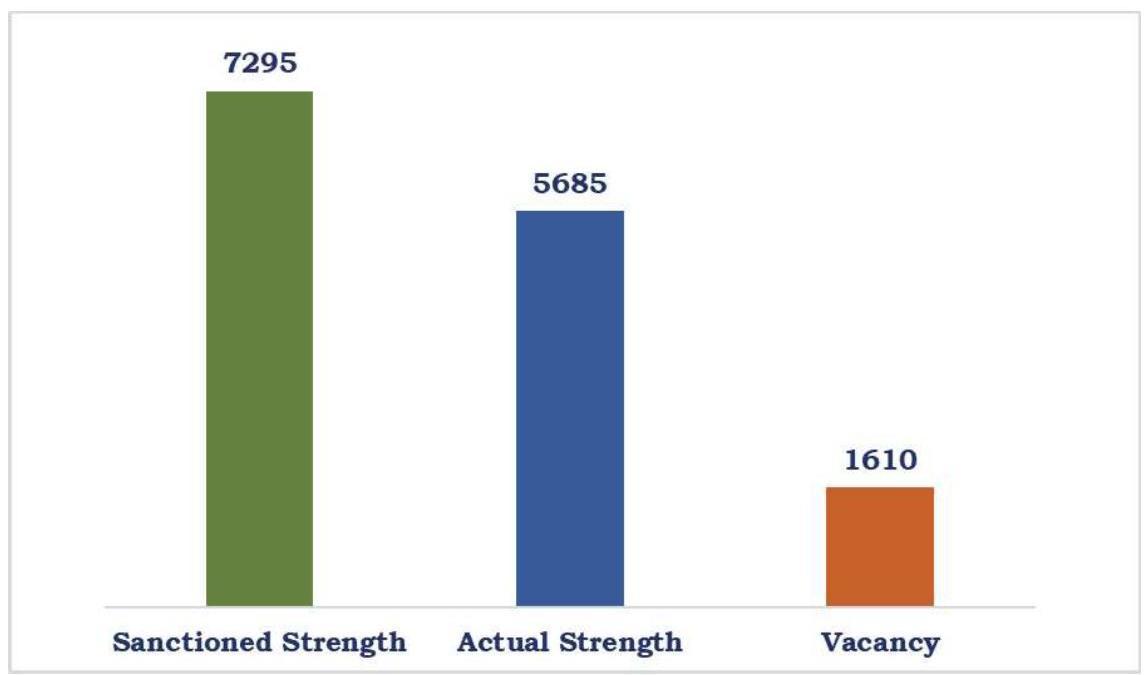
Induction
12.57 During the year 2023, total 543 Officers/Officials were inducted on deputation in CBI in different ranks comprising of Director (01), Joint Director (04), Director of Prosecution (01), Deputy Inspector General of Police (07), Superintendent of Police (07), Admin. Officer (01), Inspector [(State Police/CPOs/ other Central Govt. org./Bank Officer- (59)], Assistant SubInspector (01), Head Constable (2) and Constable (460).
Extension in Deputation Tenure
12.58 During the year 2023, deputation tenure of 155 personnel was extended in the different ranks comprising of Joint Director (07), Deputy Inspector General (08), SP (3), DSP (02), Inspector (34), Assistant Sub-Inspector (01), Head Constable (01) and Constable (99).
Direct Recruitment
12.59 During the year 2023, 106 Officers/Officials were recruited in different ranks under direct recruitment quota comprising of Public Prosecutor (07), Assistant Public Prosecutor (09), SubInspector (32), Junior Translation Officer (03), Lower Division Clerk (48) and MTS (07).
Compassionate Appointment
12.60 During the year 2023, 05 Officials were recruited in different ranks under direct recruitment quota comprising of Steno Grade-II (01), Lower Division Clerk (03) and MTS (01).
Departmental Promotion Committee
Promotion
12.61 During the year 2022, 57 meetings of DPCs/Review for Promotions of Executive and Ministerial Staff were held and 697 officers/ officials were promoted in different ranks comprising of DIG(01), Sr. SP (01), SP(17), ASP(28), DSP(56), Inspector (71), Sub-Inspector (29), ASI(99), Head Constable (192),ALA(05), DLA (04), Sr. PP (04), OS(06), CA(34), UDC (55), LDC (19), PPS(02), Sr.PS(01), PS (11), SG-I (48), PSA(01), SSA(01), Programmer (04), Asstt. Manager cum Store Keeper (01), Asstt. Halwai cum Cook (04), Clerk [Coupon Clerk/Salesman] (02) and Tea Coffee Maker (01).
Grant of MACP
12.62 During the year 2023, total MACP were granted to 418 Officers/Officials of different ranks comprising of Sr. SP (01), ASP(03), DSP(05), Inspector (34), SI (02), ASI (19), Head Constable (49), Constable (119), DLA (02), Programmer (03), Assistant Programmer (05), Data Entry Operator(01), ALIO (01), PS(01), SG-I(08), SG-II (54),CA (14), UDC (15), LDC (73), and MTS & Canteen Staff (09).
N. CRIME STATISTICS
Registration
12.63 Criminal Cases viz. Regular Cases (RCs) or Preliminary Enquiries (PEs) were registered by the CBI on the basis of references received from Government Departments, Statutory authorities like Central Vigilance Commission, Constitutional Courts (Hon’ble Supreme Court and High Courts) and references received from the State Governments and also on the basis of its own information. CBI is not the first responder and has limited manpower and resources. So, due care is taken to ensure that only good cases are registered.
12.64 During the year 2022, 876 Regular Cases/Preliminary Enquiries [RCs-768, PEs-108] were registered. Out of these 876 cases, 91 cases were taken up on the directions of the Constitutional Courts and 84 cases on the requests of State Governments/Union Territories. Other than these, 16 references received from Hon’ble Lokpal were taken up.
DISPOSAL FROM INVESTIGATION/ENQUIRY
12.65 The investigation in cases was expedited in the year 2023 and as a result, investigation was completed in 873 cases comprising of 755 Regular Cases (RCs) and 118 Preliminary Enquiries (PEs). The investigation is analyzed with the assistance of Law Officers so as to present
the best evidence in admissible form before the court of law. Other than these, 20 Lokpal references in form of Inquiry/Status Report filed were also completed.
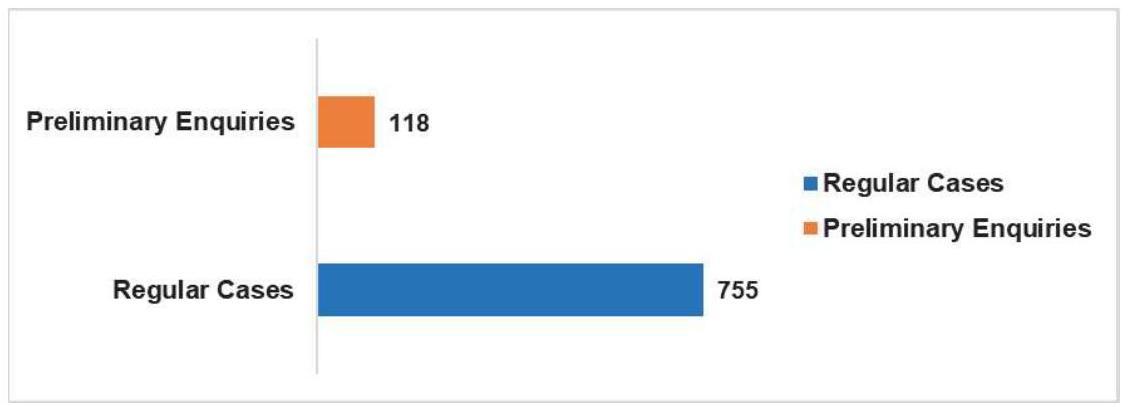
12.66 MODE OF DISPOSAL
12.66.1 Mode of disposal of RCs
Out of 755 Regular Cases [RCs], Prosecution, Prosecution & RDA was recommended in 642 cases, only RDA was recommended in 05 cases. The break-up of the disposal of 755 RCs from investigation, is depicted as under: –
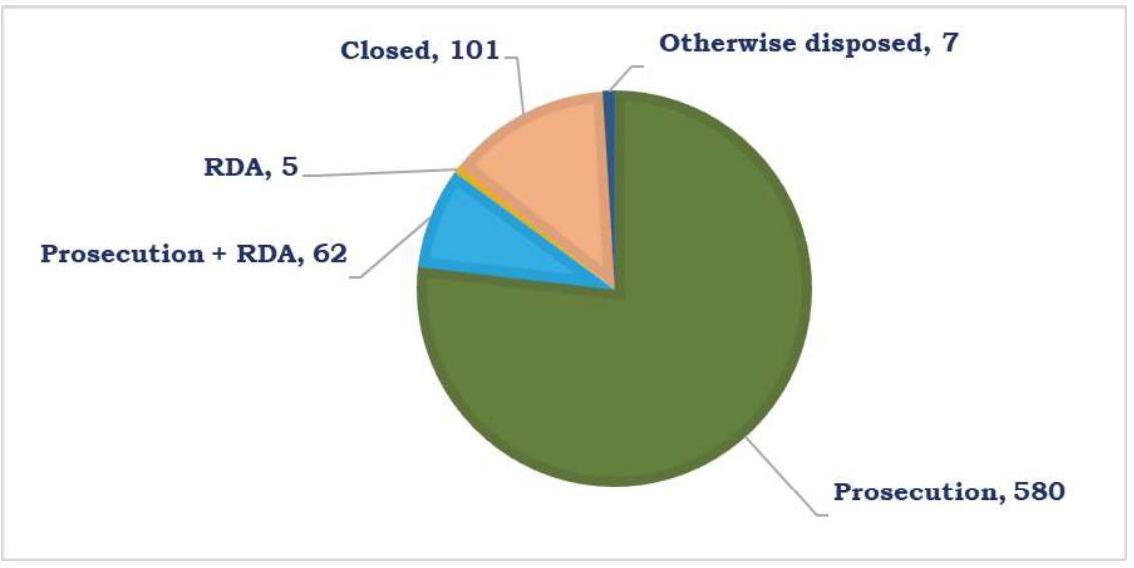
12.66.2 Mode of disposal of PEs
Out of 118 PEs, 42 PEs were converted into Regular Cases (RCs) and RDA was recommended in 04 PEs. The break-up of the disposal of 118 Preliminary Enquiries (PEs), is depicted as under:-
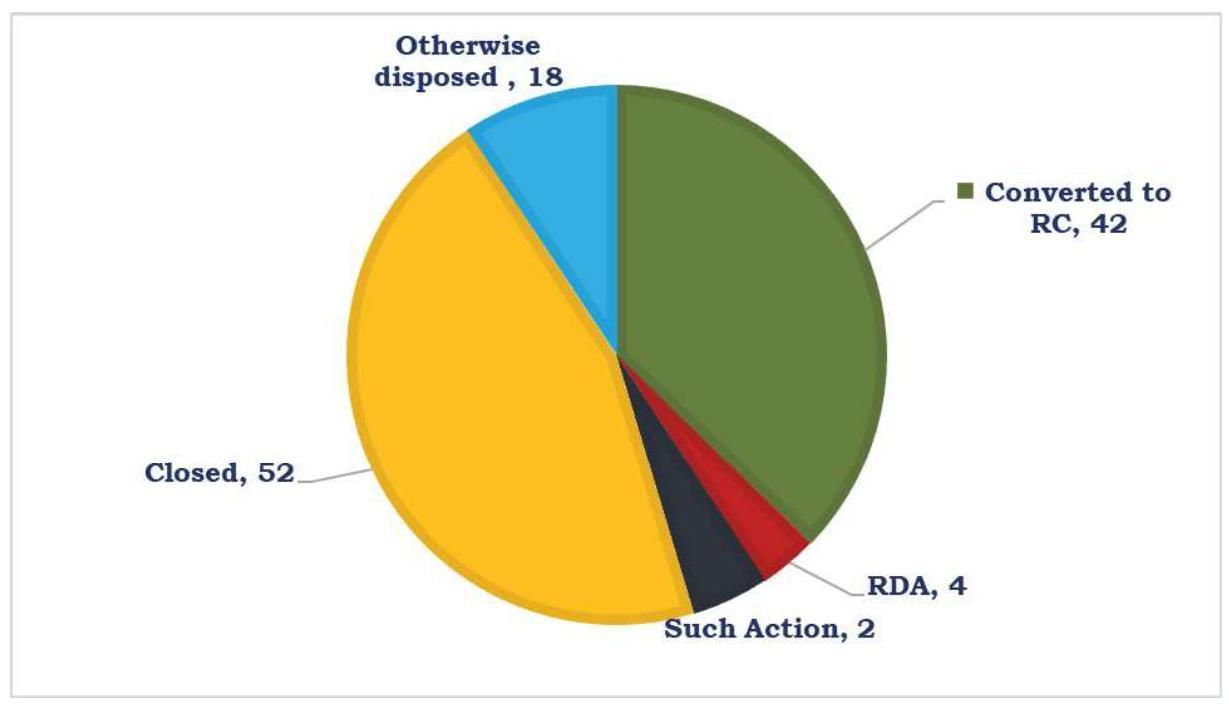
12.67 CASES PENDING UNDER INVESTIGATION/ENQUIRY
A total number of 1028 of cases (RCs 956, PEs 72) were pending under investigation/ enquiry at the end of the year. Other than this, 19 Lokpal references were pending at the end of year. Out of 956 RCs, 510 RCs were pending under investigation for more than one year. Similarly, out of 72 PEs, 58 PEs were pending under enquiry for more than three months.
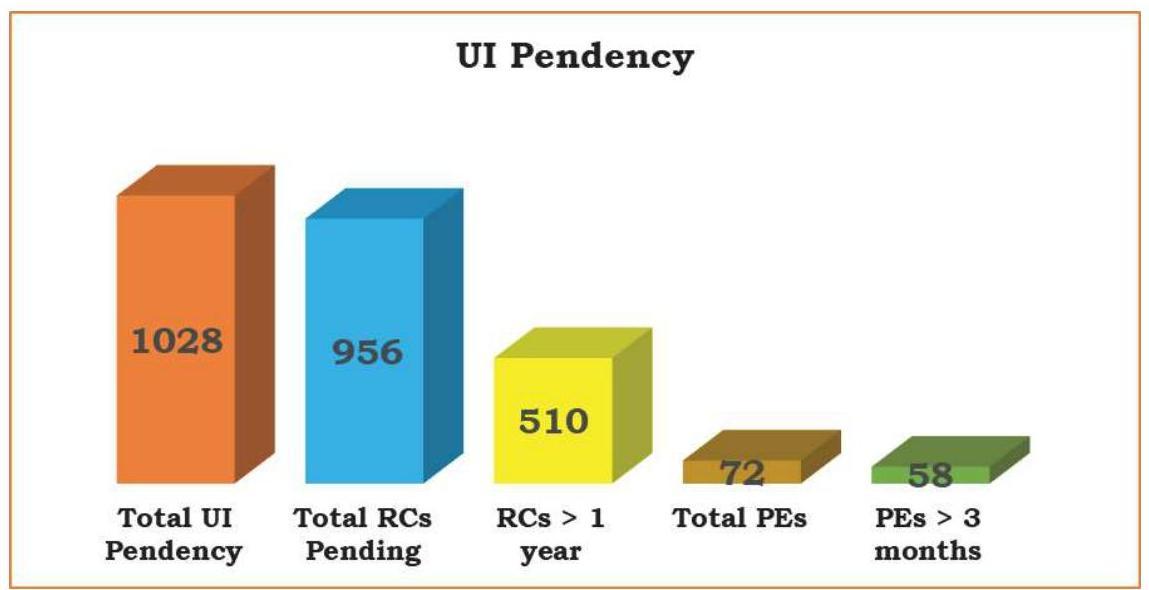
12.68 TRIAL
During the year 2023, Courts delivered Judgements in 636 Court Cases of CBI. Out of these, 411 cases resulted in Conviction, 140 in Acquittal, 24 in Discharge and 61 cases were disposed of for other reasons. The conviction rate was $71.47 %$.
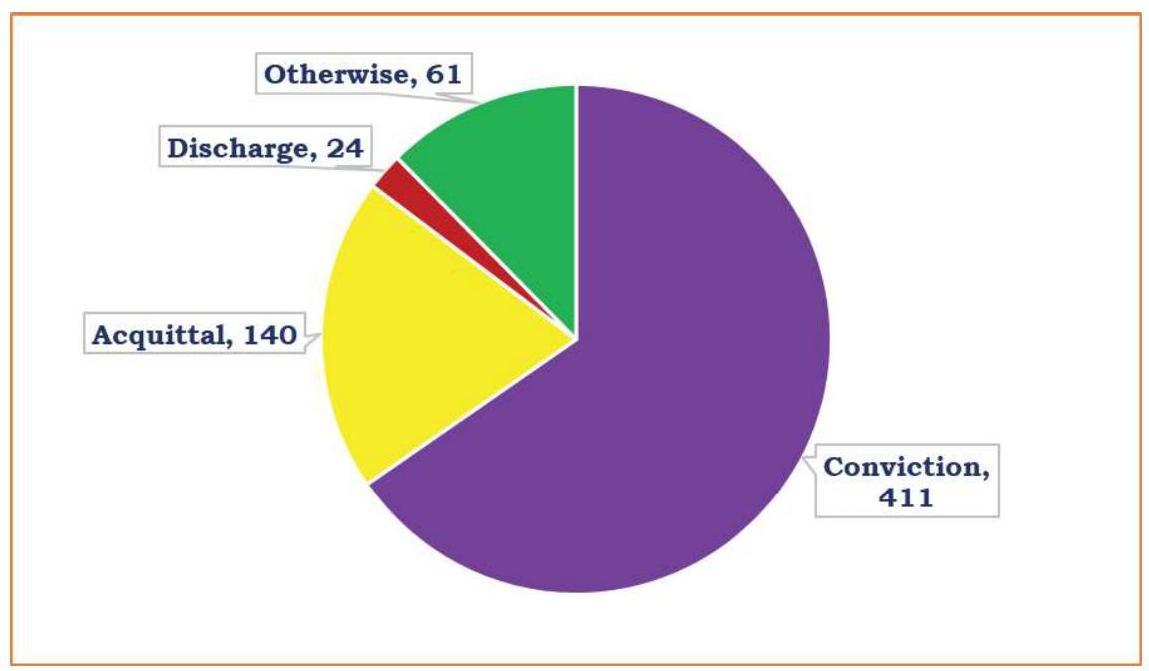
A total number of 10959 Court Cases were pending under trial in various Courts as on 31.12.2023.
O. COORDINATION
Coordination with Law Enforcement/State/Union Territory
12.69 CBI plays a key role in facilitating improved coordination between State/UT Police agencies. Tackling interstate crimes and organized crime requires enhanced coordination, information exchange and communication between police agencies across the country. CBI has been active in providing common platform for bringing together police professionals from across the country. Going forward, CBI strives to create more robust and institutionalized platforms for enhanced interstate coordination among police agencies.
VISIT OF MR. CYRIL GOUT, DIRECTOR, OPERATION SUPPORT AND ANALYSIS DIRECTORATE, IPSG
12.70 Mr. Cyril Gout, Director, OSAD, IPSG visited India and attended the inauguration Programme held on 3rd April, 2023 of Diamond Jubilee celebration of CBI. He also participated as speaker in one of the sessions.
VISIT OF MR. RAYMOND DUDA, ASSISTANT DIRECTOR- INTERNATIONAL OPERATIONS DIVISION, FBI
12.71 Assistant Director – International Operations Division, FBI visited CBI, Headquarters, New Delhi on 17th April, 2023 for meeting – strengthening cooperation between CBI and FBI in criminal matters.
VISIT OF RUSSIAN DELEGATION
12.72 A Russian delegation consisting of Mr. Pavel Khalashnyuk, Police Liaison Officer, Embassy of Russia, New Delhi, Mr. Gorokhov Dmitry, Deputy Chief of Main Directorate of Internal Security of the Russian MOIA, Mr. Yaremchuk Dmitry, Acting Deputy Chief of Information & Analytical Division of the Main Directorate of Internal Security of the Russian MOIA) and Mr. Chernyak Grigory, Deputy Chief of State and Anti- Terrorist Protection Division of the Main Directorate of Internal Security of the Russian MOIA, has visited CBI, Headquarters, New Delhi and Global Operations Centre on 16th May, 2023.
VISIT OF OFFICERS FROM ACC, MALDIVES
12.73 A session was conducted on “Investigation Abroad-need in an interconnected world” for the twenty-nine Officers of Anti-Corruption Commission of Maldives at Civil Services Officers’ Institute, New Delhi on 20th July, 2023.
VISIT OF MAURITIUS DELEGATION HEADED BY THE DIRECTOR GENERAL OF ICAC MAURITIUS
12.74 A Mauritian delegation headed by Director-General of Independent Commission against Corruption (ICAC) Dr. Navin Beekarry visited CBI, Headquarters, New Delhi on 7th August, 2023.
During the visit, discussion was held to strengthen mutual cooperation in anti-corruption matters, capacity building and possibility for a MoU between CBI and ICAC. Delegation also visited Global Operations Centre of IPCU, CBI, Headquarters, New Delhi.
VISIT OF MR. TOM TUGENDHAT, MINISTER OF STATE FOR SECURITY OF THE UNITED KINGDOM
12.75 A UK delegation headed by Mr. Tom Tugendhat, Minister of State for Security of the United Kingdom visited Director, CBI on 11th August, 2023. The UK delegation included Mr. Alex Ellis, UK High Commissioner to India, Mr. Robert Holness, UKK PLO and NCA representative in India and Mr. Adam Gardner, Special Advisor.
12.76 During the visit, discussion was held for strengthening cooperation in areas of combating Child Sexual Abuse and Exploitation, Financial Crimes and frauds, transnational crimes, Cyber Crimes etc. The delegation also visited Global Operations Centre of IPCU, CBI, Headquarters, New Delhi.
VISIT OF 25 FOREIGN PARTICIPANTS
12.77 A delegation consisting of 25 participants from foreign law enforcement agencies visited Global Operations Centre at IPCU, CBI, Headquarters, New Delhi on 25th August, 2023. Sessions on Functioning of INTERPOL, Investigation abroad, Extradition process, and INTERPOL Notices, etc. have been delivered to these participants.
VISIT OF MR. PEKKA SALONEN POLICE LIAISON OFFICER, EMBASSY OF FINLAND, NEW DELHI
12.78 Mr. Pekka Salonen Police Liaison Officer Finland/FIN Border Police Roving LO to Asia, Embassy of Finland, New Delhi has visited IPCU, CBI, New Delhi on 30.08.2023. The meeting
included discussions on strengthening cooperation between the two countries in criminal matters especially in areas of – Human Trafficking, Fake/falsified documents, cheating by travel agents etc.
VISIT OF CHILEAN DELEGATION
12.79 A workshop was organized by Narcotics Control Bureau for a Chilean Participants on 14th-15th September, 2023. A Delegation of Chilean participants consisting of Mr. Fernando Contrado Jarpa, Deputy Chief of the Mission, Embassy of the Republic of Chile in India, Mr. Andres Rios Quiroz, Prefect, Police Attache PDI, Embassy of Chile in India, Mr. Marcelo Atala Munoz, Prefect, Head of the North Antinarcotics & Organised Crime Prefecture-PDI, Mrs. Francisa Munoz Soto, Deputy Commissioner National Antinarcotics Headquarters PDI and Mrs. Sulagna Pal, Translator, visited CBI, Head Quarters, New Delhi on 15th September, 2023.
VISIT OF FBI DELEGATION
12.80 On 10th October, 2023, FBI delegation including (i) Mr. Suhel Daud, Legal Attaché, Federal Bureau of Investigation, United States Embassy, New Delhi and (ii) Ms. Lovjit M. Curran, Assistant Legal Attaché visited CBI Headquarters, New Delhi. It was discussed to improve cooperation in combating crime and sharing of criminal intelligence.
VISIT OF EUROPEAN UNION DELEGATION
12.81 European Union delegation comprising Mr. Johannes Luchner, Deputy Director-General for Migration, European Commission \& Ms. Veronila Liskova, Second Secretary, Delegation of EU to India have visited CBI Headquarters, New Delhi.
12.82 Discussions were held regarding the status of proposed CBI-EUROPOL Working Arrangement and enhancing cooperation with human trafficking unit of CBI in combating instances of trafficking.
VISIT BY DIRECTOR, FEDERAL BUREAU OF INVESTIGATION [FBI]
12.83 A high-level Delegation led by Mr. Christopher A Wray, Director, FBI visited CBI Headquarters, New Delhi on 11th December, 2023. During the visit, FBI, Director held discussions with Shri Praveen Sood, Director, CBI, and senior officers of CBI.
$91^{\text {ST }}$ INTERPOL GENERAL ASSEMBLY HELD IN VIENNA, AUSTRIA
12.84 A delegation from India to Vienna, Austria attended the annual INTERPOL General Assembly, the largest gathering of Senior Law Enforcement officials in the world. This year’s General Assembly also marks the 100th anniversary of INTERPOL and returns to the city where the organization was founded a century ago. The five-member delegation from India was led by Director CBI Shri Praveen Sood and included Shri Dinkar Gupta, Director General of National Investigation Agency.
12.85 The Indian delegation held discussions with law enforcement agencies from multiple countries for enhanced coordination via INTERPOL channels with a view for concerted action to combat organized crime, terrorism, drug trafficking, money laundering, online radicalisation, cyber enabled financial crimes and to prevent these crimes on a real-time basis.
12.86 India has stressed the need to deny any safe havens for crime, criminals, and proceeds of crimes. The need for coordinated strategies to curtail criminal organisations which operate across international jurisdictions was deliberated.
12.87 The Indian delegation has held detailed discussions on matters of police cooperation with high level delegations of Austria, UAE, USA, UK, Nepal, Brazil, Australia, Mauritius, New Zealand, Japan, Switzerland, Bangladesh, Singapore, and Zambia. Discussions were held for better sharing of criminal information via INTERPOL channels, to expedite mutual legal assistance and extradition requests.
12.88 India also supported adoption of INTERPOL’s Vision 2030 and creation of Interpol Future Council. Indian delegation has also held discussions with senior officials of Interpol, Europol, Pacific Islands Chiefs of Police Organisation and US Air Force Office of Special Investigations on strengthening arrangements for cooperation.
G20 CONFERENCE ON CRIME AND SECURITY IN THE AGE OF NFTS, ARTIFICIAL INTELLIGENCE AND METAVERSE
12.89 With the advent of new technologies and to address the unprecedented challenges posed by emerging technologies viz. NFTs, AI, and Meta-verse, a brain storming session under G-20 conference on Crime and Security was held in India in 2023 where global leaders converged for deliberation. The Conference was organized by Ministry of Home Affairs in collaboration with the Ministry of Electronics and Information Technology, Ministry of External Affairs, Central Bureau of Investigation, Intelligence Bureau, and Interpol. The main aim of the Conference was to foster international cooperation in combating cybercrime, financial fraud, and security threats in a world increasingly dominated by cutting edge technologies viz. non-fungible tokens (NFTs), artificial intelligence (AI), and the rapidly evolving Metaverse.
12.90 Representatives from G-20 nations gathered to deliberate on the multifaceted impact of these emerging technologies on global security. The conference facilitated a comprehensive discussion on the potential threats emanating from these technologies, ranging from cybercrime and financial fraud associated with NFTs to the security implications of AI applications and the complexities introduced by the Metaverse.
12.91 There was a collaborative effort of the participating members for highlighting the need for a coordinated, cross-border approach to tackle emerging forms of crime. The conference served as a platform for knowledge exchange, fostering a deeper understanding of the challenges ahead and laying the groundwork for collaborative strategies to ensure the safety and security of nations in the rapidly advancing digital landscape.
12.92 India, as the host nation, played a pivotal role in steering the discussions towards practical solutions and establishing frameworks for international collaboration in law enforcement and cybersecurity. The G-20 members recognized the urgency of adapting legal and regulatory frameworks to address the unique challenges presented by these technological advancements, underscoring the importance of shared responsibility in maintaining global security in the digital age.
ONGOING REVIEW BY FINANCIAL ACTION TASK FORCE (FATF)
12.93 This year India is being reviewed by the Financial Action Task Force (FATF) which is an independent inter-governmental body that develops and promotes policies to protect the global financial system against money laundering, terrorist financing and the financing of proliferation
of weapons of mass destruction. India’s FATF review, the Assessment Team visited the country during 06.11.2023 to 24.11.2023.
12.94 CBI along with other agencies viz. ED, NIA, IB, MHA, CBDT, RBI etc. were closely associated during the assessment/ review and prior preparations. CBI made vital contribution in preparation of Technical Compliance Report and Effective Annexure of India to the FATF submitted in the month of May, 2023 and July, 2023 respectively. As member of the Joint Working Group, CBI was involved in the risk assessment related to Money Laundering and Terrorist Financing.
12.95 Given the global nature of financial crimes and interconnectedness of financial systems, effective collaboration between investigative agencies across borders is essential for combating money laundering and terrorist financing. CBI, being National Central Bureau for INTERPOL in India, provided comprehensive insights into the Standard Operating Procedures adopted for effective international cooperation for combating illicit financial activities globally.
12.96 As the organization investigates complex financial crimes and tracks illicit financial flows, its seamless cooperation with FIU was also highlighted during the review.
12.97 CBI shared information/data and case studies for demonstrating the synergy between various Law enforcement agencies and effectiveness of India’s financial regulatory framework.
12.98 During the On-site visit of the FATF Assessment Team, CBI had given efficacious inputs and case studies for presentations especially on ‘Anti-Corruption Measures of the country’, ‘functioning of Central Authorities for Mutual Legal Assistance and International Cooperation’ and ‘Access to Beneficial Ownership Information’.
12.99 LETTERS ROGATORY (OUTGOING)
During the year 2023, 44 Letters Rogatory (LRs) were sent abroad, out of which, 24 LRs pertain to CBI cases and 20 pertain to State Law Enforcement and Central Law Enforcement agencies. It was confirmed by Indian Law Enforcement Agencies including CBI that 20 LRs are fully executed. These 20 LRs include 07 LRs of CBI and 13 LRs of State Police and other Law Enforcement Agencies. During 2022, 7 LRs were also treated as closed/ withdrawn.
As on 31.12.2023, a total of 562 LRs are pending with other countries out of which 315 pertain to CBI cases and 247 pertain to State Police and other Central Law Enforcement Agencies.
Further in the year 2022, for the purpose of sending/executing LR/MLA, the Ministry of Home Affairs has developed a portal which is available at the URL: https://mlat.mha.gov.in w.e.f. $1^{\text {st }}$ December, 2022.
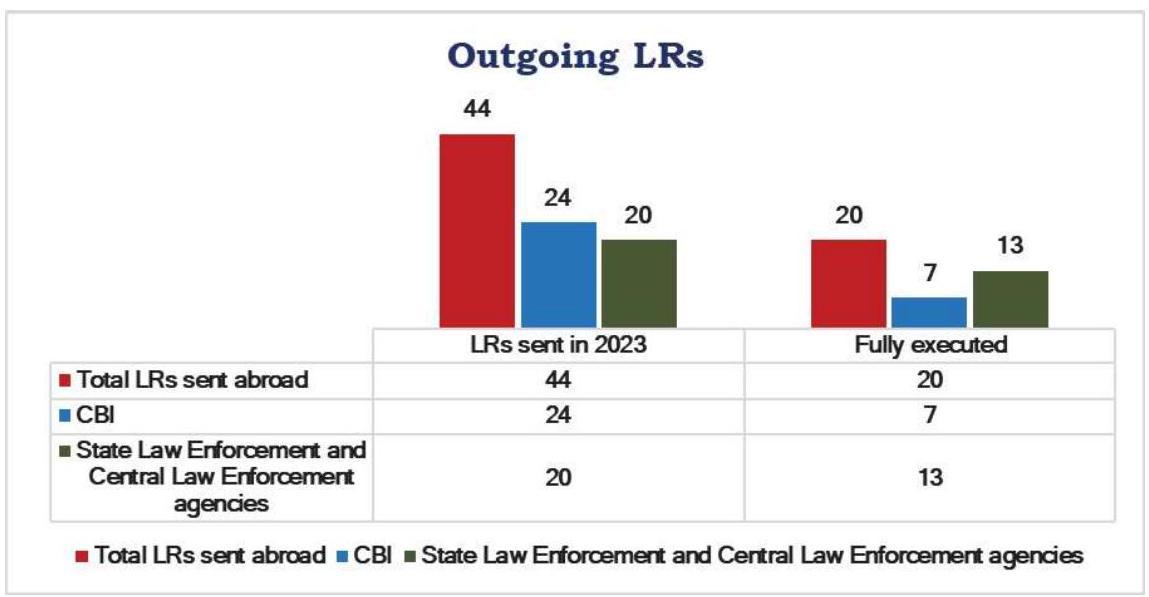
12.100 LETTERS ROGATORY (INCOMING)
During the year 2023, as many as 33 Letters Rogatory (LRs)/Treaty Based Requests were received from various countries requesting to provide assistance in the investigation of criminal matters. Besides these, 06 LRs/MLA requests were received as Addl./Supplementary requests. Execution Reports in 84 cases were sent to MEA/ MHA, after receiving the same from Indian Investigating Agencies, for onward transmission to the law enforcement agencies of the requesting countries. Besides these, 22 LRs/ MLA requests were otherwise disposed off as closed or withdrawn. As on 31.12.2023, 76 LRs/ MLA Requests are pending for execution.
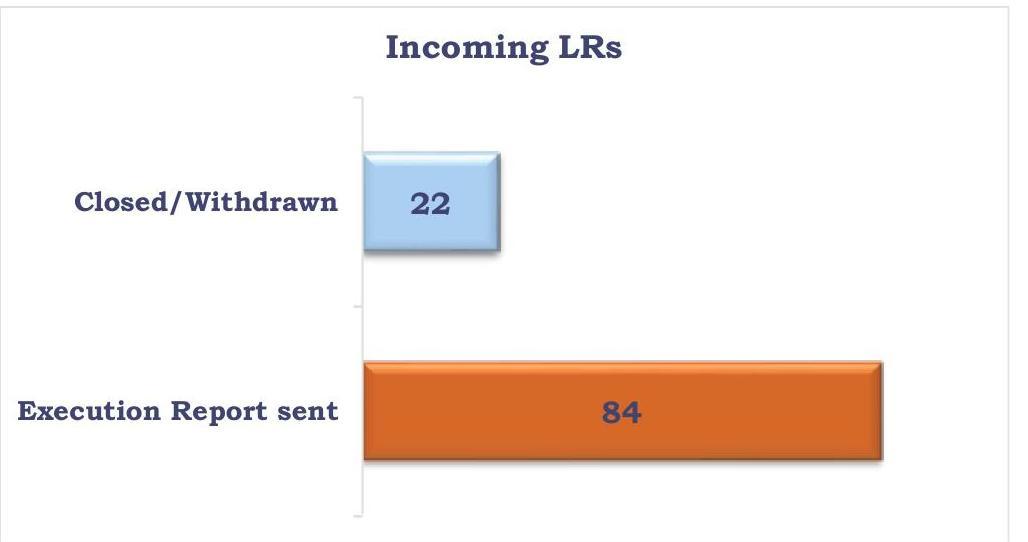
P. INTERPOL NOTICES
12.101 During 2023, notices as per details below, were published by NCB-India:-
| Red Notices | 100 |
|---|---|
| Blue Notices | 58 |
| Yellow Notices | 11 |
| Black Notices | 11 |
| Purple Notices | 02 |
| Green Notices | 01 |
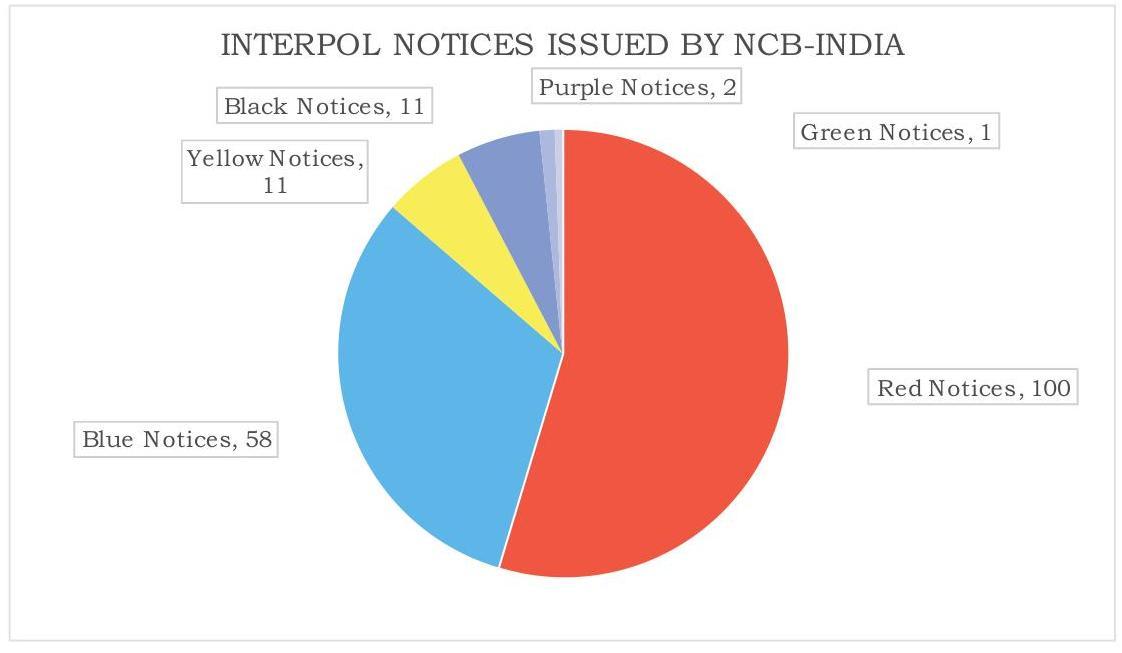
Extradition / Deportation
12.102 The following numbers of fugitives were extradited/ deported/ arrested/ located: –
| Wanted Persons/Fugitives wanted by India located abroad | $\mathbf{3 0}$ |
|---|---|
| Wanted Persons/Fugitives wanted by other countries, detected/ located in India |
$\mathbf{2 2 5}$ |
| Wanted Persons/Fugitives returned to India from abroad/arrested/ located in India on the basis of LoC |
$\mathbf{2 9}$ |
Interpol Stolen and Lost Travel Documents (SLTD) Database
12.103 NCB, India has uploaded data relating to lost/stolen/revoked Indian passports into the INTERPOL SLTD Database being maintained by IPCU Branch. Till 31.12.2023, data of 2403834 Stolen/Lost/Revoked Indian Passports has been uploaded in the SLTD Database. Upto 31.12.2022, 1363 cases of use of STLD recorded Indian passports have been reported/detected by various other NCBs.
Interpol Global Communication System [IGCS] Messages Received During 2023
12.104 The five Regional Desks received 17368 requests/IGCS message/ letters from January 2023 to December 2023 from various NCBs, PLOs and Indian Law Enforcement agencies/authorities regarding various matters on police-to-police cooperation basis. The five regional desks of NCB-India also worked in close coordination with other NCBs and rendered necessary guidance to them on various issues.
FOREIGN TERRORIST FIGHTERS (FTF)
12.105 INTERPOL maintains a database of suspected foreign terrorist fighters. Data is analysed and insights are shared with INTERPOL’s membership, for example, intelligence on the capabilities, means and emerging trends of foreign terrorist fighters. All FTFs Inputs/reports, as received from INTERPOL’s Counter Terrorist/ Terrorist Networks Sub-Directorate, are
forwarded to the MAC & NIA for further necessary action as deemed appropriate. During 2023, 128 such reports have been shared.
Q. CAPACITY BUILDING
12.106 In the year 2023, CBI Academy and the three Regional Training Centres (functioning at Kolkata, Mumbai and Chennai) conducted a total of 178 courses and trained 7339 Officers/Officials.
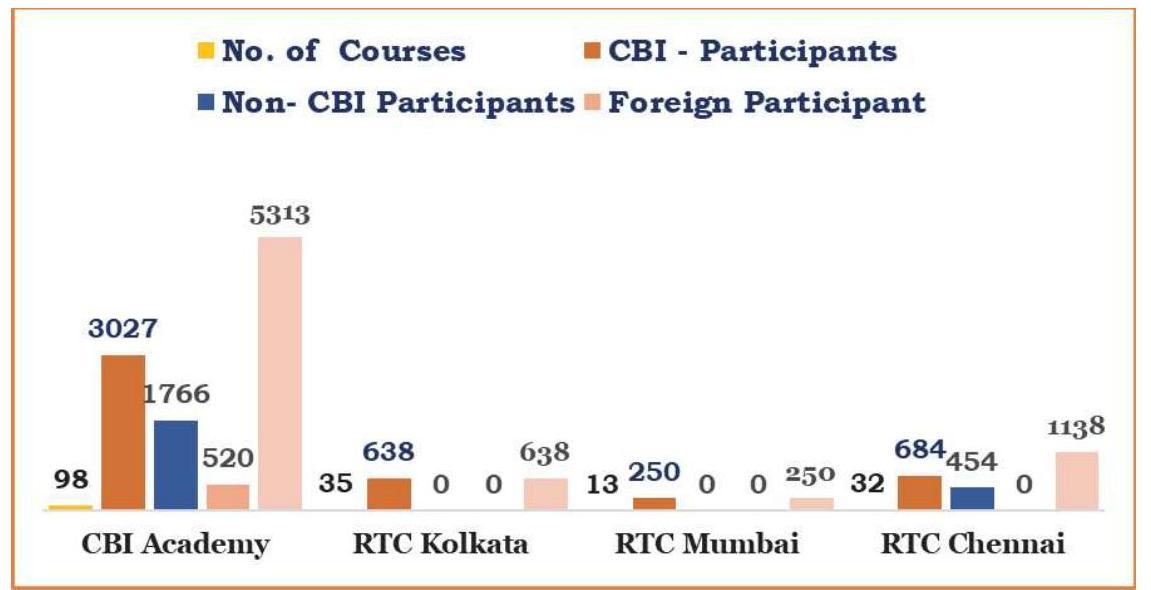
Rank/Organisation wise Break-up of the Participants
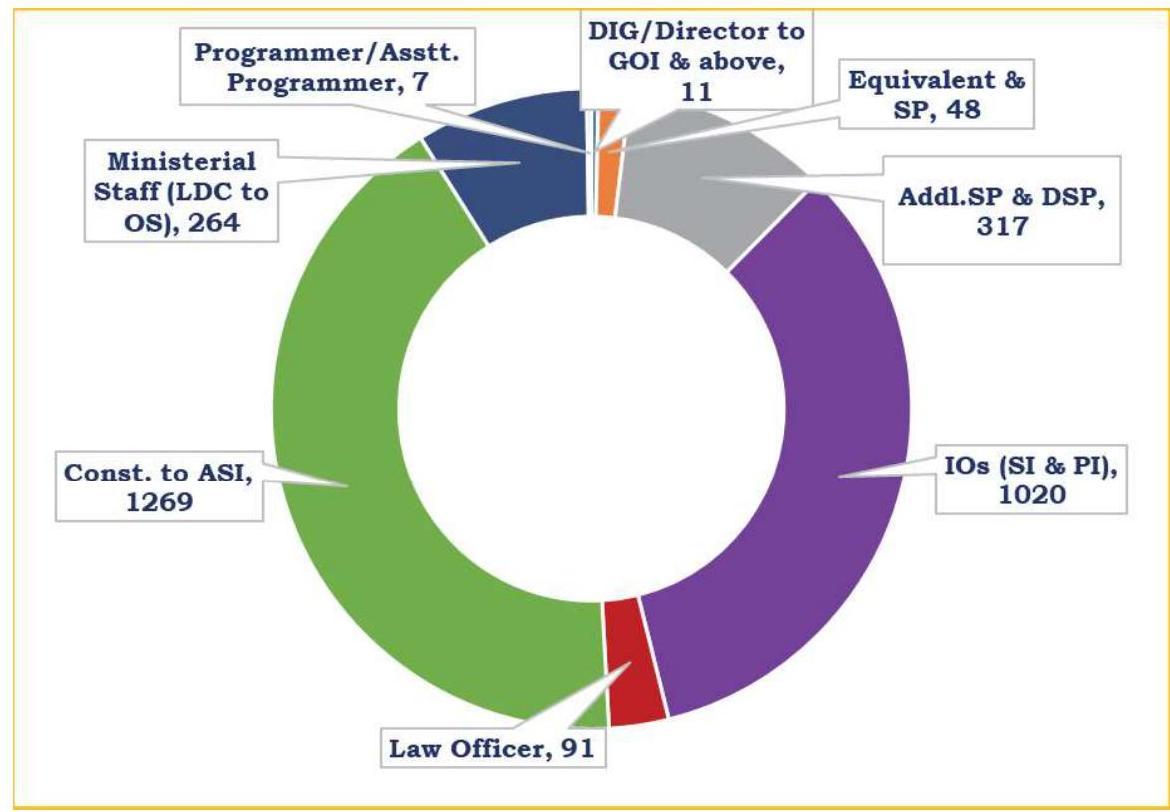
12.107 Specific courses conducted for CBI officers
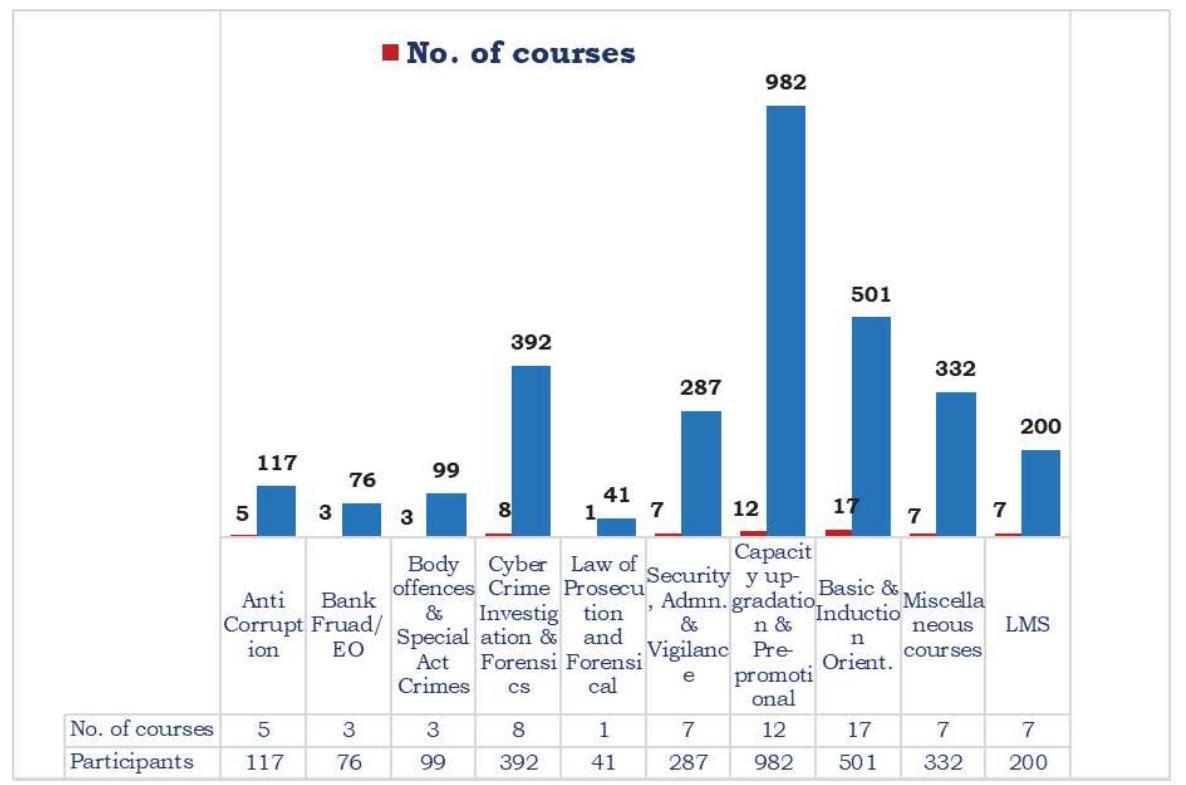
12.108 TRAINING TO STATE POLICE AND OTHER ORGANIZATIONS
These courses were conducted exclusively for the requesting organization or police agency. Some of these were:-
$>07$ Training courses for Inquiry/ Presenting officers under the jurisdiction of the CVC, 184 participants attended from various department of Govt. of India.
$>04$ Training Courses on Vigilance Administration for Senior Vigilance Officers of Govt. Departments, 120 participants attended participants from various department of Govt. of India.
Vigilance & Anti-Corruption for Vigilance Officers of CRPF, 40 participants attended.
$>02$ Visit of Officers Trainees of IPS of RR $74 \& 75$ attending attachment with CBI, 323 IPS Probationers attended.
Vigilance Course for officers of Central Bank of India Vigilance, 41 participants attended.
Visit of IDAS Officers, 06 participants attended.
Appreciation Course for IRTS Probationary officers, 30 participants attended.
Visit of BSF Officers, 41 participants attended.
One day educational visit of officers of Indian Postal Service, 11 participants attended.
Specialized Training of Detective Sub-Inspector of Karnataka CID, 03 participants attended.
Visits of UP Police DSP (Probationers), PTC, Moradabad, 17 participants attended.
Training Course on Special Crime Cases & NDPS Act for J\&K Police, 28 participants attended.
R. AWARDS AND ACCOLADES TO CBI OFFICERS DURING 2022
12.109 PRESIDENT’S POLICE MEDAL \& POLICE MEDAL
During the year 2023, twelve [12] officers of Central Bureau of Investigation were awarded President’s Police Medals (PPM) for Distinguished Services and and thirty eight [38] officers of Central Bureau of Investigation were awarded Police Medal (PM) for Meritorious Services on the occasions of the Republic Day, 2023 and the Independence Day, 2023.
12.110 UNION HOME MINISTER’S MEDAL FOR EXCELLENCE IN INVESTIGATION AWARDED TO CBI PERSONNEL
During the year 2023, fifteen [15] officers were awarded Union Home Minister’s Medal for Excellence in Investigation for the year, 2023.
12.111 ASADHARAN AASUCHANA KUSALATA PADAK
During the year 2023, three [03] officers were awarded ‘Asadharan Aasuchana Kusalata Padak’ for exceptional courage and skill in intelligence service.
12.112 CBI GOLD MEDAL FOR BEST INVESTIGATING OFFICER FOR THE YEAR 2021
During the year 2023, one [01] officer was awarded ‘CBI Gold Medal for Best Investigating Officers’ for the year 2021.
12.113 CBI GOLD MEDAL FOR BEST PROSECUTING OFFICER FOR THE YEAR 2019, 2020 \& 2021
During the year 2023, three [03] officer was awarded ‘CBI Gold Medal for Best Investigating Officers’ for the year 2019, 2020 \& 2021 respectively.
S. FUTURE ROADMAP
12.114 Perspective Future Plan
CBI strives for excellence in investigation and prosecution of offences by bench marking its standards with the best law enforcement institutions in the world. Accordingly, there is a constant endeavor to understand the changes in national and global scenario and assimilate them through identified perspective plans.
Bureau has been designated as nodal agency for the Government of India to investigate computerrelated offenses. Over a period, CBI has significantly fortified its capabilities in cybercrime investigation and intends to: –
Establish a dedicated Cyber Crime Zone within the CBI, encompassing specialized Cyber Crime Investigation Branches/ Units across the country with specific focus on
Cyber-crimes involving Central Government Institutions/Personnel including attacks on India’s Critical Infrastructure.
Investigate the organised cyber-enabled crimes having international implications.
Investigate complex cyber-dependent crimes especially, concerning to dark web, ransomware attacks, and cases involving cryptocurrency.
Prepare itself to handle future challenges that would arise in investigation of Metaverse and NFTs.
Need to leverage and deploy advances in Artificial Intelligence [AI], machine learning and big data analytics for enabling real time detection, prevention, and mitigation of cyber-crimes.
The ongoing negotiations for drafting UN Convention on countering the use of ICT for criminal purposes is at the concluding stages. Once adopted, the central authority under the convention would need an investigation agency to carry out its obligations under the convention. CBI is prepared to take on this additional responsibility, especially since it has been doing similar work as Indian arm of INTERPOL as well as under the UNCAC.
Besides, CBI aims to furnish actionable financial intelligence to India’s Law Enforcement Agencies, including the FIU IND, using AI/ML based data mining techniques.
CHAPTER 13
JOINT CONSULTATIVE MACHINERY
13.0 The Scheme for Joint Consultative and Compulsory Arbitration for the Central Government Employees was introduced in the year 1966 on the lines of the Whitely Councils in the U.K. The scheme provides a platform for constructive dialogue & discussion between the representatives of the staff side and the official side for peaceful resolution of all disputes between the Government as employer and the employees. The scheme was introduced with the objectives of promoting harmonious relations and securing the greatest measure of cooperation between the Central Government as the employer and the employees in matters of common concern and further increasing the efficiency of the public service combined with the well-being of those employed.
13.1 The JCM Scheme provides for three-tier machinery:
i. The National Council as the apex body; (chaired by the Cabinet Secretary);
ii. Departmental Councils at the level of individual Ministries / Departments including their attached and subordinate offices and (chaired by respective Secretaries); and
iii. Regional / Office Councils to deal with mainly the local problems at the level of each individual office, depending on its structure. (Chaired by Head of office of respective organizations).
13.2 The scope of the JCM Scheme includes all matters relating to:
conditions of service and work;
the welfare of the employees; and
improvement of efficiency and standards of work,
Provided, however that in regard to recruitment, promotion and discipline, consultation is limited to matters of general principles only and individual cases are not considered.
13.3 National Council (JCM)
The National Council is the apex body under JCM, Chaired by the Cabinet Secretary. It comprises members both from staff side and official side. The official side of the National Council consists of 25 members and the staff side consists of 60 members National Council may have two Standing Committees; i) for the Non- Industrial employees, ii) Industrial employees. So far, 48 meetings of the National Council (JCM) have been held since its inception in 1966.
13.4 Standing Committee Meeting of the National Council (JCM):
Standing Committee meeting of the National Council (JCM) was held on $20^{\text {th }}$ September, 2023 under the Chairpersonship of the Secretary, DoPT. In the meeting 13 Agenda Items were deliberated upon.
Departmental Council
13.5 Functioning of the Departmental Council which is a vital part of the Joint Consultative Machinery formed with the very important purpose of promotion of harmonious relations and ensuring cooperation between Government and its employees.
13.6 This division is concerned with the recognition of Service Associations formed by employees of different services working in Central Secretariat. At present, process of recognition of Service Associations is in under consideration.
13.7 ARBITRATION
An important feature of the JCM Scheme is the provision for arbitration in cases where there is no agreement between the Official Side and the Staff Side on matters relating to: –
pay and allowances;
weekly hours of work; and
leave, for a class or grade of employees.
13.8 BOARD OF ARBITRATION (BOA)
A Board of Arbitration (BOA) comprising three Members; a Chairman (an independent person) and two Members, nominated, (one each by Staff Side and Official Side), functions under the administrative control of the Ministry of Labour & Employment. Award of the Board of Arbitration is binding on both sides, subject to the over-riding authority of Parliament to modify or reject the Award.
CHAPTER 14
ADMINISTRATIVE TRIBUNALS
14.0 The Administrative Tribunals Act, 1985 owes its origin to Article 323-A of the Constitution of India which empowers Central Government to set up Administrative Tribunals by an Act of Parliament for adjudication of grievances and disputes arising out of the conditions of service of an employee appointed to the public services and posts in connection with the affairs of the Union and the States. In pursuance of the provisions contained in the Administrative Tribunals Act, 1985, the Administrative Tribunals, set up under it, exercise original jurisdiction in respect of service matters of employees covered by the Act. As a result of the Supreme Court’s judgment dated 18.03.1997 in the case of L. Chandra Kumar & Others Vs UOI, the appeals against the orders of an Administrative Tribunal shall lie before the Division Bench of the concerned High Court.
14.1 The Administrative Tribunals are distinguishable from the ordinary courts with regard to their jurisdiction and procedure. They exercise jurisdiction only in relation to the service matters of the litigants covered by the Act. They are also free from many of the procedural technicalities of the ordinary courts. The procedural simplicity of the Act can be appreciated from the fact that the aggrieved person can also appear before it personally. Government can also present its cases through its departmental officers or legal practitioners. Further, only an affordable and nominal fee of $₹ 50$ is to be paid by the applicants for filing the original application before the Tribunal. Thus, the objective of the Tribunal is to provide speedy and affordable redress to the aggrieved applicants arising out of employment or conditions of service.
14.2 The Central Administrative Tribunal was set up on 01.11.1985. As on date, it has 19 regular Benches, 17 of which operate at the principal seats of High Courts and the remaining two at Jaipur and Lucknow. A statement showing the location of Central Administrative Tribunal Benches, the dates of their establishment and the number of courts in each of these Benches along with a list of places where they hold Circuit Sittings is given in Appendix-I.
14.3 The Tribunal consists of a Chairman and Members. It has also been the constant endeavour of this Ministry to ensure that the posts of Chairman and Members are filled up well in time and no post remains vacant for long time. The Members of Central Administrative Tribunal (CAT) and State Administrative Tribunals (SATs) are drawn from judicial as well as administrative streams, so as to give the Tribunal the benefit of domain expertise both in legal and service matters. The sanctioned strength of Members of Central Administrative Tribunal is 70 (including Chairman, CAT), out of which 35 are Judicial Members and 35 are Administrative Members. As per Tribunals Reforms Act, 2021, the Chairman can be a Judicial Member or an Administrative Member.
14.4 The appointment of Members in CAT is made on the basis of the recommendations of a Search-cum-Selection Committee (ScSC) chaired by Chief Justice of India or a sitting Judge of Supreme Court (nominated by the Chief Justice of India). After receipt of recommendations of ScSC, appointments are made with the approval of Appointments Committee of the Cabinet (ACC).
14.5 State Administrative Tribunals (SATs) were also set up in the following States:
i. Karnataka
ii. Maharashtra
iii. West Bengal
iv. Kerala
v. Haryana (not functional)
14.6 The appointments to the vacancies in SATs are made on the basis of proposals sent by the State Governments. Thereafter, their appointments undergo the same process as the one in respect of Central Administrative Tribunal.
14.7 Since its inception in 1985 and upto 31.03.2023, the Central Administrative Tribunal received $9,28,757$ cases for adjudication (including those transferred from High Courts), out of which $8,57,151$ cases have been disposed of, leaving a pendency of 71,606 cases. On an average, about $92 %$ of the cases instituted are disposed of. A statement indicating the institution, disposal and pendency of cases since inception of CAT is at Appendix-II.
14.8 Section 14(2) of the Administrative Tribunals Act, 1985 empowers the Central Government to extend the provisions of the Act to local or other authorities within the territory of India or under the control of Government of India and to Corporations or Societies owned or controlled by Government of India. In exercise of these powers, the Central Government had extended the provisions of the Act to 219 organizations so far.
14.9 In order to familiarize the newly appointed Members of CAT with the functioning of the Tribunal, a short Orientation Programme / Training is held from time to time. So far, five such Orientation Programme / Training have been held, in this regard from time to time.
14.10 Further, for maintaining absolute integrity and promoting fair practices in the professional court dealings and keeping in view the general directions of the Hon’ble Supreme Court, the designated Selection Committee, in its one meeting decided that a Judicial Member of CAT, who earlier practiced as Advocate in a Court in that station, should not normally be considered for posting in the CAT Bench of the same station.
14.11 It has been the constant endeavour of the Government to strengthen the infrastructure in all the Benches of CAT for their smooth functioning. For this purpose, allocation of funds for purchase of land and construction of building during the period 2019-20 to 2023-24 is as under.
| Year | Allocation (Rs. In crore) |
|---|---|
| $2019-20$ | 9.98 |
| $2020-21$ | 8.00 |
| $2021-22$ | 10.00 |
| $2022-23$ | 4.06 |
| $2023-24$ | 12.91 |
14.12 Hon’ble Shri Justice Ranjit Vasantrao More is the Chairman of CAT. He was appointed as Chairman with effect from 30.07.2022. Before his appointment as the Chairman, CAT, Justice More was the Chief Justice of Meghalaya High Court.
NAME, DATE OF SETTING, NO. OF COURTS AND LOCATION OF VARIOUS BENCHES OF CENTRAL ADMINISTRATIVE TRIBUNAL
| S.No. | Name of the Bench | Date of setting | No. of courts | Location |
|---|---|---|---|---|
| 1. | PRINCIPAL BENCH |
01.11.1985 | 6 | NEW DELHI |
| 2. | AHMEDABAD | 30.06.1986 | 1 | AHMEDABAD |
| 3. | ALLAHABAD | 01.11.1985 | 3 | ALLAHABAD |
| 4. | BANGALORE | 03.03.1986 | 2 | BANGALORE |
| 5. | CHANDIGARH | 03.03.1986 | 2 | CHANDIGARH |
| 6. | MADRAS | 01.11.1985 | 2 | CHENNAI |
| 7. | CUTTACK | 30.06.1986 | 1 | CUTTACK |
| 8. | ERNAKULAM | 01.09.1988 | 2 | ERNAKULAM |
| 9. | GUWAHATI | 03.03.1986 | 1 | GUWAHATI |
| 10. | HYDERABAD | 03.06.1986 | 2 | HYDERABAD |
| 11. | JABALPUR | 30.06.1986 | 1 | JABALPUR |
| 12. | JAIPUR | 15.10.1991 | 1 | JAIPUR |
| 13. | JODHPUR | 30.06.1986 | 1 | JODHPUR |
| 14. | CALCUTTA | 01.11.1985 | 2 | KOLKATA |
| 15. | LUCKNOW | 15.10.1991 | 1 | LUCKNOW |
| 16. | MUMBAI | 01.11.1985 | 2 | MUMBAI |
| 17. | PATNA | 30.06.1986 | 1 | PATNA |
| 18. | JAMMU | 08.06.2020 | 2 | JAMMU |
| 19. | SRINAGAR | 23.11.2021 | 2 | SRINAGAR |
STATEMENT SHOWING THE NAME OF BENCH AND PLACES WHERE CIRCUIT SITTINGS ARE HELD
BENCH
- PRINCIPAL BENCH
- CALCUTTA BENCH
- CHANDIGARH BENCH
- MADRAS BENCH
- GUWAHATI BENCH
Aizwal
6. JABALPUR BENCH
7. BOMBAY BENCH
8. PATNA BENCH
9. ERNAKULAM BENCH
PLACES
- Nainital
- Port Blair, Gangtok
- Shimla
- Pondicherry
- Shillong, Itanagar, Kohima, Agartala, Imphal,
- Indore, Gwalior, Bilaspur
- Nagpur, Aurangabad, Panaji
- Ranchi
- Lakshadweep
APPENDIX-II
STATEMENT SHOWING THE POSITION OF INSTITUTION, DISPOSAL AND PENDENCY OF CASES IN THE CENTRAL ADMINISTRATIVE TRIBUNAL SINCE INCEPTION UPTO 2023.
(As provided by Central Administrative Tribunal, Principal Bench from time to time)
| S.NO. | PERIOD | INSTITUTION | DISPOSAL | PENDENCY AT THE END OF THE YEAR |
|---|---|---|---|---|
| 1. | 1985 | 2,963 | 30 | 2,933 |
| 2. | 1986 | 23,177 | 8,934 | 17,176 |
| 3. | 1987 | 19,410 | 15,084 | 21,502 |
| 4. | 1988 | 19,425 | 13,769 | 27,158 |
| 5. | 1989 | 18,602 | 13,986 | 31,774 |
| 6. | 1990 | 19,283 | 15,495 | 35,562 |
| 7. | 1991 | 21,623 | 17,552 | 39,633 |
| 8. | 1992 | 25,184 | 23,782 | 41,035 |
| 9. | 1993 | 27,067 | 28,074 | 40,028 |
| 10. | 1994 | 26,230 | 26,409 | 39,849 |
| 11. | 1995 | 25,789 | 23,668 | 41,970 |
| 12. | 1996 | 23,584 | 20,667 | 44,887 |
| 13 | 1997 | 23,098 | 21,981 | 46,004 |
| 14. | 1998 | 21,911 | 18,394 | 49,521 |
| 15. | 1999 | 22,944 | 24,566 | 47,899 |
| 16. | 2000 | 25,146 | 31,398 | 41,647 |
| 17. | 2001 | 25,977 | 31,953 | 35,671 |
| 18. | 2002 | 25,398 | 29,514 | 31,555 |
| 19. | 2003 | 25,089 | 28,076 | 28,568 |
| 20. | 2004 | 23,825 | 27,735 | 24,658 |
| 21. | 2005 | 21,528 | 22,408 | 23,778 |
| 22. | 2006 | 18,722 | 17,774 | 24,726 |
| 23. | 2007 | 17,725 | 18,674 | 23,777 |
| 24. | 2008 | 18,287 | 20,352 | 21,712 |
| 25. | 2009 | 24,496 | 23,681 | 22,527 |
| 26. | 2010 | 26,620 | 25,477 | 23,670 |
| 27. | 2011 | 25,869 | 24,750 | 24,789 |
| 28. | 2012 | 27,733 | 24,206 | 28,316 |
| 29. | 2013 | 27,442 | 21,654 | 34,104 |
| 30. | 2014 | 27,913 | 24,739 | 37,278 |
| 31. | 2015 | 29,089 | 25,150 | 41,217 |
| — | — | — | — | — |
| 32. | 2016 | 26,984 | 26,266 | 41,935 |
| 33. | 2017 | 25,402 | 20,055 | 47,282 |
| 34. | 2018 | 26,309 | 23,538 | 50,053 |
| 35. | 2019 | 24,998 | 26,040 | 49,011 |
| 36. | 2020 | 25,888 | 12,616 | 62,283 |
| 37. | 2021 | 29,679 | 17,395 | 74,567 |
| 38. | 2022 | 25,465 | 19,487 | 80,545 |
| 39. | 2023 | 25,742 | 31,672 | 74,615* |
| 40. | Upto March
2024 | 7,141 | 10,150 | 71,606 |
| 38. | Total | $\mathbf{9 , 2 8 , 7 5 7}$ | $\mathbf{8 , 5 7 , 1 5 1}$ | |
- It includes 19,000+ cases transferred from High Court of Jammu & Kashmir. 14.13 (a) Inputs on Major initiatives/achievements of CAT for the development and management of Human Resources of the Government, Administrative Reforms and Pensioner matters. (i) Rolling out the e-courts project “Advanced case Information System” (ACIS)- CAT has rolled out the cloud based ACIS module and is making rapid strides in scanning and digitizing the available records. ACIS consists of various phase i.e Advanced Case Information System (E-filing \& Internal Module), Mobile App, design and development of new website of CAT, SMS facility, online payment, video conferencing setup, e-Courts setup etc. The ACIS has been made operational internally in all the benches of CAT and all the judicial work flow from filing of fresh cases as per the AT Act, 1985 till judgments uploading are being done through ACIS (cloud-based application). (ii) Scanning and Digitization of Records: CAT is in the process of scanning, digitization, metadata preparation, bookmarking uploading on ACIS server of approved Judicial record. (iii) With regards to reforms of CAT, the various modules are being developed and implemented as per ACIS project: (a) E-filing of cases: The online filing of cases by the Registered users is being implemented and facility to upload scanned documents are being made operational. (b) E-court/ Smart Court: CAT is in process for the paper less work of Court and all the documents can be viewed by Members during the court proceedings and application is being developed and would be made available for testing shortly. (c) Display Board: Display board facility in all the Courts of the Tribunal with the available infrastructure has been started. (d) SMS: SMS facility has also been made functional for informing the parties about their case status, next listing date and proceedings reports is implemented and the stakeholders are getting status on their mobile and email. (e) Online Payment: The facility for making online court fees is also under process. Bharat Kosh is under final stage and DSC for the purpose is being integrated to make it functional shortly.
(f) Mobile App: Mobile App as per the ACIS project for the android and IOS version has almost been developed and would be provided for demo/UAT (User Acceptance Testing) (IOS Version) where the Android version of Mobile App is being used by all the stakeholders.
(g) Hybrid VC hearing: The facility for the Hybrid VC hearing of Court has been started with available infrastructure in CAT, PB as well as in other Benches of CAT.
14.14 (b) Inputs on benefits for Physically Handicapped Persons.
CAT has rolled out the ACIS module for e-filing of fresh cases e-filing of ancillary applications/documents in the matter. The facility developed for hearing through virtual mode especially act as a boon for differently abled persons since it minimizes the need for them to visit courts for pursuing their matter. Further, provision have also been made for virtual hearing of court cases for parties-in-person and advocates for which a web link is provided in the daily cause list. Although this initiative benefits the petitioners and the counsels at large, it is particularly beneficial for differently abled persons who are pursuing their cases themselves.
14.14 (c) Inputs on initiatives taken for Staff Welfare, Capacity Building/Training, eGovernance, ensuring probity in Governance, to bring more transparency in Public Affairs and to attract the most suitable candidates.
- Implementation of e-HRMS 2.0 portal across all the Benches of CAT.
- Formulation of Proper Transfer Policy and Grievance Redressal mechanism for the staff of CAT
- Submission of Pension papers of soon-to-be retiring employees online through Bhavishya portal along with forwarding of Hard copy of the same for early settlement of pensionary benefits.
- Implementation of POSH Act, 2013.
- Implementation of i-GOT Karmayogi portal to address the Capacity Building needs of the organization and $100 %$ onboarding of employees in the i-GOT Karmayogi portal. Formulation of Capacity Building Unit for CAT and drafting the Capacity Building Plan for CAT.
- Uploading of all Office orders, letters etc. on the website of CAT for transparency and probity.
- Amendment of RRs of different cadres to cater ever-changing requirements of the organization and ever-changing qualifications of the candidates along with restructuring of cadres of ex-cadre posts by enhancing the promotional avenues.
14.15 (d) Photographs, Bar/Pie Chart Graphs:
For speedy disposal of the cases, the learned advocates or parties-in- person who are willing for redressal of their grievances through Lok Adalat may request in writing to this Bench. To spread this, a banner is also placed outside of the court premises.
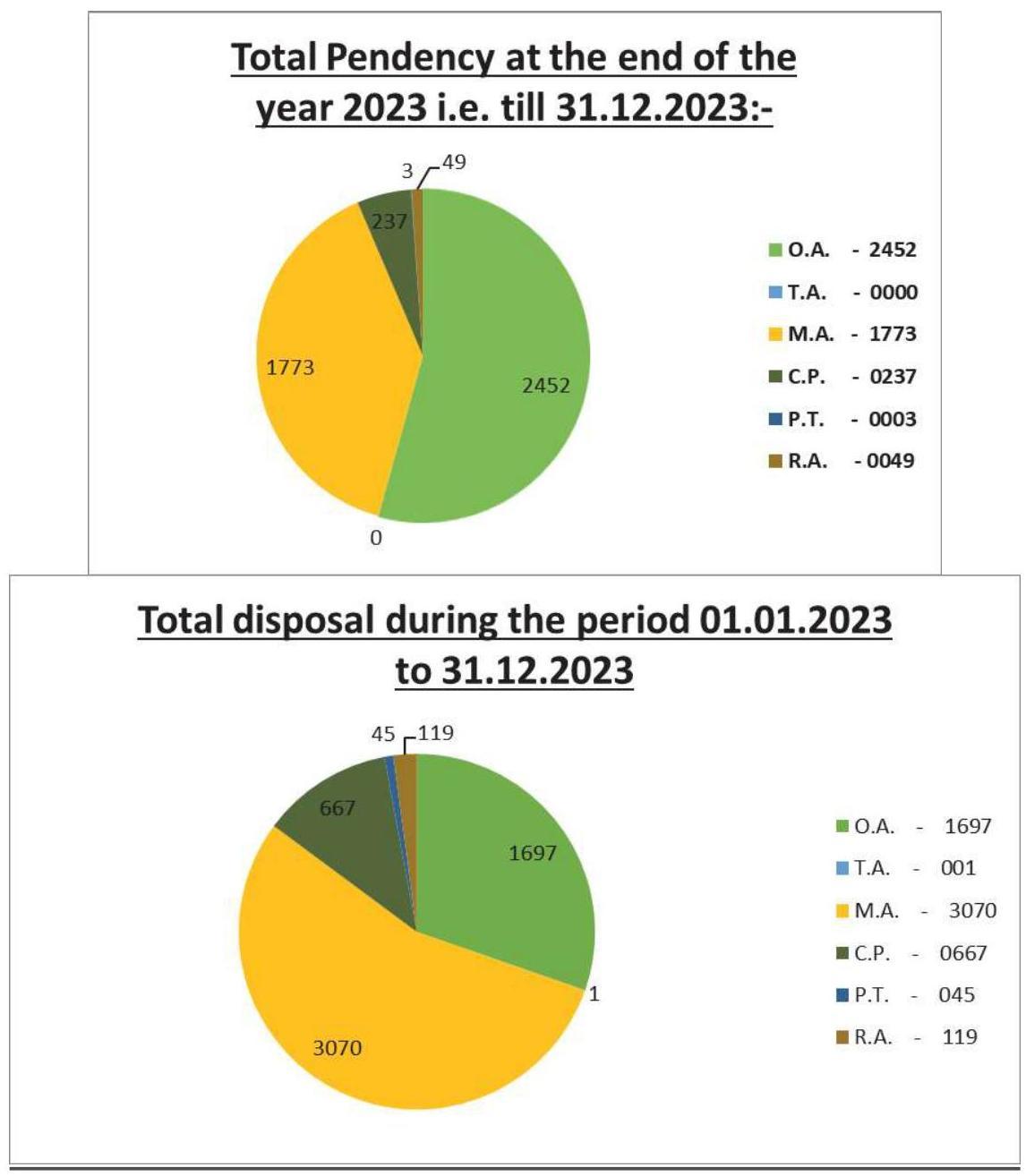
Total disposal during the period 01.01.2023 to 31.12.2023:
| 4000 | | | | | | | | | | | | | | | | | | | | | | | | | | | | | | | | | | | | | | | | | | | | | | | | | | | | | | | | | | | | | | | | | | | | | | | | | | | | | | | | | | | | | | | | | | | | | | | | | | | | |
CHAPTER 15
STAFF WELFARE
15.0 The Central Government is the largest single employer in the country and bears the major responsibility for looking after the welfare of a large number of employees spread all over the country. Realizing that improvement in the working and living conditions of the employees and their families leads to efficiency and high morale, the Department of Personnel and Training supports various staff welfare measures. A brief account of various welfare measures dealt with by the Welfare Division is given below.
RESIDENTS’ WELFARE ASSOCIATION
15.1 In order to foster a spirit of mutual help and good will among residents of Government colonies and to promote social, cultural and recreational activities, Department of Personnel & Training (DoPT) has been encouraging formation of Central Government Employees Residents’ Welfare Associations (CGERWAs). Every CGERWA seeking reorganization and grants-in-aid from Government is required to adopt Model Constitution prescribed by DOPT. The members of the Managing Committee of these Associations are elected every two years under the Provisions of a Model Constitution framed by the Department of Personnel \& Training. This Department Sanctions grants-in-aid only to recognized Associations, subject to a maximum of Rs.10,000/-per annum for an Association.
AREA WELFARE OFFICERS
15.2 The Area Welfare Officers (AWOs) are nominated in residential colonies having a large number of Central Government employees. The AWOs serve as a link between the Government and residents in matters relating to the welfare of the Government employees living in various colonies. They also work as field officers in coordinating and maintaining liaison with various agencies of Government such as CPWD, CGHS, Police etc. Applications are invited from Gazetted officers working in various Ministries/Departments for being nominated as Area Welfare Officers for a period of two years. Officers desirous of being nominated as AWOs on voluntary and honorary basis are required to apply through their respective Ministries/ Departments.
CENTRAL CIVIL SERVICES CULTURAL \& SPORTS BOARD (CCSCSB)
15.3 The Central Civil Services, Cultural \& Sports Board, a society registered under the Societies Registration Act, 1860 is the Central agency for promotion of Cultural \& Sports activities amongst the Central Government employees in the country. The Board was set up in 1964 as Central Secretariat Club in the Ministry of Home Affairs. Initially, the objective of the Board was to promote cultural and sports activities amongst the Central Government Employees located in Delhi only. Subsequently, Regional Sports Boards were set up in various states. Financial grants in-aid is sanctioned every year by the Board to the Regional Boards.
ACTIVITIES OF THE BOARD INTER MINISTRY TOURNAMENTS 2023-24
15.4 The Board organizes lnter-Ministry Tournaments in 18 disciplines of sports. Till date CCSCSB has successfully organized inter ministry tournament in Carrom, Chess, Cricket, Football, Basketball, Kabaddi, Table Tennis, Lawn Tennis, Swimming, Athletics, Volleyball,
Badminton, Power lifting, Weightlifting & Best Physique, Hockey, Shooting Ball, Wrestling and Dance \& Music.
All INDIA CIVIL SERVICES TOURNAMENTS HELD DURING THE YEAR 2023-24
15.5 These tournaments, which are open to Central and State Government employees, aim to give an opportunity to the civil servants to meet and interact with each other and compete. AICS Tournaments are being organized in collaboration with different States/UTs.
NEW ACTIVITIES UNDERTAKEN BY THE BOARD IN 2023-24
15.6(1) Third Women’s Meet was organized in the year2023-24 on $20^{\text {th }}$ December, 2023.
15.6(2) Organized All India Tournament in Kho-Kho and Yoga for first time in the year 202324 .
15.6(3) National Sports Day was organized in the year 20223-24 at Vinay Marg ground on $29^{\text {th }}$ August, 2023 for Central Government Employees.
15.6(4) Run for Unity was organized in the year 2023-24 at Vinay Marg ground on $31^{\text {st }}$ October, 2023 for Central Government Employees.
SCHEME FOR PROMOTION OF ADVENTURE SPORTS \& SIMILAR ACTIVITIES AMONGST CENTRAL GOVERNMENT EMPLOYEES
15.7 As a welfare measure, the CCSCSB launched a Scheme for promotion of adventure sports and similar activities amongst Central Government Employees working in the Ministries/Departments. The Scheme includes up to 10 days programme having components of environmental awareness, disaster management, team spirit, capacity building, and Swachh Bharat Campaign and activities like Trekking, Mountaineering, Rock-Climbing, Cycling in a difficult terrain, Skiing, Rafting, Para Sailing, Jungle Safari and Environmental Awareness Camps etc.
15.8 It is expected that participation by Central Government Employees in adventure sports and similar activities will give them a platform where they would learn lessons from nature and use the knowledge acquired for welfare of the society. It would also foster spirit of risktaking, cooperative team work, and capacity of readiness, vital response to challenging situations, endurance and environmental awareness.
15.9 CCSCSB provides financial assistance up to Rs.20, 000/- including to and fro travel charges to the Central Govt. employees.
PARTICIPATION OF GOVERNMENT EMPLOYEES AND THEIR FAMILIES IN SPORTING ACTIVITIES CONDUCTED IN COLLABORATION WITH SAI
15.10 The Board has Introduced Scheme for Swimming for Central Government Employees and their children in collaboration with Sports Authority of India at Major Dhyanchand National Stadium \&Talkatora Stadium New Delhi. Under the Scheme, Government employees and their dependents/families avail the facility of Swimming at nominal charges. Badminton, Table tennis and Fitness Centre facilities are also extended to Government Employees under “Come and Play”
scheme of Sports Authority of India to the employees and their families. Under this scheme, the amount charged by SAI is reimbursed to the beneficiary after deduction of nominal fee.
15.11 The Board is affiliated to a number of sports associations/federations at the National level. Board’s teams participate in the National Tournaments organized by these Associations/Federations in Kabaddi, Hockey, Football, Carrom, Cricket and Chess.
SPORTS FACILITIES IN DELHI
15.12 The Board has a sports complex at Vinay Marg, New Delhi which has facilities for Football, Hockey, Cricket, Athletics, Lawn Tennis, Basketball, Volleyball and practice pitches for Cricket. The Board also maintains lawn Tennis Courts at Brassy Avenue, Bharti Nagar, Pandara Road and R.K.Puram Sector 13, New Delhi, Brassy Avenue has facilities for Cricket practice pitches also. There is facility for Indoor games such as Table Tennis, Carrom and Chess at Nirman Bhawan, New Delhi. Open Gym facilities are available at Vinay Marg, Bharti Nagar, Pandara Road and R.K Puram Sector 13.
COACHING FOR CHILDREN DEPENDENTS OF GOVERNMENT EMPLOYEES
15.13 The Board also conducts regular coaching in Cricket, Football and Lawn Tennis for the children/ dependents of Government employees at Vinay Marg Sports Complex, New Delhi. Coaching in Lawn Tennis is also available at Bharti Nagar, Pandara Road and R.K. Puram Sector13 .
15.14 The Board also organizes Summer Coaching camp in Basketball, Cricket, Football, Volleyball, Self-defence and Lawn Tennis for children/dependents of government employees.
GRIH KALYAN KENDRA
15.15 Grih Kalyan Kendra (GKK) is a registered Society under the Societies Registration Act, 1860 and functioning under the aegis of Ministry of Personnel, Public Grievances & Pensions.
15.16 The basic objectives of the Kendra in brief are: –
a) To promote social, economic, cultural and educational activities for the welfare of Central Government Employees and their families.
b) To impart technical and vocational training in home crafts and other household arts for useful utilization of leisure time and better and efficient housekeeping.
c) To organize and promote economic activities that may provide opportunities for gainful employment to families of Central Government employees for supplementing the family income.
15.17 The GKK is administered by GKK Board.
The Board, which has the Secretary (P) or his nominated officer as the President, is responsible for the organization and administration of GKK.
15.18 In pursuance of its objectives, GKK has been conducting the following activities:
a) Training classes in cutting, tailoring and embroidery for the housewives and grown-up girls during their leisure hours.
b) Nursery education for children in the age group of 3 to 5 years.
c) Creches or Day Care Centres for children between the age of 90 days to 10 years.
d) Recreational facilities like Health Club/Gym, Badminton and Tennis, etc.
e) Coaching classes in Martial Arts, Yoga, Music, Dance, Computer, Brain Development, Fine Arts etc.
15.19 The welfare activities run by Grih Kalyan Kendra are indicated in the table given below:
| Place | Number of SamajSadans/ Centres |
Craft Centres |
Nursery Schools |
Creche Centres |
Health Clubs/ Gyms |
|---|---|---|---|---|---|
| Delhi | 28 | 4 | 5 | 4 | 2 |
| Mumbai | 4 | – | 4 | – | – |
| Chennai | 3 | – | 1 | – | – |
| Jaipur | 2 | 1 | 1 | 1 | – |
| Dehradun | 2 | – | 2 | – | – |
| Nagpur | 2 | – | – | – | – |
| Bangalore | 3 | – | – | – | – |
| Faridabad | 1 | – | – | – | – |
| Kolkata | 1 | – | – | – | – |
| Ghaziabad | 1 | – | – | – | – |
| Total | 47 | 5 | 13 | 5 | 2 |
- Staff has been provided by GKK to Crech Centre run by Lok Sabha Secretariat, Parliament Annexe.
15.20 The Grih Kalyan Kendra has undertaken the following activities during year 2021.
i) Due to COVID-19 pandemic, the Samaj Sadans/Centres of Grih Kalyan Kendra in Delhi and outstations were closed and all the activities viz. Nursery/KG classes, Craft centres, Creches, Yoga and Health Clubs/fitness centres etc. being conducted were suspended w.e.f 17.3.2020. Online (distance learning) classes for Nursery/KG were started in GKK Mumbai w.e.f. 5.2.2021. Physical classes wre conducted in GKK Mumbai during the year 2022-23. Approx 701 Students were benefitted during 2022-23. Martial Art and Gym/Crossfit activity, Music and Dance, Computer classes, Fine Art & Craft Activity on outsource basis have also been resumed in GKK, Delhi during 2023-24.
ii) DOPT launched a Yoga training scheme w.e.f. 01.04.2015 in association with Morarji Desai National Institute of Yoga, New Delhi for the benefit of Central Government employees and their dependants free of cost. The training sessions are conducted in 25 locations in Delhi and 11 Samaj Sadans of Grih Kalyan Kendra outside Delhi. Yoga Trainers have been selected by Morarji Desai National Institute of Yoga (MDNIY), New Delhi. These trainers have been engaged by Grih Kalyan Kendra on contract basis. Government has allocated Rs. 2 crores for running social activities under the Non-Plan for the year 2023-24.
iii) International Yoga Day, 2023 was celebrated on 21.6.2023 and 1923 approx sadhak participated in the event.
KENDRIYA BHANDAR
OBJECTIVES OF THE ORGANISATION
15.21 The Central Government Employees Consumer Cooperative Society Ltd., New Delhi, operating in the name of KENDRIYA BHANDAR was set up in 1963 in pursuance of Cabinet decision as a Welfare Project for the benefit of the Central Government Employees. The society endeavours to serve the Central Government Employees and the general public at large by providing quality goods of daily needs at reasonable prices through its retail stores. The range of items which Kendriya Bhandar provides includes consumer goods, grocery items, stationery and medicines etc.
MULTI-STATE COOPERATIVE SOCIETY
15.22 The Society is registered under MSCS Act 2002, as a Multi-State Co-operative Society and operates in Delhi and other States of the country.
NETWORK
15.23 The Society operates a network of 149 stores/branches in Delhi, Maharashtra, Tamilnadu, Andhra Pradesh, Karnataka, Cochin, Daman, Gujarat, Uttar Pradesh, Uttaranchal, Rajasthan, Madhya Pradesh, West Bengal, Jharkhand, Assam, Haryana, Jammu & Kashmir, Punjab and Chandigarh etc.
15.24 At Delhi, Kendriya Bhandar has a chain of 101 nos. self-service grocery consumer retail stores beside the Institutional Sales Unit (ISU) and 05 Pharmacy shops (inclusive of three JAN Aushadhi Generic Drug Shops). In addition, 08 stores are operating in Delhi-NCR under franchisee system. At Grocery/Consumer stores, all items of consumer goods, grocery items and certain stationery items are being sold. Through its Institutional Sales Unit, Kendriya Bhandar continues to provide goods to institutions like Tihar Jail, JNU/IIT Hostels, Janpath/Samrat Hotel, Hyderabad House, President House, Vigyan Bhawan, Homes of Social Welfare Department of Govt. of Delhi, Govt. Hospitals etc. In addition, Kendriya Bhandar has exclusive counter at East Block and West Block, R.K. Puram, New Delhi for sale of stationery and other products.
15.25 Furthermore, Kendriya Bhandar is supplying medicines and related items to CGHS Dispensaries and Hospitals in Delhi-NCR through its existing chemist shops. Jan Aushadhi Generic Drug Shops have been opened in GTB Hospital, DDU Hospital and Shastri Bhawan as a part of Jan Aushadhi project of the Department of Pharmaceuticals, Govt. of India.
15.26 Kendriya Bhandar has also opened Stationary Counter at Jamia Hamdard University. At Stationery Division Kendriya Bhandar had opened a separate Counter for COVID -19 related items.Kendriya Bhandar has opened new retail stores at NSG SahkariAvas Samiti Limited, Greater Noida, Niharika Community Centre, Sector-31 Noida, AIIMS Deoghar, Ranchi and Bihar Institute of Public Administration \& Rural Development (BIPARD), Gaya, Bihar. Kendriya Bhandar has opened new store in 23, Acres Residential Colony, Delhi Cantt, New Delhi and Indian Institute of Public Administration (IIPA), I.P. Estate, New Delhi.
SHARE CAPITAL
15.27 As on $31^{\text {st }}$ March 2022 Kendriya Bhandar had a paid-up capital of Rs. 100.84 lakhs of which Rs. 68.18 lakhs have been subscribed by the Central Government and the rest by individual members.
MODERNISATION/AUTOMATION EFFORTS
15.28 Activities such as billing to customers, purchase, inventory etc. of Stationery division of Kendriya Bhandar, located at R.K. Puram East & West Blocks are computerized through Local Area Network. Further, in Head Office, purchases \& stocks of Consumer items, pulses and spices are computerized. All retail stores have already been computerized and also inventory has been computerized.
15.29 Debit/Credit Card swiping machines have been installed in all stores of Kendriya Bhandar for the convenience of customers.
SALES AND FINANCIAL PERFORMANCE
15.30 Kendriya Bhandar has achieved sales of Rs. 3122.93 crores during the financial year 2022-23 against the sale of Rs. 4043.06 crores in Financial year 2021-22 and also achieved a net profit of Rs. 5.06 crores in the F.Y 2022-23 (after making provision of Rs.2.50 Crores for wage Revision) against the net profit of Rs. 4.95 crores during the F.Y.2021-22.
Kendriya Bhandar has declared a dividend of $10 %$ for the year 2020-21. There is no financial assistance from Govt. to Kendriya Bhandar. Source of income of Kendriya Bhandar is trading of products, interest on FDRs etc.
BENEFITS TO CUSTOMERS
15.31 The Society has been able to maintain competitive prices for various products sold by it as compared to those prevailing in the market. In fact, selling prices prevailing in Kendriya Bhandar now are deemed as the benchmark in the market.
15.32 For better quality control, full-fledged Quality Control Department is in place for monitoring the product quality and for making improvements on an ongoing basis. Packed grocery items are sold after pre-testing in the laboratory. On the shelf, post-testing is done periodically. The goods sold in the manufacturers packing carry the warranty of the manufacturer. Complaints books are provided in all the stores for the customer to enter their complaints/suggestions which are acted upon from time to time.
15.33 It is pertinent to mention that the Society has been involved in welfare activities and has always assisted the Central Government and the Govt. of NCT of Delhi in arresting the price rise at the time of crisis. At present, Kendriya Bhandar is selling Bharat Atta at the instance of Govt. of India @ Rs. 27.50 per kg against market price of minimum Rs.32-33/-per kg and Bharat Dal (Chana Dal @ 60/-per kg). Similarly, Bharat Chawal launched by Govt. of India is being sold throughout the Country @ Rs 29/- per kg. Kendriya Bhandar came to the aid of Delhi Government and other State Governments and supplied items of their need in record time and in huge quantity during Pandemic.
15.34 CCTV cameras have been provided in a large number of stores as a preventive measure against shoplifting, theft etc.
The Civil Service Society (Sanskriti School)
Introduction
15.35 The Civil Services Society is a society registered under the Societies Registration Act. The Society was set up in February 1995, by the wives of the officers of the All India and Allied Civil Services. The wife of serving Cabinet Secretary is the Chairperson of the Civil Services
Society. The office of the Society is at Dr S Radhakrishnan Marg, Chanakyapuri, New Delhi 110021 .
Aims and Objectives
15.36 The aims and objectives of the society, inter alia, are as under: –
- To establish progressive schools or other educational institutions in Delhi or outside Delhi, open to the children of officers of the All India and Central Services. Depending on the availability of seats, children of officers of the Public sector (Non – government servants) may also be admitted, at the discretion of the Governing Body.
- To impart sound and liberal education to boys and girls during their impressionable years – a type of education that will lay stress on character building, team work, esprit de corps, physical development and will infuse in school children a spirit of adventure, fair play and justice.
- To develop among its students a feeling of pride in Indian culture and to produce citizens who will truly be global and rise above social, communal, religious and provincial prejudices.
15.37 The Society started its first school with the strength of 32 students, the Sanskriti School, in New Delhi, in the year 1998. The Chairperson of the Society is also the Chairperson of the School. Sanskriti School is a recognized integrated co-educational school, affiliated to the CBSE, offering education from Nursery to Class XII.
15.38 The Society believes that every child can and must realize his/her full potential, and towards this end, must be enabled through appropriate means. With this in mind, the School has a Learning Centre with Special Educators and Counselors guiding children who have special needs, through an Individual Education Program (IEP).
15.39 Likewise, for those from the relatively less privileged sections of society, the Society runs a parallel school Umang in the afternoon. Efforts are also made to mainstream some of the children. These children from the economically weaker sections are admitted through the admission process under the Delhi Education Act.
15.40 The Civil Services Society has set up a Centre for Excellence to promote teacher training initiatives. It has instituted the Sanskriti Lecture Series to motivate students by exposing them to the thought processes of eminent persons.
Management
15.41 The general management of the affairs of the Society is vested in its Executive Committee.
15.42 The general management of the affairs of Sanskriti School is also guided by the Managing Committee.
Activities
15.43 Sanskriti School has well stocked libraries, smart classrooms, laboratories, a gymnasium, a football field and a swimming pool. Apart from the prescribed curriculum, Sanskriti School offers its students a choice of sports and games, like cricket, football, basketball, table tennis, swimming and wide ranging co – curricular activities like yoga, chess, theatre, music, dance, quiz, public speaking, paper craft, etc.
Finance
15.44 The Society has no income of its own other than the annual subscription of the members. For Sanskriti School, the source of income is the fees collected from the students.
CIVIL SERVICES OFFICERS INSTITUTE (CSOI)
INTRODUCTION
15.45 The Civil Services Officers’ Institute is a registered society under the Societies Registration Act and was set up in February 1998. CSOI was allotted a building at K.G Marg, M.S. Apartments complex in 1998 which was later re-appropriated by CPWD to provide facilities of an Institute. Subsequently, the land was allotted to CSOI in 2002 at Vinay Marg, Chanakyapuri measuring 4.23 acres by Ministry of Urban Development, GOI. The new building was constructed by NBCC at a cost of Rs. 44.33 crore and it became operational with effect from December 2012. The Governing Council of CSOI decided to run both the Institutes at their respective locations in view of increased membership.
AIMS AND OBJECTIVES
15.46 The aims and objectives of the CSOI inter alia include: –
(i) To promote the welfare of the officers of the Civil Services and bring them together under one umbrella to secure complete integration of the services and to build a corps of officers imbibed with the spirit of co-operation in all aspects of Civil Services.
(ii) To hold, organize, arrange and conduct seminars, symposiums, talks, debates, workshops, lectures and other means of dispensing education to meet the needs and challenges of modern-day Civil Administration.
(iii)To print and publish journals, periodicals and manuals to keep the civil servants abreast with modern-day development.
(iv)To acquire and promote modern skills of Civil Administration and harmonize between different fields of Civil Administration by disseminating or exchanging knowledge thereof and by providing such other facilities as would lead to their Universal application.
(v) To establish and maintain libraries and information system to facilitate the study of Civil Administration at International level and spreading information in regard thereto.
(vi)To organize and maintain, on no-profit-no loss basis, limited residential accommodation for the members of the Society coming to participate in the activities of the Association
and of other bodies with cognate objectives, as well as non-members, invited to participate in the activities of the Association.
MANAGEMENT
15.47 CSOI is managed by a Governing Council headed by Cabinet Secretary, an Executive Committee headed by Secretary (P), DoPT and a Working Committee headed by Additional Secretary (DoPT). Various sub-committees comprising of members to assist the Working Committee in its day to day smooth functioning, viz:
a) Finance subcommittee
b) Food & Beverages subcommittee
c) Arts \& Events subcommittee
d) Building Maintenance subcommittee
e) IT subcommittee
f) Library subcommittee
g) Sports subcommittee.
Events
(a) Stage Play – ‘ShashiPunnu’ by Ms. Kajalsuri.
(b) Cultural Event by Dr Bani Bora (NGO: Centre for Social Change).
(c) Organised Millet Food Festival at Vinay Marg.
(d) Book release ‘Darmiyaan’ by Shri MahoharBatham.
(e) Musical Programme (Songs and Music of Hemant Kumar) By Ms. Swati Tamhane.
(f) Block buster movies on weekends viz., $12^{\text {th }}$ Fail, Sam Bahadur \& Gifted Hands.
DEPARTMENTAL CANTEENS
15.48 As a measure of Staff Welfare, Departmental Canteens/Tiffin Rooms have been set up in the Central Government Offices/Establishments to make available. Beverages, snacks and meals prepared in hygienic conditions, to the employees at reasonable rates. At present, about 700 Departmental Canteens/Tiffin rooms are functioning in various Central Government Offices all over India. It is stated that Canteen Section DoP\&T is nodal agency for framing policies, guidelines/instructions for canteen staff of Non-Statutory Departmental Canteen functioning from the Central Government Offices.
2. With a view to providing good quality of service in clean \& hygienic environments, this Department has introduced a scheme for modernization of Departmental Canteens in 2015. Under the scheme, one time grant is given to canteens for their modernization to maintain hygiene and high standards of service.
3. Scholarship Scheme for children of employees of Non-Statutory Departmental Canteen was instituted in 1998 out of the funds in the discretionary fund of Director of Canteen. The scheme was introduced to encourage higher studies among the children of the canteen staff.
CHAPTER 16
RIGHT TO INFORMATION
MANDATE
- Administration of the RTI Act, 2005 including examination of matters related to amendments to the Act.
- Framing of Rules under the RTI Act, 2005 and amendment to the existing Rules made under the RTI Act.
- Issue/framing guidelines and orders to remove difficulties arising in giving effect to the provisions of the RTI Act.
- Appointment of Chief Information Commissioner and Information Commissioners in the Central Information Commission.
- Major policy issues relating to Right to Information Act, 2005.
- Laying of Annual Report of Central Information Commission before the Parliament.
- Action on recommendations of the Central Information Commission and Parliamentary Committee.
- Issue of guidelines and clarification on the strengthening and implementation of RTI Act.
- Implementation of the Annual Programme titled ‘Improving Transparency and Accountability in Government through Effective Implementation of RTI Act’.
- Management of RTI Online web portal.
- Administrative matters of Central Information Commission.
SALIENT FEATURES OF THE RIGHT TO INFORMATION ACT, 2005
16.1 To set out a practical regime for securing information by citizens from the Public Authorities and to promote transparency and accountability in the working of all Public Authorities, the Parliament enacted the Right to Information Act in 2005.
16.2 The Act is comprehensive and covers disclosure of information by public authorities on matters of governance. It is applicable to Government at all levels- Union, State and Local and also to the bodies owned, controlled or substantially financed directly or indirectly by the Government. It covers legislative bodies, the judiciary, the executive and Constitutional bodies.
16.3 The Act casts an obligation on public authorities for suo-motu disclosure/publication of information held by them. It also requires the public authorities to supply information called for by any citizen and to permit him to inspect the documents and collect samples of various works. The procedure for seeking information is very simple. A person seeking information has to make a request to the concerned Public Information Officer indicating the information required. The request may be sent either by post, or be submitted in person or online if such facility exists with the public authority. It can be made in Hindi or English or in the official language of the area in which the application is made.
16.4 The Act creates the machinery to ensure supply of information, which consists of Public Information Officers, Assistant Public Information Officers, Departmental Appellate Authorities, independent Central and State Information Commissions etc.
16.5 The Act requires information to be provided in time bound manner. A Public Information Officer is required to send information called for at the specified address within 30 days. In case the information concerns the life or liberty of a person, it has to be provided within forty-eight hours. The Act provides for imposition of stringent penalty on the Public Information Officer, if the information is not provided within the prescribed period which could be Rs.250/- per day of delay subject to a maximum penalty of Rs. $25,000 /-$.
16.6 The Act has created a system of two appeals. On not being provided information within the stipulated period or on not being satisfied with the reply provided, an applicant can make first appeal within 30 days to the departmental appellate authority, who is generally the next superior officer to the Public Information Officer. If not satisfied with the decision of the first appellate authority, the applicant can file a second appeal to the Central Information Commission or the State Information Commission, as the case may be, within 90 days.
16.7 However, certain types of information pertaining to security of the country, scientific or economic interest of the country and information on trade secrets etc. are exempted from disclosure. Certain security or intelligence organizations have been exempted from disclosing any information except that pertaining to allegation of corruption or violation of human rights. Such organizations are required to designate Public Information Officers and First Appellate Authorities to deal with applications and appeals relating to information pertaining to corruption or violation of human rights.
16.8 With a view to create a brand for the Right to Information, a logo as given below had been adopted for the RTI on 28th October, 2010. The logo is very simple and iconic. A sheet of paper with information on it, and the authority figure behind it – providing the information. This represents the two key stakeholders in the process of sharing information under the RTI Act.

CENTRAL INFORMATION COMMISSION
16.9 The Government of India has constituted a Central Information Commission. Further, all the 28 States to which the Act applies, have constituted State Information Commissions. These Commissions are high powered independent bodies which, inter-alia, can look into the
complaints made to them and decide the appeals. The Commissions have power to impose penalty on the defaulting Public Information Officers. Central Information Commission entertains complaints and appeals in case of offices, financial institutions, public sector undertakings, etc. under the Central Government and the Union Territories while the State Information Commissions entertain appeals pertaining to offices, financial institutions, public sector undertakings, etc. under the concerned State Government.
16.10 The Central Information Commission, when constituted initially, had five Commissioners including the Chief Information Commissioner. With the last appointment of the Chief Information Commissioner and two Information Commissioners on 6th November, 2023, the Commission has now TWO Information Commissioners apart from the Chief Information Commissioner in position.
RIGHT TO INFORMATION RULES, 2012
16.11 In supersession of the Central Information Commission (Appeal Procedure) Rules, 2005 and the Right to Information (Regulation of Fee and Cost) Rules, 2005, the Right to Information Rules, 2012 have been notified in the Gazette of India on $31^{\text {st }}$ July, 2012.
16.12 The Right to Information Rules, 2012 provide inter-alia that a request for obtaining information shall be accompanied by an application fee of rupees ten by way of cash against proper receipt or by demand draft or bankers’ cheque or Indian Postal Order payable to the Account Officer of the public authority. The applicant may have to pay fee in addition to application fee for obtaining documents or for inspecting the documents. The persons below poverty line are not required to pay any fee for seeking information.
16.13 The RTI Rules, 2012 also prescribe the procedure for deciding appeals by the Central Information Commission, covering the following aspects:
(i) Documents to be enclosed with the appeal;
(ii) Return of Appeal
(iii)Process of Appeal
(iv) Procedure for deciding appeals
(v) Presence of the appellant before the Commission
(vi) Presentation by the Public Authority
(vii) Service of notice by Commission
(viii) Order of the Commission
RIGHT TO INFORMATION RULES, 2019
16.14 RTI Amendment Bill, 2019, passed by the Lok Sabha on 22.07.2019 and Rajya Sabha on 25.07.2019, received the assent of the President on $1^{\text {st }}$ August, 2019.
16.15 The RTI (Amendment) Act, 2019 was notified, by the Legislative Department, in the Gazette of India on $1^{\text {st }}$ August, 2019.
16.16 Notification to bring into force the provision of the RTI (Amendment) Act, 2019 has been published in the Gazette of India, Extraordinary under Part II, Section 3, Sub-Section (ii) on 24.10.2019.
16.17 Consequently, ‘The Right to Information (Term of Office, Salaries, Allowances and Other Terms and Conditions of Service of Chief Information Commissioner and Information Commissioners in the Central Information Commission, State Chief Information Commissioner and State Information Commissioners in the State Information Commission) Rules, 2019’ were notified in the Official Gazette of India, Extraordinary under Part II, Section 3, Sub-Section (i) on 24.10.2019.
RTI WEBSITE
16.18 There is a dedicated website on RTI www.rti.gov.in, which contains valuable information including circulars, notifications and Guides on RTI, search facility for locating CPIOs and Appellate Authorities in Central Government etc. It has links with other RTI related sites as well. Further, there is an RTI online web portal whereby Right to Information (RTI) applications can be filed online by Indian citizens, including those who are living abroad. An Indian citizen can file RTI application online through RTI online web-portal, having urlwww.rtionline.gov.in. The prescribed fee for RTI application can also be paid online through a payment gateway of State Bank of India by way of internet banking of State Bank of India, debit/ credit cards of Master/Visa Ru Pay cards and UPI. This facility at present is available for 2628 Public Authorities of Government of India (as on 29.01.2024).
ANNUAL PROGRAMME ON RIGHT TO INFORMATION
16.19 The Government has launched a Centrally Sponsored Plan Scheme “Improving Transparency and Accountability in Government through Effective Implementation of the Right to Information Act” in August, 2010 to undertake activities in the area of awareness generation and capacity building. Under the scheme, the State Administrative Training Institutes and State Information Commissions are supported through release of grants for awareness generation and training programmes of all stakeholders. The total outlay of the scheme under XII th Five Year Plan was Rs. 110.36 crores. During the Financial year 2023-24, an amount of Rs 329.73 lakhs have been released.
TRAINING:
16.20 The above Scheme has components of training of Public Information Officers / First Appellate Authorities of Centre as well as States.
AWARENESS GENERATION FOR RTI:
16.21 The component of awareness generation includes Organization of Workshops, RTI Week Celebration, Innovative Awareness Generation Programmes and Publication of Guidebooks.
RTI ONLINE PORTAL
16.22 A web portal namely ‘RTI Online’ has been launched to provide the facility for the Indian Citizens to file online RTI applications and first appeals and also to make online payment of RTI fees. The prescribed fee can be paid by the applicant through internet banking of the State Bank of India as well as by Credit/Debit cards of VISA / Master, through the payment gateway of SBI, which is linked to RTI Online portal.
16.23 The RTI online portal provides for sending online replies to applications and appeals, though reply can be sent by regular post also. For a successful implementation of this facility, extensive training to the CPIOs / FAAs has been provided by DOPT, with the help of NIC. As on 29.01.2024, 2628 Public Authorities have been aligned with this portal.
SUO MOTU / PROACTIVE DISCLOSURE
16.24 Section 4(1)(b) of the RTI Act lays down the information which should be disclosed by Public Authorities on a suo-moto or proactive basis. Sections 4(2) and 4(3) of the Act prescribe the method of dissemination of this information. In order to improve the proactive disclosure, Government of India constituted a Task Force on Suo moto disclosure in May, 2011. After considering the recommendations of the Task Force, the Government of India has issued
guidelines to Central Ministries / Departments for Proactive Disclosure under section 4 of the RTI Act on 15.4.2013 and the same were, with slight modifications, reiterated on 07.11.2019. These guidelines envisage –
(a) Suo moto disclosure of more items under section 4 ;
(b) guidelines for digital publication of proactive disclosure;
(c) detailing of certain clauses of section 4(1)(b) to make disclosure more effective;
(d) compliance mechanism for suo moto disclosure; and
(e) personal information of an individual not to be disclosed
16.25 As per the guidelines, Pubic Authorities may publish information relating to procurement, public private partnerships, transfer policy and orders, RTI applications, CAG and PAC paras, citizens’ charter, discretional and non-discretionary grants, foreign tours of Prime Minister and Ministers.
16.26 The guidelines further provide that each Central Ministry/ Public Authority should get its proactive disclosure package audited by a third party every year and that such audit should be communicated to the Central Information Commission annually through publication on their own websites along with the names of the third-party auditors. Under these guidelines it is mandatory that a senior officer of the level of Joint Secretary in the case of Ministry/Department and Additional HoD in the case of attached/subordinate offices, is nominated as nodal officer for ensuring compliance with the proactive disclosure guidelines.
16.27 The above guidelines have been reiterated duly incorporating a slight revision to Para 4.4 of the above guidelines allowing for third party audit by any Government Training Institute, in cases where no Training Institute exists under the concerned Ministry/Department/Public Authority. In course of a relaxation to the Central Public Authorities in aforesaid guidelines, it has been further provided that if any Training Institute, under any Ministry/Department/Public Authority, is recognized and functions as a separate Public Authority in terms of provisions of RTI Act, 2005, it may get third party audit of its proactive disclosure package done by any Government Training Institute. In course of the further relaxation, on the requests of various public authorities, the requirement of respective Government training institute was dispensed with by providing that the task of undertaking transparency audits may be given to any Government Training Institutes by Ministry/Department Public Authority, under the Central or State Governments.
16.28 State Governments have also been requested to consider issuing similar guidelines, along with templates for disclosure at various levels, for better implementation of suo moto disclosure at State level. Four areas have been identified for development of templates viz. Public distribution system, Panchayats, MGNREGA and Primary and Secondary Schools.
16.29 A facility to upload the reply of RTI applications and first appeals on the respective website of the Ministry/Department has been started from $31^{\text {st }}$ October, 2014. All the Ministries/Departments of Govt. of India have been requested to upload the reply to RTI application and first appeal on their respective websites, except the replies relating to the personal information of an individual, if they do not serve any public interest.
IMPLEMENTATION OF RTI ACT, 2005 in DoPT
16.30 During the year 2023-24 a total of 19345 RTI applications were received and 18654 RTI applications were disposed of in DoPT. In addition, 1474 RTI First Appeals were received and 1395 RTI First Appeals were disposed of during the year 2023-24.
16.31 Third Party Audit on suo-moto disclosures under the RTI Act, 2005 in respect of DoPT for the year 2022-23 was conducted by IIPA through online mode. The audit report is available on the website of this Department at Home $\rightarrow$ RTI $\rightarrow$ Proactive Disclosures $\rightarrow$ Proactive Disclosure (RTI) $\rightarrow$ Item No. 17 – “Such Other Information as may be prescribed”.
CHAPTER 17
PUBLIC GRIEVANCE REDRESSAL MECHANISM & CITIZENS’ CHARTER
Citizens/ Client’s Charter and Sevottam Compliant Public Grievance System of the Department:
17.1 The Citizens’/Clients’ Charter of the Department contains the services provided by the various Divisions, name and contact, details of the responsible officer, service standards and time taken, the process involved and documents required. The charter also contains the name and contact details of public grievance officer. The services included in the citizens’/clients’charter are:
i. Processing of proposals for ACC approval.
ii. Allocation of Service based on the result of the Civil Services Examination (Display on the website of this Department)
iii Nomination of the candidate to whom service allocated for Foundation Course (Display on the website of this Department)
iv Release of holiday list for the Government Department/organisations.
v. Release of Grants-in-aid to staff side Secretariat of National Council (JCM).
vi. Grant of advice on disagreement cases with UPSC on disciplinary matters.
vii. Clarification on ACRs/APARs.
viii. Processing for extension of ad-hoc appointment /Grant of approval.
ix. Processing of proposals for framing/amendment/relaxation of RRs (including proposals received online on RRFAMS).
x. Cadre Clearance for Deputation.
xi. NOC for filling up of posts in Government organisation.
xii. Nomination of officers under domestic Funding of Foreign Training- Long Term Training Programmes ( 6 months- 1 year) \& Short Term Training Programmes (up to 6 months).
xiii. Nomination of officers for Advanced Professional Programme in Public Administration (APPPA).
xiv. Advice/clarification to Ministries/Departments on the issue of Reservation in services to SC, ST, OBC, PWD and Ex-Servicemen.
xv. Payment to vendors for invoices submitted, except air bills, submitted complete in all respects.
17.2 Review of implementation of Citizens’/Clients’ Charter is a continuous process and the Department is committed to include more services and improve service standards.
Public Grievances Redressal System
17.3 The Department is implementing the Centralized Public Grievances Redressal and Monitoring System (CPGRAMS), an online grievance redressal mechanism, developed and monitored by the Department of Administrative Reforms and Public Grievances (DARPG).
17.4. The Department received online grievances from various sources in CPGRAMS portal with the majority of grievances lodged directly by the common public. In addition to this, the Department also received grievances forwarded by the higher authorities namely PMO, President Secretariat, DARPG and DoP&PW (pension) in CPGRAMS portal, for their timely redressal. During the period from April, 2023 to March, 2024, the Department has received 26560 grievances (including 3173 brought forwarded grievances from previous year) in CPGRAMS portal, out of which, 26003 grievances have been disposed of by the concerned Divisions/Subordinate org./Attached Offices of DoP\&T and other Ministries/Departments/States/UTs.
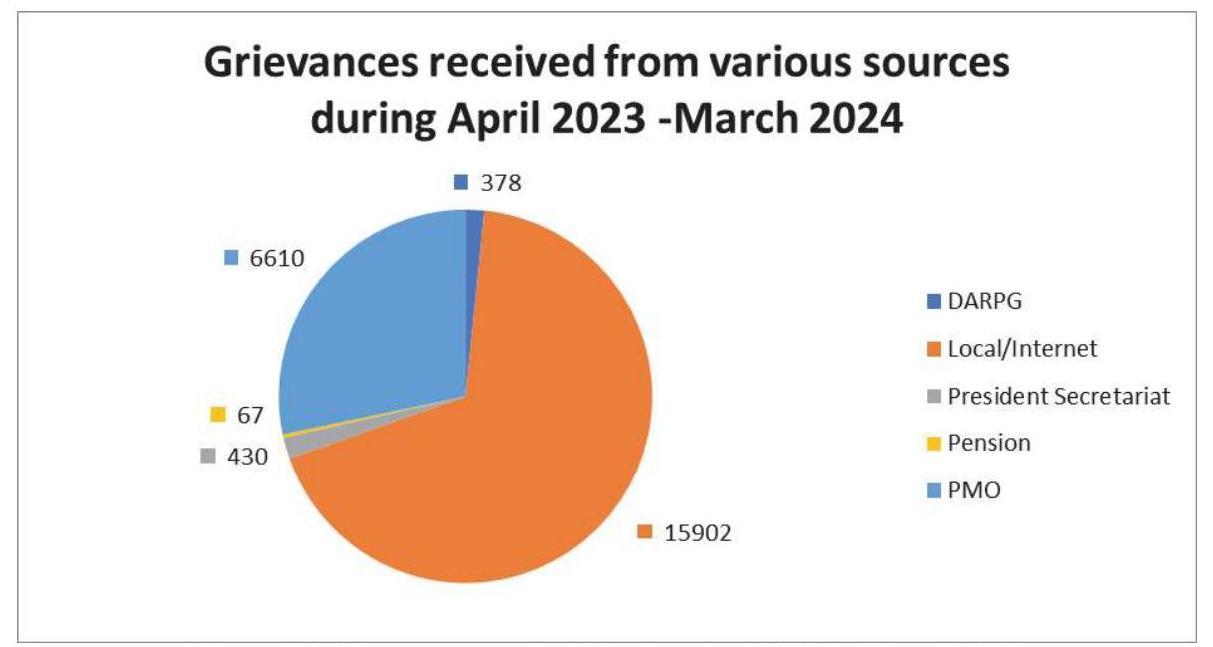
Figure 1: Grievances received during April 2023 – March 2024
17.5. The Department received 1706 grievances in physical form through letters written by the general public as well as forwarded by other Ministries/ Departments/organizations of the Government of India. These Grievances were forwarded to concerned Divisions in DoPT for examination and redressal. The grievances which do not pertain to this Department were forwarded to the Ministries/ Departments concerned and the petitioners were informed, accordingly.
17.6. The Deputy Secretary (Admin.), DoP\&T, is the Nodal Officer of Public Grievances in DoP\&T. As per the instructions of the Department of Administrative Reforms and Public Grievances, Wednesdays are observed as meeting-less day so that the citizens can meet the officers concerned with their grievances.
CHAPTER-18
PROGRESSIVE USE OF HINDI IN OFFICIAL WORK
18.0 The Ministry continued to make concerted efforts to promote the use of Hindi in official work and to ensure compliance of the provisions of the Official Language Act, 1963 as amended in 1967 and Official Language Rules, 1976 framed thereunder. Various orders/instructions issued from time to time by the Department of Official Language with a view to ensure proper implementation of the Official Language Policy of the Union are also implemented in the Ministry.
18.1 MACHINERY FOR IMPLEMENTATION AND TRANSLATION
18.1.1 The Ministry has a full-fledged Official Language Division headed by a Joint Director (OL) with one (01) Deputy Director (OL) and two (02) Assistant Directors (one post vacant) and other supporting staffs. This Division caters to the needs of the Department of Personnel and Training. There is a separate Official Language Section under a Deputy Director (OL) with necessary supporting staff in the Department of Administrative Reforms and Public Grievances. Likewise, there is a separate OL Section headed by one (01) Assistant Director (OL) with necessary supporting staffs also in the Department of Pension and Pensioners’ Welfare. Besides monitoring the implementation of the Official Language Policy and the Annual Program, the Official Language Division arranges in-service training for the staff for learning Hindi Language, Hindi Stenography and Hindi Typewriting. It also undertakes translation of the material received from various sections/desks of the Department from English to Hindi and vice versa such as General Orders, Standard forms, Notifications, Resolutions, Cabinet Notes (except the annexure relating to other Ministries/Departments), Administrative and other Reports, Press Releases and Periodic Statements/Summaries etc. referred to in section 3(3) of the Official Language Act, 1963 in addition to Parliamentary and Budgetary matters.
18.2 VARIOUS COMMITTEES FOR EFFECTIVE IMPLEMENTATION OF OFFICIAL LANGUAGE POLICY
18.2.1 Kendriya Hindi Samiti
Kendriya Hindi Samiti headed by the Hon’ble Prime Minister suggests various ways and means to the Ministries/Departments to promote the use of Official Language Hindi in the official work. Last meeting of the committee was recently held on 06.09.2018 under the chairmanship of the Hon’ble Prime Minister. The directions and follow up actions of the Committee are being implemented in the Department.
18.2.2 The Committee of Parliament on Official Language
The Committee of Parliament on Official Language was to be constituted under section 3 of the Official Languages Act 1963 after ten years of the promulgation of the Act. This Committee was set up in 1976 under section 4 of the Act.
This is a high-level committee comprising of 30 members of Parliament, 20 from Lok Sabha and 10 from Rajya Sabha. The Chairman of the Committee is elected by the members of the Committee. As a convention, the Union Home Minister (HM) has been elected as Chairman of the Committee from time to time.
The Committee of Parliament on Official Language inspected Department of Personnel and Training (DoPT) on 10.10.2020. The Committee reviewed the implementation of the provisions of Official Language Act and suggested various ways and means to the Ministry/Department to promote the progressive use of Official Language Hindi in the official work by creating a conducive and facilitative environment for the personnels of the Department.
18.2.3 Hindi Salahakar Samiti (Hindi Advisory Committee)
As per the guidelines from Department of Official Language, Ministry of Home Affairs, Hindi Advisory Committees are constituted in Ministries/Departments to put their advice regarding proper implementation of the official language policy of the Government of India. The minister concerned of the office chairs the committee.
This is a high-level committee consisting of 30 members. The committee is constituted for three years and advises the Ministry and its subordinate offices regarding implementation of the directions issued by Department of Official Language regarding provisions made under the Constitution, Official Language Act and Rules. The Hindi Salahakar Samiti of the Ministry has been reconstituted vide the Resolution No. E-11015/1/2019-Hindi dated 26.10.2020 after the constitution of the $17^{\text {th }}$ Lok Sabha. The $14^{\text {th }}$ meeting of the committee was held at CSOI, New Delhi on 16.08.2023 under the chairmanship of Hon’ble MoS (PP), Dr. Jitender Singh.
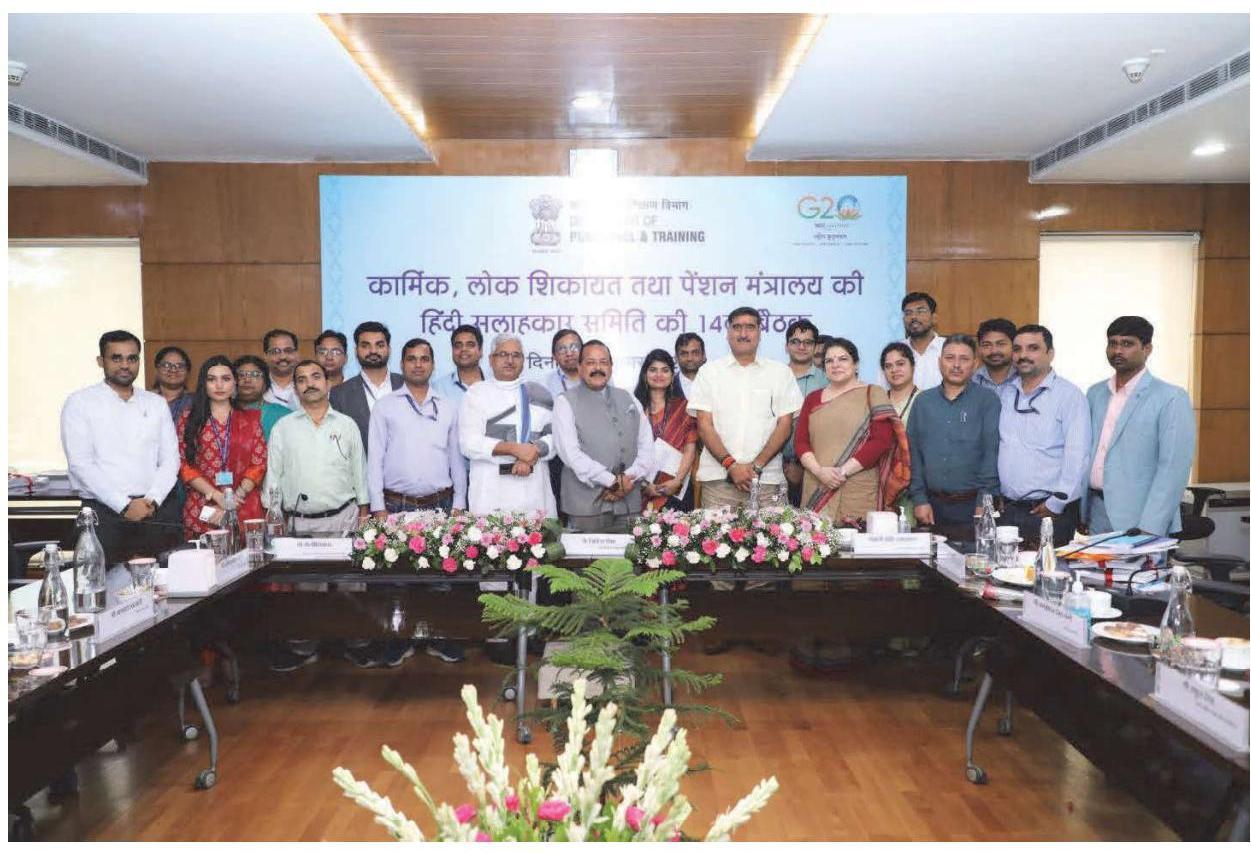
$14^{\text {th }}$ meeting of the committee was held at CSOI, New Delhi on 16.08.2023 under the chairmanship of Hon’ble MoS (PP), Dr. Jitender Singh.
18.2.4 Kendriya Rajbhasha Karyanvayan Samiti
Kendriya Rajbhasha Karyanvayan Samiti is headed by the Secretary, Department of Official Language which reviews the ongoing progress of the use of Hindi in all the
Ministries/Departments of Government of India. The last meeting ( $45^{\text {th }}$ meeting) of the said committee was held from 16.10.2023 to 18.10.2023 under the chairmanship of Joint Secretary, Department of Official Language. The directions of this Committee are being complied with in the Department.
18.2.5 Official Language Implementation Committee (OLIC)
The meetings of the Official Language Implementation Committee (OLIC) of the Department of Personnel and Training are held periodically in the Department to discuss the Quarterly Progress Reports and suggest various measures for progressive use of Official Language Hindi in the Department. The meetings of Official Language Implementation Committee (OLIC) are being held regularly in the Department. The last meeting was held on 20.03.2024. The Quarterly Progress Reports related to Official Language Hindi are reviewed in the meetings of Official Language Implementation Committee (OLIC) and various measures are taken for progressive use of Official Language Hindi in the Department.
18.2.6 Official Language Implementation Committee (OLIC) of Attached Offices
All the attached/subordinate offices of the ministry have their own Official Language Section and they have their own Official Language Implementation Committee (OLIC). The meetings of Official Language Implementation Committee are held regularly in these offices and the representatives of the Department also attend these meetings.
18.3 SPECIFIC MEASURES TAKEN FOR PROMOTING THE USE OF OFFICIAL LANGUAGE HINDI
18.3.1 Quarterly Progress Report and Annual Assessment Report
To assess the work done in Hindi by the personnel of the Department in their official work, a Quarterly Progress Report (QPR) is compiled after collecting relevant and real-time data from various Divisions/Sections in a prescribed proforma and sent to the Department of Official Language, Ministry of Home Affairs on regular basis. Similarly, Annual Assessment Report (AAR) is also sent to the Department of Official Language, Ministry of Home Affairs.
18.4 CASH AWARDS AND INCENTIVE SCHEMES
Various incentive schemes of the Department of Official Language to encourage officers and employees to do their official work in Hindi are in vogue in all the government departments. One such scheme is in vogue in this Department under which cash awards are given to staff members who carry out their official work (Noting & Drafting) in Hindi. During the year 20222023 entries from total nine (09) officials have been received and are under scrutiny of committee constituted for this purpose and all the winners will be provided with cash prizes and commendation certificates after the declaration of the results for the same.
18.5 HINDI WORKSHOPS
Hindi Workshops are organized in the Department to remove the hesitation among the officers and employees to do their official work in Hindi in which all the participants are given practical training of Rajbhasha Hindi and relevant rules and procedures thereof. During the year 2023-24, Two Hindi Workshops were organized for the personnel of DoPT on 11.04.2023 (14 participants) and 05.03.2024 ( 15 participants) respectively.
18.6 ORGANISING HINDI MONTH/FORTNIGHT/DIWAS
Hindi fortnight was organized in the Department from 14.09.2023 to 29.09.2023. During the fortnight, nine (09) competitions namely; Hindi Noting & Drafting (for Hindi Speaking and NonHindi Speaking personnel), Hindi Essay Writing (for Hindi Speaking and Non-Hindi Speaking personnel), Official Language Hindi, Translation, Hindi Story Writing, Extempore and Hindi Typing etc.were organized. On this occasion a large number of officers and employees of the Department enthusiastically participated in these competitions. The participants who secured first, second and third positions and also those who performed well were awarded with cash prizes. Commendation certificates are to be distributed to the winners at the earliest.
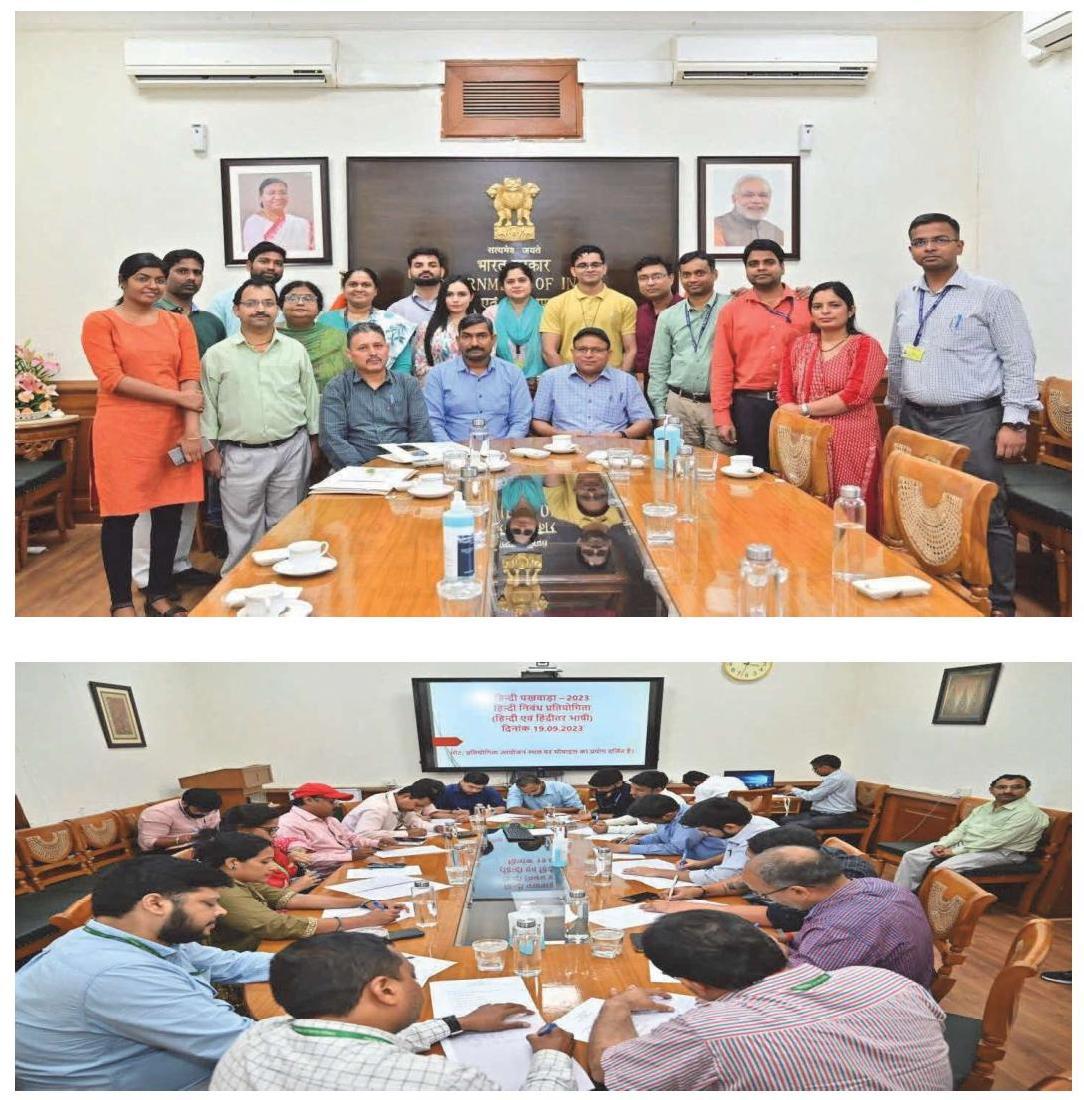
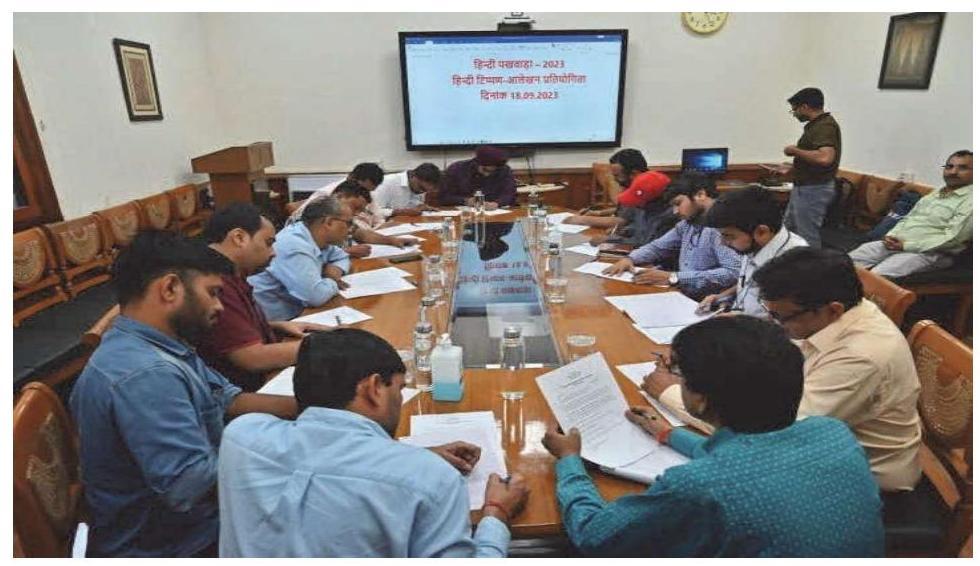
# Stills from competitions held during Hindi Fortnight 2023.
18.7 HINDI IN TRAINING INSTITUTIONS
The two Training Institutions under the Ministry viz. Lal Bahadur Shastri National Academy of Administration (LBSNAA), Mussoorie and the Institute of Secretariat Training and Management (ISTM), New Delhi have made considerable progress in providing the training material in Hindi. In LBSNAA, the teaching material of main subjects are provided in book form and translation of the lecture notes of the topics taken by the faculty members is provided immediately on the demand of trainee officers. Institute of Secretariat Training and Management (ISTM) also has its all the training material available in bilingual form.
18.8 MONITORING AND INSPECTION
The progress made in Hindi for effective implementation of the Official Language Policy is reviewed on the basis of Quarterly Progress Report (QPR) and Annual Assessment Report (AAR). The progress made in the progressive use of Hindi is discussed at length in the quarterly meetings of internal Official Language Implementation Committee in which remedial measures are suggested to remove the shortcomings found.
Besides, Divisions/Sections and the Attached Offices of the Ministry are inspected by Official Language Section of the Department of Personnel and Training in a phased manner and necessary measures are taken and directions are given to overcome the practical difficulties experienced in the course of implementing the Official Language Policy of the Union.
During inspection ways for doing away with the problems faced by the officials in carrying out their works in Hindi are also suggested to give the much-needed fillip and thrust to progressive use of official language Hindi. During the year 2023-24 inspections of 17 internal sections were carried out to take the stock of the progressive use of Official Language.
18.9 RAJBHASHA SHIELD YOJANA
With a view to promote cooperative and competitive feeling and synergy among subordinate offices and headquarters for promoting progressive use of Rajbhasha Hindi in the official work of the Department, an ambitious shield scheme consisting of two parts entitled as Rajbhasha Shield Yojana was launched. The first part is meant for the sections located at
Headquarters under which Rajbhasha Shield would be given to the section using Hindi in its official work at premium with other sections and the officers and employees working there in Hindi would be rewarded. The second part of the scheme is meant for the Subordinate Offices in which provisions have been made to give the Rajbhasha Shield to the Subordinate Office doing its official work in Hindi at premium with any of the Subordinate Offices. During the year under review, Admin-II section of DoPT and LBSNAA, Mussoorie (under subordinate office category) were declared as the winners in their respective segments and were awarded with Rajbhasha Shield and Certificate of Appreciation by Hon’ble MoS, Dr. Jitendra Singh Ji. The yojana has created a spirit of competition and dynamism for progressive use of Official Language Hindi among the officers and employees of the Department.
18.10 $4^{\text {th }}$ Edition of e-Magazine “KAUSHAL”
In a first of its kind initiative, the Department of Personnel and Training started an emagazine christened as “KAUSHAL” to provide a platform to the officers and employees of the Department to make a creative, conducive and positive environment for progressive use of Hindi Language in official work in the year 2018. The initiative is leading to a keen desire among the officers and employees to give vent to their creative urge in Hindi language. Hence, this ambitious initiative is helping create a positive synergy among the officers and employees to do their official work in Hindi which in turn will make public administration more citizen-centric and decentralized with greater active participation of the citizens. It would also make public administration more responsive and accessible with increased popular participation and two-way communication between the Government and the citizens.
This is a progressive step to make Official Language Hindi more popular among the officers and employees of the Department which would go a long way in translating the vision of ‘New India-Atmanirbhar Bharat’ of Government of India into reality by rendering public administration and public service delivery mechanism more inclusive.
The publication of the $4^{\text {th }}$ edition of the magazine is in the wings and the link of the same would be made available on the website of the Department shortly. Now, the E-Magazine is all set to be launched in the month of May, 2024.
CHAPTER 19
FINANCIAL MANAGEMENT
19.1 The provision is for expenditure of the Ministry of Personnel, Public Grievances & Pensions in respect of:
a) Department of Personnel \& Training which is entrusted with the work relating to framing / interpretation of rules and regulations; recruitment, promotion and reservation policy; induction, training and refresher courses for all levels / grades of Civil Services posts; service conditions, career and manpower planning, vigilance, discipline and welfare activities of Central Government servants; investigation and prosecution in corruption cases and other serious crimes; redressal of grievances of public servants.
b) Department of Administrative Reforms \& Public Grievances which is entrusted with matters relating to Administrative Reforms, O\&M and policy, coordination and redressal of grievances including those pertaining to Central Government Agencies; hosting of Civil Service Day, PM’s Award, Chief Secretaries Conference etc.
c) Department of Pension \& Pensioners Welfare which administers all activities relating to retirement benefits including Gratuity, Pension, fringe benefits to pensioners, etc.
19.2 The provision is for establishment-related expenditure of the Central Bureau of Investigation which is entrusted with investigation and prosecution in corruption cases against public servants, private persons, firms and other cases of serious crimes. This also includes provision for various projects such as Modernization of Training Centres of CBI, Establishment of Technical and Forensic Support Units, Comprehensive modernization \& purchase of land/ construction of office/ residence buildings for CBI.
19.3 The provision is for establishment-related expenditure of the Staff Selection Commission including expenditure on the conduct of examinations for recruitment of staff in Central Ministries/ Departments etc.
19.4 The provision is for establishment-related expenditure of the Central Administrative Tribunal which is entrusted with the redressal of grievances exclusively of public servants. This also includes provision for Purchase of Land and Construction of Building for various Benches of CAT.
19.5 The provision includes establishment related expenditure of Institute of Secretariat Training \& Management (ISTM), Lal Bahadur Shastri National Academy of Administration (LBSNAA) \& Training Division, DOPT. These Organizations arrange several training programmes including foundation courses, refresher courses, mid-career training, etc. so as to equip all levels / grades of Secretarial functionaries with adequate exposure to the latest rules and regulations, aptitude etc., expenditure on domestic / overseas travel, course fees etc. in respect of CSS / CSSS officials who are to undergo mandatory training at ISTM as a pre-condition for consideration for promotion to next higher grade have also been included centrally in the budget of this Ministry.
19.6 The provision is for establishment related expenditure of Public Enterprises Selection Board and Central Information Commission.
19.7 The provision is for establishment and construction related Charged expenditure for Lok Pal.
19.8 The provision is meant for reimbursement to State Governments towards House Building Advances paid to All India Service Officers.
19.9 This also includes provision for Training schemes like Training for All, Domestic Funding for Foreign Training, Upgradation of LBSNAA to a Centre of Excellence, Augmentation of Training Facilities at ISTM.
19.10 This provision is meant for National Programme for Civil Services & Capacity Building Mission Karmayogi.
19.11 This also includes Scheme provision for Department of Administrative Reforms \& Public Grievances scheme for Modernisation of Government Offices, Pilot projects on Administrative Reforms which consists of promotion of e-governance, fostering of good governance, learning from success, sevottam etc.
19.12 This includes scheme provision for Department of Pension’s scheme “Pensioners Portal”.
19.13 This also includes Scheme provision for Integrated Building for Institute of Secretariat Training and Management and other Institutes of Department of Personnel and Training.
19.14 This also includes Grants in Aid allocations to Indian Institute of Public Administration and National Centre for Good Governance.
19.15 The provision includes Grants-in-aid assistance to Grih Kalyan Kendra, Central Civil Services Cultural \& Sports Board and National Recruitment Agency.
19.16 This includes fund allocations in respect of DOPT’s Propagation of RTI Act.
19.17 Organisation Wise RE 2022-23\& BE 2023-24 Allocations
Demand No-74, Ministry of Personnel, Public Grievances \& Pensions
(Rs. in crore)
| Sl. No. |
Organisation | Budget Estimates 2023-24 |
Revised Estimates 2023-24 |
Expenditure upto 31.03 .2024 |
Budget Estimates 2024-25 |
|---|---|---|---|---|---|
| $\mathbf{1}$ | M/o PPG\&P | 2207.74 | 2493.70 | 2358.46 | 2328.56 |
| $\mathbf{2}$ | DoPT | 2102.52 | 2367.93 | 2254.33 | 2187.92 |
| $\mathbf{3}$ | D/o AR\&PG | 92.37 | 107.12 | 86.32 | 124.31 |
| $\mathbf{4}$ | D/o Pensions | 12.85 | 18.65 | 17.81 | 16.33 |
Organisation wise details:
(Rs. in crore)
| Sl. No. |
Head | Budget Estimates 2023-24 |
Revised Estimates 2023-24 |
Expenditure upto 31.03 .2024 |
Budget Estimates 2024-25 |
|---|---|---|---|---|---|
| 1 | DOPT Estt. | 144.43 | 176.12 | 148.92 | 202.59 |
| 2 | National
Programme for
Civil Services and
Capacity Building
(NPCSCB) | 105.69 | 86.99 | 86.66 | 86.13 |
| :– | :– | :–: | :–: | :–: | :–: |
| 3 | Training for All
(TFA) | 13.83 | 11.83 | 11.39 | 19.57 |
| 4 | Domestic Funding
of Foreign Training
(DFFT) | 1.00 | 0.03 | 0.02 | 12.00 |
| 5 | LBSNAA | 110.39 | 180.19 | 114.76 | 157.03 |
| 6 | ISTM | 58.46 | 41.59 | 31.28 | 85.51 |
| 7 | IIPA | 24.50 | 28.00 | 28.00 | 15.00 |
| 8 | CBI | 946.51 | 968.87 | 968.15 | 951.46 |
| 9 | CAT | 163.42 | 157.24 | 149.44 | 157.72 |
| 10 | SSC | 399.73 | 569.15 | 617.86 | 418.15 |
| 11 | NRA | 10.10 | 0.00 | 0.00 | 10.00 |
| 12 | PESB | 5.70 | 6.95 | 6.30 | 5.78 |
| 13 | CIC | 26.76 | 30.08 | 28.82 | 33.66 |
| 14 | LOKPAL | 92.00 | 110.89 | 62.73 | 33.32 |
| | DoPT& its offices | $\mathbf{2 1 0 2 . 5 2}$ | $\mathbf{2 3 6 7 . 9 3}$ | $\mathbf{2 2 5 4 . 3 3}$ | $\mathbf{2 1 8 7 . 9 2}$ |
19.18 Major Capital Allocations
(Rs. in crores)
| Sl. No. |
Head | Budget Estimates 2023-24 |
Revised Estimates 2023-24 |
Expenditure upto 31.03 .2024 |
Budget Estimates 2024-25 |
|---|---|---|---|---|---|
| 1. | CBI Projects | 70.14 | 95.43 | 92.43 | 55.12 |
| 2. | CAT Project | 17.75 | 16.07 | 15.43 | 20.27 |
| 3. | Augmentation of Training facilities in ISTM |
5.00 | 0.70 | 0.50 | 1.51 |
| 4. | Integrated Building for ISTM and other Institutes of DoPT |
20.00 | 8.00 | 7.52 | 55.50 |
| 5. | Improvement of infrastructure and upgradation of essential facilities at LBSNAA |
36.79 | 87.48 | 17.06 | 62.88 |
| 6. | National Programme for Civil Services \& Capacity Building: NPCSCB (SPV) |
10.37 | 5.20 | 5.00 | 8.20 |
| 7. | Lokpal | 69.42 | 88.66 | 45.81 | 10.02 |
| 8. | HBA to AIS Officers | 2.00 | 1.00 | 0.63 | 2.00 |
|---|---|---|---|---|---|
| Total | $\mathbf{2 3 1 . 4 7}$ | $\mathbf{3 0 2 . 5 4}$ | $\mathbf{1 8 4 . 3 8}$ | $\mathbf{2 1 5 . 5 0}$ |
19.19 AUDIT OBSERVATION IN RESPECT OF MINISTRY OF PERSONNEL, PUBLIC GRIEVANCES & PENSIONS
19.19.1 Public Accounts Committee
No PAC para is pending in this Ministry.
19.19.2 Comptroller \& Auditor General of India
One C\&AG paras is pending in r/o D/o ARPG.
19.19.3 Statutory Audit Paras
| S.No. | Name of the office | No. of Outstanding paras as on $31 / 12 / 2022$ |
No. of Outstanding paras as on $31 / 12 / 2023$ |
|---|---|---|---|
| 1 | Department of Personnel \& Training |
$\mathbf{2 6}$ | $\mathbf{2 5}$ |
| 2 | Staff Selection Commission | $\mathbf{4 8}$ | $\mathbf{6 0}$ |
| 3 | Union Public Service Commission | $\mathbf{1 4}$ | $\mathbf{9}$ |
| 4 | Institute of Secretariat Training \& Management |
$\mathbf{1 5}$ | $\mathbf{1 5}$ |
| 5 | Department of AR \& PG | $\mathbf{0}$ | $\mathbf{0}$ |
| 6 | Deptt. of Pensions \& Pensioners’ Welfare |
$\mathbf{0}$ | $\mathbf{0}$ |
| 7 | Lal Bahadur Shastri National Academy of Administration |
$\mathbf{9}$ | $\mathbf{1 4}$ |
| 8 | Central Administrative Tribunal | $\mathbf{4 0}$ | $\mathbf{6 1}$ |
| 9 | Central Vigilance Commission | $\mathbf{2 3}$ | $\mathbf{2 4}$ |
| 10 | Central Information Commission | $\mathbf{1 8}$ | $\mathbf{2 5}$ |
| 11 | Central Bureau of Investigation | $\mathbf{1 6 7}$ | $\mathbf{1 9 5}$ |
| Total | M/o PPG\&P | $\mathbf{3 6 0}$ | $\mathbf{4 2 8}$ |
All the concerned authorities have been instructed to take steps for early settlement of the audit objections.
DEPARTMEN
T OF
ADMINISTRATIVE REFORMS
&
PUBLIC GRIEVANCES
CHAPTER 20
DEPARTMENT OF ADMINISTRATIVE REFORMS AND PUBLIC GRIEVANCES
Vision
The Department of Administrative Reforms and Public Grievances defines its vision driving administrative reforms throughout government as well as redressal of all public grievances about public services.
Mission
The Mission of the Department of Administrative Reforms and Public Grievances is excellence in governance and pursuit of administrative reforms, promoting citizen centric governance with emphasis on grievance redressal, e- Governance, Awards and Documentation and Dissemination of Best Practices.
Objectives
Promoting administrative reforms in government policies and processes.
- Formulation of policy and coordination of issues relating to redress of grievances.
- Dissemination of governance knowledge and best practices.
- Promoting reforms through e-Governance.
EXECUTIVE SUMMARY
20.0 The Department of Administrative Reforms and Public Grievances is the nodal agency of the Government of India for administrative reforms as well as redressal of public grievances relating to the States in general and those pertaining to Central Government agencies in particular. The Department endeavors to document and disseminate successful governance practices by way of audio-visual media and publications. The Department also undertakes activities in the field of international exchange and cooperation to promote public service reforms. There are 8Divisions in the Department Namely Administrative Reforms, Organization & Methods, e-Governance, Documentation \& Dissemination, International Exchange \& Cooperation, Administration \& Coordination, Public Grievances and Administrative Reforms Commission (ARC)/e-Office.
20.1 The Department is headed by the Secretary, Department of Administrative Reforms \& Public Grievances and Pensions \& Pensioners’ Welfare. Available Staff Strength is one Secretary, 3 Joint Secretaries, 7 Directors/Deputy Secretaries and 14 Under Secretary level officers in the Department. An organizational chart of the Department is at Annexure-V. Incumbency position of Under Secretary and above level officers is at Annexure-VI. Information regarding steps taken by this Department for Prevention of sexual harassment of women at workplace and welfare of SC, ST, OBC and Persons with Disability (PWD) are at Annexure-VII and Annexure-VIII respectively.
20.2 As per the Government of India Allocation of Business Rules, the following subjects have been allocated to the Department of Administrative Reforms \& Public Grievances:
- Administrative Reforms, including e-governance and dissemination of
best practices.
2. Organization and Methods.
3. Policy, coordination and monitoring of issues relating to –
(a) Redress of public grievances in general; and
(b) Grievances pertaining to Central Government agencies.
(c) Monitoring of implementation of e-Office in Central Ministries / Departments
4. (a) Research in public management;
(b) with State Governments, professional institutions etc. in public management matters.
5. Administration of Central Secretariat Manual of Office Procedure:
PERFORMANCE (2023-24)
| Sl.No. | Objective | Targeted Activities |
|---|---|---|
| 1. | Formulation of policy and coordination of issues relating to redress of grievances. | (1.1) Review of pendency of grievances in Ministries / Departments / Organizations as well as States and UTs |
| (1.2) Training of CPGRAMS to Ministries/Departments. | ||
| (1.3) Capability building of Administrative Training Institutes for improved service delivery in their respective State Government Departments through capacity building. | ||
| (1.4) Universalization of CPGRAMS Reforms version 7.0 in Central Ministries for user friendly and faster grievance redressal. |
||
| (1.5) Integration of State Government portals with CPGRAMS | ||
| (1.6) Process for Setting up permanent Feedback call centre for seeking feedback from the Citizens on disposed of Grievances and also help citizens to file/track their grievances if such help is needed by them. | ||
| (1.7) To leverage strength of Common Service Centers (CSC) to take the facility of CPGRAMS to unconnected rural population and make awareness about CPGRAMS. |
| (1.8) To introduce CPGRAMS in all regional languages, to expand its outreach specially among the rural population and Bhasini Integration. | ||
|---|---|---|
| (1.9) Introduction of Artificial Intelligence (AI)/Machine Learning (ML) tools in the system in partnership with IIT, Kanpur to categories grievances and assess quality of resolution. | ||
| (1.10) To develop a new format of Action Taken Report (ATR). This would provide a matrix for assessment of quality of resolution. | ||
| 2. | Dissemination of governance knowledge and best practices | (2.1) Production of documentary films on good governance practices. |
| (2.2) Publishing of books containing articles on shortlisted and awarded initiatives. | ||
| (2.3) Publication of biannual e-magazine ‘Minimum Government-Maximum Governance’. | ||
| (2.4) Organizing of Regional Conferences | ||
| 3. | State Collaboration Initiative | (3.1) The D&D Section has handled 31 SCI project various States/UTs in the FY 2023-24. |
| 4. | Promoting reforms through e-Governance | (4.1) Organizing National Conference on e-Governance and presenting National Awards for e-Governance |
| (4.2) Publishing of Compendium of select papers on issues of e-Governance, a booklet on excellence in e-Governance, a booklet on citations for National e-Governance Award Winners, and a compilation of conference papers and Development of case studies on e-Governance initiatives | ||
| (4.3) Publishing of National e-Governance Service Delivery Assessment (NeSDA) Way Forward Monthly Report | ||
| (4.4) Convening of the National e-Governance Webinar (NeGW) Series with the awardees of National e-Governance Awards for dissemination of best practices and replication of successful projects driving advancement in e-governance across the nation | ||
| 5. | Transparency/Service delivery in the Department | (5.1) The Citizens’ Charter of Ministries/Departments as well as States/UTs is available on goicharters.nic.in. Review meetings held for updation of Citizens Charters. |
| 6. | Administrative Reforms | (6.1) Prime Minister’s Awards for Excellence in Public Administration. (6.2) Organizing Civil Services Day. (6.3) Development of case studies on best practices. (6.4) Promotion of Administrative Reforms through simplification of procedure such as abolition of affidavits and promotion of self-certification. (6.5) Designing, Developing & publishing Good Governance Index, recommended by Sectoral Group of Secretaries on Governance to present a state-wise comparative picture about the strong and weak areas of service delivery, which would help them in generating performance improvement mechanism. (6.6) Developing District Good Governance Index of States/UTs. |
|---|---|---|
| 7. | Improving Internal Efficiency/Responsiveness. | (7.1) Update departmental strategy to align with Plan priorities/objectives of the Scheme. |
| 8 . | Ensuring compliance to the Financial Accountability Framework | (8.1) Timely submission of Action Taken Notes on Audit paras of C\&AG. (8.2) Timely submission of Action Taken Reports to the PAC Sect. on PAC Reports. |
| 9 . | e-Office Progress | (9.1) All Central Ministries and Departments have migrated to e-Office version 7.0. In April, 2024 e-Receipts accounted for $93.8 %$ of total receipts and e-Files accounted for $94.3 \%$ of the files opened in the Central Government during the month. |
| 10. | National Centre for Good Governance (NCGG) | (10.1) The Centre is envisaged to be the apex think- tank that would guide the Government and help in implementing Good Governance Reforms. |
| 11. | Special Campaign on Disposal of Pendency | (11.1) During the campaign, Total of 2,58,673 cleanliness campaign sites participated in the campaign. 164 Lakh sq.ft. space was cleared from scrap and outlived records and Rs. 556.35 Crore of Revenue was earned. 26.35 Lakh physical files were weeded out. |
20.3 FUNCTIONS
(i) Matters relating to administrative reforms.
(ii) Organization of Civil Services Day and Prime Minister’s Awards for Excellence in Public Administration.
(iii) Capacity building, change management and Government Process Re-
engineering to provide reform through e-Governance.
(iv) e-Office Mission Mode Project under NeGP.
(v) Organization of National Conference on e-Governance and National awards on e- Governance.
(vi) Management of Public Grievance Redressal Mechanism.
(vii) Documentation and dissemination of Good Governance Practices innovations, adaptation and replication.
20.04 PUBLIC GRIEVANCES
20.04.01 An online system for grievance redress, called the ‘Centralized Public Grievance Redress and Monitoring System (CPGRAMS) has evolved since 2007. During the year, the Department has extensively used the System to forward public grievances to both the Central Government Ministries/Departments/Organizations as well as the State Governments concerned. The inflow of both center and State related grievances is in two forms (i) through the CPGRAMS and (ii) through post. The grievances received by post are digitized and sent online through the System as well as by post to the Central Ministries/Departments/Organizations/State / UT Government concerned.
20.04.02 For better monitoring, analytical reports are generated through CPGRAMS as per requirement. The format includes receipts, disposal and $%$ disposals with reference to cases pending for 2-6 months, 6-12 months and more than one year.
20.04.03 Public Grievance Mechanism of PMO available on website www.pmoindia.gov.in has been integrated with the pgportal.gov.in. This enables transfer of grievances lodged to the PMO to the Central Ministries/Departments/Organizations and State Governments and online monitoring of public grievances through CPGRAMS.
20.04.04 The Public interface of CPGRAMS has also been duly integrated with the pensioners’ portal and an option has been provided to the users to lodge pension related grievances to the pensioners’ portal by clicking the relevant option on the pgportal.gov.in.
20.04.05 Public grievance mechanism of PMO, the President’s Secretariat, the Directorate of Public Grievances (Cabinet Secretariat), Department of Administrative Reforms & Public Grievances (DARPG) and that of Department of Pensioners’ portal have been duly integrated through CPGARMS thus enabling grievances lodged to any of these entities to be transferred to the Central Ministries/Departments and State / UTs Governments online through CPGRAMS.
20.04.06 Operational trainings on Centralized Public Grievance Redress and Monitoring System (CPGRAMS) are being held regularly by the Department. The training imparted relates to new features and improvements in CPGRAMS. Problems which are being faced by the nodal Public Grievance Officers during the redressal of grievances are also taken up and resolutions on the same imparted during the training sessions. During the year 2023 DARPG has provided 06 training to all Ministries \& Departments for handling grievances properly on CPGRAMS.
20.04.07 During the period from 2023, 12 intensive review meetings have been held for reviewing the status of pending public grievances in Ministries/Departments/Organizations and expediting action on them.
20.04.08 Introduction of an Appeal Mechanism/functionality in CPGRAMS- The Appeal Mechanism/functionality in CPGRAMS in line with the Department related Parliamentary Standing Committee Recommendations in its 100thReport has been introduced in CPGRAMS. The recommendations were communicated to all Central Ministries/Departments with the request to nominate a Nodal (Appellate) authority. The Appeal provision has been made for redressal of dis-satisfied grievances identified through a mandatory feedback rating to be given by the Citizen on disposal of the grievance by the Nodal Grievance Officers.
In 2022, a 10-step CPGRAMS reforms process was adopted by DARPG for improving quality of disposal and reducing the time lines.
The10-step reforms include:
- Universalization of CPGRAMS 7.0-Auto-routing of grievances to the last mile.
- Technological Enhancements- Automatic flagging of urgent grievances leveraging AI/ ML.
- Language Translation-CPGRAMS Portal in 22 scheduled languages along with English.
- Grievance Redressal Index- Ranking of Ministries/ Departments on their Performance.
- Feedback Call Centre- 50 -seater call center to collect feedback directly from every citizen whose grievance is redressed.
- One Nation One Portal-Integration of State Portal and other GoI portals with CPGRAMS. PMOPG & DPG portals have been successfully migrated to CPGRAMS 7.0.
- Inclusivity and Outreach-Empowering the remotest citizen to file grievances through CSC’s.
- Training and Capacity Building- Conducted by ISTM and State ATIs under SEVOTTAM scheme for enabling effective grievance resolution.
- Monitoring Process – Monthly reports for both the Central Ministries/ Departments and States/UTs.
- Data Strategy Unit – Established at DARPG has developed an analytical dashboard which enables drawing insights, that may be leveraged for strategic decision making and policybased reforms. This automated tool has been rolled out to all the Central Ministries/ Departments.
20.05 Citizens’ Charter
20.05.01 The Department of Administrative Reforms and Public Grievances in its efforts to provide more responsive and citizen-centric governance coordinates the efforts of Ministries / Departments to formulate and operationalize Citizen’s Charters in Central Government Ministries / Departments as well as State Governments and UT Administrations. It provides guidelines for formulation and implementation of the Citizen’s Charters. The Citizen’s/Client’s Charter (CC) was first introduced simultaneously in Central Government Departments and in all State Governments in May, 1997. The Citizen’s Charter of DARPG is being reviewed and the updated version will be uploaded website of the Department as well as on the “goicharters.nic.in”.
20.06 Sevottam
20.06.01 Sevottam is a generic framework for achieving excellence in public service delivery. It comprises of 3 modules namely, Citizen’s Charter, Grievance Redressal Mechanism and Capability Building for Service Delivery. Under the Scheme, DARPG releases funds to State ATIs/CTIs for setting up a Sevottam Training Cell in the ATI. Department of Administrative Reforms \& Public Grievances has developed a dedicated portal for monitoring State/UT ATIs.The National Seminar on Sevottam for Effective Redressal of Public Grievances was held at Yashwantrao Chavan Academy of Development Administration (YASHADA), Pune on 23rd May, 2023.
Important events/achievements of the Department
20.07 Prime Ministers’ Awards for Excellence in Public Administration
Government of India has instituted a scheme “Prime Minister’s Awards for Excellence in Public Administration” in 2006 to acknowledge, recognize and award the extraordinary and innovative work done by the Districts/ implementing units and organizations of Central and State Governments.
20.07.02 Since its inception and till 2015, the awards were conferred under three categories, viz., individual, group and organizations. The structure of the Awards Scheme was changed in 2015-16 to focus on excellence in implementation of identified Priority Programmes wherein the States were grouped in three categories namely; (i) North Eastern and Hilly States; (ii) Union Territories and (iii) Other States. The PM Awards Scheme was restructured in 2020 to recognize the performance of District Collectors towards economic development of the District. The Scheme for Prime Minister’s Awards for Excellence in Public Administration was again revamped in 2021 with the objective to encourage Constructive Competition, Innovation, Replication and Institutionalization of Best Practices. The Award Scheme is now being revamped to recognize the performance of the District Collector through targeted individual beneficiaries and implementation with a saturation approach. Within this in focus, the applications for Awards would be evaluated on three parameters; Good Governance, Qualitative and Quantitative.
20.07.03 Prime Minister’s Awards are awarded by the Hon’ble Prime Minister on Civil Services Day (CSD) held on 21st April of every year. This is an occasion for Civil Servants of the Country to rededicate themselves to citizens and renew their commitment to public service and excellence in work. So far 16 Civil Services Day have been celebrated.
20.08 INTERNATIONAL EXCHANGE AND COOPERATION
20.08.01 The Department works as the nodal point in respect of matters relating to international cooperation in the field of Public Administration and Governance, which includes organizing programmes and visits of the foreign delegations to India and visits of Indian delegations abroad as part of projects / bilateral measures taken up in accordance with the Memorandum of Understandings (MOUs) / Agreements signed between India and other countries (bilateral or multilateral).
20.09 Minimum Government Maximum Governance Initiatives (Implementation of eOffice Mission Mode Project)
e-Office is one of the Mission Mode Projects (MMPs) under the National e-Governance Plan (NeGP). The project is aimed at significantly improving the operational efficiency of Central Government Ministries and Departments through improvement in the workflow mechanisms and associated with office procedure manuals. The DAR&PG is the nodal Department for implementation of “e-office” in Central Government Ministries/ Departments. Effective steps have been taken by DAR\&PG to expedite implementation of e-office in all Central Government Ministries / Departments by conducting regular review meetings and also by establishing a project monitoring unit in the Department. 59 Central Ministries / Departments have already achieved the target of $100 %$ e-office and the rest of the Central Ministries / Departments are also showing improving trends. In the month of April, 2024, E-Receipts accounted for $93.8 \%$ of total receipts and e-Files accounted for $94.3 \%$ of all files in the Central Government. All Central Ministries and Departments have already migrated to eOffice version 7.0. e-Office version 7.0 has several benefits, which include rich user experience, enhanced performance and security, integration with
KMS (Knowledge Management System), rich set of APIs for integration with other extern al applications, redesigned page with simultaneous viewing of multiple documents (while noting/drafting), multiple signing of drafts, and tabbed browsing of files/receipts, seamless exchange of information between departments, enhanced browser compatibility, Audit provision of electronic Files.
20.09.01 Launch of e-Office Analytics dashboard
During the Good Governance Week celebrations held on 19th December, 2023, an eOffice Advanced Analytics Dashboard was launched by Hon’ble MoS Dr. Jitender Singh. eOffice Advanced Analytics dashboard facilitates in-depth data analysis & strengthens decision making in the Central Secretariat. It also helps as a tool to validate the extent of digitization and delayering in the Central Secretariat. It allows monitoring the e-files and p-files statistics levels of file movement statistics, inter-ministerial file movement statistics, statistics of e-Receipts out of total receipts, File Signing Status using DSC/E-Sign and VPN usage.
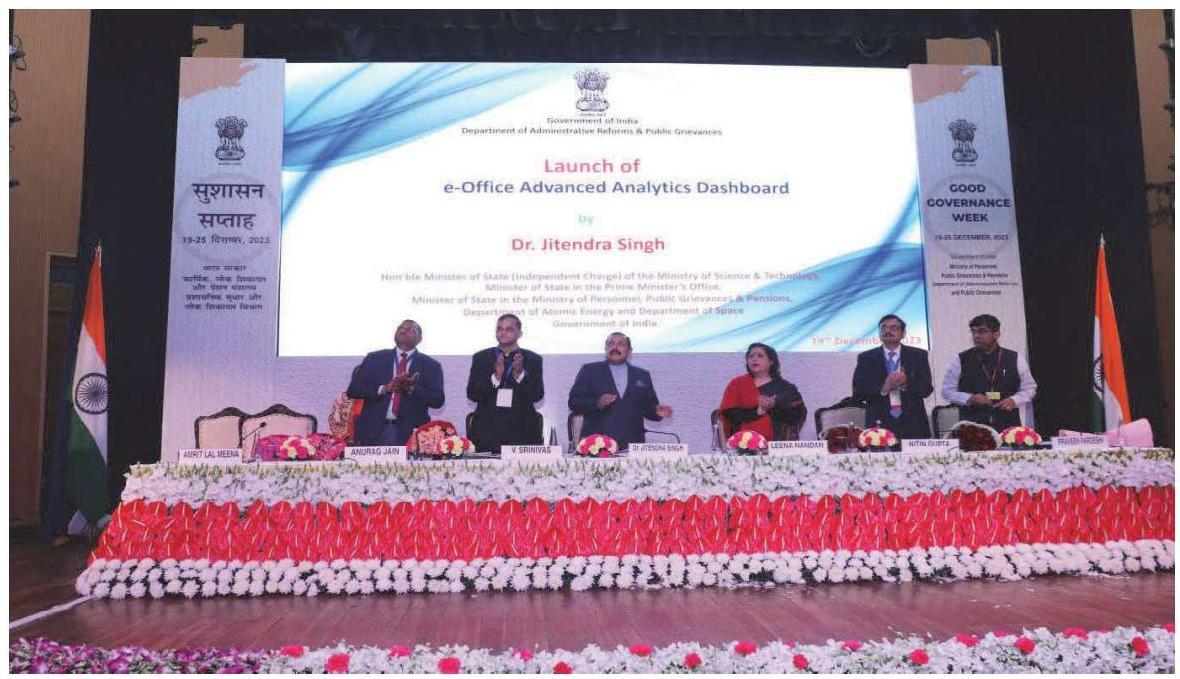
Hon’ble MoS Dr. Jitender Singh launching the eOffice Analytics during the Good Governance Week (Sushasan Saptah) celebrations on 19th December 2023 at New Delhi.
20.10 Promoting Documentation and Dissemination of Good Governance
Initiatives
The Documentation and Dissemination Division of the Department primarily carries out the activities of documentation and dissemination of good governance practices of Central and State Governments and Union Territory Administration with a view to facilitate sharing of experience with one another and replication elsewhere.
This Department brings out its e- Magazine titled ‘Minimum Government – Maximum Governance’ (MGMG) as an e-Book in its endeavors to document and disseminate successful good governance practices. In the e- Magazine, write-ups based on the shortlisted initiatives of PM Awards and National e- Governance Awards instituted by DARPG have been compiled and published on the website of the Department in e-Book form biannually.
20.11 Promoting e-Governance ( National Conference on e-Governance and National e- Governance Awards)
20.11.1 National e-Governance Awards, National e-Governance Service Delivery Assessment (NeSDA), NeSDA-Way Forward and E-Gov. Web series
20.11.2 Promoting e-Governance (National Conference on e-Governance and National eGovernance Awards) The Department of Administrative Reforms & Public Grievances along with the Ministry of Electronics and Information Technology, in association with one of the State/UT Governments, has been organizing the National Conference on e-Governance every year since 1997. This Conference provides platform for the senior officers of the Government including IT Secretaries of State Governments, IT Managers of the Central Government, and resource persons, experts, intellectuals from the industry and academic institutions, etc. to discuss, exchange views and experiences relating to various e-Governance initiatives. National Awards for e-Governance are also presented during the Conference for excellence in e-Governance.
20.12 Compliance of Cyber Security Guidelines:
20.12.1 Unified Endpoint Management (UEM) is a solution used for managing the user endpoints taking care of their day-to-day administration. This helps in maintaining the near realtime software and hardware inventory of the endpoint thus defining the scope and attack surface of the endpoints. It helps in deployment of period operating system updates. It also helps in the installation, update and removal of 3rd party software like browsers, document editors, PDF readers etc. UEM is a suitable replacement for Active Directory as it can manage endpoints w.r.t. policies and controls without any access to user data on the endpoint. It can also be used for various tasks including hardening using scripts.
20.12.2. Endpoint Detection and Response (EDR) is the next-gen endpoint security tool which protects the user endpoints like desktop and laptop from new age cyber threats and attacks. It enables users to use their devices with confidence by off-loading the security of their endpoints to the data and algorithm driven artificial intelligence and machine learning systems. The most common components of a comprehensive EDR solution are signature-based detection, behaviorbased detection, host firewall / intrusion prevention system, application and device control, vulnerability assessment, remote incident response and threat hunting. These features take of the overall security of the endpoints. The centralized management and reporting of EDR helps specialist security analysts stationed at Security Operations Center (SOC) to proactively monitor and manage security threats and attacks on user endpoints without compromising their privacy or data.
As per compliance of Network Security Guidelines, UEM \& EDR have been installed in the Desktops/Laptops in the department. Comprehensive Security Audit of Software Applications is in the process at the department.
CHAPTER 21
ADMINISTRATIVE REFORMS
Civil Services Day and Prime Minister’s Awards Scheme for Excellence in Public Administration
21.1 The Government of India celebrates April, 21 every year as ‘Civil Services Day’ for the civil servants to rededicate themselves to the cause of citizens and renew their commitment to public service and excellence in work. The first such function was held in Vigyan Bhavan, New Delhi on 21st April, 2006. On the occasion, the Hon’ble Prime Minister confers “Prime Minister’s Awards for Excellence in Public Administration” to acknowledge, recognize and award the extraordinary and innovative work done by officers of the Central and State Governments including Districts. This date coincides with the date when the first Home Minister of Independent India Sardar Vallabhbhai Patel addressed the first batch of Indian Administrative Services Officers at Metcalf House, New Delhi. Technical sessions on governance related subjects, exhibitions, release of books and documentaries are part of the event, which is attended by Ministers and senior bureaucrats of the country.
21.1.1 In 2023, the $16^{\text {th }}$ Civil Services Day function was held in Vigyan Bhawan, New Delhi on $20^{\text {th }}-21^{\text {st }}$ April, 2023, on the theme “VIKSIT BHARAT-Empowering Citizens. & Reaching The Last Mile” The Hon’ble Prime Minister graced the occasion on $21^{\text {st }}$ April and conferred the Prime Minister’s Awards for Excellence in Public Administration 2022 for effective implementation of identified Priority Programmes and Innovation to districts/ implementing units and other Central/ State organizations. 15 awards were conferred by the Hon’ble Prime Minister to recognize the extraordinary and innovative work done by Ministries/Departments of the Central and State Governments and Districts.
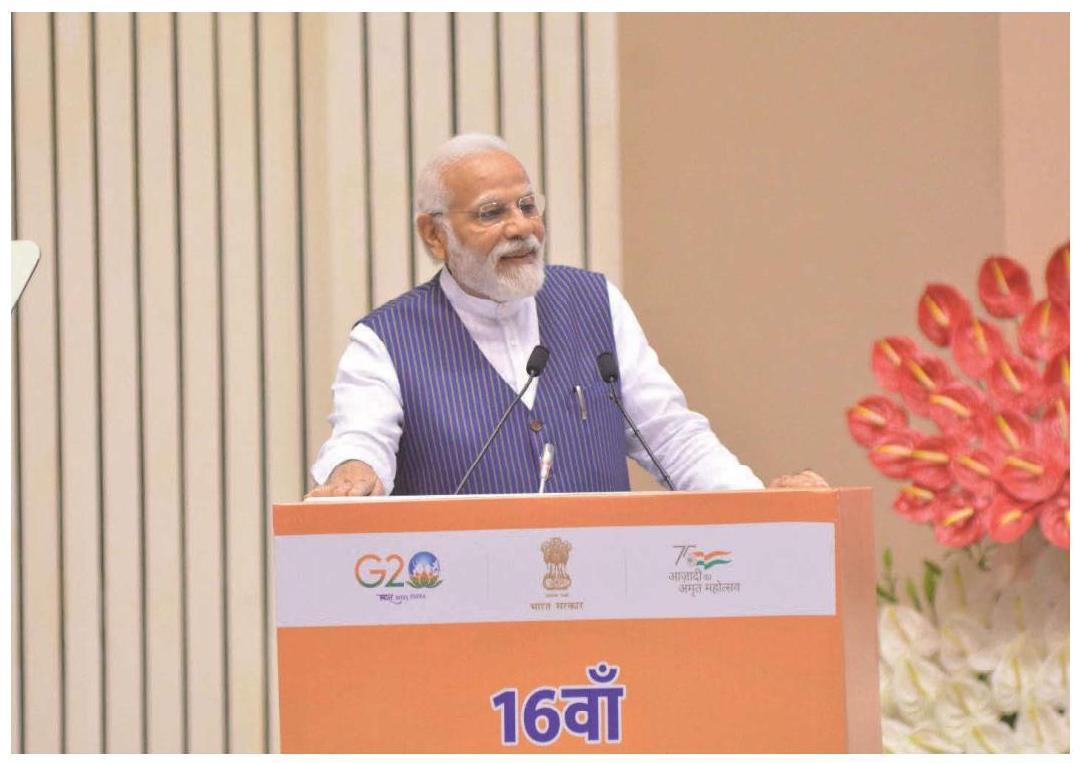
Hon’ble Prime Minister addressing the CSD 2023 event
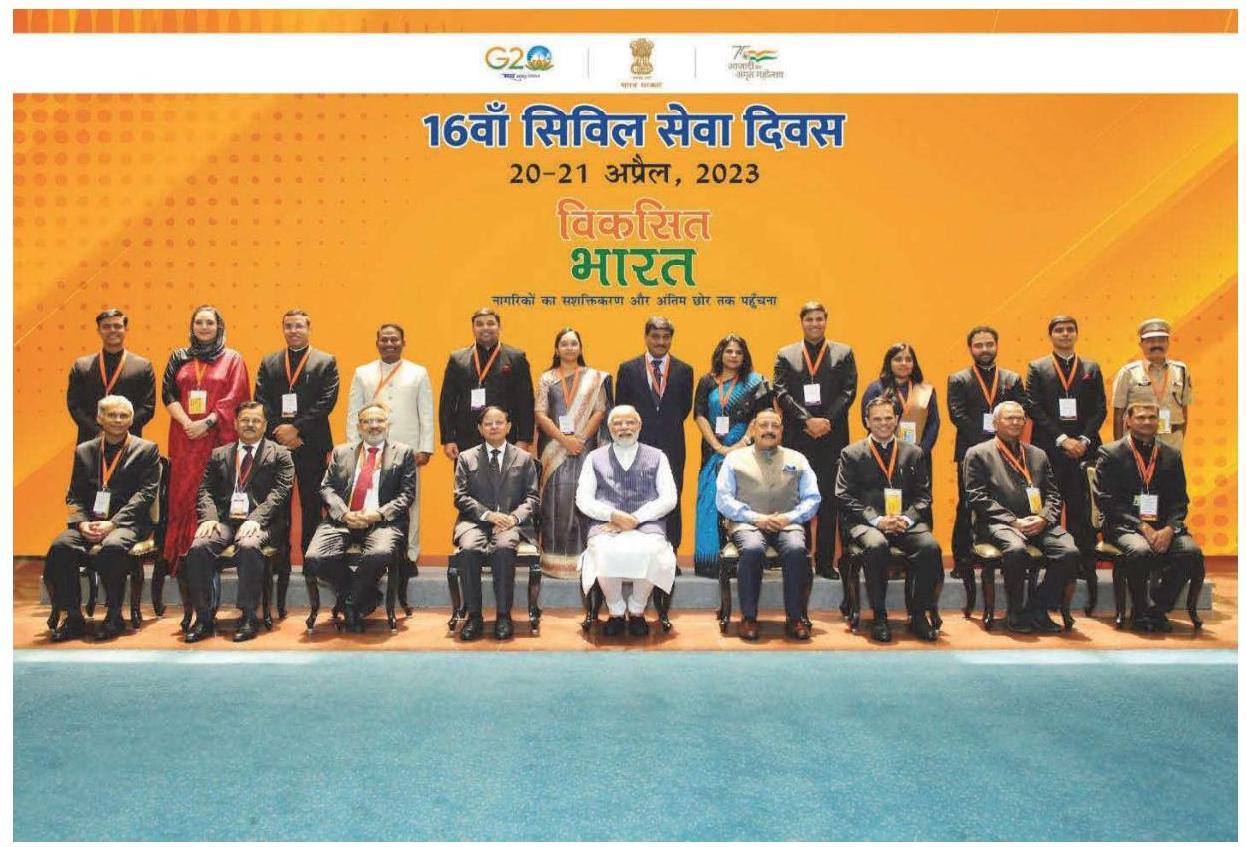
Ceremonial Photographs of the recipients of Prime Minister’s Awards 2022 with Hon’ble Prime Minister
21.2 Prime Minister’s Awards for Excellence in Public Administration’ 2023:
21.2.1 The Scheme for Prime Minister’s Awards for Excellence in Public Administration was revamped in 2021 with the objective to encourage Constructive Competition, Innovation, Replication and Institutionalization of Best Practices. For the year 2023, the Scheme for PM’s Awards for Excellence in Public Administration has been approved to recognize the contribution of civil servants in the holistic development of Districts under the following schemes: –
Category -1- Holistic Development of Districts under 12 priority sector programmes..
Category 2: Innovations for Central Ministries/Departments, States, Districts.
21.2.2 Awards – The total number of awards under the Prime Minister’s Awards for Excellence in Public Administration 2023 is 16 and the Award consists of a (i) trophy, (ii) scroll and (iii) an incentive of Rs. 20 lakh to the awarded District/organization to be utilized for implementation of project/ programme or bridging resource gaps in any area of public welfare. There are 10 awards under Category 1-Holistic Development of Districts and a total of six Awards will be presented under Category 2-Innovation Category, two awards each for Central, State level organisations and Districts.
21.2.3 Applications for Prime Minister’s Awards are received online on a designated portal and are evaluated by three hierarchical Committees. The shortlisting of applications is done by Screening Committees chaired by the Additional Secretary level officers, Expert Committee chaired by Secretary, Department of Administrative Reforms & Public Grievances and the Empowered Committee chaired by the Cabinet Secretary. The Empowered Committee then makes its recommendations for the consideration of the Hon’ble Prime Minister for final selection of the Awards.
21.2.4 There has been an overwhelming and unprecedented participation in the Prime Minister’s Awards 2023. Out of total 783 Districts of the country, 754 Districts have registered for the Prime Minister’s Awards, with a total of 1216 nominations were received on the PM Awards portal.
21.2.5 The meetings of the Screening Committee for First and Second Stage Evaluation of applications have been concluded for consideration of the Expert Committee. The awards will be conferred on the date to be decided by Government of India.
21.3 State Collaboration Initiatives
DARPG provides funds to the State Governments under the scheme “State Collaboration Initiatives” with a purpose to build collaboration with State Governments for improving public service delivery. The scheme was revised in 2015-16 to include funding for replication of PM awarded and National e-Governance awarded initiatives. The objective of the State Collaboration Initiative is to promote and support improvement in public administration for improving service delivery through a programmatic approach which will:
i. Develop collaborative relationships with Central Ministries, States and other stakeholders.
ii. Develop a coherent program of initiatives which will support and encourage administrative reform and put citizen at center stage, particularly the poor.
iii. Build capacity at district, state and center to ensure optimal use of systems and resources
21.4 National Centre for Good Governance (NCGG)
21.4.1 The National Centre for Good Governance (NCGG) was set up in the year 2014 by the Government of India as an apex-level autonomous institution under the aegis of Ministry of Personnel, Public Grievances and Pensions. The Centre traces its origin to the National Institute of Administrative Research (NIAR), which was set up in 1995 by the Lal Bahadur Shastri National Academy of Administration (LBSNAA). NIAR was subsequently rechristened and subsumed into NCGG. DARPG is the administrative Department for NCGG since 08.11.2017.
21.4.2 NCGG deals with a gamut of public policy and governance issues from local, state to national levels, across all sectors. The Centre is mandated to work in the areas of good governance, policy reforms, capacity building and training of civil servants and technocrats of India and other developing countries. It also works as a think tank for governance and Policy Reforms.
21.4.3 The affairs of the NCGG are managed under the overall superintendence and direction of the Governing Body, which is headed by the Cabinet Secretary. It has Secretaries of 9 Ministries/ Departments and provision of 5 eminent persons viz. academicians, eminent administrators, specialists, eminent innovators, and heads of reputed institutions as members. The Director General who is the Chief Executive of NCGG acts as the Member-Secretary of the Governing Body. The 3rd Governing Body meeting was held on September 9, 2022. There is a Management Committee headed by the Secretary, DARPG to guide the NCGG in its work to achieve the stated
objectives. 10 meetings of the Management Committee have been held. The 10th meeting was held on 12th April, 2024
21.5 Mandate of NCGG
(i) Promote Governance and policy reforms;
(ii) Design and conduct capacity building and training programmes for International as well as domestic civil servants;
(iii) To promote sharing and replication of innovative ideas and best practices in Governance;
(iv) Collaborate with several developing countries to foster the exchange of information, knowledge, ideas, and expertise in governance;
(v) Publish reports, case studies, monographs, and best practices in various important sectors; and
(vi) Tap into modern communication technologies and outreach for citizen-centric governance.
21.6 Activities of the NCGG
Capacity Building Programmes: Over the years, NCGG has created a niche for itself in the field of capacity building and leadership development programmes. The Ministry of External Affairs has identified NCGG as a key institution for developing and conducting highly customized capacity development programmes for the civil servants and technocrats of other developing countries. Similarly, NCGG is asked by the Government of India to organize specialized programmes for domestic civil servants and technocrats. The capacity building programmes conducted by NCGG are in the following two categories:
A. International programmes: During the year, NCGG developed and imparted customized capacity building programmes to 1169 civil servants of 10 countries in 31 batches.
i) Bangladesh: In 2013, NCGG was mandated to train 1,500 civil servants of Bangladesh by the Ministry of External Affairs. Following the successful training of 1,500 civil servants, the Ministry of Public Administration, Government of Bangladesh signed an MoU with the National Centre for Good Governance on February 11th, 2019, to train another 1,800 civil servants of Bangladesh in next six years. Under this agreement, NCGG has conducted Capacity Building Programmes for 25 batches by covering the training of 983 Bangladesh civil servants. During the year 2023- 24, 14 batches comprising 601 civil servants from the Republic of Bangladesh received training. NCGG has trained 2600 civil servants of Bangladesh up to March 2024.
ii) Maldives: During the official state visit of Hon’ble Prime Minister Shri Narendra Modi on June 8th, 2019, India and Maldives signed a memorandum of understanding (MoU) to implement a Capacity Building Training Programme (CBTP) for 1,000 civil servants of Maldives over the next 5 years. Subsequently, NCGG has successfully conducted 32 capacity building programmes, which include one programme for high level delegation and two specialized programmes for Anti-Corruption Commission (ACC), Maldives and for
Information Commission Office of Maldives (ICOM). In the year 2023-24, 369 civil servants from the Republic of Maldives have received training in 11 batches. NCGG has trained 1005 civil servants of Maldives up to March 2024.
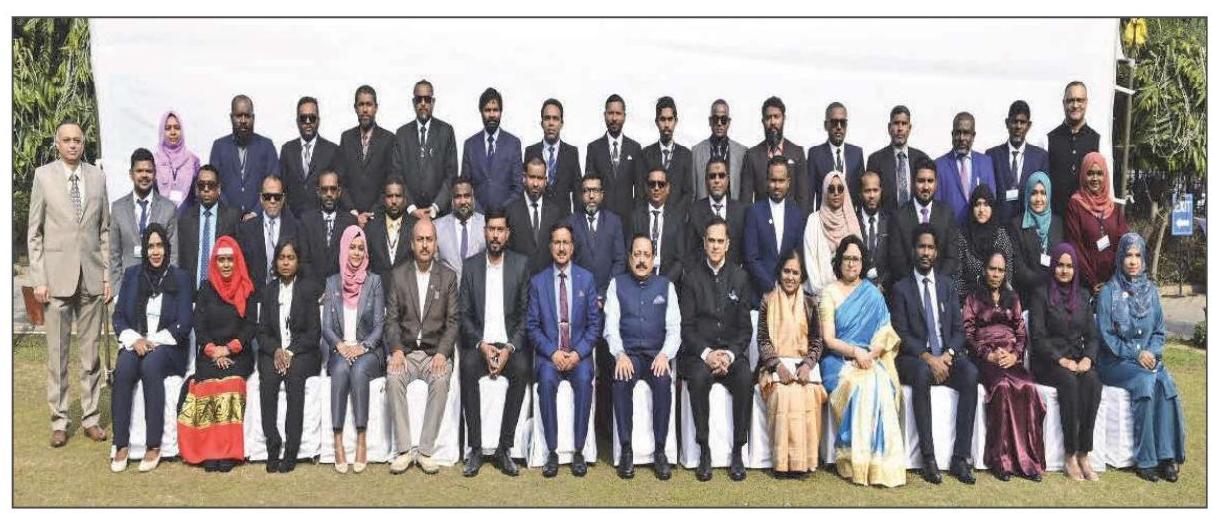
29th Training Programme for the Civil Servants of Maldives
iii) Sri Lanka: The first executive batch of the special capacity building program for senior civil servants of Sri Lanka organized by the National Centre for Good Governance (NCGG) successfully completed today at New Delhi. The program was organized from 12th February 2024 to 17th February 2024. The program was attended by fourteen senior civil servant officers from Sri Lanka led by Secretary to the Prime Minister of Sri Lanka, Mr. Anura Dissanayake and included senior officials representing key departments and ministries such as Dr. Dharmasri Kumaratunga, Secretary, Ministry of Technology; Mr. Pradeep Yasarathna, Secretary, Ministry of Public Administration, Home Affairs, Provincial Councils and Local Government; Mr. Nalaka Kaluwewe, Director General, Sri Lanka Institute of Development Administration (SLIDA) among others.
The Capacity Building Program was addressed by the Minister of State for Personnel, Public Grievances and Pensions Dr. Jitendra Singh, Secretary Ministry of Electronics and Information Technology, Secretary Department for Promotion of Industry, and Internal Trade (DPIIT), Secretary Road Transport and Highways, CEO National Health Authority, CEO Government e-Marketplace, CEO UIDAI, Member Niti Ayog, Member Lok Pal, Secretary to the Central Vigilance Commission, Secretary Capacity Building Commission who shared their leadership experiences.
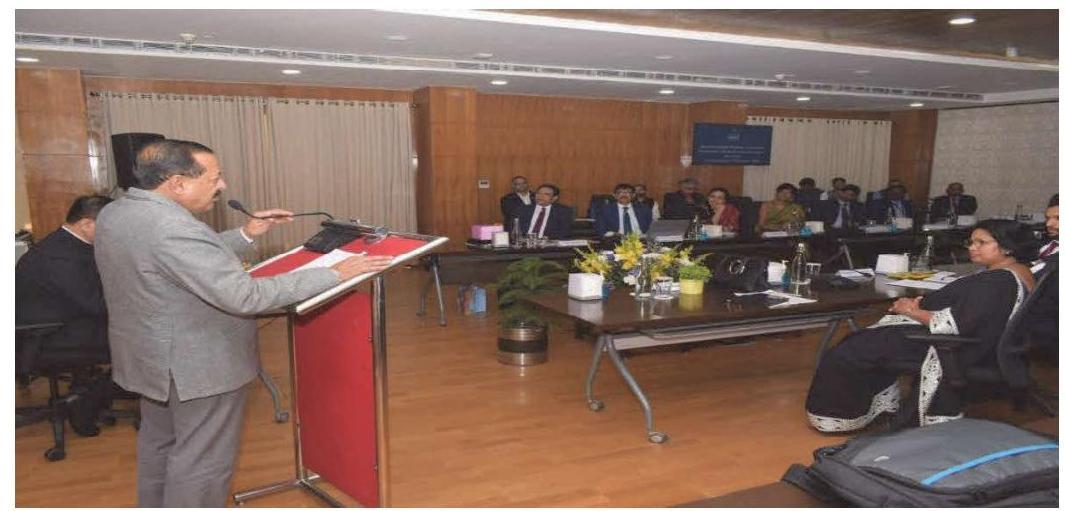
Honorable Minister of State for Personnel, Public Grievances and Pensions Dr. Jitendra Singh addressing to the senior Civil servants of Sri Lanka.
The two week 2nd capacity building program for the civil servants of Sri Lanka organized by the National Centre for Good Governance (NCGG) in partnership with the Ministry of External Affairs (MEA) concluded on 8th March ,2024. 40 Officers serving as Directors, Deputy Directors, Municipal Secretaries, Divisional Secretaries, Assistant Divisional Secretaries, Deputy Commissioners, Deputy Land Commissioners, Provincial Directors, Assistant Chief Secretary, Provincial Sport Director among others attended the program held at Mussoorie and New Delhi. The Capacity Building Programs for Sri Lanka Civil Servants are being conducted under the ITEC program of Ministry of External Affairs. Total 54 civil servants of Sri Lanka were trained by NCGG during 2023-24.
iv) Gambia: The National Centre for Good Governance, in collaboration with the Department of Administrative Reforms & Public Grievances and the Ministry of External Affairs, conducted a one-week capacity-building programme on public policy and governance for 30 senior civil servants of Gambia from 18-23 September,2023. In addition, 25 Civil servants from Gambia also participated in the ALDP on Public Policy and Governance for the civil servants of African region. During 22-23, total 55 Civil servants of Gambia have been trained by NCGG. The programme was specially designed to equip decision- makers in Gambia’s civil service, such as Permanent Secretaries, their deputies, Secretaries, and Generals, with the latest knowledge, skills, and tools to create effective public policy in an increasingly complex and interdependent world. The training aimed to promote good governance and sustainable development while providing cross- country exposure to avoid duplicating efforts. NCGG has trained 148 civil servants of Gambia up to March 2024.
v) Cambodia: The National Centre for Good Governance (NCGG) has been conducting Capacity Building Programme on Public Policy and Governance for the Civil Servants of Cambodia in association with Ministry of External Affairs (MEA). The NCGG has so far successfully conducted 4 programmes covering a total 156 Civil Servants from Cambodia during the year 2023-24. An MoU was signed between the Ministry of Civil Services of the Kingdom of Cambodia and Ministry of Personnel, Public Grievances and Pensions, Government of India on Cooperation in the Field of Human Resource Development in the Civil Services on 22nd April, 2024 for a period of 5 years.
ii) Advanced Leadership Development Programme on Public Policy and Governance for Civil Servants of the African Region
A Two-week Advanced Leadership Development Programme on Public Policy and Governance for Civil Servants of the African Region on 2-01-2024 that was organised for the first time
by NCGG. 34 senior officers working under various capacities were part of the programme from five countries, namely Eritrea, Kenya, Ethiopia, Tanzania, and Gambia.
B. National programmes: During 2023-24, capacity building programmes for 5 batches of 176 officers from Jammu & Kashmir and Arunachal Pradesh was organized by the NCGG.
Details are as under:
i.) Jammu \& Kashmir
In pursuance of the decisions announced by the Union Minister of State (Independent Charge) Development of North Eastern Region (DoNER), MoS PMO, Personnel, Public Grievances, Pensions, Atomic Energy and Space, Dr. Jitendra Singh during the Regional Conference on Replication of Good Governance Practices held on 1st – 2nd July, 2021 at Srinagar, an MoU has been signed between J\&K Institute of Management, Public Administration \& Rural Development (J\&KIMPARD) and NCGG to train 2,000 senior officers of Jammu \& Kashmir on public policy \& good governance. During the year 2023-24, 114 civil servants in 3 batches from Jammu \& Kashmir received training at NCGG, taking the total number of civil servants trained up to March, 2023 to 272 .
ii.) Arunachal Pradesh
On 18th August 2022, an MoU was signed between the Department of Administrative Reforms \& Public Grievances, Government of India; the Department of Administrative Reforms, Government of Arunachal Pradesh, and the National Centre for Good Governance to train 500 senior officers of the Government of Arunachal Pradesh. During 2023-24, NCGG imparted training to 62 officers of Arunachal Pradesh in 2 batches. The total number of civil servants trained by NCGG March 2024 to 113
22. National Good Governance Webinar Series (NGGWS)
The Department of Administrative Reforms and Public Grievances has initiated a unique initiative of organizing National Good Governance Webinar Series on a monthly basis from April 2022, which has been very popular amongst practicing administrators. Very large participation has been observed in the 20 Webinars held up to April 2024.
The Hon’ble Vice President of India released the compendium of the National Good Governance Webinar Series on 20th April 2023 in the inaugural session of Civil Services Day events 2023.
The speakers present their exemplary work in these National Webinars on their PM Award winning initiative and highlight the best practices adopted by them for replication by other States/Districts. Doing so would also infuse a new spirit and enthusiasm among administrators and other stakeholders involved in the implementation of different government programmes. These webinars covering Initiatives help in broadening of skills, dissemination of best practices as well as in replication of best practices.
During 2023-2024, the Department of Administrative Reforms and Public Grievances, in collaboration with National Centre for Good Governance (NCGG), organized a series of National Good Governance webinars. These webinars focused on various themes under the good governance initiative, which had been recognized with the Prime Minister’s Award for Excellence in Public Administration. The webinars encompassed a range of areas such as public grievances, health, education, environment, sports-Khelo India and social sectors, where states had been awarded for their exceptional work. The primary objective of these webinars was to disseminate best practices and award-winning achievements as examples for other states to emulate.
Table:PM’s Award-Winning Initiatives Webinar
| S. No. |
Categories/ Initiatives |
Date | Speakers |
|---|---|---|---|
| 1. | Redressal of Public Grievances | 28th April, 2023 | 1.Shri Ravinder Kumar, Secretary to HLG, Ladakh 2.Dr. Vinod R. Rao, Secretary (Primary and Secondary Education), Gujarat |
| 2. | Innovation at District Level | 26th May, 2023 | 1. Shri Ravindra Kumar Mander, DM, Rampur, UP 2. Shri Sunny K. Singh, DC, Changlang, Arunachal Pradesh |
| 3. | Education- Samagra Shiksha | 30th June, 2023 | 1.Shri Abhishek Anand, DM, Chitrakoot, UP 2.Shri M. Nagarajan, DC, Mahesana, Gujarat |
| 4. | Innovation at District Level | 28th July, 2023 | 1.Shri Navneet Singh Chahal, DM, Chandauli, UP 2.Ms. Tejaswi Satpute, SP, Solapur, Maharashtra |
| 5. | Aspirational District Programme | 31st August, 2023 | 1.Dr Syed Sehrish Asgar, DC, Baramulla, Jammu & Kashmir 2.Shri Karn Satyarthi, DC, Gumla |
| 6. | Health- Ayushman Bharat- Health \& Wellness Centres |
27th October, 2023 | 1.Shri Prithviraj B. P, DC Latur, Maharashtra 2.Shri Ravi Pattanshetti, DC, Anakapalli, Andhra Pradesh |
| 7. | Innovation at District Level | 28th November, 2023 | 1.Shri Kundan Kumar, DM, West Champaran, Bihar 2.Dr. M.S. Lakshmi Priya, Mission Director, National Health Mission, Assam |
| 8. | Sports- Khelo India | 31st January, 2024 | 1.Shri Sidharth Sihag, JS to Chief Minister (the then DC, Churu) Rajasthan 2.Shri Lourembam Bikram, DC, Bishnupur, Manipur |
21.3.1 Good Governance Week (GGW)
The Good Governance Week 2023 (Third Sushasan Saptah) event was successfully held in Dr. Ambedkar International Centre on 19th December 2023 with Dr. Jitendra Singh, Hon’ble Minister of State for Personnel, Public Grievances and Pensions as the Chief Guest. The Hon. Minister also inaugurated the Exhibition on Best Practices of various Ministries/Departments during Special Campaign 3.0 in which 25 Ministries/Departments installed their panels.
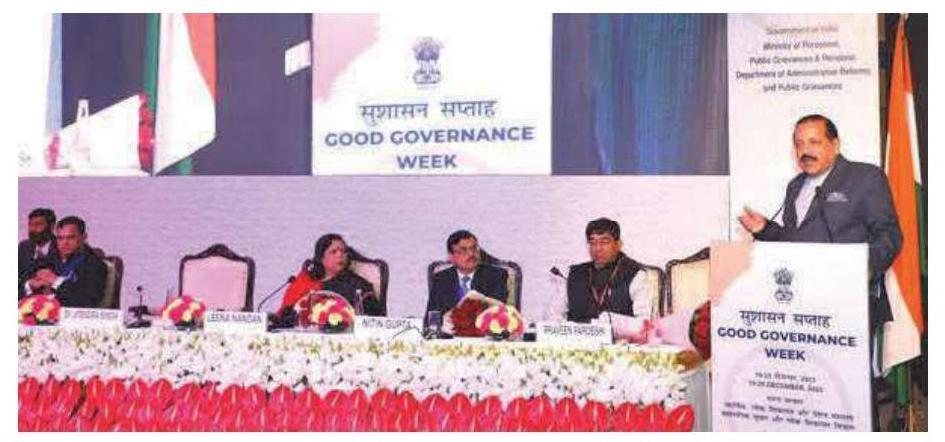
The Hon’ble Prime Minister extended his greetings and best wishes for the success of the $3^{\text {rd }}$ Sushasan Saptah. In his message the Prime Minister said “In the Amrit Kaal,we are guided by the principles of Panch Pran.” He also said that ‘The year still 2047 are an opportunity to realize the vision of building a strong, inclusive and developed India. ForIndia’Yahi samay hai ,sahi samay hai’.”
The Message of Hon’ble Prime Minister for Good Governance Week 2023 was also displayed in the Exhibition. The Hon. Minister released/launched the following documents/app on 19/12/2023:
a) Journey of 25 Regional Conferences from 2014 to 2023
b) Annual Report of CPGRAMS 2023
c) CPGRAMS Mobile App
d) Coffee Table Book on Special Campaign 3.0
e) e-office Advanced Analytics Dash Board
The Special Campaign 3.0 outcomes were presented before the Ministries in the inaugural event of Good Governance Week. Secretary M/o Road Transport & Highways, Secretary M/o Environment, Forests \& CC, Secretary, M/o Coal and Chairman, CBDT addressed and presented the work done during the Special Campaign3.0in their Ministries/Organizations. Addl. Chief Secretary, Government of Uttar Pradesh presented Govt. of Uttar Pradesh’s initiative on streamlining recruitment process focusing on transparency and Addl. Chief Secretary Government of Maharashtra presented Govt. of Maharashtra’s good governance practices in the State secretariat. Member, Capacity Building Commission presented the draft National Capacity Building Plan.
The event was attended by more than 1000 participants physically and by more than 1200 participants through web link. More than 15 Secretaries of the Government of India attended the event. 35 States/UTs also attended the event, including at the level of Addl. Chief Secretaries.
21.3.2 Good Governance Index (GGI)
In pursuit of the recommendations made by the Group of Secretaries (GoS) on Governance, for developing of an index to gauge the performance of the States, the Department of Administrative Reforms & Public Grievances (DARPG), in collaboration with Centre for Good Governance Hyderabad as technical partner, designed and developed the Good Governance Index (GGI) framework. GGI is a comprehensive and implementable framework to assess the state of governance across the States and UTs which enables ranking of States/UTs.
The key objective is to create a tool which can be applied uniformly across the States/UTs to assess impact of various interventions taken up by the Central and State/UT Governments. GGI provides a comparative picture among the States/UTs while developing competitive spirit for improvement. In selecting the sectors for GGI, the focus was on citizens centric approach and on consensus through extensive consultations at national and state-level.
The 10 sectors of GGI are (1) Agriculture and Allied Sectors, (2) Commerce \& Industry, (3) Human Resource Development, (4) Public Health, (5) Public Infrastructure \& Utilities, (6) Economic Governance, (7) Social Welfare \&Development, (8) Judiciary \& Public Safety, (9) Environment, and (10) Citizen- Centric Governance.
The performances all States/UTs in each of these sectors are assessed on the basis of indicators. The data points for indicators are selected on the basis of its availability across States/UTs and its authenticity. The first GGI was released in 2019, the second GGI was released in 2021 and the $3^{\text {rd }}$ GGI 2023 has been prepared and shall be released soon.
21.3.3 District Good Governance Index (DGGI)
To foster good governance at the District-level, on the lines of GGI, the government has developed and released customized District Good Governance Index (DGGI). DGGI is aimed to assess the state of governance in all Districts based on certain Sectors and selected Indicators enabling ranking of all Districts across the nation and present a comparative picture. The ranking would bring about healthy competition amongst Districts in the quest to provide citizen centric administration and governance. District Good Governance Index (DGGI), a next generation administrative reforms in benchmarking governance at district level is a key initiative of DARPG.
The framework for design and development of a District Good Governance Index (DGGI) was evolved and State/UT-specific DGGIs are released for ranking of districts in the respective State/UT.In furtherance of the achievement of releasing for Jammu \& Kashmir, in 2023-24 DARPG released DGGIs for the States of Arunachal Pradesh, Gujarat Uttar Pradesh and Maharashtra train collaboration with the State Governments concerned. The initiative of ranking performance has now been further penetrated to the block level through Block Level Good Governance Index (BGGI) and the first BGGI Chattarpur District on a pilot basis State Collaboration Initiatives.
CHAPTER 22
The Public Grievances Division is responsible for issuing policy guidelines and coordinating & monitoring of issues regarding redress of public grievances for the Central Government. In accordance with federal principle of governance, the grievances relating to States are forwarded to concerned State Government for appropriate action. To provide a more responsive and citizen-centric governance, the PG Division coordinates efforts to formulate and operationalize the Citizen’s Charters of various Ministries/Departments and State and UT Governments. The PG Division also handles Sevottam which is a part of a citizen-centric quality management framework for better service delivery.
Public Grievances
22.1 The Allocation of Business Rules, 1961, allocates to DARPG inter alia, the responsibility for Policy, Coordination and Monitoring of issues relating to (a) Redress of Public Grievances in general and (b) Grievances pertaining to Central Government Agencies, in particular. The Public Grievance Division is responsible for this activity since December 1987. From 1997, the Division has also been made responsible for several Citizen-Centric Initiatives under the platform of ‘Responsive Government’. These include Citizens’ Charter, and Sevottam, for bringing improvement in public service delivery on a continuous basis.
22.2 The management of Public Grievances today envisages reduction in grievances, by bringing continuous improvement in Public Service Delivery and in the Public grievance redressal system.
22.3 The Public Grievances Division has undertaken various activities during the year, some of which are on-going activities from the previous years, to improve the grievances redressal mechanism and to provide citizen-centric governance.
22.3.1 CPGRAMS – An online system for grievance redress, called the ‘Centralized Public Grievance Redress and Monitoring System’ (CPGRAMS) has evolved since 2007. CPGRAMS facilitates forwarding of public grievances received online from the citizens to both the Central Government Ministries / Departments / Organizations as well as the State Governments concerned. The inflow of these Centre and State related grievances are in two forms (i) online registered grievances through CPGRAMS and (ii) offline grievances received through post. The grievances received through post are digitized, uploaded on CPGRAMS and forwarded online through the System as well as by post to the Central Ministries/Departments / Organizations / State Government concerned. At present, the Department has undertaken CPGRAMS Reforms in the top grievance receiving Ministries / Departments. The CPGRAMS reforms envisages to ensure user friendly lodging of grievance by a citizen and enable navigation of the grievance to reach the field office responsible for resolution of the same. CPGRAMS Reforms will streamline grievance redressal mechanism so that the grievances reach the rightful redressal Office, surpassing the line offices. The broader salient features of the CPGRAMS Reforms 7.0 are that it is citizen friendly as there is a questionnaire guided registration process. Besides, there is a provision of lodging a grievance which will be automatically forwarded to field level directly. The system has also improved grievance redress time and lodging of grievance is done through drop down menus.
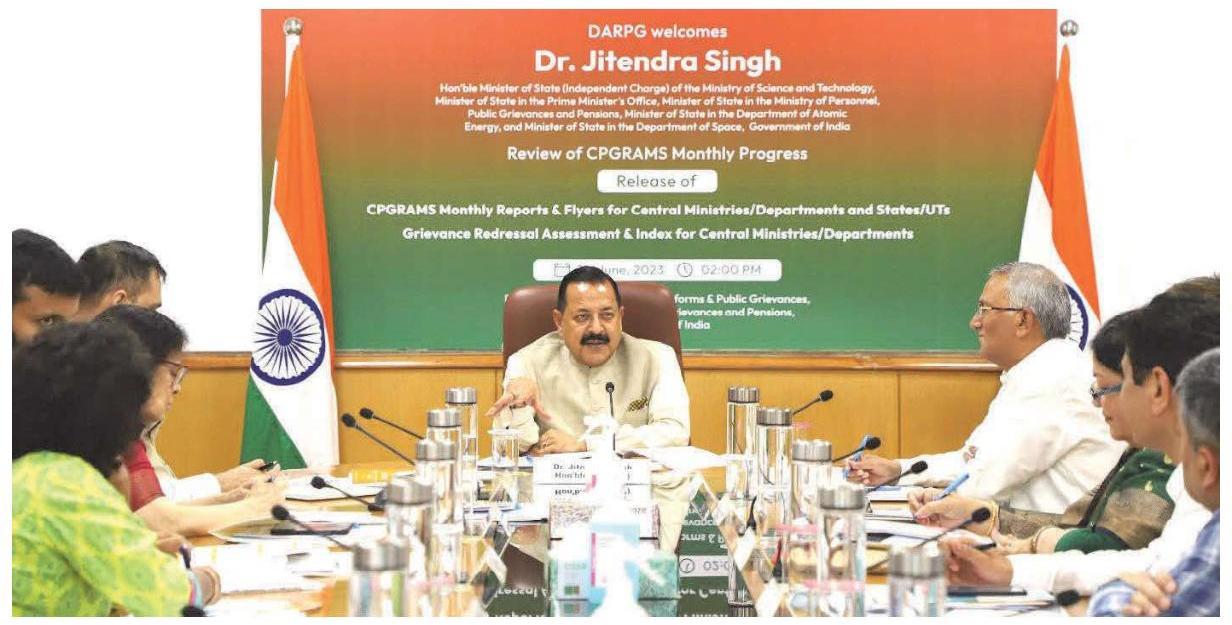
Launch of GRAI 2022 and Review of CPGRAMS – June 2023 by Hon’ble MOS
22.3.2 CPGRAMS Reformed version 7.0 was launched on 25.09.2019 for auto routing of grievances to last mile, wherein it was implemented in Department of Post. Thereafter, it was implemented in Department of Telecommunications and Department of Financial Services (Banking & Insurance Division). Now, CPGRAMS Reformed Version 7.0 has been implemented in all Ministries/Departments of Government of India.
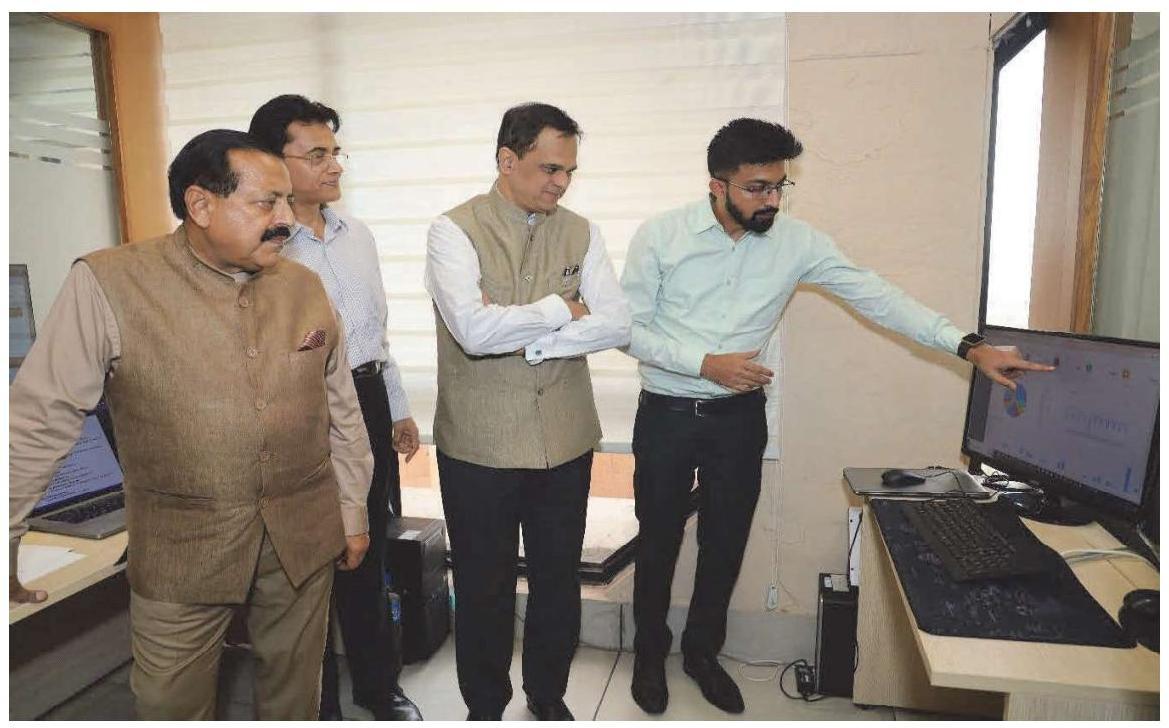
Launch of IGMS 2.0 – September 2023 by Hon’ble MOS
22.3.3 Citizens can use a Mobile App for lodging of public grievances and the action Status can also be viewed on the mobile itself. This mobile app is integrated with Unified Mobile Application for New-age Governance (UMANG). The app is available in both Android and iOS versions. A new mobile app called My Grievance is also available which is independently for CPGRAMS.
22.3.4 Public grievance mechanism of PMO, the President’s Secretariat, the Directorate of Public Grievances (Cabinet Secretariat), Department of Administrative Reforms & Public Grievances (DARPG) and the Pensioners’ portal has been duly integrated through CPGRAMS thus enabling grievances lodged to any of these entities to be transferred to the Central Ministries / Departments and State Governments online through CPGRAMS. The CPGRAMS interlinks 92 Central Ministries/Departments / Organizations and 36 States/UTs. There are more than 73 thousand active subordinate users available on CPGRAMS.
Total No of Organizations registered in CPGRAMS : 96295
Total Ministry / Departments : 92
Total / States / UTs : 36
Details of Grievances Received in DARPG during 01.01.2023 to 31.12.2023
| Total Receipts | $: 39866$ |
|---|---|
| Received by Post / Physical | $: 1388$ |
| Received online | $: 38478$ |
| Forwarded to States | $: 16403$ |
| Forwarded to Centre | $: 22075$ |
22.3.5 During the year, the Division has extensively used the System to forward public grievances to the State Governments. The inflow of State related grievances is in two forms: (i) through the CPGRAMS and (ii) through post. The grievances received by post are digitized and sent both through the System as well as by post to the State Government concerned. During 2023 a total of 16403 grievances have been sent to State Governments by Department of AR\&PG.
22.3.6 DARPG had undertaken One Nation – One Portal Digital platform across Govt. of India and State Governments for seamless digital processing of Grievances adopting a whole of Government approach. As on date, total 34 States / UTs have been integrated with CPGRAMS.
22.3.7 As a pioneer of district level integration with CPGRAMS, the JK-IGRAMS integrates the grievances from the Centralized Public Grievance Redress and Monitoring System (CPGRAMS) at the top with the last mile district level offices in the UT of Jammu \& Kashmir at the bottom. Earlier only the Jammu \& Kashmir Secretariat Departments and their Directorates were linked. However, now the Offices at District level have been linked and mapping up to Tehsil level and Block level has been done. The Union Territory of J\&K consists of 20 Districts and all these Districts of the UT of Jammu \& Kashmir have been mapped and integrated with the grievance redressal portal of JK-IGRAMS as well as the Central Government grievance redressal portal of CPGRAMS.
Introduction of an Appeal Mechanism/functionality in CPGRAMS
The Appeal Mechanism / functionality in CPGRAMS in line with the Department related Parliamentary Standing Committee Recommendations in its $100^{\text {th }}$ Report has been introduced. The recommendations were communicated to all Central Ministries / Departments with the request to
nominate a Nodal (Appellate) authority. The Appeal provision has been made for redressal of dissatisfied grievances identified through a mandatory feedback rating to be given by the Citizen on disposal of the grievance by the Nodal Grievance Officers.
22.3.8 A separate workflow and functionality for escalation of grievances to appeal authorities in CPGRAMS has been operationalized by the Department of Administrative Reforms and Public Grievances. The time line for resolution of an Appeal by the Nodal Appellate Authority is 30 days of receipt of the same. The Appellate Authority to whom a dis- satisfied Complainant can raise / escalate a public grievance is one level above the existing designated Nodal Grievance Officers. As of now the details of the nominated Nodal Appellate Authorities of 87 Ministries / Departments are available on the website at pgportal.gov.in. The Appeal Module is being operationalized by NIC in two inter-faces.
22.3.9 In the Citizens Interface, a complainant can file an appeal if he / she is not satisfied with the redress / reply of the grievance. Once the grievance is closed / disposed of, the complainant can view the details of final disposal which includes the feedback section and the complainant needs to mandatorily provide the feedback on the redressal of his/her grievance. The option of feedback is also available in the dashboard of the complainant. Five ratings will be available to the Citizen namely, Excellent, Very Good, Good, Average and Poor. It is under ‘Poor’ rating only, the option to file an appeal will be enabled to the petitioner. The petitioner will be asked whether he/she wants to raise their concern with Nodal Appellate Authority and if ‘Yes’ option is pressed then the ‘Reason for Appeal’ would be sought from the Complainant. After providing of the requisite information the complainant can successfully file an appeal. The Status of the Appeal can also be tracked by the petitioner with the grievance registration number.
The motive is to build trust with the citizen through effective and speedy redress of the grievances which would pave the way for good governance.
22.3.10 Operationalization of Feedback Call Centre: –
DARPG has setup a permanent Feedback call Centre w.e.f. 01.7.2022. Call Centre is taking direct feedbacks from the citizens regarding the resolution provided to their grievances by Ministries / Departments and the States / UTs. The call center also assists the citizen in filing appeal if they are not satisfied with the disposal. The calls are made in 12 different languages (English, Hindi, Gujarati, Marathi, Bangla, Telugu, Assamese, Odiya, Tamil, Malayalam, Kannada & Punjabi). Till December, 2023 total 7.32 lakh successful calls were made to the Citizen.
22.3.11 Introduction of Artificial Intelligence (AI) / Machine Learning (ML) tools: –
A MoU have been signed with IIT, Kanpur to Introduction of Artificial Intelligence (AI) / Machine Learning (ML) tools in the system in partnership with IIT, Kanpur to categories grievances and assess quality of resolution.
22.3.11.1 The Intelligent Grievance Monitoring System (IGMS) 2.0 Dashboard has been implemented by IIT Kanpur following an MoU with DARPG for upgrading CPGRAMS with Artificial Intelligence capabilities. The dashboard provides instant tabular analysis of priority, repeat and spam Grievances Filed \& Disposed according to a geographical area. IGMS will also help the officials identify the root cause of the grievance using AI and also provides an intuitive semantic search capability which is capable of searching the context of a grievance rather than a traditional keyword-based search approach.
22.3.12 Redressal of Public Grievances during Special Campaign and Good Governance Week: –
A special campaign 3.0 was launched on disposal of pending matters including Public Grievances and cleanliness drive was undertaken from $2^{\text {nd }}$ October to $31^{\text {st }}$ October, 2023 in every Ministry / Department
of government of India including their attached / subordinate offices and autonomous organizations across the country and abroad. During the Special Campaign total 501296 Grievances and 20662 Appeals were addressed.
22.3.13 Setting of Data Strategy Unit (DSU) in DARPG: –
DARPG has engaged NISG through contact dated 24.12.2021 for setting up a Data Strategy Unit (DSU) initially comprising 7 members. The PMU is expected to perform all the activities required for DARPG, ranging from software development, managing front end, backend, API integration, data analysis data visualization, develop AI/ML algorithms & scripts and management of CPGRAMS \& other IT applications of DARPG including e- Office.
22.3.14 leverage strength of Common Service Centers (CSC)
CPGRAMS has been integrated with Common Service Centers (CSC) from 7th June, 2022 and is available at more than 5 lakh CSCs, associating with 2.5 lakh Village Level Entrepreneurs (VLEs). This integration has helped the citizens in availing CPGRAMS related services in remote corners of the country. DARPG and CSC e-Governance Services India Limited has been taking various initiatives to create awareness about CPGRAMS among the citizens through the CSCs. There is a constant growth in the number of grievances being filed through the CSCs. In order to further create awareness about CPGRAMS among the citizens, CSC has started observing 20th of every month as CSC – CPGRAMS Grievance Day. To enhance the outreach, DARPG \& CSC had organized two Facebook Live Session under the chairmanship of Secretary (DARPG) with CSC VLEs. The Ministry of Agriculture and Farmers Welfare had also attended the 2nd session and interacted with VLEs. In 2023, a total of 97,925 grievances have been registered through the Common Service Centers.
22.4 PUBLIC SERVICE DELIVERY
22.4.1 One of the citizen-centric initiatives that were taken by this Department was to develop a Quality Management System (QMS) framework called ‘Sevottam’ for bringing excellence in service delivery by Government organizations. This has institutionalized an assessment-improvement framework for improving the quality-of-service delivery on a continuous basis through the involvement of Ministries / Departments and citizens. Sevottam comprises of 3 modules in relation to a public service organization viz., (a) Citizens’/ Clients’ Charter that specifies the service delivery standards (b) Grievance Redress Mechanism that gets activated if the service delivery is not as per standards in the charter, and (c) Service Delivery Capability of the organization to delivery service as per standards in the charter.
22.4.2 As part of the Strategic Plan for Capability Building towards implementing Sevottam Quality Management System (QMS), a Scheme for Strengthening of Administrative Training Institutes (ATIs) was implemented during the $12^{\text {th }}$ Five Year Plan 2012-2017 in Govt. approved Training Institutions in 10 States. State ATIs which are being funded under the Scheme are Punjab, Haryana, Rajasthan, NCT Delhi, Karnataka, Tamil Nadu, Uttar Pradesh, Madhya Pradesh, Himachal Pradesh and Jharkhand. The Scheme has resulted in capacity building of the ATI by enabling conducting of training programmers and workshops by the ATIs for sensitizing the officers of the State Government for implementation of Citizens’ Charter and Grievance Redress Mechanism. Under the Scheme, an amount up to Rs. 20 lakh can be released annually to the ATIs based on the UC received for the funds released during the previous years and the performance of the concerned ATIs during the previous year(s) in which funds have been released.
During the financial year 2023-24 10 ATIs have been grant under Sevottam Scheme.
22.5 CITIZENS’ CHARTER
22.5.1 In view of decision taken in Conference of Chief Ministers held on $24^{\text {th }}$ May, 1997 presided by Hon’ble Prime Minister, formulation of Citizen’s Charter by Central & State Governments began. The process started with sectors having large public interface (e.g. Railways, Telecom, Posts, Public Distribution Systems). Charters were required to include (i) standards of service (ii) time limits for public service delivery (iii) avenues for grievance redress. Guidelines for formulating the Charters as well as a list of do’s and don’ts were communicated to various government departments / Organizations by DARPG to enable them to bring out focused and effective charters. A comprehensive Website of Citizens’ Charter, www.goicharters.nic.in was launched by the DARPG on 31 May, 2002 which apart from guidelines contains the Citizens’ Charters existing in Ministries / Departments / States / UTs / Organizations.
CHAPTER 23
ORGANISATION AND METHODS DIVISION
Mandate
- Formulation and simplification of office procedures. Publication and updating of comprehensive Central Secretariat Manual of Office Procedures (CSMOP) for Physical as well as electronic files.
- Aiding and advising the Central Ministries / Departments and States / UT Governments on O&M aspects.
23.1 Increasing Efficiency in Decision making
Efficient decision making is fundamental to a responsive and accountable governance. The Central Secretariat Manual of Office Procedure (CSMOP) has been a guiding framework for effective functioning of the Central Secretariat offices. A workshop was organized by DARPG under the Chairmanship of Ho’ble MoS(PP) on 19th December, 2023, in which several Ministries presented their good governance practices. The key action points emanating from the workshop are as under:
- To make implementation procedures thorough and efficient by removing mundane procedures and older norms
- Comprehensive review for delayering and delegation for greater ownership and decision making to lower order of offices.
- Parllel/simultaneous physical and digital should be discouraged as it defeats the whole purpose of digitization.
- Optimal use of digital tools including e-Office for faster decision making through new features on e- office 7.0 like multiple screens usage, inter departmental movement of files, usage in regional language etc.
- Effective use of Desk Officer System
- To effectively delayer and reduce the Level of file submission of the files in e-Office to 4 levels
The Government’s campaign for Increasing Efficiency in Decision Making was adopted in almost all Ministries / Departments of the Central Secretariat. The campaign represents one of the most complicated and far-reaching administrative reforms witnessed in the Central Secretariat. The initiative for increasing efficiency in decision making has transformed work culture, reduced hierarchies and resulted in significant adoption of new technology. It has also enabled responsive communication and enhanced efficiency in processing receipts. Reduction in paper consumption was also witnessed. An advanced analytics dashboard for e-office was also launched during the Good Governance Week events on 19th December, 2023. The dashboard helps as a tool to validate the extent of digitization and delayering in the Central Secretariat.
23.2 Special Campaign 3.0 on Disposal of Pendency (2nd October, 2023 to 31st October, 2023)
The Special Campaign 3.0 on Swachhata and reducing pendency in Government offices was organized from 2nd- 31st October 2023 in all Central Ministries / Departments and their attached / subordinate offices / PSUs / autonomous organizations. DARPG issued the guidelines and coordinated the campaign across the Central Ministries and their offices through real-time monitoring on a dedicated portal i.e. http://scdpm.nic.in. A total of 2,58,673 cleanliness campaign sites participated in the campaign. 164 lakh sq. ft space was cleared from scrap and outlived records and Rs. 556.35 Crore of revenue was earned. 26.35 Lakh physical files were weeded out.
PMO’s Tweet on Special Campaign 3.0
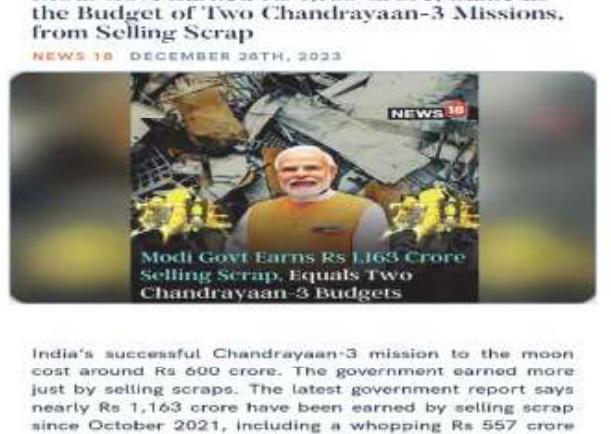
India’s successful Chandrayaan-3 mission to the moon cost around Rs 600 crore. The government earned more just by selling scraps. The latest government report says nearly Rs 1,163 crore have been earned by selling scrap since October 2021, including a whopping Rs 557 crore earned during a one-month-long campaign in October. An astounding number of 96 lakh physical files have been weeded out in central government offices since October 2021.
Best Practices during Special Campaign 3.0
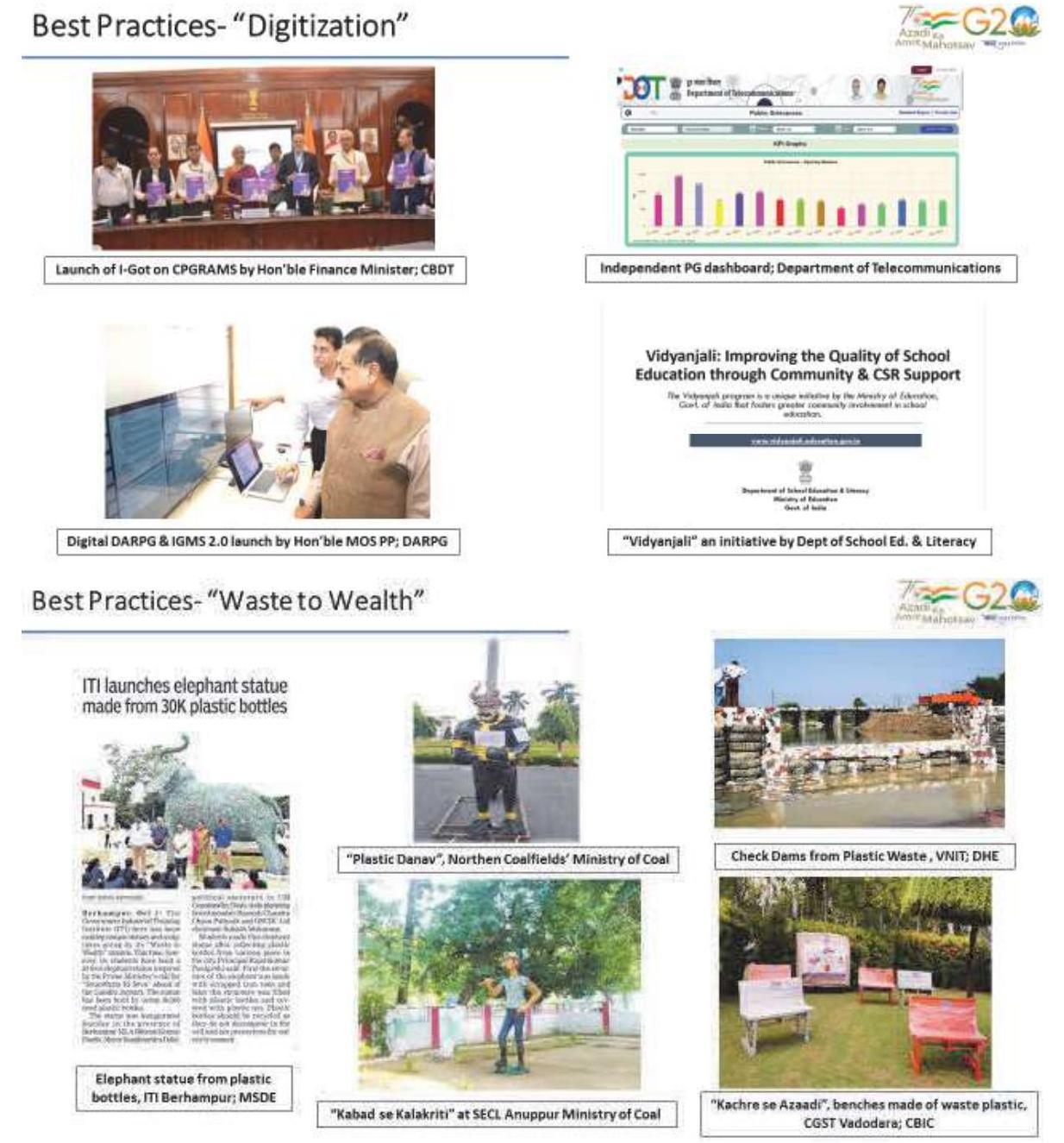
The government offices having maximum citizen centricity were given special attention. Department of Posts has conducted the cleanliness campaign in 75,000 Post Offices, Ministry of Railways has covered 23,672 sites covering all railway stations, Ministry of Road Transport & Highways conducted cleanliness drive at about 13,168 office, Ministry of School Education covered 31,275 sites. Geographical extent of the campaign was across all over India like Amroha, Mayiladuthurai, Mon, Tinsukia, Bhopal, Sanchi, Phalgam, Gondia, Vasco, Jeenagora, Barmer, Jagadalpur etc. About 300 best practices emerged during the Campaign which were documented and disseminated.
Special Campaign 3.0 was 2.5 times larger in terms of Campaign sites, 1.8 times larger in terms of Space Freed and 1.5 times larger in terms of Revenue earned than the Special Campaign of 2022 (S.C. 2.0). The Campaign was successful in institutionalizing Swachhata and reducing pendency in government offices. About 5.22 lakh public grievances were disposed of and about 26.35 lakh files
which had completed their retention schedule were weeded out during the campaign. Several Ministries were able to achieve $100 %$ disposal against the target during the campaign.
The monitoring mechanism instituted during the special campaign 3.0 is being continued and Ministries / Departments are being monitored against pendency on monthly basis.
The Special Campaign 3.0 outcomes were presented before the Ministries in the inaugural event of Good Governance Week. Secretary M/o Road Transport & Highways, Secretary M/o Environment, Forests \& CC, Secretary, M/o Coal and Chairman, CBDT addressed and presented the work done during the Special Campaign 3.0 in their Ministries/ Organizations.
23.3 Monthly Report on Secretariat Reforms
DARPG release Monthly Report on Secretariat Reforms every month and circulate it among all Ministries/departments including PMO and Cabinet Secretariat. This report includes Swachhata campaign and reducing pendency practices during the month, Parameter wise performance of Ministries/Departments, Increasing Efficiency in Decision Making, e-Office analytics and implementation.
CHAPTER 24
e-GOVERNANCE
24.0 $26^{\text {th }}$ National Conference on e-Governance
The 26th National Conference on e-Governance was held on 24th – 25th August, 2023 in Indore, Madhya Pradesh on the theme “Viksit Bharat – Empowering Citizens”. The Conference was inaugurated by the Chief Guest, Dr. Jitendra Singh, Union Minister of State (Independent Charge), Ministry of Science and Technology, Ministry of Earth Sciences, Minister of State in the Prime Minister’s Office, Minister of State of Personnel, Public Grievances & Pensions, Department of Atomic Energy and Department of Space, Government of India. Shri Shankar Lalwani, Member of Parliament, Government of India; Shri Shaitan Singh Pal, Chairman and Director, Madhya Pradesh State Electronics Development Corporation Limited, Government of Madhya Pradesh; Shri Om Praskash Sakhlecha, Honorable Minister, Science \& Technology and MSME, Government of Madhya Pradesh; Shri Abhijeet Agrawal, MD, State Electronic Development Corporation, Government of Madhya Pradesh also graced the Conference with their presence.
The Conference was attended by over 500 delegates which included delegates from Government of India, State/UT Governments, Industry, Academia and Private Sector.
An Exhibition including Wall of Fame showcasing the awarded and other best practices of the country was also organized during the Conference.
Three Booklets, namely, (i) Background papers (ii) Excellence in e-Governance Booklet and (iii) Compendium of e-Governance Initiatives and Citation – 2023 Booklet were released during the 26thNCeG 2023.
The 26th NCeG represented a platform for constructive exchange of ideas on some of the latest technologies for promoting e-Governance. 48 Distinguished speakers shared their knowledge and insights in 11 plenary sessions on the following contemporary subjects/issues:
i. Digital Transformation for India’s Techade
ii. Emerging Technologies for providing Citizen Centric Services
iii. District level initiative in e-Governance
iv. Cyber Security and Good Governance
v. Data Governance initiatives in Innovation \& Research
vi. Digital Transformation for enhancing Ease of living
vii. Digital Public Infrastructure
viii. Integrated Government Online Training (iGOT)
ix. Role of Research \& Development in Citizen Centric Services
x. Emerging Technologies in Governance by Startups
xi. UNDESA and NeSDA-2023 Way forward
xii. Digital Transformation \& e-Governance Initiatives in Madhya Pradesh
xiii. e-Governance Initiative in Madhya Pradesh
The roadmap for e-Governance of the country for the next year was drawn up during the Conference. The key takeaways from the 26th NCeG are – Closer synergy amongst researchers, academia, industry and start-ups in the field of e-Governance is the way forward for India; The policy maxim of Maximum Governance-Minimum Government is best reflected in a Digitally Empowered Nation – Digitally Empowered Citizen – Digitally Transformed Institution; Citizen Centricity as an important area of focus and Digital Transformation of Institutions.
24.1 National Awards for e-Governance
To recognize the implementation of e-Governance initiatives, the National Awards for e- Governance
2023 were presented during the Inaugural Session of the Conference. Total 16 awards, which included 8 Gold and 8 Silver were presented to Central Ministries/Departments, State/UT Governments, Districts, Local Bodies, Public Sector Undertakings and Academic & Research Institutions, under the following 5 categories/sub-categories of the National Awards for e- Governance Scheme – 2023:
Category I- Excellence in Government Process Re-engineering for Digital Transformation
(i) Central level initiatives; (ii) State/UT level initiatives
Category II – Excellence in Emerging Technologies for providing Citizen Centric Services (i) Central level initiatives; (ii) State/UT level initiatives.
Category III – Excellence in District level initiative in e-Governance
Category IV- Outstanding research on Citizen Centric Services by Academic/Research Institutions
Category V – Excellence in Emerging Technologies in Governance by Startups
Promoting Reforms through e-Governance
24.2 National e-Governance Service Delivery Assessment (NeSDA)
The Department of Administrative Reforms \& Public Grievances (DARPG) had formulated the National e-Governance Service Delivery Assessment (NeSDA) framework in 2019 as part of its mandate to boost the e-government endeavors and drive digital government excellence. This was based on the Online Service Index (OSI) of UNDESA eGovernment Survey, customized for the Indian federal structure and the e-Governance landscape of the States/UTs. The study assesses States, Union Territories (UTs), and focus Central Ministries on the effectiveness of e-Governance service delivery. NeSDA helps the respective governments to improve their delivery of citizen centric services and shares best practices across the country for all States, UTs and Central Ministries to emulate.

Under the biennial study of NeSDA, in June 2022, Minister of State for Personnel, Public Grievances and Pensions had released the NeSDA 2021 report which assessed 1400 e-Services across States and UT’s and reported that India’s e-Services had grown by 60 percent in the period 2019-2021.
69 percent of the mandatory e-services have been delivered by States/ UT’s in 2021 up from 48 percent in NeSDA 2019. 74 percent of the respondents of the Nationwide Citizen survey are satisfied/ very satisfied with the e-services. Now the Department in in the process of releasing the third edition of the study i.e. NeSDA, 2023.
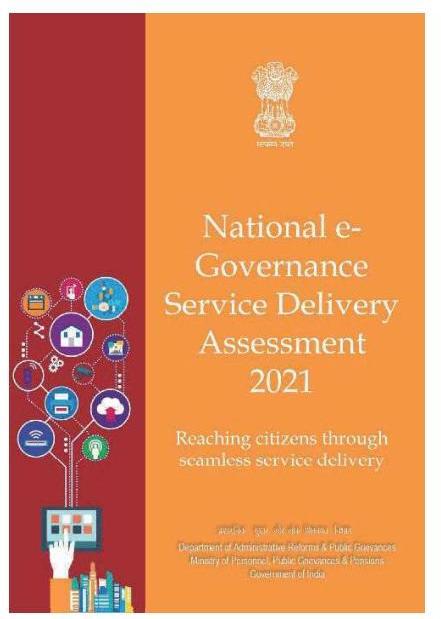
24.3 National e-Governance Service Delivery Assessment (NeSDA) Way Forward Monthly Reports
NeSADA Way Forward has been developed for regular monitoring of the implementation of recommendations given in the NeSDA 2021 report. A dashboard namely “NeSDA- Way Forward, Status of Implementation” has also been designed in line with the focus areas of e-Governance. On the basis of inputs uploaded on the above portal by respective States/UTs, the monthly reports are released by the Department. These reports institutionalize the nation’s endeavor for improved delivery of e-services and prepare States/UTs for NeSDA 2023.
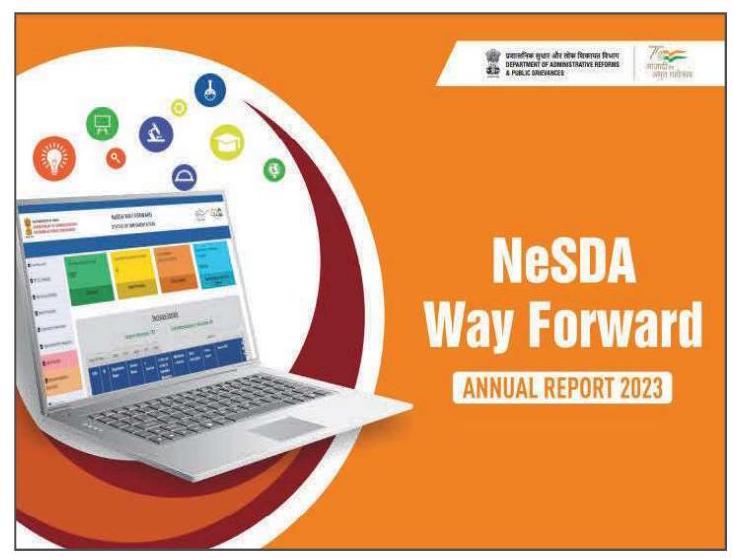
So far, 11 NeSDA Way Forward Monthly Reports and Annual Report 2023 have been published to monitor the status of e-service delivery, across States/UTs. The NeSDA Way Forward project by DARPG has achieved significant progress in expanding e-services across India. The number of services offered has risen by $42 %$ to a total of 16,536 in just one year, with Jammu & Kashmir and Tamil Nadu leading the way. Local Governance and Utility Services account for the largest share $(5,297)$ of these offerings. When it comes to mandatory services, the States/UTs have achieved an impressive $76 \%$ saturation rate, with 1,529 out of 2,016 services now available online. Six states – Himachal Pradesh, Madhya Pradesh, Punjab, Rajasthan, Tamil Nadu, and Uttarakhand – have even reached 100\% saturation for these essential services. This is a significant improvement from just a few years ago, with saturation rising from $48 \%$ in 2019 to $76 \%$ in March 2024.
Collaboration with Chief Commissioners and Appellate Officers of Right to Service (RTS) Act
In line with the objective of NeSDA Way Forward to the enhance the e-service delivery experience nationwide, DARPG has embarked on a collaborative initiative with the Chief Commissioners and Appellate Officers of the Right to Service (RTS) Act across various States/UTs. The department held two virtual meetings on 16.06.2023 and 09.10.2023, respectively
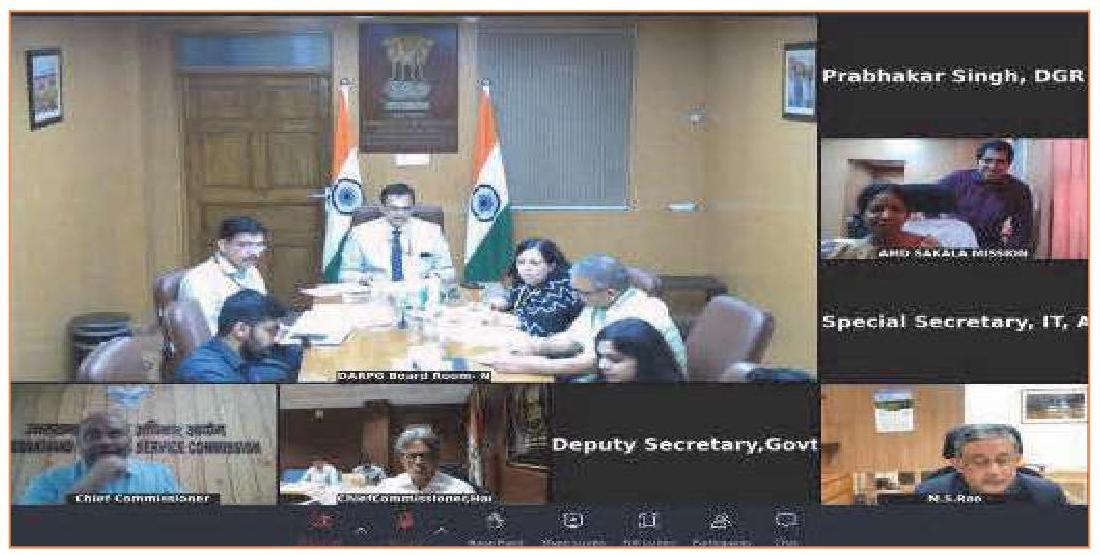
Meeting with Chief Commissioners \& Appellate officers of the RTS Act in States/UTs on 09.10.2023
Brainstorming session on Emerging and Future e-Governance Initiatives
To seek new ideas for paving the way forward, DARPG conducted a brainstorming session on the theme- Emerging and Future e-Governance Initiatives, e-Commerce Initiatives, and Emerging Technologies on 04.01.2024 at CSOI, New Delhi. 15 domain experts and distinguished representatives from leading organizations, including PwC, QCI, Primus Partners, KPMG, Deloitte and EY attended the session along with the DARPG officials.
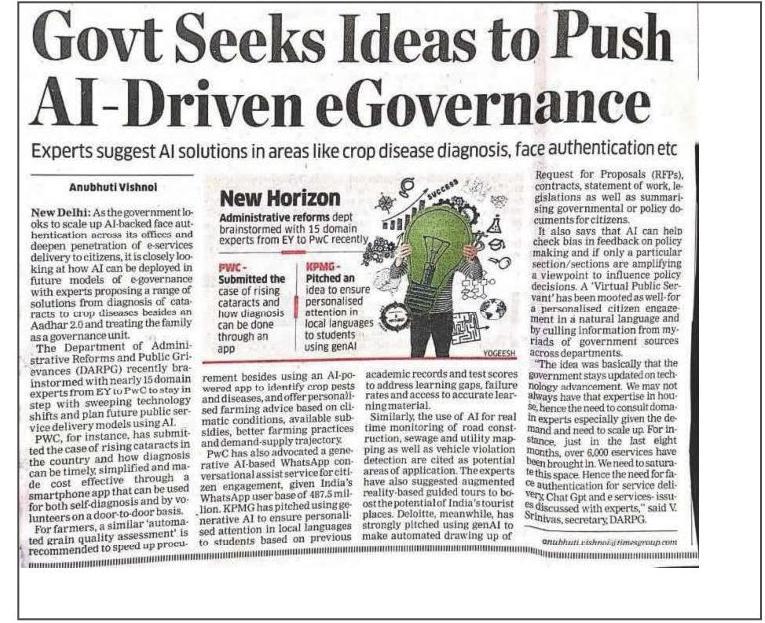
The roadmap forward, following the day long deliberations envisaged:
Promotion of Universalized Face Authentication processes for simplification of service delivery
- Incorporation of Bhashini, service plus, etc. in e-governance initiatives
- Immense potential of increasing the Mandatory e-Services to over 160
- Focus on e-Office analytics and cyber-security measures
- Enhanced Usage of AI in grievance redressal
- Reaching to families, as a unit, through use of technology
- Push towards e-commerce initiatives
- Strong media outreach to disseminate best practices
- Collaboration with State/UT Government
- Need for Hackathons to further learn and disseminate the Gen AI good practices
24.4 National e-Governance Webinar (NeGW) Series 2023-24
The Department of Administrative Reforms & Public Grievances (DARPG) launched the National e-Governance Webinars (NeGW 2023-24). This monthly series, launched in September 2023, provides a distinguished platform for public administrators to share their award-winning initiatives recognized by the prestigious National Award for Excellence in e-Governance (NAeG), their experiences and implementation challenges. Through knowledge exchange and best practice dissemination, NeGW aims to inspire replication of successful projects, driving advancements in egovernance across the nation.
The National e-Governance Webinar Series focuses on the following themes:
- Process Re-engineering for Digital Transformation at Central and State/UT level
- Citizen Centric Delivery at Central and State/UT level
- District Level Initiatives in e-Governance at State/UT level
- Recognizing Outstanding Research on Citizen Centric Services
- Adoption of Emerging Technologies for e-Governance
DARPG has successfully convened six NeGW webinars. The webinars have been well received with participation of over 500 participants from across the country which includes state functionaries, academia and certain start-ups and have served as catalysts for innovation and collaboration, fostering engagement among administrators and stakeholders invested in the implementation of diverse government programs.
Vision India@2047
The DARPG is amongst the Ministries/ Departments of Government that is formulating its Vision India@2047. The DARPG constituted an Advisory Group under the chairmanship of Minister of State for PMO, Personnel, PG and Pensions with Chief Secretaries of States/UTs, 15 Sector Specialists with National Experts from Senior Civil Servants, IIT’s, IIM’s Central and State Universities, and Public Policy Research Organizations. A working group under the chairmanship of Secretary DARPG along with AR Secretaries of States/UTs is also constituted for formulation of the Vision India@2047 under the overall supervision of the Advisory Group. The Indian Institute of Public Administration served as the Knowledge Partner of DARPG in formulating Vision India @2047.
Based on deliberations of working group and Advisory group DARPG prepared a Vision India @ 2047 document with the theme of Bringing Citizens and Government together. Further, six thematic groups in areas of Assistive Technologies, Fintech for Inclusion, Energy & Net Zero, Rural Development \& Agriculture, Transport \& Mobility and Education have been constituted to prepare sector wise vision documents which subsequently will be taken up with the concerned Ministries/ Departments for refinement.
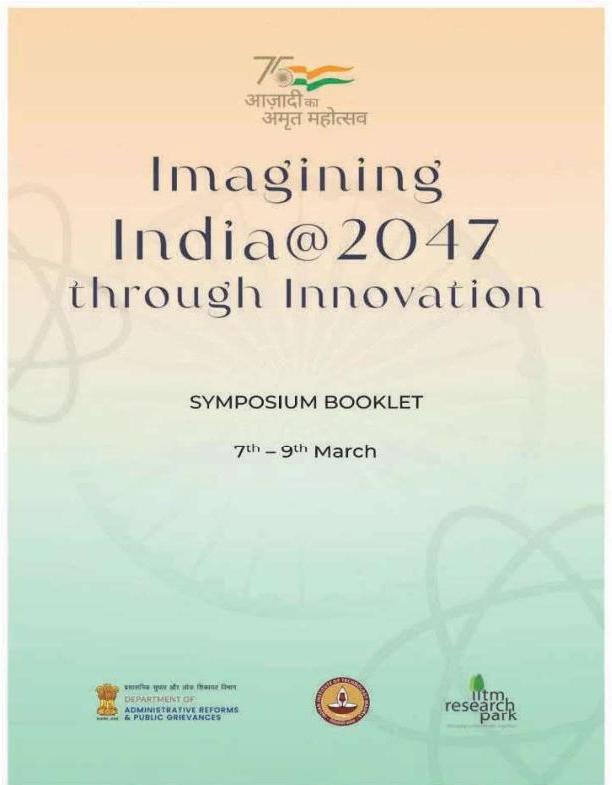
CHAPTER 25
INTERNATIONAL EXCHANGE AND COOPERATION
25.1 The Department of Administrative Reforms & Public Grievances (DARPG) deals with matters relating to international exchange and cooperation in the field of Public Administration and Governance, which includes, among other things, organizing programmes and visits of Indian delegations to foreign countries and visits of foreign delegations to India as part of projects / bilateral measures in furtherance of activities included in the Memorandum of Understandings (MOUs) / Agreements signed between India and other countries (bilateral or multilateral).
25.2 The aim of international exchange and cooperation component is to share information, and best practices across national governments. Presently bilateral MoUs in the areas of Public Administration and Governance have been signed with Portugal, United Kingdom, Singapore, Australia, The Gambia, France, Cambodia and trilateral MoU with Brazil and South Africa (IBSA).
Details of the activities are given below:-
25.3 India – Singapore Cooperation
25.3.1 The MoU for cooperation in the field of ‘Personnel Management and Public Administration’ was signed by the Department with the Public Service Division (PSD) of the Republic of Singapore on 1st June, 2018. The areas of cooperation under the MoU include (i) Workforce, Workplace and Jobs; (ii) Public Service Delivery; (iii) Human Resource Management; (iv) Public Sector Reform; (v) Leadership/Talent Development; and (vi) EGovernance / Digital Government.
25.3.2 The first bilateral meeting under the aegis of the MoU was held on 6th July, 2021. The Second bilateral meeting on “Personnel Management and Public Administration” was held on 29th September, 2022 in New Delhi under the aegis of MoU. The bilateral meeting was led by Shri V. Srinivas, Secretary, DARPG from Indian side and Mr. Loh Khum Yean, Permanent Secretary, PSD, Singapore from Singapore side. Both sides identified areas of collaboration which include Capacity Building, participation in the ASEAN Benchmarking Study on eGovernance and future reforms to explore in governance.
Mr. Loh Khum Yean, Permanent Secretary, PSD also addressed inaugural session of National Good Governance webinar jointly with Secretary (DARPG) on the theme ‘Public Service Delivery held on 30th September, 2022 which was attended by more than 850 participants from all over India.
MoU between India and Singapore in the field of Personnel Management and Public Administration was signed on 6th July, 2023 in New Delhi. The MoU was signed by Shri V.Srinivas, Secretary DARPG on behalf of DARPG and Mr. Simon Wong, High Commissioner of Republic of Singapore to India on behalf of PSD Singapore. Representatives of PSD, Singapore attended the signing in ceremony virtually. The MoU was extended for a period of five years from 1st June 2023 to 31st May 2028.
A bilateral introductory meeting between Shri V. Srinivas, Secretary, DARPG and Ms. Tan Gee Keow, Permanent Secretary, PSD, Singapore was successfully held on 30th January, 2024 through video conferencing. The meeting was attended by senior officers of PSD,
Singapore and DARPG. During the VC India and Singapore committed themselves to strengthen cooperation in the field of Personnel Management and Public Administration.
25.4 India Australia Cooperation
25.4.1 A Memorandum of Understanding (MoU) on cooperation in the field of Public Administration and Governance Reforms was signed by the Department with the Australian Public Service Commission (APSC) during Indo-Australia Virtual Summit held on 4th June, 2020 between the Prime Ministers of both the sides.
25.4.2 The areas of cooperation under the MoU include (i) Promoting transparency and accountability in delivery of public services; (ii) Building effective service delivery in the public service; (iii) Recruitment and promotion in the public service; (iv) Developing a framework for values and competencies; (v) Training and capacity building of the public service; (vi) Public Sector Management and Reform; (vii) Public Grievance Redress Mechanism; (viii) Facilitating short-term foreign training programmes for officers of Government of India or Australia; and (ix) Promoting and utilizing potential of retired government servants.
25.4.3 As part of implementation of MoU, both sides jointly organized a webinar on ‘Ethics in Governance’ on 06.04.2023. The webinar was organized jointly by DARPG and Australian Public Service Commission. The webinar was co-chaired by Shri Amar Nath, Additional Secretary, DARPG and Mr. Mark Colwell, Director, Australian Public Service Commission.
25.4.4. A Webinar on ‘Best Innovation Practices in Governance’ was held on 8th August, 2023. The webinar was organized jointly by DARPG and Australian Public Service Commission (APSC) under the aegis of the MoU signed by DARPG with the Australian Public Service Commission (APSC). Presentation on ‘New Age Learning Centre’ was made by Mr. Sunny Singh, DC, Changlang, Arunachal Pradesh for the Indian side and Presentation on ‘The Survey of Trust in Australian Public Services’ was made by Bradley Carron-Arthur, Director Trust and Transparency, for the Australian side.
25.5 India – Gambia Cooperation
25.5.1 A Memorandum of Understanding (MoU) between the Department and the Public Service Commission, Office of the President, The Gambia was signed on 08th July, 2021 on ‘Refurbishing Personnel Administration and Governance Reforms’. The First meeting of IndiaGambia Joint Working Group (JWG), formed under the MoU, was held virtually between the Department of Administrative Reforms & Public Grievances and the Public Service Commission (PSC) of The Gambia on 22nd November, 2021.
25.5.2 The India-Gambia 2nd Joint Working Group meeting to implement the bilateral MOU on Personnel Administration and Governance was held under chairmanship of Secretary DARPG V. Srinivas and Chairman Public Service Commission of Gambia Mr. Lamin Samateh by video conference on 21.08.2023. Mr. Lamin Samateh said that the MoU which was signed on 8th July, 2021 for three years and is valid till 7th July, 2024 has worked well and the possibility to extend it for 5 years could be explored on the same terms and conditions. H.E. Mr. Mustapha Jawara, High commissioner of The Gambia to India said that the officers from the Gambia have benefited from the capacity building programs held earlier and welcomed the extension of MoU for further 5 years beyond 2024.
25.5.3 The 3rd Joint Working Group meeting between DARPG and Public Service Commission of The Republic of The Gambia under the aegis of the MoU signed on 08.07.2021 was held on 09.11.2023 through VC. The meeting was attended by officials of DARPG, NCGG, O/o the
Public Service Commission of The Gambia, Embassy of India in Dakar and MEA. In the concluding remarks both sides agreed to contemplate the extension of MoU for five (05) years beyond 7th July, 2024 and take forward the cooperation in the identified areas.
25.6 India – France Cooperation
25.6.1 The Department of Administrative Reforms, Public Grievances and Pensions, Government of India and M/o Public Sector Transformation & the Civil Service of the French Republic signed the Letter of Intent on 02nd November, 2023 for Cooperation in the field of Public Administration and Administrative Reforms for three years. The Letter of Intent was signed by Shri V. Srinivas, Secretary, on behalf of the Department of Administrative Reforms and Public Grievances and H.E. Mr. Thierry Mathou, Ambassador of France to India at a ceremonial function in New Delhi on behalf of the Ministry of Public Sector Transformation and the Civil Service of French Republic. The areas of cooperation under the MoU include (i) promote cooperation in the field of Civil Service (ii) Human Resource Management; (iii) Public Administration and Administrative Reforms.
25.7 India-Portugal Cooperation
25.7.1 A Memorandum of Understanding (MoU) between DARPG and the Ministry of the Presidency and of Administrative Modernization of the Portuguese Republic was signed on 24th June, 2017 on Co-operation in the field of Public Administration and Governance Reforms. The First Meeting of Senior Consultative Body was held in Lisbon, Portugal on 8-9 May, 2018.
25.7.2 The Second meeting of the Senior Consultative Body between the DARPG and the Administrative Modernization Agency of Portugal co-chaired by Shri V. Srinivas, Secretary, DARPG and Ms. Silvia Esteves, Head of International Relations, AMA, was successfully held on 12th December, 2023 through VC.
From the Indian side, Shri V. Srinivas Secretary DARPG, and Shri Puneet Yadav Joint Secretary DARPG presented the New Paradigms in Governance in India from 2019-2024. From the Portuguese side, Ms. Silvia Esteves, Head of International Relations at AMA, and Ms. Carina Americo Head of AMA Academy presented the http://ePortugal.gov and AMA academic programs in digital transformation.
25.8 India Brazil Co-operation
A Brazilian delegation consisting of Mr. Gaetini and Mrs. Chaves along with Ms. Carolina Oliveira, representative of the Embassy of Brazil in India, had a meeting with Shri V. Srinivas, Secretary (DARPG) on 15th February, 2024 at Sardar Patel Bhavan, New Delhi. “New Paradigms in Governance” was discussed in the meeting.
25.9 Cooperation with International Institute of Administrative Sciences (IIAS)
International Institute of Administrative Sciences (IIAS) is the leading non-profit scientific international organization at the global level in the field of public administration. IIAS, with its headquarters at Brussels, Belgium, was established in 1930 for the purpose of promoting the development of Administrative Sciences, better organization and operation of public administrative agencies, improvement of administrative matters and techniques and for the progress of International Administration. Department of Administrative Reforms and Public Grievances, Ministry of Personnel, Public Grievances \& Pensions, Government of India is an institutional member of the International Institute of Administrative Sciences (IIAS) since 1998.
25.9.1 IIAS-DARPG Conference
The IIAS Annual Conference is the flagship event of the IIAS body. It is organized every year in different regions of the world. It lasts one week and consists of three parts: Pre-Conference Workshops, Conference and social program. IIAS-DARPG India Conference, 2025 shall be organized at Bharat Mandapam in New Delhi from February 10-14, 2025. More than 500 domestic as well as international delegates from many countries are expected to participate in the conference. The theme of the conference is “Next Generation Administrative Reforms Empowering Citizens and Reaching the Last Mile.”
25.9.2 IIAS Extraordinary General Assembly meeting 2024
A two-member delegation consisting of Shri Puneet Yadav, Joint Secretary, DARPG and Shri Sardendu Kumar Pandey, Director, DARPG, attended Extraordinary General Assembly meeting of IIAS Council of Administration, held at Brussels, Belgium on 4th October, 2023. Extraordinary General Assembly discussed the adoption of the new text of statutes of the association in the background of the Belgian Law of 23rd March 2019 as against the existing statutes, Amended in 2017, under the Belgian law of 27 June 1921. The Indian Delegation participated in the meeting and supported the new text of statutes. A meeting was also held with IIAS officers regarding finalizing the details of IIAS Conference 2025 to be organized in India. The Indian delegation was also joined by Shri Debasish Prusty, Deputy Chief of Mission (DCM), Embassy of India, Brussels.
25.9.3 IIAS-KSG Conference in Mombasa:-
A delegation led by Shri Puneet Yada visited Mombasa, Kenya on 26-29th, February, 2024 for the purpose of the annual International Institute of Administrative Sciences (IIAS)- Kenya School of Government (KSG) Conference. Shri NBS, Rajput, Joint Secretary, DARPG, Shri Sardendu Kumar Pandey, Director and Shri Parthasarthy Bhaskar, Deputy Secretary were part of the delegation. The Indian delegation was also accompanied by the officers of Indian embassy in Kenya Mrs Priya D. Bhanote, Second Secretary, Nairobi and Mr Sandeep Sharma, AHC, Mombasa.
The Indian delegation took the opportunity to meet with senior officials of the Kenya School of Governance led by its director Ms. Prisca Oluoch, Director Linkages, Partnerships & Collaborations, Kenya School of Government. Both the delegations explored possibilities about a future collaboration between the Kenya School of Government (KSG) and DARPG. Shri Puneet Yadav, Joint Secretary, DARPG explained to KSG about the DARPG and its main functional verticals.
Mr Puneet Yadav, head of Indian delegation made a statement about the proposed IIAS-New Delhi Conference 2025 and invited research scholars, academicians and practitioners of international communities to participate in New Delhi 2025 Conference. A film was also shown on IIAS-New Delhi Conference 2025 during the conference which was appreciated by all.
CHAPTER 26
DOCUMENTATION AND DISSEMINATION DIVISION
26.1 The Documentation and Dissemination Division of the Department primarily carries out the activities of documentation and dissemination of good governance practices of Central and State Governments and Union Territory Administration with a view to facilitate sharing of experience with one another and replication elsewhere.
- In the Year 2023-24, Documentation & Dissemination Division performed a crucial role in successfully holding ceremonial function on the occasion of Civil Services Day 2023 on 20th and 21st April, 2023. The main theme of the event was “VIKSIT BHARAT Empowering Citizens \& Reaching the Last Mile”. During the event, Hon’ble Prime Minister of India released two ecoffee table books on select initiatives of Priority Programmes and Innovations under the scheme of ‘Prime Minister’s Awards for Excellence in Public Administration 2022. For the event, altogether 15 films with language versions were produced. Besides this, short films were also produced in- house to display release of two coffee table booklets.
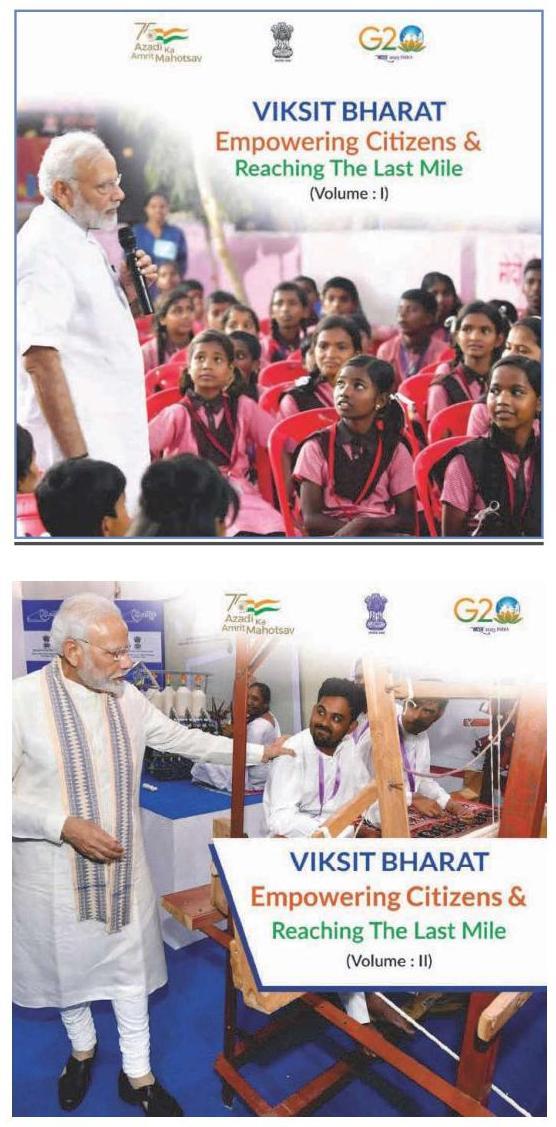
2. REGIONAL CONFERENCES
The DARPG organizes Regional Conferences (RCs) in collaboration with the State Governments to provide a platform to the officers of the Central and State Governments to share their experiences in the formulation and implementation of good governance initiatives. Since April 2023, two Regional Conferences have been held in Jaipur and Guwahati.
I. Regional Conference, Jaipur – Dr. Jitendra Singh, Hon’ble Union Minister of State (PP) inaugurated the event at Jaipur (4th and 5th October, 2023). The Conference featured 13 Award winners in 7 categories from 2022 Awardees, the PM’s Award winners/National eGovernance Award Winners from Rajasthan presented the best governance practices in the State. More than 500 delegates from across India participated in the event.
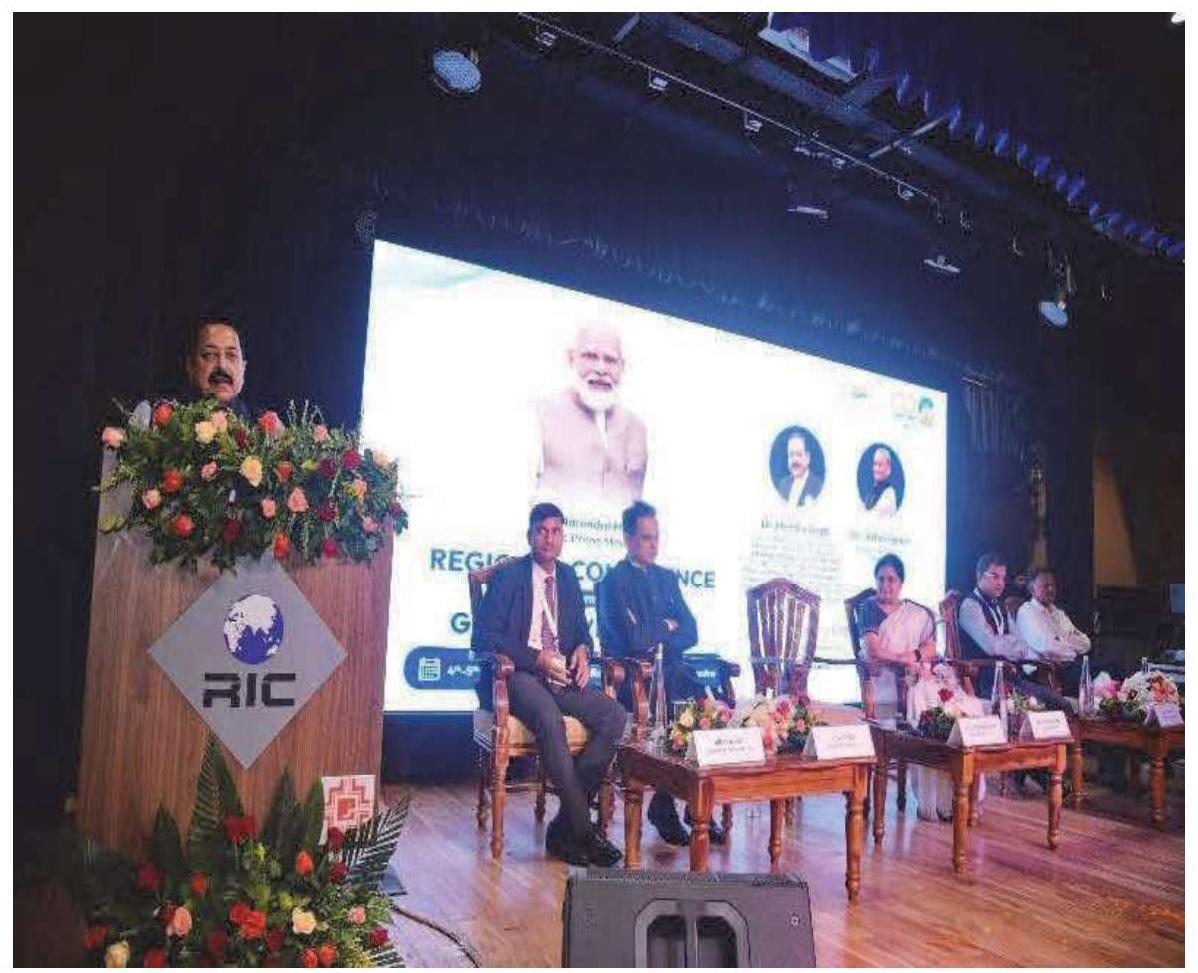
II. Regional Conference, Guwahati – Dr. Jitendra Singh, Hon’ble MoS (PP) & Hon’ble Chief Minister of Assam graced the occasion. The speakers included Prime Ministers’ Awardees 2022 and top business minds from the corporate sector. Participants from 13 states attended the conference. More than 500 delegates from across India participated in the event.
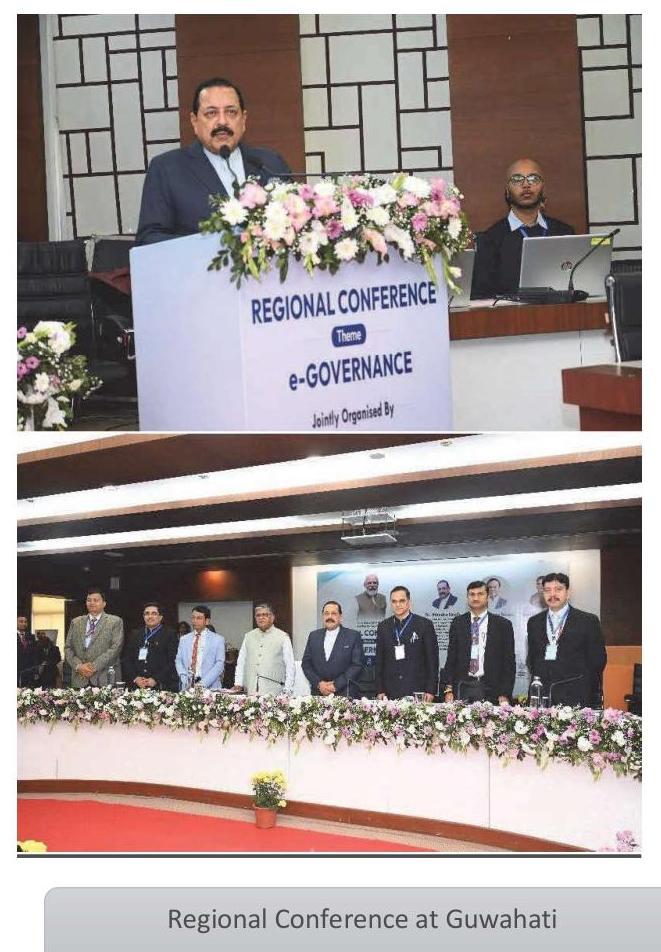
A booklet on the journey of Regional Conference in the last one decade has been published which was released by the Hon’ble MoS (PP), Dr Jitendra Singh during the inauguration function of Good Governance Week held in New Delhi between 19 \& 25 December 2023.
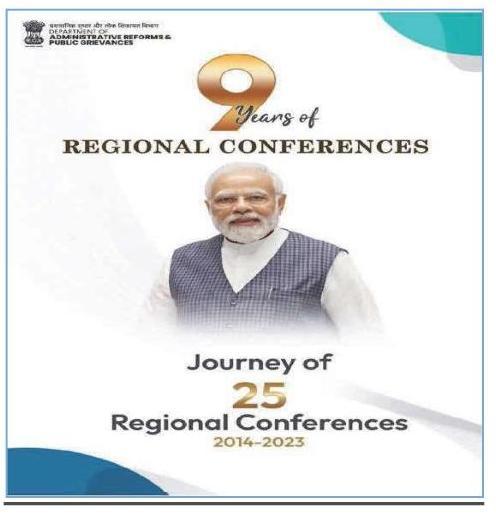
3. Film on Special Campaign: – Four films on the Special Campaign were produced
and screened multiple times on DD News and Sansad TV. Additionally, two panel discussions on Special Campaign 2.0 were held on DD News, and two more on Sansad TV.
4. Publication of e-Journal (MGMG): – The DARPG also published a biannual ejournal titled “Minimum Government Maximum Governance.” These journals featured selected achievement stories related to the Prime Minister’s Excellence Awards and National e-Governance Awards. A special edition of MGMG was published, highlighting the shortlisted initiatives for the National e-Governance Awards.
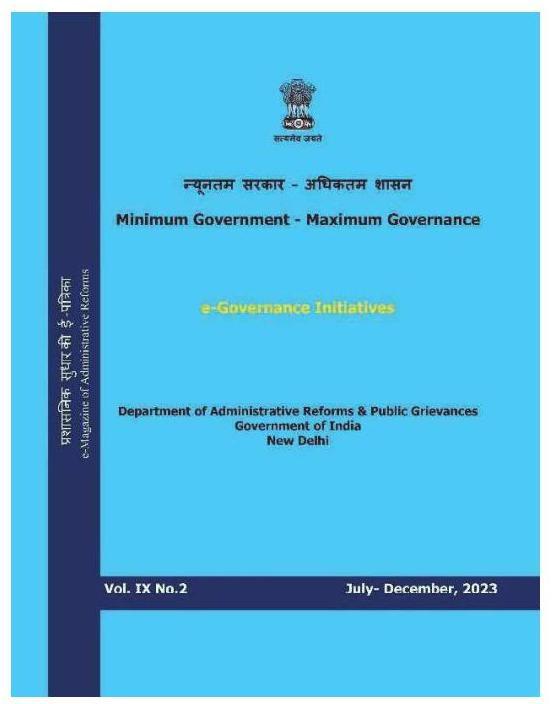
5. The division also produced one main film and 16 citation films for the National Conference on e-Governance, held in Indore in August 2023.
6. During FY 2023-24, the division granted financial assistance to 22 State Collaborative (SCI) projects, and also released Rs. 892 lakhs for the initiatives.
Chapter – 27
Official Language Division
27.00 Implementation of The Official Language Policy Of The Union
Department of Administrative Reforms and Public Grievances is committed to the effective implementation of the Official Language Policy of the Union, and due to these efforts, the use of Official Language in the Department, is increasing successively. The summary of the efforts and the achievements of the year 2023-24, is given below:
27.01 Implementation of the Official Language Policy
The Official Language Division of the Department is headed by Joint Secretary (Admn.). The Official Language Division has sanctioned posts of one Dy. Director, one Assistant Director, one Sr. Translation Officer, one Jr. Translation Officer, one steno and one DEO.
The Division duly monitors the implementation of the Official Language Policy of the union in the Department and its Attached offices/Autonomous Bodies.
The Division is discharging its responsibility of translation of diverse material received from various Sections of the Department, from English to Hindi such as General Orders, Rules, Standard Forms, Notifications, Resolutions, Cabinet Notes, D.O. letters to be issued by and senior officers, Administrative and other Reports and Press Releases etc. referred to in section 3(3) of the Official Language Act, 1963, in addition to Parliamentary and Budgetary matters.
27.02 HINDI SALAHAKAR SAMITI
DARPG, DOPT and DOP&PW have a joint Hindi Salahkar Samiti. Hon’ble Minister Of State for Personnel, is its chairperson. It has 15 non official members, (4 nominated members (MPs), from M/o Parliamentary Affairs, two (MP’s), from Parliamentary Committee on Official Language, 3 Hindi scholars form Department of Official Language, one representative from Kendriya Sachivalya Hindi Parishad, One representative from the Hindi Institute, involved in propagation of Hindi and 4 members are nominated by the Ministry). Besides, Heads of all attached offices of the ministry, and JS and above Level officers of the ministry are official members of the Samiti. The Meeting of the Samiti was organised on $16^{\text {th }}$ August, 2023.
27.03 Official Language Implementation Committee
In the Department, Official Language Implementation Committee has been Constituted under the chairmanship of Secretary, DARPG. Head of the attached office of DARPG and officers of the level of Under Secretary and above of the DARPG, are its members. The meetings of the committee were successfully organised in every quarter in the Department as mandated. Implementation of the Official Language Policy of the union was duly reviewed in the meeting with respect to the Department and its Attached Office/Autonomous Body and various measures were considered to increase the progressive use of Hindi.
27.04 Quarterly Progress Report (QPR) and Annual Assessment Report
A Quarterly Progress Report is compiled after collecting the data from various sections to assess the work done by the personnel in Hindi in their official work and sent to the Department of Official Language on regular basis. Likewise, an Annual Assesment
Report relating to the progressive use of Hindi is also sent to the Department of Official Language.
27.05 Organisation of Hindi Fortnight.
On the occasion of Hindi Diwas on $14^{\text {th }}$ September, like, every year, Hindi fortnight was organised in the department from 14 September to 28 September, 2023 and 05 competitions were held in which personnel participated enthusiastically. A Total of 88 persons participated in the competitions. Awards to Successful participants, were given by Joint Secretary (Admn.), in the prize distribution ceremony, organised on $30^{\text {th }}$ October, 2023.
27.06 Hindi Workshops
Four (4) Hindi Workshops were organized during the year to remove the hesitation of the personnel in doing their official work in Hindi.
27.07 Major Initiatives of Official Language Division
- DARPG’s E-Office has been integrated with the Kanthastha software of the Official Language Department.
- The information on Facebook/Twitter is being issued in bilingual form.
- Translation of the booklet, 9 Years’ Achievement of DARPG.
- Translation of voluminous document of Abhinav Portal.
- Monthly Summary, NESDA Reports, CPGRAMS Report, M.O.U. to be signed by India between different Countries, PM Awards relating documents are regular activities.
Observance of Vigilance Awareness Week 2023
Vigilance Awareness Week is observed every year to commemorate the birthday of Sardar Vallabhbhai Patel. In the year 2023, it was observed from $30^{\text {th }}$ October to $05^{\text {th }}$ November with the theme “Say No to Corruption; Commit to the Nation”. On the occasion, DARPG Secretary, Shri V Srinivas led the way by administering the integrity pledge to the Officers/Employees/Staff at Jawahar Vyapar Bhawan, New Delhi.
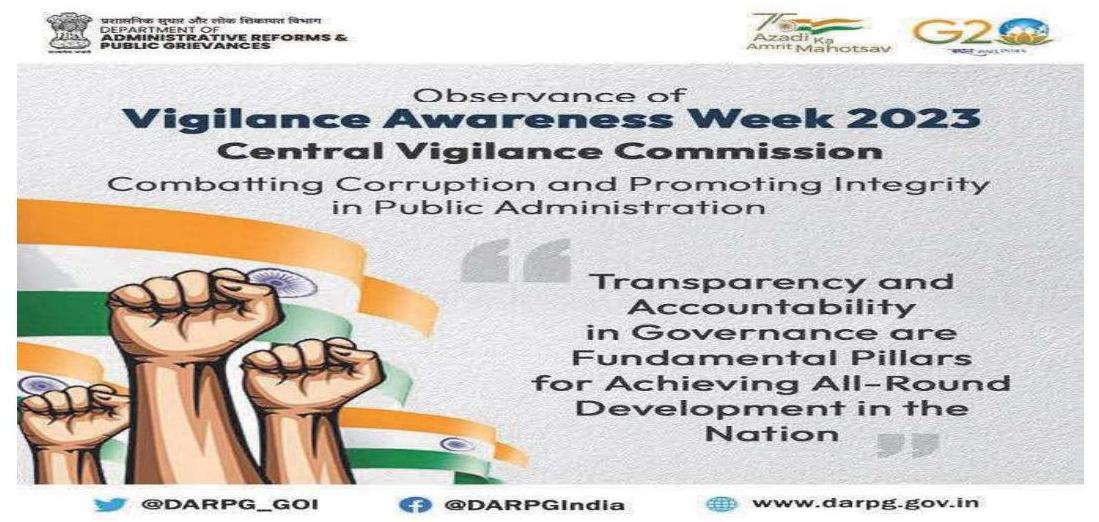
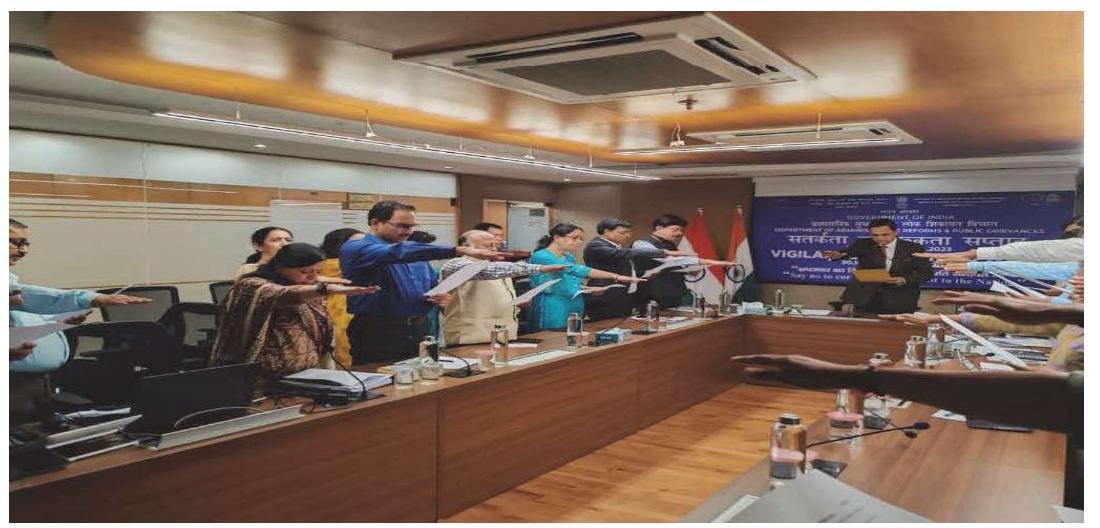
Celebration of International Women’s Day 2024
International Women’s Day is celebrated in India on March 8th every year. The day is observed to celebrate the social, economic, cultural, and political achievements of women and to call for gender equality. The day is also a time to recognize the contributions of women in various fields, such as science, technology, politics, education, and business.
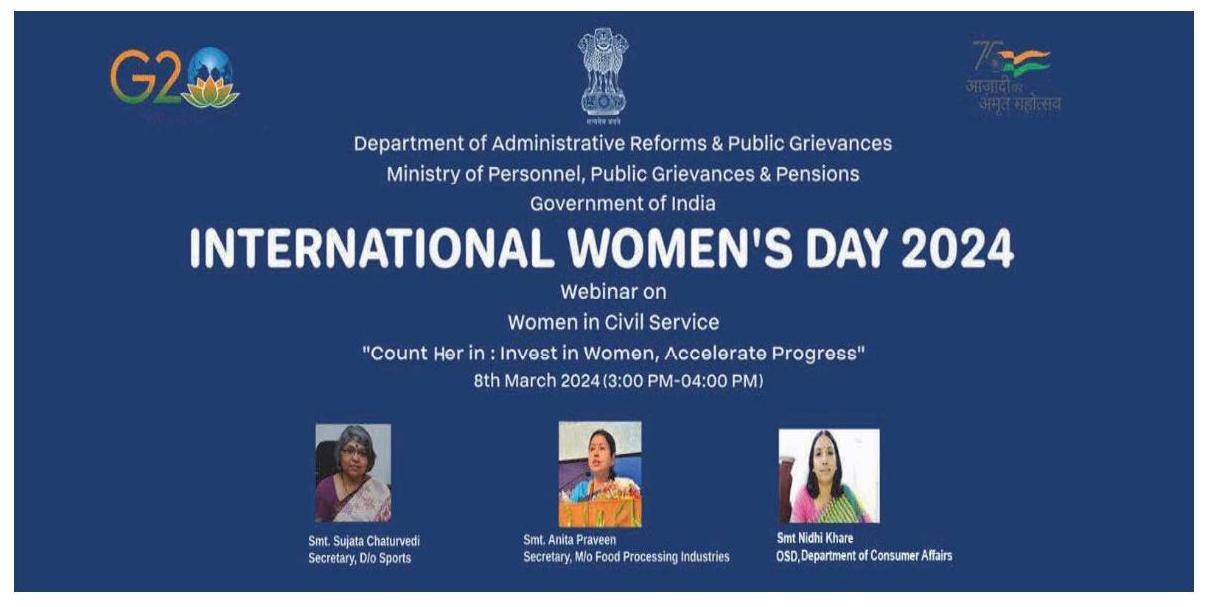
DARPG organised a Virtual Round -Table webinar “Women in Civil Service” on the theme “Count Her In: Invest in Women, Accelerate Progress “on 8th March 2024 to promote and celebrate women’s empowerment in all its dimensions. Three distinguished lead speakers viz. Smt. Sujata Chaturvedi, Secretary, D/o Sports; Smt. Anita Praveen, Secretary, M/o Food Processing Industries and Smt. Nidhi Khare, OSD, Department of Consumer Affairs, addressed the webinar on the occasion of International Women’s Day 2024. All Officials/Officers of DARPG, DoPPW, District Collectors across the country attended the webinar.
CHAPTER 28
DEPARTMENT OF PENSION AND PENSIONERS’ WELFARE
Major Highlights:
- Strengthening Pensioners’ Grievance Redressal Machinery (CPENGRAMS) : In 2019, Pensioners’ grievance redressal system was expanded with the objective to provide easy access to pensioners for registering their grievances.
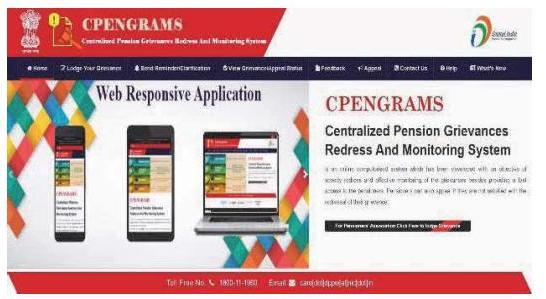
In this regard, Integrated Grievance Cell & Call Centre was inaugurated on $20^{\text {th }}$ June, 2019 so that the pensioners could register their grievances by calling on the toll-free number 1800-11-1960.
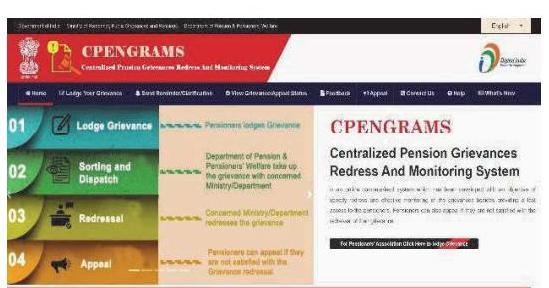
- The number of pensioners/family pensioners using the facility of Call-Centre, is increasing continuously and as on 31.03.2024 more than 39509 grievances have been registered by Call Executives since its inception. Total number of grievances registered, from 01.04.2023 to 31.03.2024, were 89287, out of which 80711 grievances were disposed of $(90.39 %)$ during the said period.
- Status of CPENGRAMS of top 10 Ministries for the period 01/04/2023 to 31/03/2024
| Grievances | ||
|---|---|---|
| Ministry | Received | Redressed |
| Pr. CDA Pension Allahabad |
25319 | 24196 |
| Department of Ex Servicemen Welfare |
23031 | 20709 |
| Department of Financial Services (Banking Division) |
12276 | 12195 |
| Department of Defence Finance |
10689 | 9566 |
| Ministry of Railways (Railway Board) |
8152 | 8103 |
| Employees Provident Fund Organisation (Head Office) |
4977 | 4938 |
| Ministry of Home Affairs |
2234 | 2138 |
| Department of Telecommunications |
2688 | 2609 |
| Department of Posts | 1689 | 1686 |
| Central Board of Indirect Taxes and Customs |
836 | 847 |
- Out of total registered grievances, $\mathbf{8 3 . 5 6 \%}$ (approx.) were received online, $\mathbf{1 1 . 1 7 \%}$ through call centre via the toll-free no of DOPPW 1800-11-1960 and 4.66 \% by post.
- Comparative position of grievances
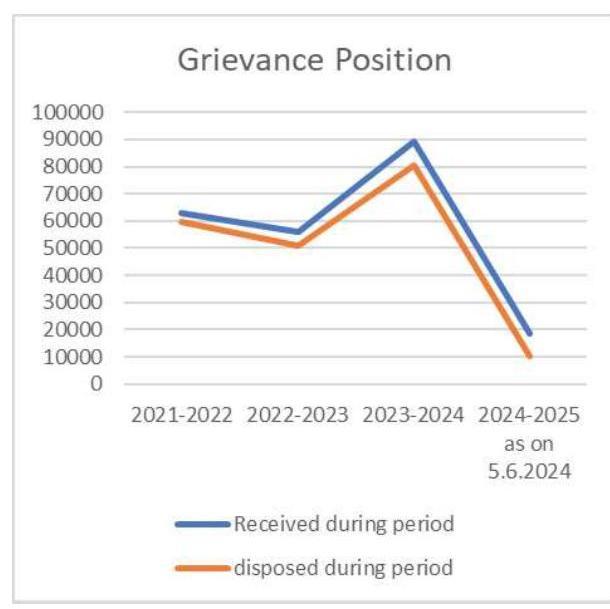
- Anubhav Portal and Award: On the directions of the Hon’ble Prime Minister of India, Department of Pension & Pensioners’ Welfare (DoPPW) had launched an online platform titled ‘Anubhav’ in March 2015. It is a means for retiring employees to showcase their significant achievements made during their service period. As on date 96 Ministries/ Departments/ Organizations have registered on Anubhav Portal and 10613 write-ups published as on 10.04.2024. As of now, six Anubhav Awards Ceremonies have been held in 2016, 2017, 2018, 2019, 2022 and 2023. 54 Anubhav Awardees and 09 Jury Certificate were given. During the Anubhav Awards ceremony held on 23.10.2023 at Vigyan Bhawan, New Delhi, 04 Anubhav Awards and 09 Jury Certificates were given. The Awardee were from Ministry of Defence (DRDO), MHA (CISF and CRPF), MoHUA, Department of Posts, Department of Space and D/o Revenue (CBDT).
- Pension Adalat: In 2018, the concept of the All India Pension Adalat was
introduced, conducting Pension Adalats across various Ministries, Departments, and Organizations on a single day throughout - the country, including all Central Armed Police Forces and non-civil Ministries like Defence, Railways, Telecom, and Posts. The first Pension Adalat of the Department was held on 20.9.2017 in New Delhi and the last Pension Adalat was held on 22.2.2024. Till date, ten Pension Adalats have been conducted by DoP\&PW and out of 24,926 cases taken up in all the Pension Adalats, 17,760 grievances were resolved $(71.25 %)$ by the different Ministries/Departments/ Organisation which participated in this initiative.
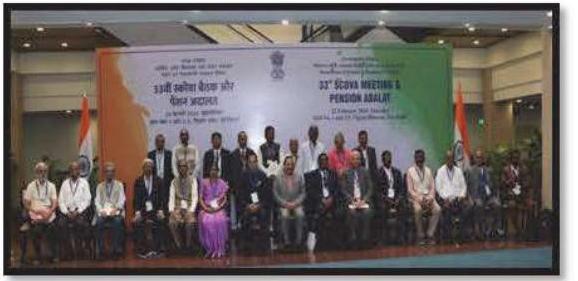
- Bhavishya : To overcome the problems of delay \& clerical errors in processing the pension cases, duplication as well as financial loss and harassment to the pensioners, the DOPPW introduced a unique innovative centralized pension processing software called ‘Bhavishya’ for all central government Ministries/Departments. At present, 98 Ministries/ Departments, 869 Offices and 8174 DDOs are on Board and 1,67,688 ePPOs have been issued till 09.04.2024.
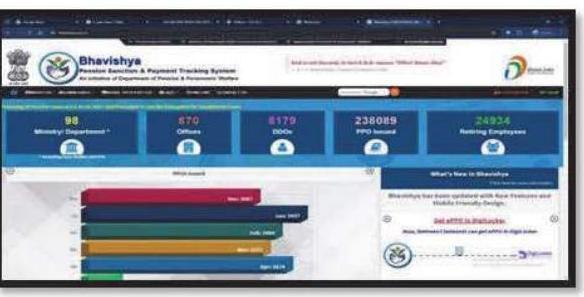
- Outreach Activities: DoPPW has adopted a gradual shift towards spreading awareness
amongst the targeted groups through social media such as Facebook, Twitter and Documentary films, YouTube etc. From April 2023 to March 2024, there were 2340 tweets on twitter and 500 posts on Facebook, a documentary on Anubhav Awards, SOP on Digital life certificate through face authentication (Jeevan Pramaan), a film on_Digital life Certificate, steps to upload Write-ups on Anubhav Portal and an educative video on CPENGRAM Portal were uploaded on YouTube.
- Jeevan Pramaan: A pensioner is required to produce life certificate annually, in November, for continuation of pension. Jeevan Pramaan, an Aadhar based scheme for Digital Life Certificate (DLC), was launched by the Hon’ble Prime Minister in November, 2014 to facilitate pensioners to submit life certificate anytime, from anywhere. This was extremely useful, particularly to aged and infirm pensioners. Department of Pension & Pensioners’ Welfare, promoted DLCs, with special emphasis on the milestone technology of Face Authentication, through Nation-wide DLC Campaigns held in November, 2022 and November, 2023. More than 1.48 crore total DLCs were generated in the Nation-wide DLC Campaign 2.0 in November, 2023. Out of this more than 45.00 lakhs were Central Government pensioners.
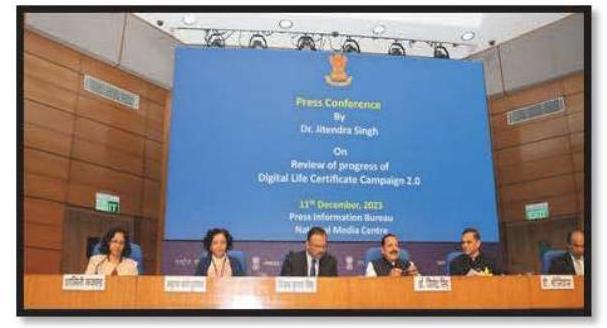
- Banks Awareness Program Series: Department of Pension and Pensioners’ Welfare has started a series of
Awareness Programs for field functionaries handling pension related work in banks, in which, a team of officers from DoPPW take sessions on Central Government Pension policy rules, reforms \& digitization. Seven such Awareness Programs have been held so far for filed functionaries of various Banks, viz. State Bank of India, Punjab National Bank, Canara Bank, Bank of Baroda.
- Pensioners’ Awareness Program : Department of Pension and Pensioners’ Welfare conducted the first post pandemic Pensioners’ Awareness Program at Puducherry on $28^{\text {th }}$ June, 2022 which was attended by more than 300 pensioners from Chennai and Puducherry. Special sessions were organized on Income Tax matters, CGHS and Digital Life Certificates. Similar interactive meetings and Awareness Programs for pensioners were also held at Pune in May, 2023 and at Bengaluru in November, 2023. In addition, online interactive meetings are also held with Pensioners’ Welfare Associations on monthly basis to apprise them of updated rules and take note of their queries, grievances and suggestions.
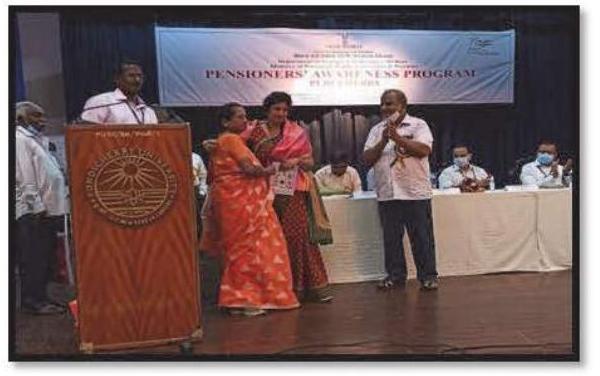
- Standing Committee of Voluntary Agencies (SCOVA): The Standing Committee of Voluntary Agencies (SCOVA) was constituted in 1986 under the Chairmanship of Minister of State for Personnel, Public Grievances and Pensions. The SCOVA works as a
consultative forum of Voluntary Agencies SCOVA provides Pensioner Welfare Associations an institutional forum for before the concerned Ministries/ Departments through constructive deliberations. The $33^{\text {rd }}$ meeting of the Standing Committee of Voluntary Agencies (SCOVA) was held at New Delhi on $22^{\text {nd }}$ February, 2024 under the Chairmanship of Dr. Jitendra Singh, Hon’ble Minister of State for Personnel, Public Grievances and Pensions. 10 major Agenda items relating to welfare of pensioners were taken up in the meeting.
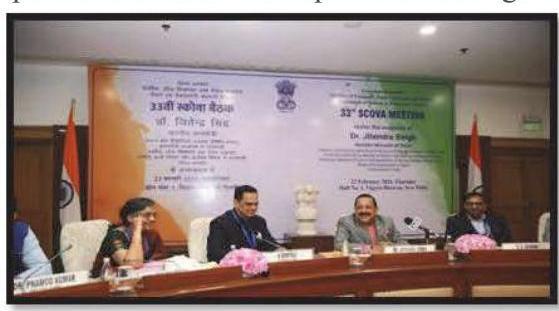
Key decision:
Operationalisation of $2^{\text {nd }} \quad$ CGHS
Wellness Centre -Additional Director
raising issues concerning pensioner welfare directly
(CGHS), Chandigarh informed that $2^{\text {nd }}$ CGHS Wellness Centre would be made operational by $15^{\text {th }}$ March, 2024. The $2^{\text {nd }}$ CGHS Wellness Centre was made operational on 13.05.2024.
Construction of CGHS Polyclinic/ Hospital at Jammu- Additional Director (CGHS), Chandigarh informed that J&K administration has allotted a land parcel in the name of Health and Education Department. Chairman, SCOVA directed Ministry of Health and Family Welfare to actively pursue the matter.
CHAPTER 28
DEPARTMENT OF PENSION AND PENSIONERS’ WELFARE
28.0 The Department of Pension & Pensioners’ Welfare was set up in 1985 as part of the Ministry of Personnel, Public Grievances and Pensions to formulate policy and coordination of matters relating to retirement benefits of Central Government employees. Being the nodal Department for pension and pension related matters, the Department receives a large number of references from Ministries/ Departments and also renders advice on interpretation of Pension Rules. In 2007, the Department initiated a web-based scheme titled – Pensioners’ Portal- which has now been expanded to run all pension welfare activities of Central Government Pensioners.
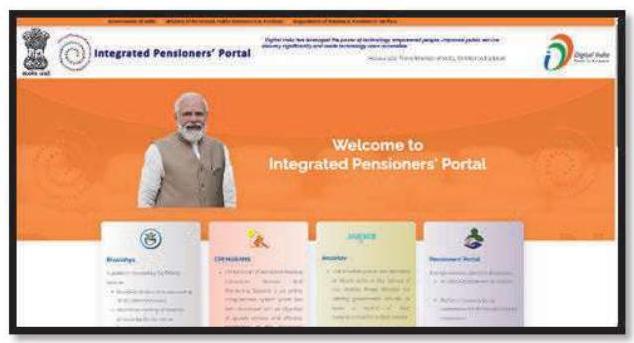
28.1 The Allocation of Business Rules broadly allocates the following areas of working to the Department: – Formulation of policy and co-ordination of matters relating to retirement benefits to Central Government employees. The Central Civil Services (Pension) Rules, 2021; the Central Civil Services (Implementation of National Pension System) Rules, 2021; the Central Civil Services (Payment of Gratuity under National Pension System) Rules, 2021; the Central Civil Services (Commutation of Pension) Rules, 1981; the Central Civil Service (Extraordinary Pension) Rules, 2023; any other scheme relating to Central Government pensioners, entrusted to the Department; pension structure and relief to pensioners; new facilities of fringe benefits to the Central Government pensioners; matters relating to amendment to or relaxation of Pension rules or any other rule concerning retirement benefits; Policy and co-ordination relating to welfare of Central Government
Pensioners. Matters with financial
implication shall be subject to the concurrence of Ministry of Finance. Action in respect of other matters involving recurring financial implications by way of relaxation or liberalization of any rule shall be subject to guidelines as agreed to between the Department of Pension and Pensioners’ Welfare and the Ministry of Finance, Department of Expenditure.
28.2 The approximate number of Central Government Pensioners as on 31/03/2024 is as follows:
| S. No. | Pensioner/Family Pensioner | Number of Pensioners including Family Pensioners | |
|---|---|---|---|
| A. | Pensioners (including Family Pensioners) of all Ministries/ Departments under the Accounting jurisdiction of Controller General of Account, M/O Finance. | $10,09,702$ | |
| B. | Defence Pensioners (including Family Pensioners) |
$31,92,265$ | |
| C. | Railway Pensioners (including Family Pensioners) |
Pensioners Family |
$15,25,768$ |
| D. | Telecom Pensioners (including Pensioners) |
Pensioners Family |
$4,56,505$ |
| E. | Postal Pensioners (including Pensioners) |
Pensioners Family |
$3,04,428$ |
| Grand total of pensioners (including Family Pensioners) |
$64,88,668$ | |
|---|---|---|
| Grand total of family pensioners only |
$20,25,576$ |
(in lakh)
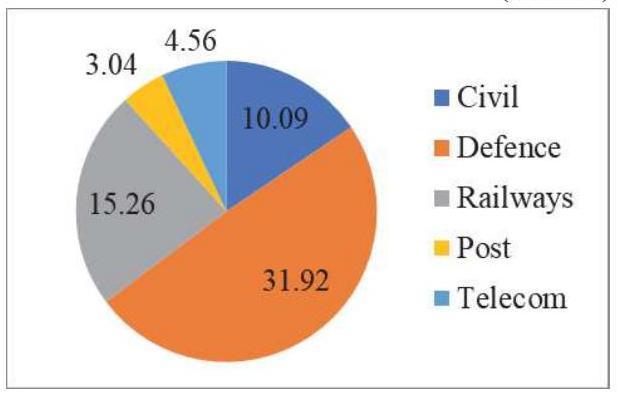
28.3 Pensioners’ Portal:
- The scheme, ‘Pensioners Portal’ was started with an objective to serve as a one stop information source for the pensioners of Government of India and also facilitate redressal of their grievances online. With the passage of time, new activities were added under the ‘Pensioners Portal’ which now includes CPENGRAM, Bhavishya, Anubhav and Sankalp etc. with an objective to create a single window system for civil pensioners.
- Pensioners’ Portal through its website provides pensioners with updated information on pension rules, personalized pension road map, online calculator for calculation of pension/family pension and redressal of Pensioners’ grievances through CPENGRAM. With effect from 01.01.2017, for ensuring transparency and accurate and timely settlement of pension dues it was made mandatory for all Ministries/ Departments to process pension cases on Bhavishya. Experiences of retirees while working in the government are being preserved in Anubhav which has become a treasure-house of information pertaining to various departments. Sankalp aims to prepare employees for post-retirement life.
28.4 Budget –
In the year 2023-24, Department has been allocated Rs 2044.00 Lakhs to meet its expenses.
| Object Head: Secretariat General Service Non-Scheme (Revenue) | $\begin{aligned} & \text { RE 2023- } \ & 24 \text { (Rs. in } \ & \text { lakhs) } \end{aligned}$ |
|---|---|
| Salary | 439.00 |
| Wages | 1.00 |
| Rewards | 3.00 |
| Medical Treatment | 10.00 |
| Allowances | 323.00 |
| Leave Travel Concession | 9.00 |
| Training Expenses | 2.00 |
| Domestic Travel Expenses | 10.00 |
| Foreign Travel Expenses | 5.00 |
| Office Expenses | 116.00 |
| Rent, Rates and Taxes for Land and Buildings | 350.00 |
| Printing and Publication | 10.00 |
| Rent for others | 1.00 |
| Digital Equipment | 9.00 |
| Fuel and Lubricants | 3.00 |
| Minor civil and electrical works | 247.00 |
| Professional Services | 12.00 |
| Repair and maintenance | 3.00 |
| Bank and agency charges | 1.00 |
| Other revenue expenditure | 5.00 |
| Swachhta Action Plan | 10.00 |
| Total | 1569.00 |
| Pensioners Portal (Plan Scheme) | RE (Rs. in lakhs) |
| Salary | 1.00 |
| Domestic Travel Expenses | 30.00 |
| Office Expenses | 150.00 |
| Advertising and Publicity | 55.00 |
| Professional Services | 153.00 |
| Grants-in-aid-General | 35.00 |
| Total | 424.00 |
| Capital Outlay on Administrative Services | RE (Rs. in lakhs) |
| Information, Computer, Telecommunications (ICT) | 10.00 |
| Motor Vehicles | 19.00 |
| Machinery & Equipment | 11.00 |
| Furniture and Fixtures | 11.00 |
| Total | 51.00 |
| Grand Total | 2044.00 |
The Hon’ble Prime Minister in Chintan Shivir held on 18:02:2023 shared his vast experiences in Governance, urged officials that impersonal governance models need to find life through deep personal commitment.
This could be achieved through personal interactions, spending time together to think about common good and seeking to find happiness in every job assigned. The corollary is that lack of deep personal
commitment, inability to work in team, inertia at work place result in institutional decay. Deep personal commitment in the case of “Redressal of Public Grievances” necessitates to holistically merge technology with citizen engagement. Such citizen engagement will necessitate all levels of the department to study individual grievances and engage with citizens on a regular basis to find solutions. The Chintan Shivir laid down a futuristic model of governance.
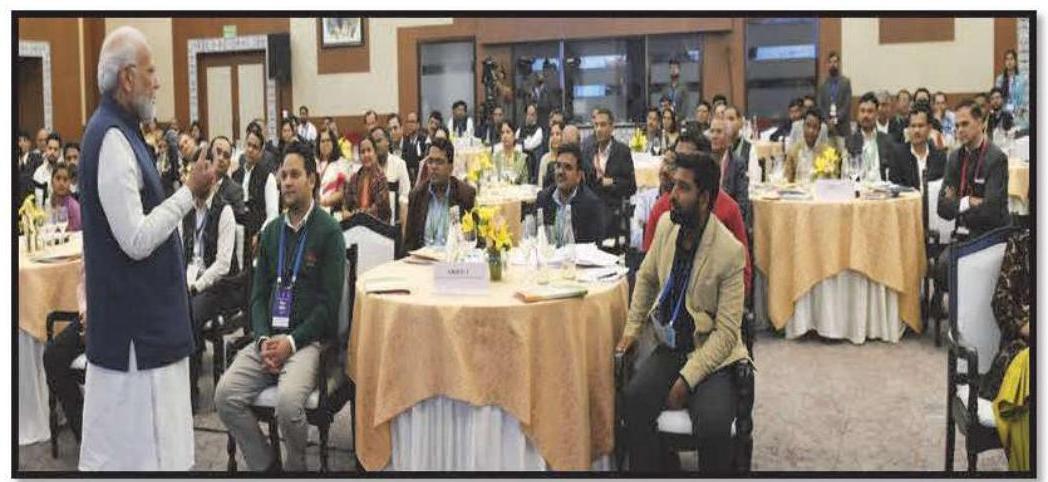
Hon’ble Prime Minister Addressing the participants in Chintan Shivir
28.5 Important Policy decisions taken by the Department
28.5.1 Central Civil Services (Pension) Rules, 2021
- On the Good Governance Day, 2022 (25th December, 2022), Hon’ble MoS(PP) released a book on the Central Civil Services (Implementation of National Pension System ) Rules, 2021 published by the Department of Pension & Pensioners’ Welfare. These Rules were earlier notified on 30.03.2021. These Rules inter alia cover the matters relating to registration process and allotment of PRAN, contributions by the employee and the Government, compensation to be paid to the Government servant in case of delay in registration and credit of contributions to
the NPS Account, option for benefits under the CCS(Pension) Rules or NPS Rules in
the event of death or disability of Government servant during service, entitlements on superannuation, premature/ voluntary retirement, resignation from service, etc. and the procedure for processing of claims under NPS. - Department has simplified Provisions of Pension Rule and had issued instructions during the Special Campaign 3.0 on Swachhata launched by Department of Administrative Reforms and Public Grievances (DARPG) for disposal of Pending Matters during 2nd October, 2023 to 31st October 2023. Under this campaign, Department of Pension and Pensioners Welfare issued five (5) Notifications/Circulars for ease of rules
with respect to NPS matters during the month of October, 2023.
28.5.2 National Pension System (NPS)
- National Pension System (NPS) was introduced for Central Government employees w.e.f. 01.01.2004 vide Ministry of Finance (Department of Economic Affairs) Notification No. 5/7/2003-ECB & PR dated 22.12.2003 for all new recruits to the Central Government service (except armed forces) from 01.01.2004. On introduction of the NPS, among others, the Central Civil Services (Pension) Rules, 1972 and the Central Civil Services (Extraordinary Pension) Rules, were amended on 30.12.2003. Accordingly, the benefits of old pension scheme are not admissible to the Government servants appointed on or after 01.1.2004, under the amended rules.
- Department of Pension and Pensioners’ Welfare vide O.M. No. 7/5/2012P\&PW(F/B) dated 26.08.2016 had extended the benefit of retirement gratuity and death gratuity to the Central Government employees covered under NPS on the same terms and conditions as are applicable under CCS(Pension) Rules, 1972.
- Further, vide DoPPW O.M. No.7/5/2012P\&PW(F/B) dated 12.02.2020 instructions had been issued for counting of service for the purpose of grant of gratuity or grant of pro-rata gratuity in case of mobility of a Central Government employee covered under NPS to other organizations through proper channel.
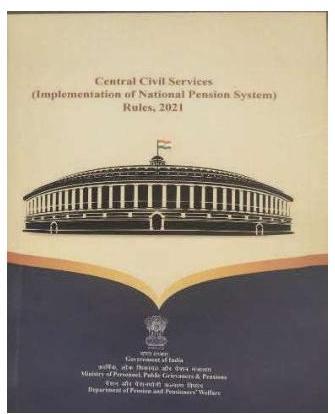
- Instructions have been issued vide OM No. 57/4/2019-P\&PW(B) dated 17.02.2020 by Department of Pension and Pensioners’
- Welfare providing that in all cases where the results for recruitment were declared before 01.01.2004 against vacancies occurring on or before 31.12.2003, the candidates declared successful for recruitment shall be eligible for coverage under the Central Civil Services (Pension) Rules, 1972. Accordingly, such Government servants who were declared successful for recruitment in the results declared on or before 31.12.2003 against vacancies occurring before 01.01.2004 and covered under the National Pension System on joining service on or after 01.01.2004, may be given a one-time option to be covered under the Central Civil Services (Pension) Rules, 1972. Further, clarifications were issued vide OM dated 25.06.2020 to clarify major doubts raised by Ministries / Departments with respect to instructions issued in OM dated 17.02.2020.
- Instructions has been issued in respect of Government employee appointed on or after 01.01.2004 and covered under NPS is disabled, he shall also be eligible to receive a lump sum compensation computed in terms of rule 9(3) of CCS (EOP) Rules, if the disablement is attributable to Government service and the Government employee is retained in service in spite of such disablement. (OM No 1/3/2019P\&PW (F) dated 01.01.2021).
- In compliance to the recommendation of the Committee constituted for suggesting measures for streamlining implementation of National Pension
System, Department of Pension and Pensioners’ Welfare in consultation with other concerned Ministries / Departments notified Central Civil Services (Implementation of National Pension System) Rules, 2021 on 31.03.2021 for regulating service related matters for Central Government employees covered under NPS. These rules includes, applicability of NPS, general conditions, emoluments, contribution, provision for interest on delayed contribution, provision for option to choose benefits under old pension scheme or National Pension System in the event of death of Government servant or his discharge from service on invalidation or disablement, provision for Voluntary retirement, treatment of resignation, removal/ dismissal from service, compulsory retirement and absorption in corporation or body etc.
- Department of Pension and Pensioners’ Welfare in consultation with other concerned Departments, have notified Central Civil Services (Payment of Gratuity under National Pension System) Rules, 2021 on 24.09.2021 for regulating grant of retirement gratuity and death gratuity to Central Government employees covered under NPS.
- Considering the hardship being faced by the family of missing Government employees appointed on or after 01.01.2004, during service, benefit of CCS(Pension) Rules, in accordance with this Department’s OM No. 1/17/2011P&PW(E) dated 25.06.2013 has also been extended vide Department of Pension and Pensioners’ Welfare OM No. 57/03/2020P\&PW(B) dated 28.04.2022 to the family of missing Government employee covered under NPS during service and in accordance with the option exercised by the Government employee or default option in this regard as provided in Central Civil Services (Implementation of National Pension System) Rules, 2021.
- Subsequently, another set of instructions were issued vide OM No. 57/05/2021P\&PW(B) dated 03.03.2023 giving one-
time option to the Central Government civil employee who has been appointed/ recruited against a post or vacancy which was advertised/ notified for recruitment/ appointment prior to notification for National Pension System i.e. 22.12.2003. A number of clarifications on these issues were also issued from time to time. - Department of Pension \& Pensioners’ Welfare has issued instructions vide its OM No. 1(2)/2023 P\&PW (H) dated 25.9.2023 regarding facilitation of Digital Life certificate through Face Authentication for Super Senior Pensioners aged 80 years and above from 1st October every year.
28.5.3 Compendium of Advisories issued
Department of Pension \& Pensioners Welfare has issued compendium of Pension related instructions during January, 2022 to August, 2023 which are quite helpful in sorting out complicated issues involve in Pension Policy matters such as NPS matters, disciplinary matters, etc.
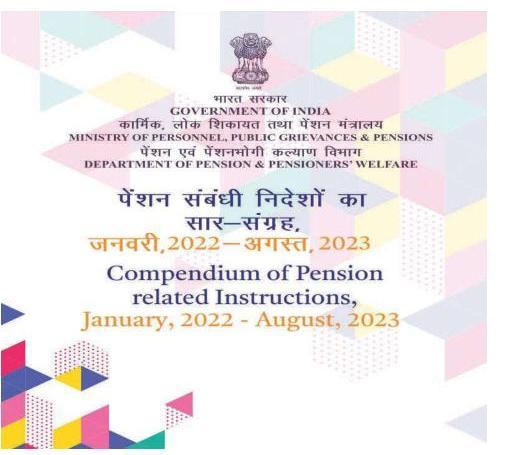
28.5.4 Amendment to Rule 37 of CCS(Pension) Rules, 2021
- The Rule 37 of CCS (Pension) Rules, 2021 envisages that in case of any grave misconduct the penalty imposed by the PSU where the Government Servant has been absorbed shall not amount to forfeiture of his retirement benefits for the service rendered under the Govt. However, Hon’ble Supreme Court of India in its judgment dated 09.01.2023 did not agree to this provision stating it discriminatory.
Department of Telecom has requested to amend this Rule proposing to forfeit service rendered in government in case of misconduct leading to dismissal and removal.
- DoPPW has agreed to the proposed amendment of Rule 37(29)(c) by Department of Telecommunication (DoT). DoPPW has invited comments of Department of Expenditure, and Department of Legal Affairs in the matter, on receipt of comments further action will be taken.
28.5.5 Integration of Railway Pension Rules with CCS(Pension) Rules, 2021
- Department related Parliamentary Standing Committee on Personnel, Public Grievances, Law & Justice in its $113^{\text {th }}$
Report (Para 3.331) recommended for bringing the Railway Pensioners under the Jurisdiction of the DoPPW. - Integrating Railway (Pension) Rules and CCS (Pension) Rules to achieve an overall standardization of pension rules and uniformity in applicability. This would subsequently have a manifold impact in the overall objective of unification of Rules and procedures.
- Department of Expenditure (DoE) has raised certain observations on the merger proposal. An inter-ministerial meeting was held with officers of Ministry of Railways and Department of Expenditure on issues raised by DoE. Consensus reached in this meeting on various aspects of integration. In 2024, merger proposal will be firmed up for the approval of Cabinet.
28.6 Improving Pensioners Welfare related matters
28.6.1 Strengthening Pensioners ${ }^{+}$Grievance Redressal Machinery (CPENGRAM)
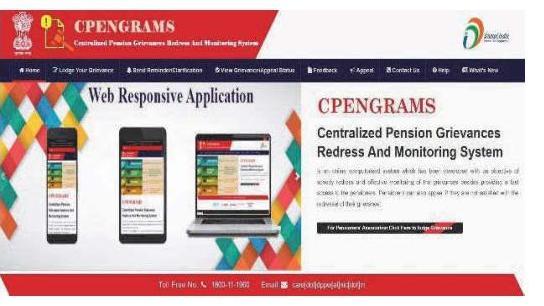
- CPENGRAMS is an on-line computerised system developed with the objective of speedy redressal and effective monitoring of the pension related grievances for the Central Civil Pensioners. The grievances are either registered directly on the portal or registered by the department on behalf of the complainant after receiving details through e-mail, Post or Integrated Grievance Cell \& Call Centre’s Toll-free number: 1800-11-1960.
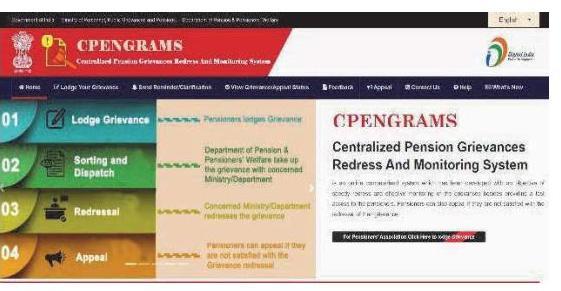
- During this financial year, DoPPW worked upon the improvement of the quality of disposal, strengthening of existing redressal system and enhancement of citizen connect. These initiatives have brought about landmark improvements.
- Active coordination with all the stakeholders and thereby breaking the silos by regular meetings led to all time high 85,535 in FY 2023-24 as compared to 54,140 grievances in FY 2022-23, registering the growth of $58 %$.
- Status of CPENGRAMS of top 10 Ministries for the period 01/04/2023 to 31/03/2024
| Grievances | ||
|---|---|---|
| Ministry | Received | Redressed |
| Pr. CDA Pension Allahabad |
25319 | 24196 |
| Department of Ex Servicemen Welfare |
23031 | 20709 |
| Department of | 12276 | 12195 |
| Financial Services (Banking Division) |
||
|---|---|---|
| Department of Defence Finance |
10689 | 9566 |
| Ministry of Railways (Railway Board) |
8152 | 8103 |
| Employees Provident Fund Organisation (Head Office) |
4977 | 4938 |
| Ministry of Home Affairs |
2234 | 2138 |
| Department of Telecommunications |
2688 | 2609 |
| Department of Posts | 1689 | 1686 |
| Central Board of Indirect Taxes and Customs |
836 | 847 |
– CPENGRAMS – Receipts and Disposal:
Total number of Pension grievance cases disposed since 2019 is $3,20,338$. The number of pensioners/family pensioners using the facility of Call-Centre, is increasing continuously and as on 31.03.2024 more than 39,509 grievances have been registered by Call Executives since its inception.
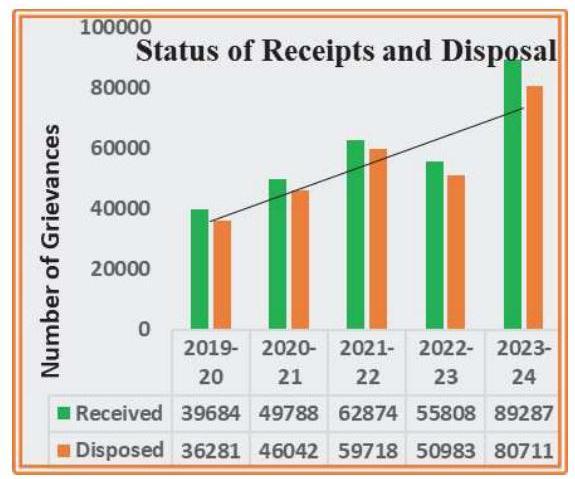
– CPENGRAMS – Disposal Time
In the year 2019 the average disposal time of grievances was 37 days, in 2020 it was 33 days and in the current year, it is only 23 days.
This is possible by continuous monitoring and Inter Ministerial Review Meetings (IMRM) conducted monthly.
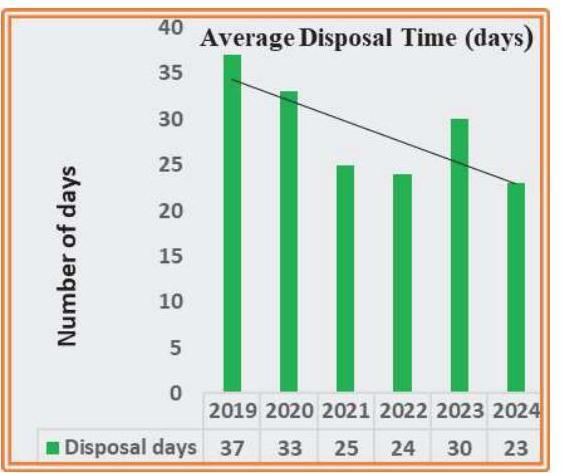
- The surge in the defence pensioners’ grievances was deeply analysed by holding meeting with PCDA, Pension, Allahabad. Further, a meeting was also held between Secretary (Defence) and Secretary (Pension) on 26.12.2023 on the issue of defense pensioners’ grievances. Thereafter, suitable instructions were issued by the Office of Financial Adviser (Defense Services).
- These active engagements bore encouraging results as in January 2024, 6137 CPENGRAMS cases of Defence Pensioners were redressed as compared to 4288 in December, 2023. The rate of redressal was also maintained further.
- DoPPW is committed towards quality redressal of pensioners’ grievances. Therefore, to achieve the same and to ensure compliance of recommendations of DRPSC in its 127th report, Feedback unit was established in the CPENGRAMS Desk. The disposed cases were examined and it was noticed that pre-mature closure of the grievances is the primary reason for the ‘Poor’ feedback provided by the complainants. Accordingly, an OM dated 23.08.2023 was issued which, among other things, stipulates that the case is to be closed only after ultimate and conclusive redressal. Also, the stakeholders were
regularly encouraged to adhere to the provisions of this OM.
- The Feedback unit also re-registered 535 deserving cases. This has helped many pensioners got their pensionary dues running in lakhs of rupees after a long period. Some of the examples are as under:
i. Ms. Anuradha Prajapati, a dependent unmarried daughter along with commencement of her family pension, got arrear of more than Rs. 16 Lakh after 06 years of her parents’ death.
ii. Ms. Jamuni Devi, a widow of pensioner received arrear of more than 12 Lakh after 8 years of death of her husband and her family pension was also started.
iii. Ms. Rajesh Kumari, a second wife was sanctioned arrears of Rs. 23.95 Lakh after 8 years of death of her husband.
iv. Sh. Vikas M Fursule got postretirement benefits of more than Rs. 11.93 Lakh, pending for one year after retirement.
v. Ms. Anita Chaterjee a widow received Long Term Arrears of Rs. 14 Lakh which was pending for more 17 years. - DoPPW accords highest priority to the Super senior pensioners and therefore, special efforts viz. Issue of reminders through the portal and e-mails were done.
- Citizen connect was also a major area of thrust in this financial year. Accordingly, capacity building of Department’s Call Centre, release of video showing the utility of the portal along with steps to file grievances and involvement of Pensioners’ Welfare Associations. Further, DoPPW has issued approval for the engagement with MeitY for providing facility of filing grievances through their
vast network of Common Service Centres. Providing the CPENGRAMS portal in all 22 scheduled languages is being processed. - Monthly report on CPENGRAMS and Bhavishya was revamped and various additional features viz. comparative analysis of the Ministries/Departments in terms of redressal, pendency and Appeal filed, success stories, testimonials, performance of call centre and presentation in graphical manner were added.
– Highlights in the monthly Reports
Monthly report gives an overall picture of the status of the grievances/Appeals viz. total receipts, disposal, pendency, redressal rate, performance of different Ministries/ Deptts. on CPENGRAMS Portal.
The surge in the defence pensioners’ grievances, as reported in the monthly reports, was deeply analysed and a meeting was also held between Secretary (Defence) and Secretary (Pension) on 26.12.2023 on the issue of defense pensioners’ grievances. Thereafter, suitable instructions were issued by the Office of Financial Adviser (Defense Services).
These active engagements bore encouraging results as policy intervention has helped in reducing defence pensioners’ grievances pendency on CPENGRMAS portal considerably enabling DoPPW achieve all time high of 9399 pension grievance redressal in February, 2024.
CPENGRAMS & BHAVISHYA Monthly Reports
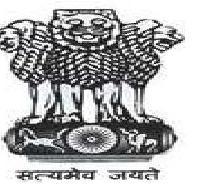
Government of India
Ministry of Personnel, PG & Pensions
Department of Pension and Pensioners’ Welfare
CPENGRAMS & BHAVISHYA
MONTHLY REPORT
SEPTEMBER, 2023
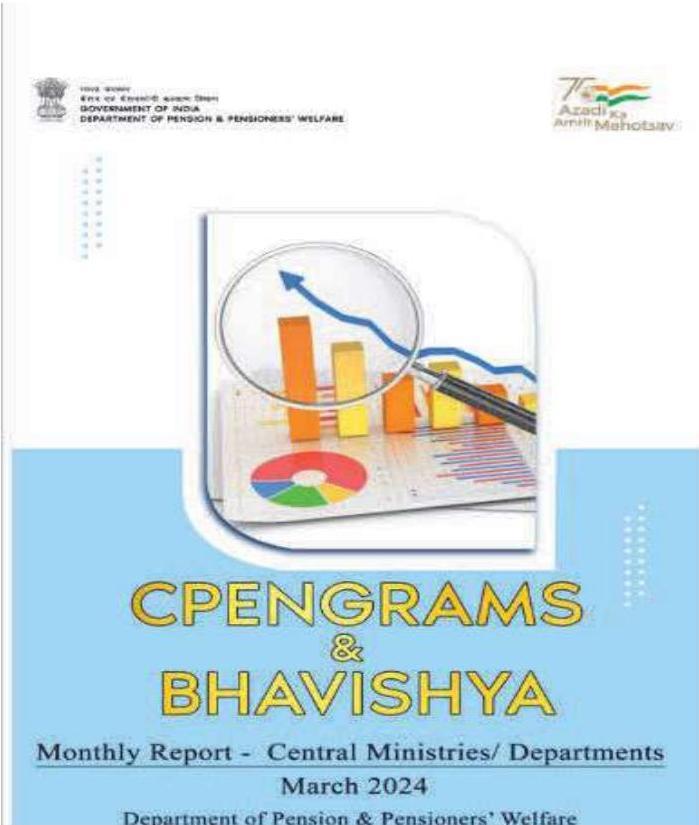
28.6.2 Pension Adalat
- Redressal of Pensioners Grievances is a high priority of Government. With a view to strengthen the grievance redressal mechanism, DoPPW had started the unique experiment of holding Pension Adalats to resolve chronic grievances of Central Govt. Pensioners, falling within the four walls of extant policy. In 2018, the concept of the All India Pension Adalat was introduced, conducting Pension Adalats across various Ministries, Departments, and Organizations on a single day throughout the country, including all Central Armed Police Forces and non-civil Ministries like Defence, Railways, Telecom, and Posts. This was one of the most extensive resolution exercises ever undertaken in the country.
- The objective was to provide on-the-spot resolution of unresolved grievances in CPENGRAMS Portal. In the Adalat, the concerned Ministry/Department, the PAO, the concerned Bank and representative of the Pens ioner are called on a single platform for resolution of the grievances across the table, thereby reducing the need for court cases from pensioners and providing them relief. However, the decision/award of these Pension Adalats does not have any judicial/quasi-judicial sanctity, as it is a forum/platform where the pensioner or his representative can meet all the stakeholders and resolve the issue.
- Pension Adalat has emerged as an effective platform for the redressal of pension grievances. The first Pension Adalat of the Department was held on September 20, 2017 in New Delhi and the last Pension Adalat was held on 22.2.2024. Till date, ten Pension Adalats have been conducted by DoP&PW and out of 24,926 cases taken up in all the Pension Adalats, 17,760 grievances were resolved ( $71.25 %$ ) by the different Ministries/Departments/ Organisation which participated in this initiative.
- The Departmental Parliamentary Standing Committee for Ministry of Personnel, Public Grievances \& Pensions in its $95^{\text {th }}$ and $127^{\text {th }}$ Reports appreciated the system of holding Pension Adalats as part of good governance and efforts made to minimize pensioners’ grievances.
All India Pension Adalat – Pensioners’ voices (Success Stories)
- Smt. Jasodaben Devi, A widow of pensioners’ received arrears of Rs. 17.31 lakh for revsied family pension after 36 long years with Adalat’s intervention.
- Shri Manik Dongre, Ex-AC BSF, received Retirement Gratuity of Rs. 10.37 Lakh.
- Shri C. K. Pangeni – The name of his second wife was included in PPO after 8 years.
- Dr. Arvind Kumar – Got Rs. 26.75 lakh for leave encashment and CGEGIS.
- Smt. Anita Kanik Rani, A widow of Pensioner after 20 years of struggle was able to get family pension with arrears of Rs. 22 Lakh.
- Smt. Nirmla Devi – Got revised PPO after 7 years as per 7th CPC and arrears thereof.
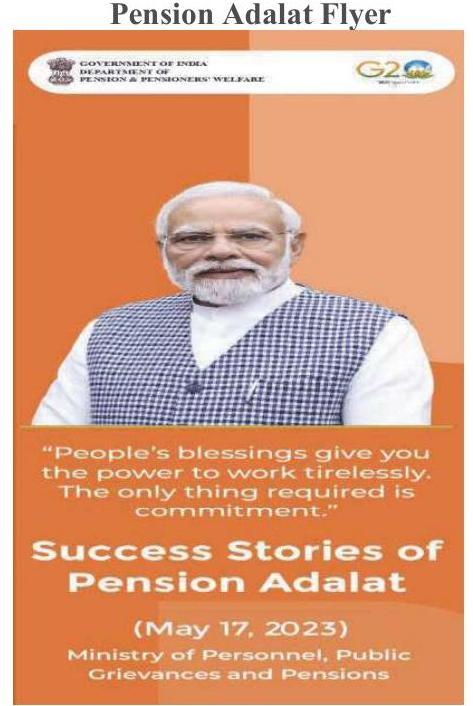
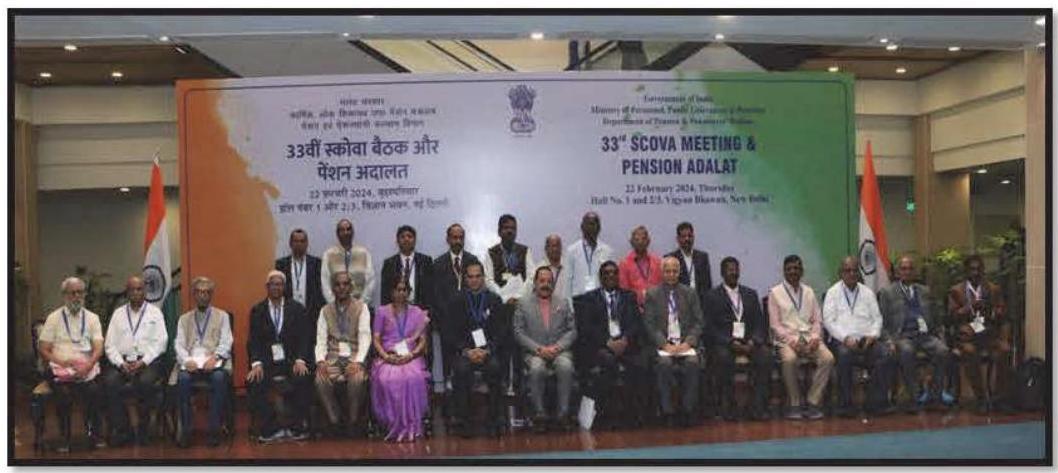
Hon’ble MOS (PP) addressing the participants of Pension Adalat
28.6.3 Standing Committee of Voluntary Agencies (SCOVA)
- The Standing Committee of Voluntary Agencies (SCOVA) was constituted in 1986 under the chairmanship of Minister of State for Personnel Public Grievances and Pensions. The SCOVA works as a consultative forum of Voluntary Agencies SCOVA provides Pensioner Welfare Associations an institutional forum for raising issues concerning pensioner welfare directly before the concerned Ministries/ Departments through constructive deliberations.
- The $33^{\text {rd }}$ meeting of the Standing Committee of Voluntary Agencies (SCOVA) was held at New Delhi on 22 February 2024 under the Chairmanship of Dr. Jitendra Singh, Hon’ble Minister of State for Personnel, Public Grievances and Pensions. 10 major Agenda items relating
to welfare of pensioners were taken up in the meeting.
Key decisions:
Operationalisation of $2^{\text {nd }}$ CGHS Wellness Centre -Additional Director (CGHS), Chandigarh informed that $2^{\text {nd }} \mathrm{CGHS}$ Wellness Centre would be made operational by $15^{\text {th }}$ March, 2024. The $2^{\text {nd }} \mathrm{CGHS}$ Wellness Centre was made operational on 13.05.2024.
Construction of CGHS Polyclinic/ Hospital at Jammu- Additional Director (CGHS), Chandigarh informed that J&K administration has allotted a land parcel in the name of Health and Education Department. Chairman, SCOVA directed Ministry of Health and Family Welfare to actively pursue the matter.
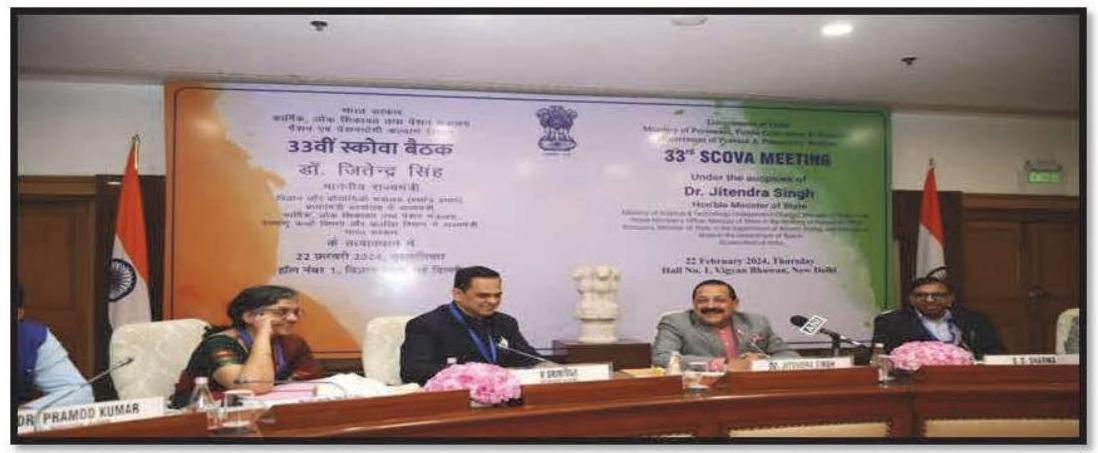
Hon’ble MOS(PP) addressing SCOVA Members
28.6.4 Anubhav Awards
- On the directions of the Prime Minister of India, Department of Pension & Pensioners’ Welfare (DoPPW) had launched an online platform entitled ‘Anubhav’ in March 2015. It is a means for retiring employees to share their experiences and achievements during their service period through write-ups. This will prove an invaluable tool for helping in future governance related issues.
- 96 Ministries/ Departments/ Organizations have registered on Anubhav Portal of this Department and 10404 write-ups have been published as on 31.03.2024.
- An annual Anubhav Awards scheme was introduced in 2015 to incentivize and encourage the participation. In 2023, in order to broaden the base of participation, Jury certificates were also introduced. Till date, 54 Anubhav awards and 09 Jury certificates have been conferred in six Ceremonies held so far.
- DoPPW conducted outreach programmes in the run up to Anubhav awards Ceremony, 2023 and 2024. For this, DOs
at the level of Secretary (Pension) were issued and regular meetings with Anubhav Nodal Officers were held. These campaigns have speed up the publication of the write-ups including the all-time high 1901 published write-ups for 2023 Anubhav ceremony. Also, the campaigns have resulted in increased participation from the higher ranked officers including the Secretaries to GoI. Even, the officers from departments hitherto not participated earlier have submitted their write-ups. - During the ceremony held on 23.10.2023 at Vigyan Bhawan, New Delhi, Dr Jitendra Singh, Hon’ble Minister of State (PP) conferred Anubhav Awards/Jury Certificates to 13 write-ups ( 04 Anubhav Awards and 09 Jury Certificates). The event witnessed broader participation as the awardees were from Ministry of Defence (DRDO), MHA (CISF and CRPF), MoHUA, Department of Posts, Department of Space and D/o Revenue (CBDT).
The list of the awardees is as under-
| Anubhav Awardees-2023 | |||
|---|---|---|---|
| S.No | Name (Sh./Ms.) | Designation | Organization |
| 1. | Shri Mohammad Jamshed, | Member (Traffic), Railway Board | Ministry of Railways |
| 2. | Shri Yogender Chaudhry | Chief Commissioner Income Tax | Central Board of Direct Taxes |
| 3. | Shri P. Damodara Bhat | GCS, Senior Superintendent, RMS | Department of Posts |
| 4. | Shri Bhola Ram Thakur | DRDO (A\&A), Assist. Director (OL) | Department of Defence Research and Development |
| Jury Certificate Winner-2023 | |||
| S.No | Name (Sh./Ms.) | Designation | Organization |
| 1. | Dr. Reny Mammen | Scientist E | Department of Defence |
| Roy | Research & Development | ||
|---|---|---|---|
| 2. | Shri Shashi Kumar Valiathan |
CSS, Director | Ministry of Housing and Urban Affairs |
| 3. | Shri Cyriac V. M. | Administrative Officer | Department of Space |
| 4. | Shri Sagaya Das | DRTC, Technical Officer |
Department of Defence Research \& Development |
| 5 | Shri Arumugam P. | Chief Office Superintendent |
Ministry of Railways |
| 6 | Shri Moorthy L., | Chief Commercial Inspector |
Ministry of Railways |
| 7 | Shri Mohanan. N | Loco Pilot (Goods)/Mech, |
Ministry of Railways |
| 8 | Shri Lakhinana Kesava Rao |
SI/Exe. | CISF, M/o Home Affairs |
| 9 | Shri Mukul Barua | CAPF HC/GD | CRPF, M/o Home Affairs |
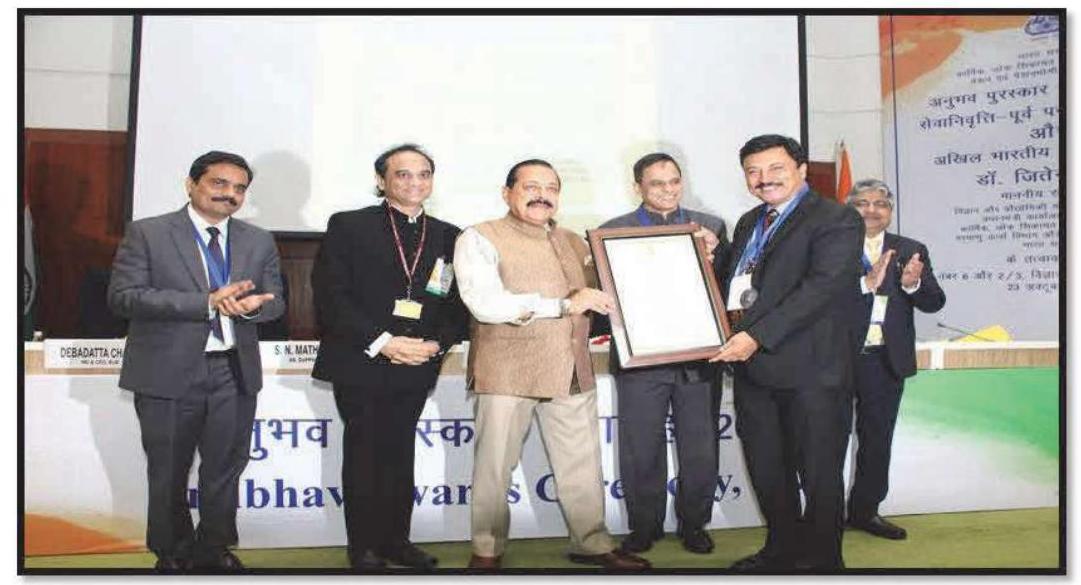
Presentation of Anubhav Award by Dr. Jitendra Singh, Hon’ble MoS(PP)
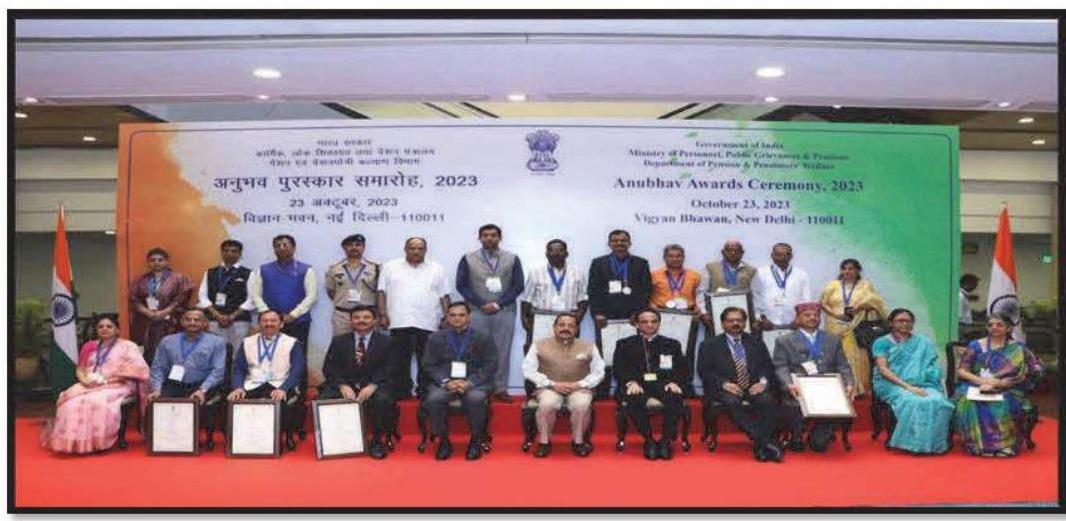
Group photograph of awardees with Dr. Jitendra Singh, Hon’ble MoS(PP)
28.6.5 Nationwide “Anubhav Awardees Speak” Webinar Series
- The webinar series aims to facilitate experience sharing with relevant stakeholders and concerned Ministries/ Departments/Organizations. It is envisaged that this culture of leaving notes by retirees will become the foundation stone of good governance and administrative reforms in future. The inaugural webinar was held on 22.11.2022.
- So far sixteen webinars have been held. The webinar series generally features Anubhav Awardees as speakers to share their experience and to motivate/raise awareness among retiring employees on filling up their own experiences on the Anubhav Portal. The Speak is well received and is usually attended from more than 700 locations across the country.
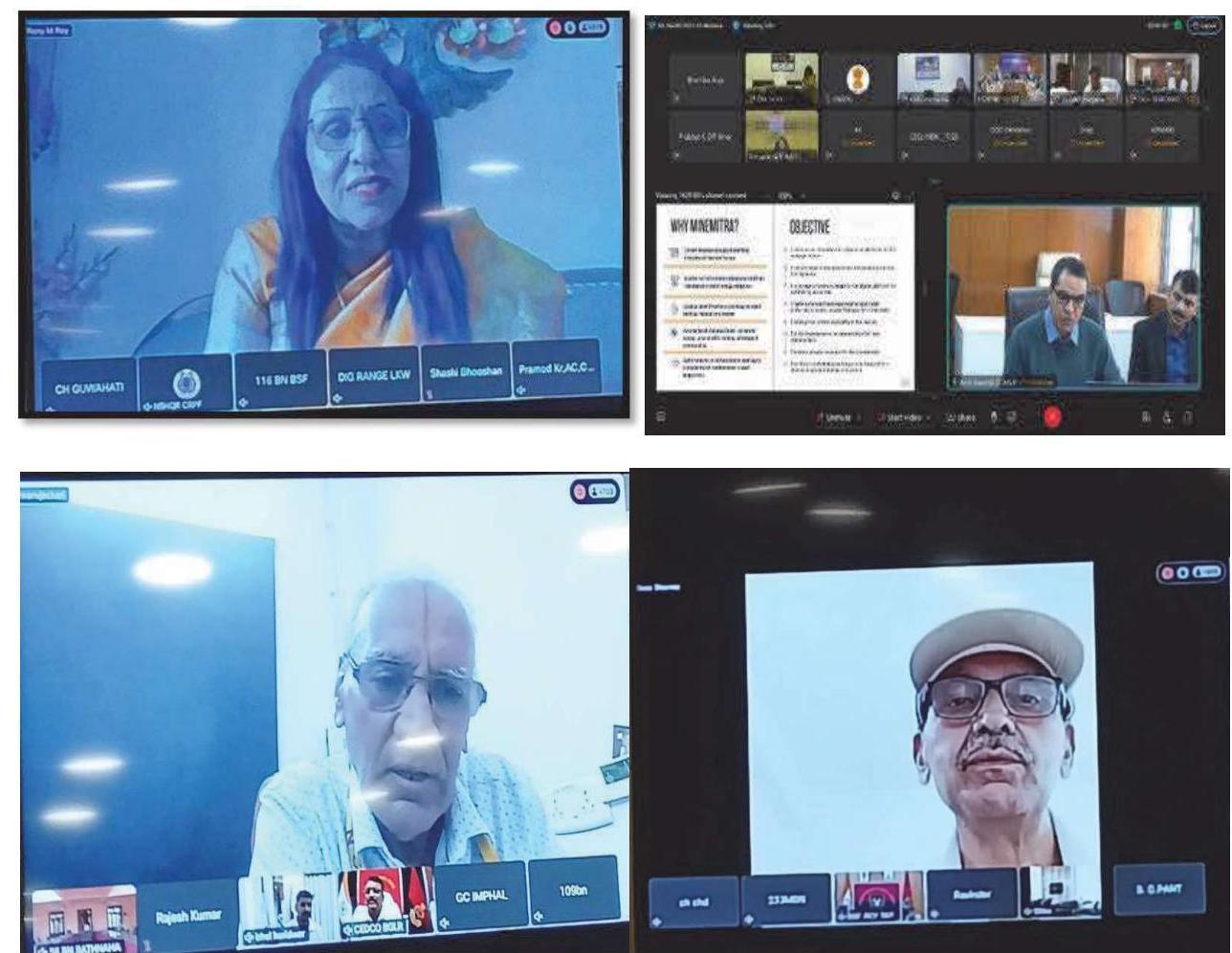
Anubhav Awardees speaker sharing their experience in Anubhav Webinar
28.6.6 Pre-Retirement Counselling (PRC) Delhi & Ahmedabad
- In $50^{\text {th }}$ PRC workshop, 900 Participated at Vigyan Bhawan, New Delhi under the Chairmanship of Honourable MOS(PP) on $17^{\text {th }}$ May, 2023.
- In $51^{\text {st }}$ PRC workshop, 300 Participated at Vigyan Bhawan, New Delhi under the Chairmanship of Honourable MOS(PP) on $23^{\text {rd }}$ October, 2023.
- $52^{\text {nd }}$ PRC Workshop was conducted at DAIC, Janpath, New Delhi on 20th December, 2023 to empower the retiring employees with crucial insights into various aspects of their transition, including topics like Bhavishya Portal, CGHS Rules, Income Tax Rules, Investments Avenues, etc.
- 300 Participated at $53^{\text {rd }}$ PRC Workshop held at Ahmedabad on $05^{\text {th }}$ March, 2024 under
the forward-thinking initiative ‘Sankalp’ for providing invaluable support to retiring employees, wherein sessions on various topics relevant to them viz Bhavishya Portal, Submission of DLC, Investment Opportunities, CGHS Rules, Income Tax Rules, Anubhav Awar, etc. were taken.
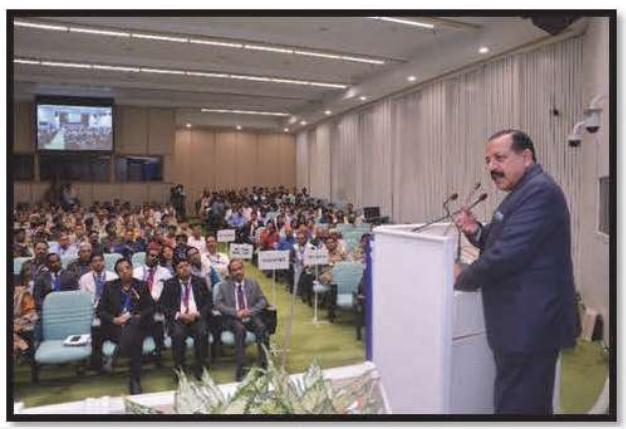
Glimpse of Pre-Retirement Counseling held in New Delhi on $22^{\text {nd }}$ February, 2024
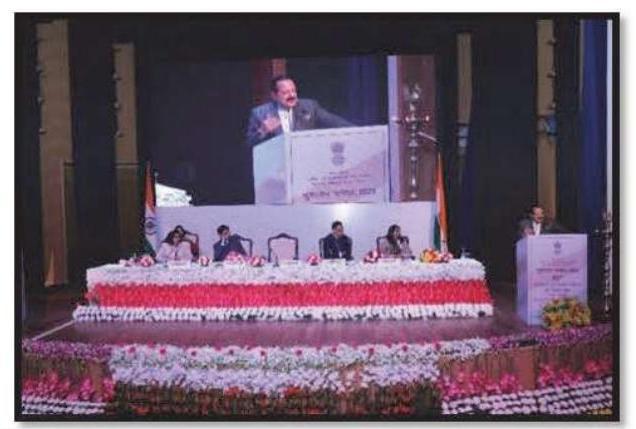
Pre-Retirement Counseling Workshop for retiring employees at Delhi.
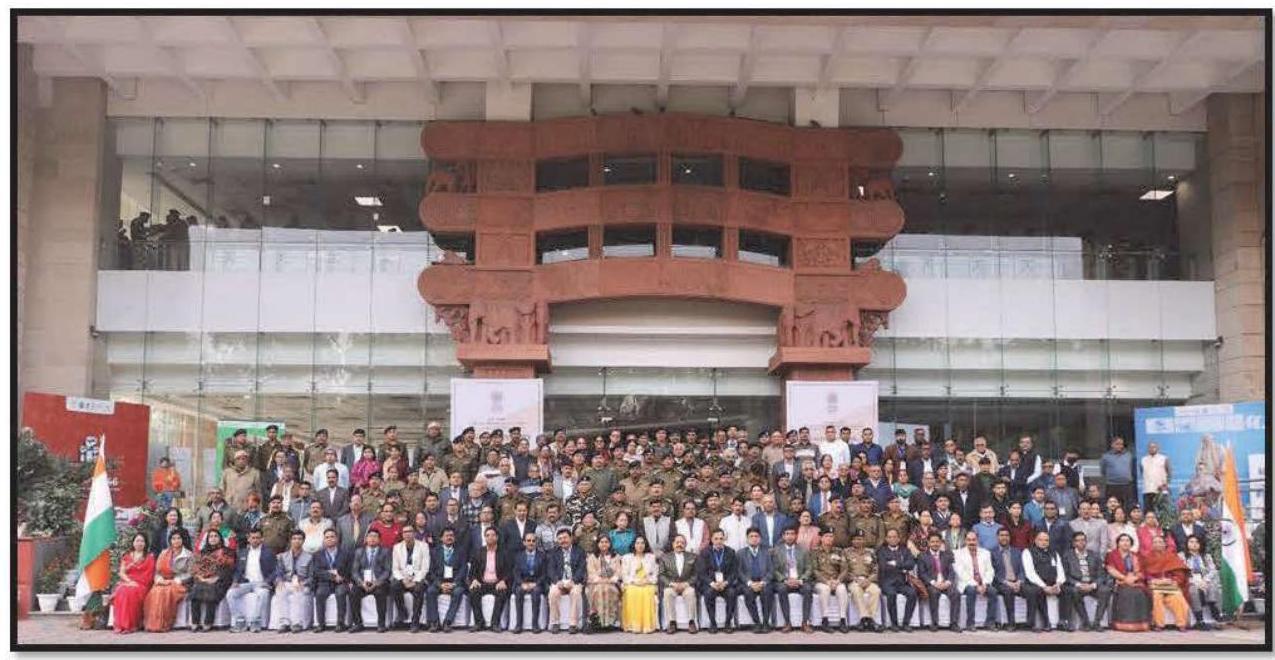
Pre-Retirement Counselling for Spreading Awareness for retiring employees at New Delhi
28.6.7 All India Digital Life Certificate Campaign 2.0
- Every year in the month of November a pensioner is required to produce life certificate for further continuation of his pension. In the traditional mode, pensioners could submit life certificate by physically presenting themselves before the pension disbursing authority such as banks or send a certificate issued by a gazetted officer or other designated authorities.
- Due to infirmity or other ailments and old age, this manual system was a cause of extreme discomfort and inconvenience, as pensioners had to wait outside the bank branches in long queues for submission of Life certificate. There was no mechanism for pensioners to get updated status on recording of their Life Certificate, and it was observed, on the basis of grievances received, that at times, pension was discontinued, due to non -updating of Life Certificate record in the banking system by the concerned staff, even though the pensioner had submitted the same. Keeping in view the concerns of senior pensioners and discomfort faced by them in the manual process, it was felt necessary to streamline the process to make it digital and initiate Door Step Service for submission of Life Certificate.
- In November, 2014 an Aadhar based scheme for online submission of digital life certificate, Jeevan Pramaan, was launched by the Hon’ble Prime Minister with the object to facilitate pensioners to submit life certificate
anytime and from anywhere.
In 2018, DoPPW started a Pilot Programme DLC from home campaign with the assistance of Pensioners’ Associations. The objective of the campaign was to extend support to the aged and infirm pensioners in submission of Life certificate digitally from home. Around 2500 DLC were successfully created by pensioners Associations in 7 cities.
- In October-November 2019, this project was expanded to cover 24 cities i.e. Hyderabad, Ranchi, Bhuvneshwar, Jaipur, Thrissur, Kolkata, Cuttack, Chennai, Guwahati, Madurai, Balasore, Jalandhar, Ahmedabad, Prayagraj, Pune, Dehradun, Mumbai, Bengaluru, Vadodara, Trivandrum, Mysore, Chandigarh, Noida, Delhi. In the year 2019, around 4100 DLCs were collected from such pensioners by the above Pensioners Associations.
-
With a view to make Doorstep Services for submission of Life Certificate available to all pensioners across the country, DoPPW roped in India Post Payments Bank (IPPB) under the Department of Posts for Digital Life Certificate. IPPB started Doorstep Service in November, 2020 through its huge network of Postmen & Gramin Dak Sevaks (presently 2,06,200) Thus the major initiative of DoPPW, viz. DLC from Home has reached every nook and corner of the country. This has come as a source of great comfort to Pensioners, especially those residing in rural areas.
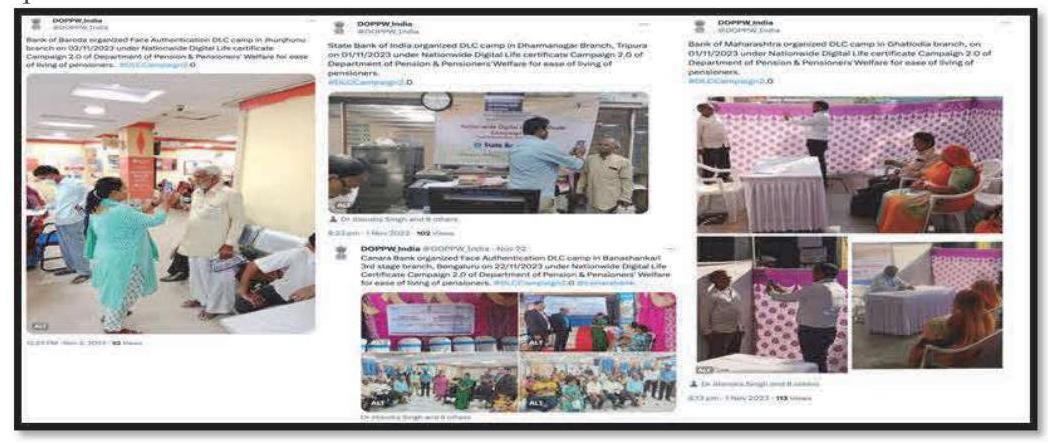
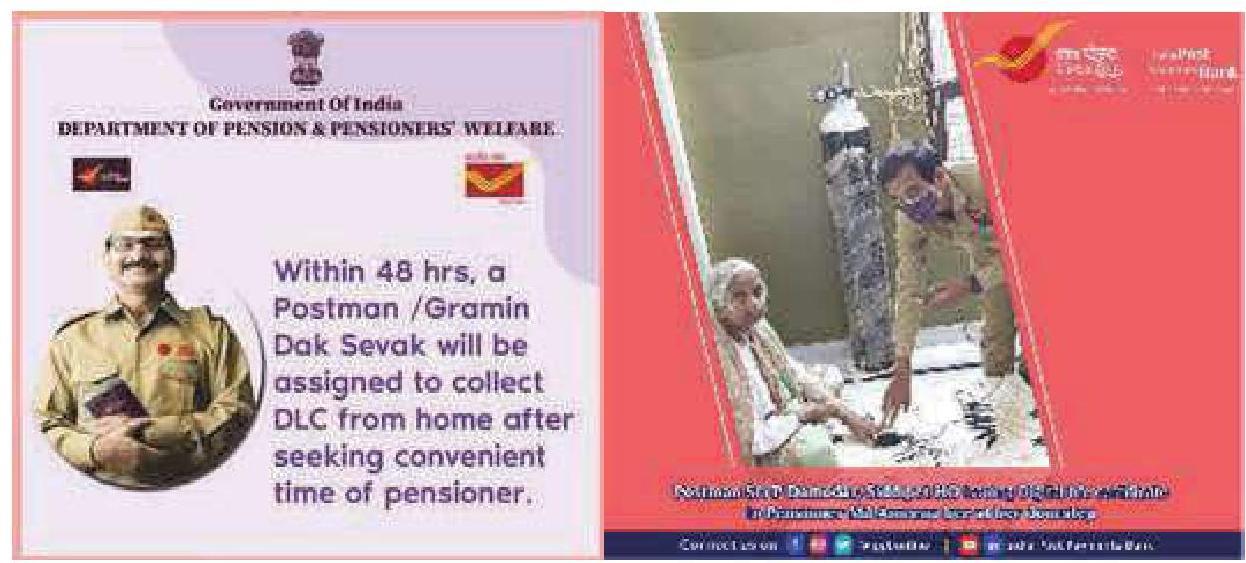
- After the coordination with Public Sector Banks Alliance (PSB), the service for collection of Life Certificate has been brought under the umbrella of Doorstep Banking Service. Now pensioners can submit Life Certificate by calling Banking agents at their home. This facility is presently available in 100 cities.
- In order to address the inconvenience faced by senior pensioners in submission of Life Certificate digitally due to non-capturing of their finger bio-metrics, DoPPW issued directions through OMs advising all Pension Disbursing Banks to adopt the Video based Customer Identification Process (V-CIP) as an additional facility for obtaining a Life Certificate from the pensioners, within permissible RBI guidelines. Most of the Banks have adopted V-CIP for their pensioners.
- Face Authentication Technology was launched by the Hon’ble Minister of State (PP) on $29^{\text {th }}$ November 2021 with a view to enhance ease of submission of Digital Life Certificate by pensioners. Through this App a pensioner can submit a Digital Life Certificate from the comfort of home using any Android mobile without attaching any external device. The above technology is a milestone in leveraging technology for the purpose of Life Certificate. As per this facility, the identity of a pensioner is
established through face authentication technique on the basis of the live photo captured and submitted online using any Android based smart phone. On being authenticated by the UIDAI server, DLC gets generated. This technology has reduced the dependence of pensioners on external biometric and made the process of LC submission more affordable by enabling pensioners to submit their LCs from the comfort of their homes. The Face Authentication Technology has been given wide publicity on social media viz. Youtube, Facebook, Twitter and through print media. - In addition, the Department took steps to facilitate pensioners living abroad for submission of Life Certificate and gave instructions to the Ministry of External Affairs, that all the Indian Embassies/High Commissions/Consulates devise a methodology for endorsing Life Certificates and also to the International Banking Divisions of Pension Disbursing Banks to facilitate Life Certificate of such Pensioners.
- Keeping in view the difficulties faced by very senior citizens aged 80 years and above, an exclusive window has been provided to enable submission of Life Certificates by them from October $1^{\text {st }}$ onwards. This would help them to avoid the rush at Banks from $1^{\text {st }}$ November onwards, when all pensioners are required to submit their annual life
certificates. Department of Pension & Pensioners’ Welfare has issued instructions vide its OM No. 1(2)/2023 P\&PW (H) dated 25.9.2023 regarding facilitation of Digital Life certificate through Face Authentication for Super Senior Pensioners aged 80 years and above from 1st October every year.
- The Department of Pension \& Pensioners’ Welfare, Ministry of Personnel, Public Grievances and Pensions launched a Nationwide Campaign for promotion of Digital Life Certificate (DLC) for Central Government pensioners during 1st – 30th November, 2022. A similar Nation-wide DLC Campaign 2.0 was held from 1st to 30th November, 2023. The objective of these Nation-wide Campaigns was to promote the use of digital modes for LC submission with special emphasis on the milestone technology of Face Authentication thereby ensuring comfort and ease of usage. All the registered Pensioners’ Associations, Pension Disbursing Banks and Ministries/Departments of Government of India had been directed to promote the Digital Life Certificate/Face Authentication Technique for giving Life Certificate by organizing special camps for pensioners.
- To promote the campaign, Pension Disbursing Banks joined hands with the Department and provided the Camp venues in different cities. Registered Pensioners’ Associations of the Department played a pivotal role in informing and mobilizing pensioners to visit the camps in different cities. Officials of DoPPW were nominated to monitor the camps and visited various locations for this purpose. During the Nationwide DLC campaign 2.0, camps were held at 600 locations across 100 cities across the country.
- DLC Portal was developed by the Department for monitoring \& providing complete information about the progress of the Campaign. All the Nodal Officers were registered on the Portal to enable them to login and post information about the camps. 291 Nodal Officers from Banks, Ministry of Defence (SPARSH), Department of Telecom, UIDAI and Pensioners’ Welfare Associations were registered on the Portal. Regular
meetings were held with all the stakeholders to share information about the Campaign and guide them with regard to the techniques to be used for generation of DLCs. In addition, a WhatsApp group was created with Nodal Officers of all stakeholders to post the progress of the camps and any issues being faced. - The Nation-wide DLC Campaign 2.0, another milestone in the initiatives taken by the Department of Pension and Pensioners’ Welfare towards ensuring Ease of Living of pensioners, was a huge success and was widely covered in Print and Visual Media by PIB and DD News. More than 1.48 crore DLCs were generated of which more than 45.56 lakh were of Central Government pensioners. More than 25.49 lakh DLCs were generated using Face Authentication technique of which more than 11.50 lakhs were of Central Government pensioners. An analysis of the age-wise generation of DLCs reveals that more than 30,500 central government pensioners above the age of 90 years and more than 3.15 lakh central government pensioners in the age group $80-90$ years used digital mode for LC submission. During the campaign, representatives from the department, Banks and Pensioners’ Welfare Associations visited sick/ incapacitated/aged pensioners at their homes/hospitals to assist them in DLC generation. With a view to technologically empowering the pensioners, in addition to generating their DLCs, the process was also explained to them for future use.
Year-wise DLCs generated are as below:
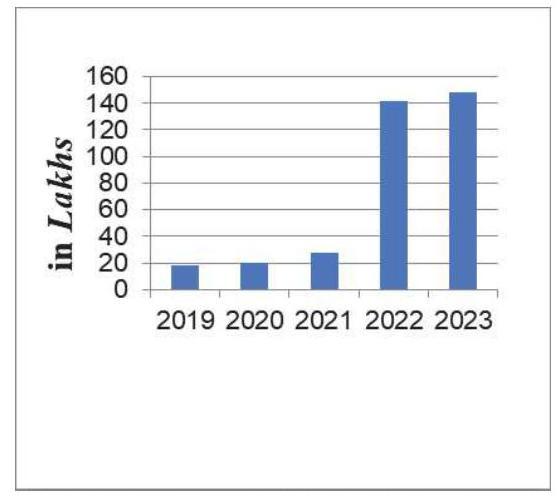
- In order to publicize the Nation-wide campaign for promoting DLC this Department sent SMSs to Central Government pensioners on their mobile phones. The campaign was widely covered by the newspapers and Doordarshan all over the country. During the campaign period, Department of Pension & Pensioners*
Welfare disseminated 2405 tweets from its Twitter account during the period. Beside this, other stakeholders also issued tweets. Three videos were uploaded by the Department on its YouTube page (DOPPW_INDIA OFFICIAL) explaining the process of submitting the Life Certificate through Face Authentication Technique in simple language.
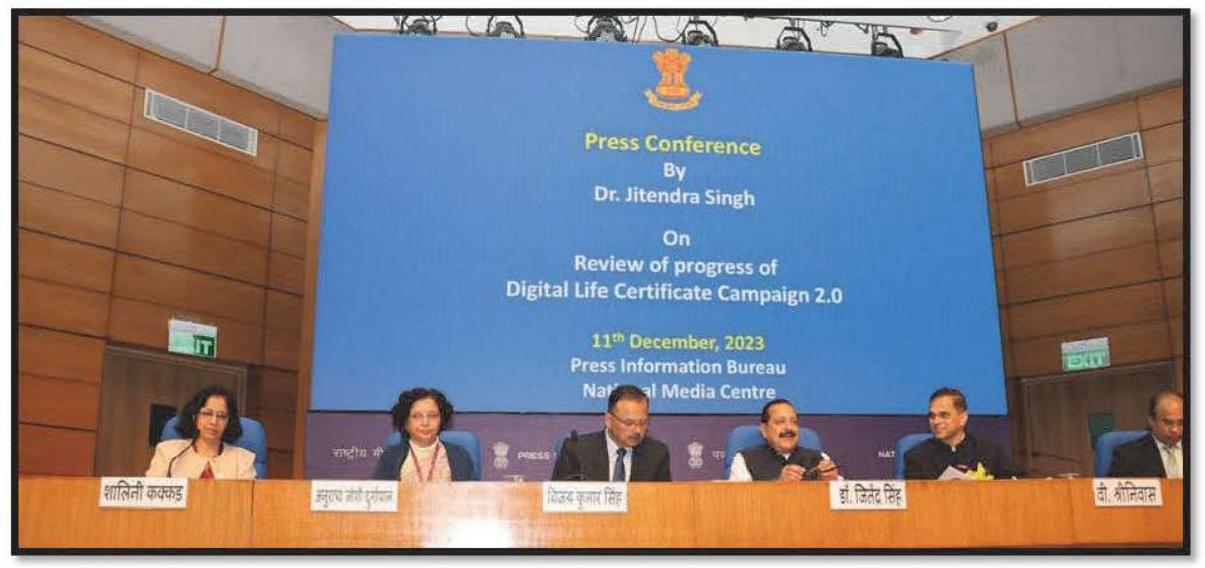
Press conference on DLC 2.0 chaired by Hon’ble MoS(PP)
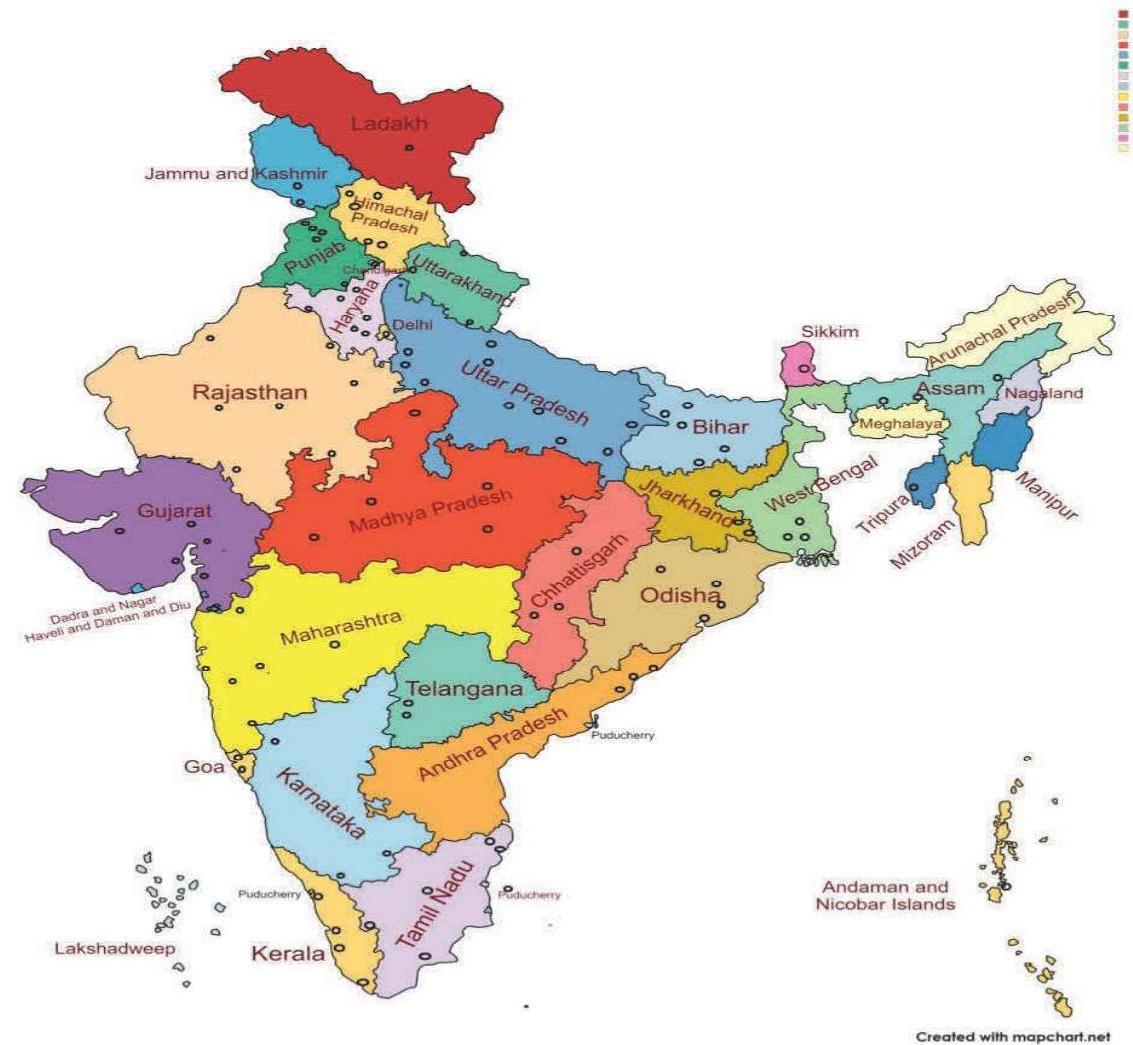
| NATIONWIDE DIGITAL LIFE CERTIFICATE CAMPAIGN 2.0 – LIST OF 100 CITIES WHERE CAMPS WERE HELD | ||||||||
|---|---|---|---|---|---|---|---|---|
| Sire | Title | Sire | Title | Sire | Title | Sire | Title | |
| Anderson Nicobar | Port Blair | Haryana | Aishaw | Medhya Pradesh | Uddan | Sikkim | East Sikkim | |
| Andhra Pradesh | East Sudwani | Gorgani | Pashtri | Tamilnadu | Chandigarh | |||
| Vizakhapatnam | Jaisal | Bhopal | Madhya | |||||
| Jaiswal | Jihalpur | Manipur | ||||||
| Jathral | Jodhpur | Manipur | ||||||
| Assam | Jambal | Maharashtra | Manipur | Chittagong | ||||
| Assam | Jambal | |||||||
| Kamal | Himachal | Shintla | ||||||
| Pradeep | ||||||||
| Bihar | Bhavahapat | |||||||
| Chittagong | Mandi | |||||||
| Kareal | ||||||||
| Patna | ||||||||
| Manali | ||||||||
| Patna | ||||||||
| Manali | Odisha | |||||||
| Chandigarh | Srinagar | |||||||
| Chandigarh | Chandigarh | |||||||
| Chattisgarh | Srinapal | Saranu | ||||||
| Jharkhand | ||||||||
| Bihar | ||||||||
| Dadra and Nagar | Nagar | |||||||
| Haryana | ||||||||
| Delhi | ||||||||
| Delhi | Central Delhi | Karnataka | Belgaum | |||||
| North Delhi | ||||||||
| Goa | North Goa | Jaiswal | ||||||
| Rajasthan | ||||||||
| Gujarat | Rajkot | |||||||
| Bhavanagar | ||||||||
| Ahmedabad | ||||||||
| Baroda | ||||||||
| Surat | ||||||||
| Rajasthan | ||||||||
| Rajkot | ||||||||
| Jammu & | Karnataka | Belgaum | ||||||
| Kashmir | Saranu | |||||||
| Jharkhand | ||||||||
| Rajasthan | ||||||||
| Rajasthan | ||||||||
| Rajasthan | ||||||||
| Rajasthan | ||||||||
| Rajasthan | ||||||||
| Rajasthan | ||||||||
| Rajasthan | ||||||||
| Rajasthan | ||||||||
| Rajasthan | ||||||||
| Rajasthan | ||||||||
| Rajasthan | ||||||||
| Rajasthan | ||||||||
| Rajasthan | ||||||||
| Rajasthan | ||||||||
| Rajasthan | ||||||||
| Rajasthan | ||||||||
| Rajasthan | ||||||||
| Rajasthan | ||||||||
| Rajasthan | ||||||||
| Rajasthan | ||||||||
| Rajasthan | ||||||||
| Rajasthan | ||||||||
| Rajasthan | ||||||||
| Rajasthan | ||||||||
| Rajasthan | ||||||||
| Rajasthan | ||||||||
| Rajasthan | ||||||||
| Rajasthan | ||||||||
| Rajasthan | ||||||||
| Rajasthan | ||||||||
| Rajasthan | ||||||||
| Rajasthan | ||||||||
| Rajasthan | ||||||||
| Rajasthan | ||||||||
| Rajasthan | ||||||||
| Rajasthan | ||||||||
| Rajasthan | ||||||||
| Rajasthan | ||||||||
| Rajasthan | ||||||||
| Rajasthan | ||||||||
| Rajasthan | ||||||||
| Rajasthan | ||||||||
| Rajasthan | ||||||||
| Rajasthan | ||||||||
| Rajasthan | ||||||||
| Rajasthan | ||||||||
| Rajasthan | ||||||||
| Rajasthan | ||||||||
| Rajasthan | ||||||||
| Rajasthan | ||||||||
| Rajasthan | ||||||||
| Rajasthan | ||||||||
| Rajasthan | ||||||||
| Rajasthan | ||||||||
| Rajasthan | ||||||||
| Rajasthan | ||||||||
| Rajasthan | ||||||||
| Rajasthan | ||||||||
| Rajasthan | ||||||||
| Rajasthan | ||||||||
| Rajasthan | ||||||||
| Rajasthan | ||||||||
| Rajasthan | ||||||||
| Rajasthan | ||||||||
| Rajasthan | ||||||||
| Rajasthan | ||||||||
| Rajasthan | ||||||||
| Rajasthan | ||||||||
| Rajasthan | ||||||||
| Rajasthan | ||||||||
| Rajasthan | ||||||||
| Rajasthan | ||||||||
| Rajasthan | ||||||||
| Rajasthan | ||||||||
| Rajasthan | ||||||||
| Rajasthan | ||||||||
| Rajasthan | ||||||||
| Rajasthan | ||||||||
| Rajasthan | ||||||||
| Rajasthan | ||||||||
| Rajasthan | ||||||||
| Rajasthan | ||||||||
| Rajasthan | ||||||||
| Rajasthan | ||||||||
| Rajasthan | ||||||||
| Rajasthan | ||||||||
| Rajasthan | ||||||||
| Rajasthan | ||||||||
| Rajasthan | ||||||||
| Rajasthan | ||||||||
| Rajasthan | ||||||||
| Rajasthan | ||||||||
| Rajasthan | ||||||||
| Rajasthan | ||||||||
| Rajasthan | ||||||||
| Rajasthan | ||||||||
| Rajasthan | ||||||||
| Rajasthan | ||||||||
| Rajasthan | ||||||||
| Rajasthan | ||||||||
| Rajasthan | ||||||||
| Rajasthan | ||||||||
| Rajasthan | ||||||||
| Rajasthan | ||||||||
| Rajasthan | ||||||||
| Rajasthan | ||||||||
| Rajasthan | ||||||||
| Rajasthan | ||||||||
| Rajasthan | ||||||||
| Rajasthan | ||||||||
| Rajasthan | ||||||||
| Rajasthan | ||||||||
| Rajasthan | ||||||||
| Rajasthan | ||||||||
| Rajasthan | ||||||||
| Rajasthan | ||||||||
| Rajasthan | ||||||||
| Rajasthan | ||||||||
| Rajasthan | ||||||||
| Rajasthan | ||||||||
| Rajasthan | ||||||||
| Rajasthan | ||||||||
| Rajasthan | ||||||||
| Rajasthan | ||||||||
| Rajasthan | ||||||||
| Rajasthan | ||||||||
| Rajasthan | ||||||||
| Rajasthan | ||||||||
| Rajasthan | ||||||||
| Rajasthan | ||||||||
| Rajasthan | ||||||||
| Rajasthan | ||||||||
| Rajasthan | ||||||||
| Rajasthan | ||||||||
| Rajasthan | ||||||||
| Rajasthan | ||||||||
| Rajasthan | ||||||||
| Rajasthan | ||||||||
| Rajasthan | ||||||||
| Rajasthan | ||||||||
| Rajasthan | ||||||||
| Rajasthan | ||||||||
| Rajasthan | ||||||||
| Rajasthan | ||||||||
| Rajasthan | ||||||||
| Rajasthan | ||||||||
| Rajasthan | ||||||||
| Rajasthan | ||||||||
| Rajasthan | ||||||||
| Rajasthan | ||||||||
| Rajasthan | ||||||||
| Rajasthan | ||||||||
| Rajasthan | ||||||||
| Rajasthan | ||||||||
| Rajasthan | ||||||||
| Rajasthan | ||||||||
| Rajasthan | ||||||||
DLC Campaign 2.0
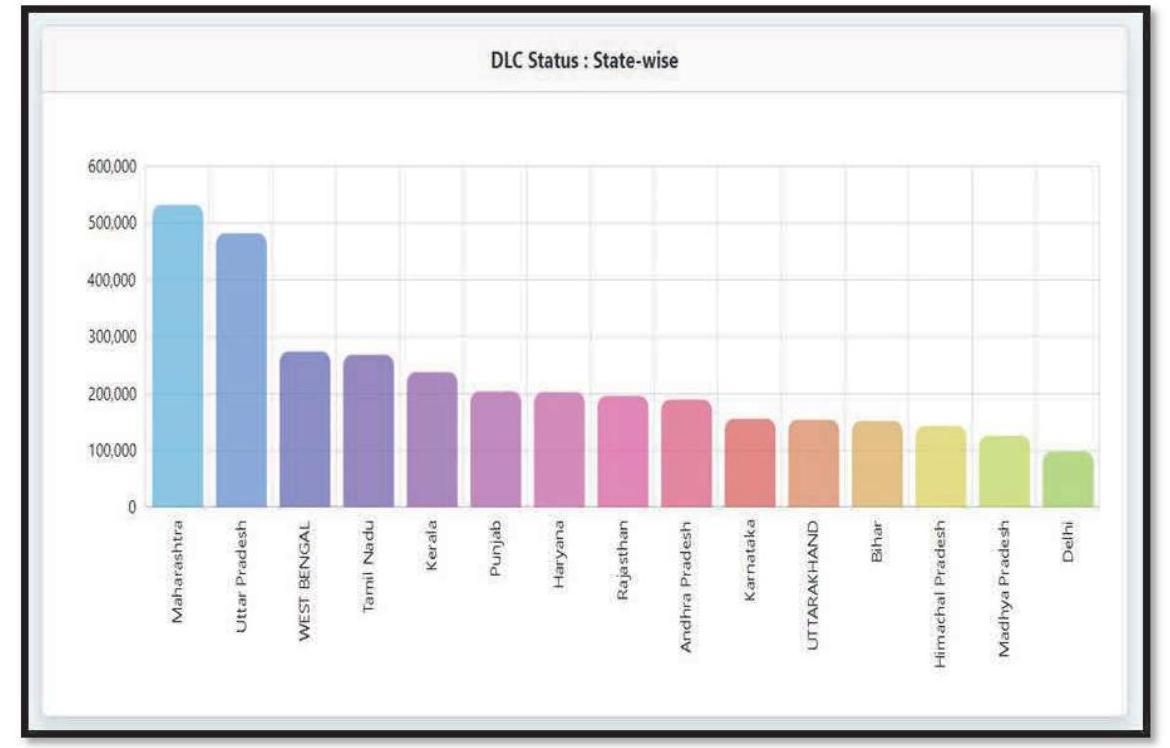
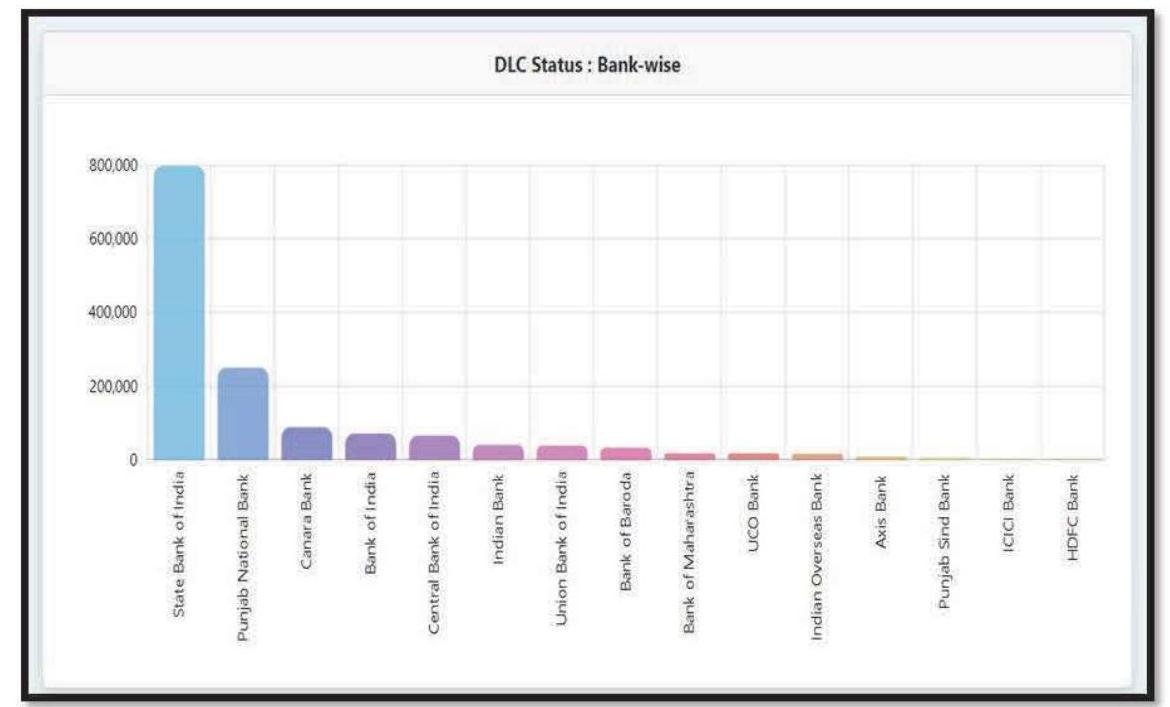
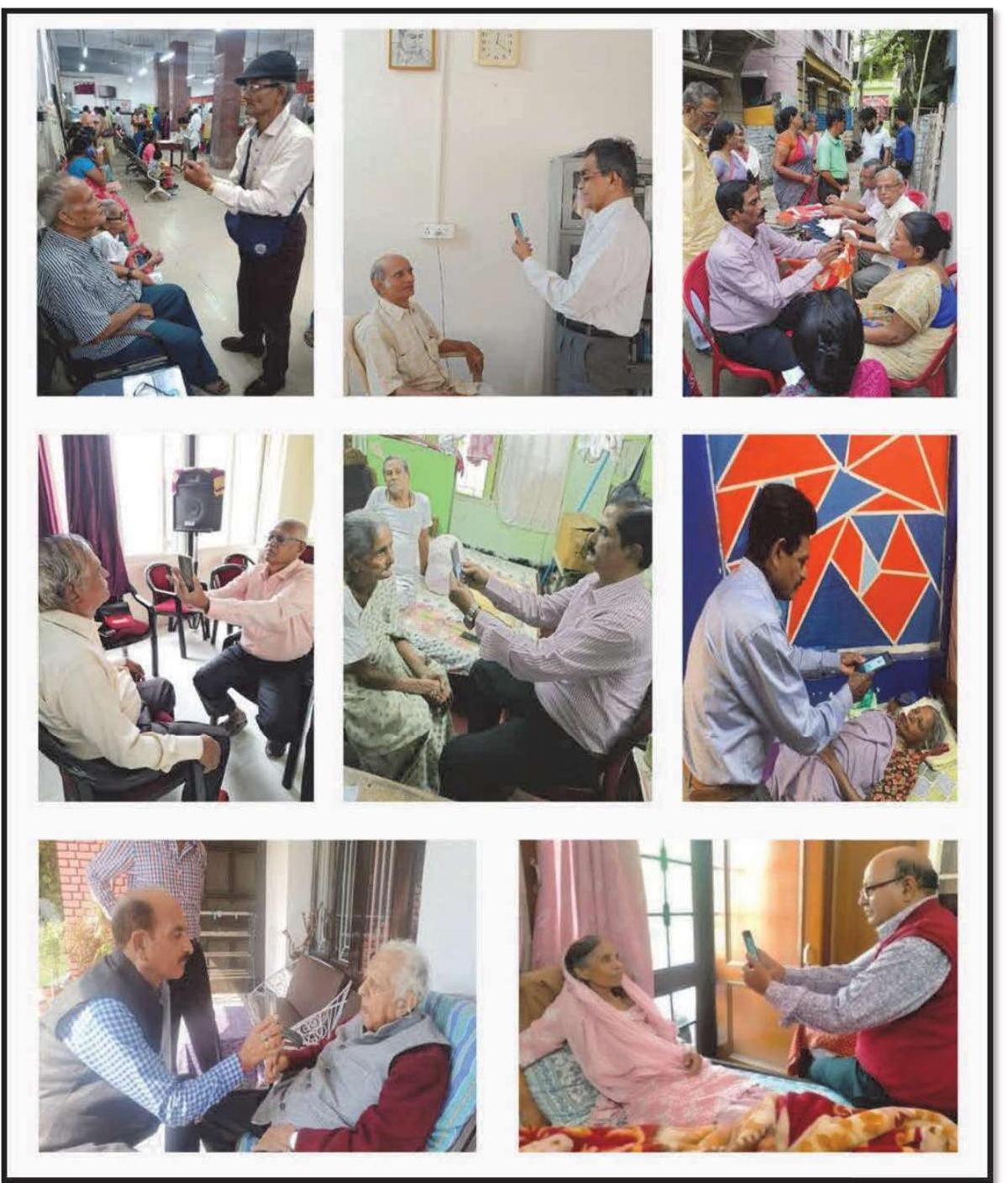
Pensioners’ Associations facilitating DLC of Aged/Sick pensioners
राष्ट्रव्यापी डिजिटल जीवन प्रमाणपत्र अभियान 2.0 का शुभारंभ
लखनऊ। इंडियन बैंक ने राष्ट्रव्यापी डिजिटल जीवन प्रमाणपत्र अभियान 2.0 का शुभारंभ किया है। बैंक अपनी विभिन्न साम्ढाओं, कार्यालयों, एटीएम में रणनीतिक रूप से लगाए गए बैनर पोस्टर के माध्यम से डीएलसी केस अधिनिकेशन तकनीक के बारे में जागरूकता फैलाने व उचित प्रचार प्रदान करने जहां तक हो सके डीएलसीभ्केस अधिनिकेशन जैसे तकनीक का उपयोग किया जा रहा है। ताकि जब पेंशनभोगी जीवन प्रमाण पत्र जमा करने के लिए साम्द्रा में जाएं तो इस तकनीक के माध्यम से पेंशनभोगियों को बिना किसी देरी के अपने डीएलसी जमा
करने में सक्षम बनाया जा सके। बैंक के अंजल प्रबंधक लखनऊ श्री प्राणेश कुमार ने बताया कि इंडियन बैंक डिजिटल पेंशन के इस अभियान को सफर बनाने के लिए हरसंभव प्रयासरत हैन् जिससे पेंशनभोगियों के जीवन को और भी सुगम एवं सुलभ बनाया जा सके। उप अंजल प्रबंधक श्री राजेश कुमार ने बताया किर लखनऊ अंजल के अंतर्गत इंडियन बैंक को हजरतगंज मुख्य सामव्र, आलमबाग, हुसैनगंज, उज्रियापा गीसदीपगर एवं चवईया साम्द्राओं को परिमेनेट किया गया है जहाँ पेंशनभोगी जीवन प्रमाण पत्र का लाभ उठा सकते हैं।
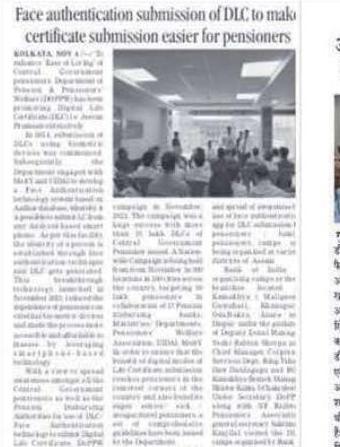
डीएलसी जमा के लिए पेश अधिनिकेशन एप के बारे में जागरूकता फैलाने के लिए रिपोर्ट का आयोजन
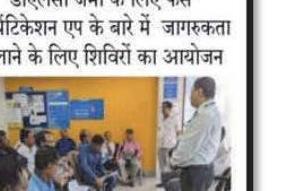
Media Coverage of DLC Campaign 2.0
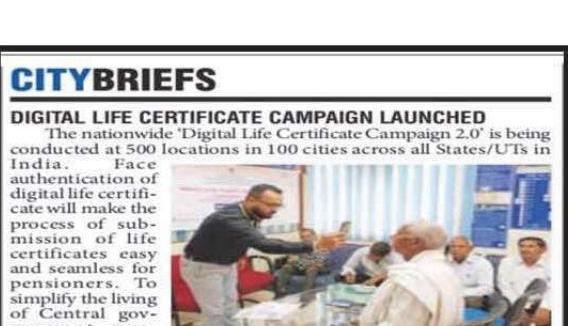
1 से 30 नवंबर तक राष्ट्रव्यापी डिजिटल जीवन प्रमाणपत्र अभियान 2.0 शुरू किया
जीतश्री, केंद्र सरकार के पेंशनभोगियों के शौचरमाण्ड के प्रधानमंत्री को कहते थे कि, पेंशन और पेंशनभोगी कल्याण विभाग डिजिटल जीवन प्रमाणपत्र (डीएलसी) यानी जीवन प्रमाण पत्र को रेंगाने पर बढ़ावा दे रहा है, 2014 में, कार्यपत्रिका उपकरणों पर अपडेट करने डीएलसी जमा करना शुरू किया गया था, इसके बाद, विभाग ने अपना डेटाबेस पर आधारित पेश अधिनिकेशन टेक्नोलॉजी सिस्टम विकसित करने के लिए एमईआईडीआर और यूआईडीएआई के साथ काम किया, जिसमें किसी भी एंड्रॉइड आधारित स्मार्ट फोन से एलसी जमा करना संभव हो सके, इस यूनिक के अनुसार, पेश अधिनिकेशन तकनीक के जरिए किसी व्यक्ति की पहचान स्थापित की जाती है और डीएलसी जेनरेट किया जाता है, नवंबर 2021 में लॉन्च की गई इस महत्वपूर्ण तकनीक ने पेंशनभोगियों की
एमईआईडीआई के सहयोग से 30 लाख पेंशनभोगियों को जटिल करने हुए यह राष्ट्रव्यापी अभियान चलाया जा रहा है, पेंशनभोगी कल्याण संघों को भी डीएलसी जमा करने के लिए पेंशनभोगियों के लिए निर्देश आयोजित करने के लिए संवेदनशील बनाया गया है, पेंशन और पेंशनभोगी कल्याण विभाग के अधिकारी पेंशनभोगियों को उनके जीवन प्रमाण पत्र जमा करने के लिए विभिन्न डिजिटल परिषदों के उपयोग में सहायता करने के लिए देश भर में प्रमुख स्थानों पर दौरा कर रहे हैं, 30 मुकदमा के डीओरेरीविज्ञान के प्राथमिकता सदा भर में पंशनभोगी और दूसरे बैंक साम्द्राओं में 9 अभियान सफरों को कवर करने के लिए कोलकाता के डॉ सिलसिल दौरे पर 2 और उन्होने में खाद्य स्थानों पर 1 से 30 नवंबर, 2021 तक 17 पेंशन विभागों की संचालनों/विभागों, पेंशनभोगियों कल्याण संघ, यूआईडीएआई, एमईआईडीआई के सहयोग से 30 लाख पेंशनभोगियों को जटिल करने हुए यह राष्ट्रव्यापी अभियान चलाया जा रहा है, पेंशनभोगी कल्याण संघों को भी डीएलसी जमा करने के लिए पेंशनभोगियों के लिए निर्देश आयोजित करने के लिए संवेदनशील बनाया गया है, पेंशन और पेंशनभोगी कल्याण विभाग के अधिकारी पेंशनभोगियों को उनके जीवन प्रमाण पत्र जमा करने के लिए विभिन्न डिजिटल परिषदों के उपयोग में सहायता करने के लिए देश भर में प्रमुख स्थानों पर दौरा कर रहे हैं, 30 मुकदमा के डीओरेरीविज्ञान के प्राथमिकता सदा भर में पंशनभोगी और दूसरे बैंक साम्द्राओं में 9 अभियान सफरों को कवर करने के लिए कोलकाता के डॉ सिलसिल दौरे पर 2 और उन्होने में खाद्य स्थानों पर 1 से 30 नवंबर, 2021 तक 17 पेंशन विभागों की संचालनों/विभागों, पेंशनभोगियों कल्याण संघ, यूआईडीएआई, एमईआईडीआई के सहयोग से 30 लाख पेंशनभोगियों को जटिल करने हुए यह राष्ट्रव्यापी अभियान चलाया जा रहा है, पेंशनभोगी कल्याण संघों को भी डीएलसी जमा करने के लिए पेंशनभोगियों के लिए निर्देश आयोजित करने के लिए संवेदनशील बनाया गया है, पेंशन और पेंशनभोगी कल्याण विभाग के अधिकारी पेंशनभोगियों को उनके जीवन प्रमाण पत्र जमा करने के लिए विभिन्न डिजिटल परिषदों के उपयोग में सहायता करने के लिए देश भर में प्रमुख स्थानों पर दौरा कर रहे हैं, 30 मुकदमा के डीओरेरीविज्ञान के प्राथमिकता सदा भर में पंशनभोगी और दूसरे बैंक साम्द्राओं में 9 अभियान सफरों को कवर करने के लिए कोलकाता के डॉ सिलसिल दौरे पर 2 और उन्होने में खाद्य स्थानों पर 1 से 30 नवंबर, 2021 तक 17 पेंशन विभागों की संचालनों/विभागों, पेंशनभोगियों कल्याण संघ, यूआईडीएआई, एमईआईडीआई के सहयोग से 30 लाख पेंशनभोगियों को जटिल करने हुए यह राष्ट्रव्यापी अभियान चलाया जा रहा है, पेंशनभोगी कल्याण संघों को भी डीएलसी जमा करने के लिए पेंशनभोगियों के लिए निर्देश आयोजित करने के लिए संवेदनशील बनाया गया है, पेंशन और पेंशनभोगी कल्याण विभाग के अधिकारी पेंशनभोगियों को उनके जीवन प्रमाण पत्र जमा करने के लिए विभिन्न डिजिटल परिषदों के उपयोग में सहायता करने के लिए देश भर में प्रमुख स्थानों पर दौरा कर रहे हैं, 30 मुकदमा के डीओरेरीविज्ञान के प्राथमिकता सदा भर में पंशनभोगी और दूसरे बैंक साम्द्राओं में 9 अभियान सफरों को कवर करने के लिए कोलकाता के डॉ सिलसिल दौरे पर 2 और उन्होने में खाद्य स्थानों पर 1 से 30 नवंबर, 2021 तक 17 पेंशन विभागों की संचालनों/विभागों, पेंशनभोगियों कल्याण संघ, यूआईडीएआई, एमईआईडीआई के सहयोग से 30 लाख पेंशनभोगियों को जटिल करने हुए यह राष्ट्रव्यापी अभियान चलाया जा रहा है, पेंशनभोगी कल्याण संघों को भी डीएलसी जमा करने के लिए पेंशनभोगियों के लिए निर्देश आयोजित करने के लिए संवेदनशील बनाया गया है, पेंशन और पेंशनभोगी कल्याण विभाग के अधिकारी पेंशनभोगियों को उनके जीवन प्रमाण पत्र जमा करने के लिए विभिन्न डिजिटल परिषदों के उपयोग में सहायता करने के लिए देश भर में प्रमुख स्थानों पर दौरा कर रहे हैं, 30 मुकदमा के डीओरेरीविज्ञान के प्राथमिकता सदा भर में पंशनभोगी और दूसरे बैंक साम्द्राओं में 9 अभियान सफरों को कवर करने के लिए कोलकाता के डॉ सिलसिल दौरे पर 2 और उन्होने में खाद्य स्थानों पर 1 से 30 नवंबर, 2021 तक 17 पेंशन विभागों की संचालनों/विभागों, पेंशनभोगियों कल्याण संघ, यूआईडीएआई, एमईआईडीआई के सहयोग से 30 लाख पेंशनभोगियों को जटिल करने हुए यह राष्ट्रव्यापी अभियान चलाया जा रहा है, पेंशनभोगी कल्याण संघों को भी डीएलसी जमा करने के लिए पेंशनभोगियों के लिए निर्देश आयोजित करने के लिए संवेदनशील बनाया गया है, पेंशन और पेंशनभोगी कल्याण विभाग के अधिकारी पेंशनभोगियों को उनके जीवन प्रमाण पत्र जमा करने के लिए विभिन्न डिजिटल परिषदों के उपयोग में सहायता करने के लिए देश भर में प्रमुख स्थानों पर दौरा कर रहे हैं, 30 मुकदमा के डीओरेरीविज्ञान के प्राथमिकता सदा भर में पंशनभोगी और दूसरे बैंक साम्द्राओं में 9 अभियान सफरों को कवर करने के लिए कोलकाता के डॉ सिलसिल दौरे पर 2 और उन्होने में खाद्य स्थानों पर 1 से 30 नवंबर, 2021 तक 17 पेंशन विभागों की संचालनों/विभागों, पेंशनभोगियों कल्याण संघ, यूआईडीएआई, एमईआईडीआई के सहयोग से 30 लाख पेंशनभोगियों को जटिल करने हुए यह राष्ट्रव्यापी अभियान चलाया जा रहा है, पेंशनभोगी कल्याण संघों को भी डीएलसी जमा करने के लिए पेंशनभोगियों के लिए निर्देश आयोजित करने के लिए संवेदनशील बनाया गया है, पेंशन और पेंशनभोगी कल्याण विभाग के अधिकारी पेंशनभोगियों को उनके जीवन प्रमाण पत्र जमा करने के लिए विभिन्न डिजिटल परिषदों के उपयोग में सहायता करने के लिए देश भर में प्रमुख स्थानों पर दौरा कर रहे हैं, 30 मुकदमा के डीओरेरीविज्ञान के प्राथमिकता सदा भर में पंशनभोगी और दूसरे बैंक साम्द्राओं में 9 अभियान सफरों को कवर करने के लिए कोलकाता के डॉ सिलसिल दौरे पर 2 और उन्होने में खाद्य स्थानों पर 1 से 30 नवंबर, 2021 तक 17 पेंशन विभागों की संचालनों/विभागों, पेंशनभोगियों कल्याण संघ, यूआईडीएआई, एमईआईडीआई के सहयोग से 30 लाख पेंशनभोगियों को जटिल करने हुए यह राष्ट्रव्यापी अभियान चलाया जा रहा है, पेंशनभोगी कल्याण संघों को भी डीएलसी जमा करने के लिए पेंशनभोगियों के लिए निर्देश आयोजित करने के लिए संवेदनशील बनाया गया है, पेंशन और पेंशनभोगी कल्याण विभाग के अधिकारी पेंशनभोगियों को उनके जीवन प्रमाण पत्र जमा करने के लिए विभिन्न डिजिटल परिषदों के उपयोग में सहायता करने के लिए देश भर में प्रमुख स्थानों पर दौरा कर रहे हैं, 30 मुकदमा के डीओरेरीविज्ञान के प्राथमिकता सदा भर में पंशनभोगी और दूसरे बैंक साम्द्राओं में 9 अभियान सफरों को कवर करने के लिए कोलकाता के डॉ सिलसिल दौरे पर 2 और उन्होने में खाद्य स्थानों पर 1 से 30 नवंबर, 2021 तक 17 पेंशन विभागों की संचालनों/विभागों, पेंशनभोगियों कल्याण संघ, यूआईडीएआई, एमईआईडीआई के सहयोग से 30 लाख पेंशनभोगियों को जटिल करने हुए यह राष्ट्रव्यापी अभियान चलाया जा रहा है, पेंशनभोगी कल्याण संघों को भी डीएलसी जमा करने के लिए पेंशनभोगियों के लिए निर्देश आयोजित करने के लिए संवेदनशील बनाया गया है, पेंशन और पेंशनभोगी कल्याण विभाग के अधिकारी पेंशनभोगियों को उनके जीवन प्रमाण पत्र जमा करने के लिए विभिन्न डिजिटल परिषदों के उपयोग में सहायता करने के लिए देश भर में प्रमुख स्थानों पर दौरा कर रहे हैं, 30 मुकदमा के डीओरेरीविज्ञान के प्राथमिकता सदा भर में पंशनभोगी और दूसरे बैंक साम्द्राओं में 9 अभियान सफरों को कवर करने के लिए कोलकाता के डॉ सिलसिल दौरे पर 2 और उन्होने में खाद्य स्थानों पर 1 से 30 नवंबर, 2021 तक 17 पेंशन विभागों की संचालनों/विभागों, पेंशनभोगियों कल्याण संघ, यूआईडीएआई, एमईआईडीआई के सहयोग से 30 लाख पेंशनभोगियों को जटिल करने हुए यह राष्ट्रव्यापी अभियान चलाया जा रहा है, पेंशनभोगी कल्याण संघों को भी डीएलसी जमा करने के लिए पेंशनभोगियों के लिए निर्देश आयोजित करने के लिए संवेदनशील बनाया गया है, पेंशन और पेंशनभोगी कल्याण विभाग के अधिकारी पेंशनभोगियों को उनके जीवन प्रमाण पत्र जमा करने के लिए विभिन्न डिजिटल परिषदों के उपयोग में सहायता करने के लिए देश भर में प्रमुख स्थानों पर दौरा कर रहे हैं, 30 मुकदमा के डीओरेरीविज्ञान के प्राथमिकता सदा भर में पंशनभोगी और दूसरे बैंक साम्द्राओं में 9 अभियान सफरों को कवर करने के लिए कोलकाता के डॉ सिलसिल दौरे पर 2 और उन्होने में खाद्य स्थानों पर 1 से 30 नवंबर, 2021 तक 17 पेंशन विभागों की संचालनों/विभागों, पेंशनभोगियों कल्याण संघ, यूआईडीएआई, एमईआईडीआई के सहयोग से 30 लाख पेंशनभोगियों को जटिल करने हुए यह राष्ट्रव्यापी अभियान चलाया जा रहा है, पेंशनभोगी कल्याण संघों को भी डीएलसी जमा करने के लिए पेंशनभोगियों के लिए निर्देश आयोजित करने के लिए संवेदनशील बनाया गया है, पेंशन और पेंशनभोगी कल्याण विभाग के अधिकारी पेंशनभोगियों को उनके जीवन प्रमाण पत्र जमा करने के लिए विभिन्न डिजिटल परिषदों के उपयोग में सहायता करने के लिए देश भर में प्रमुख स्थानों पर दौरा कर रहे हैं, 30 मुकदमा के डीओरेरीविज्ञान के प्राथमिकता सदा भर में पंशनभोगी और दूसरे बैंक साम्द्राओं में 9 अभियान सफरों को कवर करने के लिए कोलकाता के डॉ सिलसिल दौरे पर 2 और उन्होने में खाद्य स्थानों पर 1 से 30 नवंबर, 2021 तक 17 पेंशन विभागों की संचालनों/विभागों, पेंशनभोगियों कल्याण संघ, यूआईडीएआई, एमईआईडीआई के सहयोग से 30 लाख पेंशनभोगियों को जटिल करने हुए यह राष्ट्रव्यापी अभियान चलाया जा रहा है, पेंशनभोगी कल्याण संघों को भी डीएलसी जमा करने के लिए पेंशनभोगियों के लिए निर्देश आयोजित करने के लिए संवेदनशील बनाया गया है, पेंशन और पेंशनभोगी कल्याण विभाग के अधिकारी पेंशनभोगियों को उनके जीवन प्रमाण पत्र जमा करने के लिए विभिन्न डिजिटल परिषदों के उपयोग में सहायता करने के लिए देश भर में प्रमुख स्थानों पर दौरा कर रहे हैं, 30 मुकदमा के डीओरेरीविज्ञान के प्राथमिकता सदा भर में पंशनभोगी और दूसरे बैंक साम्द्राओं में 9 अभियान सफरों को कवर करने के लिए कोलकाता के डॉ सिलसिल दौरे पर 2 और उन्होने में खाद्य स्थानों पर 1 से 30 नवंबर, 2021 तक 17 पेंशन विभागों की संचालनों/विभागों, पेंशनभोगियों कल्याण संघ, यूआईडीएआई, एमईआईडीआई के सहयोग से 30 लाख पेंशनभोगियों को जटिल करने हुए यह राष्ट्रव्यापी अभियान चलाया जा रहा है, पेंशनभोगी कल्याण संघों को भी डीएलसी जमा करने के लिए पेंशनभोगियों के लिए निर्देश आयोजित करने के लिए संवेदनशील बनाया गया है, पेंशन और पेंशनभोगी कल्याण संघों को भी डीएलसी जमा करने के लिए पेंशनभोगियों के लिए निर्देश आयोजित करने के लिए संवेदनशील बनाया गया है, पेंशन और पेंशनभोगी कल्याण संघों को भी डीएलसी जमा करने के लिए पेंशनभोगियों के लिए निर्देश आयोजित करने के लिए संवेदनशील बनाया गया है, पेंशन और पेंशनभोगी कल्याण संघों को भी डीएलसी जमा करने के लिए पेंशनभोगियों के लिए निर्देश आयोजित करने के लिए संवेदनशील बनाया गया है, पेंशन और पेंशनभोगी कल्याण संघों को भी डीएलसी जमा करने के लिए पेंशनभोगियों के लिए निर्देश आयोजित करने के लिए संवेदनशील बनाया गया है, पेंशन और पेंशनभोगी कल्याण संघों को भी डीएलसी जमा करने के लिए पेंशनभोगियों के लिए निर्देश आयोजित करने के लिए संवेदनशील बनाया गया है, पेंशन और पेंशनभोगी कल्याण संघों को भी डीएलसी जमा करने के लिए पेंशनभोगियों के लिए निर्देश आयोजित करने के लिए संवेदनशील बनाया गया है, पेंशन और पेंशनभोगी कल्याण संघों को भी डीएलसी जमा करने के लिए पेंशनभोगियों के लिए निर्देश आयोजित करने के लिए संवेदनशील बनाया गया है, पेंशन और पेंशनभोगी कल्याण संघों को भी डीएलसी जमा करने के लिए पेंशनभोगियों के लिए निर्देश आयोजित करने के लिए संवेदनशील बनाया गया है, पेंशन और पेंशनभोगी कल्याण संघों को भी डीएलसी जमा करने के लिए पेंशनभोगियों के लिए निर्देश आयोजित करने के लिए संवेदनशील बनाया गया है, पेंशन और पेंशनभोगी कल्याण संघों को भी डीएलसी जमा करने के लिए पेंशनभोगियों के लिए निर्देश आयोजित करने के लिए संवेदनशील बनाया गया है, पेंशन और पेंशनभोगी कल्याण संघों को भी डीएलसी जमा करने के लिए पेंशनभोगियों के लिए निर्देश आयोजित करने के लिए संवेदनशील बनाया गया है, पेंशन और पेंशनभोगी कल्याण संघों को भी डीएलसी जमा करने के लिए पेंशनभोगियों के लिए निर्देश आयोजित करने के लिए संवेदनशील बनाया गया है, पेंशन और पेंशनभोगी कल्याण संघों को भी डीएलसी जमा करने के लिए पेंशनभोगियों के लिए निर्देश आयोजित करने के लिए संवेदनशील बनाया गया है, पेंशन और पेंशनभोगी कल्याण संघों को भी डीएलसी जमा करने के लिए पेंशनभोगियों के लिए निर्देश आयोजित करने के लिए संवेदनशील बनाया गया है, पेंशन और पेंशनभोगी कल्याण संघों को भी डीएलसी जमा करने के लिए पेंशनभोगियों के लिए निर्देश आयोजित करने के लिए संवेदनशील बनाया गया है, पेंशन और पेंशनभोगी कल्याण संघों को भी डीएलसी जमा करने के लिए पेंशनभोगियों के लिए निर्देश आयोजित करने के लिए संवेदनशील बनाया गया है, पेंशन और पेंशनभोगी कल्याण संघों को भी डीएलसी जमा करने के लिए पेंशनभोगियों के लिए निर्देश आयोजित करने के लिए संवेदनशील बनाया गया है, पेंशन और पेंशनभोगी कल्याण संघों को भी डीएलसी जमा करने के लिए पेंशनभोगियों के लिए निर्देश आयोजित करने के लिए संवेदनशील बनाया गया है, पेंशन और पेंशनभोगी कल्याण संघों को भी डीएलसी जमा करने के लिए पेंशनभोगियों के लिए निर्देश आयोजित करने के लिए संवेदनशील बनाया गया है, पेंशन और पेंशनभोगी कल्याण संघों को भी डीएलसी जमा करने के लिए पेंशनभोगियों के लिए निर्देश आयोजित करने के लिए संवेदनशील बनाया गया है, पेंशन और पेंशनभोगी कल्याण संघों को भी डीएलसी जमा करने के लिए पेंशनभोगियों के लिए निर्देश आयोजित करने के लिए संवेदनशील बनाया गया है, पेंशन और पेंशनभोगी कल्याण संघों को भी डीएलसी जमा करने के लिए पेंशनभोगियों के लिए निर्देश आयोजित करने के लिए संवेदनशील बनाया गया है, पेंशन और पेंशनभोगी कल्याण संघों को भी डीएलसी जमा करने के लिए पेंशनभोगियों के लिए निर्देश आयोजित करने के लिए संवेदनशील बनाया गया है, पेंशन और पेंशनभोगी कल्याण संघों को भी डीएलसी जमा करने के लिए पेंशनभोगियों के लिए निर्देश आयोजित करने के लिए संवेदनशील बनाया गया है, पेंशन और पेंशनभोगी कल्याण संघों को भी डीएलसी जमा करने के लिए पेंशनभोगियों के लिए निर्देश आयोजित करने के लिए संवेदनशील बनाया गया है, पेंशन और पेंशनभोगी कल्याण संघों को भी डीएलसी जमा करने के लिए पेंशनभोगियों के लिए निर्देश आयोजित करने के लिए संवेदनशील बनाया गया है, पेंशन और पेंशनभोगी कल्याण संघों को भी डीएलसी जमा करने के लिए पेंशनभोगियों के लिए निर्देश आयोजित करने के लिए संवेदनशील बनाया गया है, पेंशन और पेंशनभोगी कल्याण संघों को भी डीएलसी जमा करने के लिए पेंशनभोगियों के लिए निर्देश आयोजित करने के लिए संवेदनशील बनाया गया है, पेंशन और पेंशनभोगी कल्याण संघों को भी डीएलसी जमा करने के लिए पेंशनभोगियों के लिए निर्देश आयोजित करने के लिए संवेदनशील बनाया गया है, पेंशन और पेंशनभोगी कल्याण संघों को भी डीएलसी जमा करने के लिए पेंशनभोगियों के लिए निर्देश आयोजित करने के लिए संवेदनशील बनाया गया है, पेंशन और पेंशनभोगी कल्याण संघों को भी डीएलसी जमा करने के लिए पेंशनभोगियों के लिए निर्देश आयोजित करने के लिए संवेदनशील बनाया गया है, पेंशन और पेंशनभोगी कल्याण संघों को भी डीएलसी जमा करने के लिए पेंशनभोगियों के लिए निर्देश आयोजित करने के लिए संवेदनशील बनाया गया है, पेंशन और पेंशनभोगी कल्याण संघों को भी डीएलसी जमा करने के लिए पेंशनभोगियों के लिए निर्देश आयोजित करने के लिए संवेदनशील बनाया गया है, पेंशन और पेंशनभोगी कल्याण संघों को भी डीएलसी जमा करने के लिए पेंशनभोगियों के लिए निर्देश आयोजित करने के लिए संवेदनशील बनाया गया है, पेंशन और पेंशनभोगी कल्याण संघों को भी डीएलसी जमा करने के लिए पेंशनभोगियों के लिए निर्देश आयोजित करने के लिए संवेदनशील बनाया गया है, पेंशन और पेंशनभोगी कल्याण संघों को भी डीएलसी जमा करने के लिए पेंशनभोगियों के लिए निर्देश आयोजित करने के लिए संवेदनशील बनाया गया है, पेंशन और पेंशनभोगी कल्याण संघों को भी डीएलसी जमा करने के लिए पेंशनभोगियों के लिए निर्देश आयोजित करने के लिए संवेदनशील बनाया गया है, पेंशन और पेंशनभोगी कल्याण संघों को भी डीएलसी जमा करने के लिए पेंशनभोगियों के लिए निर्देश आयोजित करने के लिए संवेदनशील बनाया गया है, पेंशन और पेंशनभोगी कल्याण संघों को भी डीएलसी जमा करने के लिए पेंशनभोगियों के लिए निर्देश आयोजित करने के लिए संवेदनशील बनाया गया है, पेंशन और पेंशनभोगी कल्याण संघों को भी डीएलसी जमा करने के लिए पेंशनभोगियों के लिए निर्देश आयोजित करने के लिए संवेदनशील बनाया गया है, पेंशन और पेंशनभोगी कल्याण संघों को भी डीएलसी जमा करने के लिए पेंशनभोगियों के लिए निर्देश आयोजित करने के लिए संवेदनशील बनाया गया है, पेंशन और पेंशनभोगी कल्याण संघों को भी डीएलसी जमा करने के लिए पेंशनभोगियों के लिए निर्देश आयोजित करने के लिए संवेदनशील बनाया गया है, पेंशन और पेंशनभोगी कल्याण संघों को भी डीएलसी जमा करने के लिए पेंशनभोगियों के लिए निर्देश आयोजित करने के लिए संवेदनशील बनाया गया है, पेंशन और पेंशनभोगी कल्याण संघों को भी डीएलसी जमा करने के लिए पेंशनभोगियों के लिए निर्देश आयोजित करने के लिए संवेदनशील बनाया गया है, पेंशन और पेंशनभोगी कल्याण संघों को भी डीएलसी जमा करने के लिए पेंशनभोगियों के लिए निर्देश आयोजित करने के लिए संवेदनशील बनाया गया है, पेंशन और पेंशनभोगी कल्याण संघों को भी डीएलसी जमा करने के लिए पेंशनभोगियों के लिए निर्देश आयोजित करने के लिए संवेदनशील बनाया गया है, पेंशन और पेंशनभोगी कल्याण संघों को भी डीएलसी जमा करने के लिए पेंशनभोगियों के लिए निर्देश आयोजित करने के लिए संवेदनशील बनाया गया है, पेंशन और पेंशनभोगी कल्याण संघों को भी डीएलसी जमा करने के लिए पेंशनभोगियों के लिए निर्देश आयोजित करने के लिए संवेदनशील बनाया गया है, पेंशन और पेंशनभोगी कल्याण संघों को भी डीएलसी जमा करने के लिए पेंशनभोगियों के लिए निर्देश आयोजित करने के लिए संवेदनशील बनाया गया है, पेंशन और पेंशनभोगी कल्याण संघों को भी डीएलसी जमा करने के लिए पेंशनभोगियों के लिए निर्देश आयोजित करने के लिए संवेदनशील बनाया गया है, पेंशन और पेंशनभोगी कल्याण संघों को भी डीएलसी जमा करने के लिए पेंशनभोगियों के लिए निर्देश आयोजित करने के लिए संवेदनशील बनाया गया है, पेंशन और पेंशनभोगी कल्याण संघों को भी डीएलसी जमा करने के लिए पेंशनभोगियों के लिए निर्देश आयोजित करने के लिए संवेदनशील बनाया गया है, पेंशन और पेंशनभोगी कल्याण संघों को भी डीएलसी जमा करने के लिए पेंशनभोगियों के लिए निर्देश आयोजित करने के लिए संवेदनशील बनाया गया है, पेंशन और पेंशनभोगी कल्याण संघों को भी डीएलसी जमा करने के लिए पेंशनभोगियों के लिए निर्देश आयोजित करने के लिए संवेदनशील बनाया गया है, पेंशन और पेंशनभोगी कल्याण संघों को भी डीएलसी जमा करने के लिए पेंशनभोगियों के लिए निर्देश आयोजित करने के लिए संवेदनशील बनाया गया है, पेंशन और पेंशनभोगी कल्याण संघों को भी डीएलसी जमा करने के लिए पेंशनभोगियों के लिए निर्देश आयोजित करने के लिए संवेदनशील बनाया गया है, पेंशन और पेंशनभोगी कल्याण संघों को भी डीएलसी जमा करने के लिए पेंशनभोगियों के लिए निर्देश आयोजित करने के लिए संवेदनशील बनाया गया है, पेंशन और पेंशनभोगी कल्याण संघों को भी डीएलसी जमा करने के लिए पेंशनभोगियों के लिए निर्देश आयोजित करने के लिए संवेदनशील बनाया गया है, पेंशन और पेंशनभोगी कल्याण संघों को भी डीएलसी जमा करने के लिए पेंशनभोगियों के लिए निर्देश आयोजित करने के लिए संवेदनशील बनाया गया है, पेंशन और पेंशनभोगी कल्याण संघों को भी डीएलसी जमा करने के लिए पेंशनभोगियों के लिए निर्देश आयोजित करने के लिए संवेदनशील बनाया गया है, पेंशन और पेंशनभोगी कल्याण संघों को भी डीएलसी जमा करने के लिए पेंशनभोगियों के लिए निर्देश आयोजित करने के लिए संवेदनशील बनाया गया है, पेंशन और पेंशनभोगी कल्याण संघों को भी डीएलसी जमा करने के लिए पेंशनभोगियों के लिए निर्देश आयोजित करने के लिए संवेदनशील बनाया गया है, पेंशन और पेंशनभोगी कल्याण संघों को भी डीएलसी जमा करने के लिए पेंशनभोगियों के लिए निर्देश आयोजित करने के लिए संवेदनशील बनाया गया है, पेंशन और पेंशनभोगी कल्याण संघों को भी डीएलसी जमा करने के लिए पेंशनभोगियों के लिए निर्देश आयोजित करने के लिए संवेदनशील बनाया गया है, पेंशन और पेंशनभोगी कल्याण संघों को भी डीएलसी जमा करने के लिए पेंशनभोगियों के लिए निर्देश आयोजित करने के लिए संवेदनशील बनाया गया है, पेंशन और पेंशनभोगी कल्याण संघों को भी डीएलसी जमा करने के लिए पेंशनभोगियों के लिए निर्देश आयोजित करने के लिए संवेदनशील बनाया गया है, पेंशन और पेंशनभोगी कल्याण संघों को भी डीएलसी जमा करने के लिए पेंशनभोगियों के लिए निर्देश आयोजित करने के लिए संवेदनशील बनाया गया है, पेंशन और पेंशनभोगी कल्याण संघों को भी डीएलसी जमा करने के लिए पेंशनभोगियों के लिए निर्देश आयोजित करने के लिए संवेदनशील बनाया गया है, पेंशन और पेंशनभोगी कल्याण संघों को भी डीएलसी जमा करने के लिए पेंशनभोगियों के लिए निर्देश आयोजित करने के लिए संवेदनशील बनाया गया है, पेंशन और पेंशनभोगी कल्याण संघों को भी डीएलसी जमा करने के लिए पेंशनभोगियों के लिए निर्देश आयोजित करने के लिए संवेदनशील बनाया गया है, पेंशन और पेंशनभोगी कल्याण संघों को भी डीएलसी जमा करने के लिए पेंशनभोगियों के लिए निर्देश आयोजित करने के लिए संवेदनशील बनाया गया है, पेंशन और पेंशनभोगी कल्याण संघों को भी डीएलसी जमा करने के लिए पेंशनभोगियों के लिए निर्देश आयोजित करने के लिए संवेदनशील बनाया गया है, पेंशन और पेंशनभोगी कल्याण संघों को भी डीएलसी जमा करने के लिए पेंशनभोगियों के लिए निर्देश आयोजित करने के लिए संवेदनशील बनाया गया है, पेंशन और पेंशनभोगी कल्याण संघों को भी डीएलसी जमा करने के लिए पेंशनभोगियों के लिए निर्देश आयोजित करने के लिए संवेदनशील बनाया गया है, पेंशन और पेंशनभोगी कल्याण संघों को भी डीएलसी जमा करने के लिए पेंशनभोगियों के लिए निर्देश आयोजित करने के लिए संवेदनशील बनाया गया है, पेंशन और पेंशनभोगी कल्याण संघों को भी डीएलसी जमा करने के लिए पेंशनभोगियों के लिए निर्देश आयोजित करने के लिए संवेदनशील बनाया गया है, पेंशन और पेंशनभोगी कल्याण संघों को भी डीएलसी जमा करने के लिए पेंशनभोगियों के लिए निर्देश आयोजित करने के लिए संवेदनशील बनाया गया है, पेंशन और पेंशनभोगी कल्याण संघों को भी डीएलसी जमा करने के लिए पेंशनभोगियों के लिए निर्देश आयोजित करने के लिए संवेदनशील बनाया गया है, पेंशन और पेंशनभोगी कल्याण संघों को भी डीएलसी जमा करने के लिए पेंशनभोगियों के लिए निर्देश आयोजित करने के लिए संवेदनशील बनाया गया है, पेंशन और पेंशनभोगी कल्याण संघों को भी डीएलसी जमा करने के लिए पेंशनभोगियों के लिए निर्देश आयोजित करने के लिए संवेदनशील बनाया गया है, पेंशन और पेंशनभोगी कल्याण संघों को भी डीएलसी जमा करने के लिए पेंशनभोगियों के लिए निर्देश आयोजित करने के लिए संवेदनशील बनाया गया है, पेंशन और पेंशनभोगी कल्याण संघों को भी डीएलसी जमा करने के लिए पेंशनभोगियों के लिए निर्देश आयोजित करने के लिए संवेदनशील बनाया गया है, पेंशन और पेंशनभोगी कल्याण संघों को भी डीएलसी जमा करने के लिए पेंशनभोगियों के लिए निर्देश आयोजित करने के लिए संवेदनशील बनाया गया है, पेंशन और पेंशनभोगी कल्याण संघों को भी डीएलसी जमा करने के लिए पेंशनभोगियों के लिए निर्देश आयोजित करने के लिए संवेदनशील बनाया गया है, पेंशन और पेंशनभोगी कल्याण संघों को भी डीएलसी जमा करने के लिए पेंशनभोगियों के लिए निर्देश आयोजित करने के लिए संवेदनशील बनाया गया है, पेंशन और पेंशनभोगी कल्याण संघों को भी डीएलसी जमा करने के लिए पेंशनभोगियों के लिए निर्देश आयोजित करने के लिए संवेदनशील बनाया गया है, पेंशन और पेंशनभोगी कल्याण संघों को भी डीएलसी जमा करने के लिए पेंशनभोगियों के लिए निर्देश आयोजित करने के लिए संवेदनशील बनाया गया है, पेंशन और पेंशनभोगी कल्याण संघों को भी डीएलसी जमा करने के लिए पेंशनभोगियों के लिए निर्देश आयोजित करने के लिए संवेदनशील बनाया गया है, पेंशन और पेंशनभोगी कल्याण संघों को भी डीएलसी जमा करने के लिए पेंशनभोगियों के लिए निर्देश आयोजित करने के लिए संवेदनशील बनाया गया है, पेंशन और पेंशनभोगी कल्याण संघों को भी डीएलसी जमा करने के लिए पेंशनभोगियों के लिए निर्देश आयोजित करने के लिए संवेदनशील बनाया गया है, पेंशन और पेंशनभोगी कल्याण संघों को भी डीएलसी जमा करने के लिए पेंशनभोगियों के लिए निर्देश आयोजित करने के लिए संवेदनशील बनाया गया है, पेंशन और पेंशनभोगी कल्याण संघों को भी डीएलसी जमा करने के लिए पेंशनभोगियों के लिए निर्देश आयोजित करने के लिए संवेदनशील बनाया गया है, पेंशन और पेंशनभोगी कल्याण संघों को भी डीएलसी जमा करने के लिए पेंशनभोगियों के लिए निर्देश आयोजित करने के लिए संवेदनशील बनाया गया है, पेंशन और पेंशनभोगी कल्याण संघों को भी डीएलसी जमा करने के लिए पेंशनभोगियों के लिए निर्देश आयोजित करने के लिए संवेदनशील बनाया गया है, पेंशन और पेंशनभोगी कल्याण संघों को भी डीएलसी जमा करने के लिए पेंशनभोगियों के लिए निर्देश आयोजित करने के लिए संवेदनशील बनाया गया है, पेंशन और पेंशनभोगी कल्याण संघों को भी डीएलसी जमा करने के लिए पेंशनभोगियों के लिए निर्देश आयोजित करने के लिए संवेदनशील बनाया गया है, पेंशन और पेंशनभोगी कल्याण संघों को भी डीएलसी जमा करने के लिए पेंशनभोगियों के लिए निर्देश आयोजित करने के लिए संवेदनशील बनाया गया है, पेंशन और पेंशनभोगी कल्याण संघों को भी डीएलसी जमा करने के लिए पेंशनभोगियों के लिए निर्देश आयोजित करने के लिए संवेदनशील बनाया गया है, पेंशन और पेंशनभोगी कल्याण संघों को भी डीएलसी जमा करने के लिए पेंशनभोगियों के लिए निर्देश आयोजित करने के लिए संवेदनशील बनाया गया है, पेंशन और पेंशनभोगी कल्याण संघों को भी डीएलसी जमा करने के लिए पेंशनभोगियों के लिए निर्देश आयोजित करने के लिए संवेदनशील बनाया गया है, पेंशन और पेंशनभोगी कल्याण संघों को भी डीएलसी जमा करने के लिए पेंशनभोगियों के लिए निर्देश आयोजित करने के लिए संवेदनशील बनाया गया है, पेंशन और पेंशनभोगी कल्याण संघों को भी डीएलसी जमा करने के लिए पेंशनभोगियों के लिए निर्देश आयोजित करने के लिए संवेदनशील बनाया गया है, पेंशन और पेंशनभोगी कल्याण संघों को भी डीएलसी जमा करने के लिए पेंशनभोगियों के लिए निर्देश आयोजित करने के लिए संवेदनशील बनाया गया है, पेंशन और पेंशनभोगी कल्याण संघों को भी डीएलसी जमा करने के लिए पेंशनभोगियों के लिए निर्देश आयोजित करने के लिए संवेदनशील बनाया गया है, पेंशन और पेंशनभोगी कल्याण संघों को भी डीएलसी जमा करने के लिए पेंशनभोगियों के लिए निर्देश आयोजित करने के लिए संवेदनशील बनाया गया है, पेंशन और पेंशनभोगी कल्याण संघों को भी डीएलसी जमा करने के लिए पेंशनभोगियों के लिए निर्देश आयोजित करने के लिए संवेदनशील बनाया गया है, पेंशन और पेंशनभोगी कल्याण संघों को भी डीएलसी जमा करने के लिए पेंशनभोगियों के लिए निर्देश आयोजित करने के लिए संवेदनशील बनाया गया है, पेंशन और पेंशनभोगी कल्याण संघों को भी डीएलसी जमा करने के लिए पेंशनभोगियों के लिए निर्देश आयोजित करने के लिए संवेदनशील बनाया गया है, पेंशन और पेंशनभोगी कल्याण संघों को भी डीएलसी जमा करने के लिए पेंशनभोगियों के लिए निर्देश आयोजित करने के लिए संवेदनशील बनाया गया है, पेंशन और पेंशनभोगी कल्याण संघों को भी डीएलसी जमा करने के लिए पेंशनभोगियों के लिए निर्देश आयोजित करने के लिए संवेदनशील बनाया गया है, पेंशन और पेंशनभोगी कल्याण संघों को भी डीएलसी जमा करने के लिए पेंशनभोगियों के लिए निर्देश आयोजित करने के लिए संवेदनशील बनाया गया है, पेंशन और पेंशनभोगी कल्याण संघों को भी डीएलसी जमा करने के लिए पेंशनभोगियों के लिए निर्देश आयोजित करने के लिए संवेदनशील बनाया गया है, पेंशन और पेंशनभोगी कल्याण संघों को भी डीएलसी जमा करने के लिए पेंशनभोगियों के लिए निर्देश आयोजित करने के लिए संवेदनशील बनाया गया है, पेंशन और पेंशनभोगी कल्याण संघों को भी डीएलसी जमा करने के लिए पेंशनभोगियों के लिए निर्देश आयोजित करने के लिए संवेदनशील बनाया गया है, पेंशन और पेंशनभोगी कल्याण संघों को भी डीएलसी जमा करने के लिए पेंशनभोगियों के लिए निर्देश आयोजित करने के लिए संवेदनशील बनाया गया है, पेंशन और पेंशनभोगी कल्याण संघों को भी डीएलसी जमा करने के लिए पेंशनभोगियों के लिए निर्देश आयोजित करने के लिए संवेदनशील बनाया गया है, पेंशन और पेंशनभोगी कल्याण संघों को भी डीएलसी जमा करने के लिए पेंशनभोगियों के लिए निर्देश आयोजित करने के लिए संवेदनशील बनाया गया है, पेंशन और पेंशनभोगियों के लिए निर्देश आयोजित करने के लिए संवेदनशील बनाया गया है, पेंशन और पेंशनभोगियों के लिए निर्देश आयोजित करने के लिए संवेदनशील बनाया गया है, पेंशन और पेंशनभोगियों के लिए निर्देश आयोजित करने के लिए संवेदनशील बनाया गया है, पेंशन और पेंशनभोगियों के लिए निर्देश आयोजित करने के लिए संवेदनशील बनाया गया है, पेंशन और पेंशनभोगियों के लिए निर्देश आयोजित करने के लिए संवेदनशील बनाया गया है, पेंशन और पेंशनभोगियों के लिए निर्देश आयोजित करने के लिए संवेदनशील बनाया गया है, पेंशन और पेंशनभोगियों के लिए निर्देश आयोजित करने के लिए संवेदनशील बनाया गया है, पेंशन और पेंशनभोगियों के लिए निर्देश आयोजित करने के लिए संवेदनशील बनाया गया है, पेंशन और पेंशनभोगियों के लिए निर्देश आयोजित करने के लिए संवेदनशील बनाया गया है, पेंशन और पेंशनभोगियों के लिए निर्देश आयोजित करने के लिए संवेदनशील बनाया गया है, पेंशन और पेंशनभोगियों के लिए निर्देश आयोजित करने के लिए संवेदनशील बनाया गया है, पेंशन और पेंशनभोगियों के लिए निर्देश आयोजित करने के लिए संवेदनशील बनाया गया है, पेंशन और पेंशनभोगियों के लिए निर्देश आयोजित करने के लिए संवेदनशील बनाया गया है, पेंशन और पेंशनभोगियों के लिए निर्देश आयोजित करने के लिए संवेदनशील बनाया गया है, पेंशन और पेंशनभोगियों के लिए निर्देश आयोजित करने के लिए संवेदनशील बनाया गया है, पेंशन और पेंशनभोगियों के लिए निर्देश आयोजित करने के लिए संवेदनशील बनाया गया है, पेंशन और पेंशनभोगियों के लिए निर्देश आयोजित करने के लिए संवेदनशील बनाया गया है, पेंशन और पेंशनभोगियों के लिए निर्देश आयोजित करने के लिए संवेदनशील बनाया गया है, पेंशन और पेंशनभोगियों के लिए निर्देश आयोजित करने के लिए संवेदनशील बनाया गया है, पेंशन और पेंशनभोगियों के लिए निर्देश आयोजित करने के लिए संवेदनशील बनाया गया है, पेंशन और पेंशनभोगियों के लिए निर्देश आयोजित करने के लिए संवेदनशील बनाया गया है, पेंशन और पेंशनभोगियों के लिए निर्देश आयोजित करने के लिए संवेदनशील बनाया गया है, पेंशन और पेंशनभोगियों के लिए निर्देश आयोजित करने के लिए संवेदनशील बनाया गया है, पेंशन और पेंशनभोगियों के लिए निर्देश आयोजित करने के लिए संवेदनशील बनाया गया है, पेंशन और पेंशनभोगियों के लिए निर्देश आयोजित करने के लिए संवेदनशील बनाया गया है, पेंशन और पेंशनभोगियों के लिए निर्देश आयोजित करने के लिए संवेदनशील बनाया गया है, पेंशन और पेंशनभोगियों के लिए निर्देश आयोजित करने के लिए संवेदनशील बनाया गया है, पेंशन और पेंशनभोगियों के लिए निर्देश आयोजित करने के लिए संवेदनशील बनाया गया है, पेंशन और पेंशनभोगियों के लिए निर्देश आयोजित करने के लिए संवेदनशील बनाया गया है, पेंशन और पेंशनभोगियों के लिए निर्देश आयोजित करने के लिए संवेदनशील बनाया गया है, पेंशन और पेंशनभोगियों के लिए निर्देश आयोजित करने के लिए संवेदनशील बनाया गया है, पेंशन और पेंशनभोगियों के लिए निर्देश आयोजित करने के लिए संवेदनशील बनाया गया है, पेंशन और पेंशनभोगियों के लिए निर्देश आयोजित करने के लिए संवेदनशील बनाया गया है, पेंशन और पेंशनभोगियों के लिए निर्देश आयोजित करने के लिए संवेदनशील बनाया गया है, पेंशन और पेंशनभोगियों के लिए निर्देश आयोजित करने के लिए संवेदनशील बनाया गया है, पेंशन और पेंशनभोगियों के लिए निर्देश आयोजित करने के लिए संवेदनशील बनाया गया है, पेंशन और पेंशनभोगियों के लिए निर्देश आयोजित करने के लिए संवेदनशील बनाया गया है, पेंशन और पेंशनभोगियों के लिए निर्देश आयोजित करने के लिए संवेदनशील बनाया गया है, पेंशन और पेंशनभोगियों के लिए निर्देश आयोजित करने के लिए संवेदनशील बनाया गया है, पेंशन और पेंशनभोगियों के लिए निर्देश आयोजित करने के लिए संवेदनशील बनाया गया है, पेंशन और पेंशनभोगियों के लिए निर्देश आयोजित करने के लिए संवेदनशील बनाया गया है, पेंशन और पेंशनभोगियों के लिए निर्देश आयोजित करने के लिए संवेदनशील बनाया गया है, पेंशन और पेंशनभोगियों के लिए निर्देश आयोजित करने के लिए संवेदनशील बनाया गया है, पेंशन और पेंशनभोगियों के लिए निर्देश आयोजित करने के लिए संवेदनशील बनाया गया है, पेंशन और पेंशनभोगियों के लिए निर्देश आयोजित करने के लिए संवेदनशील बनाया गया है, पेंशन और पेंशनभोगियों के लिए निर्देश आयोजित करने के लिए संवेदनशील बनाया गया है, पेंशन और पेंशनभोगियों के लिए निर्देश आयोजित करने के लिए संवेदनशील बनाया गया है, पेंशन और पेंशनभोगियों के लिए निर्देश आयोजित करने के लिए संवेदनशील बनाया गया है, पेंशन और पेंशनभोगियों के लिए निर्देश आयोजित करने के लिए संवेदनशील बनाया गया है, पेंशन और पेंशनभोगियों के लिए निर्देश आयोजित करने के लिए संवेदनशील बनाया गया है, पेंशन और पेंशनभोगियों के लिए निर्देश आयोजित करने के लिए संवेदनशील बनाया गया है, पेंशन और पेंशनभोगियों के लिए निर्देश आयोजित करने के लिए संवेदनशील बनाया गया है, पेंशन और पेंशनभोगियों के लिए निर्देश आयोजित करने के लिए संवेदनशील बनाया गया है, पेंशन और पेंशनभोगियों के लिए निर्देश आयोजित करने के लिए संवेदनशील बनाया गया है, पेंशन और पेंशनभोगियों के लिए निर्देश आयोजित करने के लिए संवेदनशील बनाया गया है, पेंशन और पेंशनभोगियों के लिए निर्देश आयोजित करने के लिए संवेदनशील बनाया गया है, पेंशन और पेंशनभोगियों के लिए निर्देश आयोजित करने के लिए संवेदनशील बनाया गया है, पेंशन और पेंशनभोगियों के लिए निर्देश आयोजित करने के लिए संवेदनशील बनाया गया है, पेंशन और पेंशनभोगियों के लिए निर्देश आयोजित करने के लिए संवेदनशील बनाया गया है, पेंशन और पेंशनभोगियों के लिए निर्देश आयोजित करने के लिए संवेदनशील बनाया गया है, पेंशन और पेंशनभोगियों के लिए निर्देश आयोजित करने के लिए संवेदनशील बनाया गया है, पेंशन और पेंशनभोगियों के लिए निर्देश आयोजित करने के लिए संवेदनशील बनाया गया है, पेंशन और पेंशनभोगियों के लिए निर्देश आयोजित करने के लिए संवेदनशील बनाया गया है, पेंशन और पेंशनभोगियों के लिए निर्देश आयोजित करने के लिए संवेदनशील बनाया गया है, पेंशन और पेंशनभोगियों के लिए निर्देश आयोजित करने के लिए संवेदनशील बनाया गया है, पेंशन और पेंशनभोगियों के लिए निर्देश आयोजित करने के लिए संवेदनशील बनाया गया है, पेंशन और पेंशनभोगियों के लिए निर्देश आयोजित करने के लिए संवेदनशील बनाया गया है, पेंशन और पेंशनभोगियों के लिए निर्देश आयोजित करने के लिए संवेदनशील बनाया गया है, पेंशन और पेंशनभोगियों के लिए निर्देश आयोजित करने के लिए संवेदनशील बनाया गया है, पेंशन और पेंशनभोगियों के लिए निर्देश आयोजित करने के लिए संवेदनशील बनाया गया है, पेंशन और पेंशनभोगियों के लिए निर्देश आयोजित करने के लिए संवेदनशील बनाया गया है, पेंशन और पेंशनभोगियों के लिए निर्देश आयोजित करने के लिए संवेदनशील बनाया गया है, पेंशन और पेंशन और पेंशनभोगियों के लिए निर्देश आयोजित करने के लिए
28.6.8 Bankers & Pensioners Awareness
Banks Awareness Program Series:
- Department of Pension and Pensioners’ Welfare has started a series of Awareness Program for Central Pension Processing Centres and field functionaries handling pension related work in the banks. In these awareness programs, a team of officers from DoPPW take sessions on Pension policy reforms \& digitization regarding disbursement of pension to Central Government pensioners, with the objective of updating the field functionaries of the Banks. Special sessions are organized on Income Tax matters related to pensioners as well as Digital means of submitting the Annual Life Certificates. Representatives from CPAO also attend the program to share the reasons leading to pensioners’ grievances and suggest actions which may be taken by the bank for redressal.
- Seven such Awareness Programs have been held so far for filed functionaries of various Banks, viz. State Bank of India, Punjab National Bank, Canara Bank, Bank of Baroda.
Pensioners’ Awareness Program:
- Department of Pension and Pensioners’ Welfare conducted Pensioners’ Awareness Program at Puducherry on 28th June, 2022. This is the first physical Awareness program post pandemic covering the Southern region of country. The program was attended by more than 300 pensioners from Chennai and Puducherry in collaboration with Pensioners’ Associations from Chennai and Puducherry. A team of officers from DoP\&PW took sessions on Pension policy reforms \& digitization regarding pension/family pension sanction to Central Government pensioners, with the objective of updating the pensioners of the changes made under the “Ease of Living” initiative of the Government. Special sessions were organized on Income Tax matters related to pensioners as well as
Digital means of submitting the Annual Life Certificates. The objective of these programs is to spread awareness of the various rules and procedures regarding pension entitlements and processes to Central Government pensioners as well as to update the pensioners about the changes that take place from time to time through various amendments in the policy and procedures. Such programs also serve as a feedback mechanism of pension policy from pensioners. Chief Controller (Pensions), CPAO, MoF also addressed the pensioners providing information about the common grievances faced by pensioners, their modes of redressal as well as new initiatives taken by CPAO to enhance ‘Ease of Living’ of pensioners. A representative from CGHS also addressed the participants and provided information on the queries raised by pensioners.
- Similar interactive meetings and Awareness Programs for pensioners were also held at Pune in May, 2023 and at Bengaluru in November, 2023. In addition, online interactive meetings are also held with Pensioners’ Welfare Associations on monthly basis to apprise them of updated rules and take note of their queries, grievances and suggestions.
28.6.9 Digitization of Pension Sanction and Payment Tracking System: Bhavishya
- During the analysis of grievances registered at CPENGRAMS, it is found that around substantial number of grievances are received due to delay in release of first pension/family pension. Therefore, DoPPW took initiative to achieve complete digitalization of the pension payment process from start to finish, wherein the start is online filling of pension forms by the retiree and the finish is to issue of e-PPO which reaches the Digi-locker of the Pensioner and credit of the first pension in pensioner’s account.
- To overcome the problems of delay & clerical errors in processing the pension cases, duplication as well as financial loss and harassment to the pensioners, the DOPPW introduced, on a pilot basis, a unique innovative centralized pension processing software called ‘Bhavishya’ for all central government Ministries/ Departments.
- After a successful pilot, Bhavishya’ was made mandatory for all central civil Ministries and Departments w.e.f 01.01.2017. At present, 98 Ministries/ Departments, 869 Offices and 8174 DDOs are on Board. The ‘Bhavishya’ software was indigenously made by the Department of Pension \& Pensioners’ Welfare and was meant to be a common platform for processing of pension cases by all civil Ministries/Departments of Government of India.
- At a Glance (on 31.03.2024):
| S. No. |
Items | Num bers |
|---|---|---|
| 1. | No. of Ministries/Departments on-board |
98 |
| 2. | No. of Attached/Subordinate Offices on-board |
869 |
| 3. | No. of DDOs registered | 8174 |
| 4. | No. of pension cases under process |
2511 |
| 5. | No. of cases processed/PPO issued |
2347 |
| 6. | No. of Training programmes | 27 |
| 7. | No. of Participants attended the Training |
9172 |
- This software brought all the stakeholders who were till date decentralized on a single platform. The system laid down a common methodology incorporating all the rules and regulations of CCS Pension Rules, 1972 (now, CCS (Pension) Rules, 2021) and automatic calculation of pension and other retirement dues.
- From the pay roll/EIS, the ‘Bhavishya’ software was integrated and would auto fill all the data of the retiring employees and at the beginning of the year provide the necessary MIS to the various departments as well as to the DOPPW the number of employees due to retire in the coming year.
- The software has laid down strict timelines for various stages of pension processing across all stakeholders involved. The process starts online 15 months prior to retirement and the pensioner has to fill up a single form once. The system on its own keeps throwing up alerts to the pensioner as well as to the stakeholder for meeting out the deadlines prescribed for various stages.
- Due to the system being digital, there is no duplication of entries and the retiring staff need not leave his office work and run from desk to desk chasing his case. The pension calculation cutting across all Ministries/Departments is accurate since it removes manual intervention. Through this system, any office can directly contact the DOPPW for any clarification, if necessary. It has resulted in saving of huge manpower and time cutting across all Ministries.
- Every department through this software can assess in the beginning of the year the number of retirees and this feature is also visible to DOPPW for all retiring central civil pensioners across Government of India. The system is capable of giving real time data of pension processing of central civil retirees up to the stage of first credit of pension in their respective bank’s accounts.
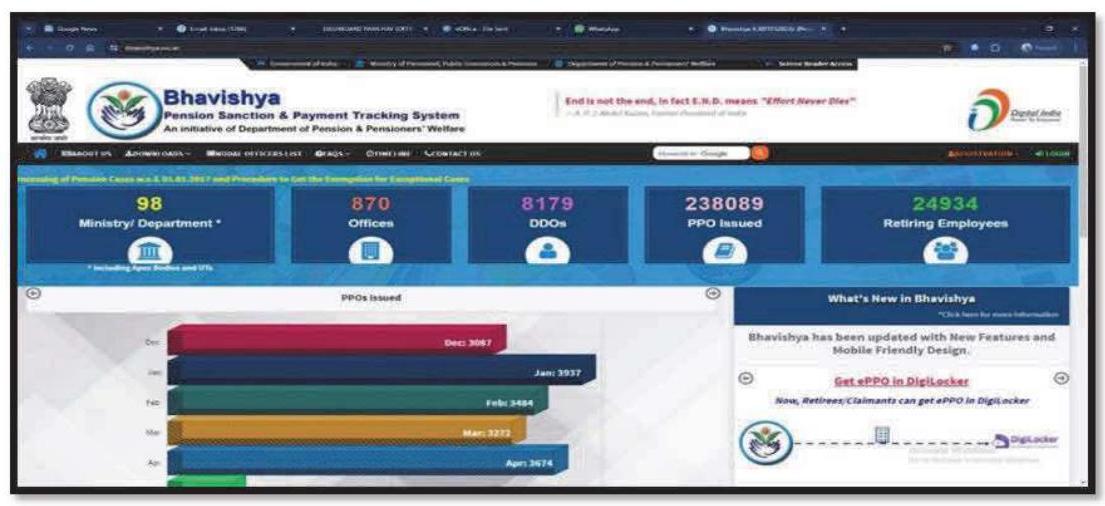
Bhavishya Portal Dashboard
- The ‘Bhavishya’ process have also been integrated with the PFMS module of CGA and due to this it has now become possible to issue electronic PPOs (e-PPO). At present, the Data from Bhavishya is being provided/transferred to PFMS for 501 PAOs. 1,67,688 e-PPOs have been issued till 09.04.2024. The e-PPO is transmitted by the concerned Ministry/Department’s PAO to CPAO from where it goes to the Bank. The paying branch can view e-PPO online. Intimation of credit of first Pension & subsequent monthly Pension is done electronically on real time basis and is also communicated to Pensioner via email/SMS alerts. A link has been incorporated in the Bhavishya system to download the e-PPO by the retirees as well as HOO.
- Integration of Bhavishya with Digi Locker – Pensioners have to face innumerable hardship at various stages of their retired life due to misplacement of the original copies of their Pension Payment Order (PPO). Therefore, Bhavishya was upgraded to create a permanent record of PPO in DigiLocker of pensioners. This was a technological leap since now the Central Government Pensioners can store their PPOs in their Digi lockers as a permanent record. 5034 retirees have pushed their e-PPOs in DigiLocker till 09.04.2024.
- The ‘Bhavishya’ system has also been made available on a Mobile App, thereby making it simples specially for those Para Military Forces who are out in the fields to keep track of their pension cases.
- As another step towards ‘Ease of Living’ for pensioners, D/o Pension and Pensioners’ Welfare has introduced the facility to download Electronic Special Seal authority (e-SSA). Now the Retiree as well as the Head of Office (HOO) can download the eSSA from the Bhavishya system. It will save Pensioners from undue hardship in getting a copy of their SSA at the time of retirement.
- Coordination with Defence, Railways, Post and Telecom to automate their Pension processing system on the lines of Bhavishya: As per directives of Parliamentary Standing Committee, DoPPW is regularly pursuing with Defence, Railways, Post and Telecom for getting their pension processing system digitized on the pattern of ‘Bhavishya. As of now, digitization has taken momentum in these establishments. M/o Defence after introduction of SPARSH Portal, DoT with SAMPANN Portal, Railways with ARPAN software and D/o Posts have made considerable headway in digitization of the pension settlement of their employees. DoPPW is also working towards bringing the Defence, Railways, Post and Telecom on the Department’s Dashboard in order to get regular updates on the number of retiring persons in their respective establishments.
- Real-time monitoring for settlement of family pension claim in CAPF: All the CCAPFs viz. BSF, CRPF, CISF, ITBP, Assam Rifles and SSB come under MHA and CCS (Pension) Rules, 1972 (now, CCS (Pension) Rules, 2021) are applicable to them. With a view to curtail the time lag between the date of death in any CAPF and settlement of family pension, a real-time monitoring Dashboard was made functional w.e.f. February 2020 through which the status of delay in family pension can be monitored and reminders sent to MHA to take action on expeditiously starting the family pension.
- To the commemoration of Bharat ke Azadi ke Amrut Mahotsav India@75, the Department of Pension and Pensioners’ Welfare has imparted training on Bhavishya (online Pension Sanction Module) to 75 Government of India offices.
- Services available on IPP: – At present, the pension portals of State Bank of India (SBI), Canara Bank, Punjab National Bank and Bank of Baroda have been integrated. The pensioners can now get their pension slip, the status of submission of Life Certificate and Form-16 through the Integrated Pensioners’ Portal (IPP).
- Impact of Bhavishya:
Timely issue of PPO
$\checkmark 83 %$ Superannuation PPOs are issued either before retirement or within 30 days.
$\checkmark$ 69\% Family Pension PPOs are issued within 6 months from the date of death.
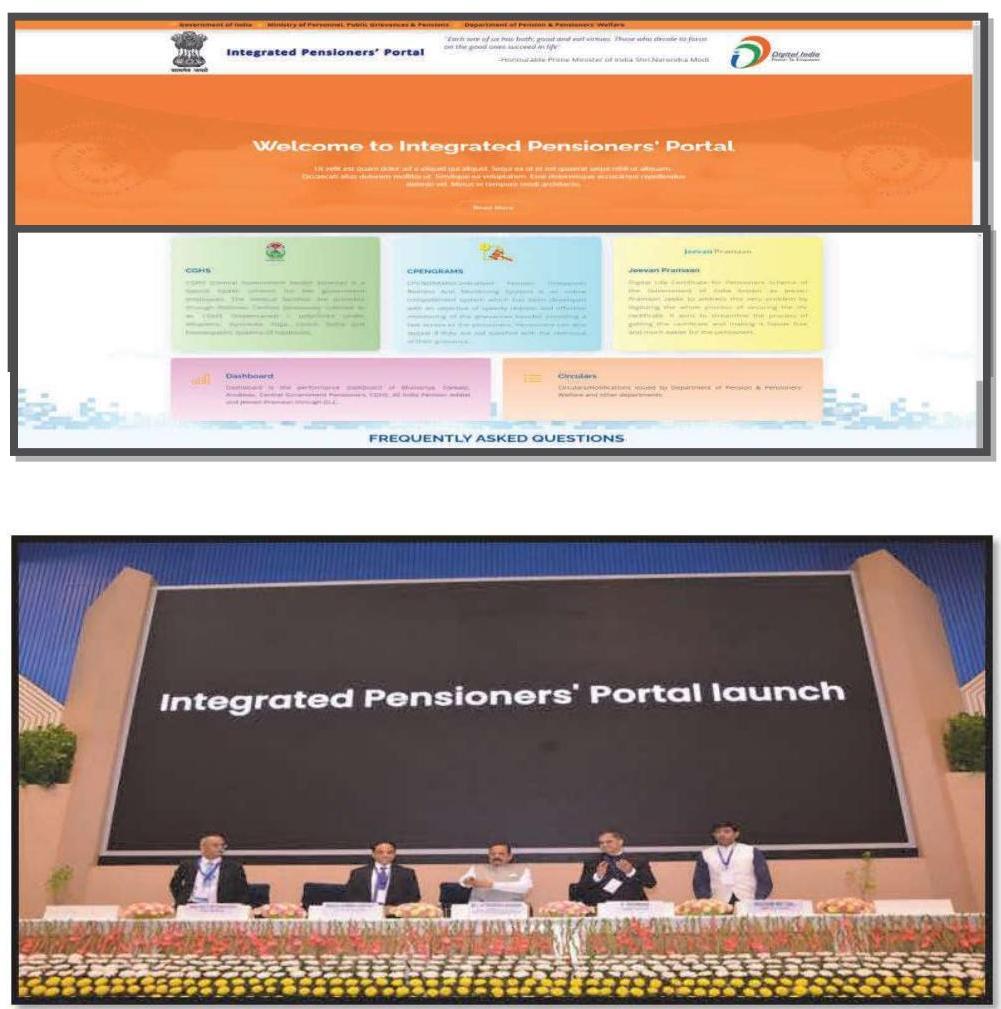
28.6.10 Social Media Outreach:
- Providing access to information is an important tool to empower the people, therefore, DoPPW has adopted a policy of spreading awareness amongst the targeted groups on instructions issued time to time and entitlements through workshop and various available medium such as electronic, print and social media. Since Social Media has emerged as a powerful participatory medium of communication in recent times, therefore, DoPPW has
adopted a gradual shift towards spreading awareness amongst the targeted groups through social media such as Facebook, Twitter and Documentary films, YouTube etc. The Department has also been creating awareness through SMSs which are sent directly on the Mobile Phone of pensioners. This has resulted in creating greater awareness in the targeted group at minimal costs.
| Number of Tweets on Twitter 2430 |
Number of Impressions on Twitter 324,400 |
|---|---|
| Number of Facebook posts $\mathbf{5 0 0}$ | Number of reaches on Facebook 10,671 |
You Tube (Year 2023)
| S.no | DD/MM/YY | Name of video | No. of Videos |
Views |
|---|---|---|---|---|
| 1 | April 3, 2023 | Documentary on Anubhav Awards | 1 | 3434 |
| 2 | May 19, 2023 | Inaugural Speech by Shri Sanjiv Narain Mathur,AS DoPPW in $50^{\text {th }}$ PRC & $8^{\text {th }}$ AIPA held on 10.05.2023 Inaugural address by Shri V. Srinivas, Secy, DoPPW in $50^{\text {th }}$ PRC \& $8^{\text {th }}$ AIPA held on 17.05.2023 |
2 | 1324 |
| 3 | Oct 23, 2023 | Anubhav Award film, 2023 | 1 | 2616 |
| 4 | Oct 30, 2023 | Digital life certificate through Face Authentication Jeevan Pramaan App, 2023 जीवन प्रमाण ऐप के माध्यम से फेस अॅथॅटिकेशन द्वारा डिजिटल जीवन प्रमाण, 2023 |
2 | 791,798 |
| 5 | Oct 31, 2023 | Digital Life Certificate Film 2023 | 1 | 16,584 |
| 6 | Jan 9, 2024 | STEPS TO FILL WRITE UP ON ANUBHAV PORTAL |
1 | 4,423 |
| 7 | Mar 12, 2024 | An educative video on CPENGRAMS Portal | 1 | 2066 |
| Total | 9 | 838,829 | ||
| *Total no. of Subscribers 51,963, we have gained $+27,875$ subscribers in year 2023 | ||||
| *Total no. of views from April, 2023 to till date on our channel 2,312,927 views |
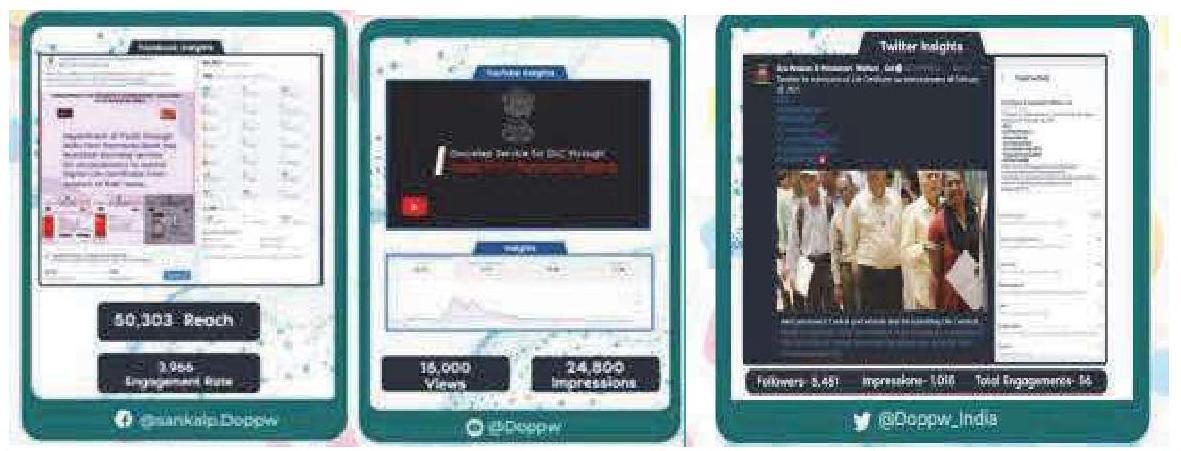
28.7 Miscellaneous:
28.7.1 Special Campaign Activities 3.0 (SCDPM)
- 5000 pensioners’ grievances with various Ministries taken up in campaign mode: During SCDPM 2.0 campaign, the department has resolved 4126 pending pension grievances to ensure speedy redressal and to enhance “Ease of living” for 70 lakh Central Government Pensioners. The Department is convening inter-ministerial meetings with concerned Ministries/Departments to resolve all grievances within due time period. Total 534 appeals on pension grievances have also been disposed of.
- “Ease of Living” for pensioners was the central focus while re-iterating relevant circulars at a glance: The Department has issued 6 circulars under Easing of Rules/Processes.
- Hundreds of physical files as well as e-files which have outlived their codal life weeded out: Total 406 physical files and 384 EFiles have been closed in which action is completed.
- Registered Pensioners’ Associations offices made part of Swachhta Campaign: Total 50 Cleanliness Campaign have been conducted.
28.7.2 Dearness Relief to Pensioners/Family Pensioners: - Revised rates of Dearness Relief (DR) to Central Government Pensioners/ Family pensioners on implementation of decision taken on recommendation of $7^{\text {th }} \mathrm{CPC}$ are admissible at following rates:-
| Date from which payable |
Rate of Dearness Relief per month |
|---|---|
| From 01.01.2023 | $42 %$ of Basic Pension/Family Pension |
| From 01.07.2023 | $46 \%$ of Basic Pension/Family Pension |
| From 01.01.2024 | $50 \%$ of Basic Pension/Family Pension |
- For the convenience of all Ministries/ Departments and Banks/ Treasuries/ Post Offices, orders are hosted on the website of this Department. This facilitates faster payment of enhanced DR by Pension Disbursing Authorities.
- The process has been streamlined to ensure that enhanced DR orders are issued with a minimum time lag with reference to the orders for enhancement of DA.
28.8.1 राजभाषा अनुभाग
- हिंदी संघ की राजभाषा होने के कारण पेंशन एवं पेंशनभोगी कल्याण विभाग सरकारी कामकाज में हिंदी के प्रगामी प्रयोग को बढ़ावा देने के लिए सक्रिय रूप से भूमिका निभा रहा है। पेंशन एवं पेंशनभोगी कल्याण विभाग का राजभाषा अनुभाग हिंदी अनुवाद का कार्य करने के साथ-साथ राजभाषा नीति तथा राजभाषा अधिनियम के कार्यान्वयन संबंधी कार्य देखता है। विभाग के सभी अनुभागों में राजभाषा नीति के कार्यान्वयन की स्थिति की निगरानी के लिए विभाग में राजभाषा कार्यान्वयन समिति का गठन किया गया है। राजभाषा नीति के कार्यान्वयन की स्थिति की निगरानी के लिए विभागाध्यक्ष की अध्यक्षता में प्रत्येक तिमाही में नियमित रूप से बैठक आयोजित की जाती है और बैठक में लिए गए निर्णयों पर की गई कार्यवाही, विभाग के सभी अनुभागों से प्राप्त तिमाही प्रगति रिपोर्ट की समीक्षा की जाती है तथा सरकारी कामकाज में हिंदी के प्रयोग को बढ़ाने की दिशा में प्रयास करने हेतु मार्गदर्शन किया जाता है। गृह मंत्रालय राजभाषा विभाग द्वारा समय-समय पर जारी किए गए आदेशों/अनुदेशों के अनुसरण में राजभाषा हिंदी के प्रगामी प्रयोग को बढ़ावा देने के लिए पेंशन एवं पेंशनभोगी कल्याण विभाग में 1 से 15 सितंबर, 2023 तक की अवधि के दौरान हिंदी पखवाड़े का आयोजन किया गया जिसके दौरान आयोजित प्रतियोगिताओं में अधिकारियों/कर्मचारियों ने उत्साहपूर्वक भाग लिया।
- राजभाषा विभाग, गृह मंत्रालय, भारत सरकार द्वारा दिनांक 14 से 15 सितंबर, 2023 को पुणे(महाराष्ट्र) में आयोजित हिंदी दिवस और तृतीय अखिल भारतीय राजभाषा सम्मेलन में पेंशन विभाग को 300 से कम कार्मिक वाले मंत्रालय/विभाग की श्रेणी में लगातार दूसरी बार प्रथम राजभाषा कीर्ति पुरस्कार शील्ड प्रदान की गई।
- डॉ. जितेंद्र सिंह, माननीय राज्यमंत्री के तत्वावधान में विभाग द्वारा आयोजित विभिन्न कार्यक्रमों, अभियानों जैसे अनुभव पुरस्कार समारोह 2023, राष्ट्रव्यापी डिजिटल जीवन प्रमाणपत्र अभियान 2.0, स्वच्छता अभियान 3.0, सेवानिवृत्ति-पूर्व परामर्श(पीआरसी) कार्यशालाओं, पेंशन अदालतों का मंचसंचालन सहायक निदेशक (रा.भा.) द्वारा हिंदी में किया गया। सभी संबंधित स्टैंडी, निमंत्रण-पत्र, मिनटवार कार्यक्रम और प्रेस रिलीज द्विभाषी तैयार किए गए तथा दूरदर्शन, स्थानीय अखबारों, ट्वीटर, फेसबुक और युट्यूब के माध्यमों से द्विभाषी रूप में प्रचार-प्रसार किया गया।
- सचिव, पेंशन की अध्यक्षता में समय-समय पर बैंकों, पेंशनभोगी संघों तथा विभिन्न मंत्रालयों/विभागों के नोडल अधिकारियों के साथ की गई बैठकों से संबंधित सामग्री, युट्यूब पोस्ट और ट्वीट द्विभाषी जारी किए गए।
- राजभाषा हिंदी के प्रगामी प्रयोग को बढ़ावा देने के क्रम में उत्साहवर्धक माहौल तैयार करने के लिए लोकनायक भवन के तृतीय तल पर विद्वानों और गणमान्य व्यक्तियों की हिंदी सूक्तियां लगाई गई।
ANNEXURES
Department of Personnel and Training
Incumbency Position of Group ‘A’ Officers in D/o Personnel and Training as on 31.03.2024
| Post | Name of Incumbent |
|---|---|
| Secretary (Personnel) | Ms S. Radha Chauhan |
| Additional Secretary | 1. Ms Deepti Umashankar |
| 2. Shri Manoj Kumar Dwivedi | |
| Joint Secretary | 1. Shri Rajat Kumar |
| 2. Ms Rajul Bhatt | |
| 3. Shri S D Sharma | |
| Director | 1. Shri Ashok Kumar Jayapal |
| 2. Shri Prashant Shukla | |
| 3. Ms. Pallavi Singh | |
| 4. Shri Harmit Singh Pahuja | |
| 5. Shri S.P. Pant | |
| 6. Ms Syed Imran Ahmed | |
| 7. Shri Murali Bhavaraju | |
| 8. Shri Sandeep Mukherjee | |
| 9. Shri Moloy Sanyal | |
| 10. Ms Shivendra Chaturvedi | |
| Principal Staff Officer | 1. Shri Ashok Kumar |
| 2. Shri Harish Kumar Chawla | |
| 3. Shri P. Suresh | |
| 4. Virendar Aggarwal | |
| Deputy Secretary | 1. Ms. Charulata Somal |
| 2. Ms. Yashu Rustagi | |
| 3. Ms. Debasweta Banik | |
| 4. Ms. Pooja Jain | |
| 5. Shri Kumar Abhinav | |
| 6. Shri Vijay S. | |
| 7. Shri Shankra Nand Bharti | |
| 8. Ms. D.S. Nagalakshmi | |
| 9. Shri Anindya Bhattacharya | |
| 10. Shri Sandeep Saxena | |
| 11. Shri J. Sriram Murty | |
| 12. Shri Ram Dutt | |
| 13. Shri Shamik Bhowmick | |
| 14. Shri Parveen Jargar | |
| 15. Shri Vadali Rambabu | |
| 16. Shri P.B. Sahu | |
| 17. Ms. Priya Mahadevan | |
| 18. Shri Deo Nath Sah | |
| 19. Shri S.K. Dahiya |
| 20. | Shri Naresh Kumar | |
|---|---|---|
| Senior Principal Private Secretary | 1. | Shri Rajinder Parshad |
| 2. | Ms Savita Sen | |
| 3. | Shri Yati Raj Sehgal | |
| Principal Private Secretary | 1. | Deepak Chandra Upreti |
| 2. | R. K. Malhotra | |
| 3. | Kartika Chandra Sahoo | |
| 4. | Naresh Kumar Mendratta | |
| 5. | Dilip Kandulna | |
| 6. | Amit Munjal | |
| 7. | Raman Kumar | |
| 8. | Rajneesh Jain | |
| 9. | Laxmi Narain | |
| 10. | Arvind Bhardwaj | |
| 11. | Girish Kumar Ahuja | |
| 12. | Jaipal Singh | |
| 13. | Zahid Hussain | |
| 14. | Sarada Behera | |
| 15. | Jay Prakash Singh | |
| 16. | Ishwar Singh Bhandari | |
| 17. | JenenderKawatra | |
| 18. | Sanjay Sharma | |
| 19 | S. Rama Prasad | |
| 19. | Rajesh Kumar | |
| 20. | C Sundar | |
| Deputy Director (OL) | 1. | Shri Jagmohan Singh Negi |
| 2. | Ms. Shraddha Mathur | |
| Under Secretary | 1. | Shri A. M. U. Mahesh |
| 2. | Shri Ajay Kumar Sinha | |
| 3. | Shri Ajay Lawania | |
| 4. | Shri Alok Suman | |
| 5. | Shri Ambrish Kumar Gopal | |
| 6. | Shri Amit Choubey | |
| 7. | Shri Amit Kumar | |
| 8. | Shri Anil Bajpai | |
| 9. | Shri Anshuman Mishra | |
| 10. | Shri Anurag Saxena | |
| 11. | Shri Arun Kumar Dahiya | |
| 12. | Shri Arun Kumar Singh | |
| 13. | Shri Arvind Thakur | |
| 14. | Shri Ashok Giri | |
| 15. | Shri Bhupinder | |
| 16. | Shri Bhupinder Pal Singh | |
| 17. | Shri Debabrata Das | |
| 18. | Shri Deepak Sharma | |
| 19. | Ms. Deonisia Ekka | |
| 20. | Shri Deshraj Yadav |
| 21. | Shri Dilip Kumar Jha |
|---|---|
| 22. | Shri Gandharv Kumar Sandilya |
| 23. | Shri Gautam Kumar |
| 24. | Shri Hemant Sharma |
| 25. | Shri Imtichuba N Jamir |
| 26. | Ms. Jasmine |
| 27. | Shri Jata Shankar Kanth |
| 28. | Ms. Kavita Chauhan |
| 29. | Shri Kumar Rajiv Ranjan |
| 30. | Shri Kundan Nath |
| 31. | Shri L Raghavendran |
| 32. | Shri Lalit Kumar |
| 33. | Shri Mahesh Kumar |
| 34. | Shri Manish Kumar Singh |
| 35. | Shri Manoj Gupta |
| 36. | Shri Manoj Kumar |
| 37. | Shri Narendra Kumar |
| 38. | Shri Naveen Kumar |
| 39. | Ms. Nidhi Garg |
| 40. | Ms. OrugantiPhani |
| 41. | Shri Pawan Kumar |
| 42. | Shri Pijush Mohanta |
| 43. | Shri Praveen Pal Singh |
| 44. | Shri R.Venketesan |
| 45. | Shri Rajeev Kumar Choudhary, IAS |
| 46. | Shri Rajeev Kumar Khare |
| 47. | Shri Rajeev Nayan |
| 48. | Shri Rajesh Kumar |
| 49. | Shri Rajesh Sharma |
| 50. | Shri Rakesh Kumar |
| 51. | Shri Rakesh Kumar Sinha |
| 52. | Shri Ram Bhagat Kushwaha |
| 53. | Shri Ramesh Chandra Jha |
| 54. | Shri Randhir Kumar |
| 55. | Shri Rishi Pal |
| 56. | Shri Rupesh Kumar |
| 57. | Shri Sanjay Kumar Chaurasia |
| 58. | Shri Santanu Dhar |
| 59. | Shri Santosh Kumar |
| 60. | Shri Satish Kumar |
| 61. | Shri Satya Pal Singh |
| 62. | Shri Satyendra Singh |
| 63. | Shri SubandhuBasu |
| 64. | Shri Subir Kumar |
| 65. | Shri Subodh Verma |
| 66. | Shri Sujit Kumar Mishra |
| 67. | Shri Sunil Kumar |
|---|---|
| 68. | Ms. Varinder Kaur Bhalla |
| 69. | Shri Vijay Kumar |
| 70. | Shri Vijay Kumar Darak, Dy. Director |
| 71. | Shri Zachariah Thomas |
Incumbency Position of Group ‘A’ Officers in Public Enterprises Selection Board as on 31.03.2024
| Chairman | 1. | Mallika Srinivasan |
|---|---|---|
| Member | 1. | Shri Amarjeet Sinha |
| 2. | Shri Sailesh | |
| 3. | Ms.Soma Mondal | |
| Secretary | 1. | Ms. Nita Kejrewal |
| Deputy Secretary | 1. | Shri Deepak Sajwan |
| Principal Staff Officer | 1. | Shri Virendar Aggarwal |
| 1. | Shri Girish Kumar Ahuja | |
| Principal Private Secretary | 2. | Shri Raman Kumar |
| 3. | Shri Rajneesh Jain | |
| Private Secretary | 4. | Pradeep Kumar Mishra |
| 5. | R. Suresh | |
| Under Secretary | 1. | Shri Mohammad Jainuddin |
| 2. | Shri Ajit Kumar |
2023 NAeG
Awardees
| S.No. | Category | Project Name | Dept./Orgn./State/ District | Award |
| — | — | — | — | — |
| Category I – Government Process Re-engineering for Digital Transformation (i) Central level initiatives; (ii) State/UT level initiatives | | | | |
| 1. | (i) Central level initiatives | National Automated Fingerprint Identification System (NAFIS) | National Crime Records Bureau | GOLD |
| 2. | | Mission Antyodaya | Department of Rural Development, Government of India | SILVER |
| 3. | (ii) State/ UT level initiatives | Suvidha Vehicles Facilitation System | Department of
InformationTechnology
& Electronics,
Govt of West Bengal | GOLD |
| 4. | | Maa Navjaat Tracking Application (MaNTrA) for Delivery Point Health Facilities | National Health Mission, Government of Uttar Pradesh | SILVER |
| Category II – Application of Emerging Technologies for providing Citizen Centric Services (i) Central level initiatives; (ii) State/UT level initiatives | | | | |
| 5. | (i) Central level | SVAMITVA | Ministry of Panchayati
Raj, Government of
India | GOLD |
| 6. | initiatives | Jal Jeevan Mission – Water Quality Management Information System | Department of Drinking Water \&Sanitation, Government of India | SILVER |
| 7. | (ii) State UT level initiatives | Real time tracking and surveillance for Yatra management through RFID technology and CCTV network and Digitalisation of Pilgrim services by Shri Mata Vaishno Devi Shrine Board. | Shri Mata Vaishno Devi ShrineBoard
Government of Jammu \& Kashmir | GOLD |
| 8. | | Apuni Sarkar | Information Technology
Development Agency,
ITDA
Dehradun, Government
ofUttarakhand | SILVER |
| Category III – District level initiative in e-Governance | | | | |
| 9. | (i) Districts (ii) Local Bodies | MOR Raipur Smart App | Raipur Smart City Ltd., Chhattisgarh | GOLD |
| 10. | | Cold Storage Information System (CSIS) | District Administration Firozabad, Government of Uttar Pradesh | GOLD |
| 11. | | Water SCADA | Bhopal Smart City Development Corporation Limited, MadhyaPradesh | SILVER |
| 12. | Jan Sahayata Koshang | District Administration, WestSinghbhum, Government of Jharkhand | SILVER | |
|---|---|---|---|---|
| Category IV- Research on Citizen Centric Services by Academic/Research Institutions | ||||
| 13. | Category IV | Innovative and Transformative Smart Farming using Artificial Intelligence | Indira Gandhi AgricultureUniversity, Raipur | GOLD |
| 14. | Category IV | Lucky Bill App | Kerala University of Digital Sciences, Innovation and Technology (Digital UniversityKerala) | SILVER |
| Category V – Application of Emerging Technologies in Governance by Startups | ||||
| 15. | Category V | Sampurna Shiksha Kavach Program by Filo | Filo Edtech Pvt Ltd | GOLD |
| 16. | Category V | Percept Extended Detection and Response (XDR) | Sequretek IT Solutions Pvt. Ltd. | SILVER |
Annexure – III
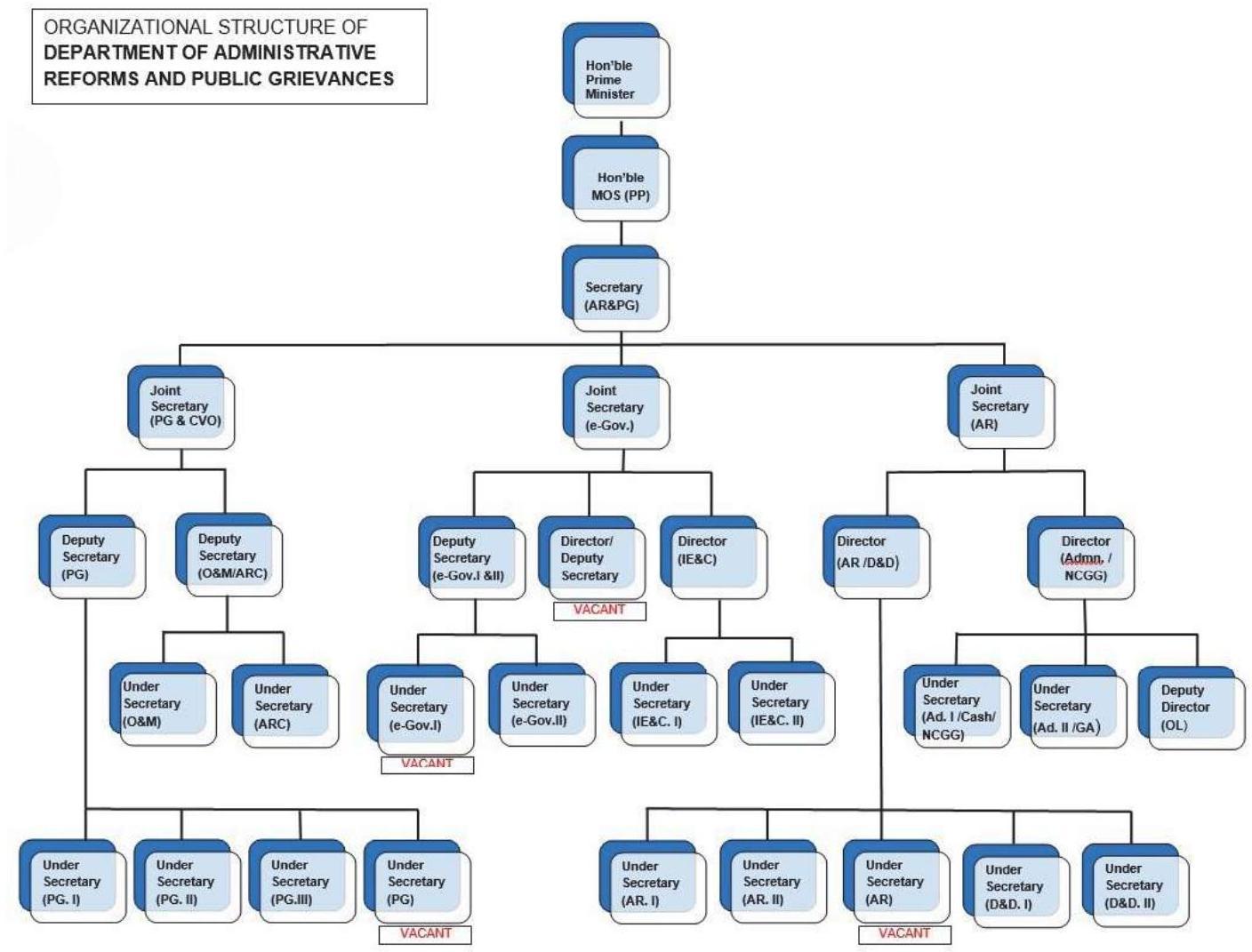
Department of Administrative Reforms and Public Grievances
Incumbency position of Under Secretary and above level officers in D/o AR&PG as on 31.03.2024
| Post | Name of Incumbent |
|---|---|
| Secretary | Shri V. Srinivas |
| Joint Secretary | 1. Ms. Jaya Dubey 2. Shri N B S Rajput 3. Shri Puneet Yadav |
| Director | 1. Shri Narendra Kumar Meena 2. Shri Rohit Anand 3. Shri Sardendu Kumar Pandey |
| Deputy Secretary | 1. Smt. Sarita Taneja 2. Shri Sanjeev Shrivastava 3. Shri Parthasarathy Bhaskar Devarakonda |
| Under Secretary | 1. Shri Udham Singh 2. Shri Rakesh Chandra 3. Shri R Rajasekharan 4. Shri Sunil Kumar Singh 5. Shri Kaikam Doungel 6. Shri Santosh Kumar 7. Shri Hari Krishan Bhatt 8. Shri Kamal Kumar Thakur 9. Shri Prashant Pandey 10. Shri Dharam Pal Arora 11. Smt. Sanjeeta Chatterjee 12. Shri Lakshmi Chandra 13. Smt. Vandana Nangia 14. Shri Gya Prasad 15. Smt. Hari Kiran Gurla 16. Smt. P. Songlianvung |
| Principal Private Secretary | 1. Shri Sudhir 2. Smt. Ranjana Malik 3. Smt. Alka Ahuja |
| Deputy Director (OL) | 1. Shri Rakesh Kumar |
Annexure-V
Department of Administrative Reforms and Public Grievances
Prevention of Sexual Harassment of Women in Workplace
An Internal Complaints Committee has been constituted in the Department of Administrative Reforms and Public Grievances for the prevention of Sexual Harassment of Women in the Workplace. It has been constituted with the following:
- Ms. Jaya Dubey, Joint Secretary – Chairperson
- Shri Sanjeev Srivastava, DS – Member
- Ms. Sarita Taneja, DS – Member
- Dr. Sonajharia Minz, YWCA – NGO member
- Ms. Hari Kiran Gurla, US – Member Secretary
Women employees are being made aware of the existence of the said Committee from time to time through circulars, display on Notice Boards, and interactions. In this connection, Department of Administrative Reforms and Public Grievances convened a workshop on 04.12.2023 as part of the Sexual Harassment at Workplace Prevention Week”. Sh Rajinder Tuteja, District and Session Judge was invited for delivering a lecture on “Prevention of Sexual Harassment at Workplace” through Video Conferencing.
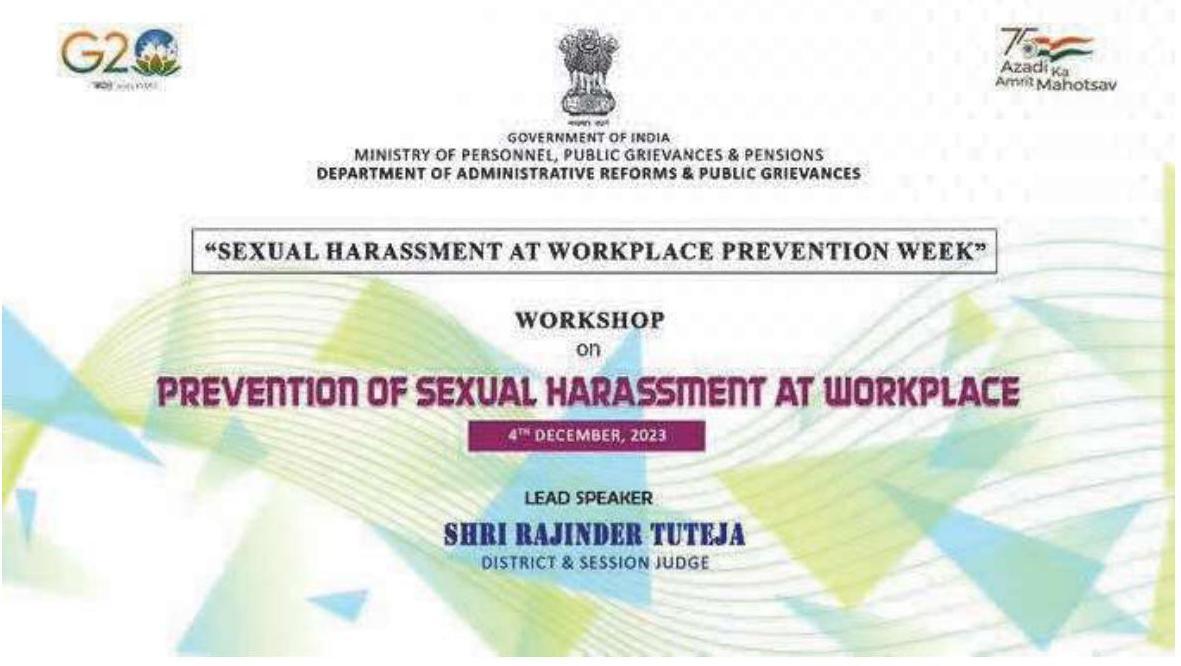
Department of Administrative Reforms and Public Grievances
Welfare of SC,ST, OBC and Persons with Disability (PWD)
As on 31.03.2024, the imcumbency position of SC, ST, OBC and Persons with Disability (PwD) in the Group ‘A’, ‘B’ and ‘C’ category of officials of Department of Administrative Reforms and Public Grievances is as under:
| Category | Total | SC | ST | OBC | PwBD |
|---|---|---|---|---|---|
| Group-A | 30 | 2 | 3 | 3 | 0 |
| Group-B | 33 | 5 | 2 | 7 | 2 |
| Group-C | 10 | 2 | 0 | $3^{*}$ | $1^{*}$ |
| Total | 73 | 9 | 5 | 13 | 3 |
*includes 1 PwBD category Officer
The Department has appointed Nodal Officers to look into the complaints/ representations, if any, received from SC, ST & OBC officials and as also to watch their welfare.
ORGANISATIONAL CHART (as on 31.03.2024)
| | | | | | | | | | | | | | | | | | | | | | | | | | | | | | | | | | | | | | | | | | | | | | | | | | | | | | | | | | | | | | | | | | | | | | | | | | | | | | | | | | | | | | | | | | | | | | | | | | | | |
Incumbency position of Officers in D/o Pension & Pensioner’s Welfare as on 31/03/2024
| Post | Name of the incumbent |
|---|---|
| Secretary | Shri V. Srinivas |
| Joint Secretary | Shri Dhrubajyoti Sengupta |
| Director | Shri Ravikiran Ubale Shri Pramod Kumar Shri Ravinder Kumar |
| Deputy Secretary | Shri Ramesh Chandra Sethi |
| Under Secretary | Shri S. Chakrabarti Ms. Sonika Khattar Shri Subhash Chander Shri Vishal Kumar Shri Deepak Gupta Shri Sandeep Gahlot Ms. Madhu Mankotia Shri Rajesh Sharma Shri Nagender Kumar |
| Assistant Director (OL) | Ms Manju Gupta |
| Section Officers | Shri Hemant Ms Deborah Umesh Ms Swati Kant Shri Andrew Zomawia Karthak Shri Akhlesh Mann Shri Syed Mohd. Danish Rizvi |
.
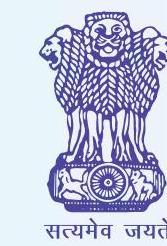
Ministry of Personnel, Public Grievances and Pensions Government of India
Printed by the Manager, Government of India Press, Minto Road, New Delhi-110002